Revolutions per Minute festival, an artist run festival, is dedicated to short-form poetic, personal, cinematic work in experiments, essay film, animation, documentary, video and audiovisual performance.
RPM24: We are looking for any work that experiments with the formal possibilities or hybrid form of film, audiovisual, animation and video.
Shorts under 10mins
Medium Length under 20mins
Essay and Documentary under 30mins
Thematic Category: Water under 15mins
Submit your work (produced after Jan. 1st, 2023)
through FilmFreeway.
Selections by Sept. 1, 2024.
Revolutions Per Minute Festival 2023 - 2024 was co-hosted by
Art and Art History Department and Cinema Studies at UMass-Boston, Goethe-institut Boston , Brattle Theatre in Cambridge & Harvard FAS CAMLab.
RPM Festival 2022 Screening Series presented with the support of a Festivals Grant from the Massachusetts Cultural Council.
For more info: contact@revolutionsperminutefest.org
![]()


















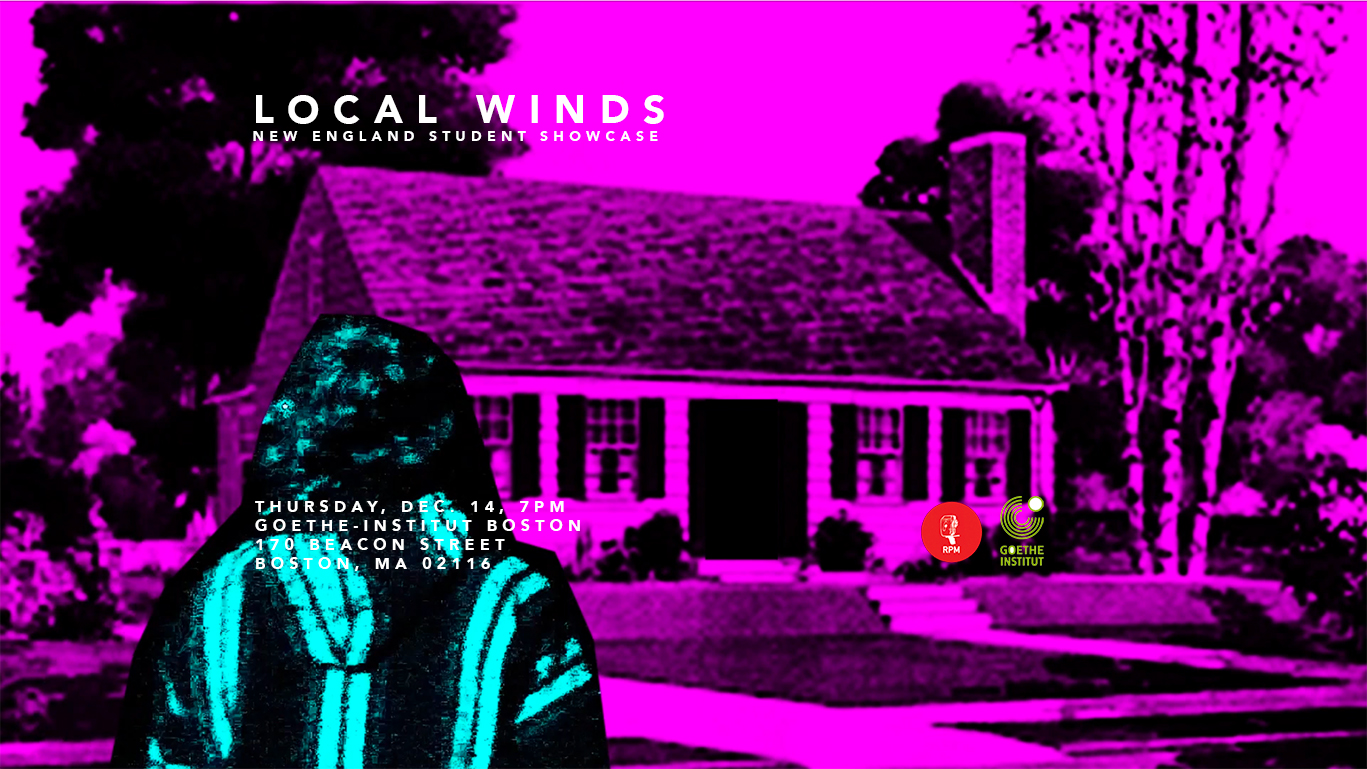
The RPM Student Shorts Showcase aims to spotlight unconventional works by student filmmakers from New England, exploring realms beyond conventional cinema. This includes experimental films, documentaries, and animations that push the boundaries of traditional filmmaking. The featured works encompass a diverse range, showcasing hand-altered and hand-developed analog film, narrative experiments, and poetic, personal reflections on the cinematic medium. Join us in celebrating the emerging generation of local experimental filmmakers who are actively broadening the language of cinema.
In its inaugural year, the RPM New England Student Film Showcase attracted a total of 42 submissions from 12 universities and colleges, such as Emerson, MassArt, UMass-Amherst, UMass-Boston, Boston College, Harvard, Brown, Dartmouth, Keene State, Amherst College, Suffolk, and Fitchburg State. The final selection consists of 14 exceptional finalists, forming a captivating hour-long program.
This program is curated by Brett Melican, a local filmmaker, AgX Film Collective member, and recent graduate of MassArt.


After Work, Tuesday Night - Blake Tianyi Shao
Brown University, HD, B&W, sound, 1:21 mins
"Time is a loop", I wish - Yue Hua
Emerson College, 16mm, B&W , sound, 3:28 mins
Séance - Charlie De Koster
MassArt, 16mm, B&W, sound, 8 mins
Menorrhagia - Claire Maske
Emerson College, 16mm to HD, B&W, sound, 5:36 mins
Headlands - Cecelia Clare Meade
Emerson College, 16mm, B&W, sound, 4:37 mins
September Space - Bree Andruzzi
MassArt, HD, Color, sound, 5:47 mins
Room Tone - Ren Evans
MassArt, Digital, color, sound, 3:51 mins
Time For Supper -Kyle Lindfors
Fitchburg State University, Digital, color, sound, 1:30 mins
Sorry it took me so long.. to See -Leticia Sidney
UMass-Boston, 8mm to HD, B&W, sound, 1:57 mins
Our Shadows - Polly Chesnokova
Dartmouth College, HD, Color , sound, 16:05 mins
Never Forget Death - Tomás Orrego
Emerson College, 16mm to HD, color, sound, 2 mins
Fragments from the End of History - Chris Connell
MassArt, 16mm, color, sound, 6:48 mins
Can You Carry Me - Tess Meersman
Emerson College, 16mm, B&W, sound, 5:47 mins
Never Forget Death - Tomás Orrego
Emerson College, 16mm to HD, color, sound, 2 mins
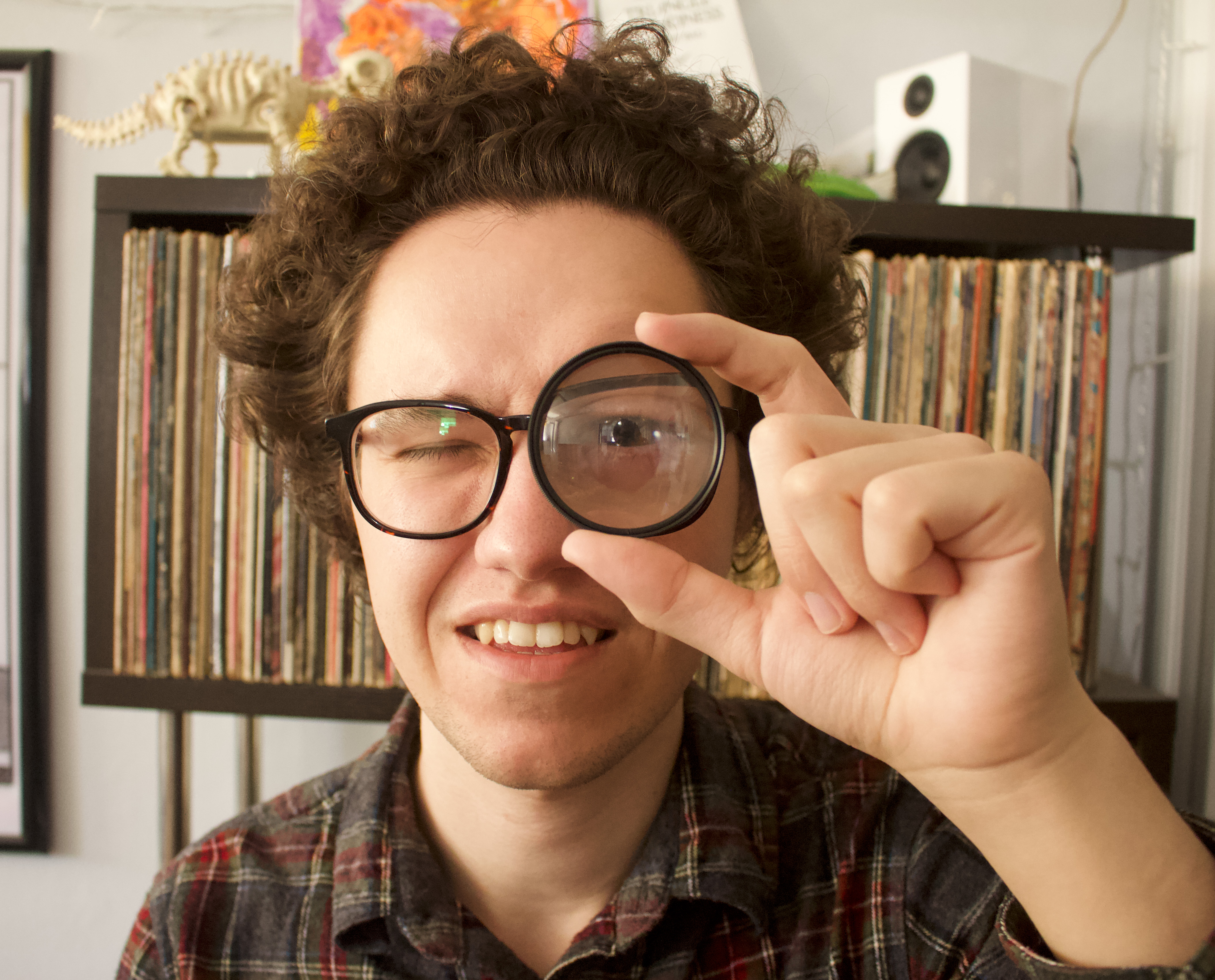
Guest Curator Brett Melican
Brett Melican is a filmmaker based in Boston, Massachusetts whose work mixes narrative and experimental forms, exploring fractured relationships and psychological isolation in a blend of genres. He is a member of the AgX Film Collective, and helps organize and program local film festivals alongside work in camera and lighting departments on independent and commercial productions.
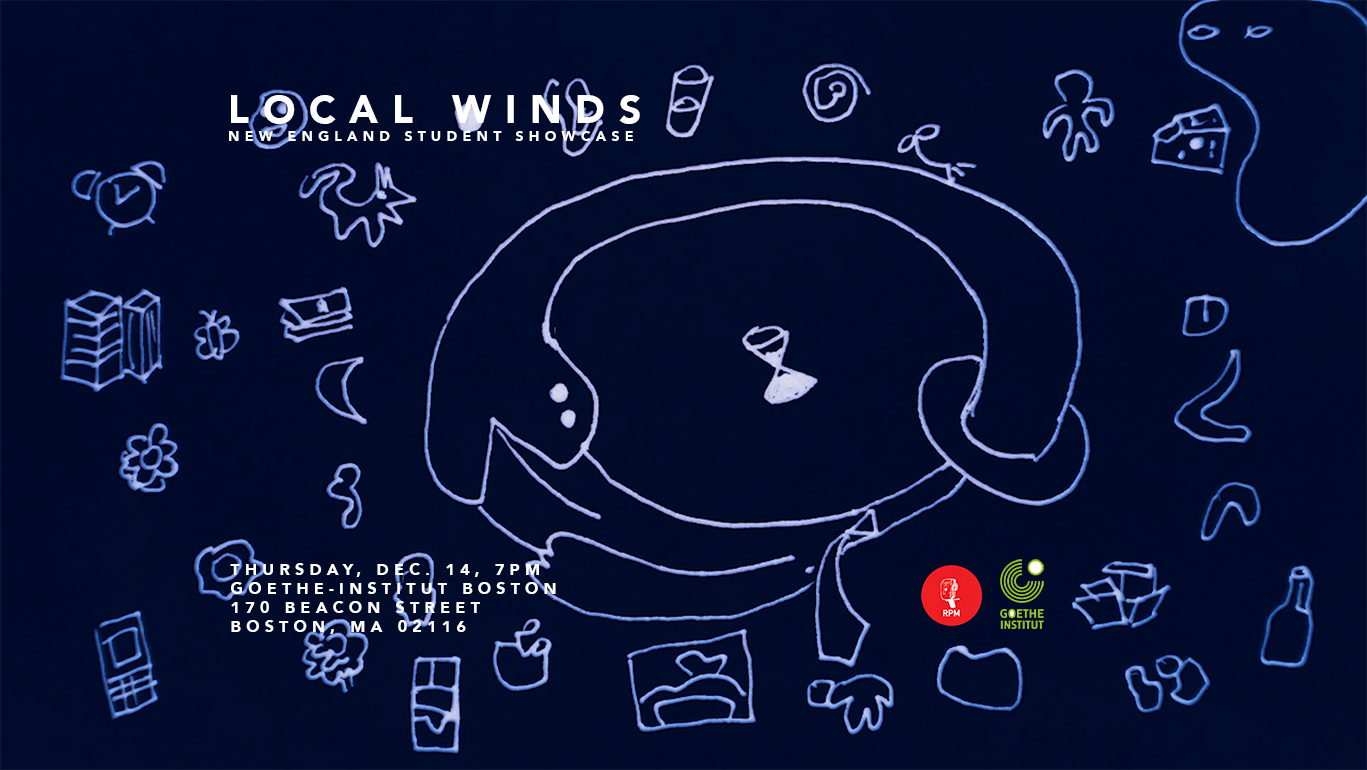
After Work, Tuesday Night - Blake Tianyi Shao
Brown University, HD, B&W, sound, 1:21 mins
Overwork, exploitation, and exhaustion oversaturate modern work-life. Each day seems to become an endless, mechanical cycle of commuting and tedious tasks, rinse and repeat.
The film Tuesday Night, After Work provides a whimsical and ethereal attempt to portray the inescapability of the repetitive cycle of labor. Religious elements are widely used auditorially and visually, painting work as a divine order and thus reflecting the absurd coerciveness of the modern work-life. The film, aside from giving an ironic and amusing take on labor conditions, also begs the question of why that comes to be.
Blake Shao is a filmmaker, animator, and designer from Jinan, China, currently attending Brown University in Providence, Rhode Island, US. He has worked in China and the United State in various productions of short films, music videos, documentaries, and short films.
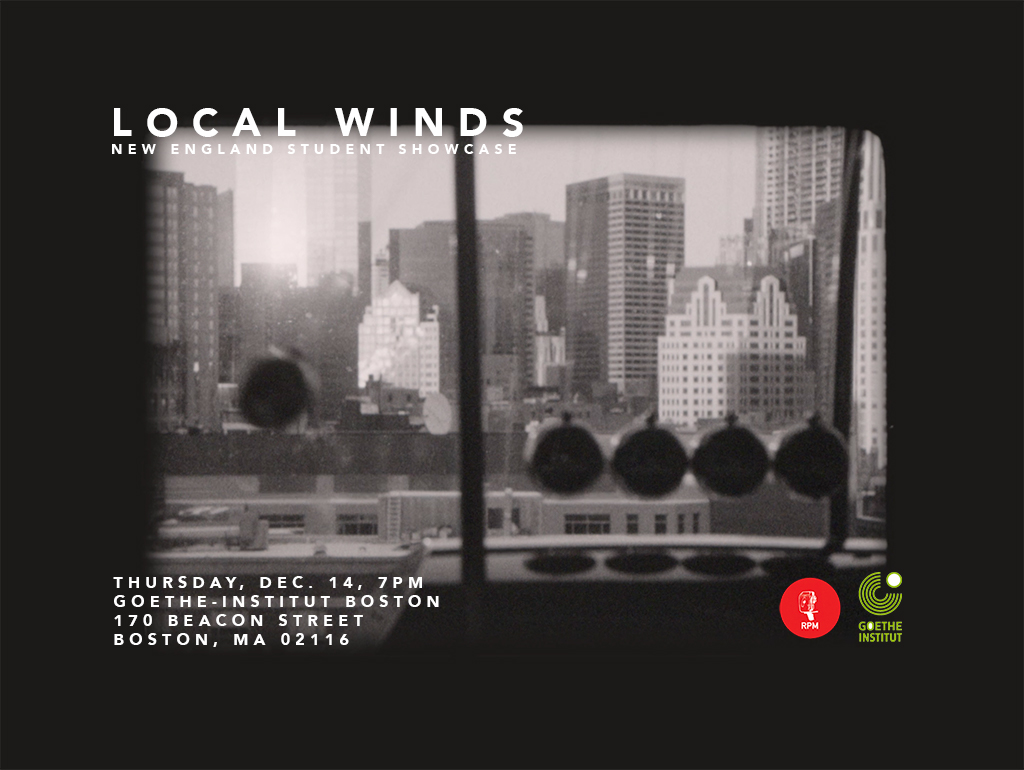
"Time is a loop", I wish - Yue Hua
Emerson College, 16mm, B&W , sound, 3:28 mins
A personal poetic film composed of hybrid media of 16mm and motion graphics.
“When I was little, time was slow and I thought I could catch time...Now I made a wish.” The filmmaker transcribes feelings on time and loss with toys, wobbly cradle Balance Balls, and light and shadow.
Yue Hua/华越 is an artist and filmmaker based in Boston, focusing on visual storytelling and intermedia artwork. Her work ranges from narrative shorts, experimental films, expanded cinema, and collage artwork.
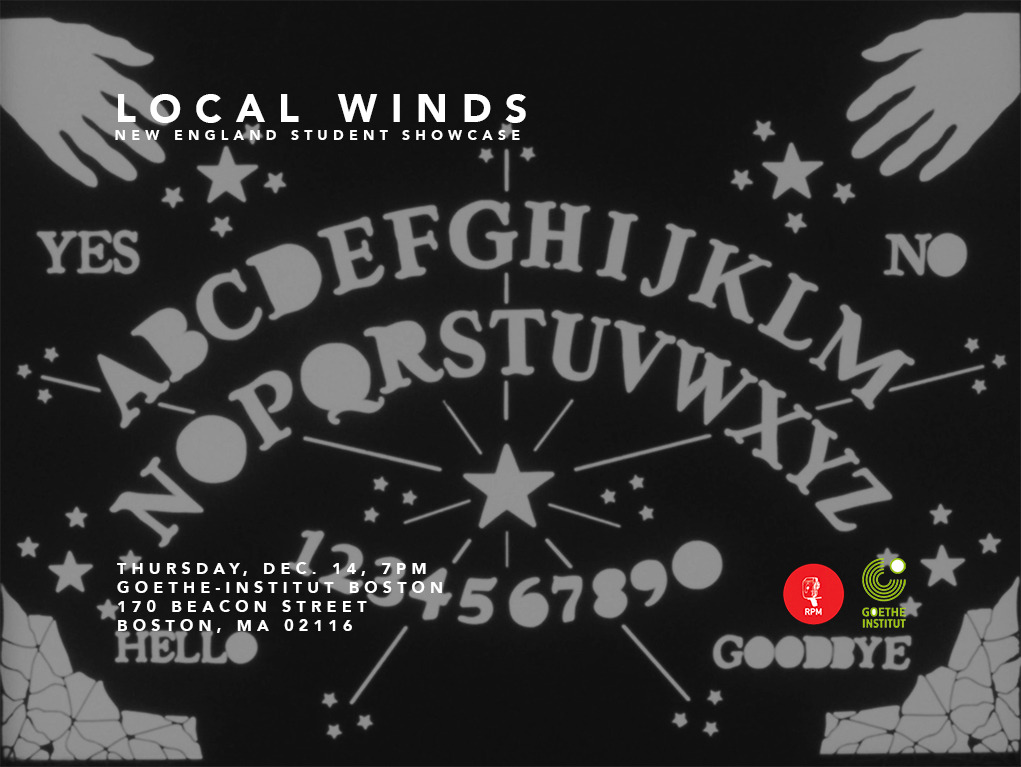
Séance - Charlie De Koster
MassArt, 16mm, B&W, sound, 8 mins
Séance is a film about feeling like you're speaking from beyond the grave.
Charlie De Koster is a non-binary filmmaker from Boston, currently attending Massachusetts College of Art and Design. They make work that addresses ideas of home, remembrance, and lost media – exploring how these concepts interact with identity. Presently, they are a Teacher’s Assistant to Professor Adam Savje for his VFX Alchemy class, in which students create visual effects with a variety of analog and contemporary animation tools. They relish working with the optical printer and the Oxberry animation stand, which allows them to push their work further and has inspired a love of analog film in their practice. Their work has been showcased in a Grrl Haus Film program at the Brattle Theatre in Cambridge, MA.
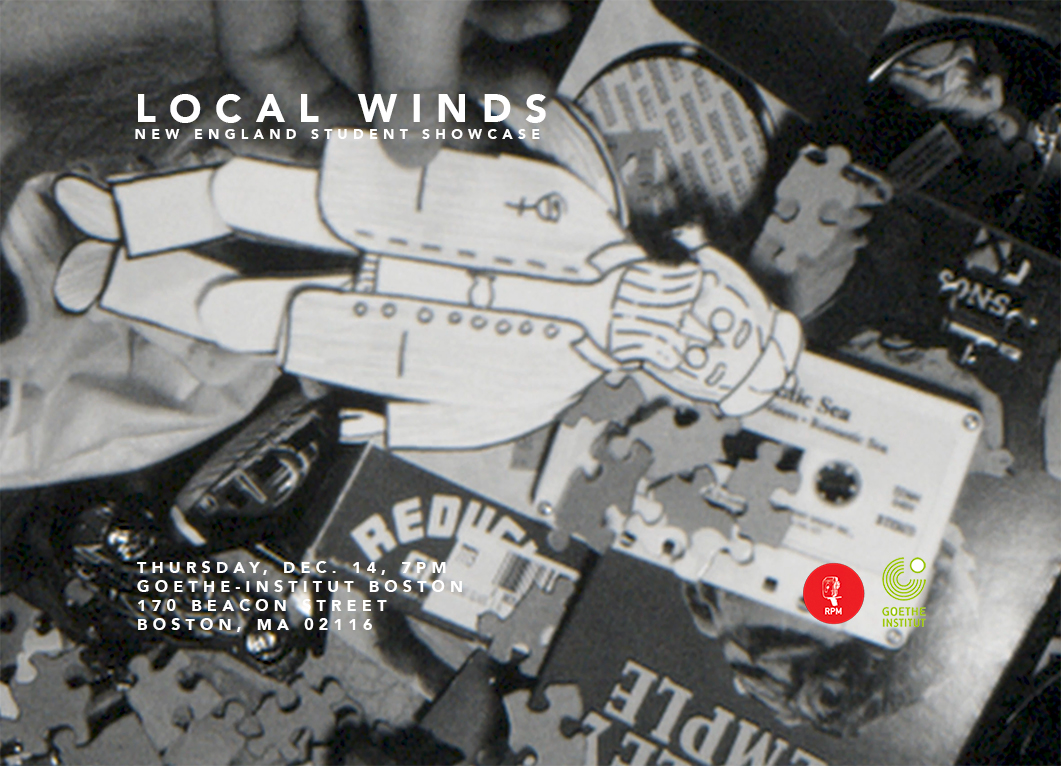
Headlands - Cecelia Clare Meade
Emerson College, 16mm, B&W, sound, 4:37 mins
An elderly person goes on a journey through their childhood as they grapple to grieve their youth.
My names Cecelia Clare Meade, I am from the Bay Area California and now live in Boston attending Emerson College. I love drawing, filmmaking, animation and all thing's creative.
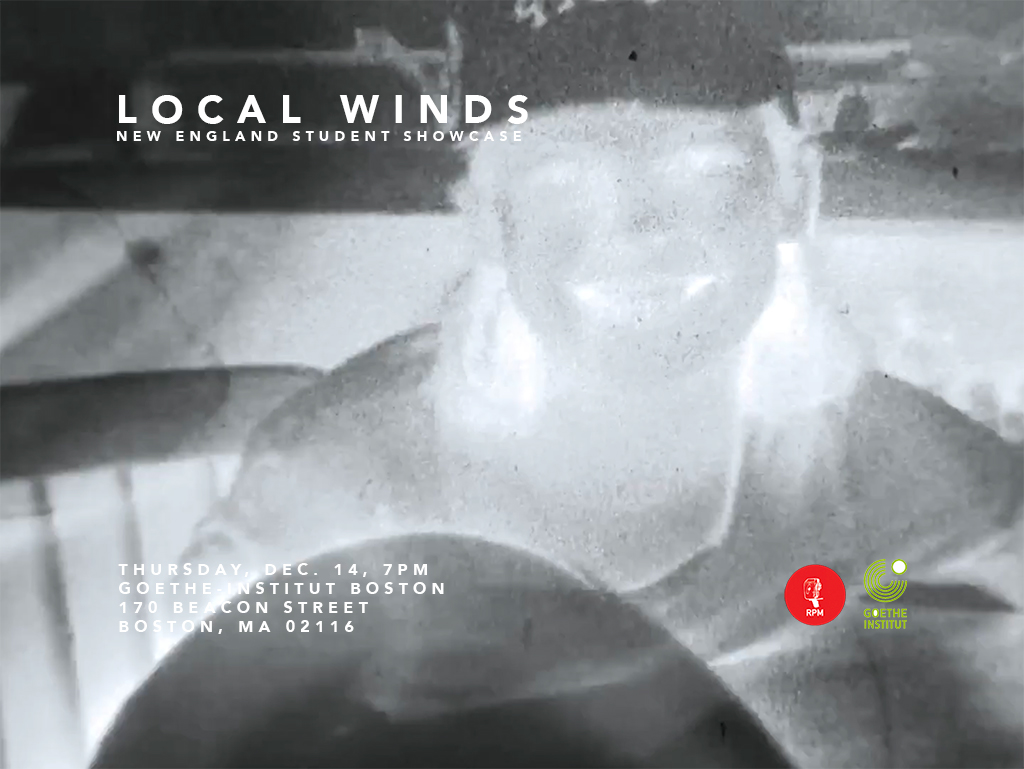
Menorrhagia - Claire Maske
Emerson College, 16mm to HD, B&W, sound, 5:36 mins
A personal documentary reflecting on shame and menstruation through an experience with a little-researched condition called menorrhagia.
Blending documentary and studio art practices, my work explores themes of illness, anatomy, grief, and mortality. I am largely interested in the body and all the ways it can mutate, deviate, and, ultimately, fail. I typically begin with a piece of documentary audio, whether that be an interview, a performance of nonfiction writing, or myself speaking in voiceover. Then, using combinations of animation, handwriting, 16mm footage, digital footage, and archival materials, I build up visuals which supplement and guide the interpretation of the audio. The visual choices are driven by emotion; I am less interested in a documentary rooted in fact than one which most accurately portrays an experience from the perspective of the person living it. From cancer to menstruation to neurological disorders, I often use film as an attempt to recreate the subjective experience of physical suffering, or to grapple with the emotions that come along with sickness and loss. These films can serve not only as a site of healing for those sharing their experiences but as a way for myself and audiences to wrap their minds around the possibility of their own body’s demise. In order to address power imbalances often present in traditional documentary modes, my work often lands at the intersection of personal and co-created film, and is rooted in feminist, queer, and disability studies. I am inspired by women who explore personal stories in relation to larger philosophical questions- Bell Hooks, Barbara Hammer, Agnes Varda, Jeanette Winterson, Lynne Sachs- and am influenced by sketchbook and scrapbook aesthetics. In order to offset the emotional intensity of this work, I take on lighter projects involving 16mm and stop motion in interim periods. These projects serve as containers to learn and play, helping me expand the tools available to me as I continue to build a body of work that attempts over and over again to approach and understand death.
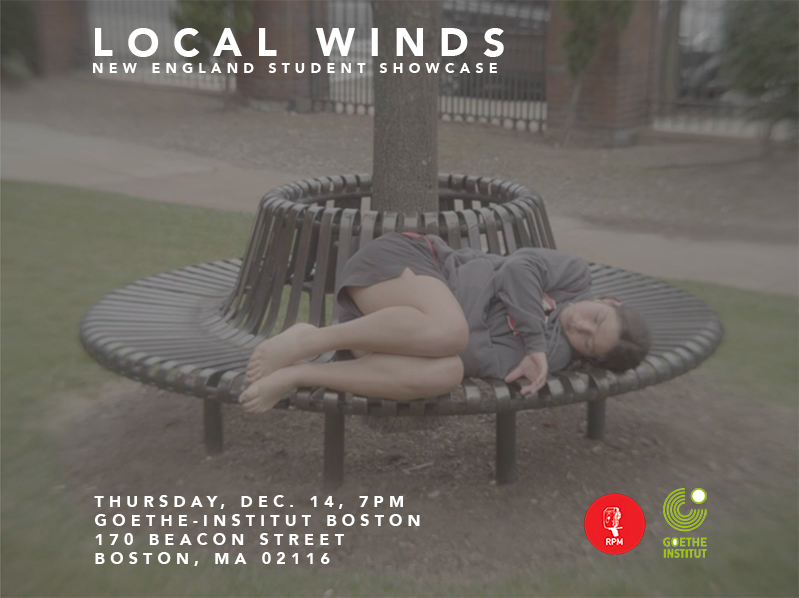
September Space - Bree Andruzzi
MassArt, HD, Color, sound, 5:47 mins
Still form agitates tension in space with no release of force. Elongated human isolation creates concentrated stress. When interacting with each other, they seek comfort that is implausible and causes both to slip.
Bree Andruzzi is a moving image artist based in Brooklyn, NY. She seeks to balance the cinematic relationship between herself and her audience, and while doing so, investigates identity, ambiguity, and psychological effects from audio-visuals. She uses both film and video in her practice and considers the functionality with these tools to further her ideas. Andruzzi received her Bachelor’s degree in the Film and Video department at Massachusetts College of Art and Design Spring '23 and
has previously studied at the University of Michigan, Penny W. Stamps School of Art and Design.
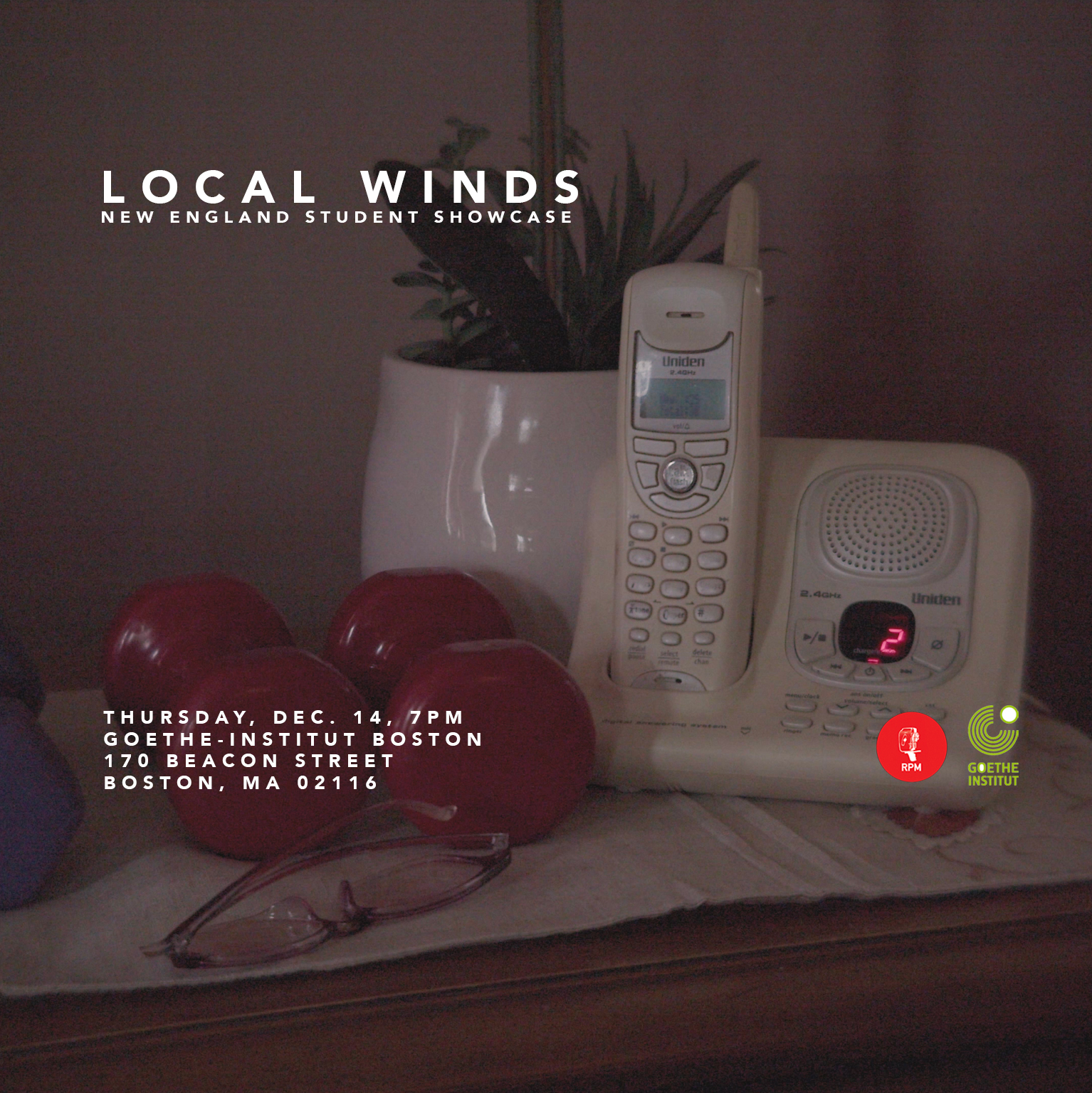
Room Tone - Ren Evans
MassArt, Digital, color, sound, 3:51 mins
Room Tone is an experimental sound and space piece inspired by Alvin Lucier's I Am Sitting in a Room. This piece explores the reverb and acoustics which create the auditory finger print of a childhood home.
Ren is an interdisciplinary artist and filmmaker/directress based in Boston, MA. Her work is imbued with + dictated by her love for the transcendent nature of visual storytelling and the medium of moving image. She is deeply inspired by nostalgia and expressing the intangible and unreal through film and design. With a background in fine arts, Ren is gravitated to experimentally investigating moving image and how to use the medium in innovative and evocative ways.
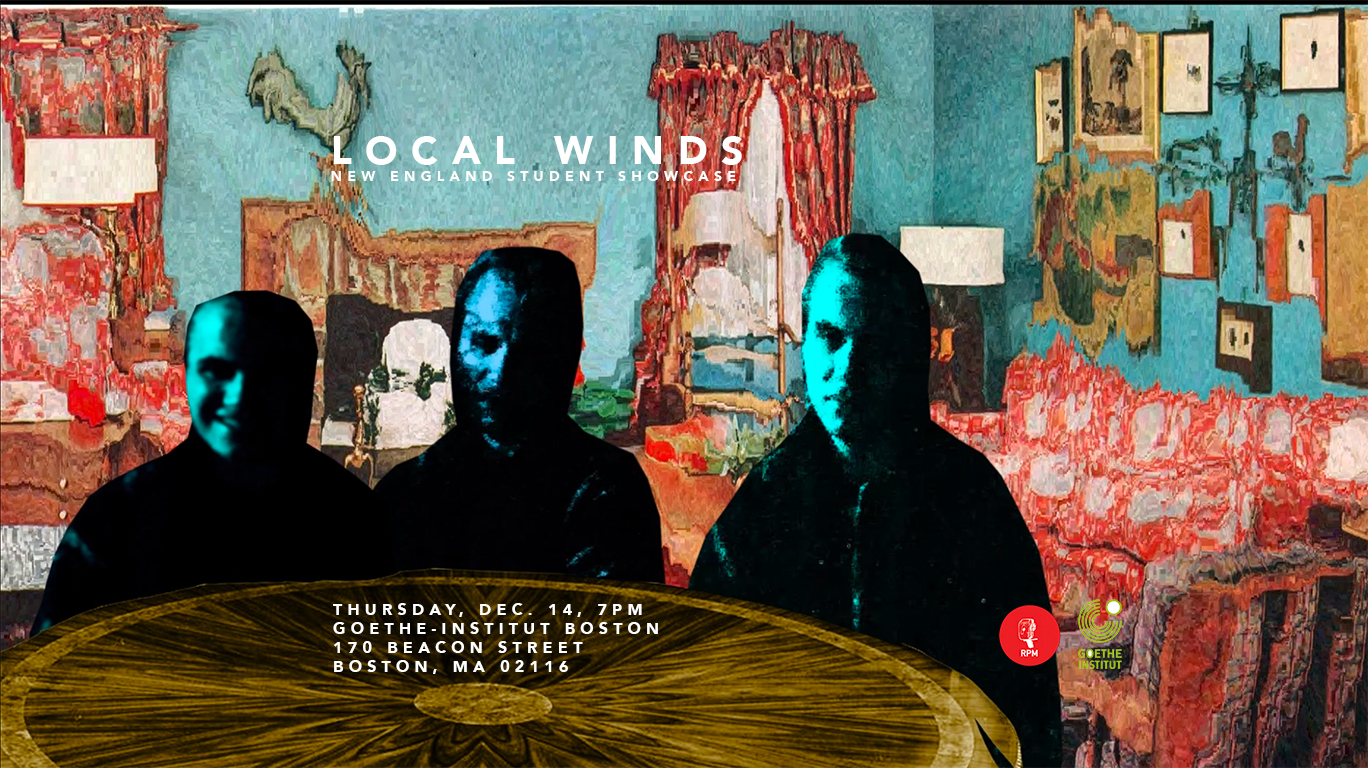
Time For Supper -Kyle Lindfors
Fitchburg State University, Digital, color, sound, 1:30 mins
Recorded some film and messed around with it. A collage of some expression or other.
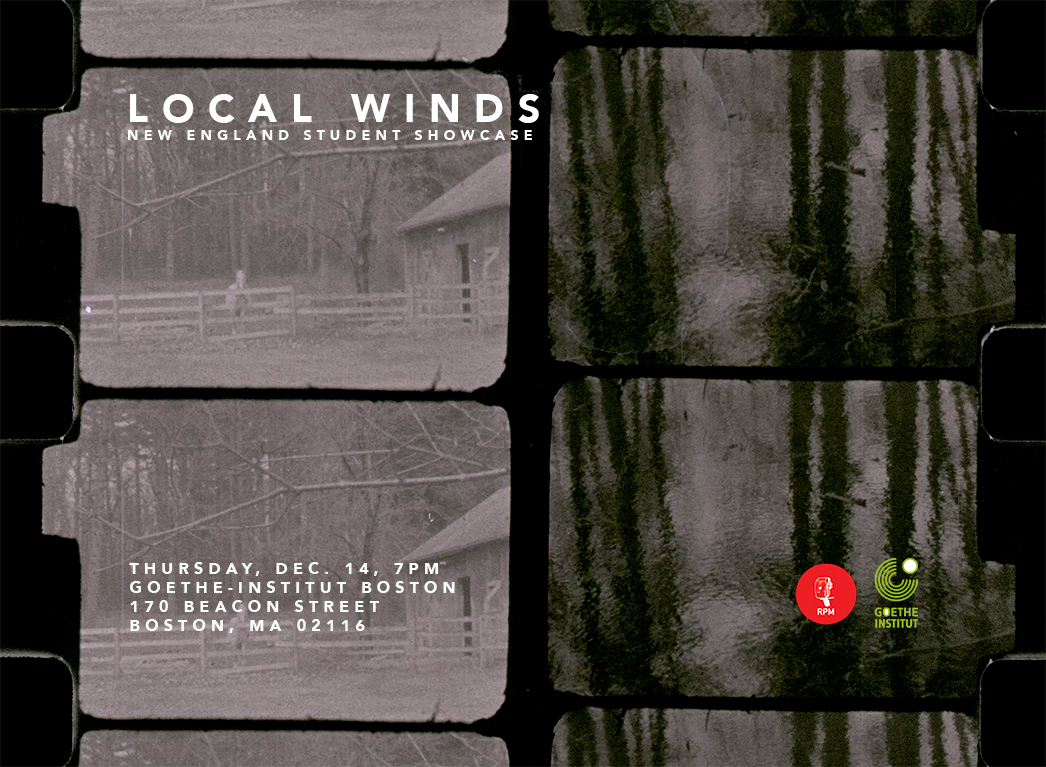
Sorry it took me so long.. to See -Leticia Sidney
UMass-Boston, 8mm to HD, B&W, sound, 1:57 mins
In the short film, Sorry it took me so long.. to see, I experimented for the first time with regular 8mm film. This film became a visual sort of diary entry about a horse I’ve driven by countless times in the last five years that I had never stopped to see up close.
Leticia Sidney is based in Boston and works primarily with printmaking and video. She approaches her art experimentally and as a means of understanding and responding to what is familiar but unclear. Her work is personal and particularly interested in exploring memory and abstraction. With video, she enjoys experimenting with rhythm and displacement of image and sound.
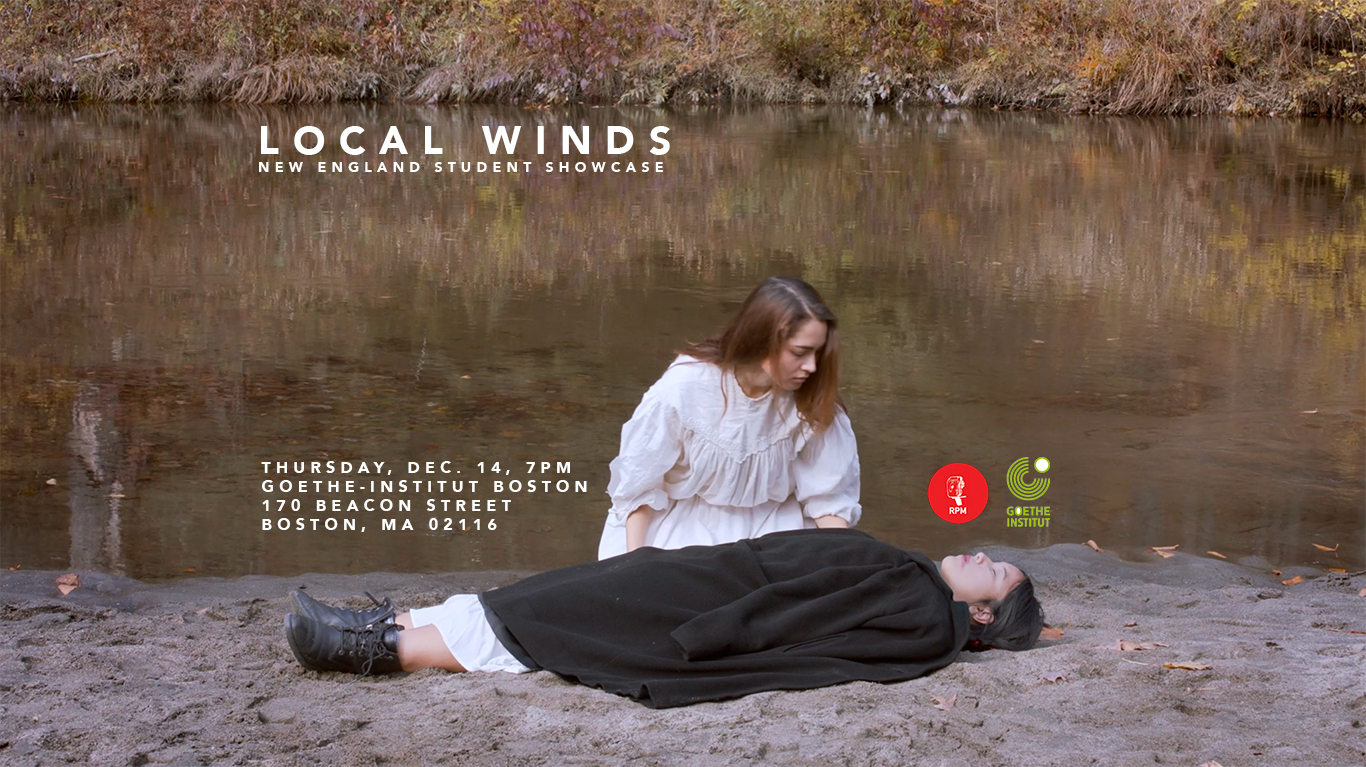
Our Shadows - Polly Chesnokova
Dartmouth College, HD, Color , sound, 16:05 mins
Facing the imminence of an arranged marriage, a lesbian couple navigates their
future in Western Ukraine, guided by the centuries-old Hutsul myths
Polly Chesnokova is a cinematography student in their senior year at Dartmouth College. Originally from Kyiv, Ukraine, Polly takes much inspiration from Eastern European cinematic traditions. As a non-binary artist, Polly strives to explore the themes of gender-fluidity and gender-neutral society through their films and other visual mediums.
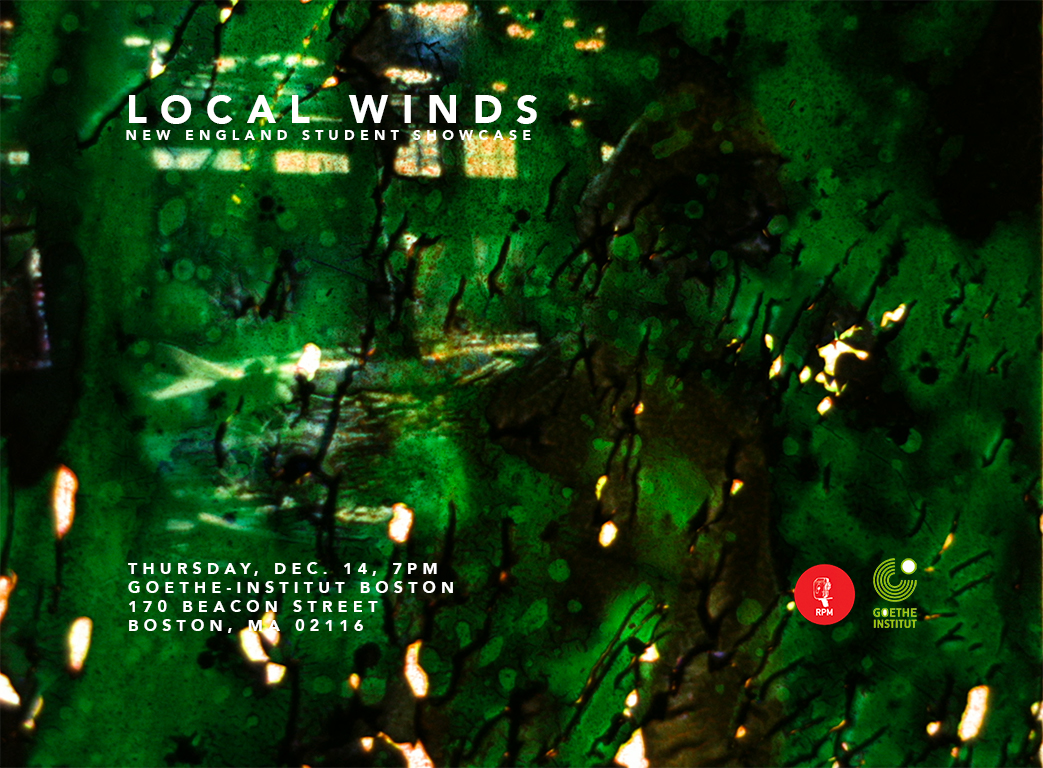
Fragments from the End of History - Chris Connell
MassArt, 16mm, color, sound, 6:48 mins
Sixteen mm footage of a man wandering a wasteland treated with bleach and washing soda, then painted, set to audio drawn from data-moshed clips from The Curse of Frankenstein. The film is a meditation on the concept of the end of history from Hegel's and Mary Shelley's context of the Napoleonic era to the creation of the atomic bomb at the end of World War 2, to the present, and considers the immanence of the apocalyptic future in the origins of bourgeois society.
I seek to reflect on the place of the present in relation to history, both in our responsibilities to the past and the possibility of an emancipated utopian future. To this end I explore the relationship of war and media, the relationship of cinema to literary traditions, and the generalized crisis of cinema's evidentiary function.
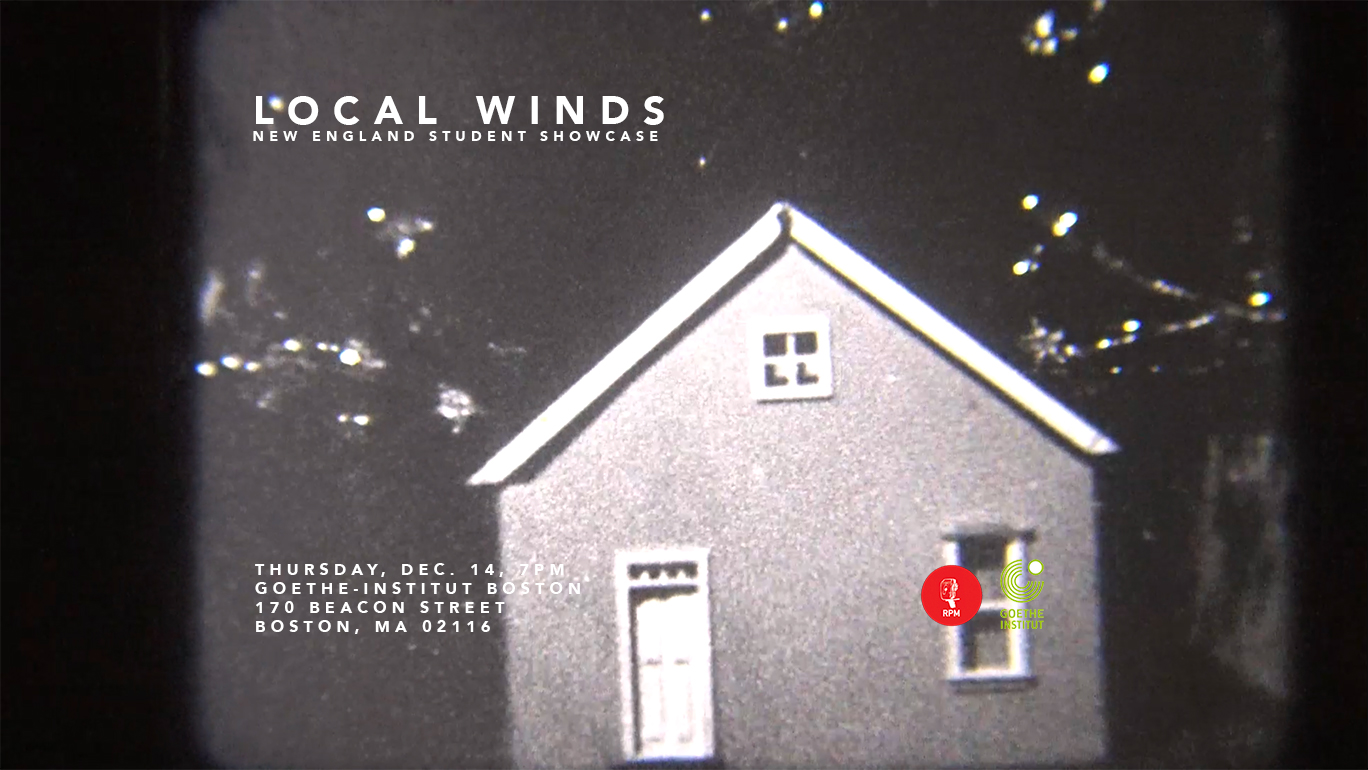
Can You Carry Me - Tess Meersman
Emerson College, 16mm, B&W, sound, 5:47 mins
Can you carry me? uses old familial artifacts such as super eight film, mini dv tapes, and old teeth to examine generational remembrances and the influence that the passing down of memory plays on the development of identity.
Tess Meersman is a recent graduate of Emerson College having studied Media arts Production, Literature, and Women's, Gender, and Sexuality studies. Her areas of concentration lie in Producing, Development, and Experimental Filmmaking. Her personal works mainly focus the concept of the body, gender, and memory.
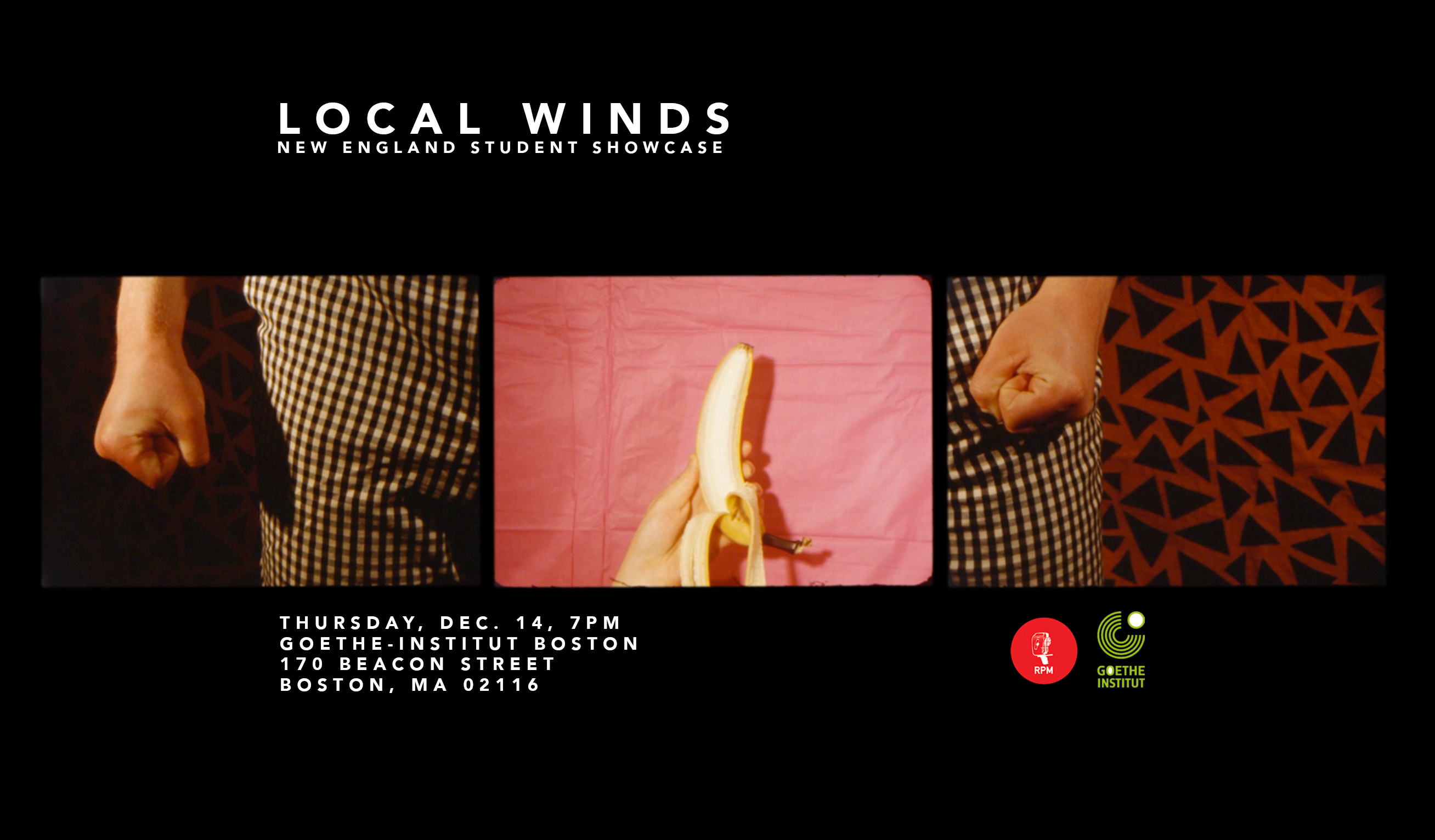
Never Forget Death - Tomás Orrego
Emerson College, 16mm to HD, color, sound, 2 mins
The destruction of the banana is a delicious action reaction that brings forth dreams of vulnerable joy to the subject.
Inspired by the films of Kenneth Anger.
Tomás Orrego is a peruvian filmmaker, visual artist, designer, and musician with a background in architecture. Spanning animation, design, collage, and installation, his work touches in a very idiosyncratic way the construction of male heterosexuality and the disruption of innocence. By using free association and an absurd approach, these themes are explored in an irrational way, eschewing logic, and embracing the drowsy consciousness of dreams. He currently lives in Boston, taking part in the MFA Film and Media Art program at Emerson College, trying to maintain a healthy lifestyle by exercising and eating.
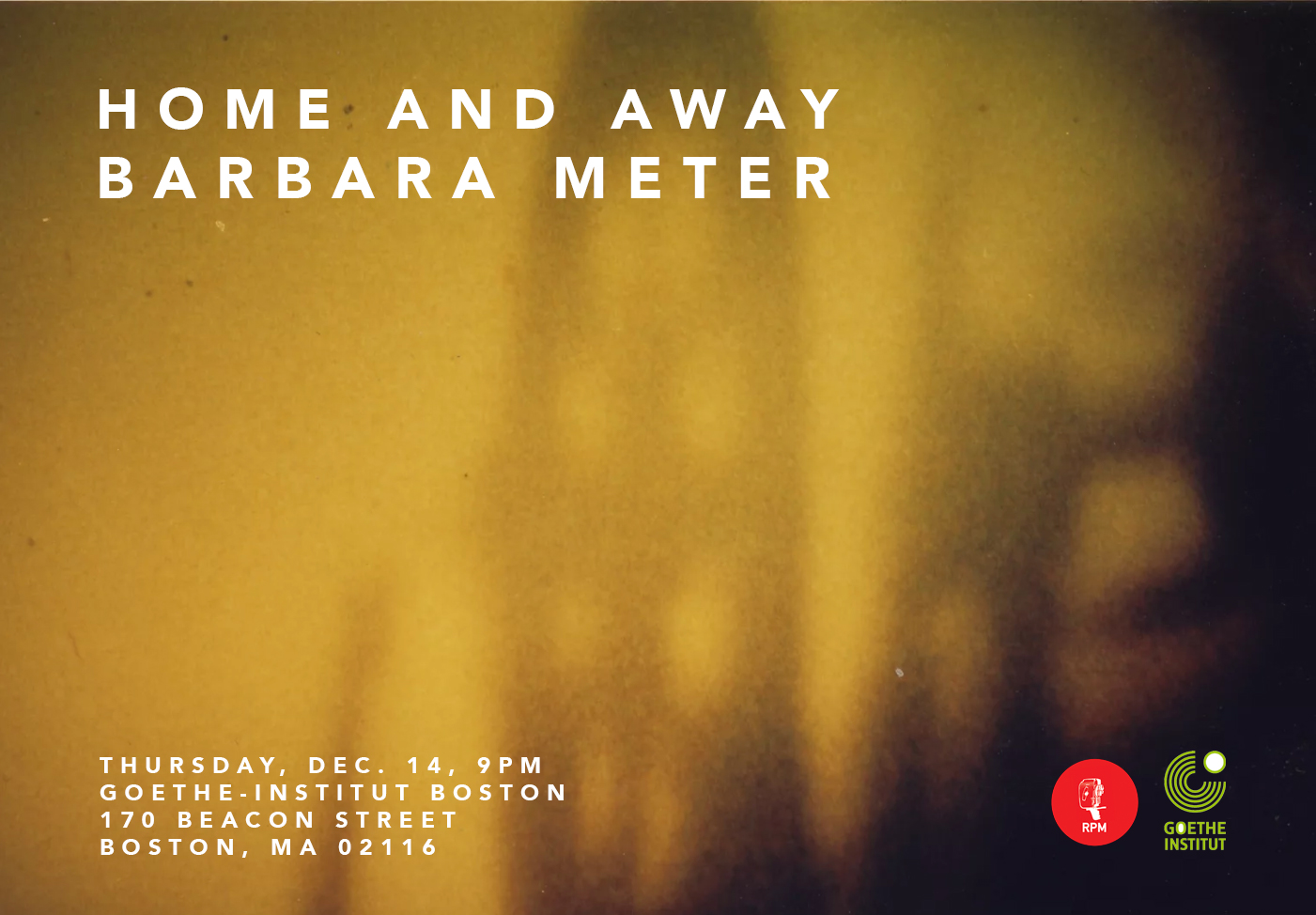

Curated by Robin Roblee-Strauss
Home and Away features one biographical documentary and four short avant-garde
films by filmmaker, Barbara Meter. As one of the first women to study at the
Netherlands Film Academy in the 1960s and co-founder of Amsterdam's Electric
Cinema, a bastion of avant-garde film and ideas in the 1970s, Barbara has been a
pioneer in the production and promotion of experimental filmmaking in the Netherlands.
In a 1971 interview, Barbara describes her work as “pure films”, conveying “thoughts
and feelings by pure movement, a pure image that may flicker or be blurred, and by
intervening in the process of developing and printing the film.” Through her innovative
use of optical printing methods, she seamlessly massages, and reworks found sounds
and images: combining them with her personal archive. She remolds these documents
into distinct, deeply personal sense worlds.
This program showcases a range of works made throughout Barbara’s artistic career
which echo deep psychological themes tied to the destabilizing effects the Second
World War wrought on her family life and personal sense of home. Her notion of
“wanting to belong to something you can’t reach” is explored prismatically in this film
program by showing a biographical documentary work which explore her family’s history
during WWII alongside experimental films that represent the universal feelings of
yearning to belong, the pain of separation, the distance felt in estrangement, and the joy
of homecomings.
Throughout Barbara’s life she has continued to create work, program screenings, and
teach and lecture on film. Her work has been shown at Rotterdam Film Festival, BFI
London Film Festival, Stedelijk Museum Amsterdam, Filmmuseum Amsterdam, Tate
Gallery London, Cinematheque San Francisco, the Museum of the Moving Image in
New York City among many other venues in Europe. Home and Away is the first solo
exhibition that combines her experimental work alongside her documentaries and the
second solo exhibition of her films in North America.
Additional information about Barbara Meter
can be found at her website (https://www.barbarameter.com/) and
via Light Cone
(https://lightcone.org/en/filmmaker-
470-barbara-meter).
From The Exterior
1970, 16mm, color, silent, 9 min
Up To The Sky, And Much Much More
2015, video, color, sound, 36 min
Convalescing
2000, 16mm (from super 8), color, silent, 3 mins
Quay
2003, 16mm, color, sound, 4 mins
Ariadne
2004, 16mm, color, sound, 12 mins
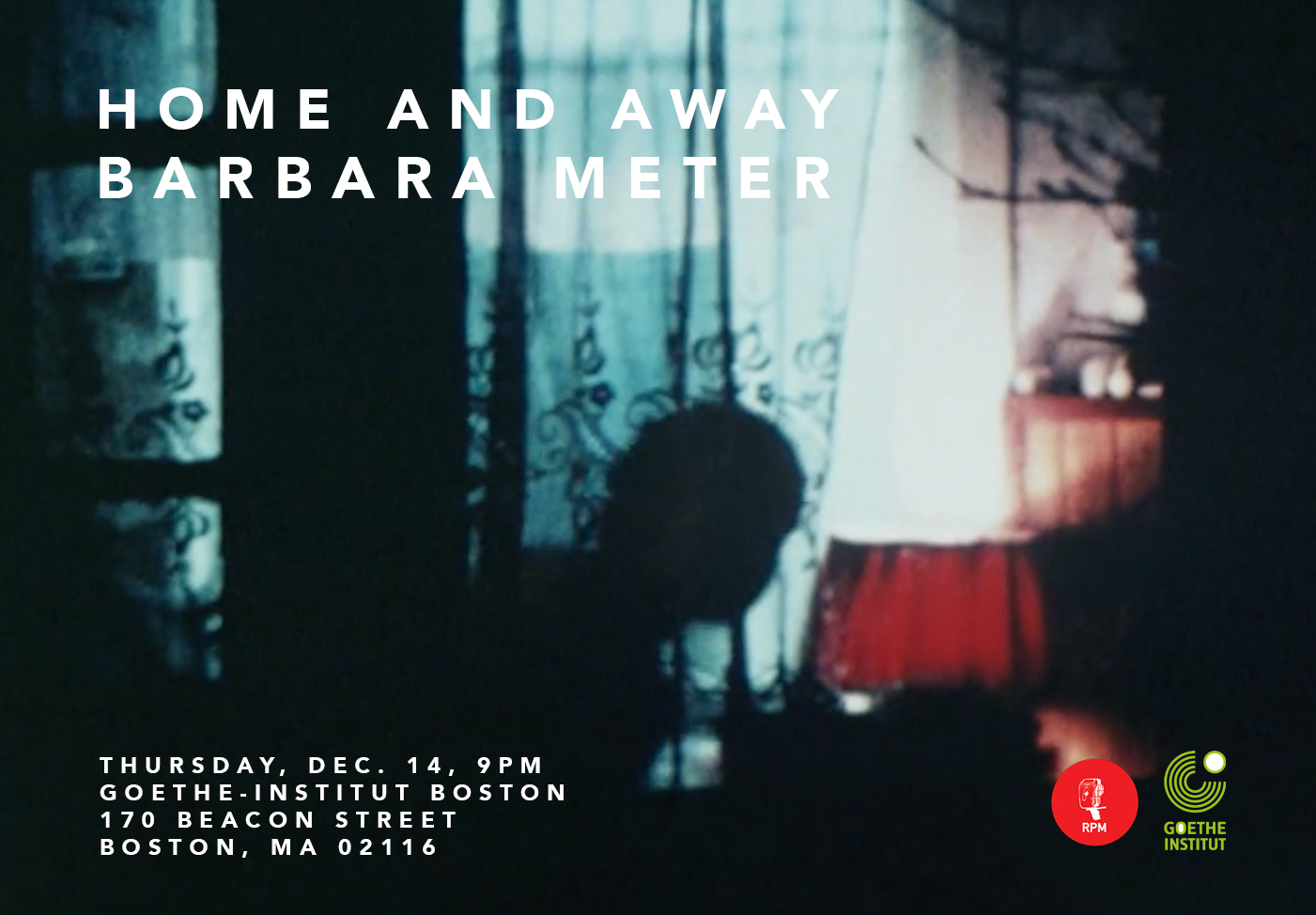
From The Exterior
1970, 16mm, color, silent, 9 min
A nocturnal view of existences left to themselves, seen from the other side. A handheld
camera peers covertly through open-curtained windows, overlapping lives: faces,
silhouetted figures, rouge lampshades, houseplants, blinking TV sets, cigarettes,
poodles, and amber orbs – unobtrusive fragments of an evening spent at home.
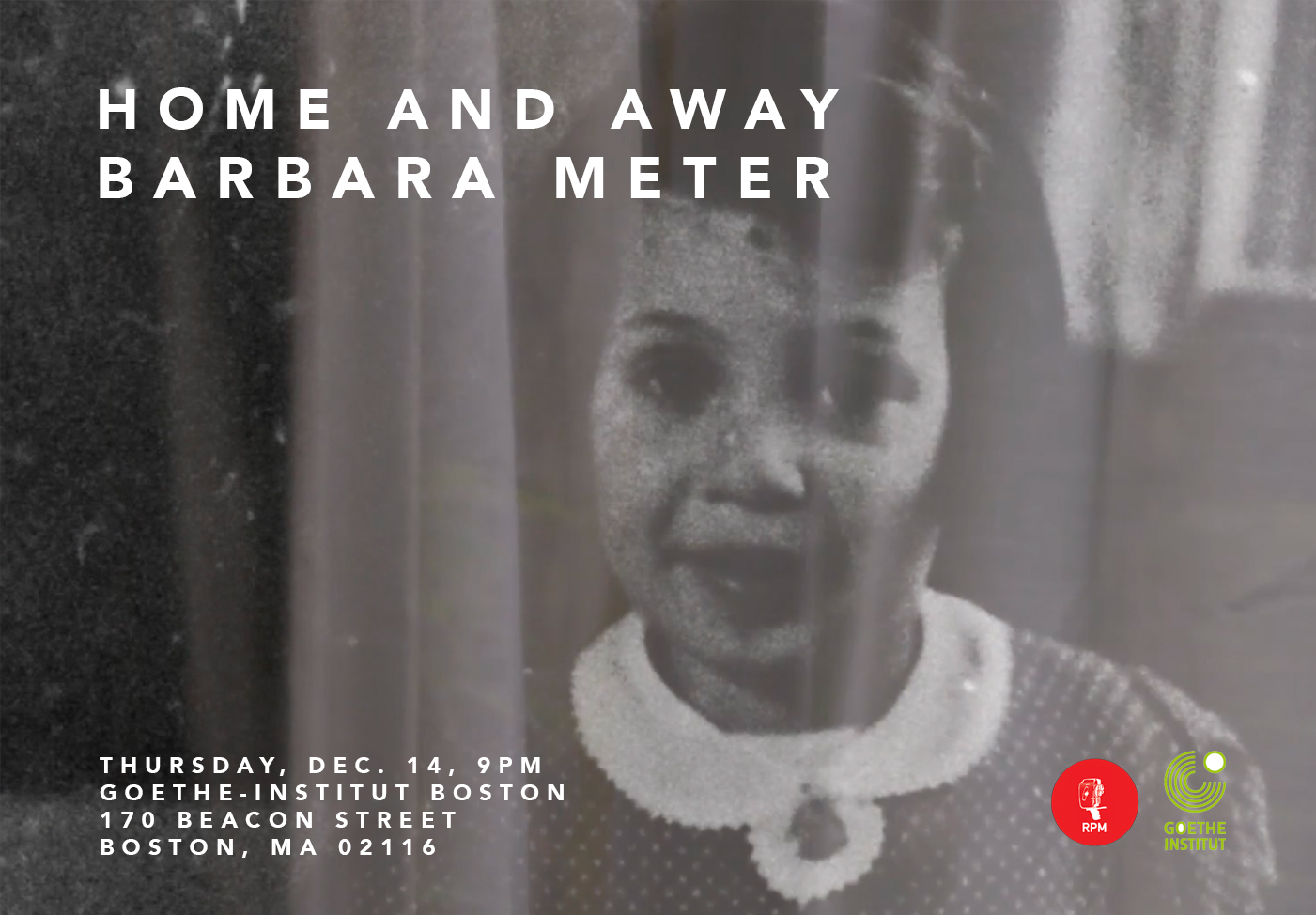
Up To The Sky, And Much Much More
2015, video, color, sound, 36 min
Barbara Meter tells the life story of her father Leo Meter, using slides, photographs,
drawings, and the letters her father wrote to her after being arrested by the Gestapo and
deported to the Eastern Front. Barbara Meter reflects, "There are not many testimonies
from Germans who resisted fascism – my father was one of them, and I could tell it. So,
I dug up what I found of him – photos, letters, drawings, stories – and recorded it.
During the making of the film, I felt that step by step I came closer to who he had been,
and also closer to the love and protection I experienced from him – even if I was too
little to remember his presence clearly. In Poland, I was very close to where he had
died. There were only empty fields of grain and old broken houses ... such an estranged
feeling that there were no signs left of the cruel fighting that had happened there. For
myself, this gap has been filled, and I hope for some others too."
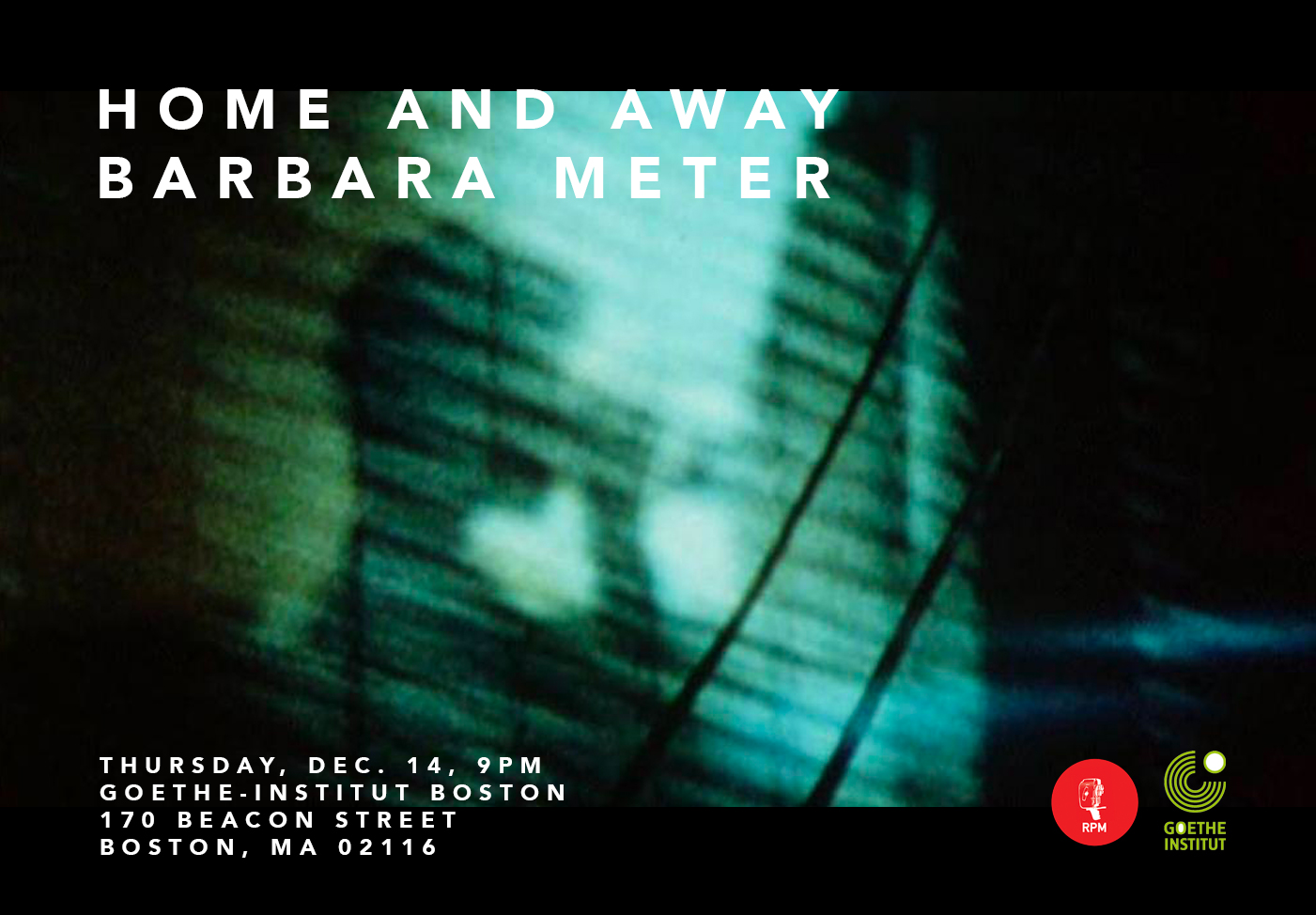
Convalescing
2000, 16mm (from super 8), color, silent, 3 mins
Confined to a room, one reads, looks, and listens. In these moments of distance from
the world, Barbara Meter considers “the blue, the light of the television, the blue, the
book, the patterns, the light, the blue. Time to appreciate how much that really is.”
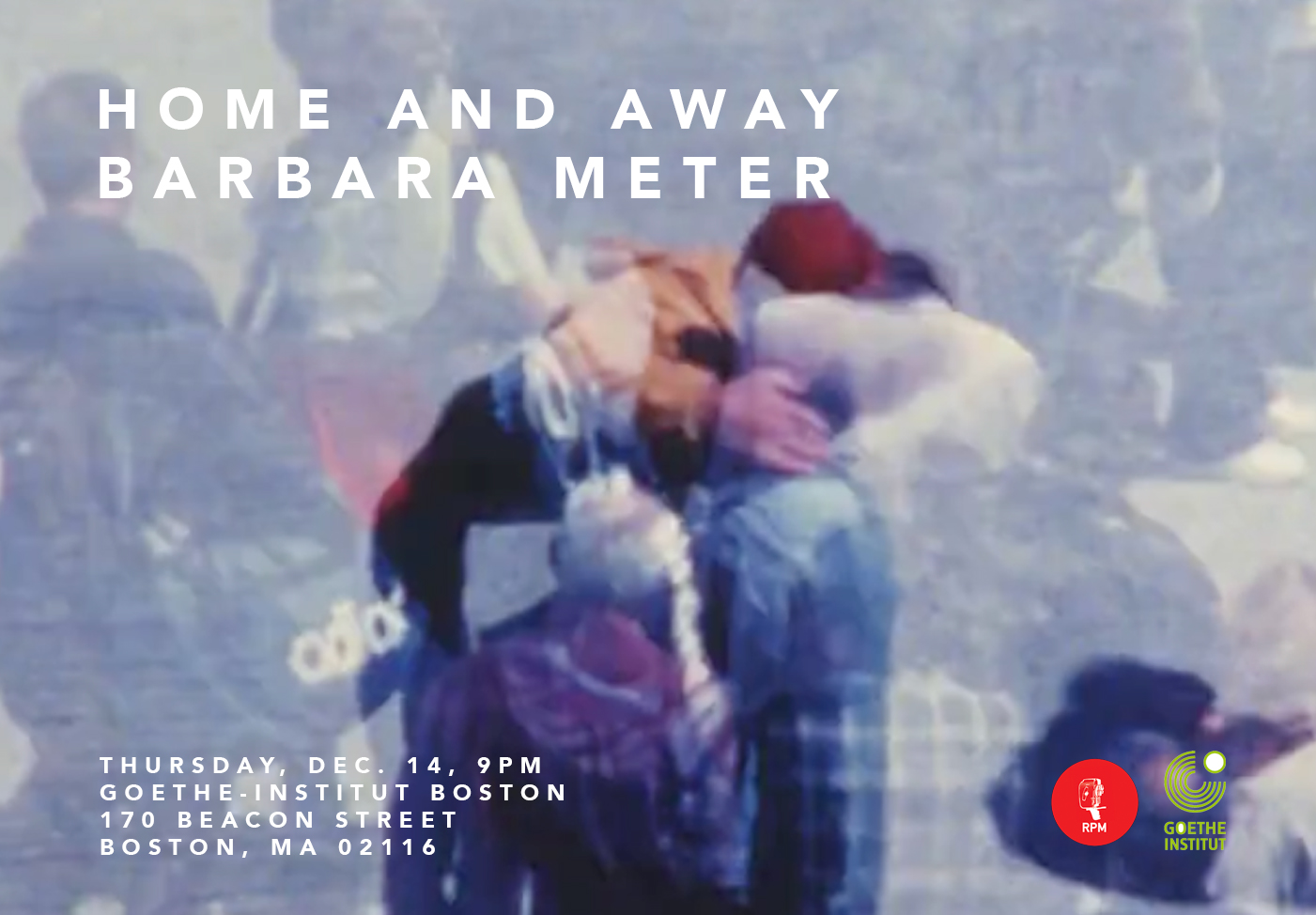
Quay
2003 16mm, color, sound, 4 mins
A study of arrivals, maritime comings and goings: vessels dock, sailors throw ropes,
drop anchor, and people poised on platforms await friends or families. Then the
choreography of reunions begins. Barbara writes: “Arriving at an island is a joy forever.
The magic of ships when they dock, the expectation on the quays, the exciting theatre
of the people with and without their vehicles, the saying hello and goodbye are everyday
experiences on the Greek islands.”
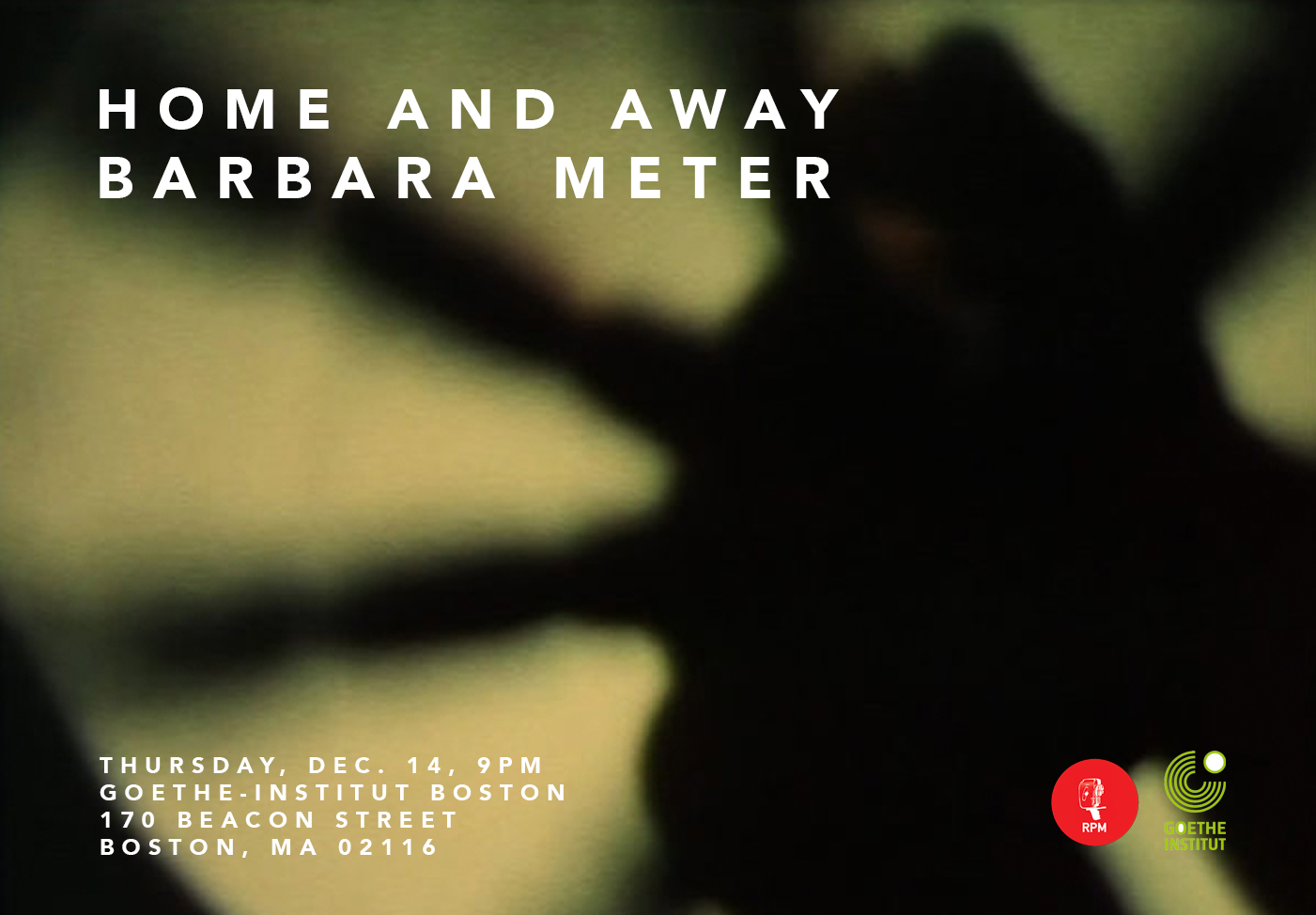
Ariadne
2004, 16mm, color, sound, 12 mins
A haptic hymn to longing restlessness and desire – movement of the wheels, a spool of
string, sprockets, feet, and hands suggests cycles of renewal and reinvention. An
anonymous woman– could it be Ariadne who gave Theseus the thread to find his way
out of the labyrinth? Or perhaps one of the ancient fates spinning the yarn of destiny…
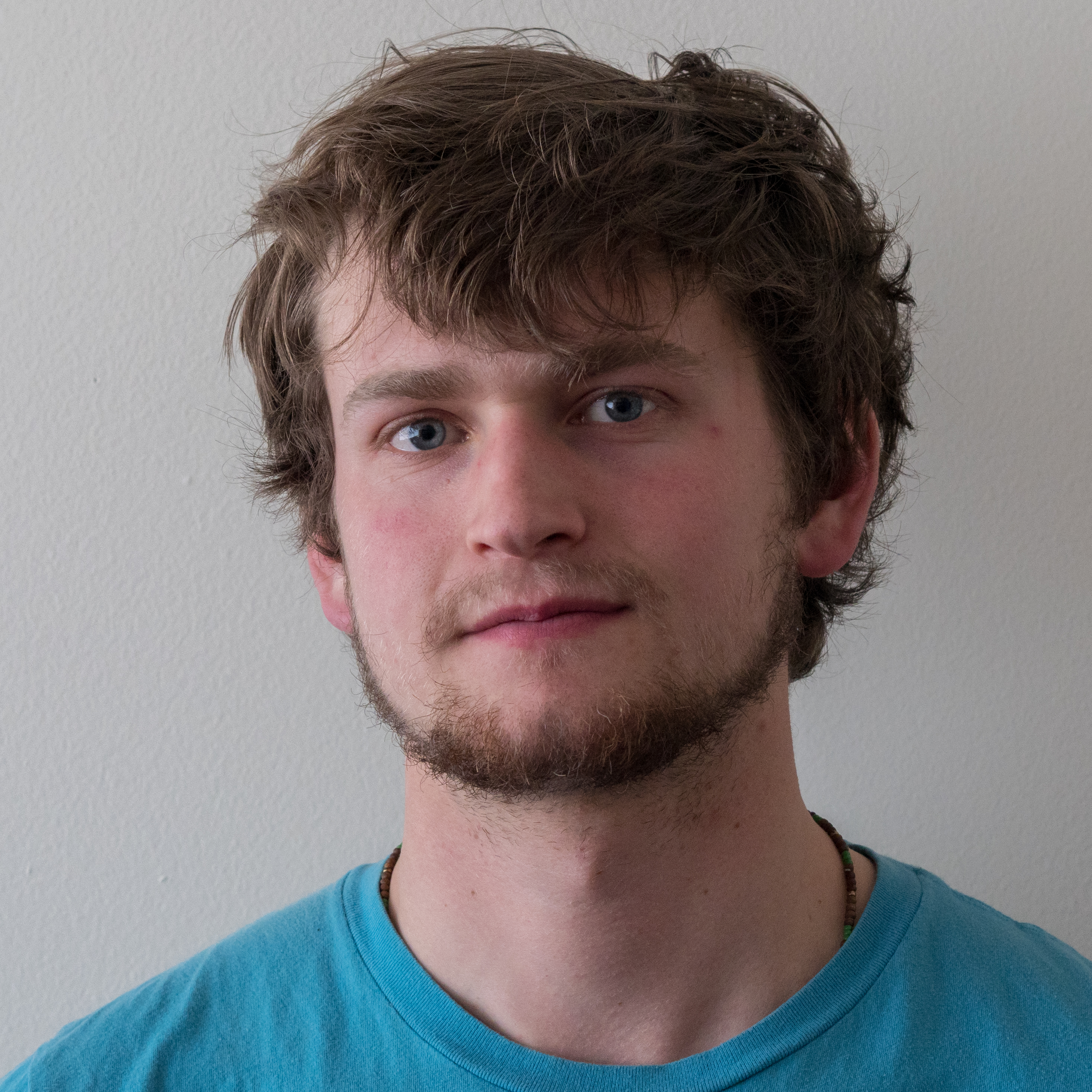
Guest Curator Robin Roblee-Strauss is a lebenskünstler—a life-artist! Born and raised in the woodlands of Western Massachusetts. he has always gravitated towards filmmaking as an approach to research that combines scholarly investigation with artistic expression. At Hampshire College he studied non-fiction & experimental film, psychology, and critical disability studies. Robin has assisted several experimental filmmakers including Abraham Ravett, Barbara Meter, Ansuya Blom, and Abigail Child. He worked at Anthill Sound Design in the Netherlands as a sound editor and most recently as a research assistant on an archival documentary series directed by Luke Meyer. Curation is a new facet of his practice motivated by his investment in the haptic qualities of sound and the moving image works as a way to communicate through the senses—articulating alternative ways of knowing.
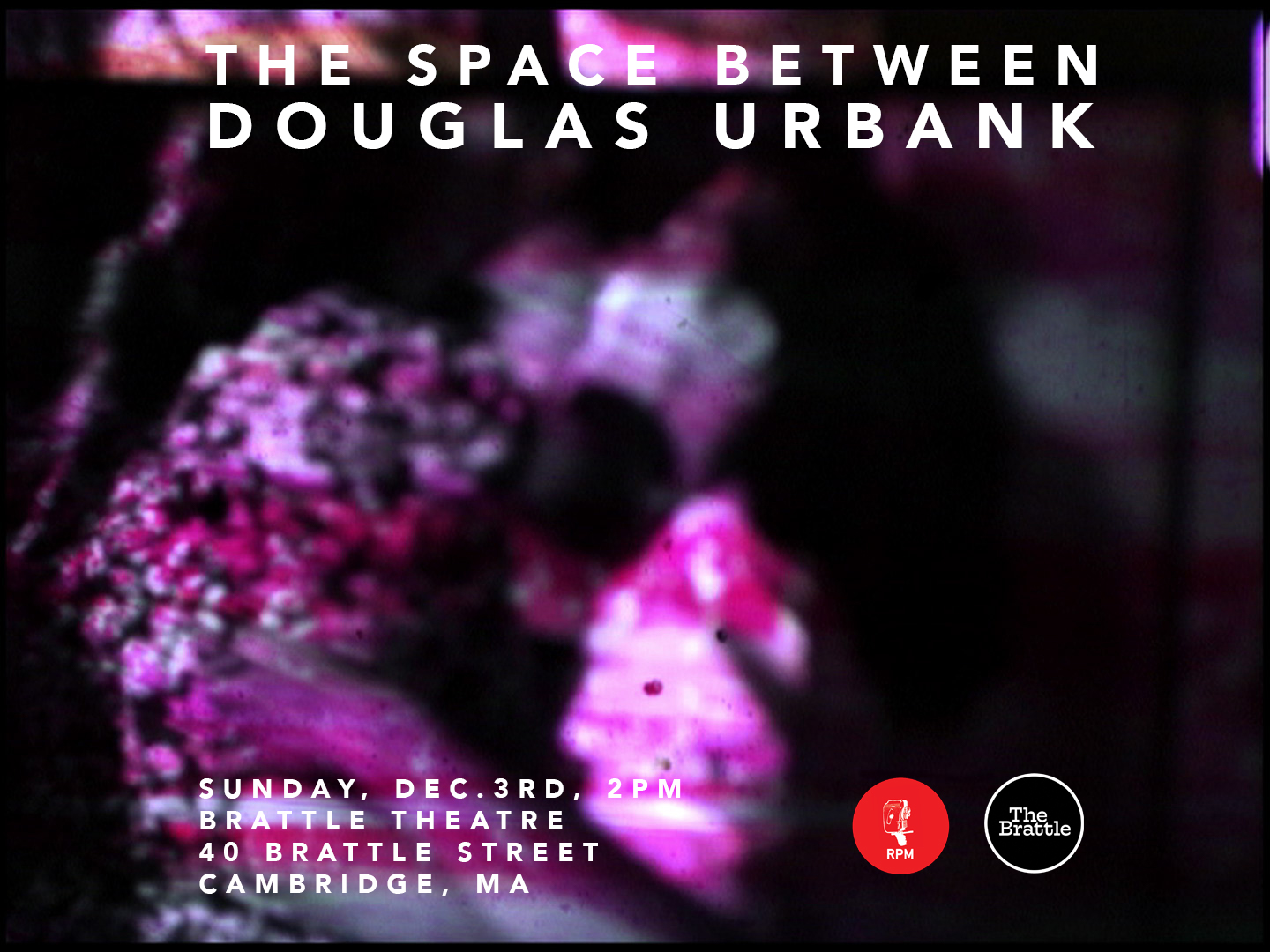
Douglas Urbank, based in Boston, Massachusetts, is an artist with a background in sculpture and drawing who began to experiment with filmmaking in 2008.
His short films have screened in festivals and curated programs, including nationally at Revolutions Per Minute Festival, Boston, Massachusetts;
Microscope Gallery and Millennium Film Workshop in New York; San Francisco Cinematheque’s Crossroads Film Festival; Moviate Underground Film Festival,
Harrisburg, Pennsylvania; Chicago Underground Film Festival; Engauge Experimental Film Festival, Seattle, Washington; and internationally at Mire Lab’s
PRISME festival, Nantes, France; and curated programs including, Zumzeig Cinema, Barcelona; Laboratorio Experimental de Cine program, Mexico City; Artist
Film Workshop, Melbourne, Australia; and others. He was a Massachusetts Cultural Council Artist Fellowships Film & Video finalist in both 2017 and 2019.
Beginning in 2001 he co-hosted a radio program devoted to experimental, improvisational, and other unconventional music and sound art.
He has been a member of Fort Point Theatre Channel, an independent theater company which brings together an ensemble of artists from the worlds of theater,
music, and visual arts. And he is a founding member of the AgX Film Collective. He is interested in cross-pollination between art forms on the fringes of
alternative culture: experimental music, film and theater.
Program: 65 minutes
Projection Format: 16mm film & Digital
Bathers
16mm, B&W, sound, 2019, 03:45
Oracle
16mm, color, sound, 2014, 07:20
Portrait
16mm, B&W, silent, 2017, 05:15
Small
16mm, B&W, silent, 2023, 04:30
Cartoon Dream
16mm to video, color, silent, 2023, 05:45
Hotel Cassiopeia: Algiers part 1
video, color, sound, 2013, 03:45
Splash
16mm to video, color, sound, 2012, 02:40
Skate
16mm to video, B&W, sound, 2019, 03:00
Cryptogram (v.5)
16mm to video, color, silent, 2022, 04:40
Move
16mm to video, B&W, sound, 2021, 04:40
3 Notes to a Redwood Tree
16mm to video, color, sound, 2023, 09:30
Sojourn
16mm to video, color, sound, 2010, 01:50
Post Screening Q&A
Alison Folland & Douglas Urbank

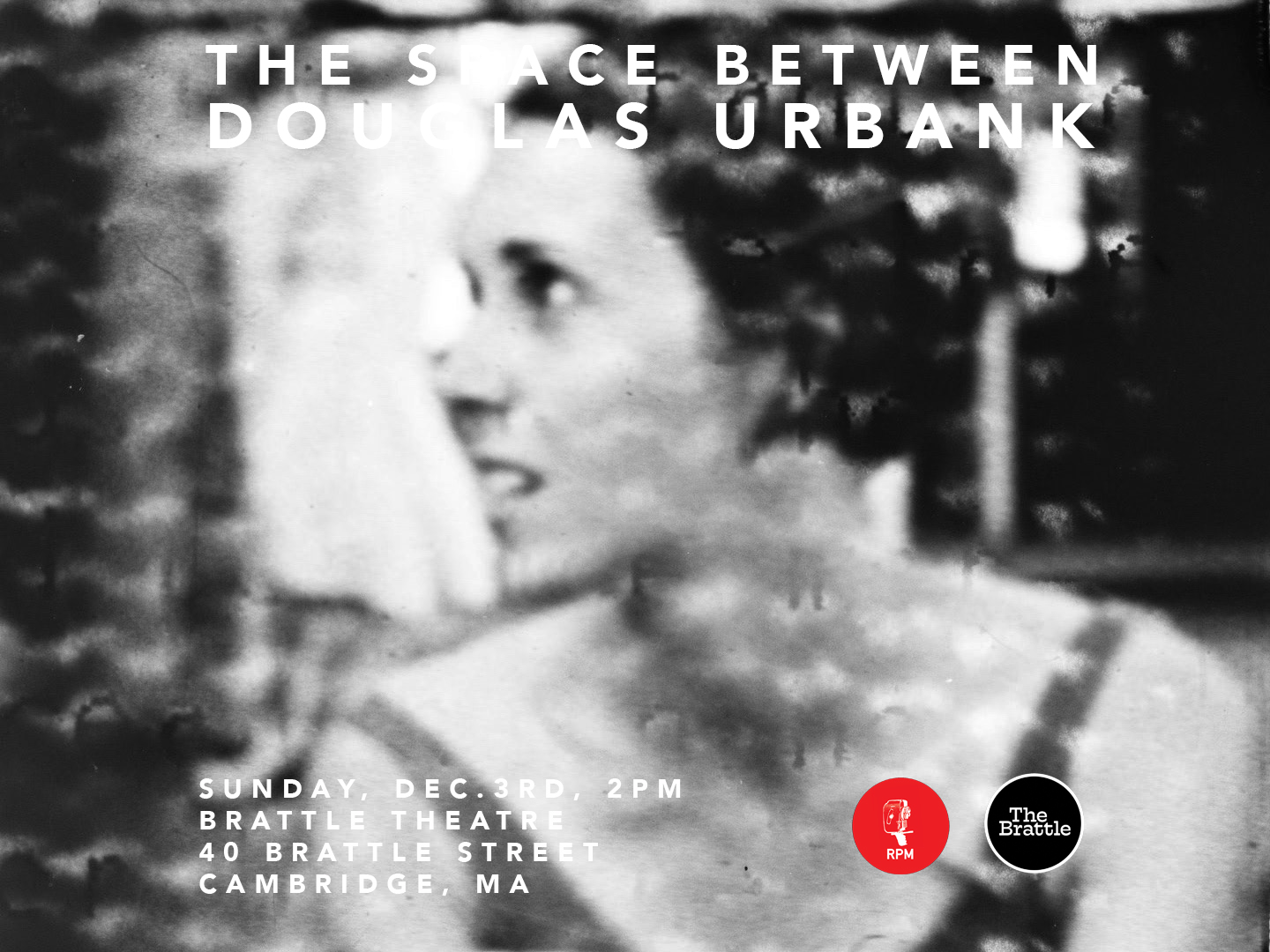
Bathers
16mm, B&W, sound, 2019, 03:45:
Three friends, the beach, the waves, their brief time together.
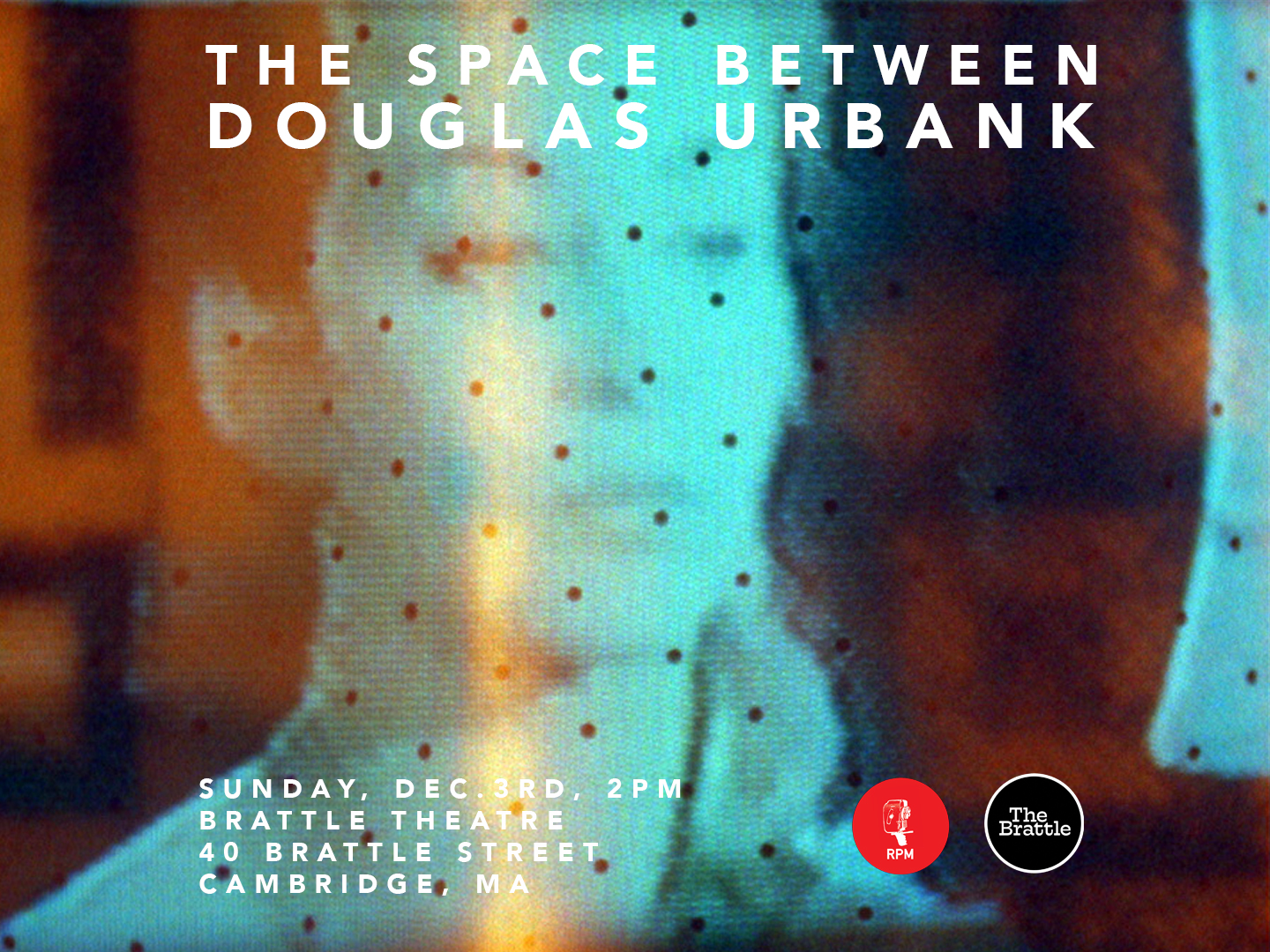
Oracle
16mm, color, sound, 2014, 07:20:
The Oracle answers a question.
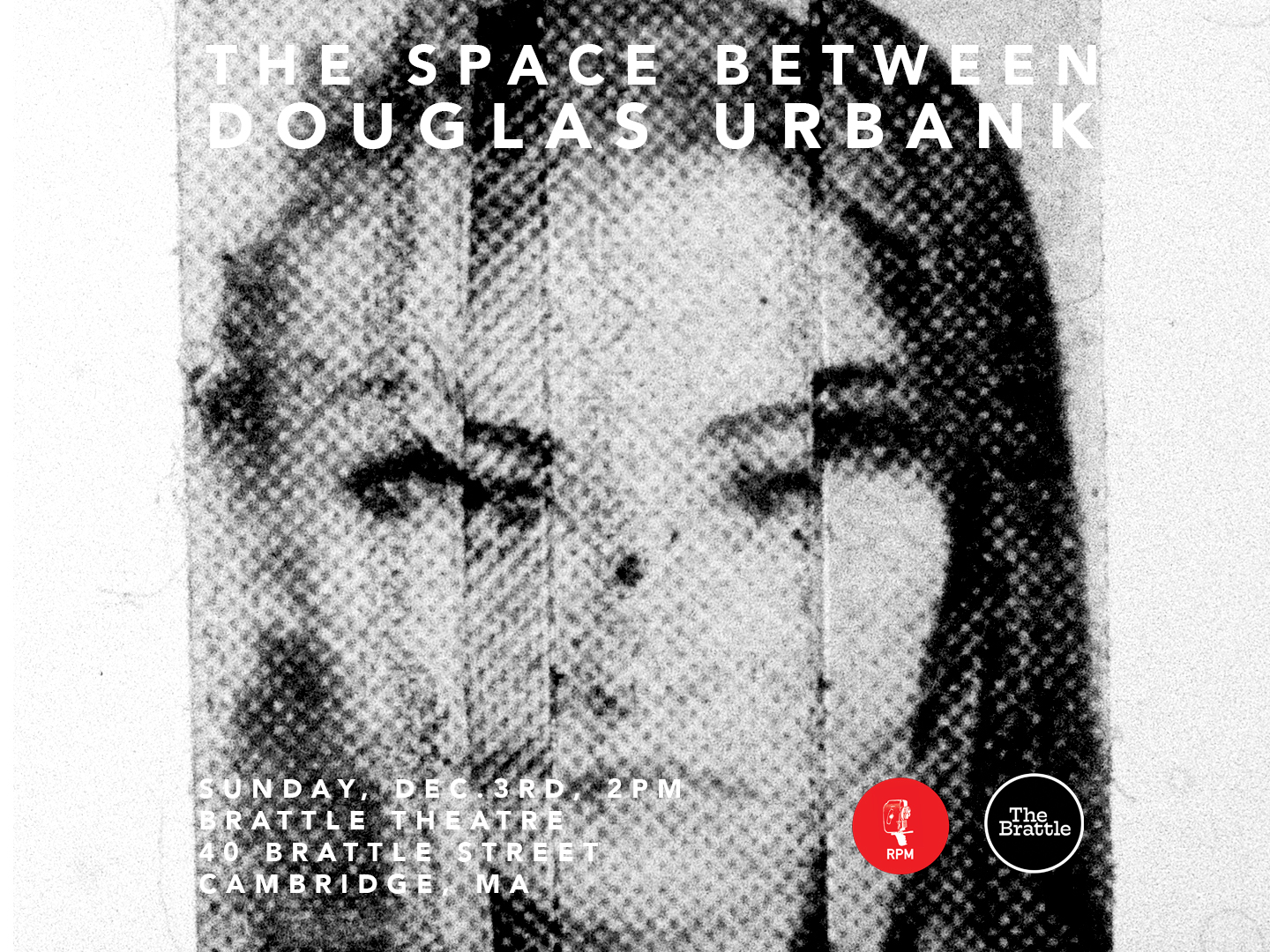
Portrait
16mm, B&W, silent, 2017, 05:15:
An imagined portrait, a handmade, stream-of-consciousness improvisation.
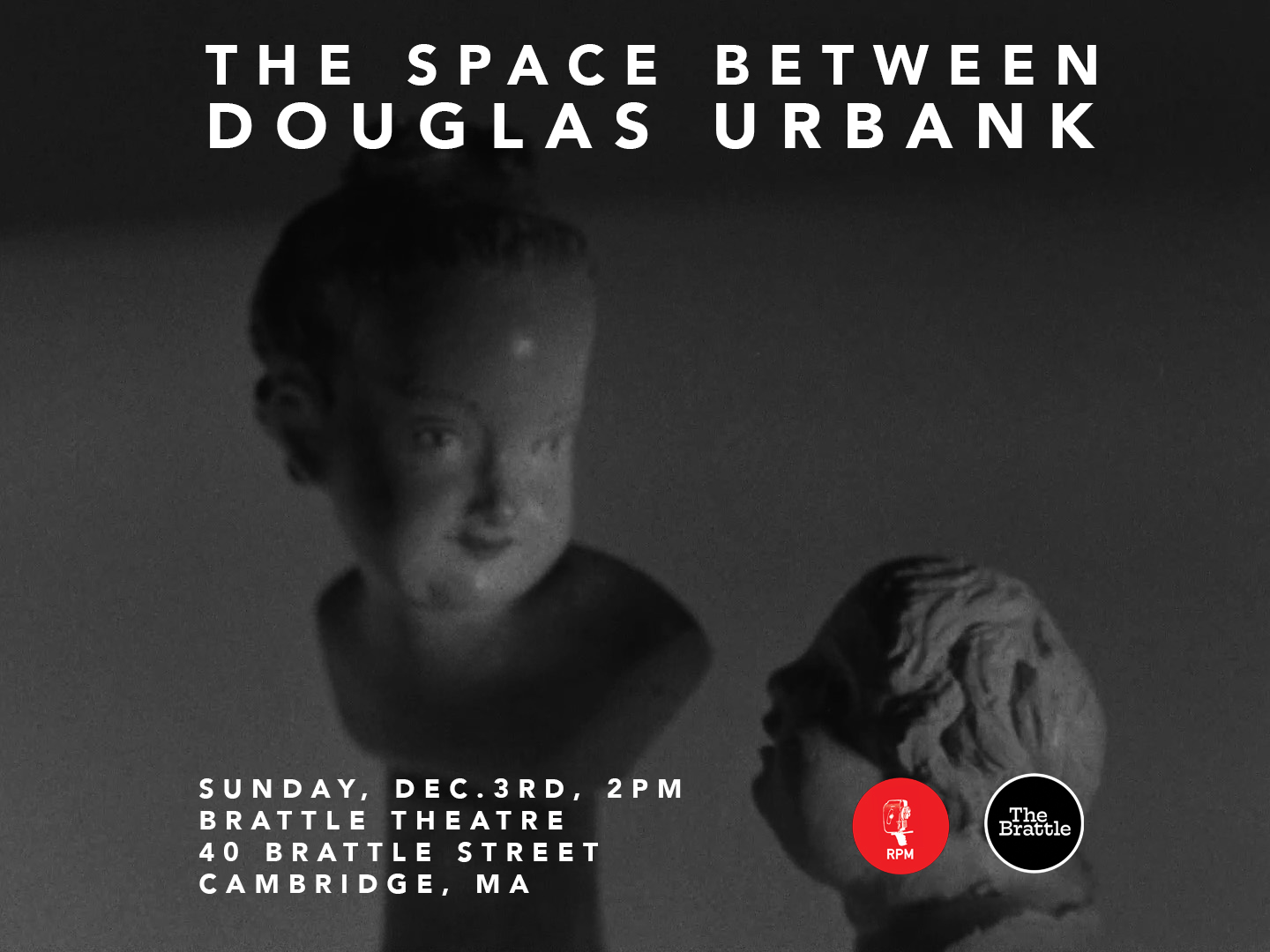
Small
16mm, B&W, silent, 2023, 04:30:
The inner lives of figurines.
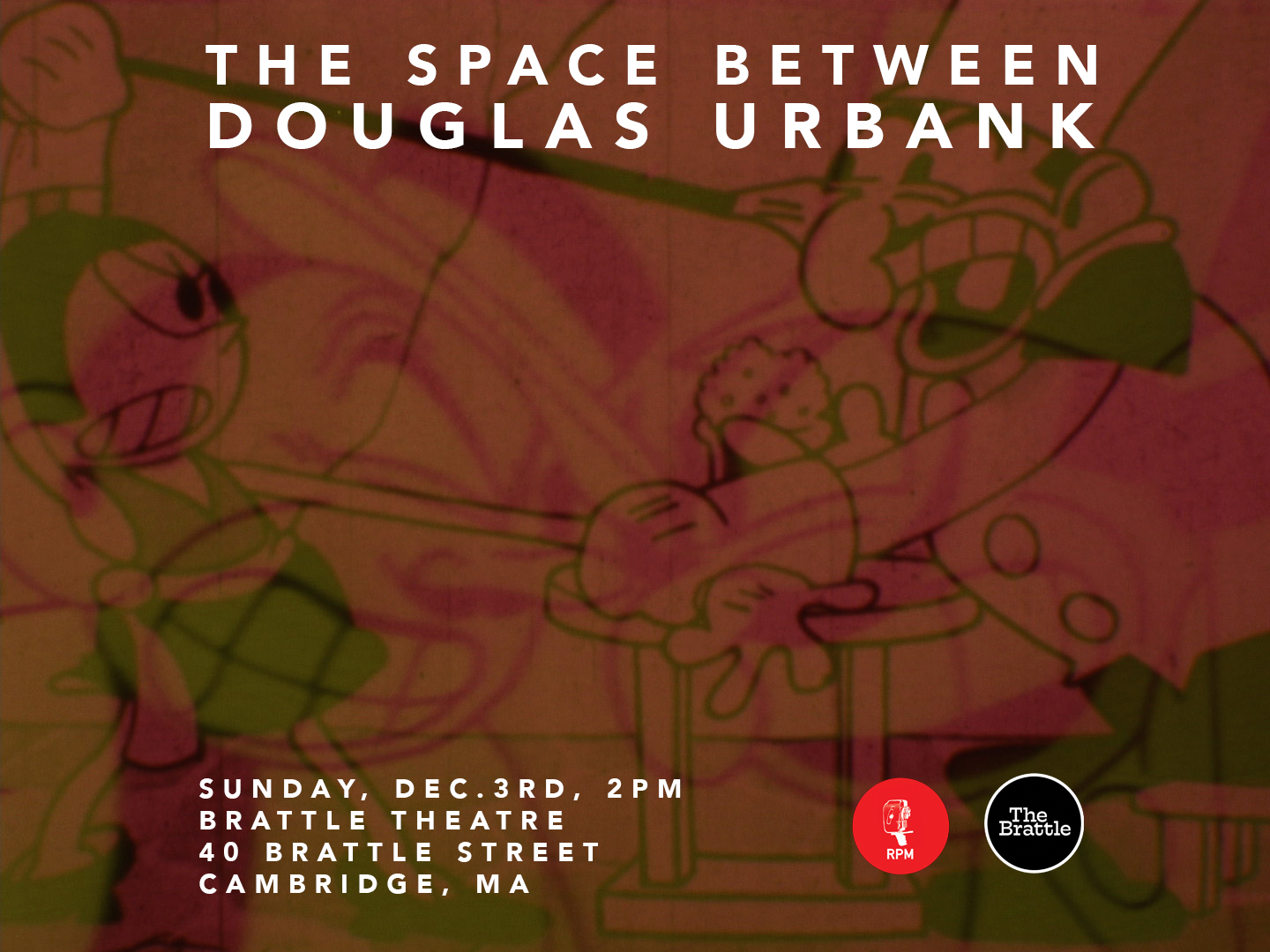
Cartoon Dream
16mm to video, color, silent, 2023, 05:45:
A found cartoon copied twice, in sequence, four rolls of 16mm film, contact printing, optical printing.
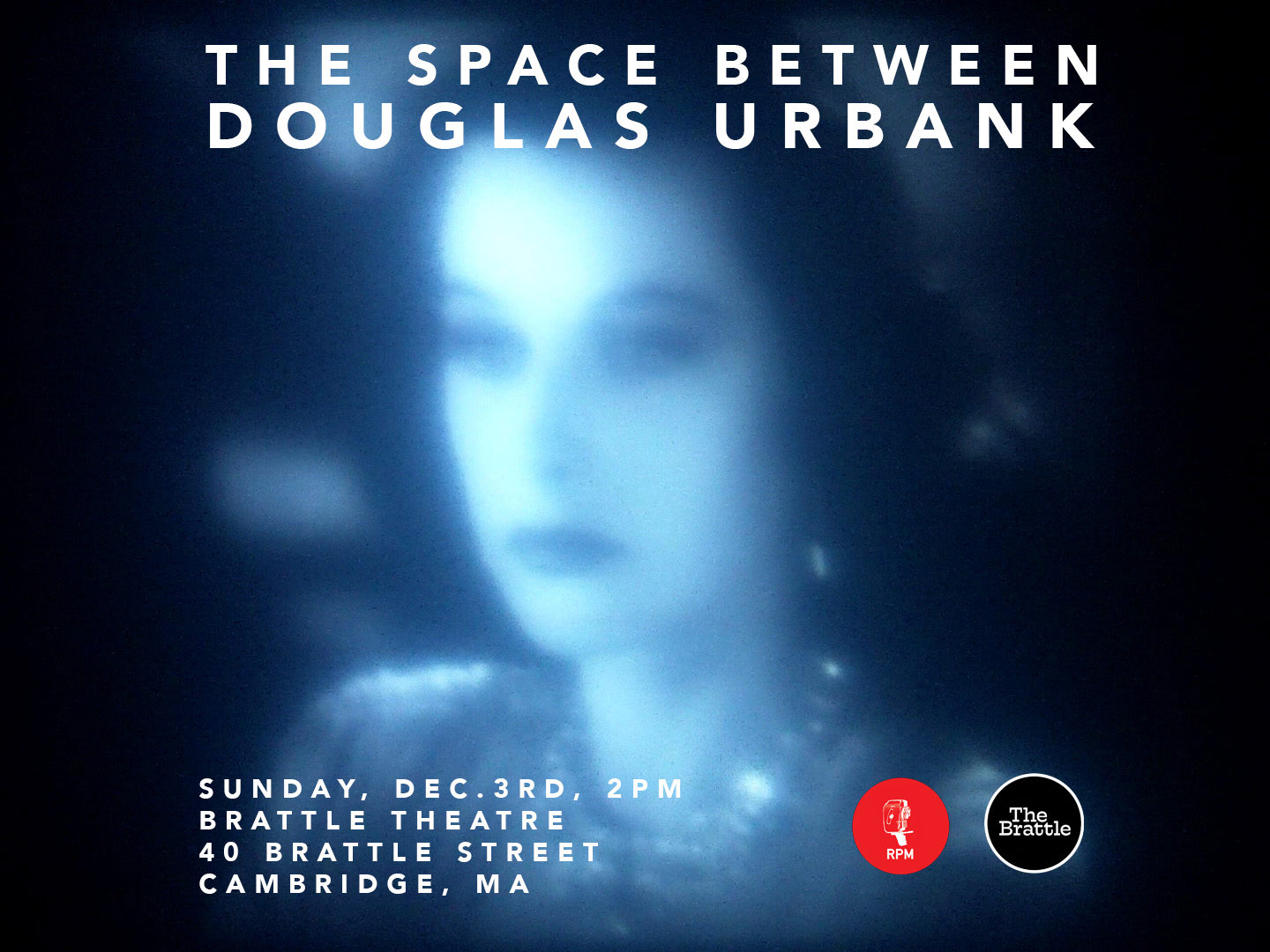
Hotel Cassiopeia: Algiers part 1
video, color, sound, 2013, 03:45:
Hotel Cassiopeia, a play by Charles Mee, imagines the fantasy world of artist, Joseph Cornell. The script includes three direct dialog excerpts from two Hollywood films: Algiers featuring Hedy Lamarr and To Have and Have Not with Lauren Bacall. This video is one of the three made for a Fort Point Theatre Channel production in Boston, intended as a reflection Cornell's found footage films Rose Hobart and By Night with Torch and Spear.
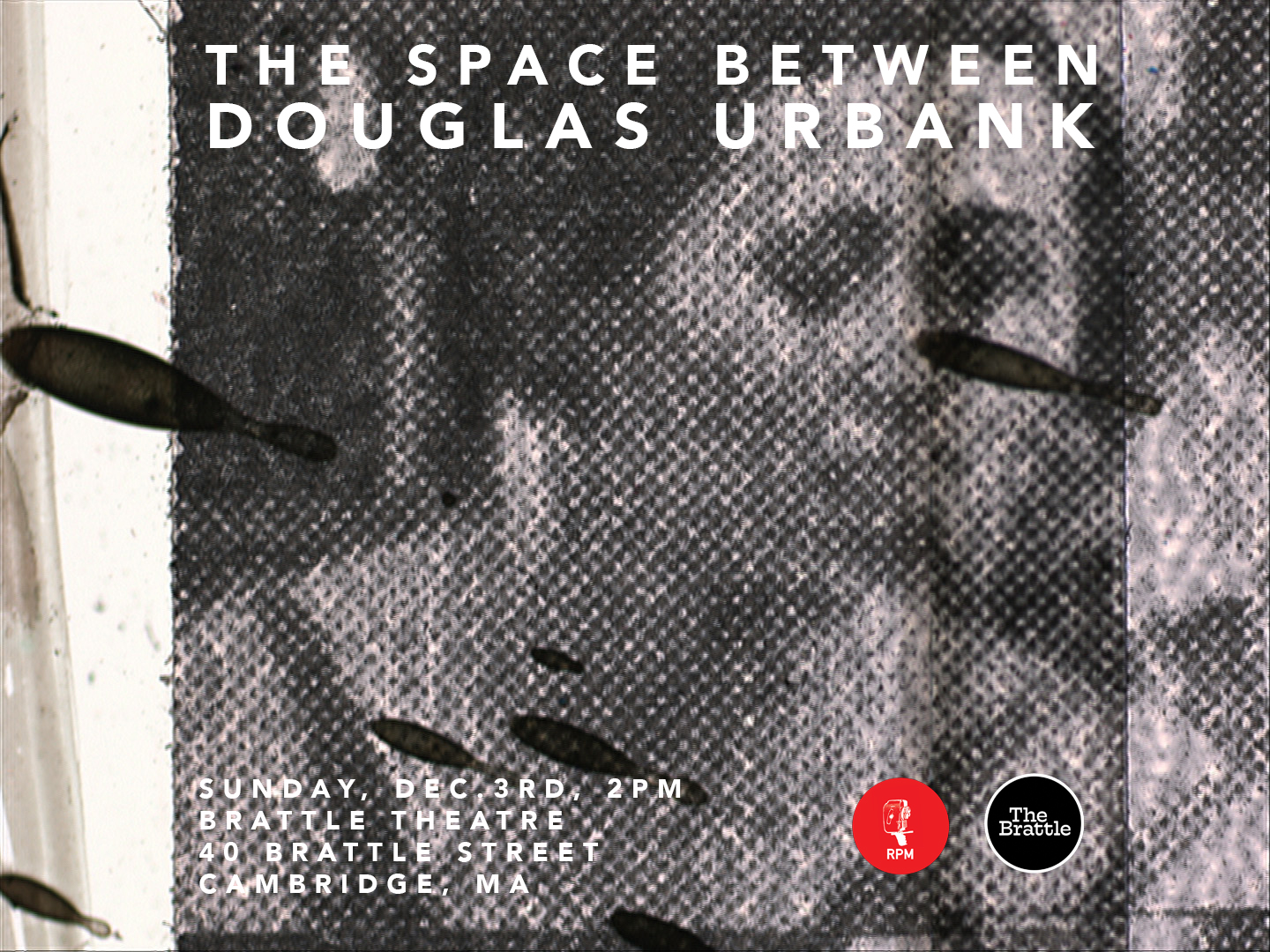
Splash
16mm to video, color, sound, 2012, 02:40:
Young bather, sand, waves, surf, synthetic soundtrack.

Skate
16mm to video, B&W, sound, 2019, 03:00:
Winter, Boston Common Frog Pond, 16mm film and in-camera editing.
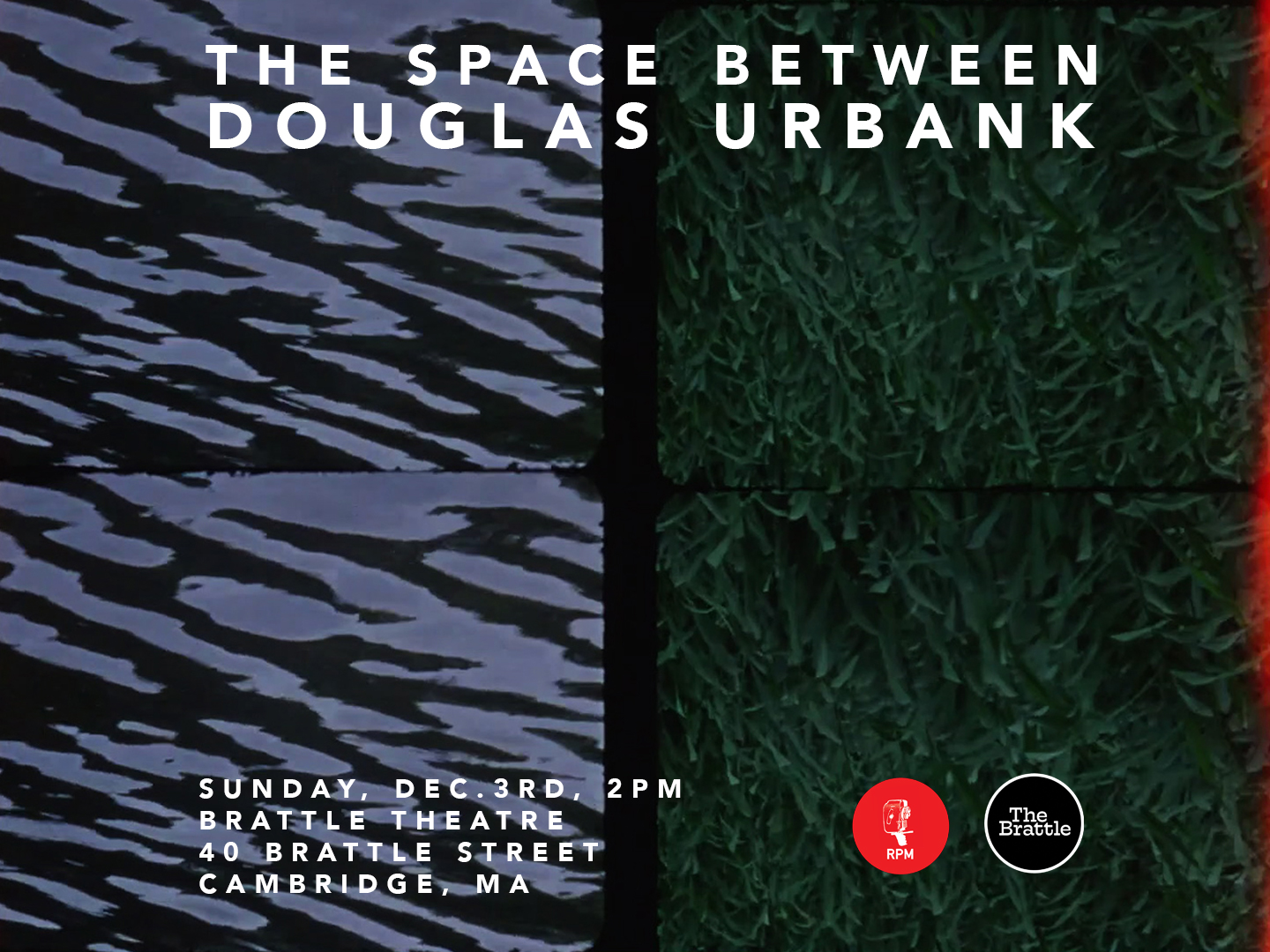
Cryptogram (v.5)
16mm to video, color, silent, 2022, 04:40:
Double 8mm film and in-camera editing, landscape, cityscape, brick, glass, water, trees, windows, abstraction.
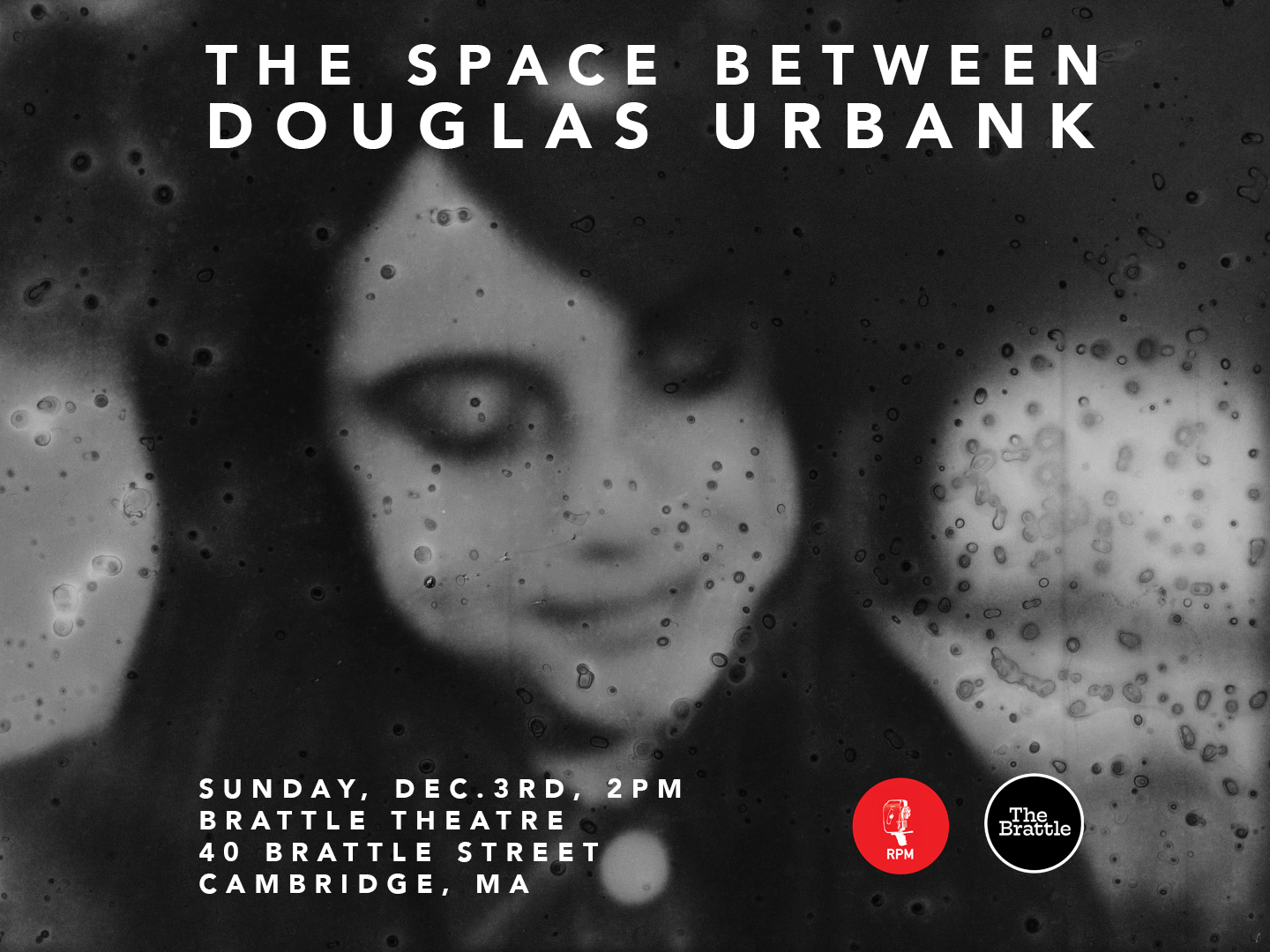
Move
16mm to video, B&W, sound, 2021, 04:40:
Rhythms of children, birds, and insects.
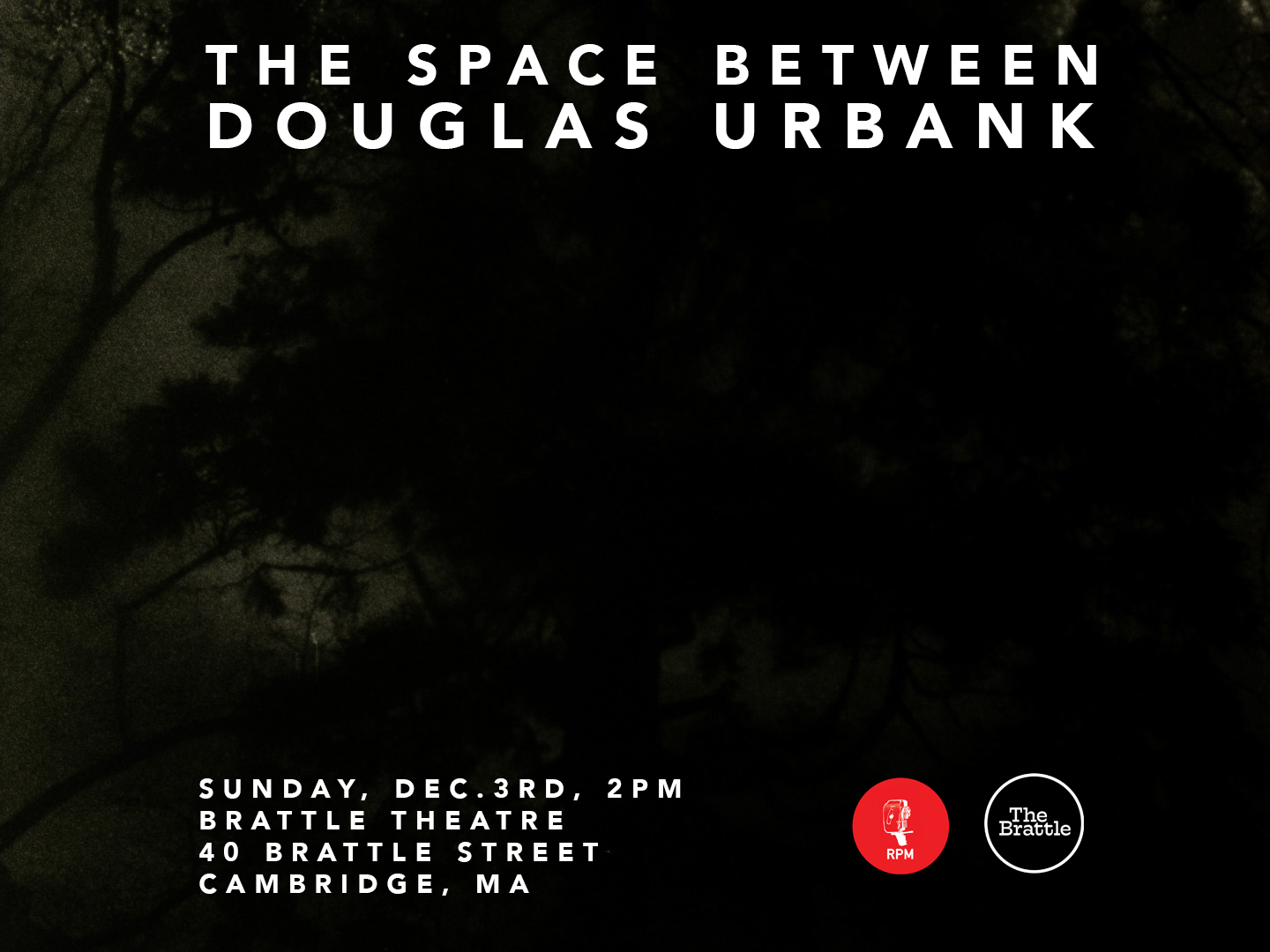
3 Notes to a Redwood Tree
16mm to video, color, sound, 2023, 09:30:
The space between.

Sojourn
16mm to video, color, sound, 2012, 01:50:
Arrival, celebration, departure.
Return to top
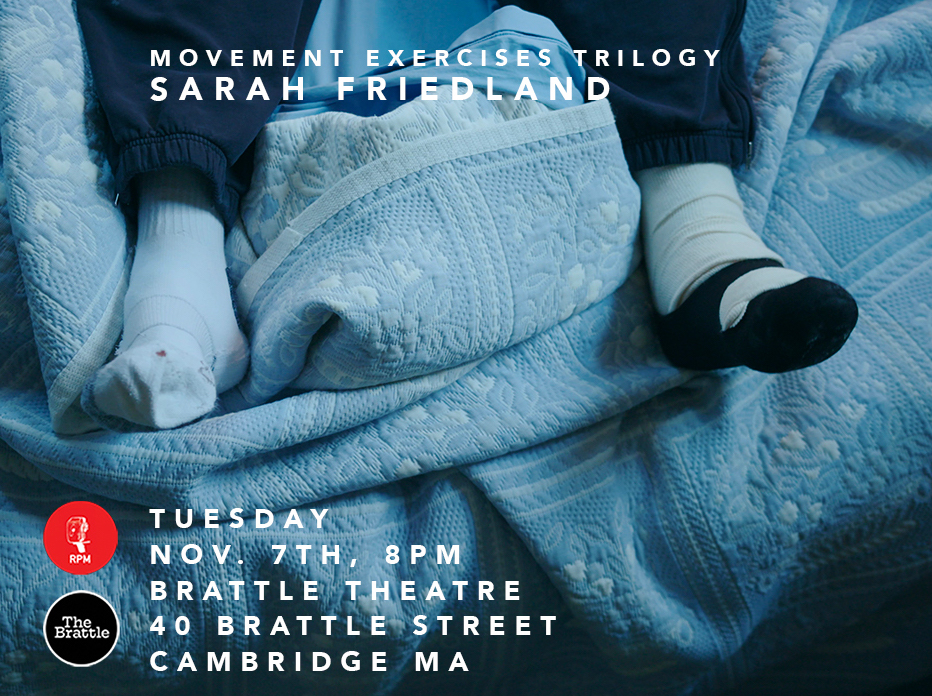
RPM Festival and the Brattle Theatre are excited to announce our co-presentation of "Movement
Exercises Trilogy," A feature-length trilogy of films by filmmaker-choreographer Sarah Friedland, Movement
Exercises deconstructs and revises the choreographic vocabularies of exercises practiced
across home, work, and school spaces. The trilogy consists of three short films: Home
Exercises (2017), Drills (2020), and Trust Exercises (2022). Movement Exercises examines the
premise and promise of the exercise: that by moving together, repeatedly, we both create and
recreate the social body.
Home Exercises
Digital, 22 minutes, 2017, Color, Sound.
Drills
Digital, 17 minutes, 2020, Color, Sound.
Trust Exercises
Digital , 25 minutes, 2022, Color, sound.
Screening format: DCP ( DCP courtesy of Video Data Bank)
total: 64 mins
Post-Screening Q&A: Sarah Friedland & Homa Sarabi
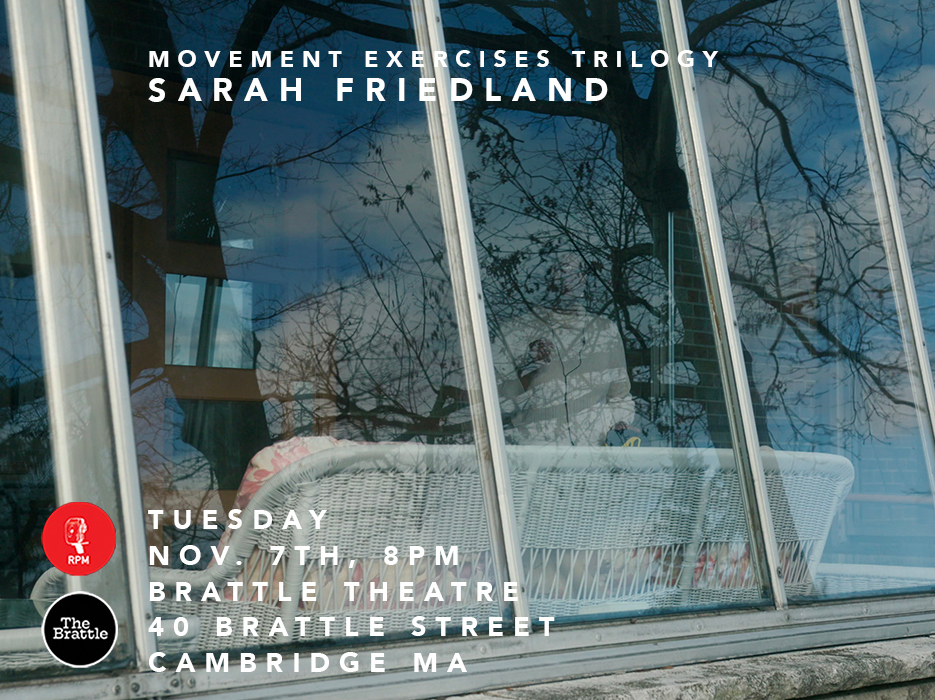
Sarah Friedland is a filmmaker and choreographer working at the intersection of
moving images and moving bodies. Through hybrid, experimental, and movement-based
filmmaking, multi-channel video installation, and site-specific live dance performance, she
stages and scripts bodies and cameras in concert with one another to elucidate, distill, and
revise the embodied patterns of social life and the body politic. Facilitating a research process
integrating found movements, gestures, and postures from embodied memories, cinema and
archival footage, and contemporary movement languages, she choreographs through practices
of interviewing, pre- and re-enactment, adaptation, and improvisational play, shaping dances
with diverse communities of performers and movers—from professional
dancers to cohorts of seniors and teenagers.
Her work has screened and been presented in numerous festivals and film spaces including
New York Film Festival, New Directors/New Films, Ann Arbor Film Festival, New Orleans Film
Festival, BAMcinématek, Mubi, and Anthology Film Archives, in art spaces such as Performa19
Biennial, La MaMa Galleria, MoMA, Sharjah Art Foundation, and Manifattura delle Arti Bologna,
and in dance spaces including the American Dance Festival and Dixon Place, among others.
Brattle Ticket Info

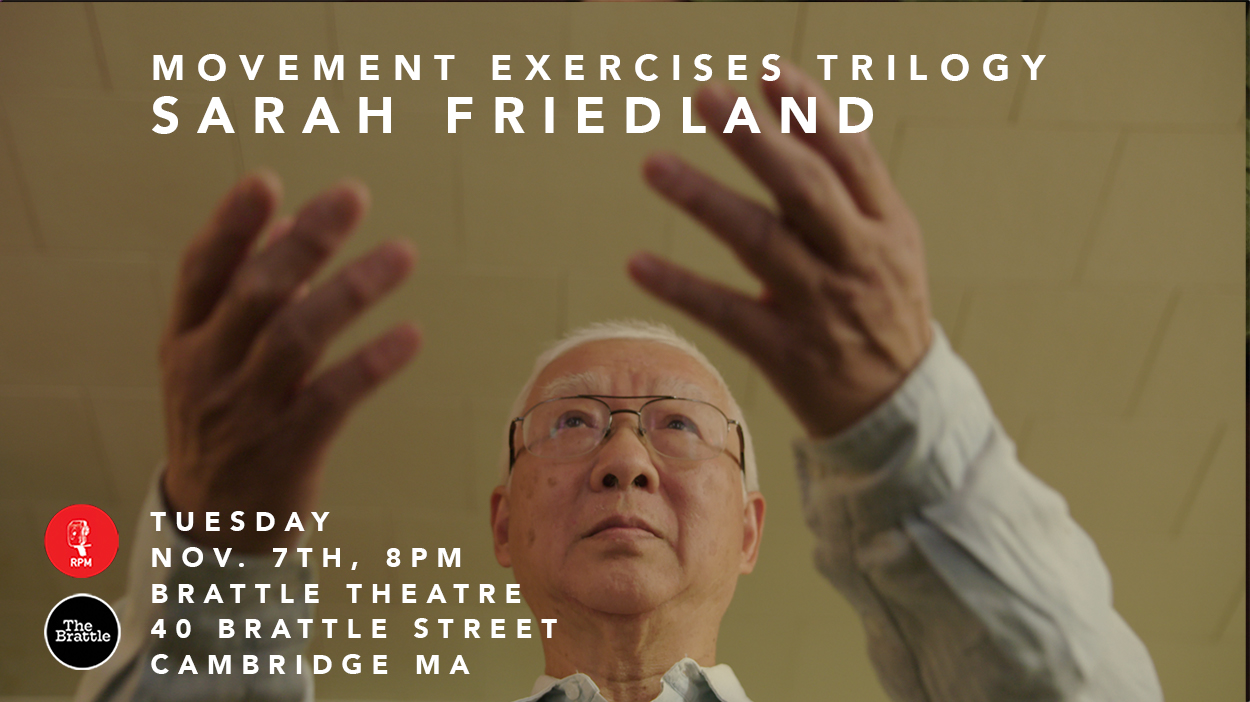
Home Exercises
22 minutes, 2017
Adapting the form of the home workout video, Home Exercises investigates the gestural habits
and choreographies of aging individuals in their homes. Created in collaboration with a group of
eight seniors to shape their daily routines into dance for camera, the on-screen movements shift
in their fidelity to the daily patterns they reperform. Some elders rigorously reenact their daily
actions, whereas others erupt into stylized and rhythmically altered movements. Intertitles
precede each exercise, annotating the performances while charting the time of day from morning
to nightfall.
Prior screenings include New Directors/New Film, BAMcinematek, Sharjah Art Foundation, and
American Dance Festival, among others.
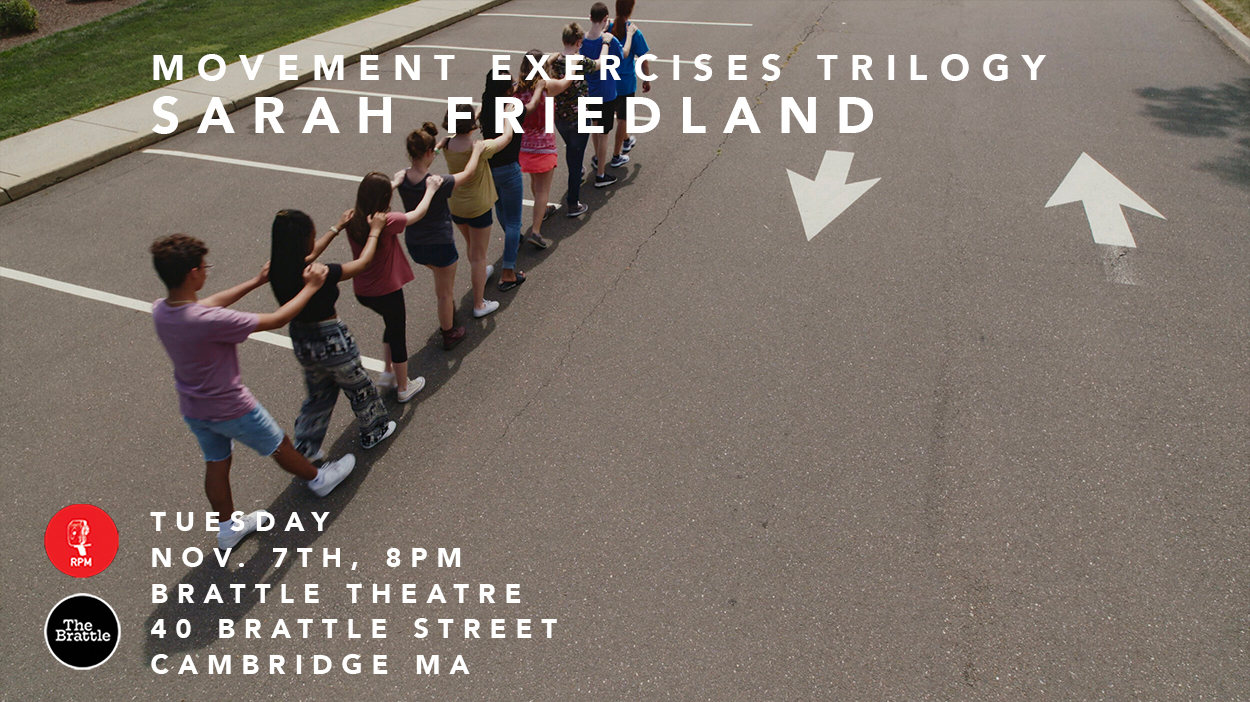
Drills
17 minutes, 2020
Drills is a film about the choreography of preparing for the future. A hybrid documentary and
experimental dance film reimagining the form of the Cold War-era, US government-produced
social guidance film, Drills asks what futures we are preparing for through the exercises
embodying present anxieties. Weaving in between multiple forms of choreography and
documentation, Drills restages lockdown and active shooter drills, frames corporate and tech
start-up office meditation, and reperforms Boy Scout drills from their 1917 manual.
Past screenings include New York Film Festival (Currents), Prismatic Ground, Pleasure Dome,
ICDOCS, Full Frame, Mubi, and Athens International Film and Video Festival, where it won the
Film House Award for Visionary Filmmaking, among other festivals and galleries.
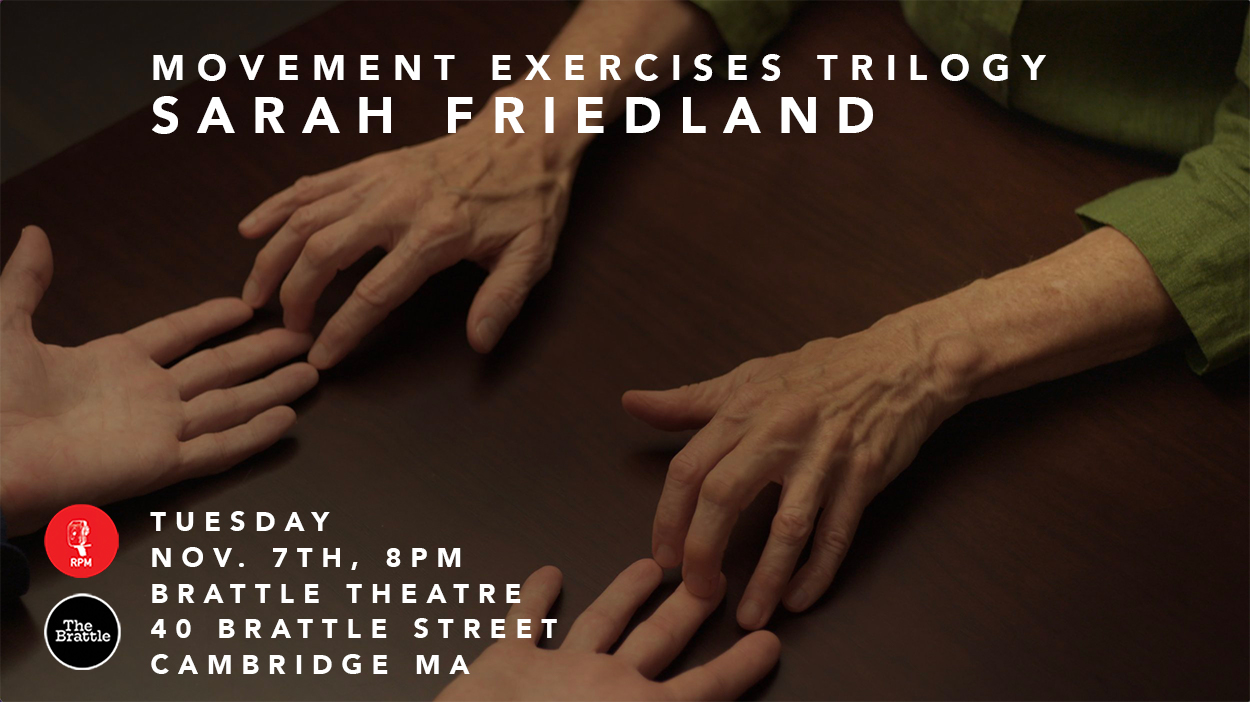
Trust Exercises
25 minutes, 2022
The final film in the trilogy, Trust Exercises explores the tension between the poetics of group
movement and its instrumentalization for capitalist management. Amending the choreography of
team-building and the visual grammars of corporate video, Trust Exercises braids together
movement from three work spaces: a fictional start-up retreat, a body work session as interview,
and a dance rehearsal. Movements transmit between performers across scenes, complicating the
discrete goals of their choreographies and examining their portability across spheres. Dislocating
the movement of the retreat to the space of rehearsal, professional dancers transform stock
exercises into intimate social dances. A body work session reconfigures the office environment.
Lingering after hours, movement facilitators transmute team-building games into a playful duet.
Funding for trilogy provided by the Dance Films Association, Rhode Island State Council on the
Arts, New York State Council on the Arts, New York Foundation for the Arts, and Athens
International Film and Video Festival, among others.
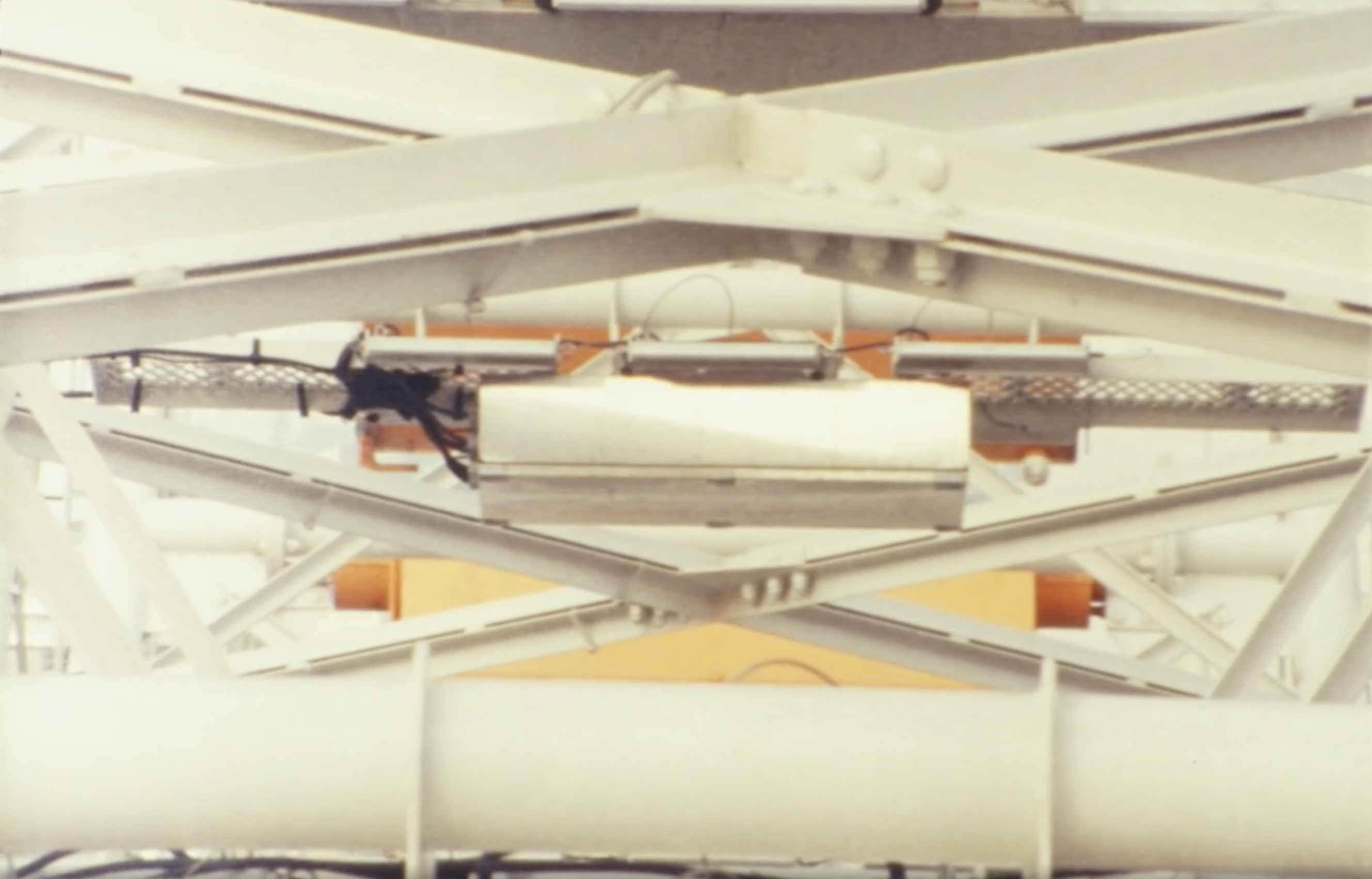
This touring program features 16mm films by Malic Amalya,
Karel Doing, Anna Kipervaser, Ryan Marino, Moviate (Josh Drake,
James Hollenbaugh, Jeremy Moss, Caleb Smith), Tomonari Nishikawa, Kathleen Rugh,
Josh Weissbach, and Lilan Yang. Exploring the formal and conceptual
possibilities of the medium with distinctive approaches, their films showcase
the diversity of works shown at RPM Festival in recent years.
The event is organized by Benny Shaffer and Wenhua Shi with Pittsburgh Sound + Image.
Program: 65 minutes
Projection Format: 16mm film
Time: doors at 7:30pm,
screening at 8:00pm.
Winter’s First Moons -
Kathleen Rugh
3 mins, 2018, USA, color, sound, 16mm
Radiant Forms
- Ryan Marino
7 mins, 2022, USA, color, sound, 16mm
Babbler, Fairy and Thrush - Karel Doing
3 mins 44 secs, 2022, UK, B/W, sound, 16mm
Amusement Ride
- Tomonari Nishikawa
6 mins, 2019, Japan, color, sound, 16mm
This Is How I Felt
- Josh Weissbach
1 mins 35 secs, 2022, USA, B/W, sound, 16mm
Everything Comes Full Circle -
Lilan Yang
13 mins 44 secs, 2022, USA, B/W & color, digital sound, 16mm
With the Tide, With the Tide
Anna Kipervaser
2 mins 49 secs, 2022, USA, color, sound, 16mm
Living Lessons in the Museum of Order
- Malic Amalya
20 mins, 2022, USA, B/W and color, sound , 16mm
Ill Composto -
Moviate (Josh Drake, James Hollenbaugh, Jeremy Moss, Caleb Smith)
3 mins 48 secs, 2023, USA, color, sound, 16mm

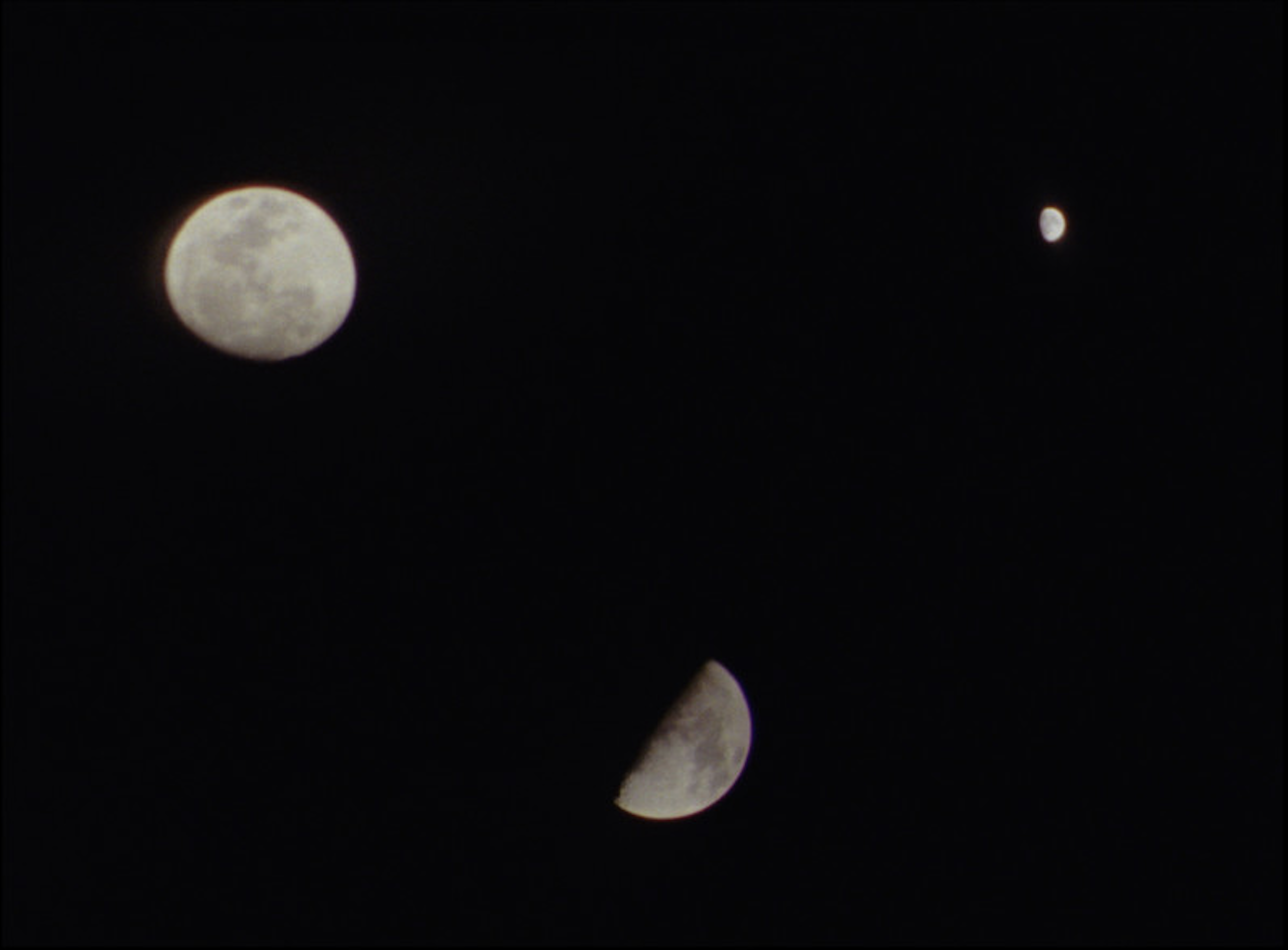
Winter's First Moons
- Kathleen Rugh
3 mins, 2018, USA, color, sound, 16mm
Following the winter solstice, the longest nights of the year prevail. Through these darkest nights the moon reaches to its fullest. Filmed over numerous nights the moons of different phases are brought together in the black sky. Through multiple exposures on film and editing created in-camera, the moons move and bounce off one another in unpredictable ways. Official NASA sound recordings from space help activate their actions. The stoic moon breaks free and gravitates at will.
Kathleen Rugh is a filmmaker and photographer based in Brooklyn, New York. Her film and photographic work has been exhibited in screenings and galleries throughout the US and internationally, including the Edinburgh International Film Festival, the Images Festival, Ann Arbor Film Festival, Antimatter [Media Art], EXiS Experimental Film Festival, and the Athens International Film and Video Festival. She has received funding for her films through the New York State Council on the Arts.
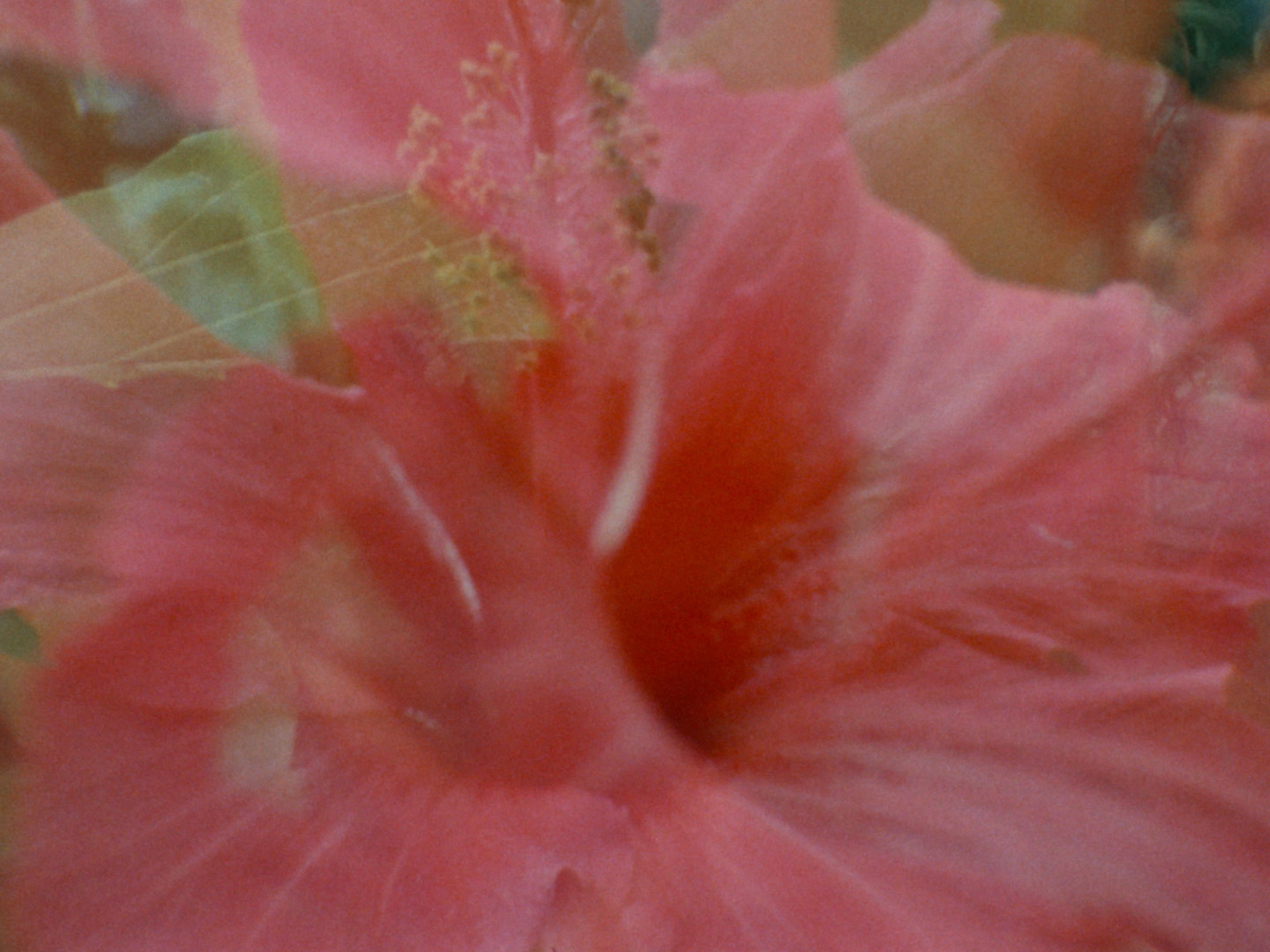
Radiant Forms
- Ryan Marino
7 mins, 2022, USA, color, sound, 16mm
Luminous forms merging in time.
Ryan Marino
is an interdisciplinary artist working with film, sound, and collage. His 16mm films explore the ethereality of time, light, and space. His 16mm films have screened at film festivals and venues including: Anthology Film Archives, New York Film Festival, San Francisco International Film Festival, Milwaukee Underground Film Festival, Uplink (Tokyo), Venice Biennale, Fracto Experimental Film Encounter, Spectacle Theater, and Pacific Film Archive. In addition to creating the soundtracks for his own films, his sound work includes original compositions and commissioned soundtracks for short films and theater productions. By day he works as an audiovisual archivist.
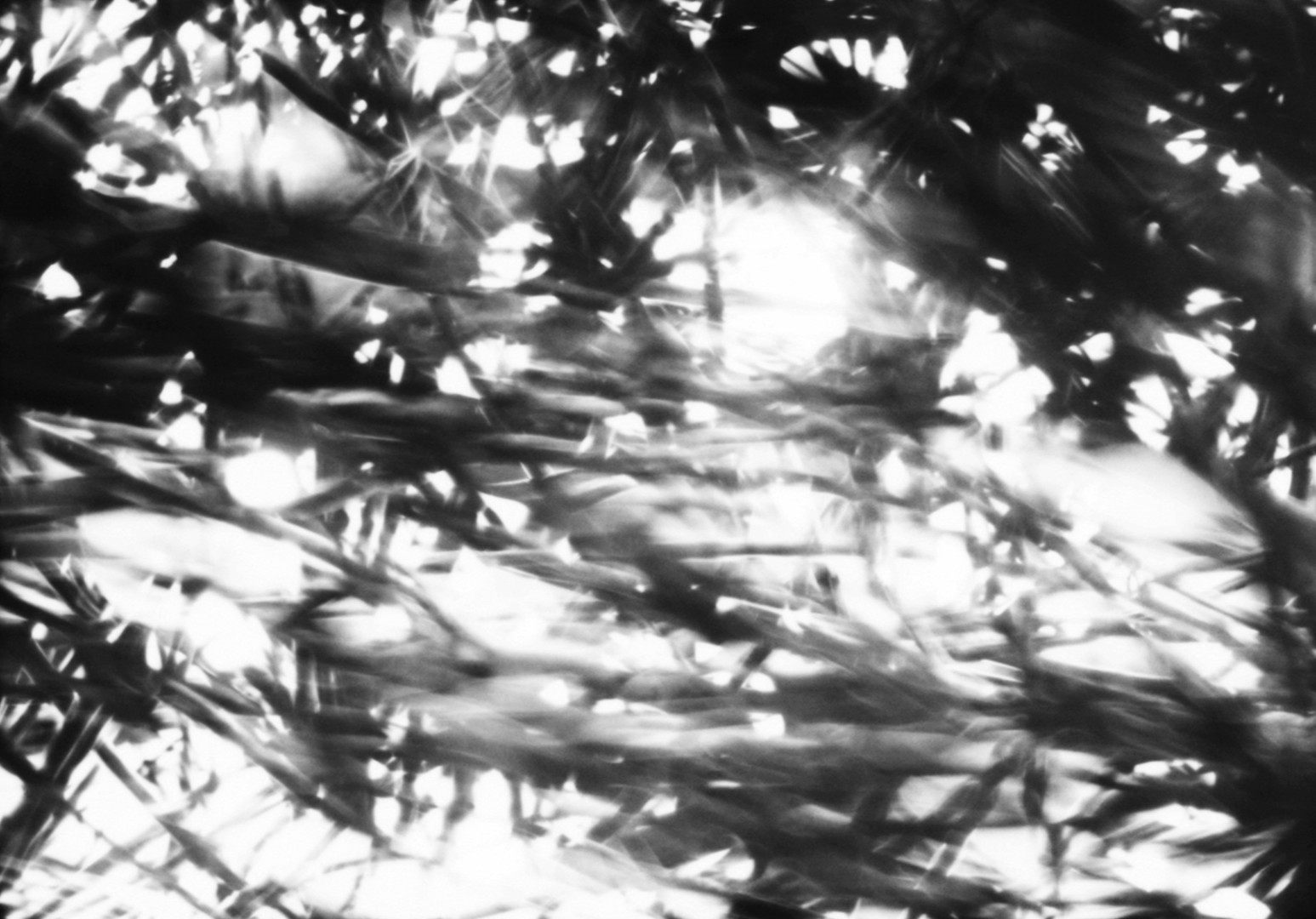
Babbler, Fairy and Thrush
- Karel Doing
3 mins 44 secs, 2022, UK, B/W, sound, 16mm
An unfiltered stream of perception: small objects and grand panoramas appear simultaneously. The certainties of near and far, detail and overview, inside and outside are deliberately thrown into confusion. Aided by ‘in camera’ superimposition and travelling mattes a near abstract experience is created. Sunlight filters through semi-transparent surfaces, while small holes and cracks allow the light to travel unrestrained. The work was conceived and shot within a few hundred yards from my house, focusing on the plants, flowers, trees and ferns that grow around me.The soundtrack is composed with noises and voices from that same area, revealing a further abundance of life.
Karel Doing is an independent artist, filmmaker and researcher whose practice investigates the relationship between culture and nature by means of analogue and organic process, experiment and co-creation.
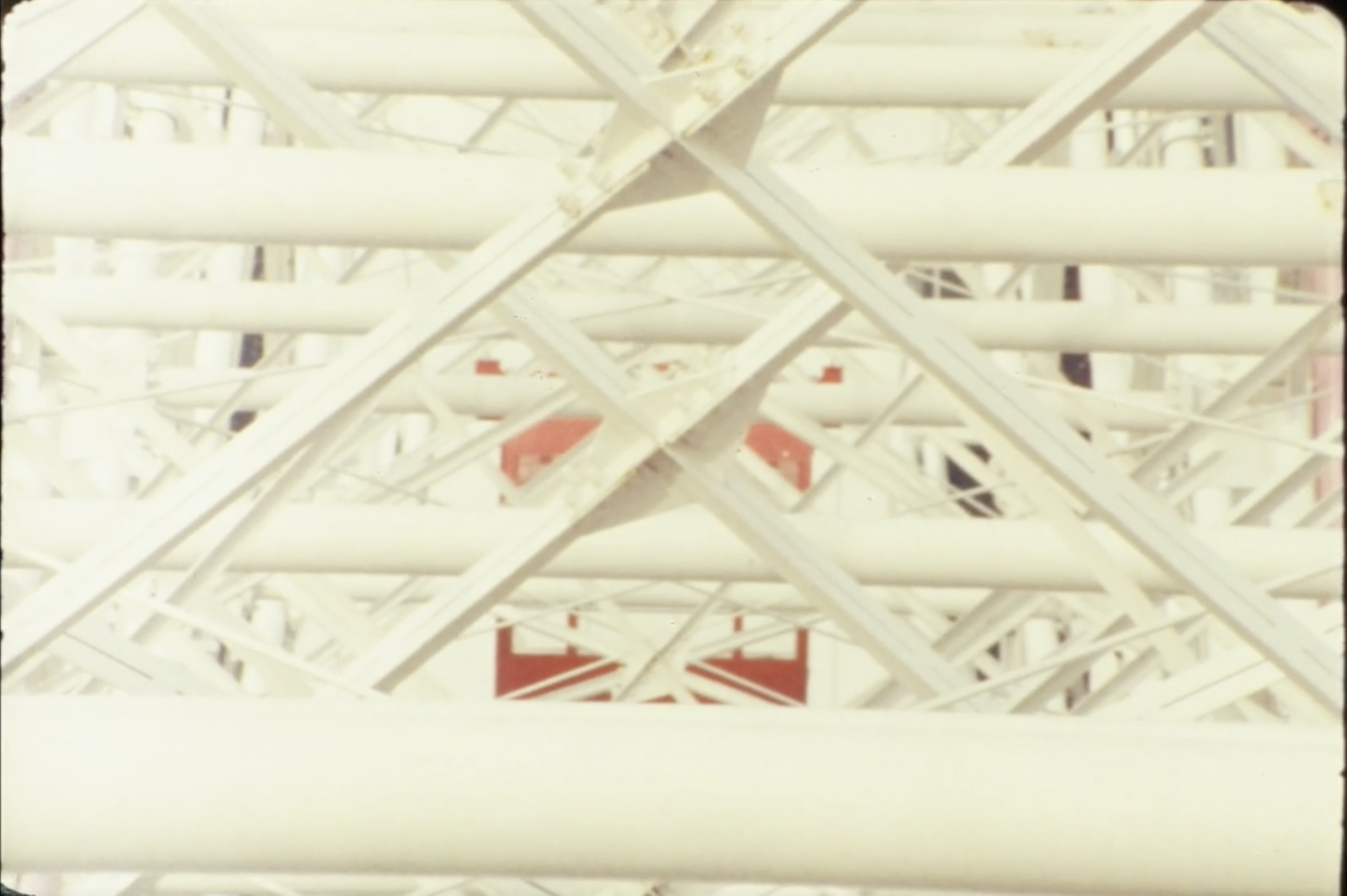
Amusement Ride - Tomonari Nishikawa
6 mins, 2019, Japan, color, sound, 16mm
Shot with a telephoto lens from inside a cabin of Cosmo Clock 21, a Ferris wheel at an amusement park in Yokohama, Japan. The distorted image shows the structure of the Ferris wheel, focusing on the intermittent vertical movement, which resembles the movement of a film at the gate of a film projector or camera.
Tomo NIshikawa
Nishikawa’s films explore the idea of documenting situations/phenomena through a chosen medium and technique, often focusing on process itself. His films have been screened at numerous film festivals and art venues, including Berlinale, Edinburgh International Film Festival, Hong Kong International Film Festival, International Film Festival Rotterdam, London Film Festival, Media City Film Festival, New York Film Festival, Singapore International Film Festival, and Toronto International Film Festival. In 2010, he presented a series of 8mm and 16mm films at MoMA P.S.1 Contemporary Art Center, and his film installation, Building 945, received the 2008 Grant Award from the Museum of Contemporary Cinema in Spain. He served as a juror for the 2010 Ann Arbor Film Festival, the 2012 Big Muddy Film Festival, and the 2013 dresdner schmalfilmtage. He is one of the co-founders of KLEX: Kuala Lumpur Experimental Film and Video Festival and Transient Visions: Festival of the Moving Image. He lives in Japan/USA, currently teaching in Cinema Department at Binghamton University.
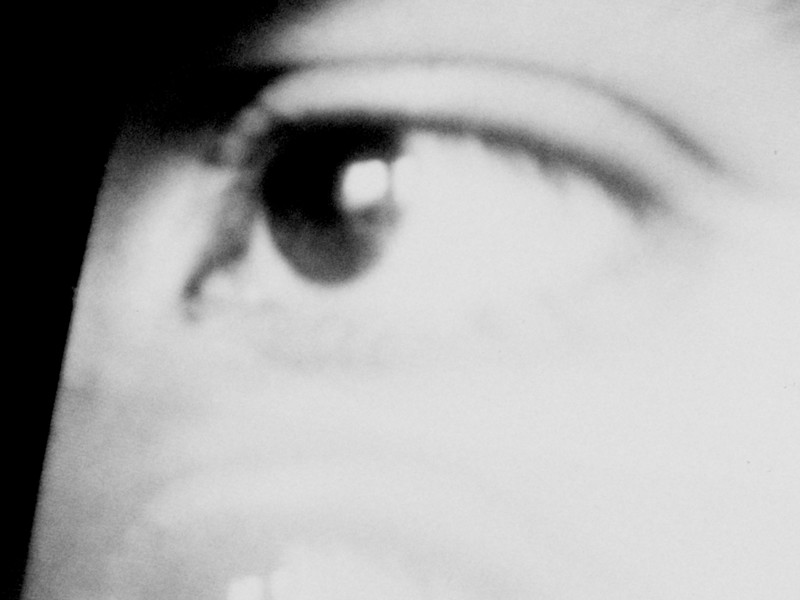
This Is How I Felt
- Josh Weissbach
1 mins 35 secs, 2022, USA, B/W, sound, 16mm
This Is How I Felt was filmed in a twenty-four period while the filmmaker was wearing a heart monitor to investigate possible arrhythmias.
Josh Weissbach is an experimental filmmaker. He lives in a house with his wife, two daughters, three cats, and six chickens next to a once abandoned village.
His films and videos have been shown worldwide in such venues as Ann Arbor Film Festival, Slamdance Film Festival, European Media Art Festival, Mono No Aware, Chicago Underground Film Festival, 25 FPS Festival, and Alchemy Film and Moving Image Festival. He has won jury prizes at Videoex, ICDOCS, $100 Film Festival, Onion City Experimental Film and Video Festival, Berlin Revolution Film Festival, and Haverhill Experimental Film Festival.
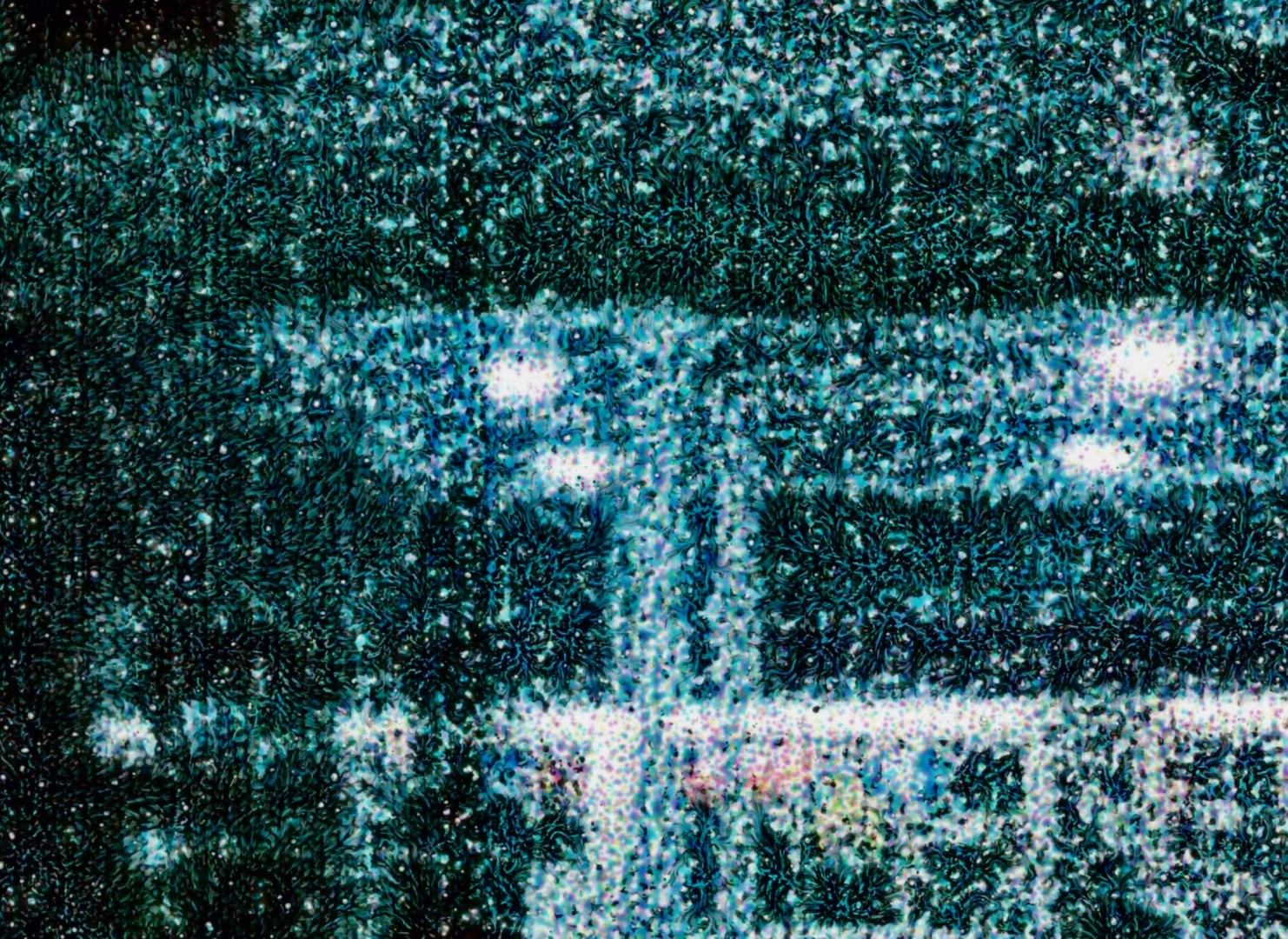
Everything Comes Full Circle
- Lilan Yang
13 mins 44 secs, 2022, USA, B/W & color, digital sound, 16mm
Following Wim Wenders’ Paris, Texas (1984) filming locations from Houston, Texas to Los Angeles, California, I use a 16mm Bolex camera to capture the vastness of the American West. The footage draws me to reminisce about snippets of my everyday life. I contemplate how we perceive the world through analog optical apparatuses and how memories are multidimensional yet fragile. Our recollections of people and places can be distorted, unrecognizable, and fictitious. These memories would eventually diminish with the passing of time. Everything Comes Full Circle is a personal attempt to remember things that will soon be forgotten.
The original footage was shot in Kodak 16mm film stocks during the summer of 2021 and edited digitally with voiceover. Later the digital moving images were inkjet printed on clear film spliced together with perforations cut out with a laser cutter. Each run of the projection makes the printer ink slowly melt, and the film will eventually fall into decay over the course of time.
Lilan Yang is an artist and experimental filmmaker from Chongqing, China. Her practice explores the myth of cities and landscapes, ways of seeing and unseeing, and sentiments of remembering and forgetting, through lens-based analog media such as 16mm filmmaking and 35mm photography, as well as digital technologies such as machine learning and data visualization. She received a BS in Computer Engineering from University of Illinois at Urbana-Champaign and an MFA in Digital + Media from Rhode Island School of Design.
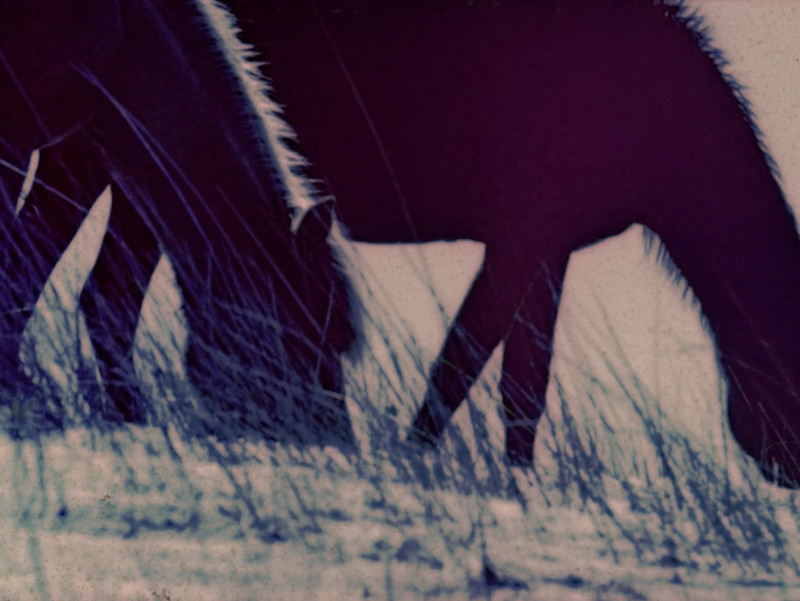
With the Tide, With the Tide
- Anna Kipervaser
2 mins 49 secs, 2022, USA, color, sound, 16mm
I know, you're a seasonal beast
Like the starfish that drift in with the tide
With the tide
So until your blood runs
To meet the next full moon
Your madness fits in nicely with my own
With my own
Your lunacy fits neatly with my own
My very own
- from Sea Song by Robert Wyatt
Anna Kipervaser is a Ukrainian-born artist whose practice engages with a range of topics including human and animal bodies, ethnicity, religion, colonialism, and environmental conservation. Her engagement with these topics is informed by a commitment to formal experimentation, DIY and alternative processes, spanning disciplines including experimental and documentary moving image works in both 16mm film and digital video.
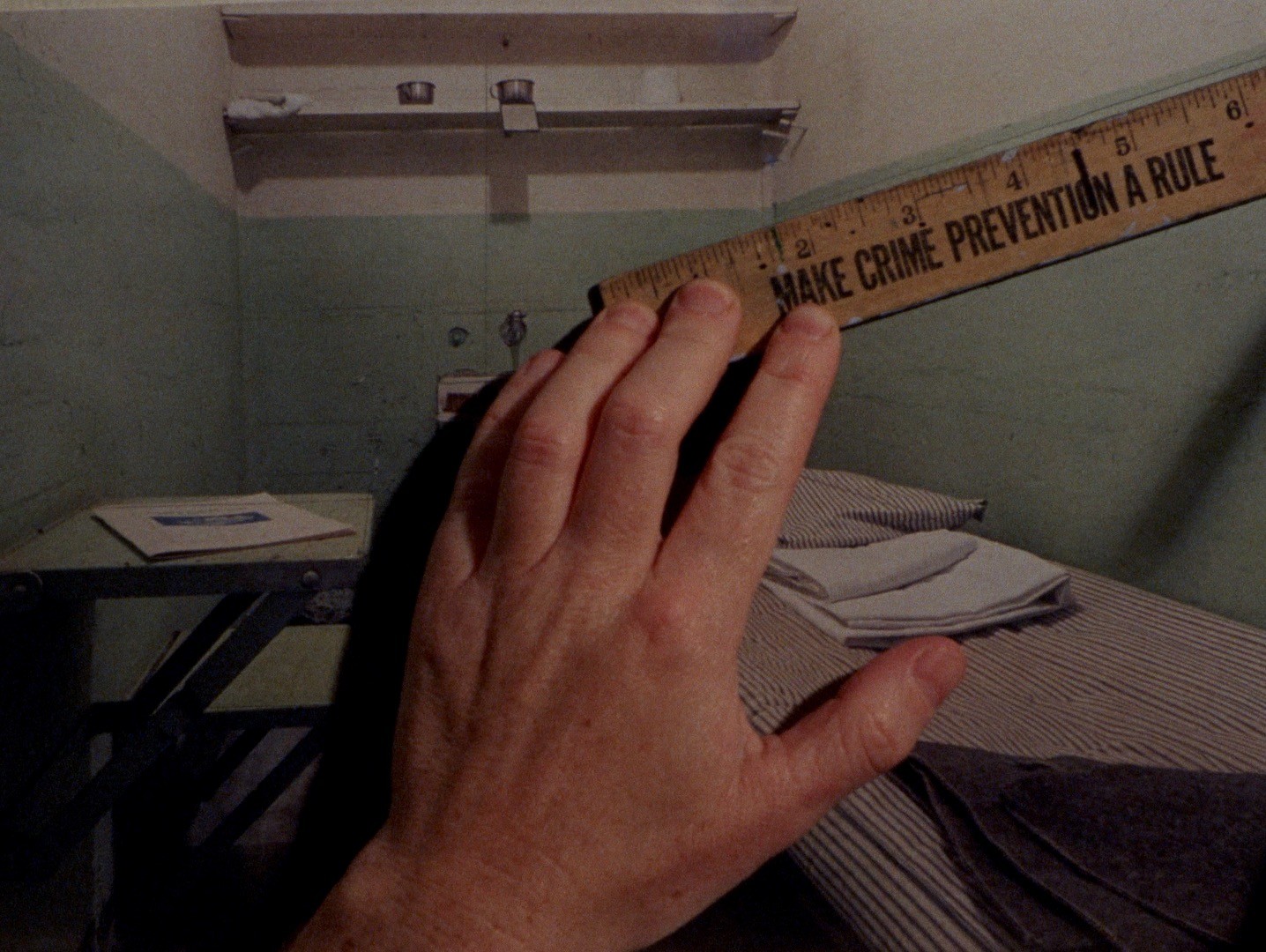
Living Lessons in the Museum of Order
-
Malic Amalya
20 mins, 2022, USA, B/W and color,
sound , 16mm
Living Lessons in the Museum of Order examines the carceral logics of the Orca Encounter at SeaWorld San Diego and the “Doing Time” tour of the former Alcatraz prison in the San Francisco Bay.
Juxtaposing original 16mm footage, promotional VHS and 16mm footage, and analog video feedback, Living Lessons in the Museum of Order explores the tensions between public fantasies and exploitative practices, as well as between rhetorical and cultural changes, within the two California entertainment empires.
Malic Amalya (b. 1980. Burlington, VT) is an experimental filmmaker living and working in Boston.
Malic is an Assistant Professor of Experimental Media and Film Production at Emerson College. His films have screened widely and are distributed by Canyon Cinema in San Francisco and Collectif Jeune Cinema in Paris.

Ill Composto
- Moviate (Josh Drake, James Hollenbaugh, Jeremy Moss, Caleb Smith)
3 mins 48 secs, 2023, USA, color, sound, 16mm
A collaborative Dadaist/exquisite corpse film on the theme of waste by four members of the Harrisburg-based collective Moviate.
Process: A found, expired 100’ roll of 16mm color negative film was split into four parts and photographed separately by each participant. Then each section was developed in a homemade b&w developer from the participant’s own compostable waste. The negative was then printed to 16mm color print stock on a makeshift DIY contact printer along with found optical sound. Lastly, it was assembled in the Dadaist poetry method by cutting the printed film into pieces, placing them into a large wooden box with holes, randomly pulling strips of film out through the holes one at a time and splicing them together in that order.
Moviate is a filmmaker-run curatorial collective based in Harrisburg, Pennsylvania.
Return to top
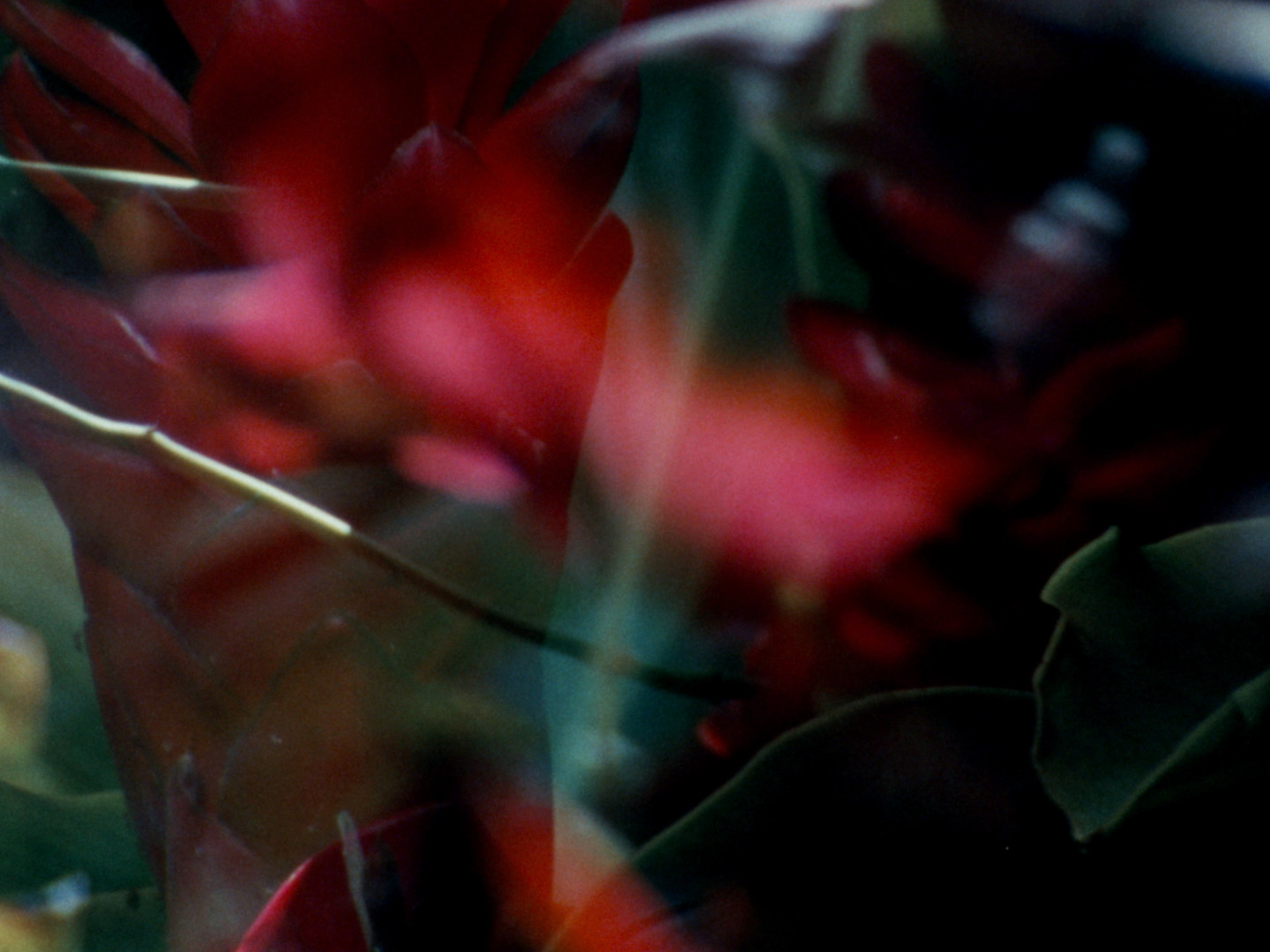
Pittsburgh Sound + Image
Pittsburgh Sound + Image is a 501(c)(3) nonprofit, formed in 2021 to create a film and video archive and cinema. Through preservation and exhibition, it is our mission to make local film history known and available to the public, alongside national and global artists who otherwise do not currently have outlets in Pittsburgh.
Return to top

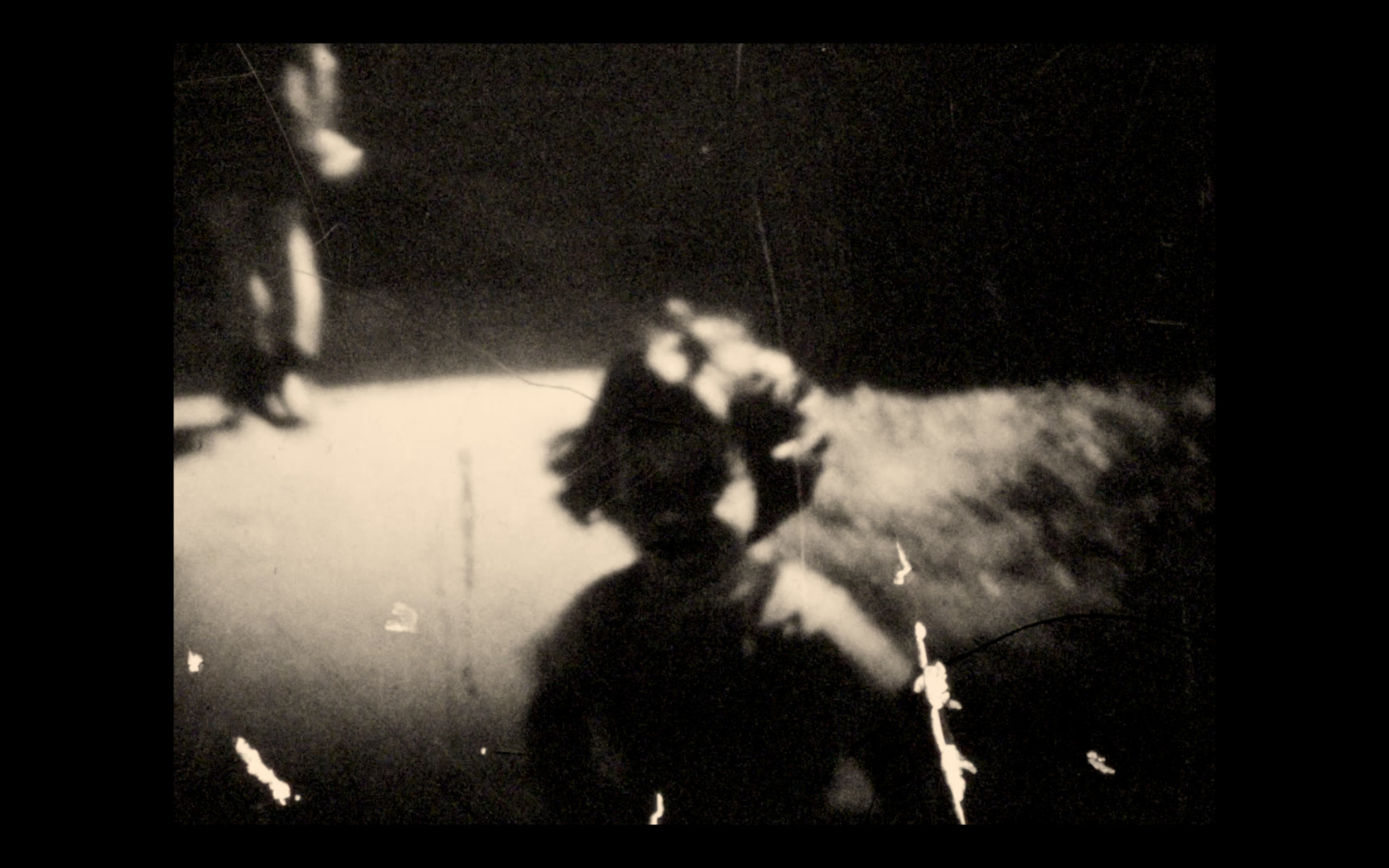
This year marks the 100th anniversary of the birth of the 16mm film format. This medium, since its inception, has always had an intimate connection with amateur, underground, and experimental film. Today, a century later, experimental film has become even more diverse, and approaches to the medium have become highly varied. Contemporary filmmakers and visual artists have continued to explore the limitless possibilities of film as a medium, while also adopting new media and methods that have sparked new directions.
If we view the hundred-year history of experimental film as constantly transforming, then the endeavors in personal and poetic experimental film today can be seen as a type of palimpsest.[1] This screening program, titled Palimpsest, is a representative program that brings together a range of outstanding works shown at RPM Festival[2] in recent years, and presents the work of three generations of experimental film artists. Their medium and methods are the central elements that drive their experimentation with the moving image. In their distinctive films, clues and evocations emerge for audiences to interpret and contemplate.
This section features a diverse range of experimental film production methods: Italian director Stefano P. Testa uses still images and collage to create the essay film Dear Monster; Canadian director Louise Bourque uses a classic small gauge film format, super8, to create a work based on family film footage; American director Monteith McCollum employs unconventional tools to produce a microcosm of the world by shooting the surface of postage stamps with an electron microscope;
Lilan Yang’s innovative approach uses an inkjet printer to output images and then creates 16mm film works using a laser cutter; California artist Kate Lain produces photosensitive materials on blank 16mm film to create abstract films that reveal an environmental consciousness by processing film in streams and creeks; experimental filmmaker Xiao Zhang, who studied at the Beijing Film Academy in her early years, examines the family space and transforms it into a physical manifestation of memory; in Takahiro Suzuki's work, the artist reinterprets the communication between trees through low-frequency radio waves; artist Laura Kraning, who lives and works in the Rust Belt city of Buffalo, uses stop-motion animation to capture the rust marks of weathered steel, tracing time.
Artists include: Louise Bourque, Laura Kraning, Kate Lain, Monteith McCollum, Takahiro Suzuki, Stefano P. Testa, Lilan Yang, Xiao Zhang
The event is organized by Wenhua Shi, Benny Shaffer and Bianca LEI with Ox Warehouse Art Center, Macau.
2cent / 10coil
- Monteith Mccollum
10mins, 2022, USA, B/W, sound, HD
Water Mining (Eaton Canyon)
- Kate Lain
5mins10secs, 2021, USA, color, sound, 16mm to HD
electric moonlight & the language within the leaves
- Takahiro Suzuki
8mins, USA, 2023, B/W & color, sound , Super8 to HD
A throwing forth
- Xiao Zhang
6mins, 2023, China/USA, color, sound, 16mm to HD
Dear Monster
- Stefano P. Testa
15mins, 2023, Italy, Color, Sound, HD
Bye Bye Now
- Louise Bourque
8mins27, 2022, Canada, color, sound, 16mm to HD
Everything Comes Full Circle
- Lilan Yang
13mins44secs, 2022, USA, B/W & Color, sound, 16mm to HD
de-composition
- Laura Kraning
2mins40secs, USA, 2023, color, sound , HD
Total: 68 mins

[1] The term "palimpsest" originally refers to the parts of a written page that have been modified and corrected while retaining traces of the original text.
[2] Revolutions per Minute festival, an artist-run festival, is dedicated to short-form poetic, personal, cinematic work in experimental, essay film, animation, documentary, video, and audiovisual performance. For more information, please visit https://revolutionsperminutefest.org
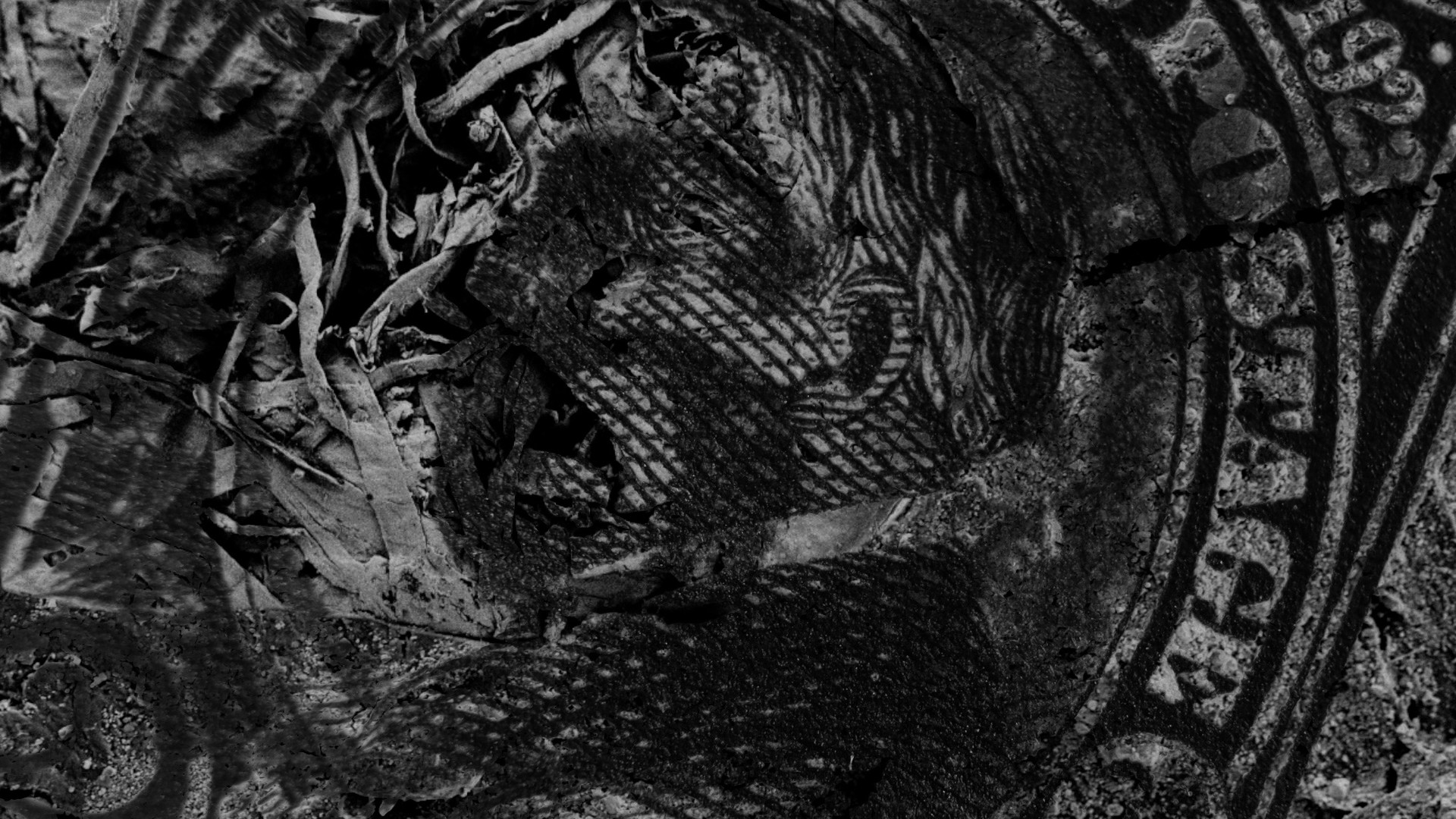
2cent / 10coil
- Monteith McCollum
10mins, 2022, USA, B/W, sound, HD
Part science, part history, 2cent / 10coil is an exploration into the physical properties of a U.S. postage stamp and the anomalies it presents when subjected to the beam of an electron microscope. Integrated within, are the philosophical musings and speeches of a man in his last weeks of life on a quest entitled, “The Voyage of Understanding.”
I like to say this subject found me. At the Analytic Diagnostics lab at Binghamton University I received training over many months culminating in access to a Scanning Electron Microscope. I was enamored with the unique possibilities the SEM offered despite its difficulties. I brought in a small stamp collection to give myself border limitations. The 1932 Harding stamp was the first to come to life. Using the SEM is a slow process, after sealing the stamp in the chamber and composing a shot there was only time for approximately 120 consecutive scans per session. This particular stamp reacted in a way the others hadn’t, fibers came to life and the ink danced. None of these images are animated with software. The mysterious movement stems from the scanning process itself and the build up of heat from the electrons rendering the object.
– monteith mccollum
Monteith McCollum is an interdisciplinary artist working across film, sound, performance, and sculpture, with a fascination with topics encompassing ecology, agriculture, urban mobility, and technology in sound. Both his experimental shorts and feature essay documentaries have frequently blended nonfiction and fiction moving between character and subject-driven concepts. Parallel with creating his own work he often has been commissioned to compose soundtracks for experimental and independent filmmakers. His live audio-visual performances and fixed media sound compositions interweave environmental field recordings with musical assemblages incorporating strings and modular synthesis. Feature documentaries and shorts have been exhibited and broadcast on PBS’s “POV” series as well as presented in museums such as MOMA’s New Directors / New Films, Wexner Center for the Arts, and The Hirschhorn. Film festivals have included South by Southwest, Slamdance, Hot Docs, IDFA, Osnabruck Intermedia Film Festival, The New York City Electroacoustic Music Festival, and San Francisco International Film Festival. In addition to screenings his work has received generous financial support from the New York Foundation for the Arts, NYSCA, Kodak,
The Rockefeller Foundation, The National Endowment on the Arts, Iowa Arts Council, POV, and the Jerome Foundation.
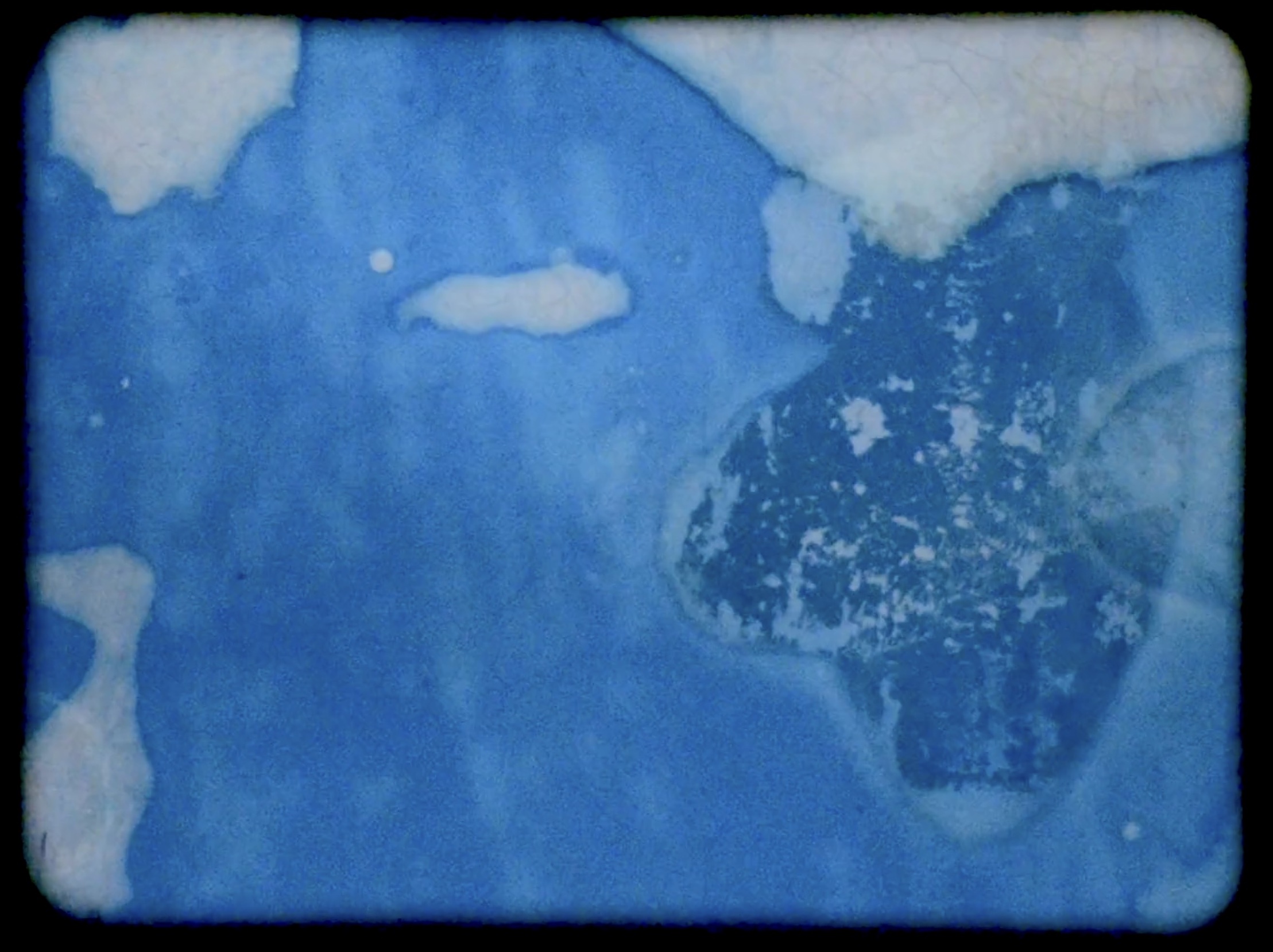
Water Mining (Eaton Canyon) -
Kate Lain
5mins10secs, 2021, USA, color, sound, 16mm to HD
Water Mining (Eaton Canyon) is a nature document(ary) made *with* a stream, rather than about it. Its images come from a combination of cyanotype, a blue-and-white photographic process dating back to the 1840s, and actual plant material adhered to physical film. I hand-coated clear 16mm leader with cyanotype chemicals, then used sunlight to make photogram-style, cameraless exposures of plant matter I had gathered in and around the stream in Eaton Canyon. Cyanotypes are processed using water, and for this film, I used stream water that I had also collected from the canyon. I approached the film as though the stream, what was in it, its surroundings, the film, the chemicals, and I were all extensions of one another.
Kate Lain
is a Los Angeles–area multidisciplinary artist working in film, video, clay, and other media. Her experimental film and video work
verges on documentary and spans a wide range—from essay film to stopmotion collage to impressionist portraiture. Her works have screened
at festivals, microcinemas, museums, and other spaces across North America and Europe.
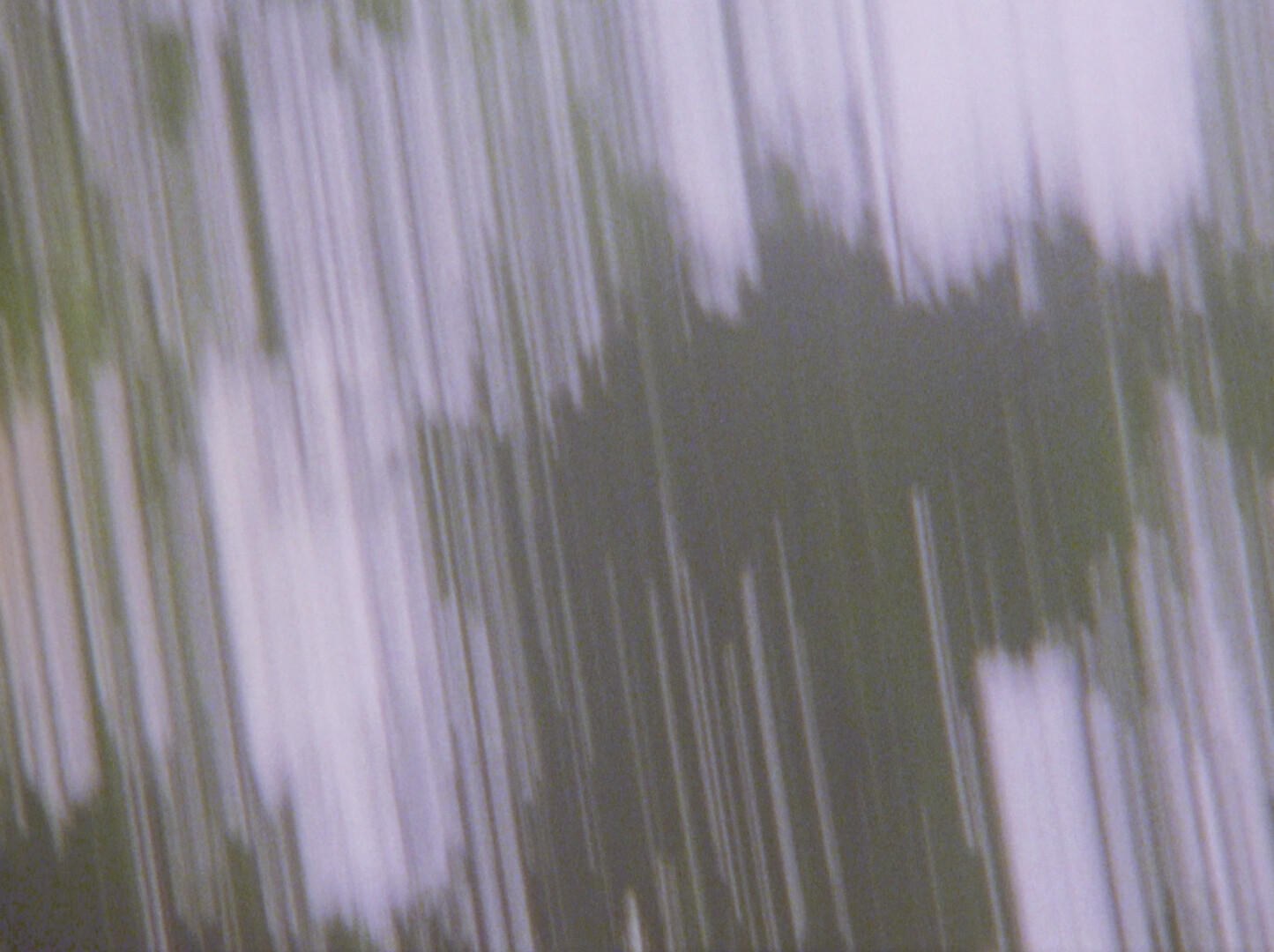
electric moonlight & the language within the leaves
- Takahiro Suzuki
8mins, USA, 2023, B/W & color, sound , Super8 to HD
a modern re-telling of the japanese tale of the bamboo cutter and the moon princess. the moon princess listens to the untold intelligence of the cosmos as observed by the trees to become closer with and eventually return home.
Takahiro Suzuki (he/him/his) is an artist currently residing in Portland, ME (USA). He completed his BA in Studio Art from the University of Virginia concentrating in the media of photography and cinematography, and received his MFA in Film, Video, Animation, and New Genres from the University of Wisconsin-Milwaukee.
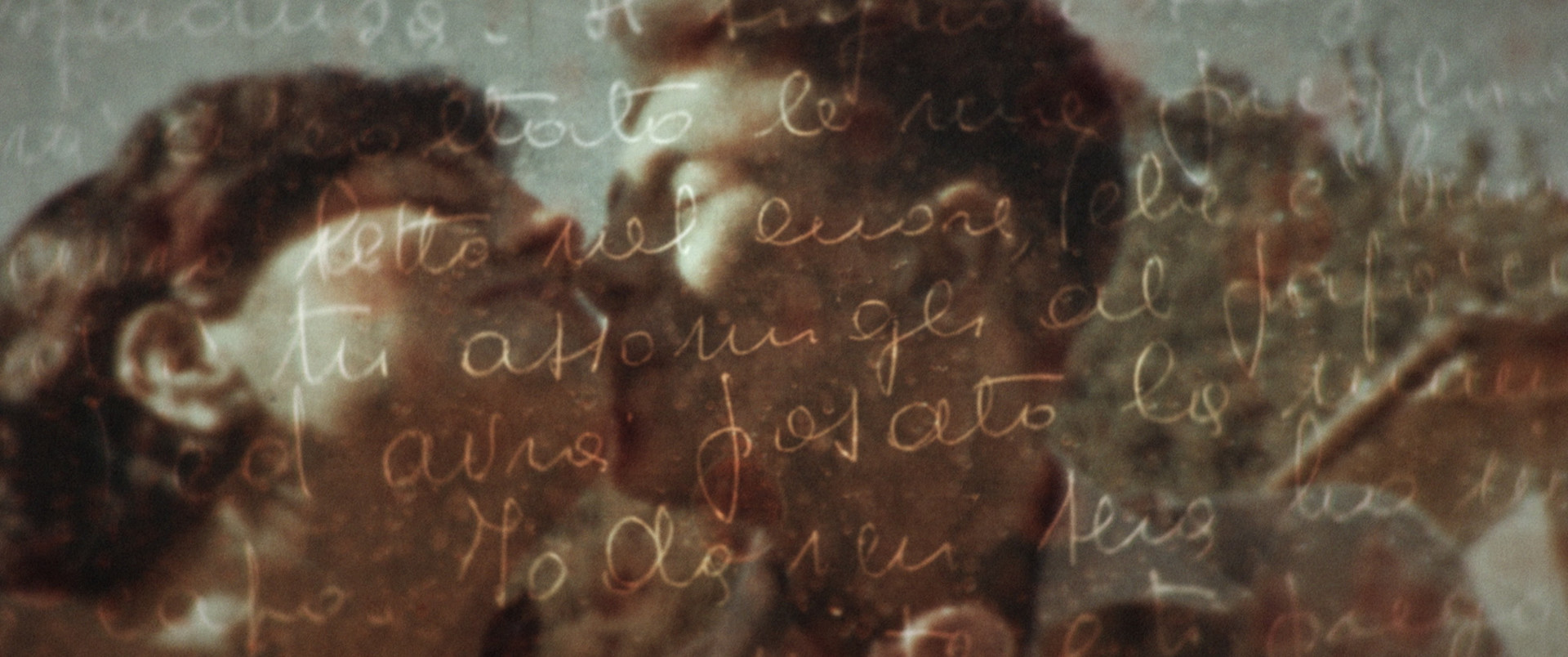
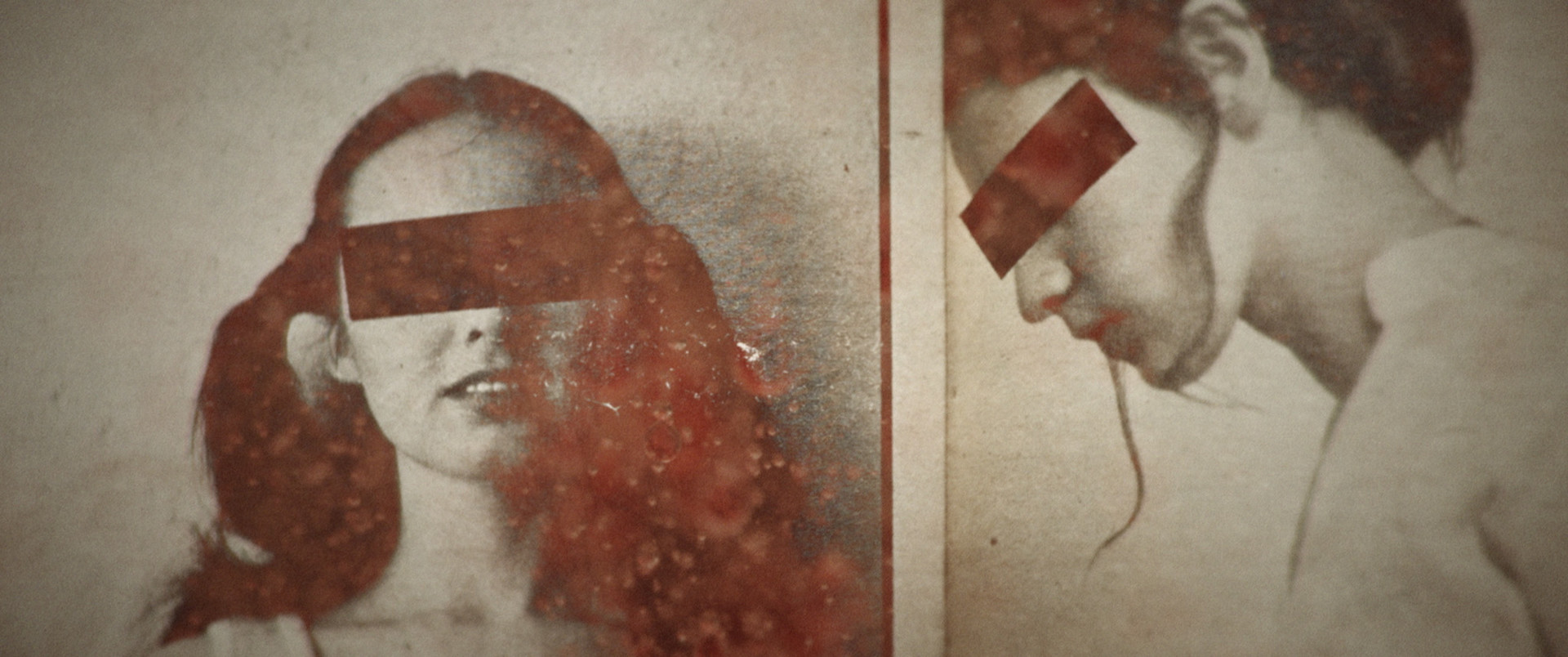
Dear Monster -
Stefano P. Testa
15mins, 2023, Italy, Color, Sound, HD
A fragmented collection of letters tells the story of Elio’s passage from adolescence to adulthood. Elio is a restless and disobedient Italian 18-year-old fellow who lives his youth between cheating and betrayals during the swinging 60s.
“Dear Monster” is a collection of authentic documents. However, there are few historical and biographical references to the characters. Voices and handwriting are the only elements useful to draw the senders’ psychological profiles. The texts are read and interpreted by actors; the voices are inserted into sound environments, as if hypothetically present at the time of writing. The film develops visually through a slow overlap of symbolic and evocative images of the inner universe of the young Elio. Through the use of fade effects, the pages of the letters merge with photographs, magazine clippings and some amateur films of the time. The result is a stratification of worn-out textures and faded colours. “Dear Monster” is a backward journey in memories, in search of lost affections.
Stefano P. Testa was born in 1988. He lives and works in Bergamo (Italy) as a camera operator, video editor, colorist and post-production technician. Since 2010 he has been collaborating with Lab 80 film in documentary films production and with Bergamo Film Meeting, in charge of the festival audiovisual communication.
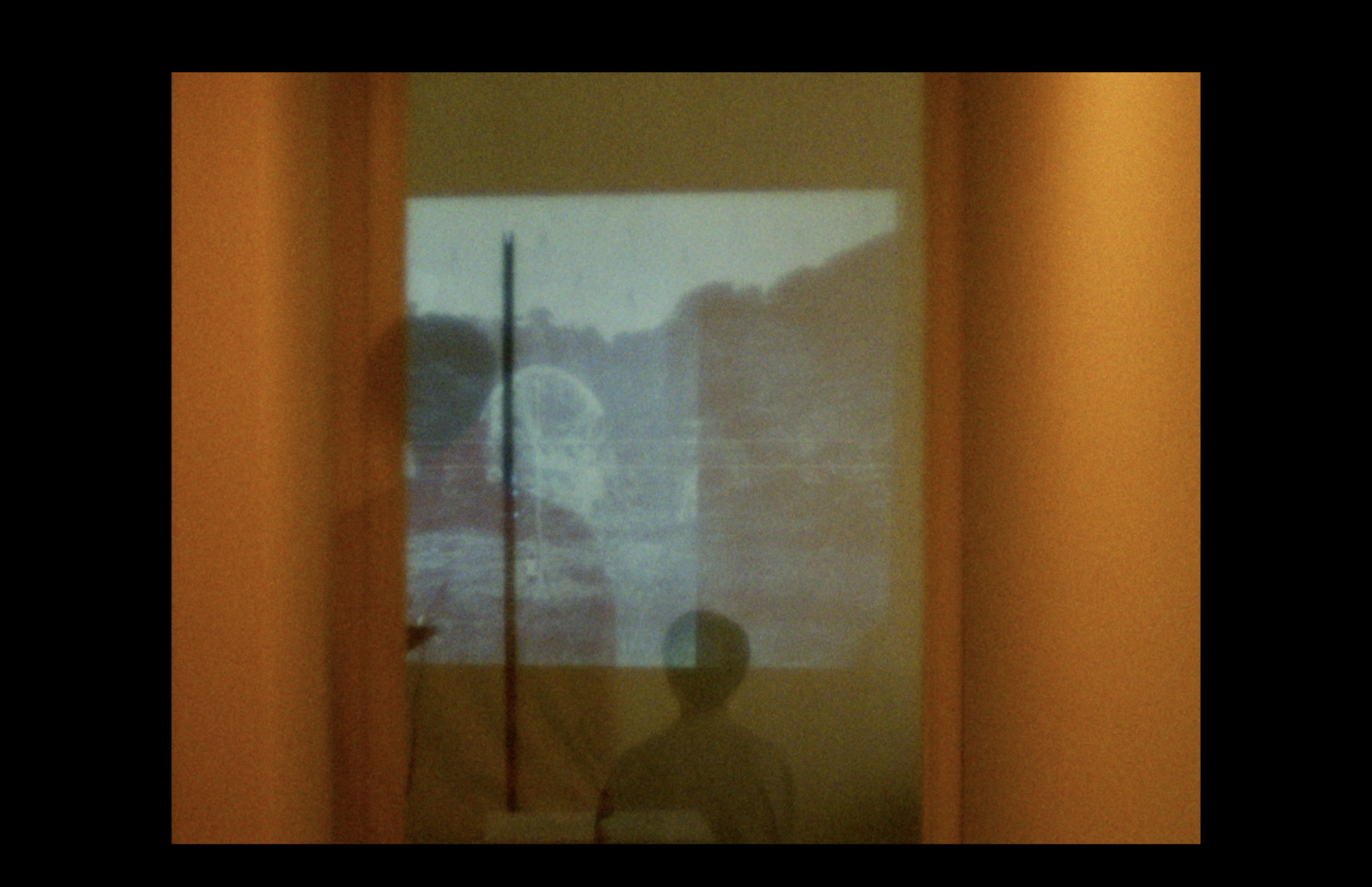
A throwing forth
- Xiao Zhang
6mins, 2023, China/USA, color, sound, 16mm to HD
A time remnant inhabits a personal space with a secret, private, unspoken word of one's being. Sliding planes of window and time, throwing drifts of the inner and the outer self, the film seeks in the interval of memory for a transitory reunion with my family.
Xiao Zhang is an artist-filmmaker from China living in Los Angeles. She received her BFA at Beijing Film Academy in 2020 and currently holds an MFA in Film/Video at CalArts. Her practice centers on personal poetics which derives from cross-generation memory and diaristic approaches. It continues by employing methods drawn from handcrafted celluloid film and expanded cinema. Her work often offers a complex fluctuation between material reality and subjective experience.
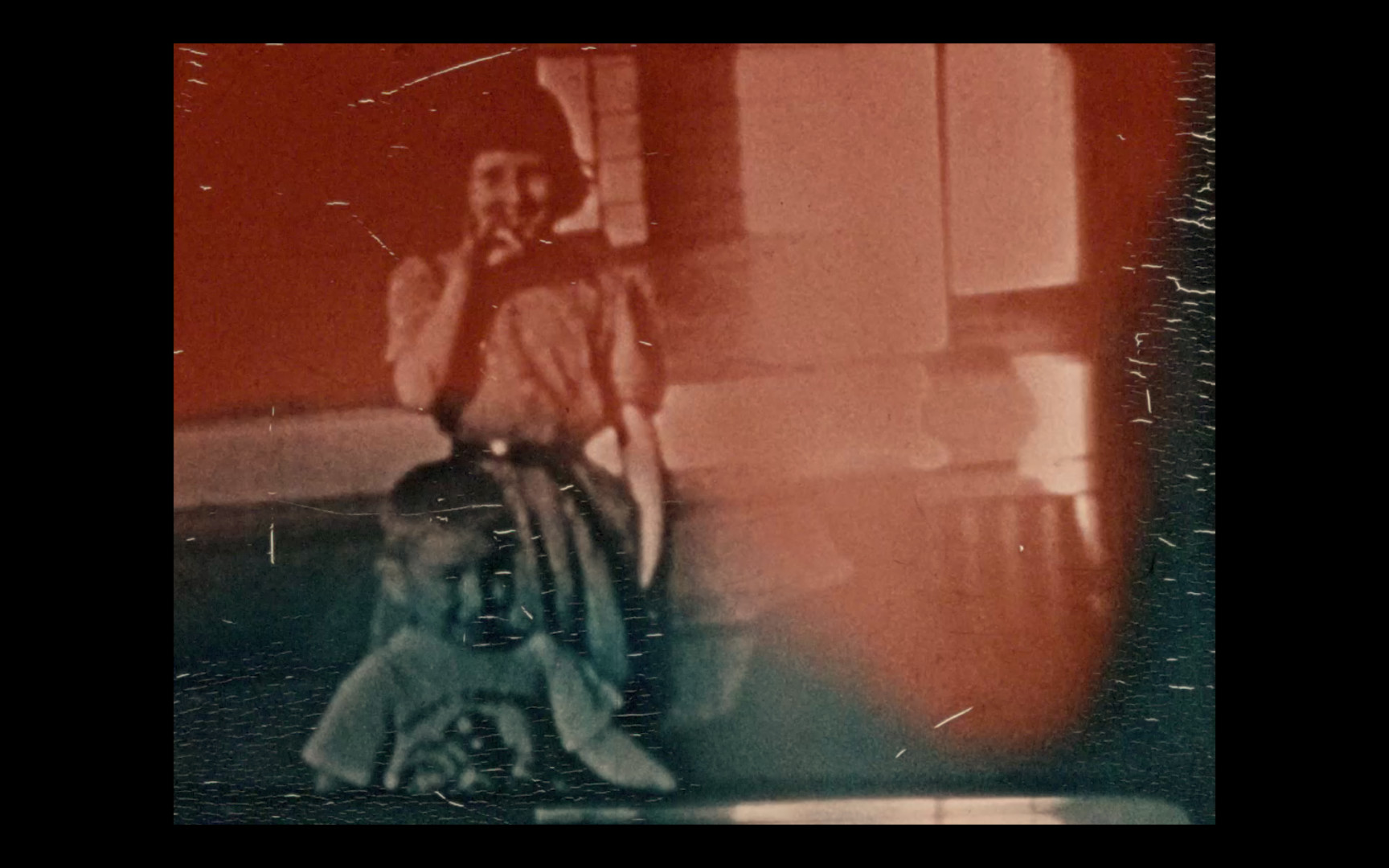
Bye Bye Now -
Louise Bourque
8mins27, 2022, Canada, color, sound, 16mm to HD
Waving hello to the filming cameraperson, the subjects through this very gesture, are also providing a future viewer with the acknowledgment of a constant good-bye to a fleeting moment.
Yet when the film is projected and the captured gesture is seen, it's as if the subjects are saying hello again from the past.
This film is an homage to the artist's father, the man behind the camera in these personal family archives.
The filmmaker
Louise Bourque recently moved back to Montréal after spending 30 years in the United States and elsewhere. Her films have been screened in more than forty-five countries and broadcast on PBS and the Sundance Channel in the US as well as on Télé-Québec in Canada and SBS in Australia. Her work has been presented by major galleries and museums worldwide, including the Musée de la Civilisation and the Musée national des beaux-arts du Québec in Québec city, the National Gallery of Art in Washington, D.C., the Museum of Modern Art and the Whitney Museum of American Art in NYC.

Everything Comes Full Circle -
Lilan Yang
13mins44secs, 2022, USA, B/W & Color, sound, 16mm to HD
Following Wim Wenders’ Paris, Texas (1984) filming locations from Houston, Texas to Los Angeles, California, I use a 16mm Bolex camera to capture the vastness of the American West. The footage draws me to reminisce about snippets of my everyday life. I contemplate how we perceive the world through analog optical apparatuses and how memories are multidimensional yet fragile. Our recollections of people and places can be distorted, unrecognizable, and fictitious. These memories would eventually diminish with the passing of time. Everything Comes Full Circle is a personal attempt to remember things that will soon be forgotten.
The original footage was shot in Kodak 16mm film stocks during the summer of 2021 and edited digitally with voiceover. Later the digital moving images were inkjet printed on clear film spliced together with perforations cut out with a laser cutter. Each run of the projection makes the printer ink slowly melt, and the film will eventually fall into decay over the course of time.
Lilan Yang is an artist and experimental filmmaker from Chongqing, China. Her practice explores the myth of cities and landscapes, ways of seeing and unseeing, and sentiments of remembering and forgetting, through lens-based analog media such as 16mm filmmaking and 35mm photography, as well as digital technologies such as machine learning and data visualization. She received a BS in Computer Engineering from University of Illinois at Urbana-Champaign and an MFA in Digital + Media from Rhode Island School of Design.
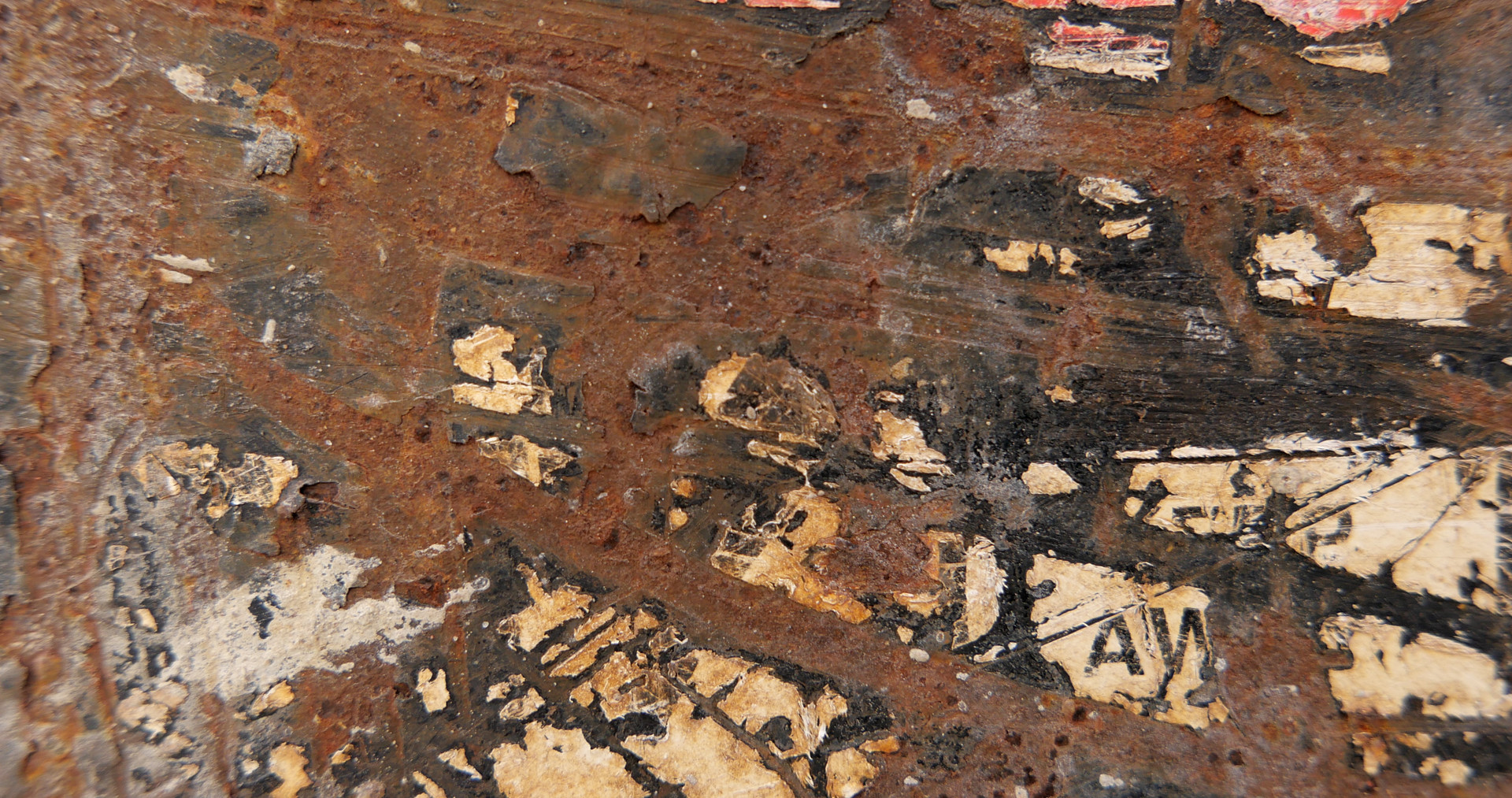
de-composition -
Laura Kraning
2mins40secs, USA, 2023, color, sound , HD
A textural macro collage of a rust belt landscape- scratched, splattered, dripping, cracking, and bursting to the surface. Photographed and meticulously edited over one year in Buffalo, NY, the reverberant tones of the New York Central rail line provide the rhythmic pulse to a rapid cascade of multi-hued material decay and metallic de-composition.
Laura Kraning’s moving image work navigates landscape as a repository for memory, cultural mythology, and the technological sublime. Exploring absence and the fluidity of time, she evokes liminal spaces of neither past, nor present, but a landscape of the imagination. Laura’s work has screened widely at international film festivals, such as New York, Rotterdam, London, Edinburgh, San Francisco, Ann Arbor, Antimatter, Visions du Réel, and Festival du Nouveau Cinema, among others. She is a recipient of the Princess Grace Foundation John H. Johnson Film Award, the Leon Speakers Award and Jury Awards at the Ann Arbor Film Festival, the Film House Award at the Athens International Film and Video Festival and the Jury Award for Short Film at Rencontres Internationales Sciences et Cinémas.
Return to top
Ox Warehouse is a private and non-profit art association offering free admission exhibitions. It is an art space open to local artists and art associations for collaborative projects, making the venue an experimental platform for Macau’s artistic creation.
The Ox Warehouse presents exhibitions and performances of contemporary art, trying to provide an alternative platform to the local arts scene. Being dedicated to the promotion of art, the Ox Warehouse also organizes inspirational artistic workshops, in order to foster individual creativity and the experimental spirit, as well as cross-border exchange programs.

實驗電影在今年是值得特別紀念,因為這是電影十六毫米膠片規格誕生100週年,這一媒介在誕生之際, 就與非專業/實驗視覺語言接下不解之緣。
在一百年之後的今天,實驗電影與實驗影像更是豐富多彩,媒介也相當多元,實驗影像藝術家也是倍有才人出,新媒介觸發新方向,我們是否可以認為「媒介即影像,方式即記憶」。 如果把百年實驗影像歷史視為一段記憶,那麼今天的個體實驗影像的嘗試可以被視為Palimpsest。
Palimpsest 原意是指書寫頁面上被修改更正的部分,並同時保留原文的印跡。這些「印跡」正成為一條條線索不斷給予觀眾解讀實驗影像的通道。
《有關記憶》實驗影像放映單元是從轉速節的展映作品裡挑選出的代表節目,這是一場集結老中青三代實驗影像藝術家的盛宴。本單元裡呈現多元化的實驗影像生產方式: 既有Stefano P. Testa 使用靜格拼貼組合義大利短片作品「親愛的魔鬼」;也有加拿大導演 Louise Bourque 以經典小規格膠片運用超8電影家庭影像為素材的創作; 美國導演Monteith Mccollum使用非常規工具生產,用超精度顯微鏡拍攝硬幣表面微觀大千世界;才女 Lilan Yang 更有用油墨打印機輸出圖像,再用激光切割機自製16毫米膠片作品;美國加州藝術家 Kate Lain在空白16毫米膠片上自製感光材料,利用河流小溪沖洗的環保意識的「水跡」抽象電影;早年就讀於北京電影學院的實驗電影人 Xiao Zhang 審視家庭空間,將其轉換成記憶的實體;在 Takahiro Suzuki 作品中,作者遙想樹木間以低頻電波隔空交流;居住在鐵繡城市布法羅的藝術家 Laura Kraning 用定格動畫方式拍攝風化岩融下的鋼鐵鏽跡,也堪稱「歲月痕跡」。

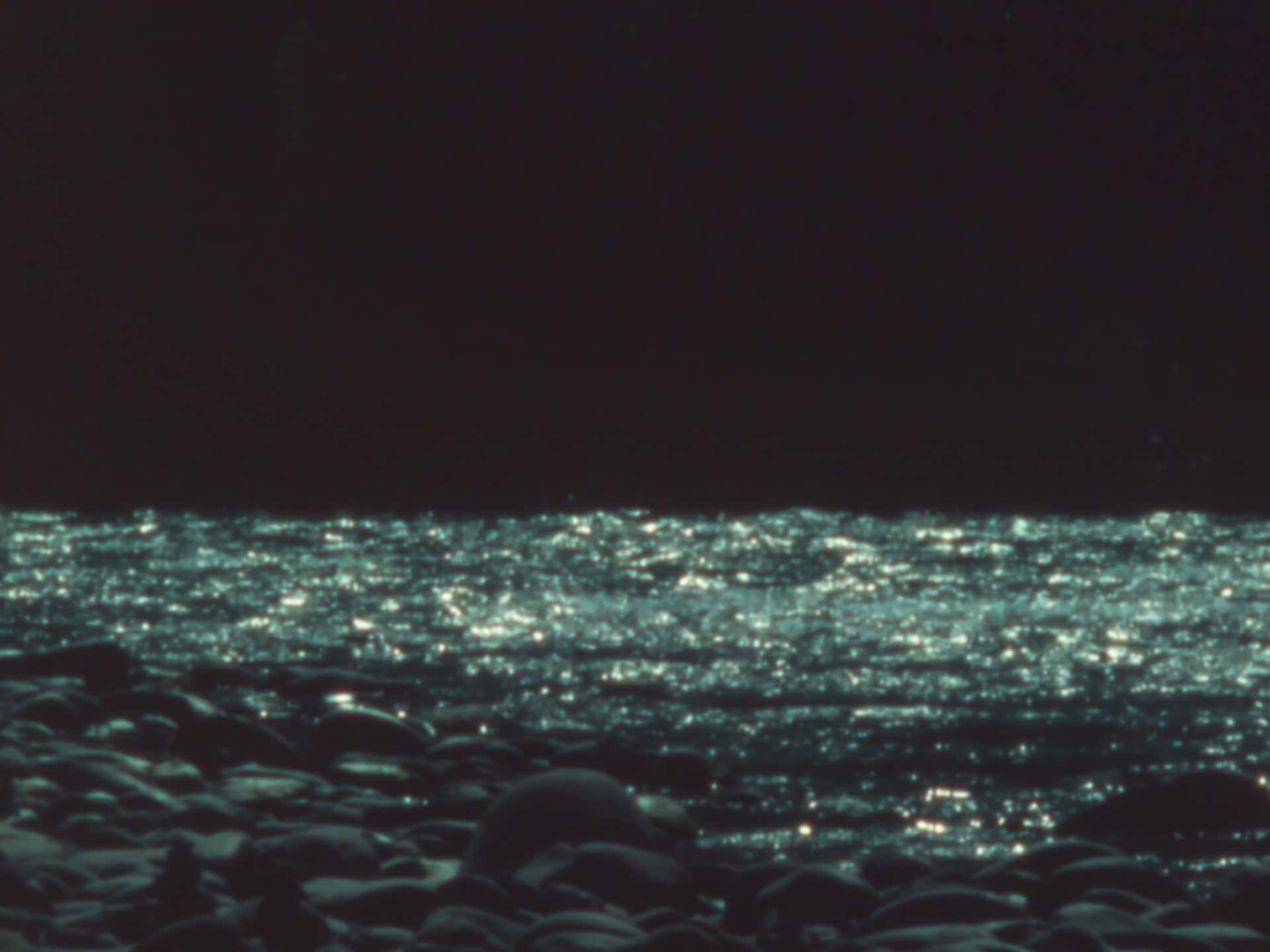
Public Reception: 9.29.23 from 5-7PM
Artists include: Brit Bunkley, Heather Cassano, Abigail Hendrix, Jodie Mack, Kym
McDaniel, Tess Martin, and Vito A. Rowlands
This year's exhibition, titled Room to Breathe, was co-curated by Samuel Toabe,
Director of University Hall Gallery, and Wenhua Shi, Associate Professor of Art and Art
History. A total of seven video installations were juried from forty-seven submissions.
The exhibition explores the possibility of the exhibition space to act as a site or a
sanctuary for energizing, renewing, and meditating.

Dear Hart - How they dream. How we dream. - Brit Bunkley
(2023, 3:38m loop, Sound, Color, Digital, New Zealand)
M*U*S*H* - Jodie Mack
(2022, 8m loop, Color, Silent, 16mm to Digital, UK/USA)
Nimueh Triptych - Abigail Hendrix
(2023, Three-channel 9:29m loop, Color, Sound, 16mm to Digital, USA)
Madness - Heather Cassano
(2022, Three-channel 16m, 24m & 24m loop, Color, Sound, Digital, USA)
Still Life with Woman, Tea and Letter - Tess Martin
(2022, 2:14m loop, Color, Sound, Digital, Netherlands)
Invisible World - Kym McDaniel
(2022, 4:51m loop, Color, Sound, Digital, USA)
Immaculate Generations no. 1
- Vito A. Rowlands
(2022, 11m loop, Color, Sound, Digital, Belgium/USA)
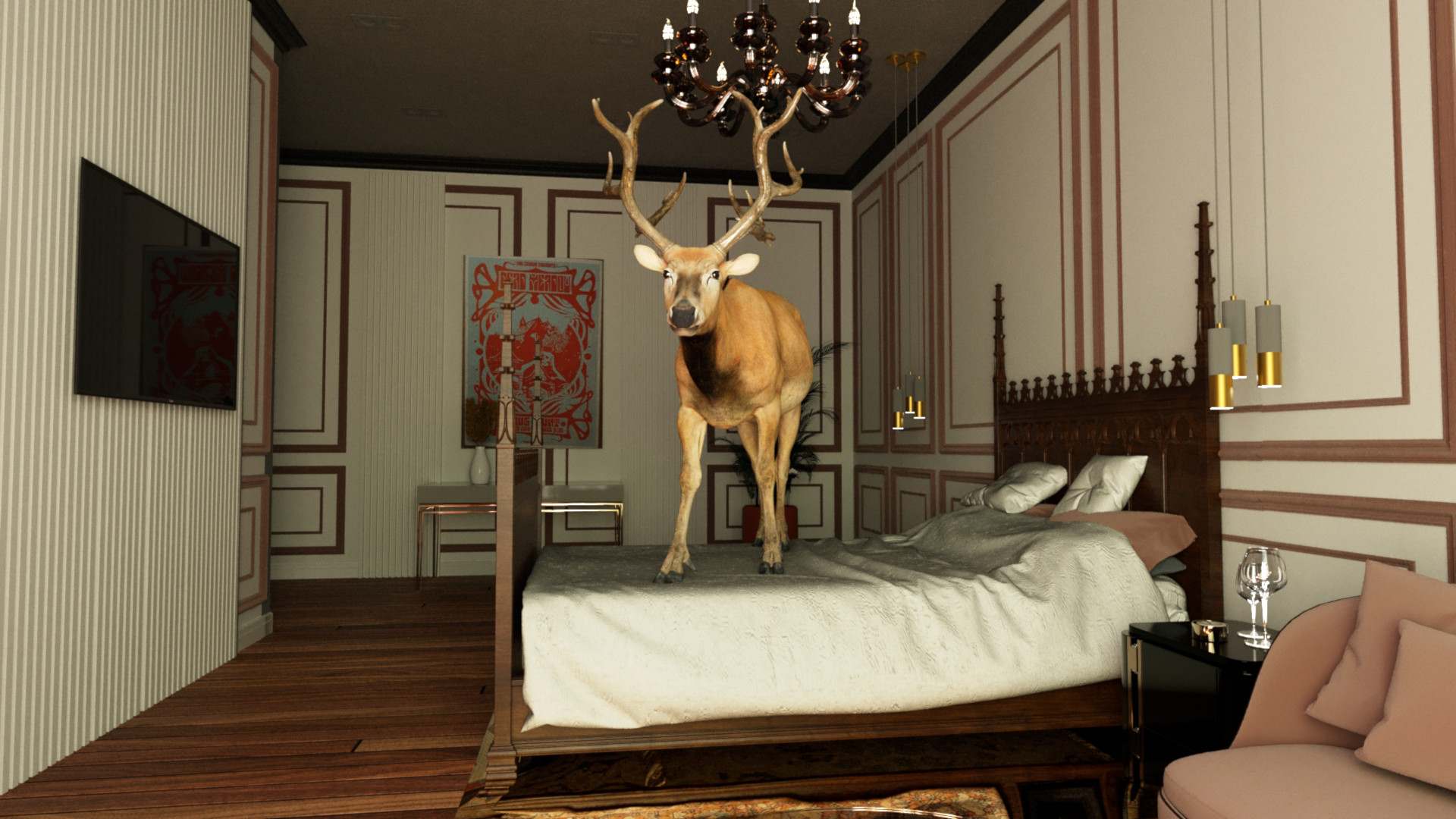
Dear Hart - How they dream. How we dream.
- Brit Bunkley
(2023, 3:38m loop, Sound, Color, Digital, New Zealand)
"Dear Hart, How they dream. How we dream" consists of animations of a hybrid Père David's deer combined with video footage where deer inhabit human space in a deep fake video of dreams.
The Père David's deer is an unusual animal whose antlers grow like tree branches - a chimerical animal. “The species is sometimes known by its informal name, sì bú xiàng… literally meaning four not alike… or like none of the four...The hooves of a cow but not a cow.
Brit Bunkley is a New Zealand-based artist and videographer whose practice includes the construction of large-scale outdoor sculpture and installations as well as the creation of ‘impossible’ moving and still images and architecture designed using 3D modeling, video editing, and image editing programs.
Bunkley, an NZ/USA citizen, has also been a recipient of a National Endowment for the Arts fellowship and the Rome Prize Fellowship in the USA.
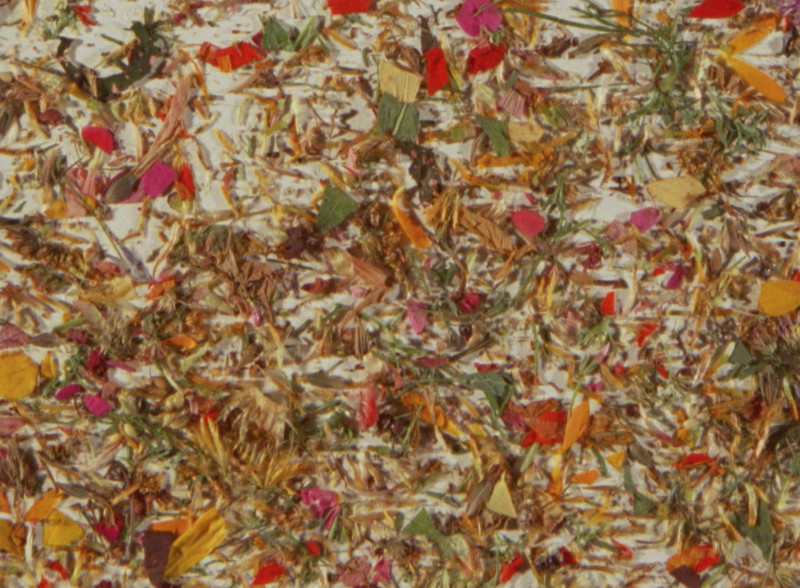
M*U*S*H* - Jodie Mack
(2022, 8m loop, Color, Silent, 16mm to Digital, UK/USA)
Vital grief finds interplanetary putrescence.
Jodie Mack
is an experimental animator. Her films unleash the kinetic energy of material remnants of domestic and institutional knowledge to illuminate the relationship between decoration and utility. Straddling the boundary between rigor and accessibility, her cinema questions how we ascribe value to things.

Nimueh Triptych - Abigail Hendrix
(2023, Three-channel 9:29m loop, Color, Sound, 16mm to Digital, USA)
Nimueh is a hybrid 16mm and digital 3-channel installation that explores the mythologizing of the body after violence and death.
Abigail Hendrix is a writer, photographer, and filmmaker based in Boston, MA. With a BA in anthropology from the University of Washington, Hendrix is currently pursuing an MFA in Film and Media Art at Emerson College with emphases on animation, experimental media, and ethnography. Hendrix has edited short documentaries and concert videos for Smithsonian Folklife, Smithsonian Folkways, and The Roadwork Center, and has written screenplays and non-fiction prose pieces for various publications such as Smithsonian Folklife.
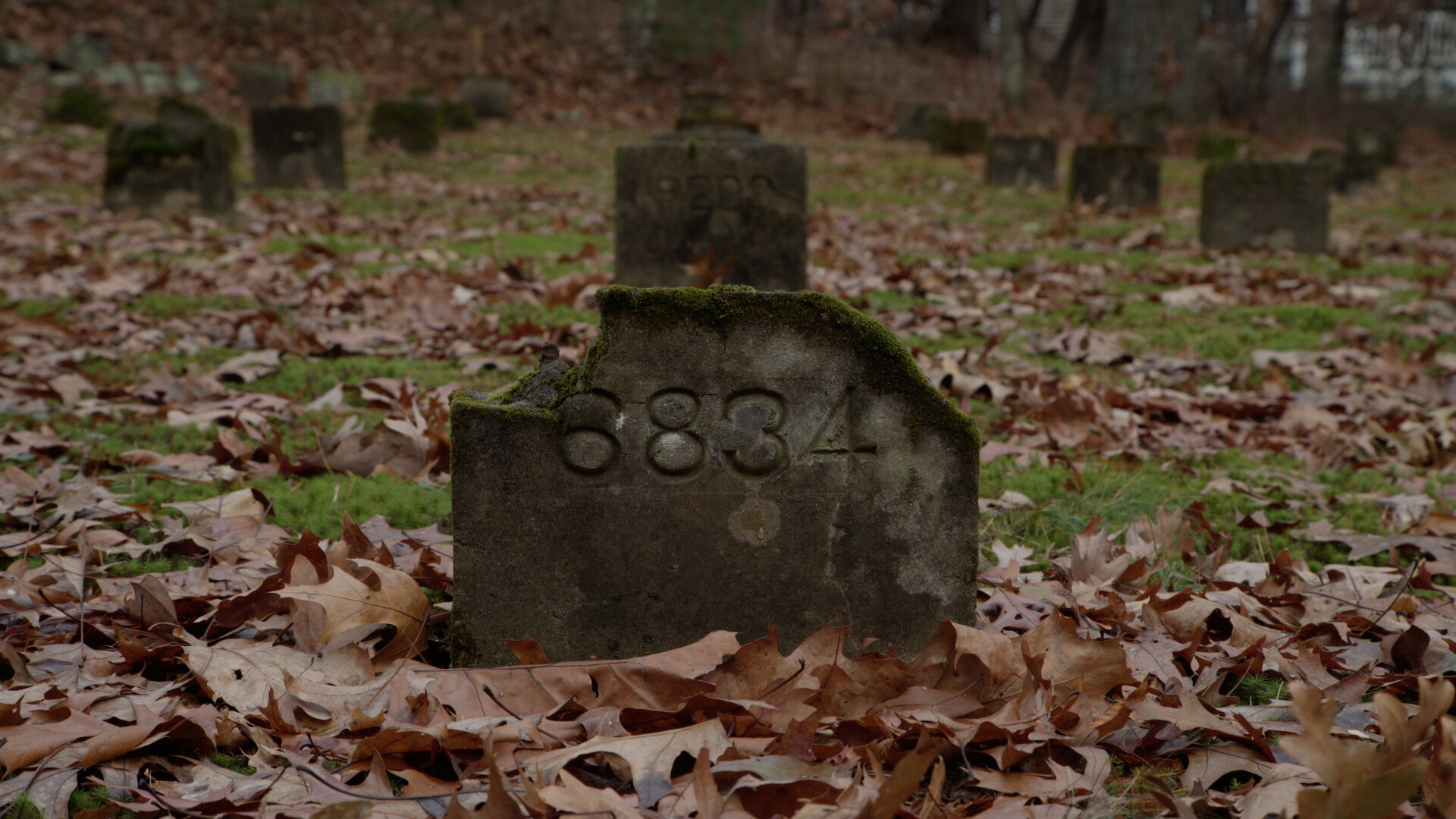
Madness - Heather Cassano
(2022, Three-channel 16m, 24m & 24m loop, Color, Sound, Digital, USA)
MADNESS is a three-channel video installation featuring archival video, moving imagery from mental institution cemeteries, and text-on-screen detailing the number of graves present at each gravesite. The archival video is taken from a series of films produced in the early 1950s featuring Dr. Heinz Lehmann describing eight forms of "mental symptoms" as they appear in the mentally ill. Mental institutions and state school cemeteries exist in every state in the contiguous United States.
Heather Cassano is a documentary film and media artist working at the intersection of observational and poetic documentary. Her work often frames narratives through her personal experiences, exploring the idea of “otherness” as it relates to mental health, disability, and established social norms. She has presented work in the form of documentary films, multi-channel video installations, and still photography.
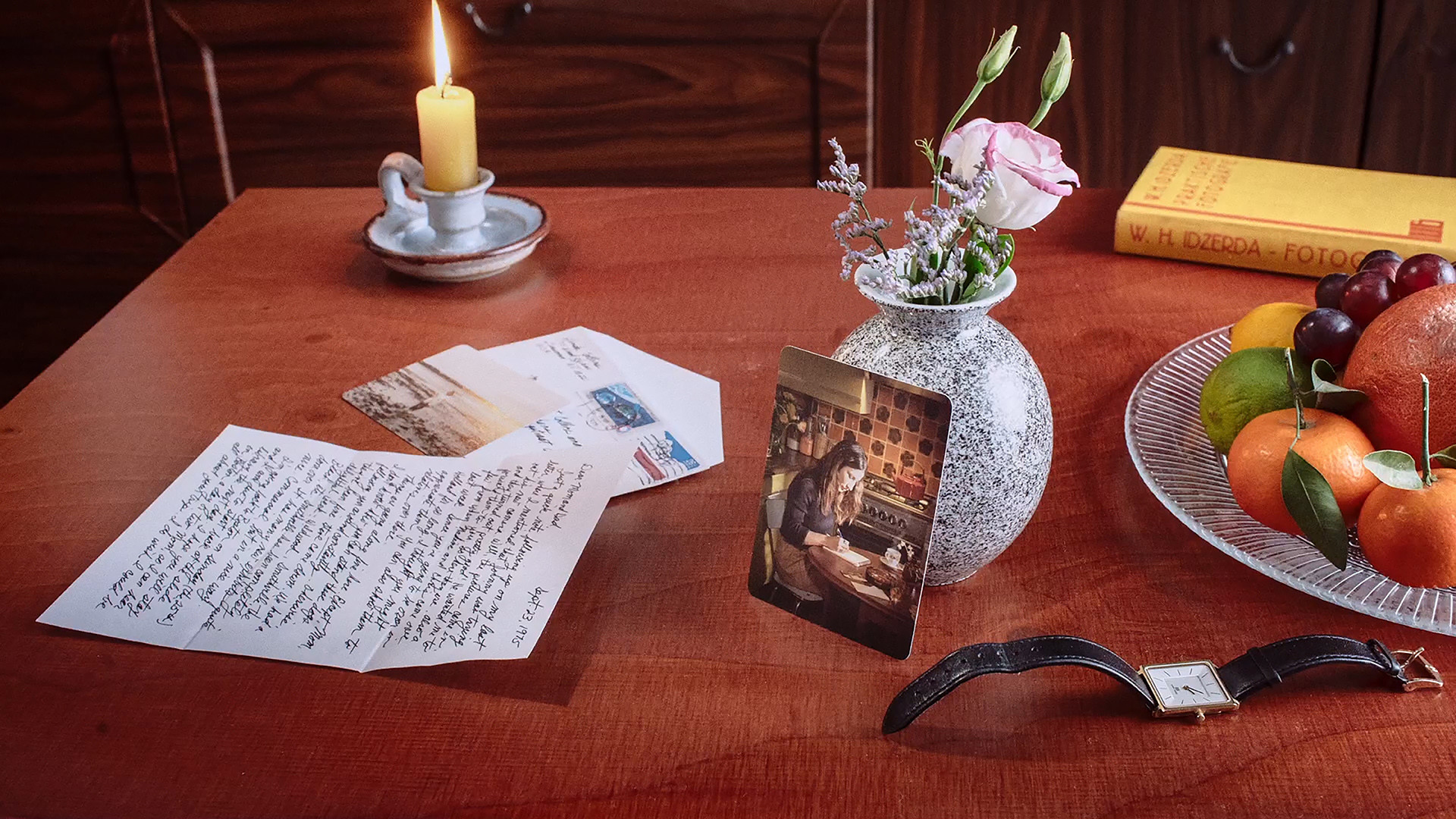
Still Life with Woman, Tea and Letter - Tess Martin
(2022, 2:14m loop, Color, Sound, Digital, Netherlands)
A photograph is a window into the past, but sometimes the border between the past and the present is not entirely clear. This stop-motion animation invites us to think about our relationship to time by portraying one woman caught in the middle.
Tess Martin is a filmmaker/visual artist based in Rotterdam, The Netherlands. Her work is informed by hand-made animation techniques and their potential to explore the human condition. Persistent themes are our place in nature, our relationship to the past, and how memory and perception inform identity. She creates short films, interactive installations and paintings/prints.
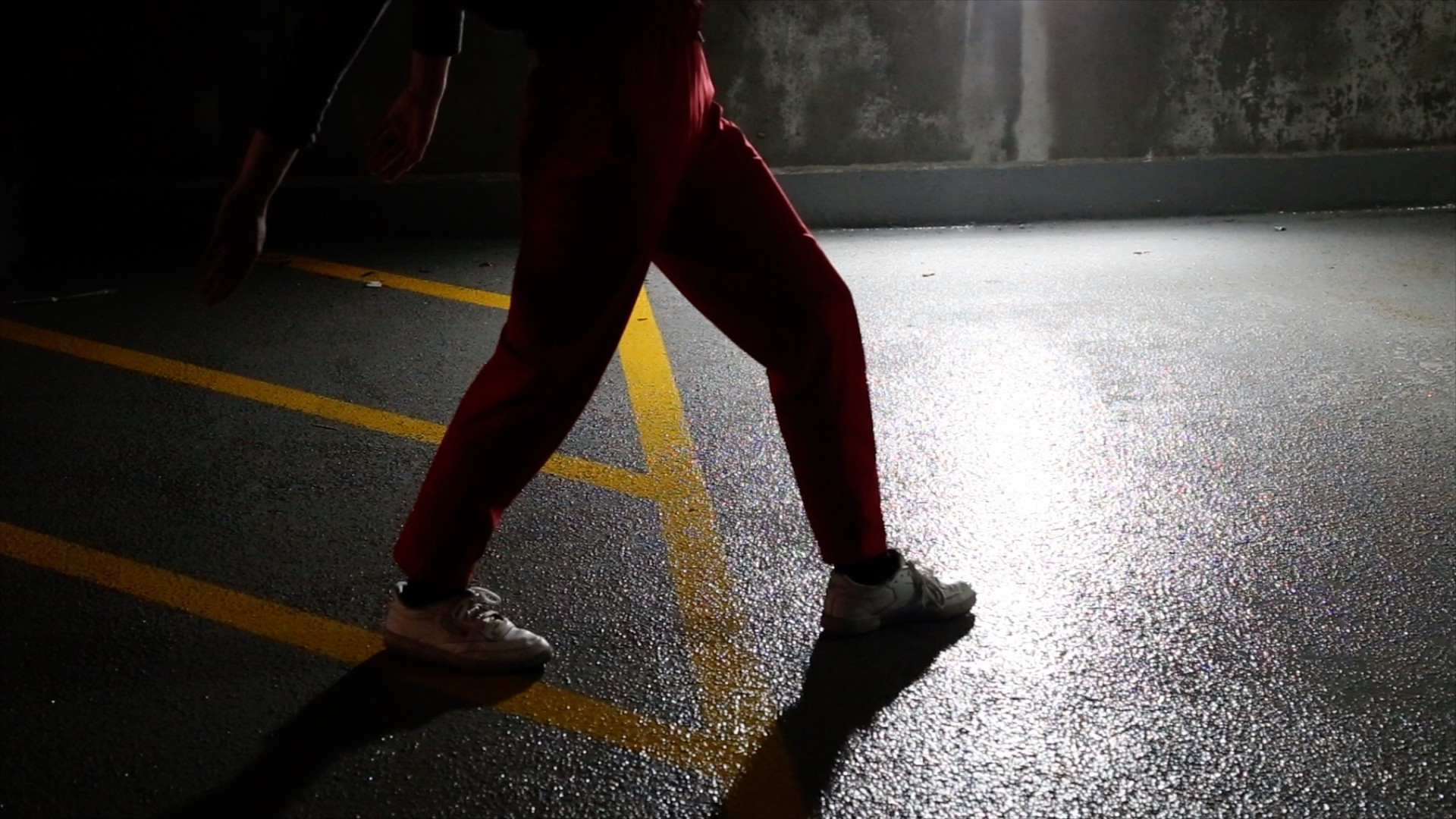
Invisible World - Kym McDaniel
(2022, 4:51m loop, Color, Sound, Digital, USA)
To apply for an accessible or Crip parking placard, a doctor within the state must approve the application. As part of the application, there are six medical conditions which qualify a person for a placard. These conditions include: (1) cannot walk two hundred feet without stopping to rest; (2) cannot walk without the use of an assistance device; (3) is restricted by lung disease; (4) uses portable oxygen; (5) has a cardiac condition; (6) is severely limited in their ability to walk due to an arthritic, neurological, or orthopedic conditions. Many people with disabilities are included in these categories, and many are not.
Kym McDaniel (she/her) is queer, invisibly disabled, experimental filmmaker, choreographer, and performer. She began working in video after a head injury changed her relationship to her body, dance, and choreography. She uses image collages, text, gesture, and the body to explore chronic illness, queerness/disability, and structural dissociation. She is an AmSAT Alexander Technique teacher and has an MFA in Film, Video, Animation, and New Genres from the University of Wisconsin-Milwaukee.
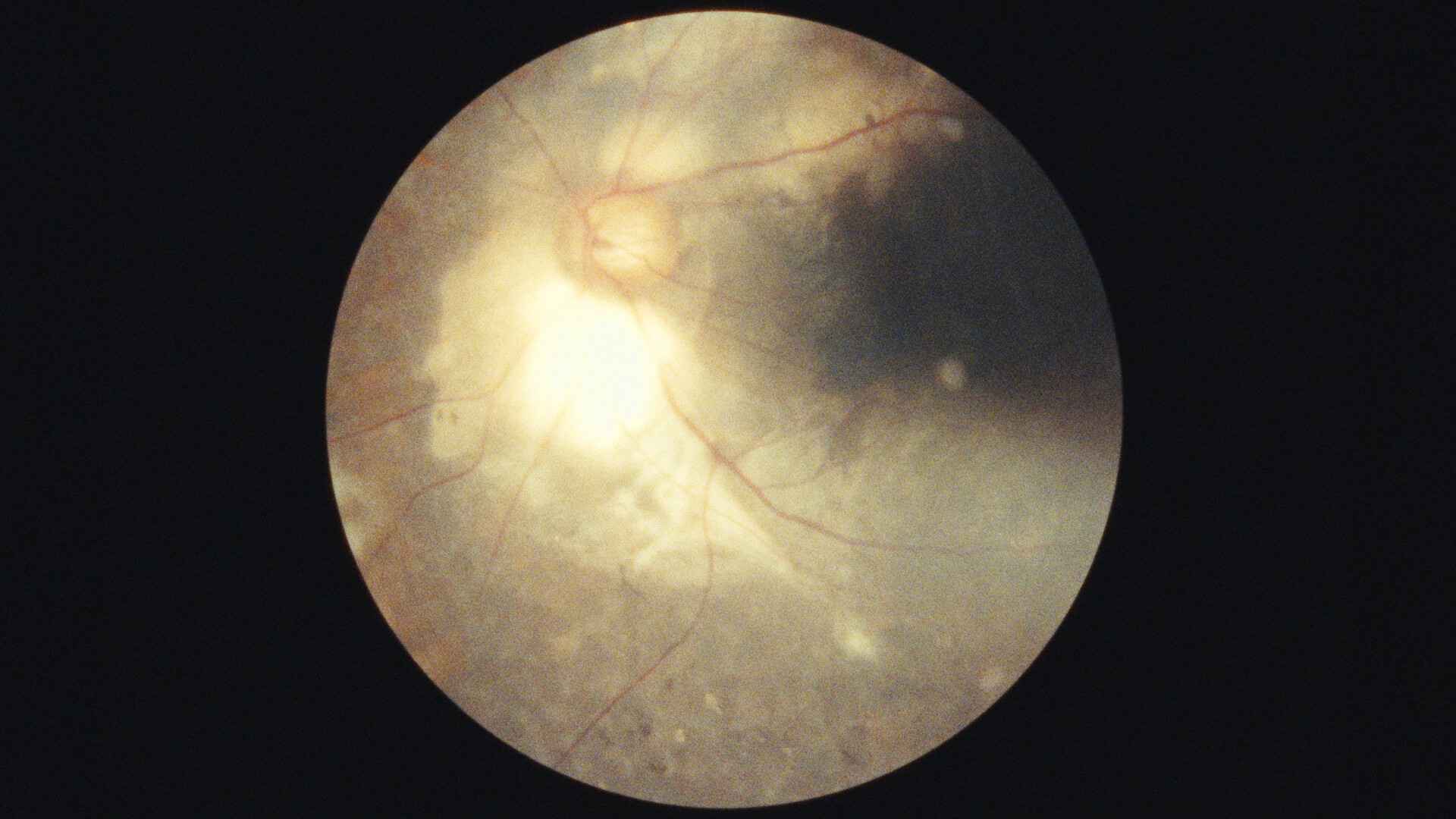
Immaculate Generations no. 1 - Vito A. Rowlands
(2022, 11m loop, Color, Sound, Digital, Belgium/USA)
If the eyes are the window to the soul, "Immaculate Generations no. 1" presents its viewer with a singular look into thousands of souls. Equal parts Carl Sagan and William Blake, this flicker film is composed of tens of thousands of individual retinal photographs from public databases. Animated between 12 and 24 frames per second, they make for a dazzling rush into the maelstrom of life as we perceive it. Every retinal exposure is a galaxy, replete with its own sun, star-studded clouds, and light refracted through time and space.
Vito A. Rowlands(Antwerp / 1986) is a Belgian filmmaker and scholar whose films have toured internationally. His feature script "Elvis, We Like Your Music," was a finalist at the 2021 Sundance Film Festival Development Track, and his short "Into the Silver Ether" (2020) was in competition at the Raindance, Brooklyn and HollyShorts film festivals. Vito has taught in Amsterdam, Brussels, and Copenhagen, as well as at Columbia University. He is currently an Assistant Professor of Experimental Film and Media at New York University's Tisch School of the Arts, and a 16mm film instructor at Mono No Aware in Brooklyn.
Return to top
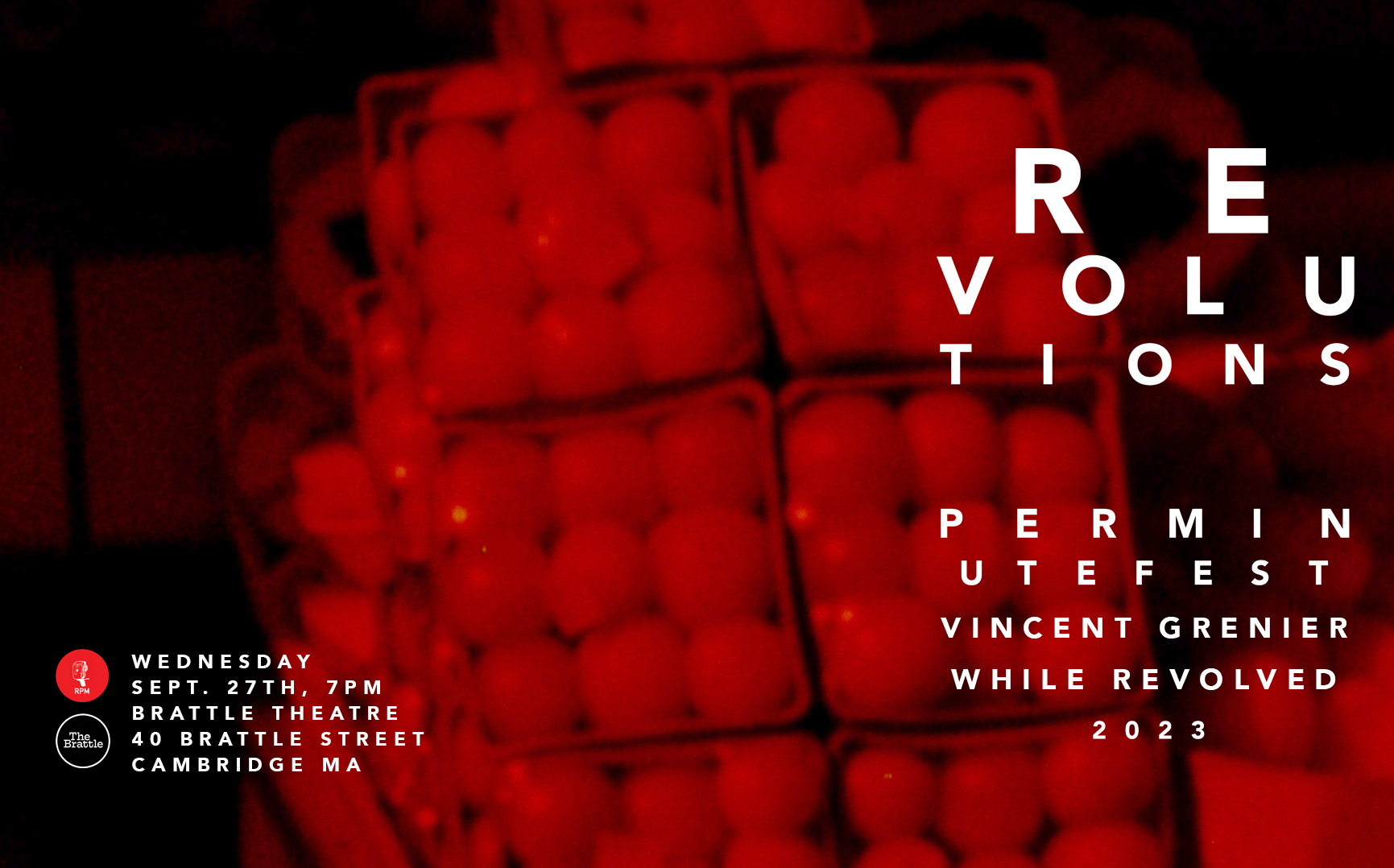
We are delighted to announce the upcoming mini retrospective program for solo artist Vincent Grenier at the Brattle Theatre in Cambridge on September 27th at 7pm. This event will showcase a total of 11 pieces spanning Grenier's impressive five-decade-long cinematic practice.
The program will commence with Mend, an early piece shot on 16mm film in 1979, and will extend to his more recent creations, Moonrise (2022) and Wishbone (2021), which is in Grenier's signature style: the simple gestures of everyday life (Nicole Gingras, La revue de la Cinémathèque, Montréal). Throughout his career, Grenier has deeply explored the fundamental aspects of the moving image; light and shadows, stillness and movements, and durations.
We sincerely hope you can join us for this event honoring the exceptional contribution of Vincent Grenier to experimental cinema.
Tabula Rasa
Orig: 16 mm. 1993-2004, originally edited on DV, Video, 7:30 min. color, sound.
Re-scanned to FHD /2K format 8-20-2018
Mend
Orig: 16mm, 1979, 5 min. b&w / silent.
Time’s Wake
Orig: 16mm, 1987, 12 min. color/B&W, silent.
Tremors
16mm, 1984, 13 min. color, sound.
You
Orig: 16mm, 1990 (revised 2014), 11:45 min. color, sound.
Surface Tension
Orig: 16 mm, 1995, 4.5 min. color, mono.
Color Study
Orig: Mini DV, 2000, 4:30 min. color, stereo.
Wishbone
HD Cinema (4:3), 2021, 1:10 min. color, stereo.
Moonrise
HD Video, 2022, 4:40 min. B&W, sound.
Commute
HD Cinema (4:3), 2018, 6:10 min. color, stereo.
While Revolved
(Orig 16mm, 1976, 18fps silent) HD Digital, 2022, 9:22 min. color, sound.
Screening format: DCP
total: 71 mins
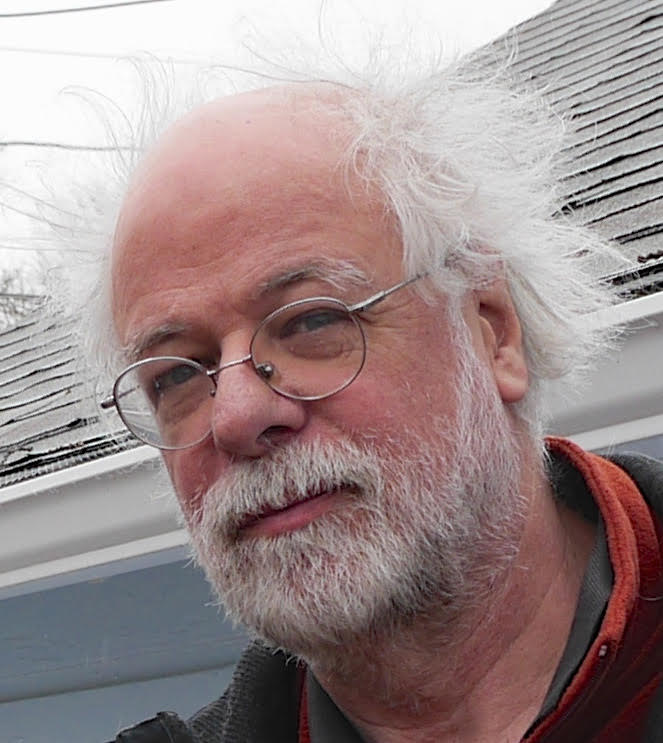
Vincent Grenier is a native of Quebec City, Canada. He has lived largely in the US, mostly New York City and upstate New York. In spite of this, he was a frequent contributor to the Montreal art scene of the 70’s and 80’s and the San Francisco bay areas where he received an MFA at the San Francisco Art Institute in the early 70's.
Grenier's experimental films and videos have earned numerous awards and have shown in North America, Europe and China at major museums, showcases and festivals.
Grenier has made over two dozens films and since 1990 as many videos. His work was the subject of retrospectives at Media City film Festival, Windsor, Ontario and Images Film & Video Festival's Canadian Images Spotlight, in Toronto.
One of his video, Tabula Rasa, was screened in the “Best Avant Garde Films & Videos of the Decade” (2000-2010) program at the Lincoln Center, NYC and his recent work Watercolor received the Stellar award for Experimental Works at the Black Maria Film & Video Festival and the First Prize, experimental category, at the Athens Film Festival, Ohio.
For many years one of his video has screened each year at Views from the Avant Garde section of the New York Film Festival.
He has received a Guggenheim Foundation Fellowship in 2010 and the Stan Brakhage Vision Award in 2019. He lives in Ithaca NY and teaches at nearby Binghamton University.

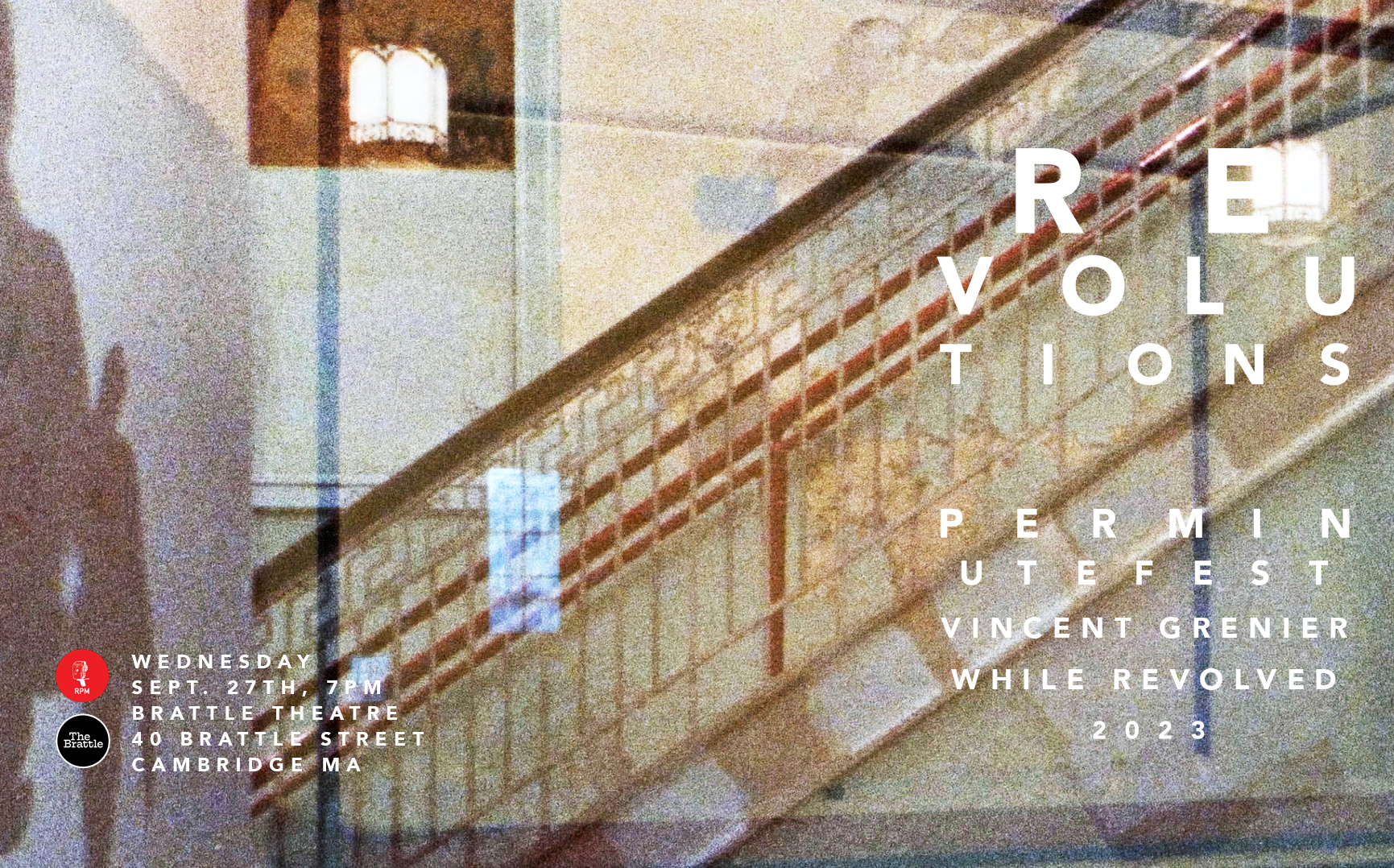
Tabula Rasa
Orig: 16 mm. 1993-2004, originally edited on DV, Video, 7:30 min. color, sound.
Re-scanned to FHD /2K format 8-20-2018
Filmed in a South Bronx high-school, Tabula Rasa attempts through sound image juxtapositions, digital manipulation and layering to deal at once with the propensity to mislead and eloquence of the recorded image. The ambiguous qualities of appearances, so assiduously cultivated by institutions, the motivations found in the clues that tells the history of objects, colors, textures, architecture and ultimately, psychological states of mind are but some of the players in this poetic and cultural happening.
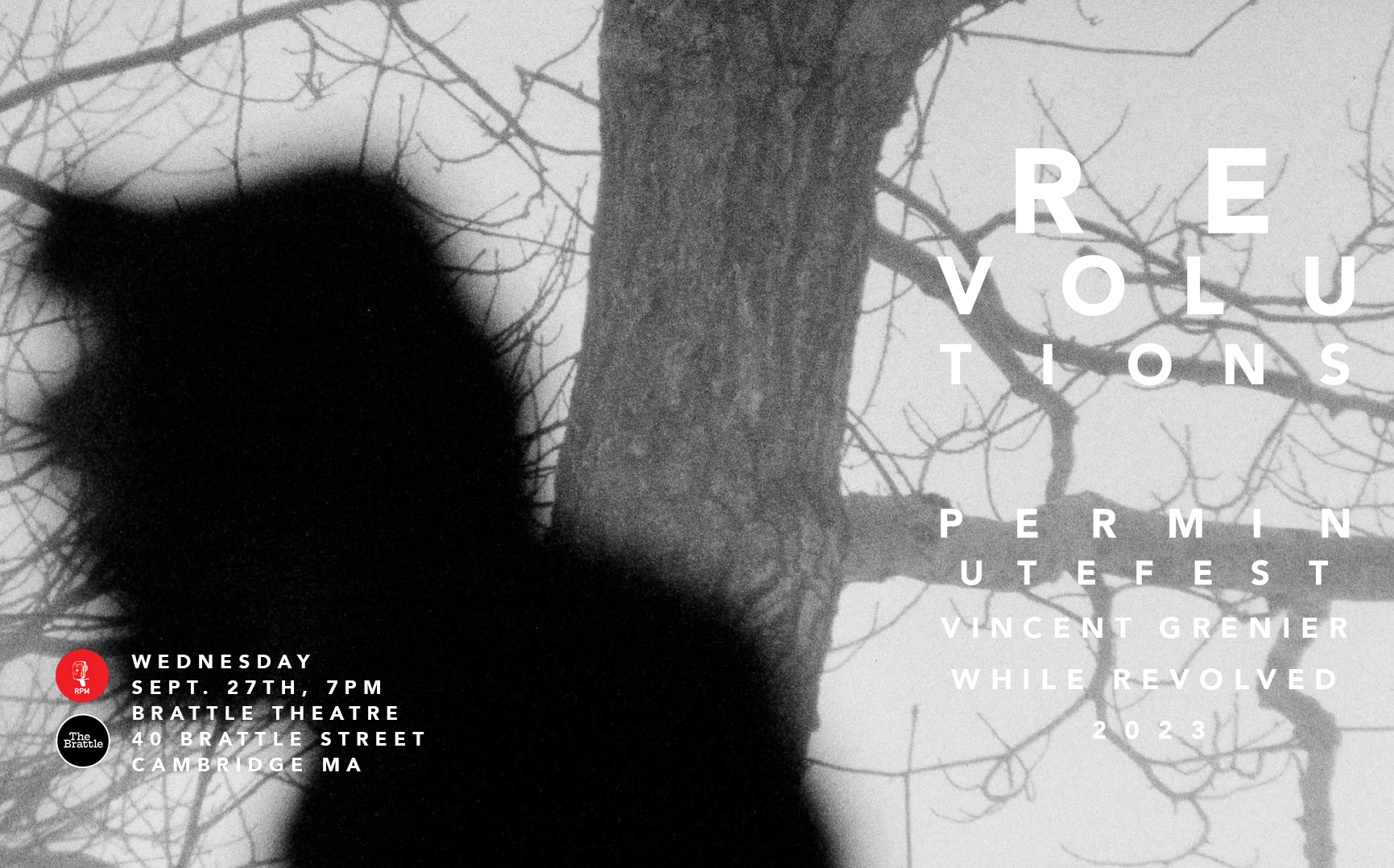
Mend
Orig: 16mm, 1979, 5 min. b&w / silent.
Is it happening in the screening room or on the screen; in a snowstorm or inside; what isn't surrounding and what is? From filming Ann sewing, on a grey winter day.
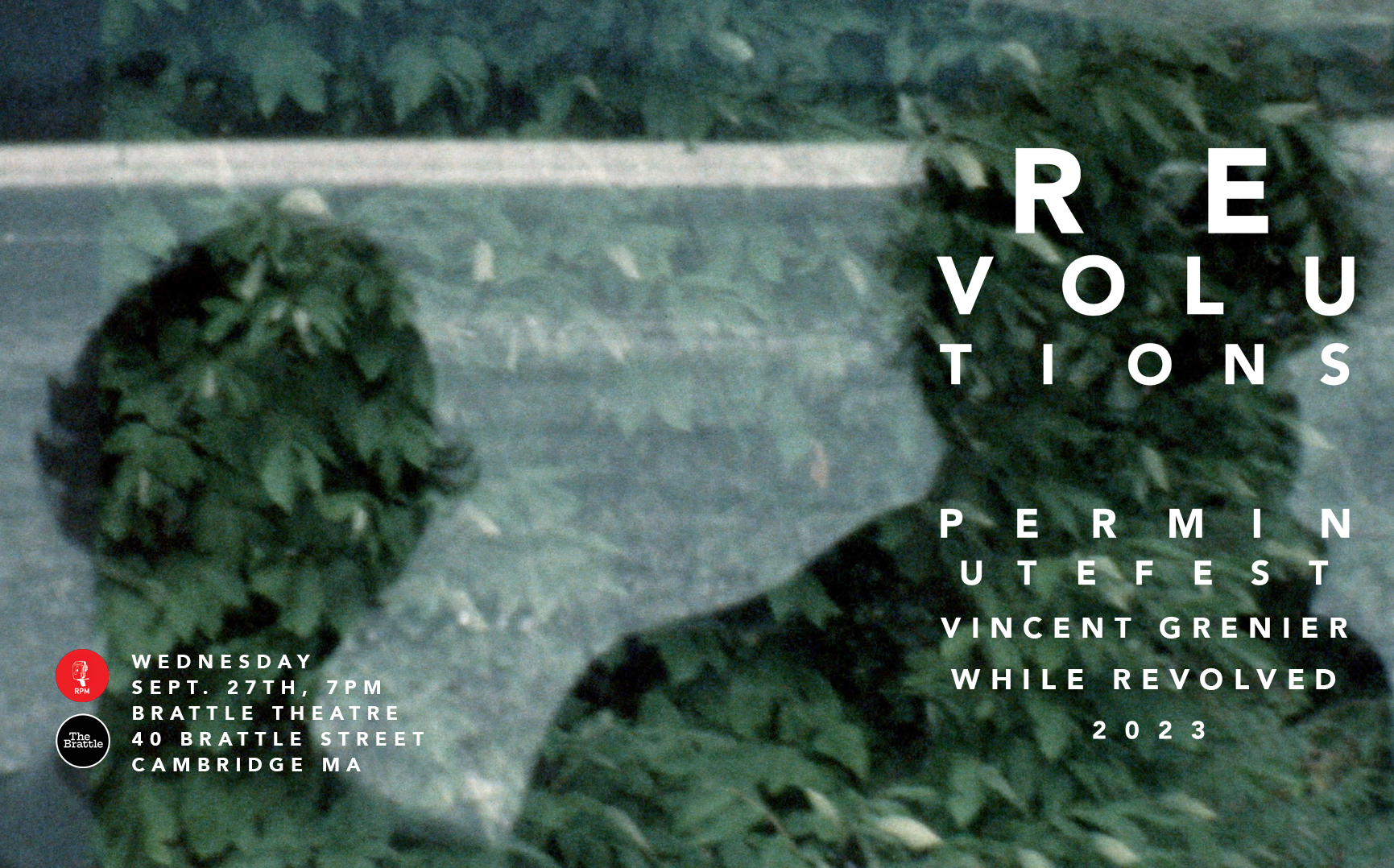
Time’s Wake
Orig: 16mm, 1987, 12 min. color/B&W, silent.
A collection of 'windows' on a personal past, TIME'S WAKE (once removed) is made from home movie and other types of footage I collected through the years when I went back to visit my parents at l'Ile d'Orléans, Québec. Through the use of the double exposure, fragmentation, motion and stillness are linked with memory. -VG.
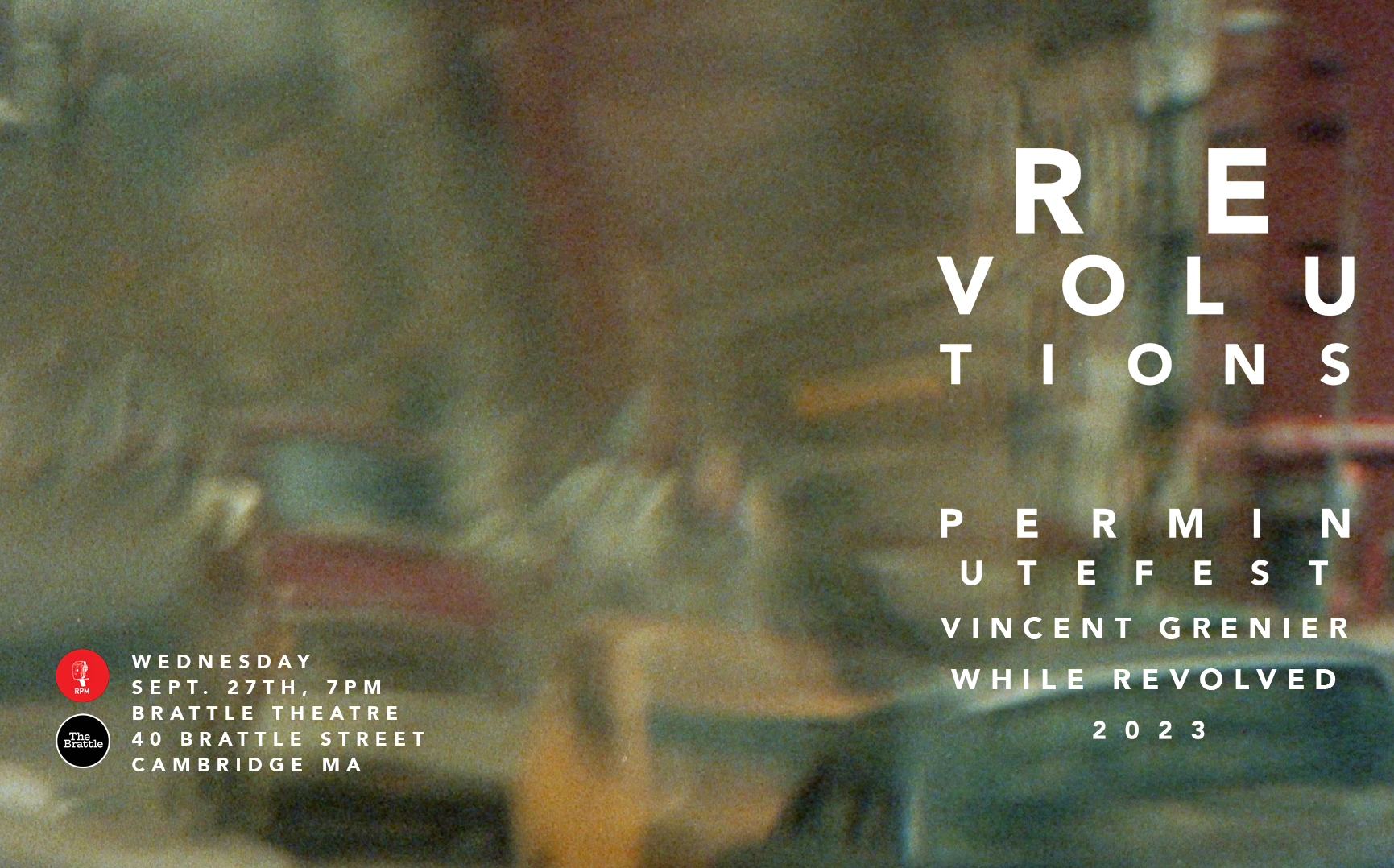
Tremors
16mm, 1984, 13 min. color, sound.
Tall buildings and cars are filmed through the Kinemacolor process, variable color filters and a water lens. Sturdiness jousts with fragility, past with present, alienation with tenderness, abrasiveness with sensuality, red with green. (The Kinemacolor process was used in 19l5 to obtain fairly illusionistic colors from black and white films by filming and projecting them through synchronized, red and green filters.) -VG.
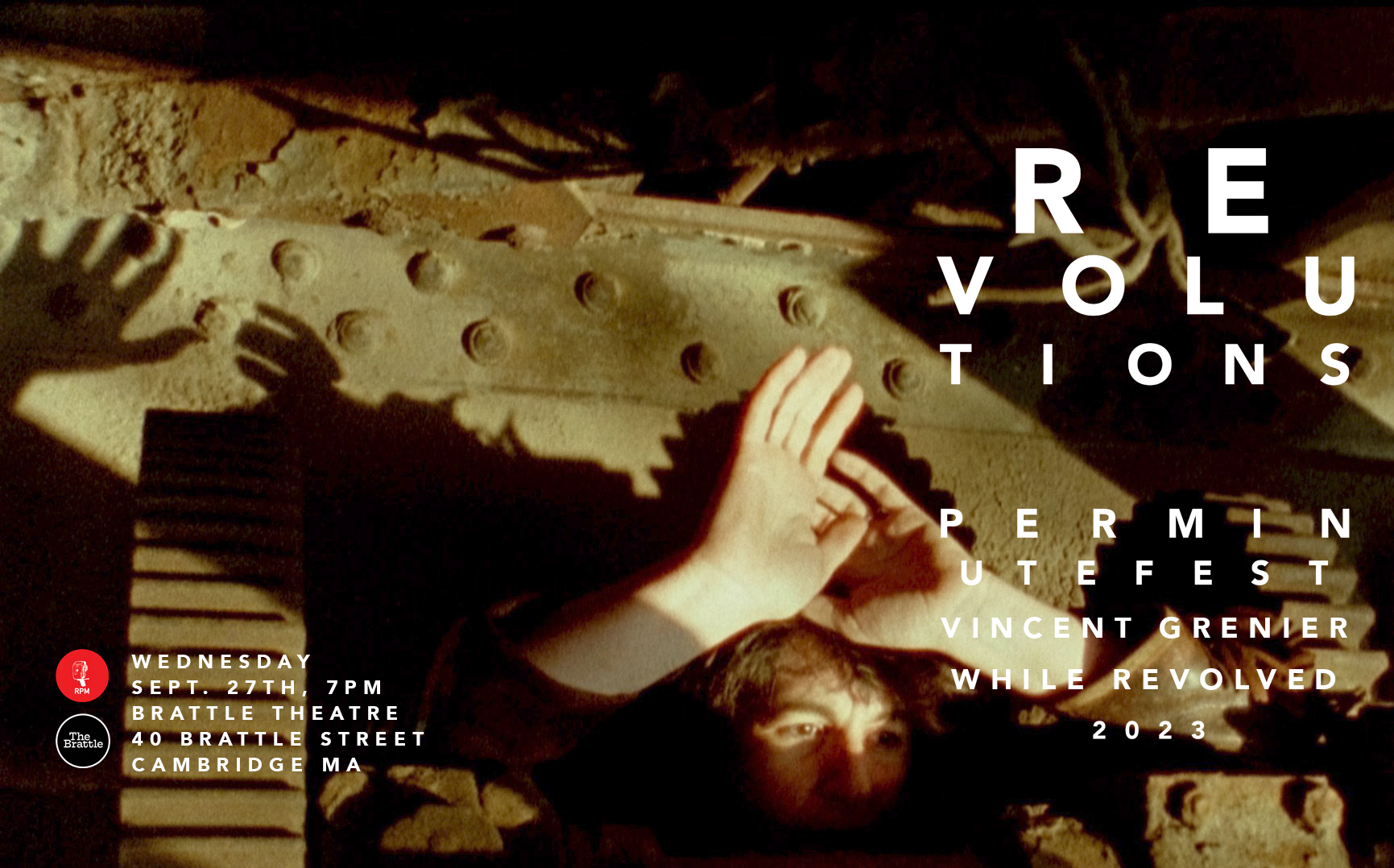
YOU
Orig: 16mm, 1990 (revised 2014), 11:45 min. color, sound.
No I? Should separate worlds be mixed? Knowing what one wants. The absurd and the hurt. Images for what you did.
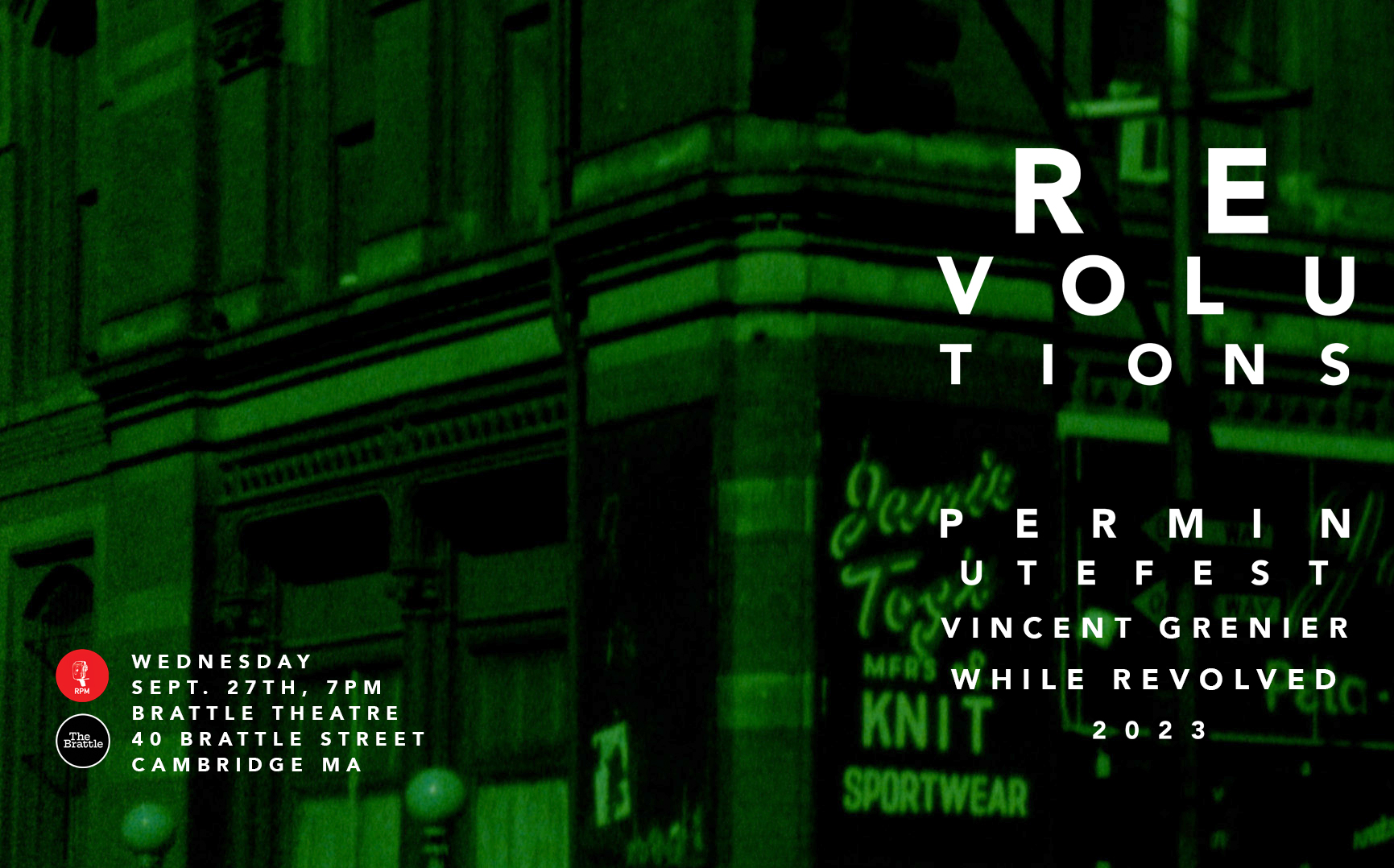
Surface Tension
Orig: 16 mm, 1995, 4.5 min. color, mono.
This film was shot in color but using the Kinemacolor process, a process which was used in 1915 to obtain fairly illusionistic colors from black and white films by filming and projecting them through synchronized red and green filters.
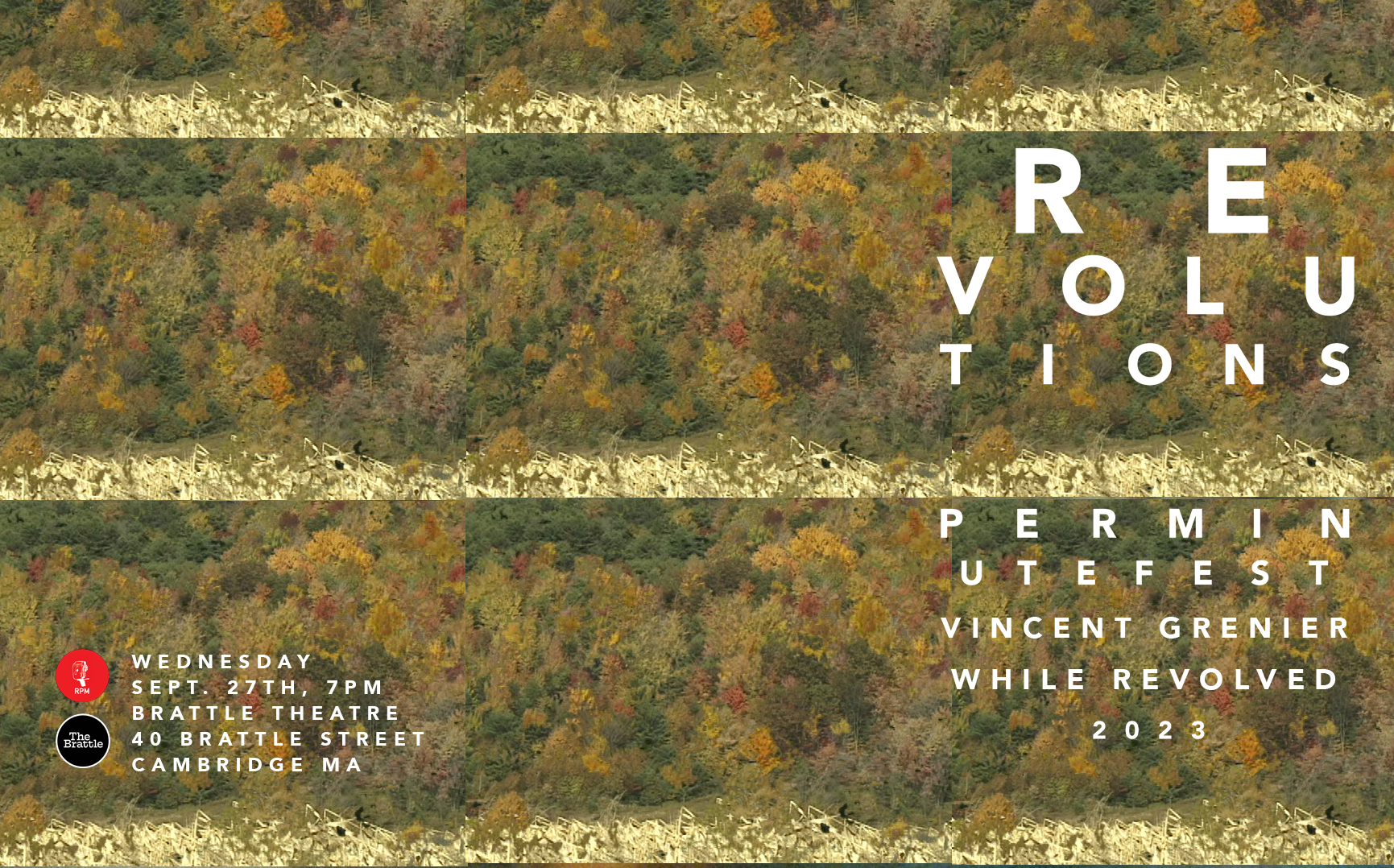
Color Study
Orig: Mini DV, 2000, 4:30 min. color, stereo.
“It is interesting to think about Color Study in relation to the purely cinematic-photochemical nature of a work like Kurt Kren’s Asyl with its multiplicity of delicate composite imagery and overlapping seasons that create a feeling of all time being simultaneous. In Asyl, solar light cohabitates with the film - the emulsion receives singes and burns that inscribe the image and are reconstituted in projection as muted radiance. In Color Study, a cat’s eye like chatoyancy of splattered color, the precise mimicry of natural color combined with unnatural color fields, creates and breaks illusion. Color manufactures a kind of implied time lapse where it does not technically exist. A spatial jigsaw, combining the autumnal and the verdant. The invented light and color of the digital process creating an acid wash.” -- Mark McElhatten
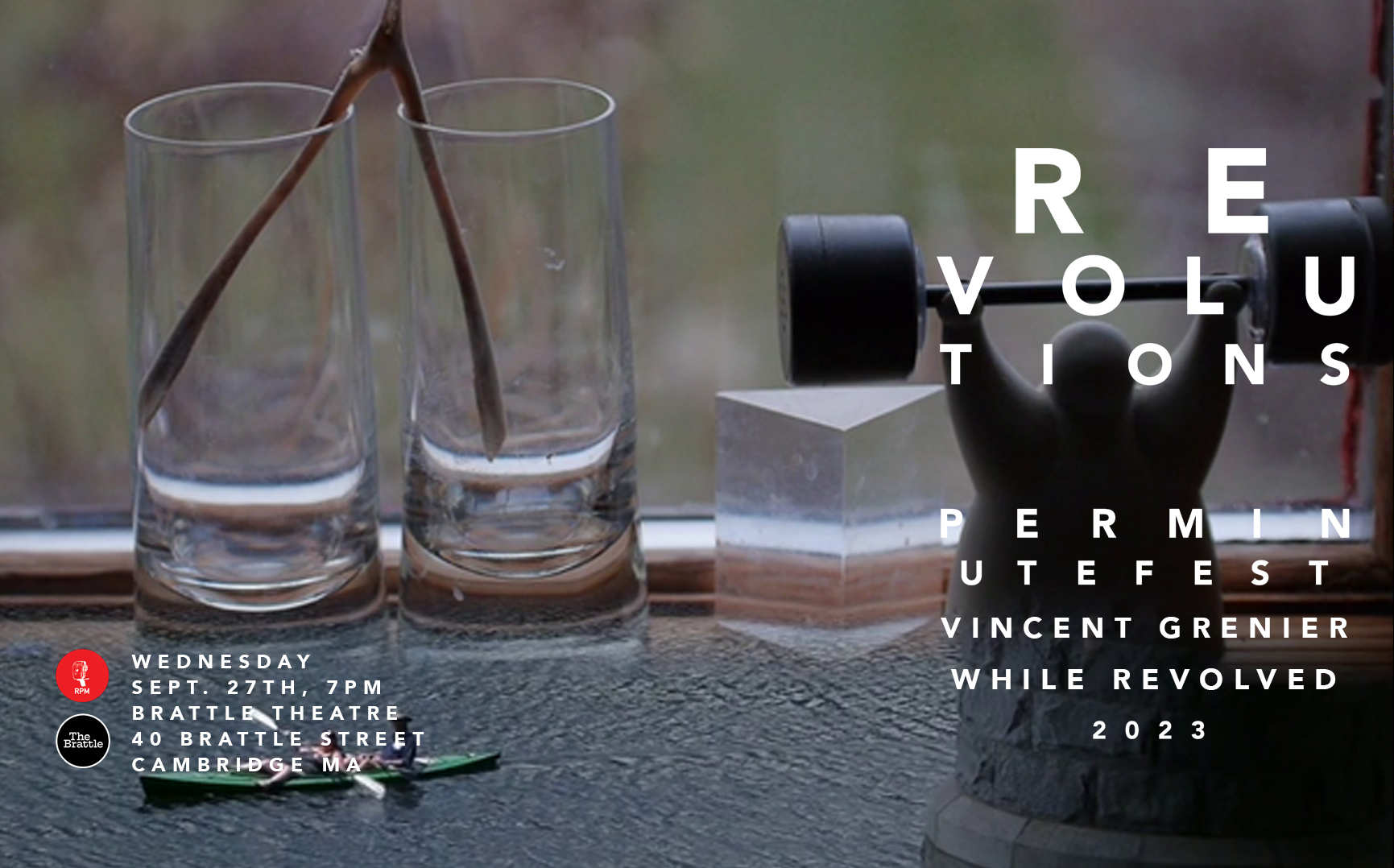
Wishbone
HD Cinema (4:3), 2021, 1:10 min. color, stereo.
The basis of Wishbone is a still life on a tabletop near a window. In addition to a small figurine of a Buddha-like weightlifter, and a nondescript glass prism, the composition is anchored by the titular wishbone. It is situated inside two different drinking glasses, its branches contained as it tapers into a juncture that hovers between both containers. But this still life doesn't remain still for long. Grenier overlays the tabletop with a flowing river, complete with a rower in a tiny kayak.
– Michael Sicinski
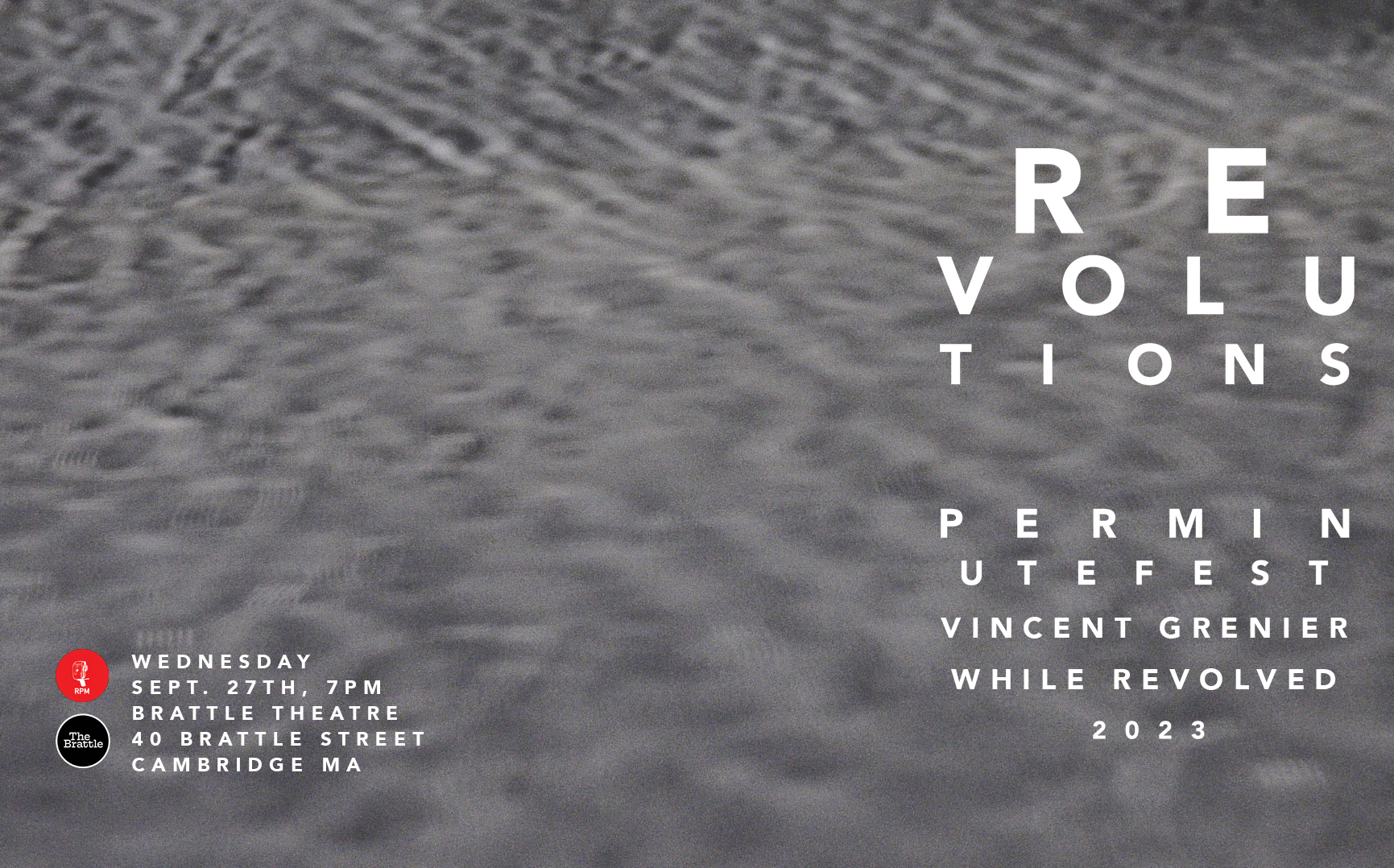
Moonrise
HD Video, 2022, 4:40 min. B&W, sound.
A wild montage of everyday sounds that impersonate rain drops, anthropomorphize eyeballs floaters.
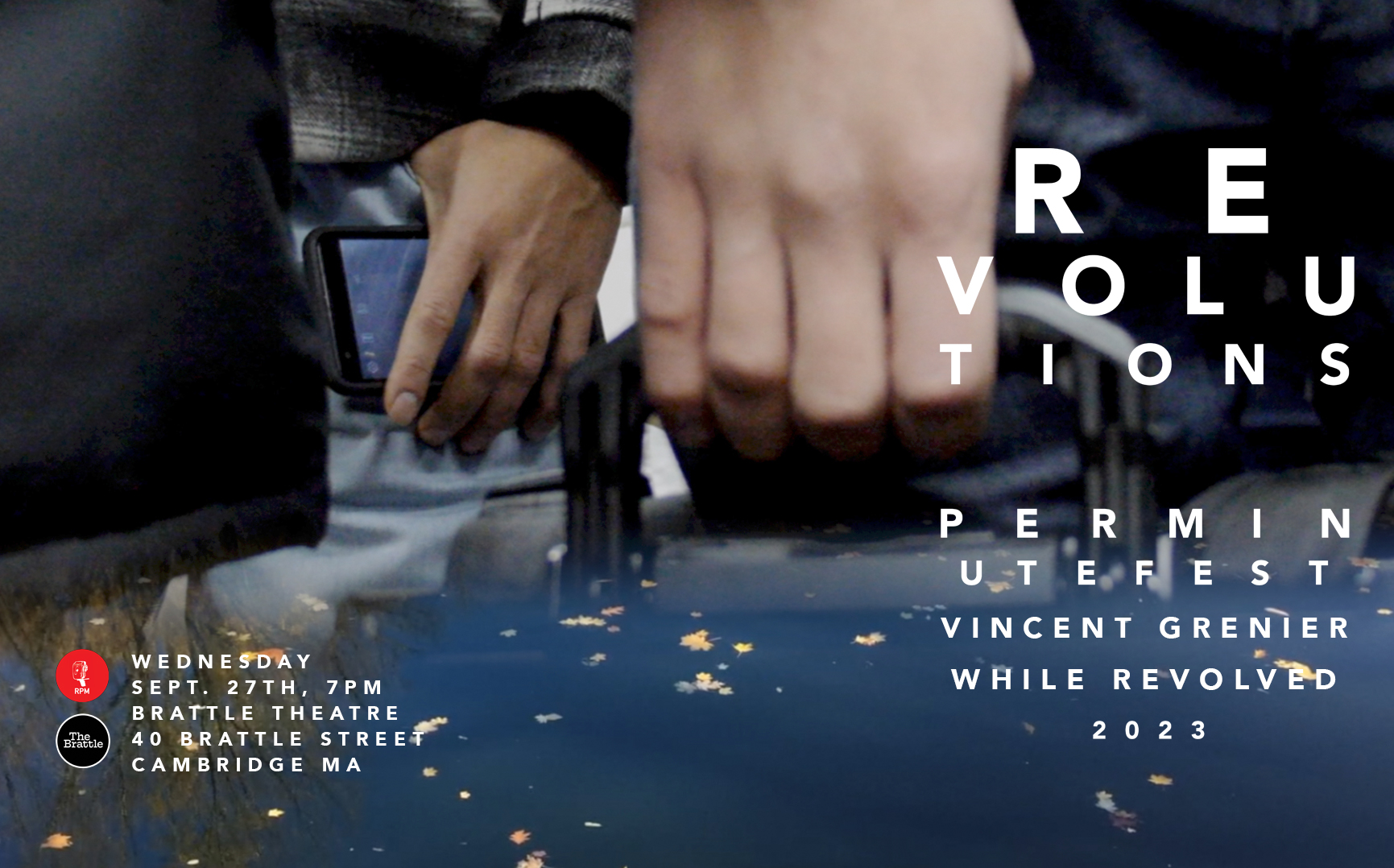
COMMUTE
HD Cinema (4:3), 2018, 6:10 min. color, stereo.
Distinct fields on the same screen, foreground each other, invite comparisons, between different times and spaces, and the constructed and natural processes that inescapably defines us thru textures and emotional spaces. Commute does refer to regular travels between one place and an other, but also to substitutions, and exchanges.
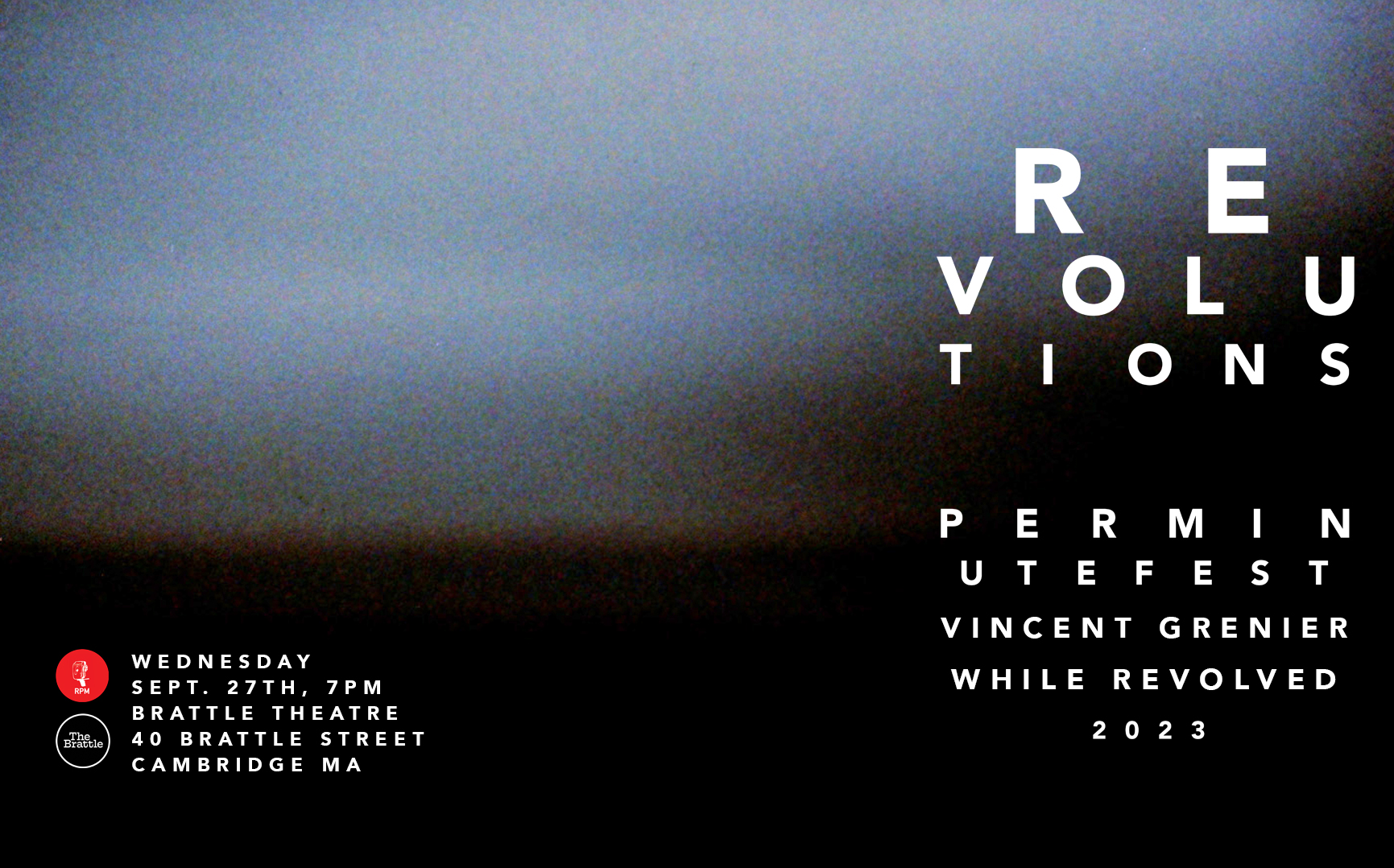
While Revolved
(Orig 16mm, 1976, 18fps silent) HD Digital, 2022, 9:22 min. color, sound.
Restored version with soundtrack by Etienne Grenier
An elusive film that highlights, in a series of movements, the magnified chemical soup of the emulsion as the camera lens is trained on both a closely foregrounded granular surface and a complex set of sinking, rising and emerging spaces behind it, subtly shaped by the focusing abilities of shadows. Sound introduce other layers and ideas about movement and space bringing new understandings and articulations to this sculpture like cinema.
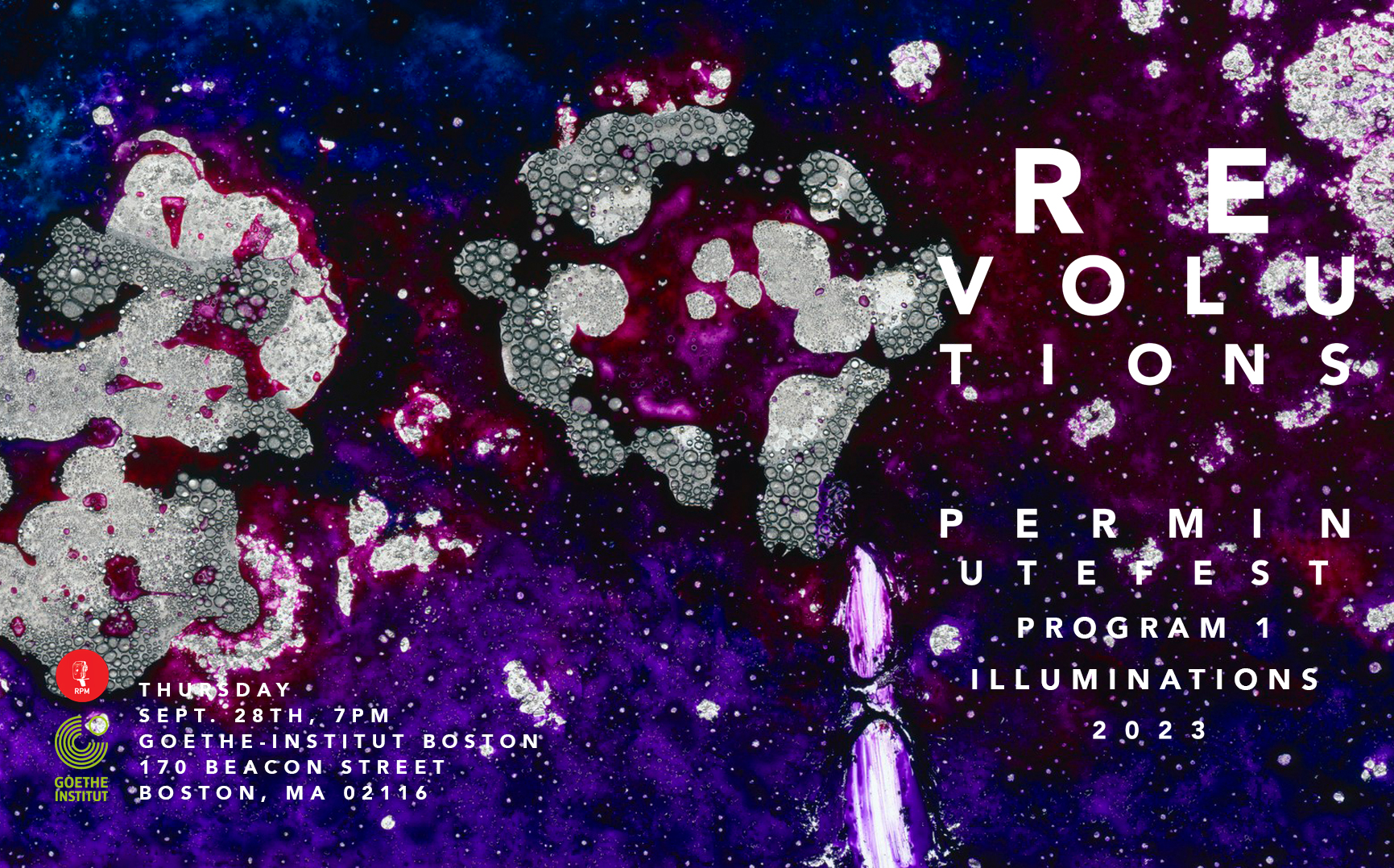
Thursday
Sept. 28th, 7PM
Goethe-Institut Boston
170 Beacon Street
Boston, MA 02116
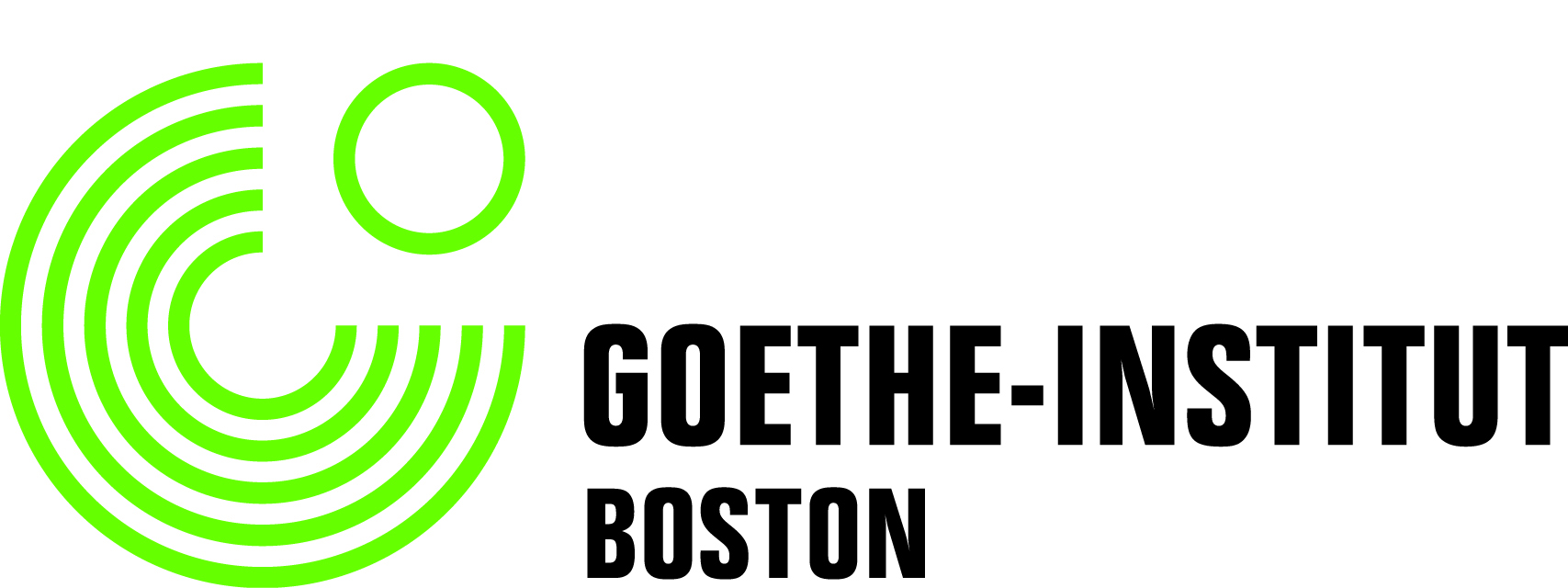
Rhythm 23(Rhythmus 23)
Hans Richter
3mins, 1923, Germany, B/W, sound, 16mm (prints from the Film-makers' Coop)
RED HOUSE
Barry Doupé
3mins, 2022, Canada, color, sound, digital
Just Untitled
Alessandra Vorontsova
2mins, 2023, USA, color/B&W, sound, 16mm to HD
Under the Midnight Sun
Mélissa Faivre
9mins52secs, 2022, France, B/W, Sound, HD
Like a Lighthouse
Richard Tuohy
12mins, 2023, Australia, color, sound, 16mm
Grain Cloud Atmosphere
Martin Moolhuijsen
6mins38secs, 2023, Germany, color, sound, 35mm to HD
Arcalis
Youjin Moon
12mins58secs, 2022, USA, color, sound, digital
Parts
Michael Lyons
4mins47secs, 2023, Japan, B/W, silent, 16mm to HD
Water Mining (Eaton Canyon)
Kate Lain
5mins10secs, 2021, USA, color, sound, 16mm to HD
In the Wind
Yue Hua
5mins36secs, 2022, USA, color, sound, 16mm to HD
Potemkin Piece
Justin Clifford Rhody
1min35secs, 2022, USA, color, sound, 35mm to 4K
total: 73 mins
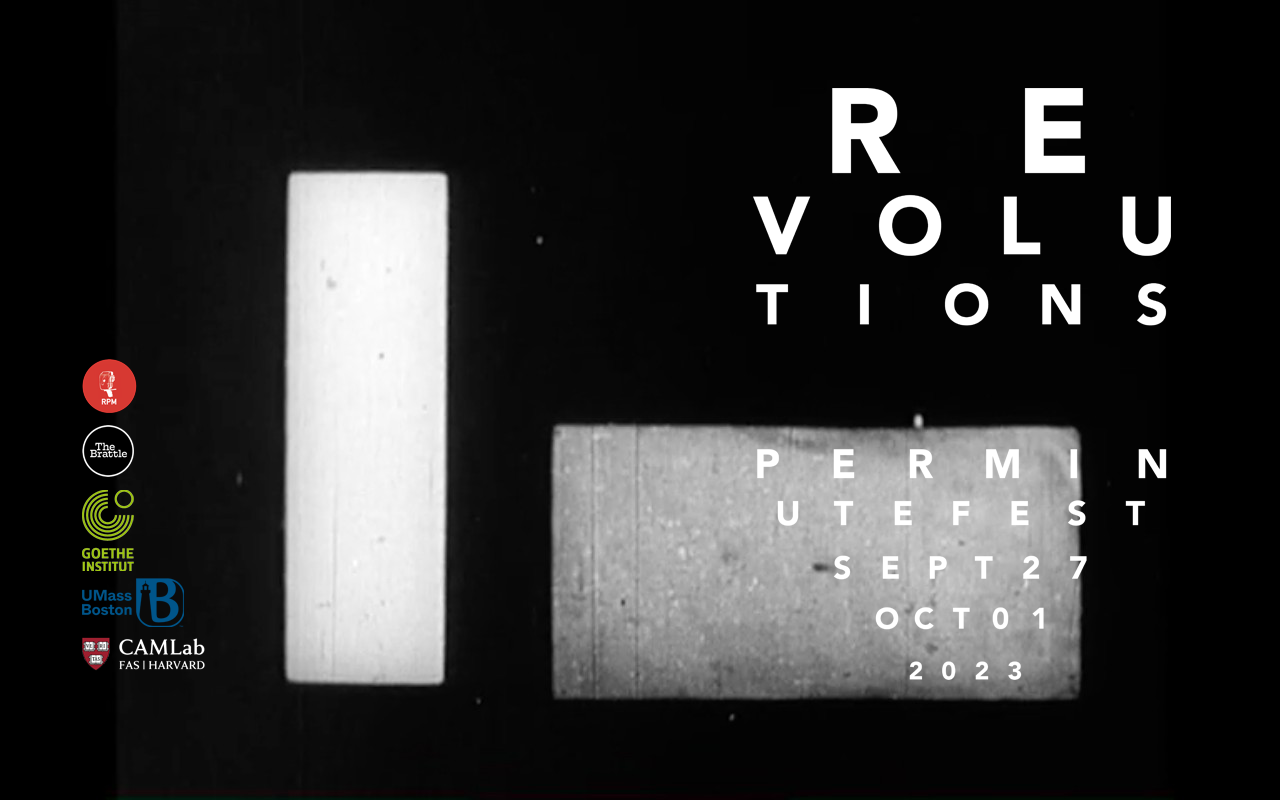
Rhythm 23 (Rhythmus 23)
Hans Richter
3mins, 1923, Germany, B/W, silent, 16mm
"More complex than RHYTHM 21, the film is nonetheless a logical extent of Richter's conviction that film is modern art. Again, the orchestration of basic geometric forms according to precise rhythmical ...
Hans Richter was a German abstract painter, filmmaker and avant-gardist. He was a member of the Dada art movement and created one of the early and influential examples of abstract film, Rhythmus 21.
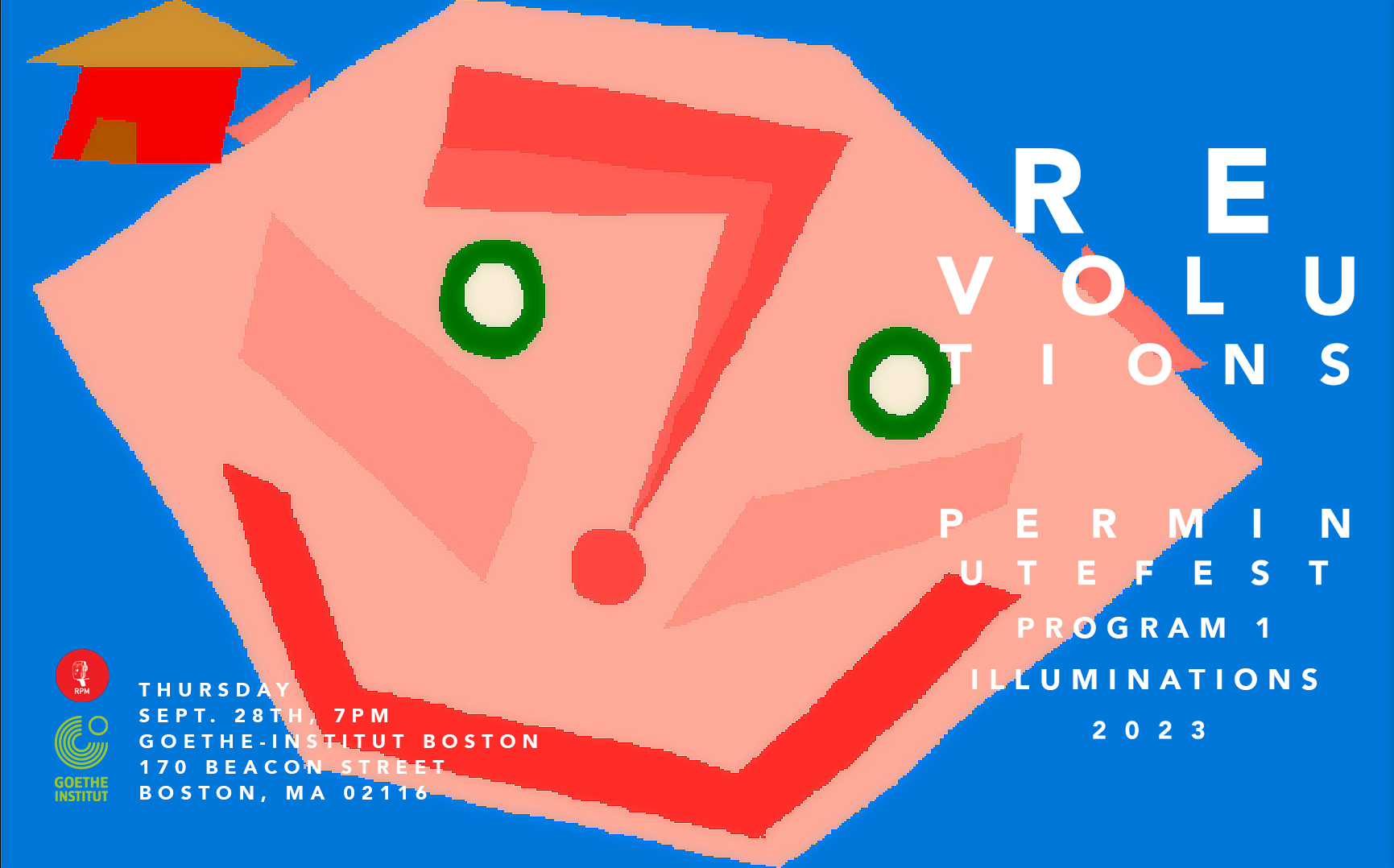
RED HOUSE
Barry Doupé
3mins, 2022, Canada, color, sound, digital
RED HOUSE is an animation that playfully explores metamorphosis in relation to the stability and structure of housing. Created using the AMIGA computer console and Deluxe Paint IV software, hand drawn sequences delight in the constant reconfiguration of images, characters and forms.
Barry Doupé (b. 1982 Victoria, BC) is a Vancouver based artist primarily working with computer animation. His films use imagery and language derived from the subconscious; developed through writing exercises and automatic drawing.
His films have been screened throughout Canada and Internationally including the Ann Arbor Film Festival (Ann Arbor, Michigan), International Film Festival Rotterdam (Rotterdam, the Netherlands), Anthology Film Archives (NY, New York), Lyon Contemporary Art Museum (Lyon, France),
Pleasure Dome (Toronto, ON), MOCCA (Toronto, ON), Whitechapel Gallery (London, UK), Centre Pompidou (Paris, France), the Vancouver Art Gallery (Vancouver, BC), and the Tate Modern (London, UK).
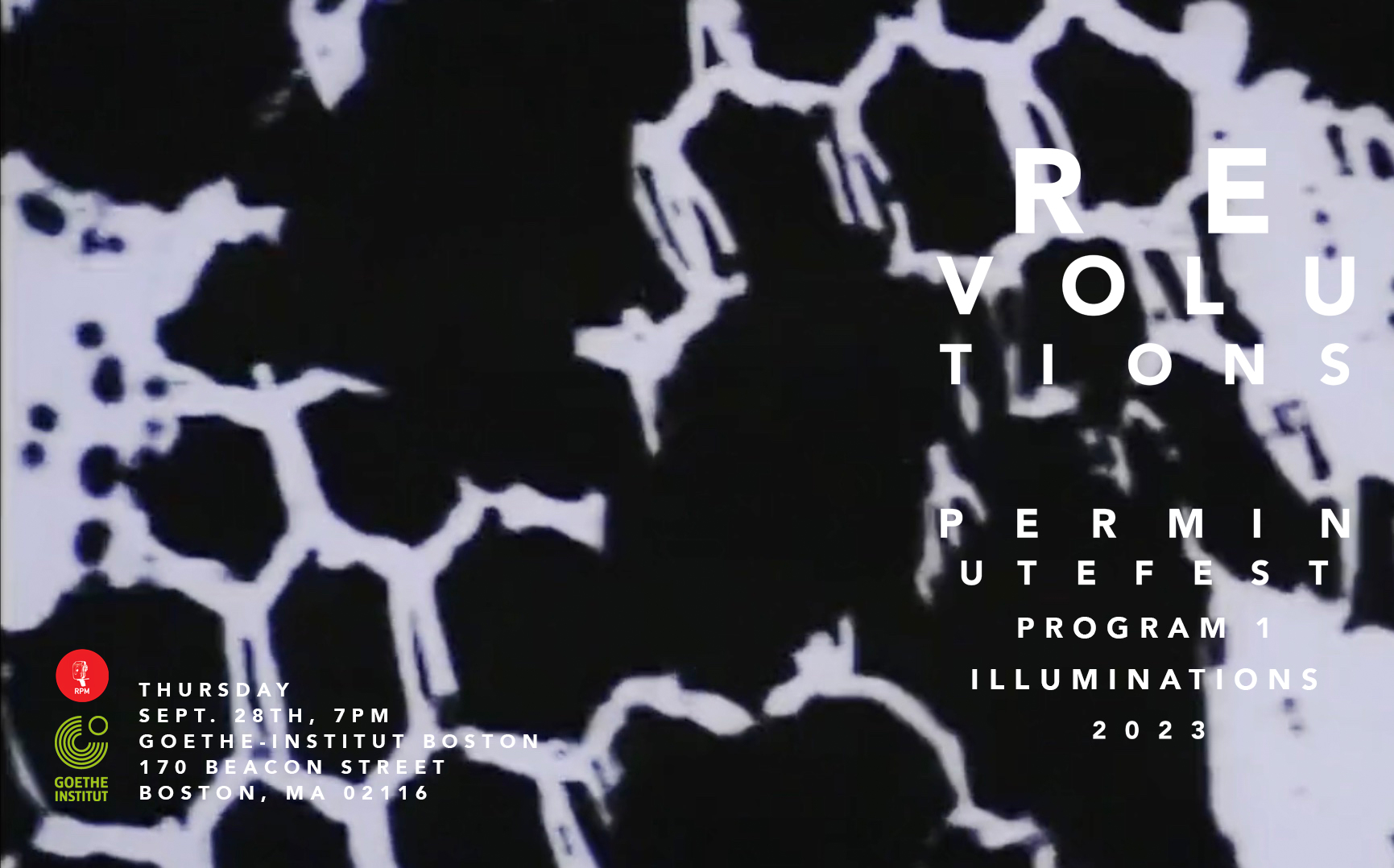
Just Untitled
Alessandra Vorontsova
2mins, 2023, USA, color/B&W, sound, 16mm to HD
16mm cameraless handmade film. The soundtrack is the materials used to create this film.
Alessandra Vorontsova is a multidisciplinary artist mainly working in stills, film and installation pieces. Analog and digital methods are often used to pose questions about the way we do things and why.
The work seeks to be a source of contemplation of media consumption in current times.
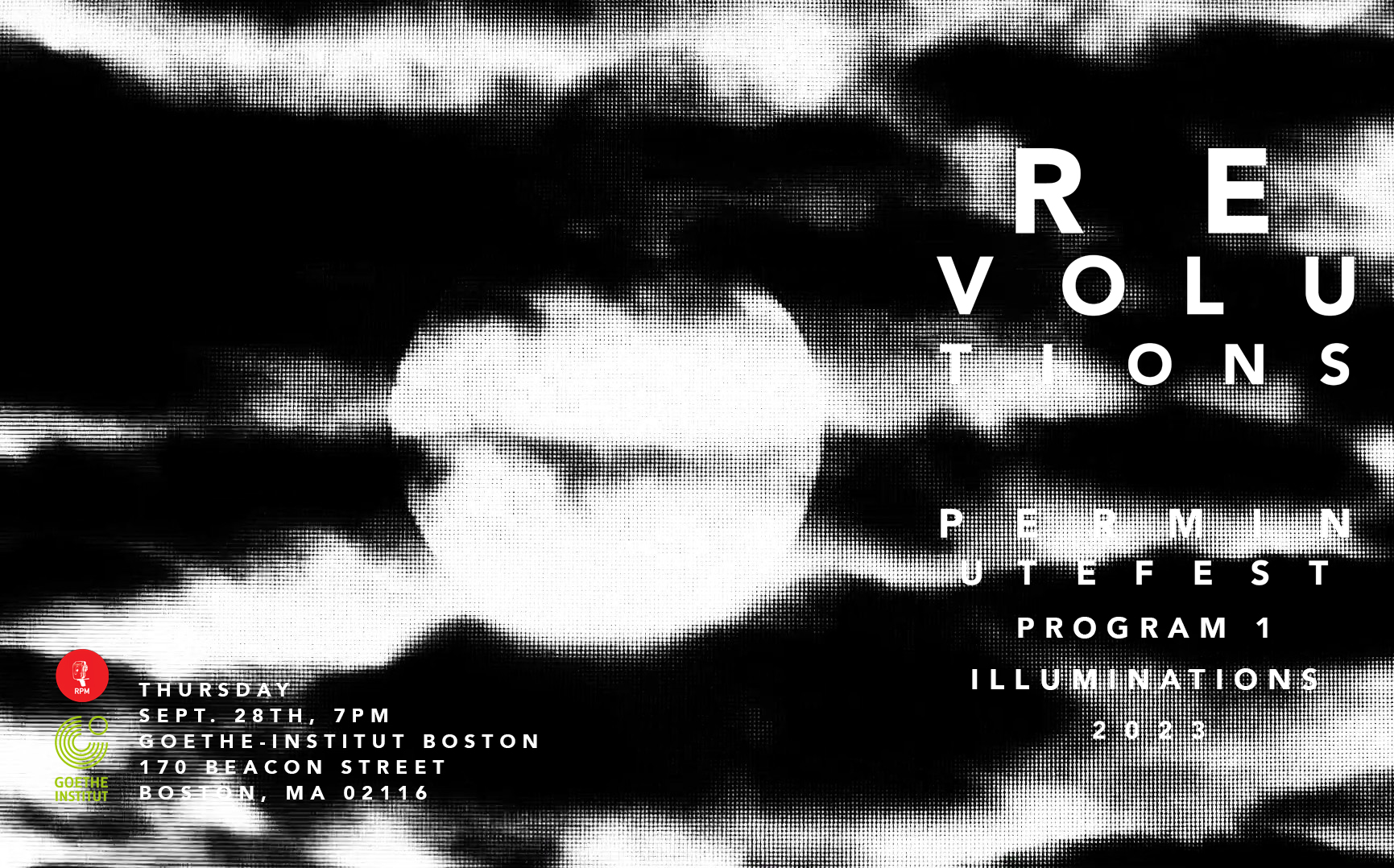
Under the Midnight Sun
Mélissa Faivre
9mins52secs, 2022, France, B/W, Sound, HD
"Under the Midnight Sun" is a dance of light and shadows, textured grayscale expanding across the landscape of an apocalyptic city. The sun is moon and light. It unveils itself by means of visual pulsating dynamics, unstable frequencies and vibrating rhythms; until it disintegrates into particles and pixels, and vanishes into darkness. This visual-musical piece is dark, worrying and calls to sensorial explorations into deeper energies.
Mélissa Faivre, born 1989 in France, is an experimental video artist based in Berlin. Her rhythmic and mesmerizing work seeks to provoke questions on the nature of perception.
The images she creates present blended and distorted realities that test the temporal and spatial coordinates foundational to the perceptive experience. Working only in digital format, her practice often pushes the aesthetic boundaries between film and video.
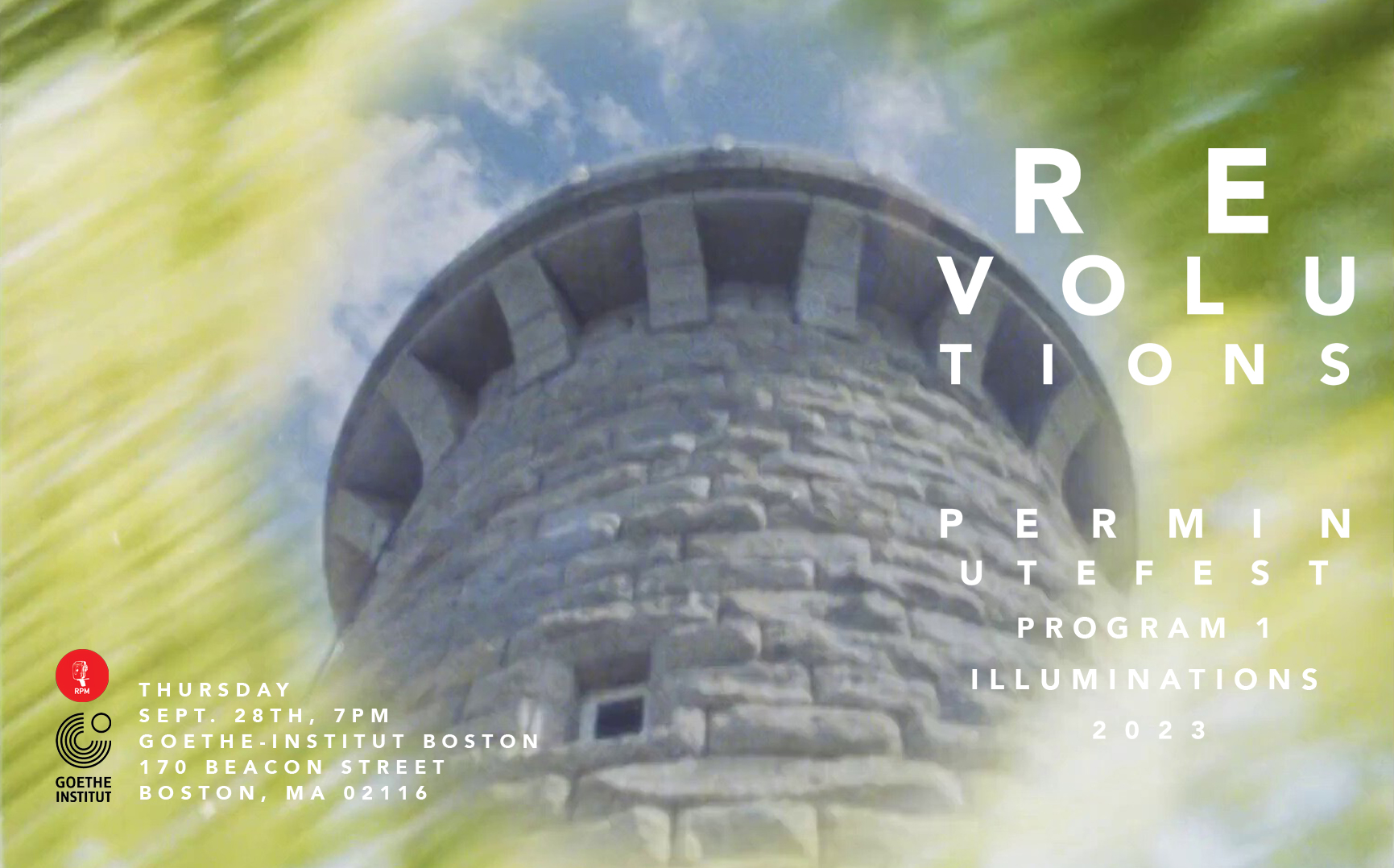
Like a Lighthouse
Richard Tuohy
12mins, 2023, Australia, color, sound, 16mm
A blinding beam of light. The piercing sound of ships. Everything - the land, plants, the sky - shouts for attention. Perceptions assail us with their demands to be noticed.
Richard Tuohy is one of the most active experimental film artists currently working on celluloid in Australia. His film IRON-WOOD won first prize (ex aequo) at Abstracta 2009 experimental film festival in Rome. He runs Nanolab in Australia – the specialist small gauge film processing laboratory. He actively encourages other artists to work with cine film through his Artist Film Workshop initiative (see artistfilmworkshop.org). He is also a founding director of the Australian International Experimental Film Festival.

Grain Cloud Atmosphere
Martin Moolhuijsen
6mins38secs, 2023, Germany, color, sound, 35mm to HD
Many grains make a cloud. many clouds form an atmosphere.
120 meters of handpainted 35mm film were digitized as single pictures and fed into a self developed editing software that shuffles the individual images according to certain parameters such as painterly technique and color. the film is the result of one hour of improvisation with that software. grain cloud atmosphere explores the perception of time through the eye and through the ear.
martin moolhuijsen is an italian intermedia artist based in berlin.
his work is situated at the threshold of sound art, experimental film and experimental poetry and has taken the form of installations, fixed-media pieces, conceptual artworks, poems, signs, films and of any combination of the aforementioned.
his work has been presented at akademie der künste, deutschlandfunk kultur, ZKM – zentrum für kunst und medien and CTM vorspiel among others.
he is a member of the analog film lab LaborBerlin
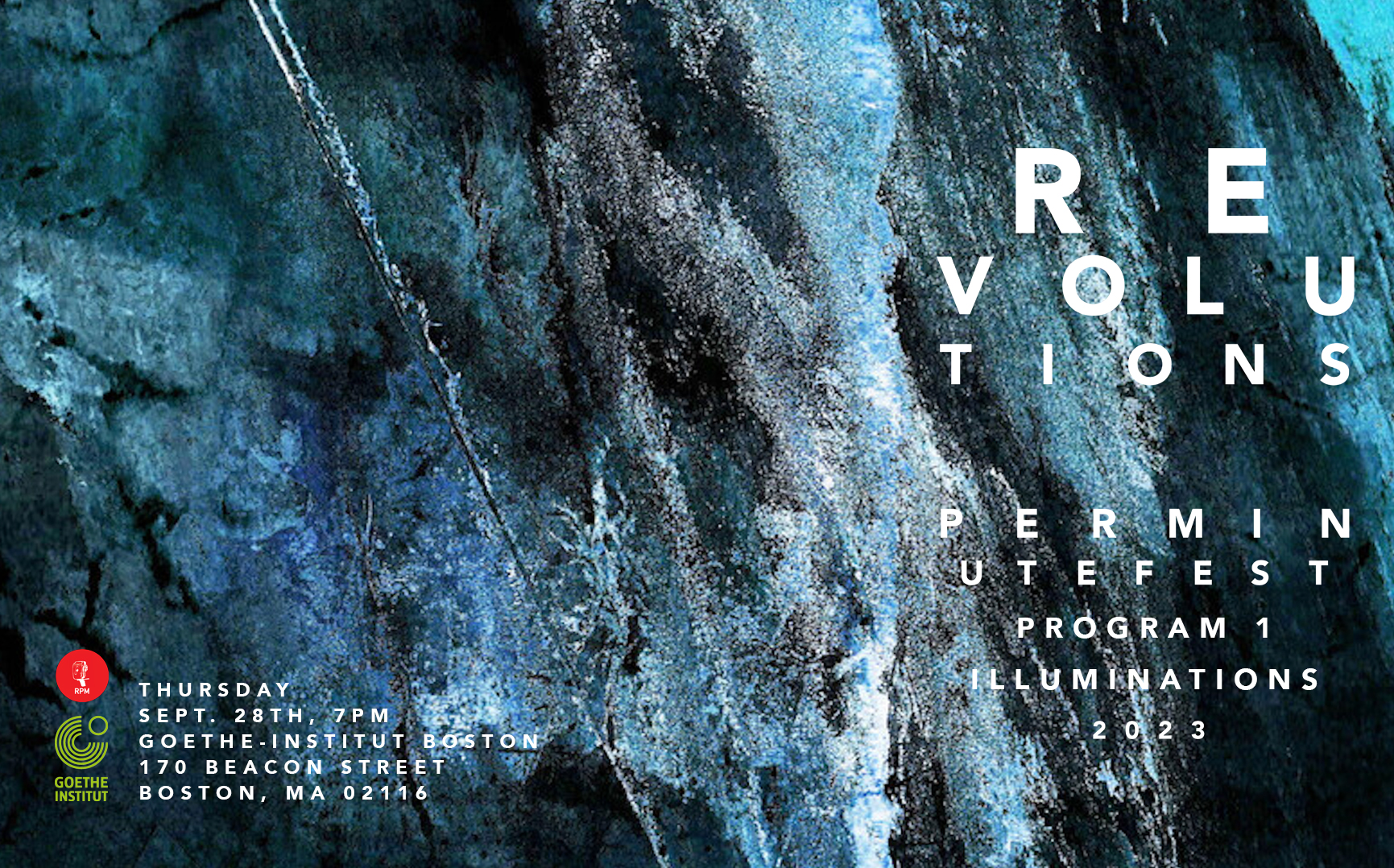
Arcalis
Youjin Moon
12mins58secs, 2022, USA, color, sound, digital
A cosmic panorama of dazzling silver forms and specks of light unfolds, conjuring a utopian vision. The viewer is led on a quest for paradise in shades of green and fantasies of unknown space.
Youjin Moon is a South Korean artist based in Boston. Moon has shown her work at national and international film festivals and exhibitions, including the deCordova New England Biennial, the 56th Ann Arbor Film Festival, Hamburg International Short Film Festival, and the Biennial of the Moving Image, Buenos Aires. Moon received the Korean EXiS Award at the 12th and 16th Seoul International Experimental Film and Video Festival. Her works have been featured in the Boston Globe and Art New England, among others.
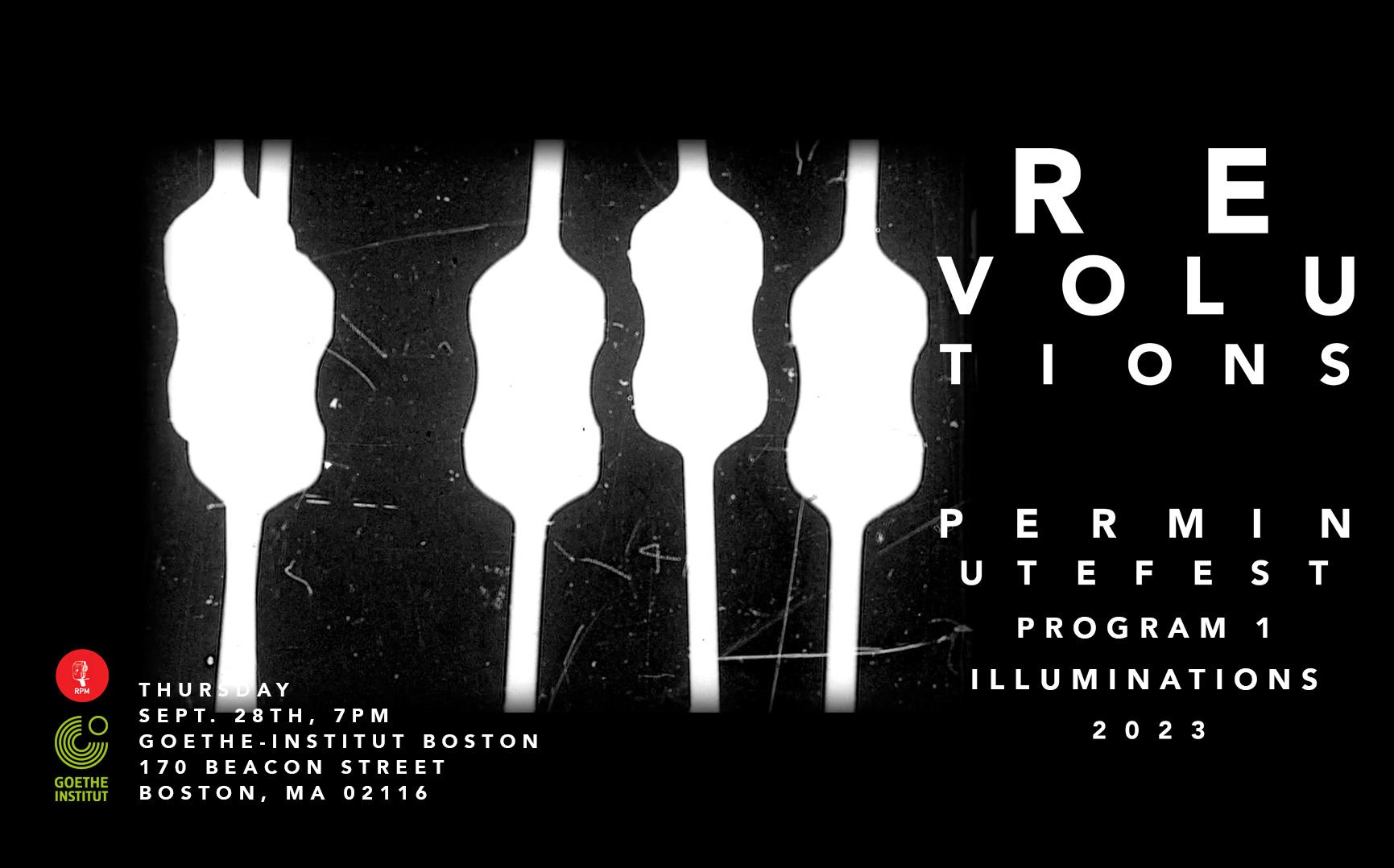
Parts
Michael Lyons
4mins47secs, 2023, Japan, B/W, silent, 16mm to HD
This camera-less silent film examines parts and wholes. Electronic components were photogrammed on 16mm print stock. Displacements in time and space assemble the parts into an abstract dynamic gestalt.
Michael Lyons is a researcher and artist based in Kyoto, Japan.

Water Mining (Eaton Canyon)
Kate Lain
5mins10secs, 2021, USA, color, sound, 16mm to HD
Water Mining (Eaton Canyon) is a nature document(ary) made *with* a stream, rather than about it. Its images come from a combination of cyanotype, a blue-and-white photographic process dating back to the 1840s, and actual plant material adhered to physical film. I hand-coated clear 16mm leader with cyanotype chemicals, then used sunlight to make photogram-style, cameraless exposures of plant matter I had gathered in and around the stream in Eaton Canyon. Cyanotypes are processed using water, and for this film, I used stream water that I had also collected from the canyon. I approached the film as though the stream, what was in it, its surroundings, the film, the chemicals, and I were all extensions of one another.
Kate Lain is a Los Angeles–area multidisciplinary artist working in film, video, clay, and other media. Her experimental film and video work verges on documentary and spans a wide range—from essay film to stopmotion collage to impressionist portraiture. Her works have screened at festivals, microcinemas, museums, and other spaces across North America and Europe.
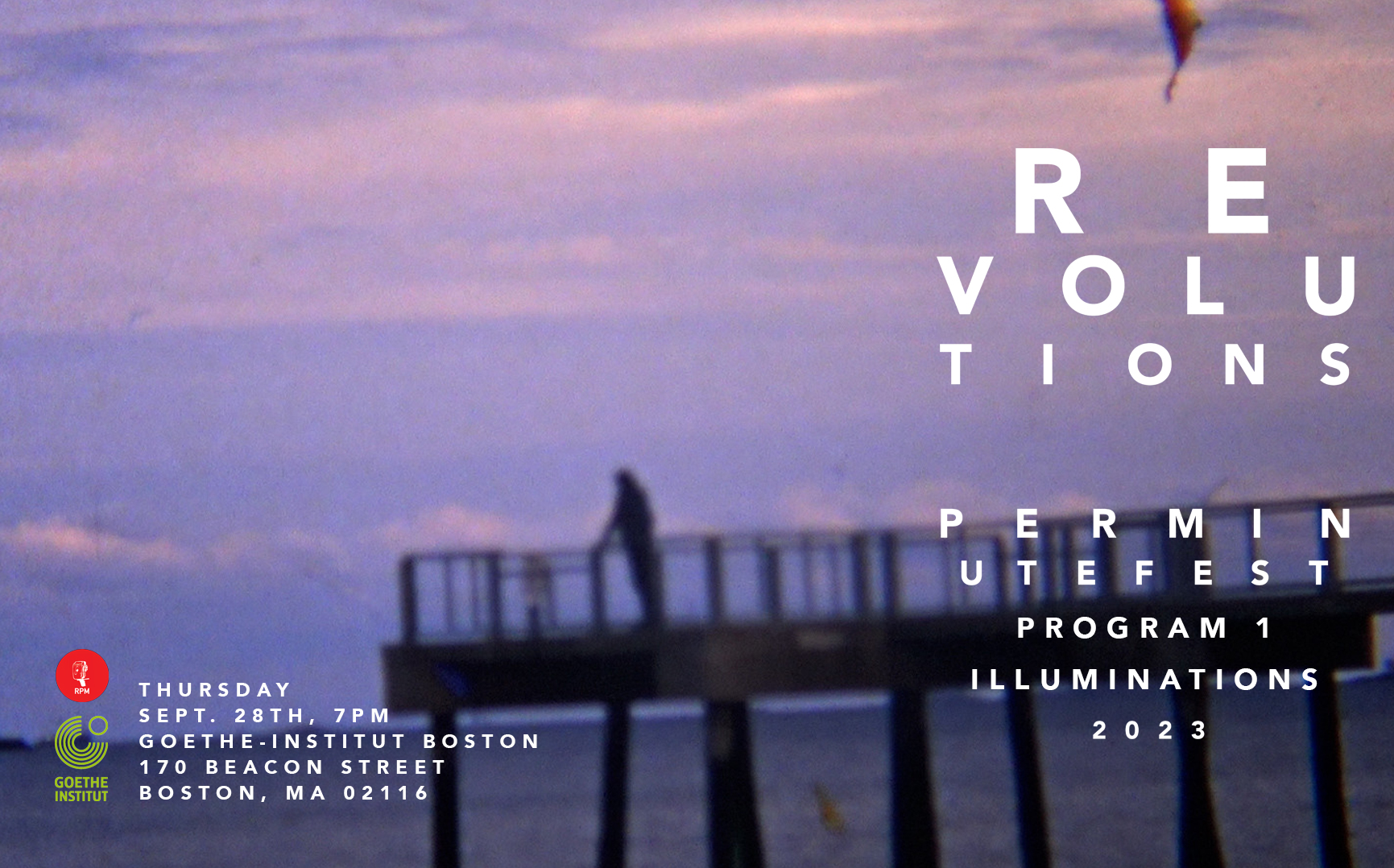
In the Wind
Yue Hua
5mins36secs, 2022, USA, color, sound, 16mm to HD
“In the wind” is a thought experiment on Found footage attempts to decipher myself and my experience of the physical world around me.
By linking my senses through sound and images, I establish my connection to this diverse and ever-changing world.
Walking In the wind is also a state that I try to maintain in the post-epidemic era, a state of confronting the world and maintaining myself -
"everything happens, dissipates in the wind, and I observe, experience, feel, and keep walking.
Yue Hua/华越 is an emerging artist and filmmaker based in Boston, focusing on visual storytelling and intermedia artwork. She loves using celluloid films to explore themes of the female, identity, spiritual and physical world. She holds a BFA from the China Academy of Art and is currently completing an MFA in Film and Media Art at Emerson College.
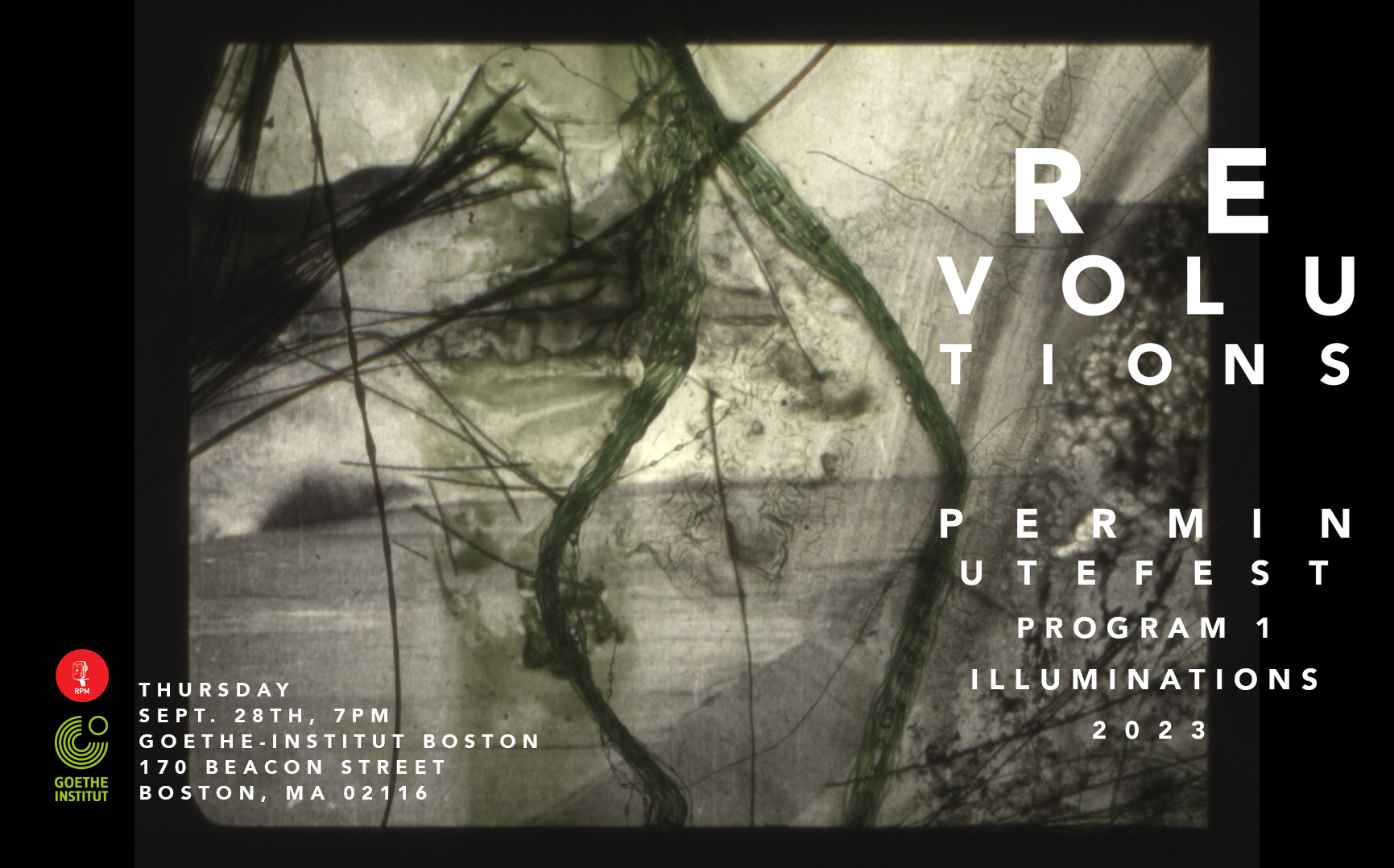
Potemkin Piece
Justin Clifford Rhody
1min35secs, 2022, USA, color, sound, 35mm to 4K
A collaborative deconstruction/destruction of a Battleship Potemkin 35mm trailer created through the mail during lockdown with nearly 100 participants. Each person was sent half-second long strips of the film to manipulate as they saw fit. Once returned, they were spliced together in a new sequence creating a chance-driven score from the optical soundtrack. A messy and exciting experiment in montage and cut up techniques made by a diverse cast including found footage maestro Craig Baldwin and my high school girlfriend.
Justin Clifford Rhody (b. 1984, Flint Michigan) is a fine art photographer, filmmaker and sound artist based in Santa Fe, New Mexico.
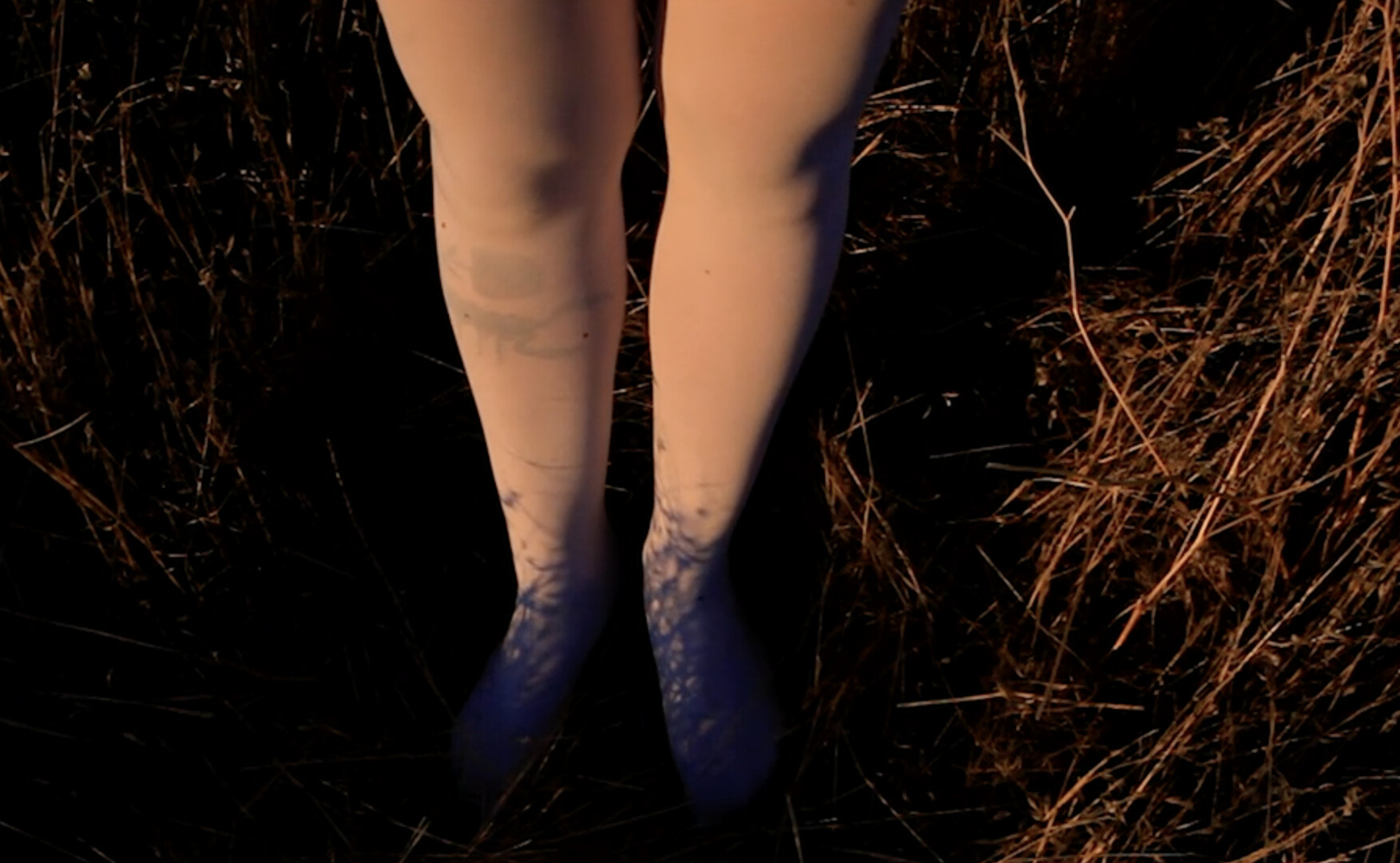
Thursday
Sept. 28th, 9PM
Goethe-Institut Boston
170 Beacon Street
Boston, MA 02116

A Companion for Amateur Cinematographers: Vol. I
Federico Di Corato
20mins, 2022, Italy, B/W & Color, sound, HD
Golden Headacher
Niina Suominen
17mins, 2022, Finland, color, sound, digital
Broadcasting from home
Mariano Ramis
3mins, 2022, Argentina, color, sound, HD
The Winter of Eternity
Patrick Müller
8mins10secs, 2022, Germany, Color, Sound, Super8 to HD
The End of the World
Ali Aschman
3mins, 2023, UK, color, sound, Digital & 16mm to HD
Postlude
Roger Deutsch
6mins, Hungary, 2023, color, sound , 8mm & 16mm to HD
Khorosho
Dominic Angerame
3mins23secs, 2022, USA, B/W, sound, 16mm to HD
Tarantula
Tomás Orrego
3mins20secs, 2023, USA, B/W, sound, 16mm to HD
White Shoes
Simone Bethancourt
6mins30secs, USA, 2022, color, sound , 8mm & HD to HD
total: 71 mins
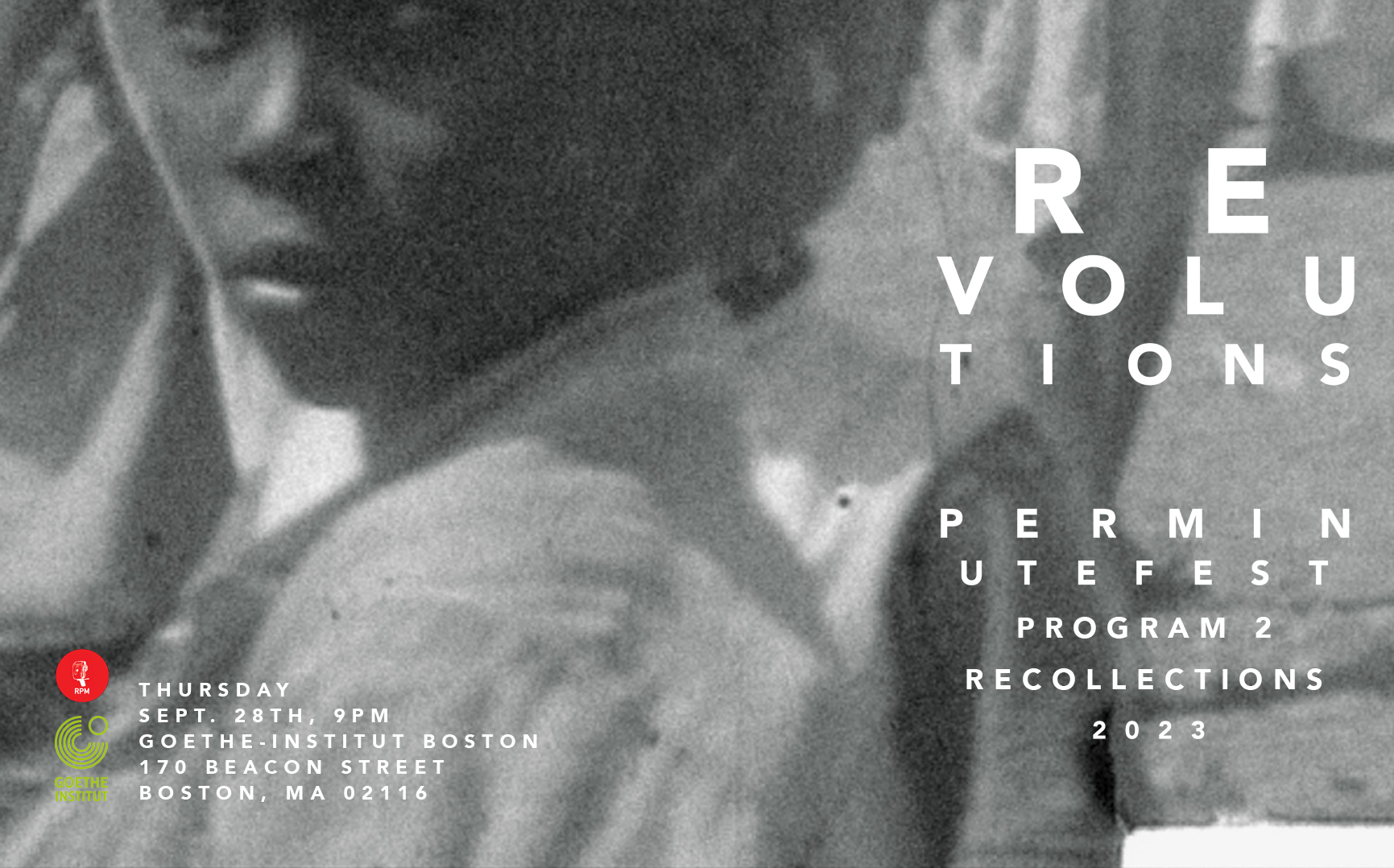
A Companion for Amateur Cinematographers: Vol. I
Federico Di Corato
20mins, 2022, Italy, B/W & Color, sound, HD
Set against the backdrop of Italy in the years of the fascist dictatorship, a man of means, yet unknown to history, scrutinises the world through his small cine camera. Guiding him and teaching him is a manual; the buds of ideology are detectable beneath the seemingly impartial tone it uses to describe technique. But in his films, the ineffable signs of resistance still rise to the surface.
Production Companies: Enece Film, Lab 80 Film
Made with: Footage from the Augusto Gandini Collection (Archivio Cinescatti – Lab 80 Film)
Development supported by: Re-framing Home Movies, Vidéadoc
Born in Andria in 1991, he lives in Milan. He graduated from the Nuova Accademia di Belle Arti (NABA), where he now teaches film editing. He is one of the founding partners of the Re-framing Home Movies association, which works to safeguard and promote amateur film heritage. He has directed three short films. “The Shack” and “(s)words” both explore the theme of private memory, through the aesthetic of video tape devices; both were presented in competition at the Locarno Film Festival. “A Companion for Amateur Cinematographers: Vol. I” is the result of his research into Fascist-era manuals for amateur cine enthusiasts; it was presented in competition at the Venice Film Festival.
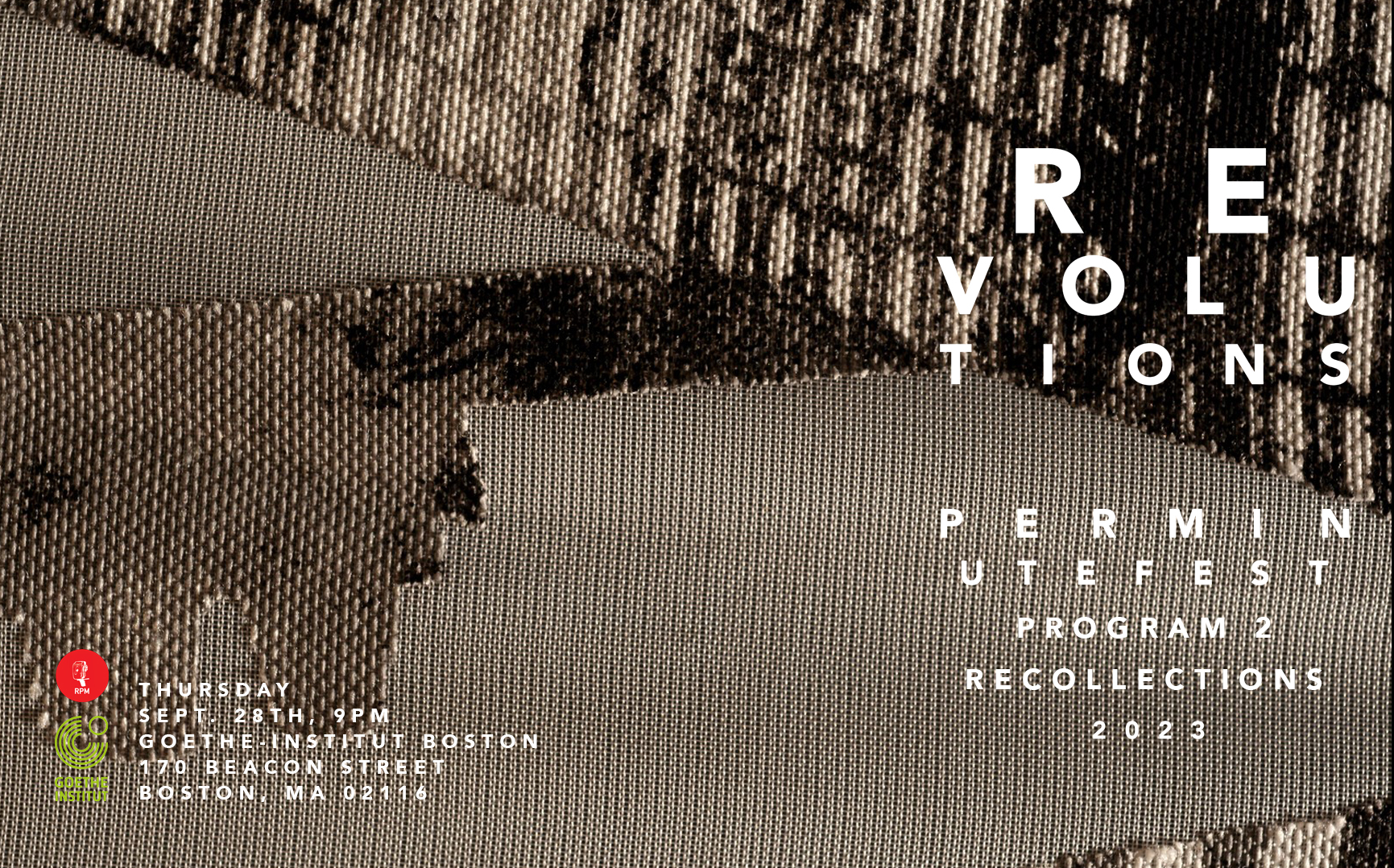
Golden Headacher
Niina Suominen
17mins, 2022, Finland, color, sound, digital
An experimental animation documentary about women’s hate and aggression and the culturally sanctioned ways to express or suppress these uneasy feelings. The film was created by animating textile and décor waste and beautiful glossy pictures of children that were popular in Scandinavia in the last century. The work brings to the fore the irritation and exhaustion felt by women and the thoughts often left unsaid outside the walls of home, as well as reflecting on the remorse and the shame felt after the bursts of anger.
Niina Suominen graduated from the Arts Academy at Turku in 2004. She also has an education of a blacksmith, animal nurse and a forest worker. She works as a film director and media artist using traditional animation techniques requiring hand-work. Her works have been shown widely at the festivals both in Finland and abroad. She lives and works in Southwest Finland.
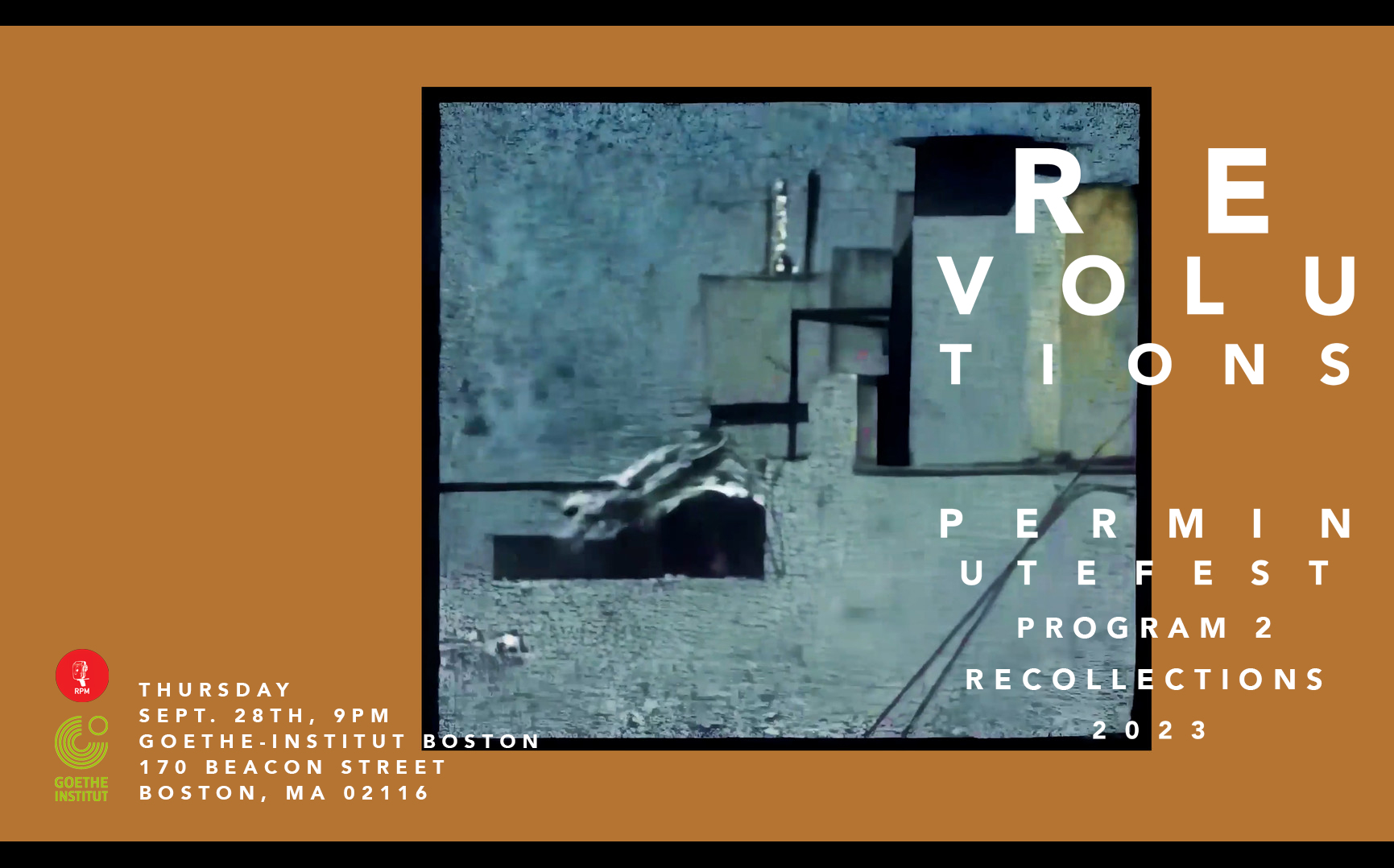
Broadcasting from home
Mariano Ramis
3mins, 2022, Argentina, color, sound, HD
Broadcasting from home, was created while reflecting about the perplexity of loss and the human desire to communicate with the afterlife.
The video was manufactured using frame-by-frame analog transfer technique and digital post-production.
Born in San Pedro, Buenos Aires, Argentina in 1979.
Mariano Ramis is an Image and Sound Designer from the Faculty of Architecture and Design of the Universidad de Buenos Aires, preparing thesis on video montage through Artificial Intelligence.
As an artist he specializes in frame by frame experimentation on moving image recording, mixed image transfer techniques and music. His work has been exhibited in festivals, museums and salons in Argentina, America and Europe.
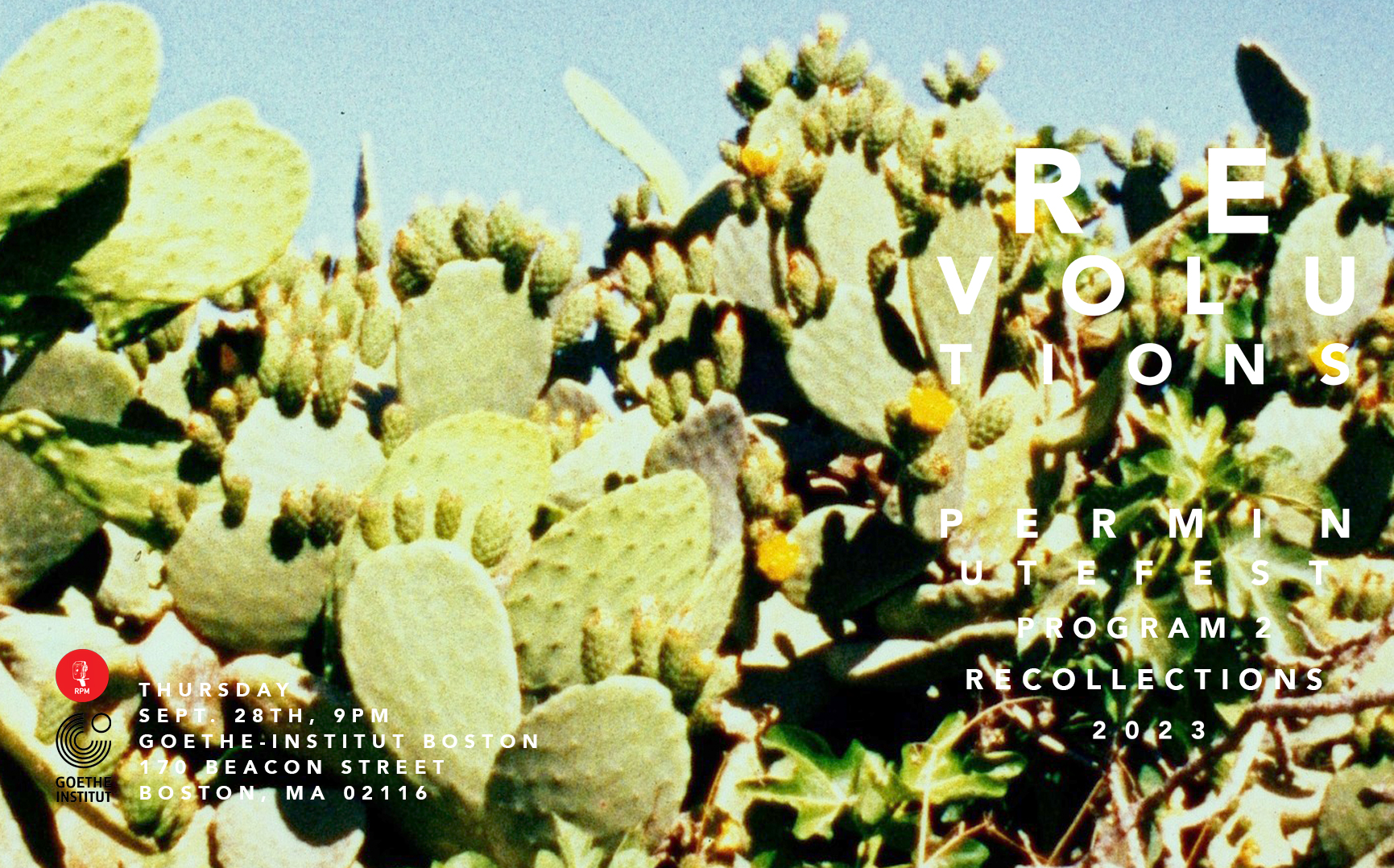
The Winter of Eternity
Patrick Müller
8mins10secs, 2022, Germany, Color, Sound, Super8 to HD
What's the meaning of life? How do I find my way? In his existential philosophy work CITADELLE, Antoine de Saint-Exupéry posthumously gives us uncomfortable answers.
A few years ago I visited the citadel on the island of Gozo and immediately remembered Antoine de St. Exupéry's posthumously published existential philosophy work CITADELLE. I had read the text fifteen years ago and, because of its radical nature and mysterious beauty, I never forgot one passage in particular that dealt with the meaning of life. I took my Super 8 camera and filmed my associations. The soundtrack finally succeeded in 2022: Valérie Hendrich spoke the text and four young musicians based in Chemnitz, Germany, composed the music (In 2023 they even won the first prize at "Jugend musiziert" festival in Berlin for their score).
Patrick Müller, born in 1981 in Frankenberg, GDR, has made more than 40 short films, primarily with 8 and 16mm film, seeking to explore poetry within moving images. His experimental works have screened at numerous film festivals around the world and won several awards.
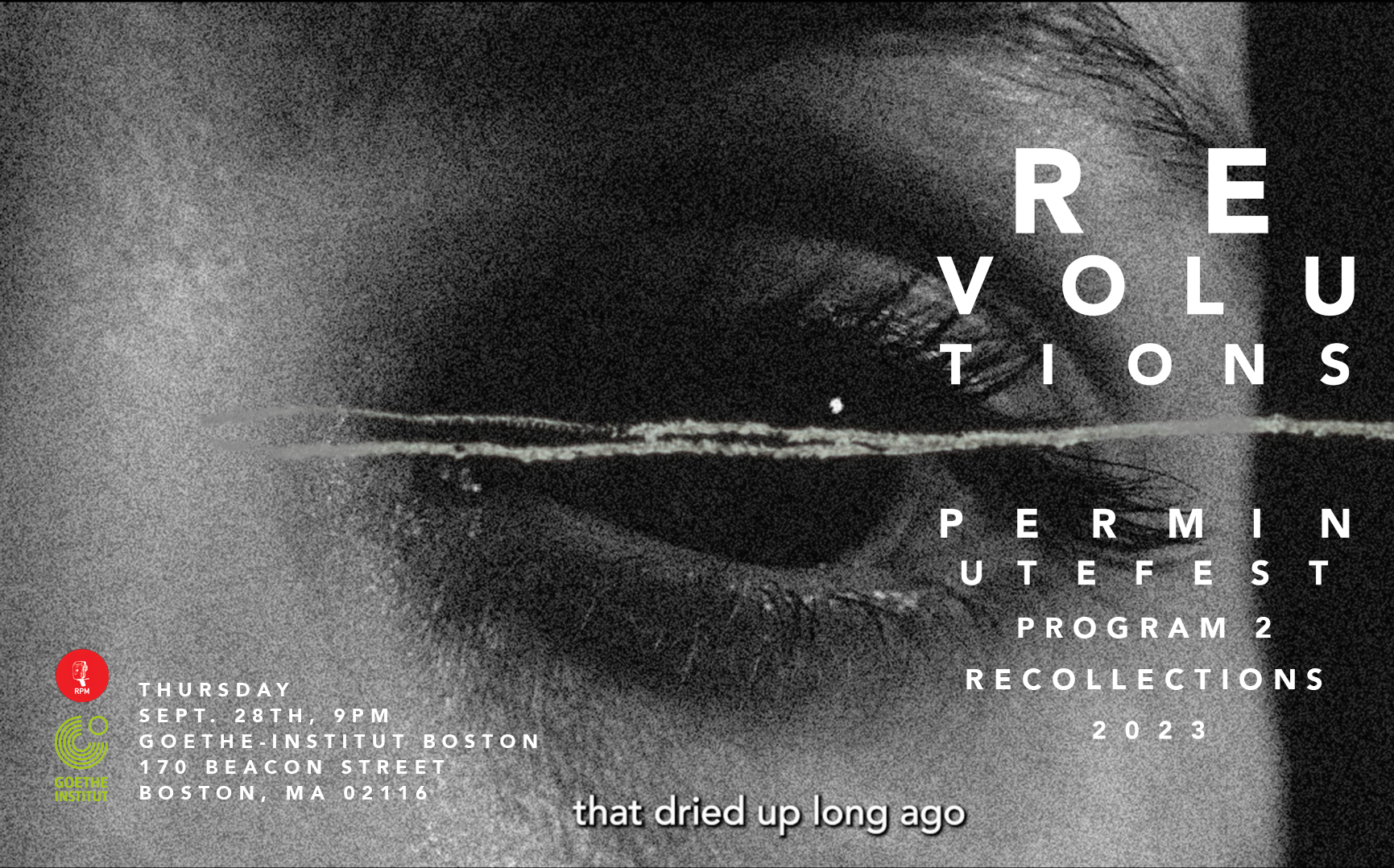
The End of the World
Ali Aschman
3mins, 2023, UK, color, sound, Digital & 16mm to HD
How do we relate to the concept of climate catastrophe on a personal level? The filmmaker draws a parallel between various threats of climate change and her own visceral and emotional experience of grieving after an immense and sudden loss, questioning her capacity to care about humanity yet nonetheless showing a glimmer of hope for the future.
Ali Aschman is a London-based artist from South Africa and the United States, making experimental animated short films. Her work has been exhibited in numerous galleries in the US and screened at festivals worldwide. She has studied at the University of Cape Town, the School of the Art Institute of Chicago and the Royal College of Art. She is the Pathway Leader for Animation & Film at Cambridge School of Visual and Performing Arts.
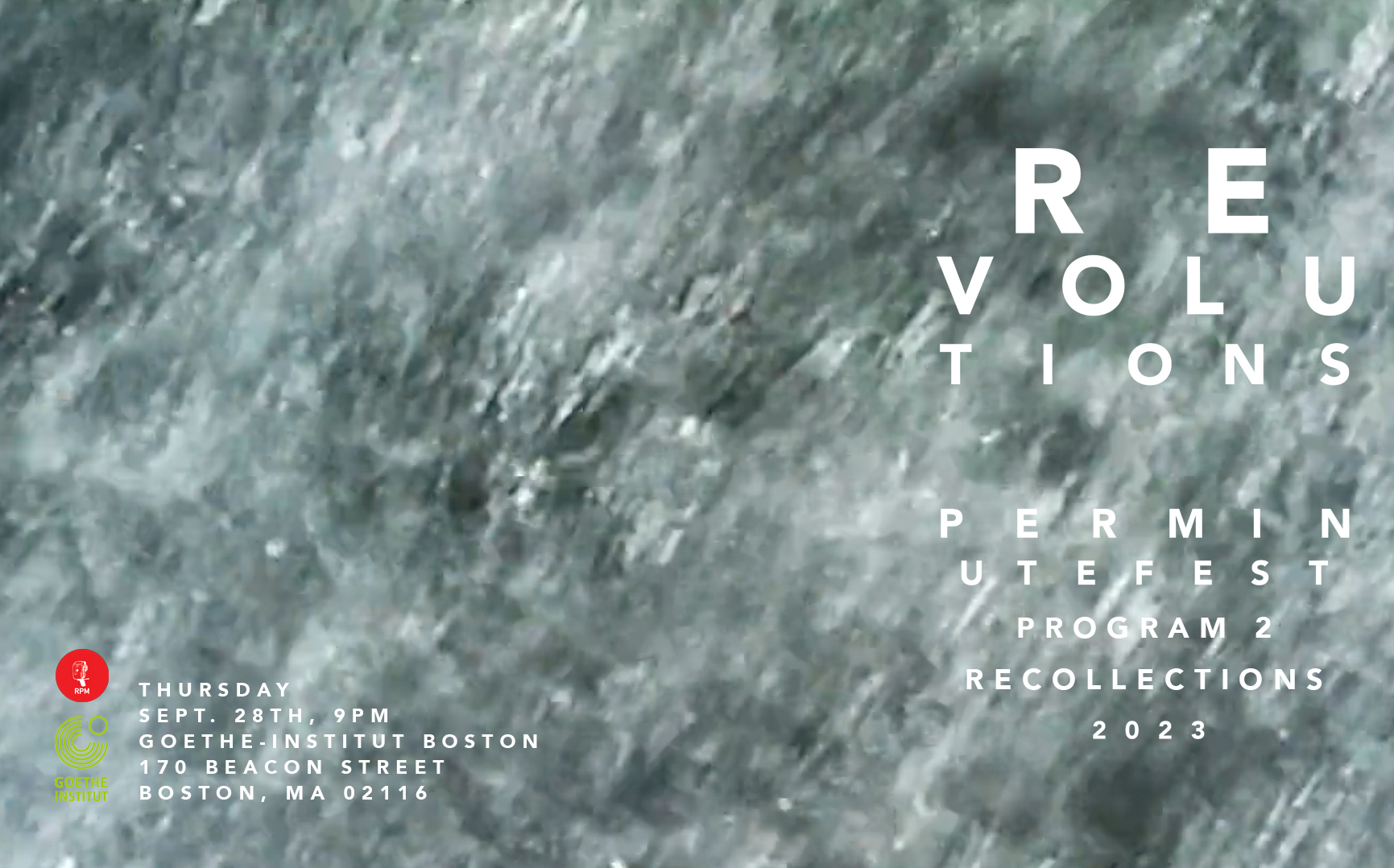
Postlude
Roger Deutsch
6mins, Hungary, 2023, color, sound , 8mm & 16mm to HD
"Would I lie to you? All I do is dream of you."
"Don't"
Roger Deutsch is an American who lives in Hungary. He entered the realm of film 40 years ago as the producer of the punk classic “Blank Generation” featuring Richard Hell and the Voidoids.
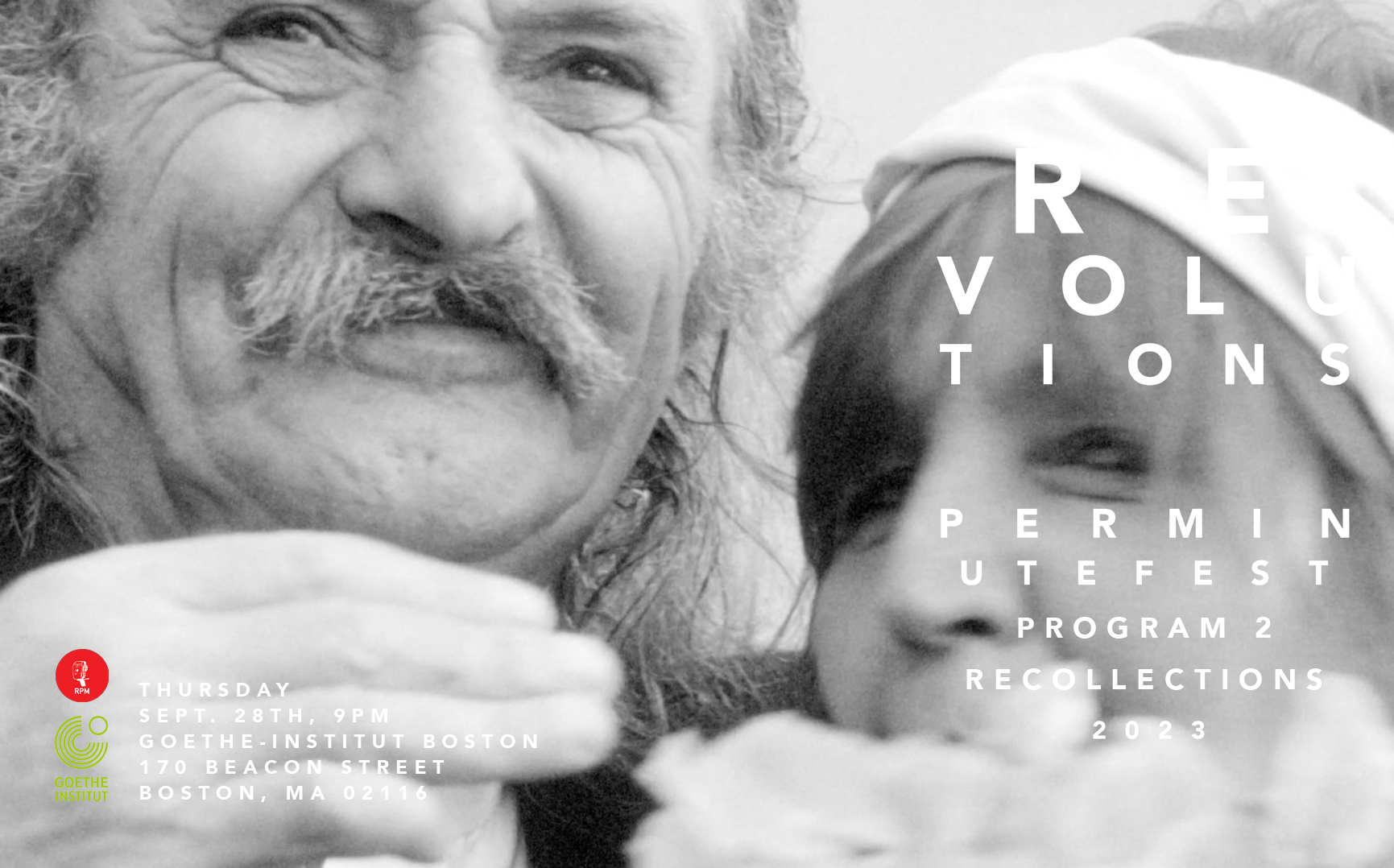
Khorosho
Dominic Angerame
3mins23secs, 2022, USA, B/W, sound, 16mm to HD
In June 1999 dear friends Agnetta Falk and Jack Hirschman were married at Matt Gonzales' place in the Mission. I was there with my 16mm Bolex and filmed part of the ceremony and crowd. After almost 30 years I finally made this footage into a finished film. It features many of our dear friends both living and deceased. In honor of Jack and Aggie's wedding anniversary I finished the film over the weekend.
Dominic Angerame's works search for unfamiliar views of seemingly familiar things: cities, landscapes, faces, and bodies. The filmmaker's desire to make everyday images "strange" at the editing table, to learn to see them fresh and to estrange them from our senses, makes his films seem-in all the different social realities they contain-always distanced as well, as if they led to another world beyond the concrete, beyond time and defined space. In Angerame's films, which pay homage to films from early cinema and the classic avant garde to American underground films of the 1960s and 70s and non-narrative films of the present day, an amazingly comprehensive history of the "visionary" moving image is always present. It may be that precisely his refusal to adopt a signature style has diminished the immediate influence of Angerame's films; however, Angerame's decision to work "universally," not to be swayed by considerations of the art market, and to experiment with very different styles increases the pedagogical worth of his films. It's not surprising to learn that Angerame, born in 1949, teaches at several American schools in addition to having served as the executive director of the American avant garde distribution center Canyon Cinema from 1980 to 2012.
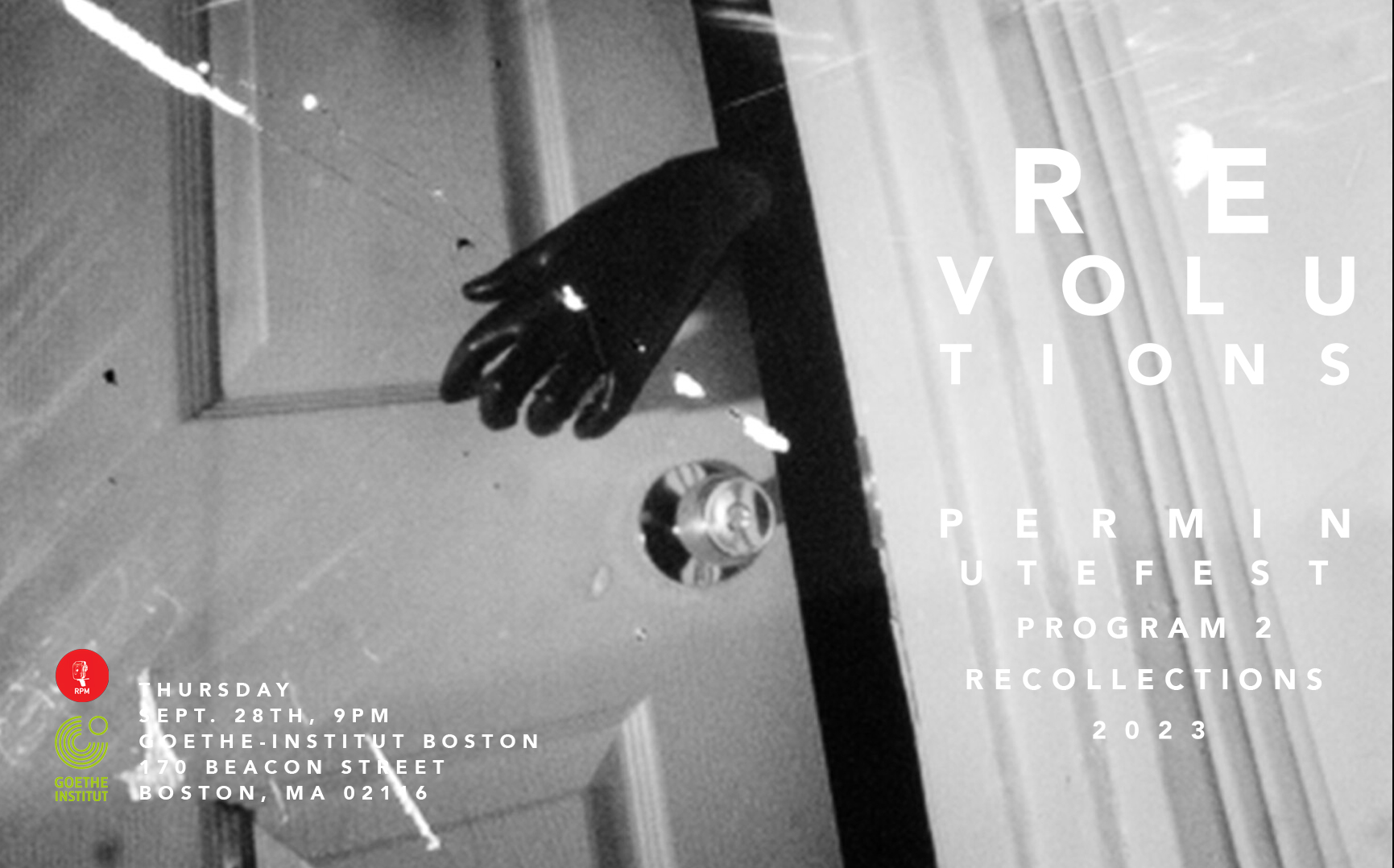
Tarantula
Tomás Orrego
3mins20secs, 2023, USA, B/W, sound, 16mm to HD
When hungry, the black gloved tarantula crawls out of its crypt to feed. The pale flesh of innocent bodies it takes into dark corners to ejaculate.
Tomás Orrego (Lima 1991) is a filmmaker, designer, visual artist, and musician with studies in architecture. Through digital animation, sound design and video installation, his work embraces the drowsy consciousness of dreams.
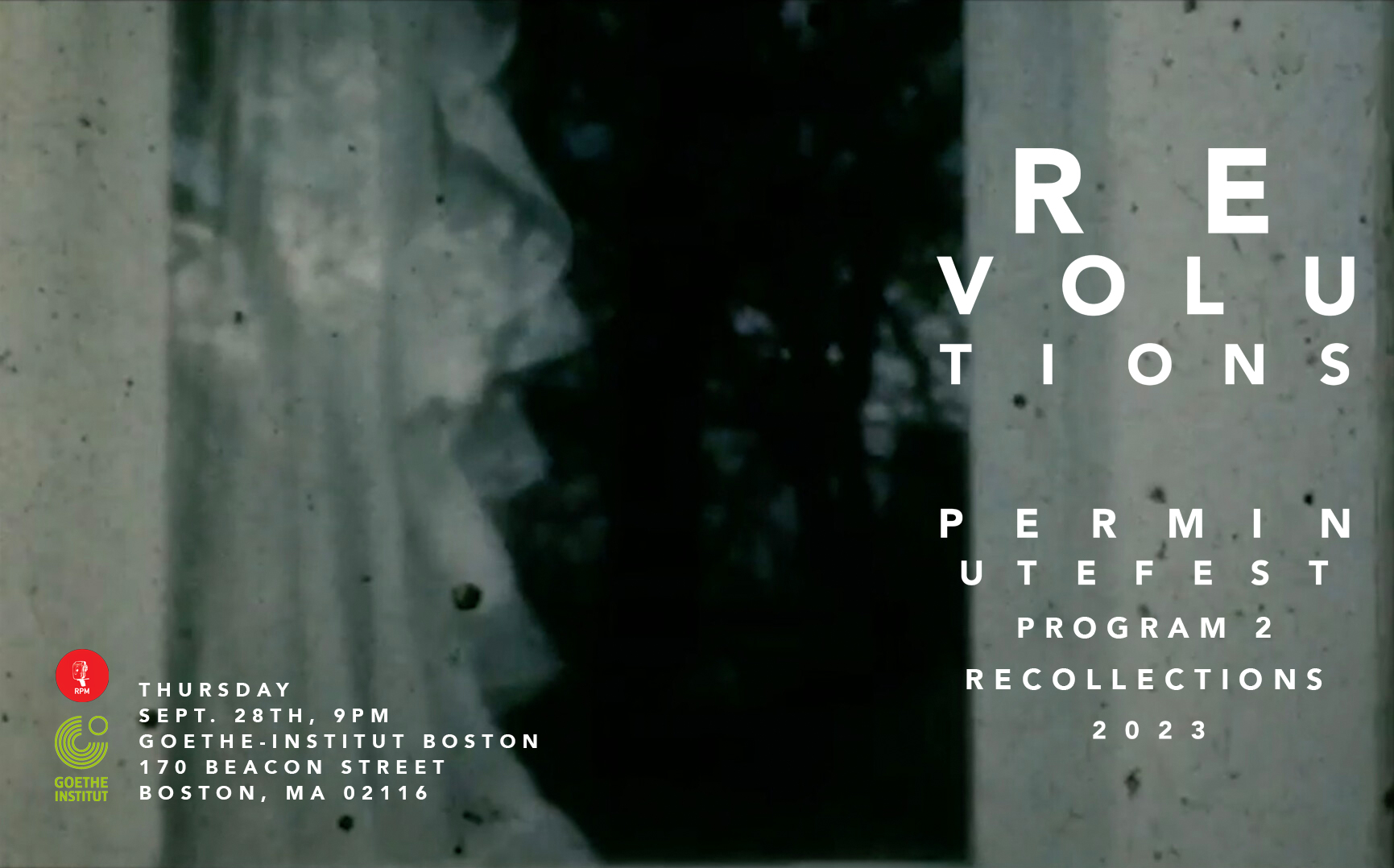
White Shoes
Simone Bethancourt
6mins30secs, USA, 2022, color, sound , 8mm & HD to HD
A memory told from the perspective of a little girl meeting her father for the first time, and the gift he gives her before disappearing.
Simone Bethancourt graduated from the Calarts in 2022. White shoes is her thesis project.

Friday
Sept. 30th, 5PM - 7PM
University Hall Gallery
UMass-Boston (JFK/UMass)
University Drive North
Boston(Dorchester)
MA 02125


Friday
Sept. 29th, 6PM
University Hall 2300
University Hall
UMass-Boston (JFK/UMass)
University Drive North
Boston (Dorchester)
MA 02125

“And when I die let me be buried in a Hemlock coffin, so I’ll go through hell snapping.”
Sarah Ema Friedland
7mins54secs, 2022, USA, B/W & Color, sound, 16mm&HD to HD
Sea of Sighs
J.M. Martínez
5mins, 2022, USA, color, sound, 18fps, Super8 to HD
Salute to the Sun
Darko Masnec
8mins50secs, 2022, Croatia, Color, Sound, HD
Radiant Forms
Ryan Marino
7mins, 2022, USA, color, sound, 16mm to HD
Exaggerations
Charles de Agustin
20mins, 2022, UK&USA, color, sound, digital
Konstantin
Hogan Seidel
3mins, USA, 2023, B/W & color, sound , 16mm to HD
Ill Composto
Moviate (Josh Drake, James Hollenbaugh, Jeremy Moss, Caleb Smith)
3mins38secs, 2023, USA, color, sound, 16mm
electric moonlight & the language within the leaves
Takahiro Suzuki
8mins, USA, 2023, B/W & color, sound , Super8 to HD
de-composition
Laura Kraning
2mins40secs, USA, 2023, color, sound , HD
total: 74 mins
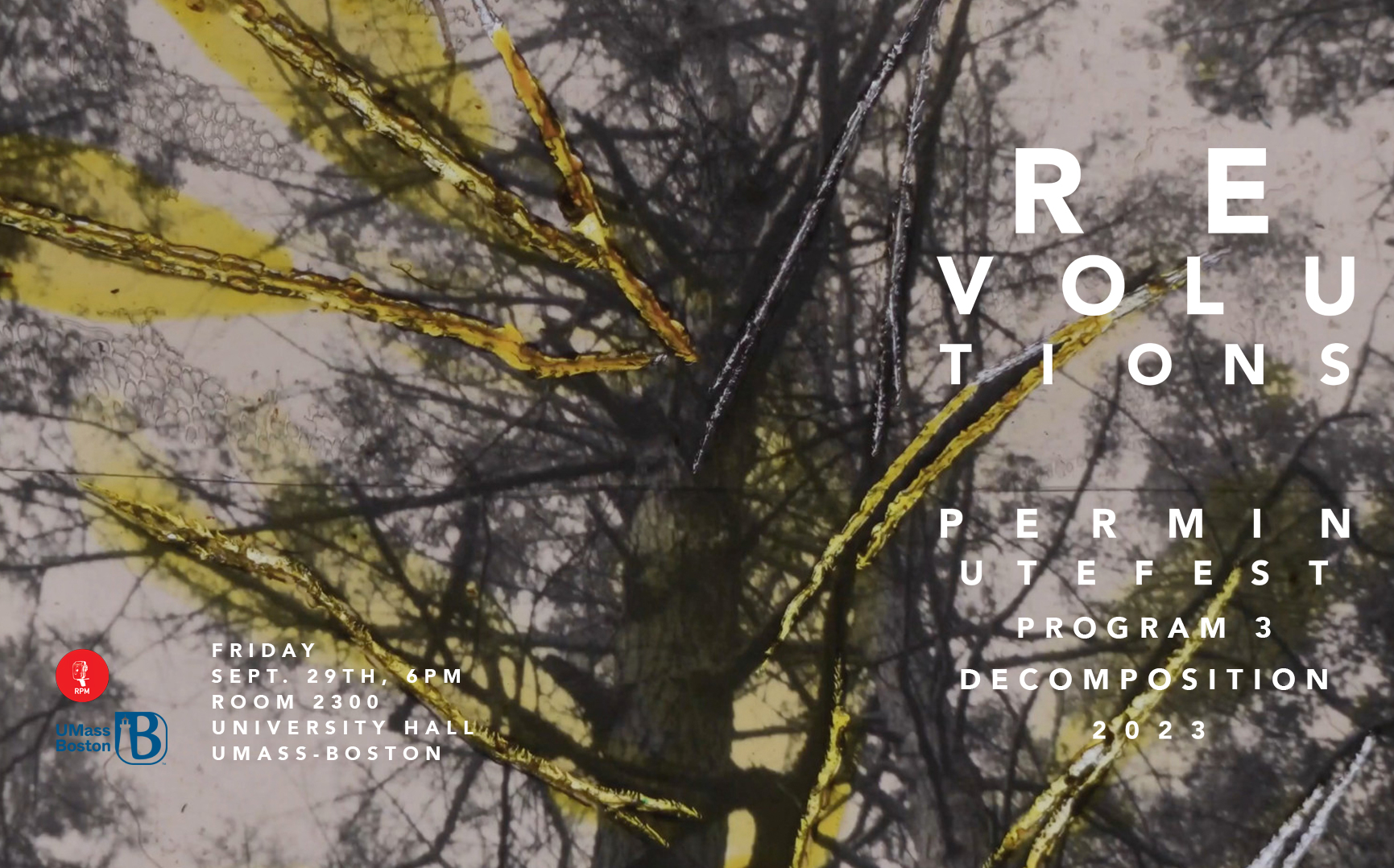
“And when I die let me be buried in a Hemlock coffin, so I’ll go through hell snapping.”
Sarah Ema Friedland
7mins54secs, 2022, USA, B/W & Color, sound, 16mm&HD to HD
Combining fantastical hand-painted and computer animations with 16mm film, a Hemlock forest in Western Massachusetts that is dying due to beetle infestation tells a larger story about climate collapse and the interconnections between the natural and the built environments.
Sarah Ema Friedland received her BA from Sarah Lawrence College and the International School of Film and Television in Cuba and her MFA from the Integrated Media Art Program at Hunter College.
Friedland’s works have been supported by grants and fellowships from the Jerome Foundation, the Paul Newman Foundation, the Ford Foundation, the New York State Council on the Arts, the Palestine American Research Center, the LABA House of Study, and the MacDowell Colony.Friedland is a member of the Meerkat Media Collective and the Director of the MDOCS Storyteller’s Institute at Skidmore College.
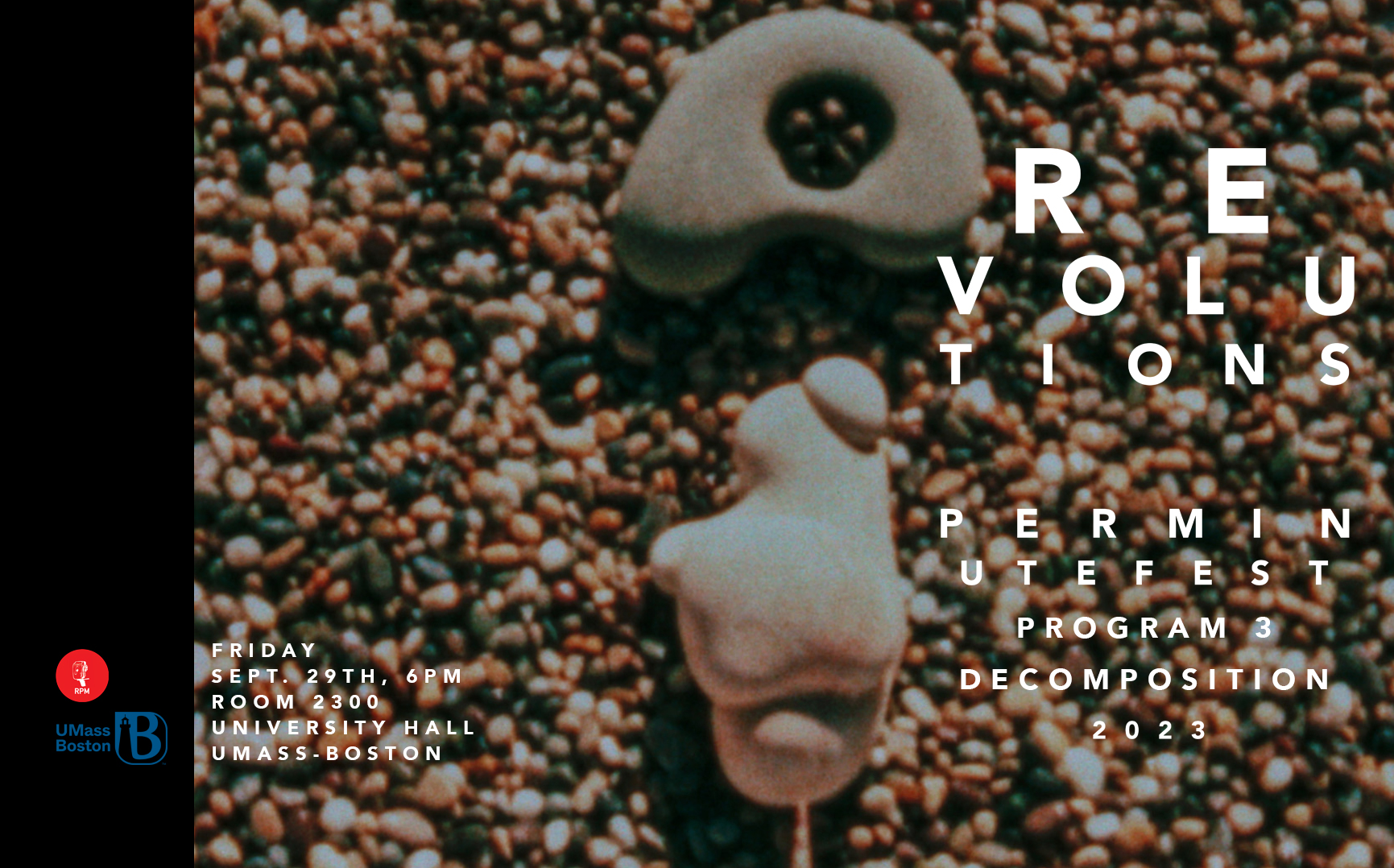
Sea of Sighs
J.M. Martínez
5mins, 2022, USA, color, sound, 18fps, Super8 to HD
Oceanic patterns come in waves of chroma blurs and ultraviolet light, illuminating marine life in states of change.
Washed-up pieces of bleached coral, urchins, and abalone enter tide pools offering evidence of acidification in the warming waters of the Pacific Ocean. Imagery and color were manipulated with found sea glass and diachronic glass. The sound was made with hydrophones placed inside tide pools, within layers of sea foam, and the surrounding waters capturing the sounds of whales, sonar, container ships, cruise ships, and mining. An ocean soundscape of increasing noise.
J.M. Martínez is an artist based in the Santa Cruz Mountains of California working with photography, film, video, and sculpture. His work utilizes the properties of light with the intention of abstracted visions and biomorphic forms that reveal the evolving landscape. Works of his have been exhibited at SFMoMA, CROSSROADS, Chicago Underground, Festival ECRÃ, EXiS, Crater-Lab, Cámara Lúcida, Antimatter, and the San Francisco Cinematheque.
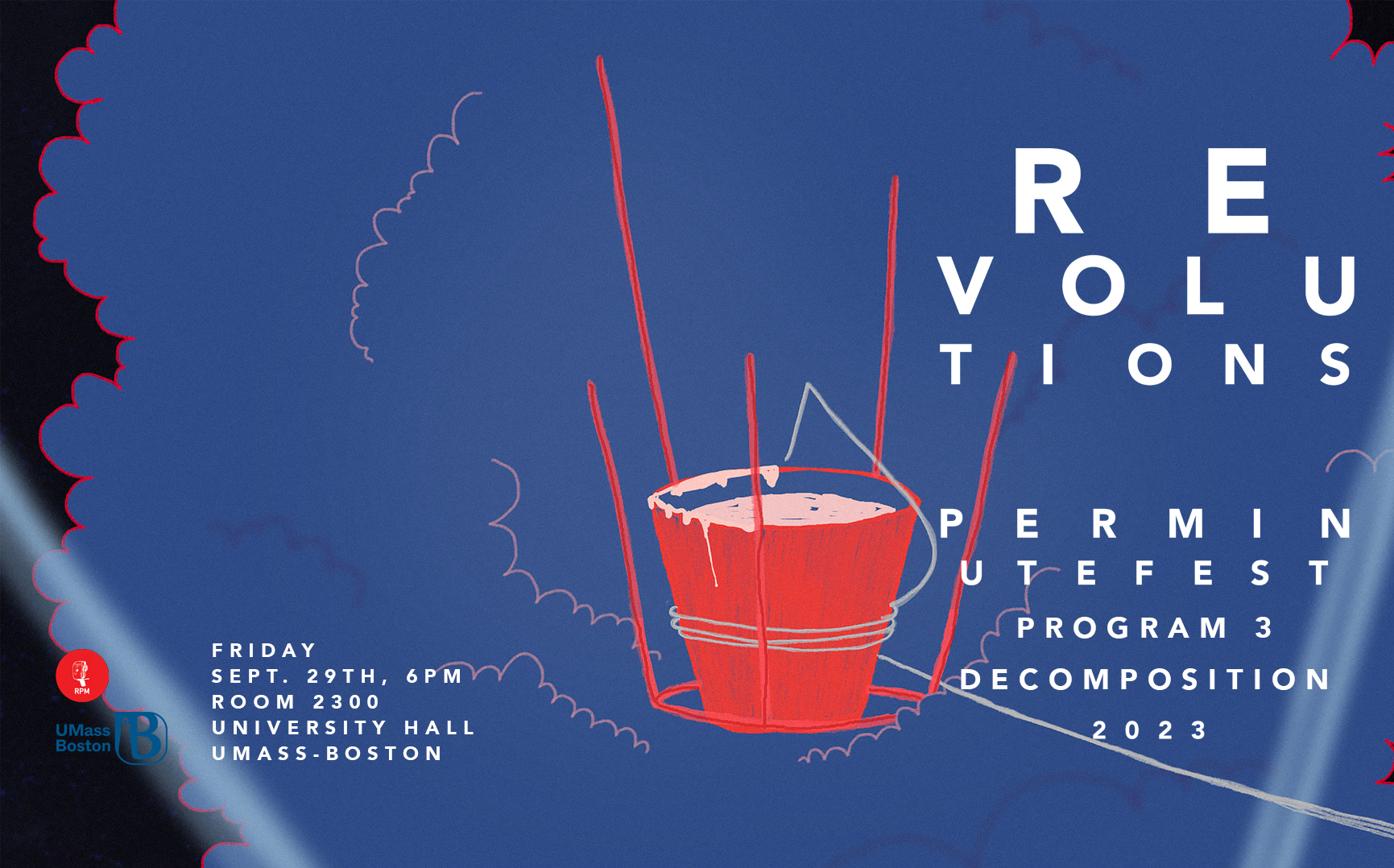
Salute to the Sun
Darko Masnec
8mins50secs, 2022, Croatia, Color, Sound, HD
An astronaut in love orbits around the sun absorbing its energy. But the sun is too big, causing their connection to break, and the astronaut must continue on his own. As he tries to return to his source of energy, he realizes there are others like him. What started out as a game, slowly turns into a love triangle. Shapes change, but their needs remain the same.
Darko Masnec (1985, Celje) graduated from the Faculty of Education (Department of Visual Arts) in Maribor in 2009 and in 2012 completed his MA studies at the Academy of Fine Arts in Zagreb, Department of Animation and New Media. In 2017 he obtained a PhD degree from the Academy of Fine Arts in Zagreb with the thesis “The Zagreb School of Animated Film: Art and Market Practices in the Context of Videogames”. He has worked as an animator on a few short animated film projects and published several articles on the topic of animation and videogames. He regularly cooperates with Animafest and other festivals. He currently works as an assistant professor at the Academy of Fine Arts in Zagreb.
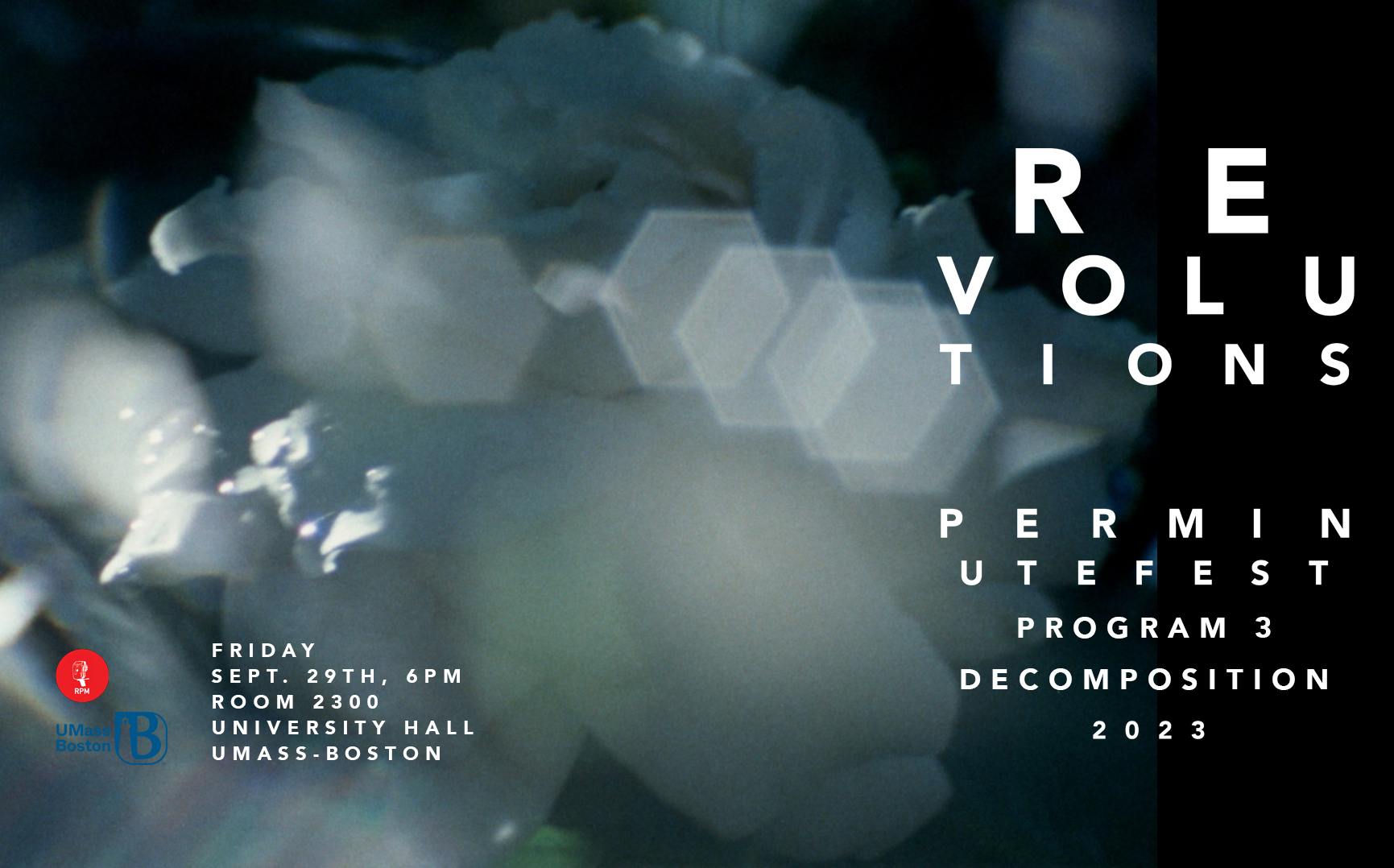
Radiant Forms
Ryan Marino
7mins, 2022, USA, color, sound, 16mm
Luminous forms merging in time.
Ryan Marino is an interdisciplinary artist working with film, sound, and collage. His 16mm films explore the ethereality of time, light, and space. His 16mm films have screened at film festivals and venues including: Anthology Film Archives, New York Film Festival, San Francisco International Film Festival, Milwaukee Underground Film Festival, Uplink (Tokyo), Venice Biennale, Fracto Experimental Film Encounter, Spectacle Theater, and Pacific Film Archive. In addition to creating the soundtracks for his own films, his sound work includes original compositions and commissioned soundtracks for short films and theater productions. By day he works as an audiovisual archivist.
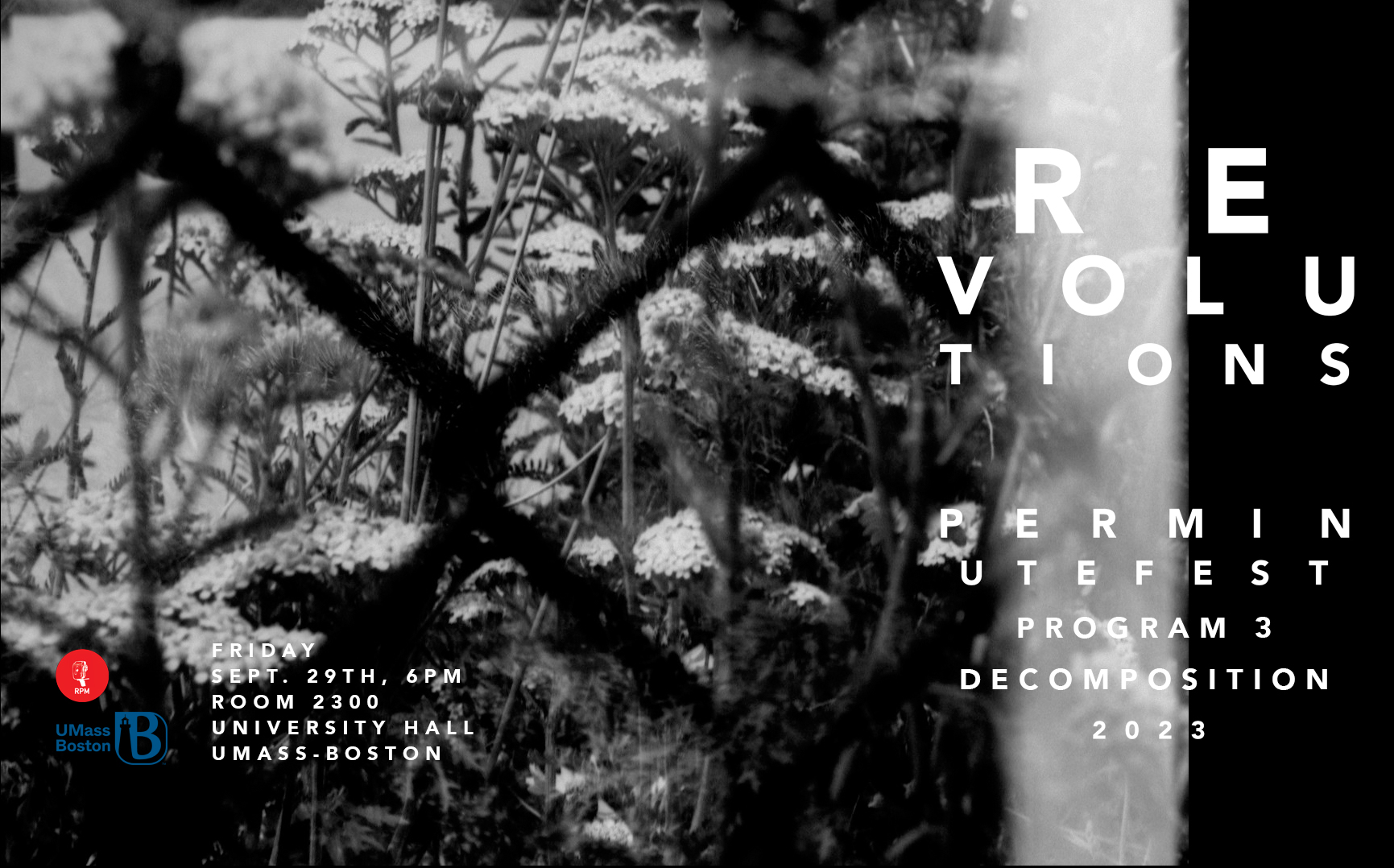
Konstantin
Hogan Seidel
3mins, USA, 2023, B/W & color, sound , 16mm to HD
Konstantin is an experimental film shot on high-contrast black and white 16mm film using a single 100ft reel. The film is an in-camera edit with triple exposures, creating a layered and complex visual language. Through this aesthetic, the piece explores themes of queer love and queer ecology. It invites the viewer to enter a unique and poetic world, where the boundaries between the human and natural realms blur and merge. Pushing against human exceptionalism & into a world where there is no ‘natural’ or ‘unnatural.’
Can a walk in the forest, a kiss between lovers, a roll of film, the touch lichen, liberate ourselves from these hierarchies?
Born and raised in the American South, Hogan Seidel is an interdisciplinary artist with a creative presence in Boston and Seattle. Their moving image art has been featured in prestigious festivals, including Alchemy, Analogica, Onion City, and Istanbul Experimental. Their work has been shown at museums and galleries such as the Belvedere Contemporary Art Museum, The Museum of Fine Arts Boston, The Boston Center for the Arts, Cyber Arts New Media Gallery, Fountain Street Gallery, and the Clemente. Hogan has received funding and support for their work from the Massachusetts Cultural Council, Collective Futures, and the United States Artists Grant. They are a recent alum of the Studios at MASS MoCA Artist Residency.
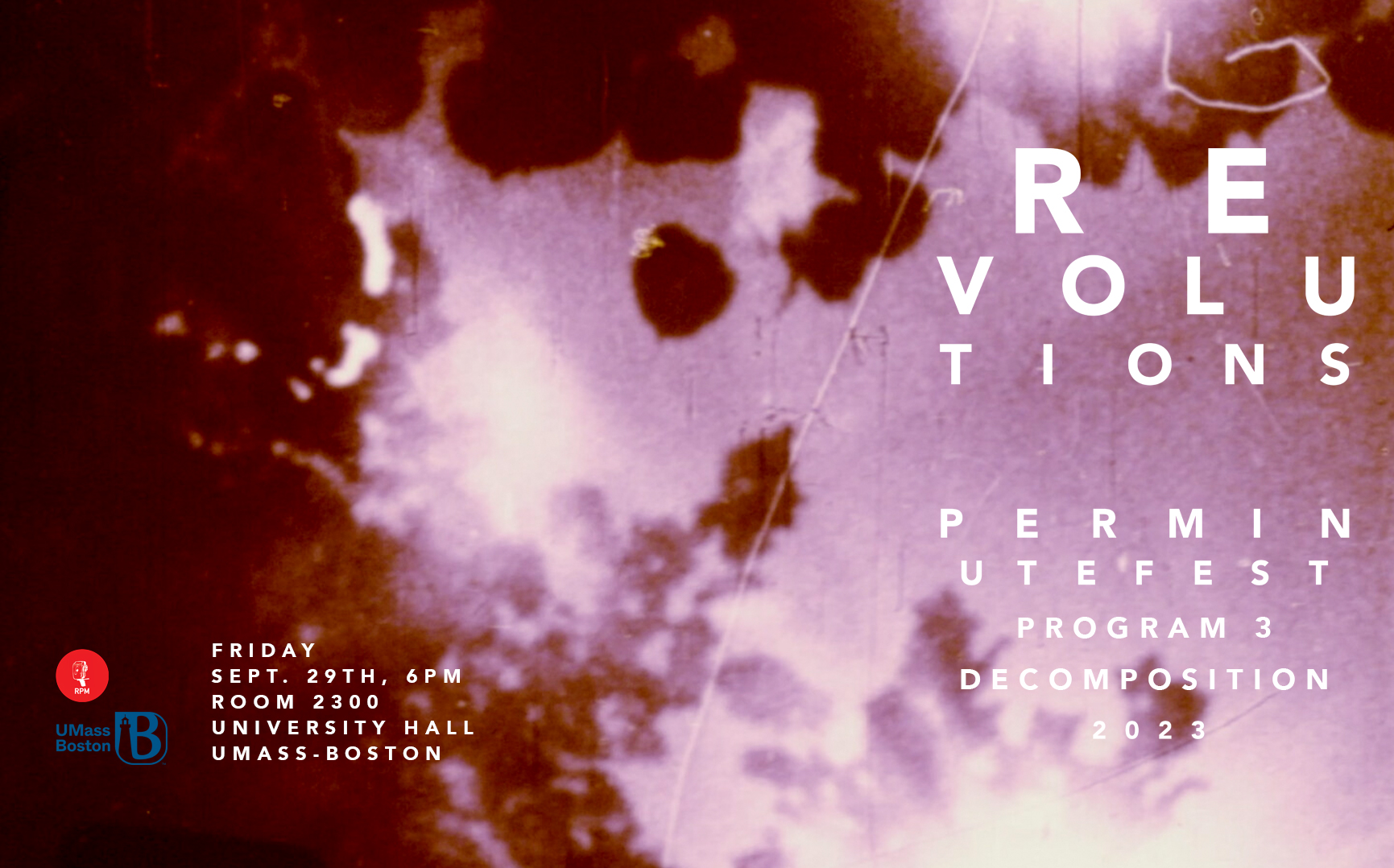
Ill Composto
Moviate (Josh Drake, James Hollenbaugh, Jeremy Moss, Caleb Smith)
3mins38secs, 2023, USA, color, sound, 16mm
A collaborative Dadaist/exquisite corpse film on the theme of waste by four members of the Harrisburg-based collective Moviate.
Process: A found, expired 100’ roll of 16mm color negative film was split into four parts and photographed separately by each participant. Then each section was developed in a homemade b&w developer from the participant’s own compostable waste. The negative was then printed to 16mm color print stock on a makeshift DIY contact printer along with found optical sound. Lastly, it was assembled in the Dadaist poetry method by cutting the printed film into pieces, placing them into a large wooden box with holes, randomly pulling strips of film out through the holes one at a time and splicing them together in that order.
Moviate is a filmmaker-run curatorial collective based in Harrisburg, Pennsylvania.
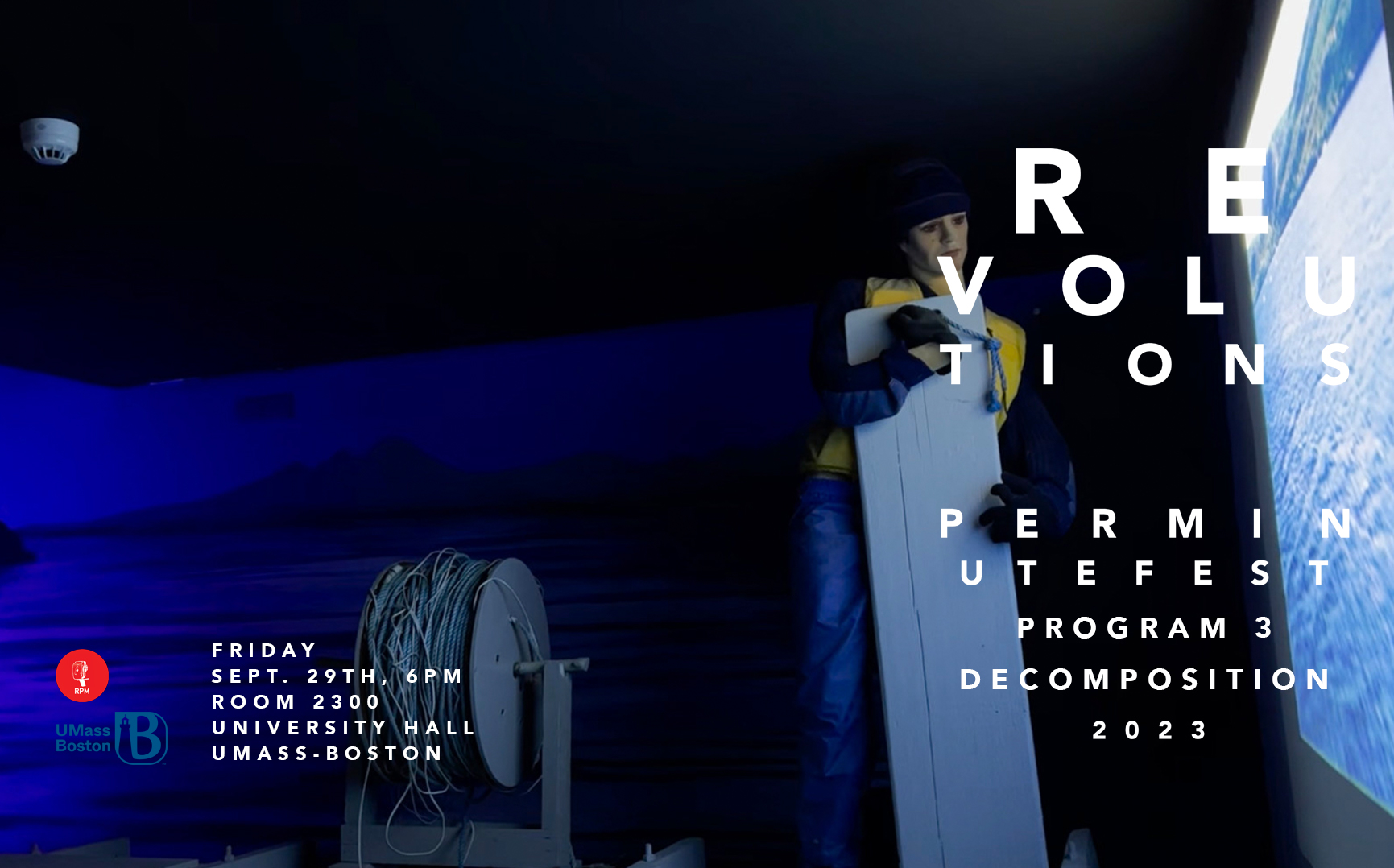
Exaggerations
Charles de Agustin
20mins, 2022, UK&USA, color, sound, digital
A supernatural road trip in the Scottish village of Foyers, the American hamlet of Grovers Mill, and reading breaks in an Amsterdam film library. We try to pick at belief and clarity. Difficulties between loving your work, working at loving, making a living. Language piles up, crashes down, and maybe becomes something else.
Charles de Agustin is an artist primarily making films, performances, and texts which playfully scavenge in the ruins of critique and complicity. Influenced by essay/diary cinema traditions, de Agustin finds value in making a caricature out of the didactic, working toward better questions about the insidious forms of violence that impact our attempts at leading ethical lives.
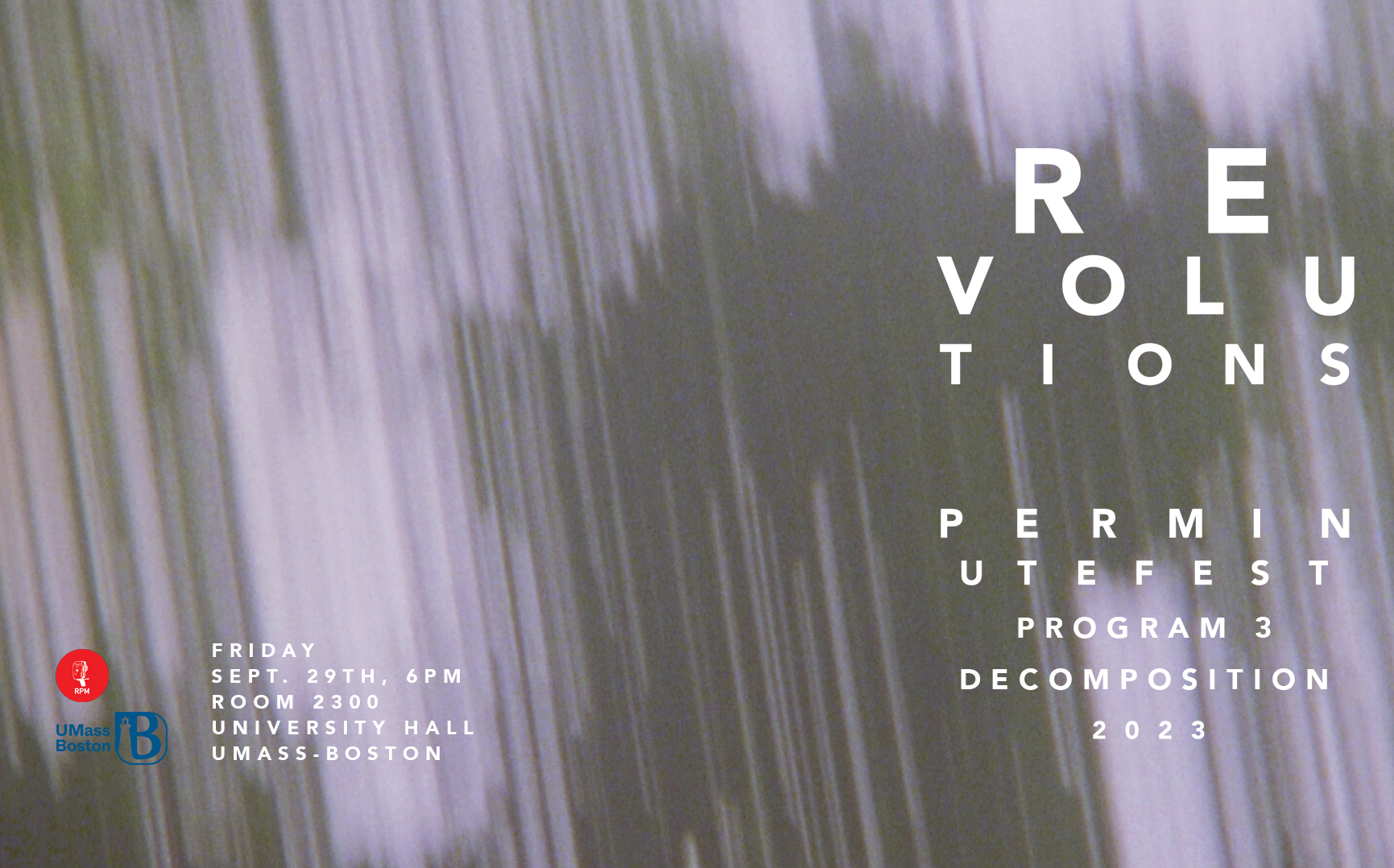
electric moonlight & the language within the leaves
Takahiro Suzuki
8mins, USA, 2023, B/W & color, sound , Super8 to HD
a modern re-telling of the japanese tale of the bamboo cutter and the moon princess. the moon princess listens to the untold intelligence of the cosmos as observed by the trees to become closer with and eventually return home.
Takahiro Suzuki (he/him/his) is an artist currently residing in Portland, ME (USA). He completed his BA in Studio Art from the University of Virginia concentrating in the media of photography and cinematography, and received his MFA in Film, Video, Animation, and New Genres from the University of Wisconsin-Milwaukee.
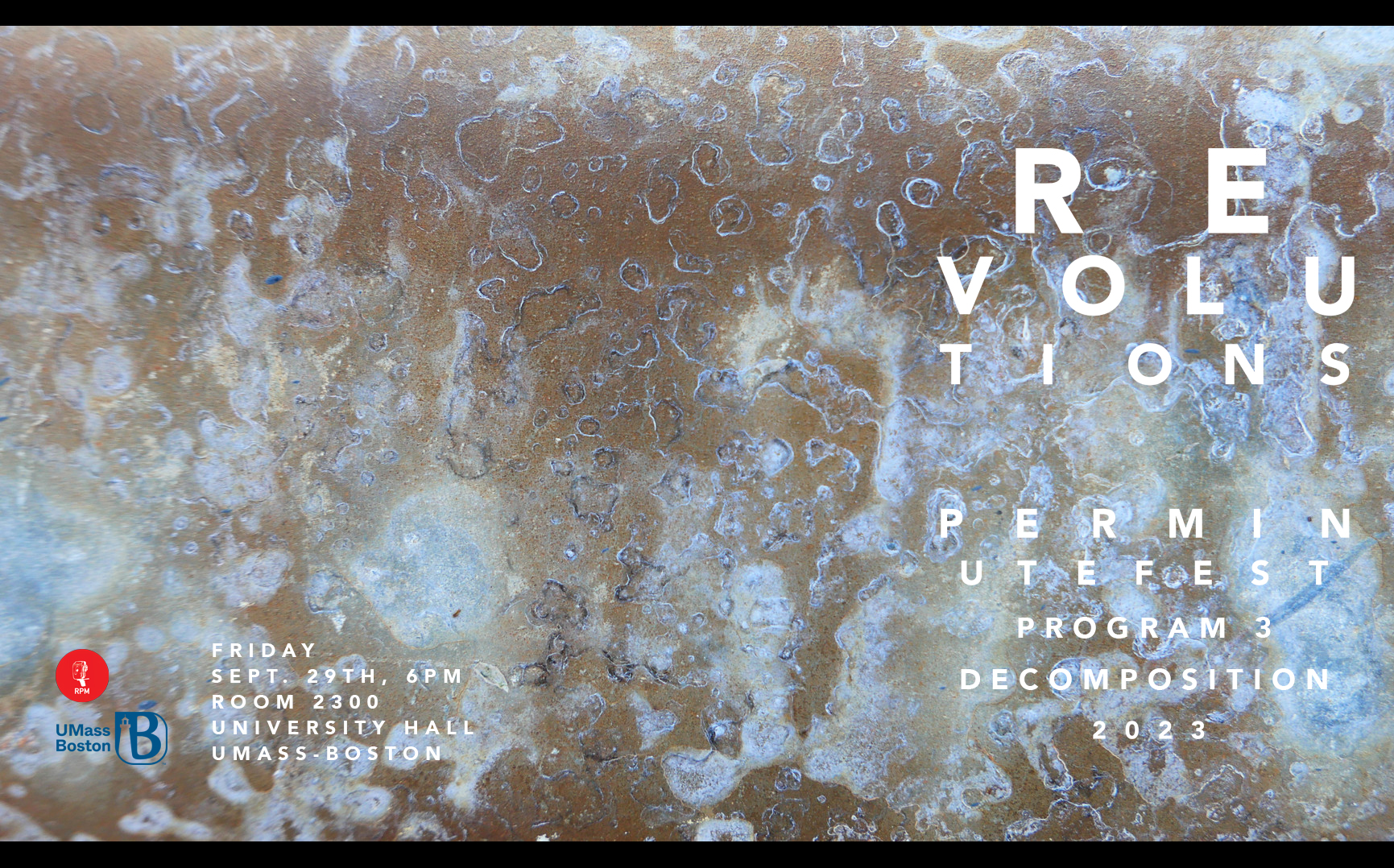
de-composition
Laura Kraning
2mins40secs, USA, 2023, color, sound , HD
A textural macro collage of a rust belt landscape- scratched, splattered, dripping, cracking, and bursting to the surface. Photographed and meticulously edited over one year in Buffalo, NY, the reverberant tones of the New York Central rail line provide the rhythmic pulse to a rapid cascade of multi-hued material decay and metallic de-composition.
Laura Kraning’s moving image work navigates landscape as a repository for memory, cultural mythology, and the technological sublime. Exploring absence and the fluidity of time, she evokes liminal spaces of neither past, nor present, but a landscape of the imagination. Laura’s work has screened widely at international film festivals, such as New York, Rotterdam, London, Edinburgh, San Francisco, Ann Arbor, Antimatter, Visions du Réel, and Festival du Nouveau Cinema, among others. She is a recipient of the Princess Grace Foundation John H. Johnson Film Award, the Leon Speakers Award and Jury Awards at the Ann Arbor Film Festival, the Film House Award at the Athens International Film and Video Festival and the Jury Award for Short Film at Rencontres Internationales Sciences et Cinémas.
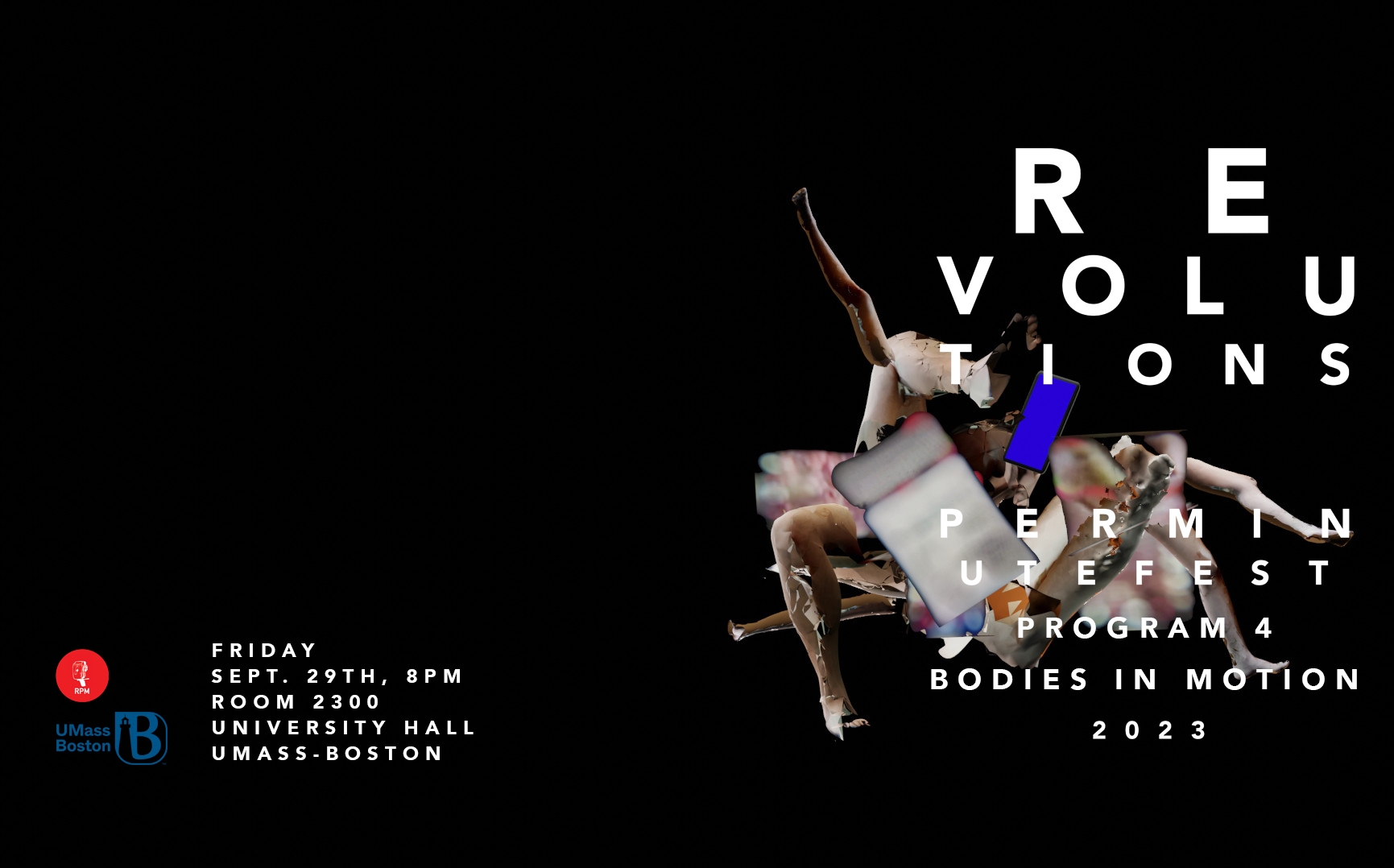
Friday
Sept. 29th, 8PM
University Hall 2300
University Hall
UMass-Boston (JFK/UMass)
University Drive North
Boston (Dorchester)
MA 02125

Three Approaches
Ethan Osman
4mins48secs, 2022, USA, Color, sound, digital
Virtual Spectres
Sarah Boo
5mins12secs, 2022, Canada, color, sound, HD
Busy
Jan Otto Ertesvåg
6mins52secs, 2021, Norway, color, sound, HD
Two Boys and a Dream
Casey Carter
20mins45secs, 2023, USA, Color, Sound, HD&16mm to HD
Three Pride Flags
Tom Bessoir
2mins, 2022, USA, color, sound, digital
The Only Photograph of Emily Dickinson, American Poet
Dennis Tupicoff
7mins43secs, Australia, 2023, color, sound , digital
Site of Passage
Lucy Kerr
7mins, 2023, USA, color, sound, 16mm to HD
Endearing Insanity
Poyen Wang
8mins36secs, 2022, USA, Color, sound, digital
Bodies #1: Milwaukee Waters
Michelle Trujillo
5mins5secs, USA, 2022, B/W , sound , 16mm to HD
total: 68 mins
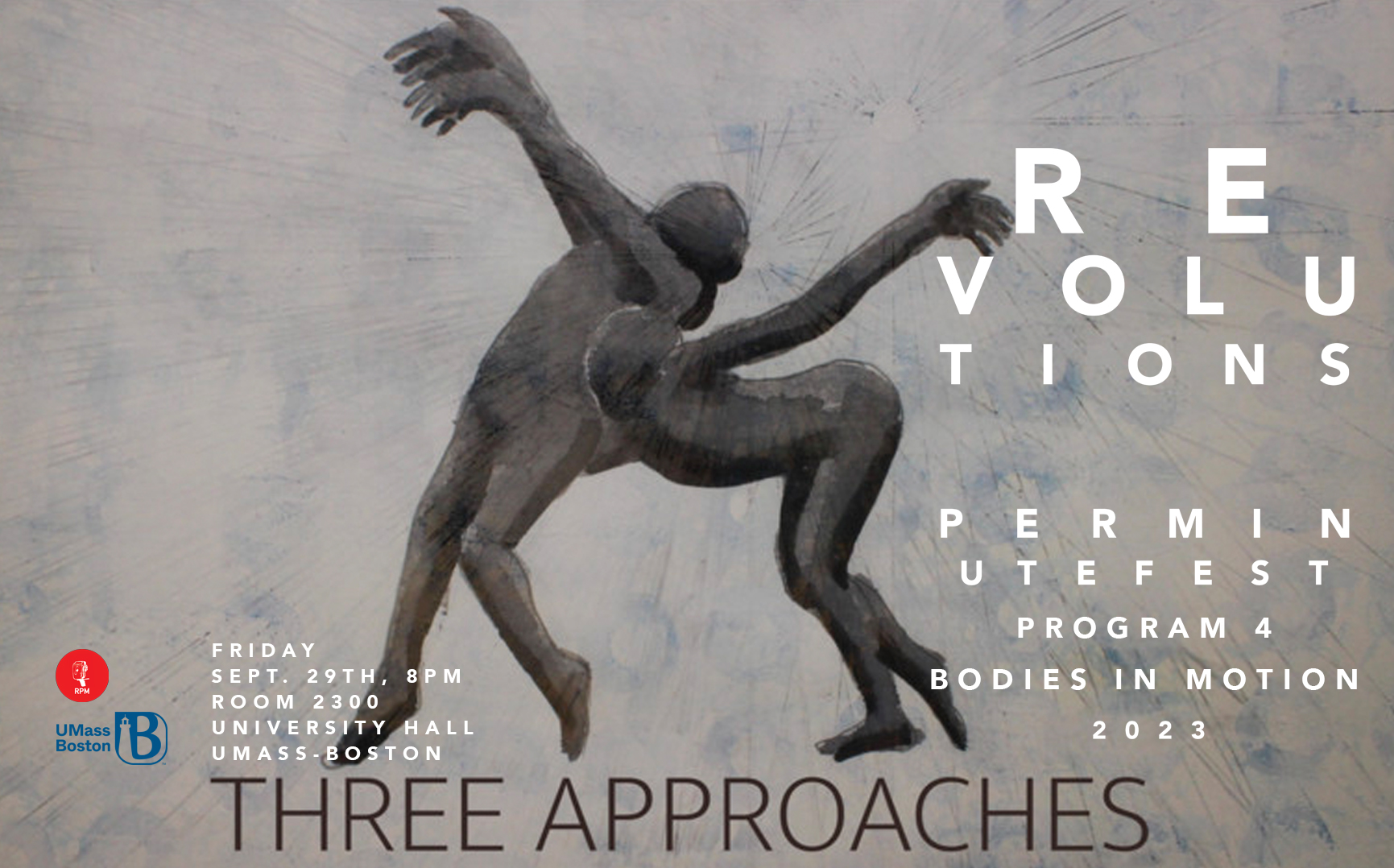
Three Approaches
Ethan Osman
4mins48secs, 2022, USA, Color, sound, digital
Three Approaches is collection of three animated dance performances by Ethan Osman, with sound by Carrie Neumayer. Each piece explores a different process or approach. Ethan uses the human form to explore movement without visual references or dance experience, embodying the 'dancers' to somatically explore the possibilities of movement, one frame at a time. While working on the first approach, Ethan met musician and visual artist, Carrie, who shared love for process oriented artwork and ‘chance’ operation, particularly the collaborations between John Cage and Merce Cunningham. Ethan and Carrie's collaboration began with the mantra, “whatever you make will be perfect.” This climate of safety also formed an intentional practice of allowing the other person to become the ‘chance’ element in each other’s process. For the second approach, Carrie made the music first for Ethan to ‘dance’ to. For the third approach, Carrie and Ethan developed a time code adapted from a text message conversation to compose/choreograph to.
"I make handmade animated films and studies. By intuitively following each film's process without preliminary sketches or editing out mistakes, the films serve as a document of their own process. Ideas, mood, and focus shift each time I enter the studio. These subtleties are evident when each image is sequenced at 12 frames per second, and months of work can be condensed into moments. Similar to AI generated art, my work starts with following a process (algorithm) that often uses prompts, but the work holds all its meaning in being made by hand with life wrapped up in its process." -- Ethan Osman
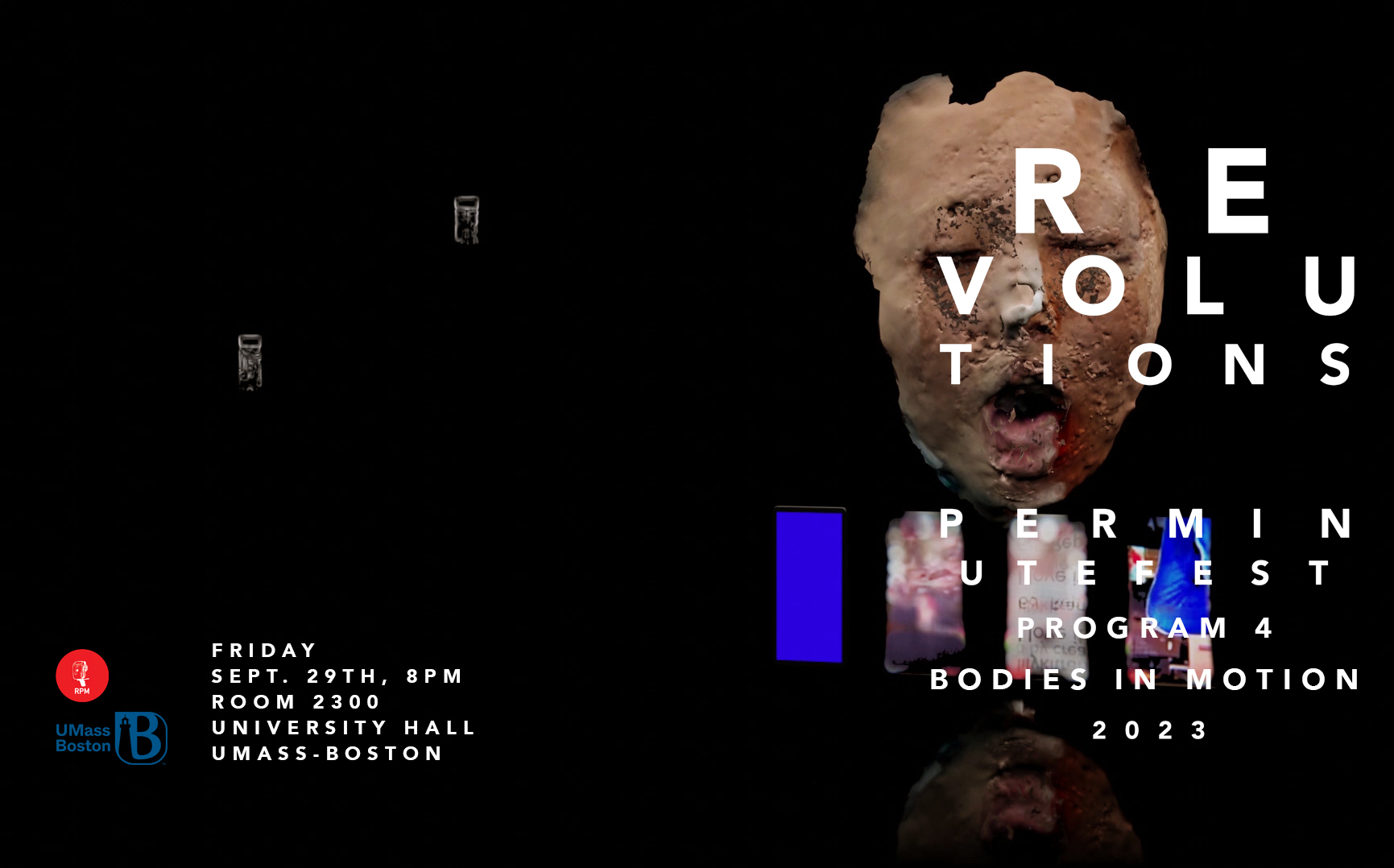
Virtual Spectres
Sarah Boo
5mins12secs, 2022, Canada, color, sound, HD
Virtual Spectres combines scrolling social media feeds with incomplete body scans, situating them together in 3D space. Moving patterns emerge when layers of TikTok footage are superpositioned and the silhouettes of their creators briefly occupy the same time and space, being swiped together and then away. The video ruminates on our existence as cyborgs in a state of the in-between and everywhere. How does it feel to have body-consciousness that is stretched between macro spaces and virtual spaces, duplicated between flesh organs and corporately owned data centers across the world?
Sarah is a Toronto-based multimedia artist who spent her formative years immersed in virtual worlds of various shapes and sizes. Her internet and video works aim to make sense of her experiences of memory, space, and time in a techno-capitalist society. Recently, she has spent much of her time thinking about online sound environments and their ability to foster digital intimacy. She is currently in the Digital Futures program at OCAD University.
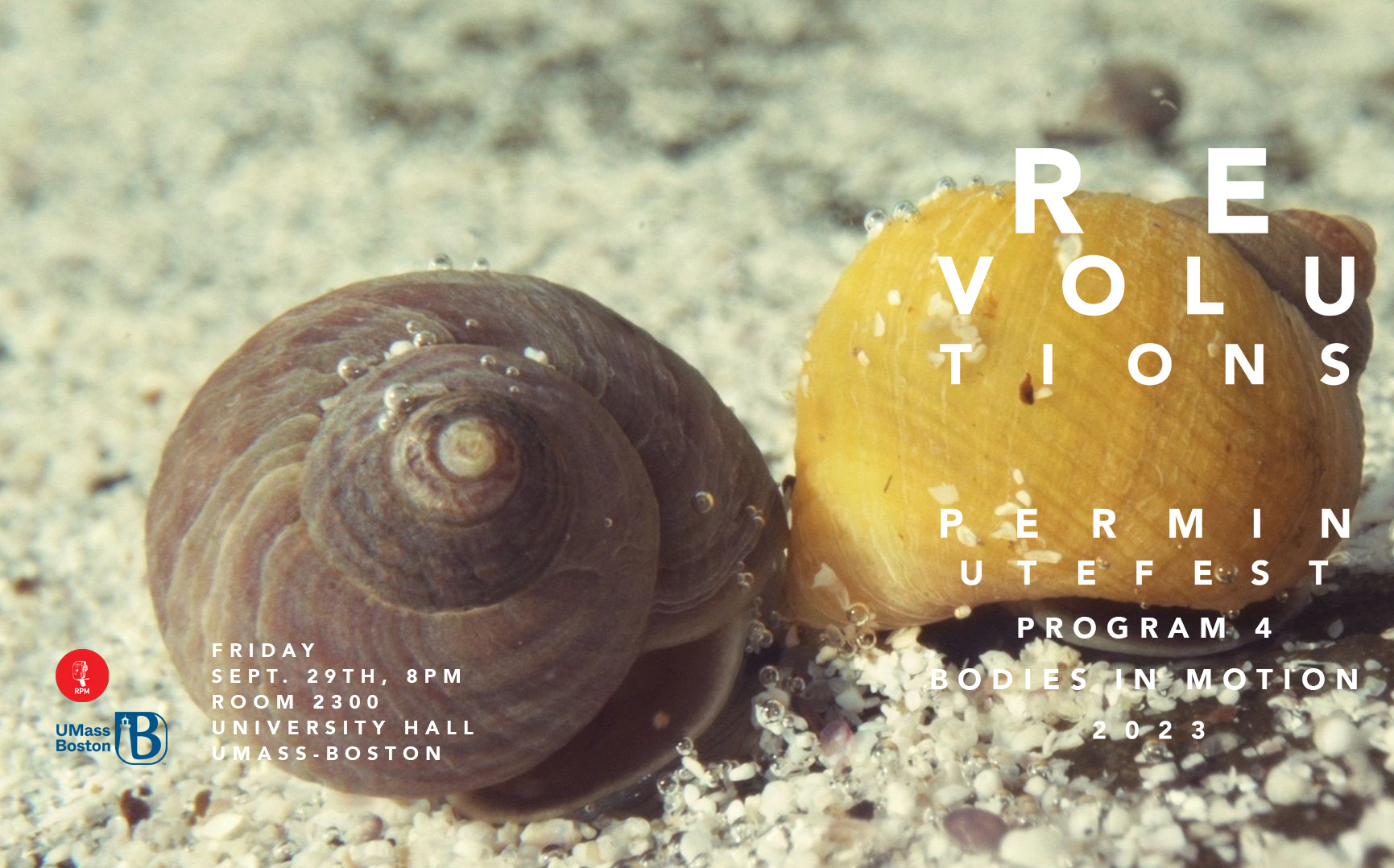
Busy
Jan Otto Ertesvåg
6mins52secs, 2021, Norway, color, sound, HD
The reality of beach snails is not that much different from human lives, filled with an intricate interplay of social interaction and solitude, curiosity about the world and its rigid rules, fleetingness of life and the resilience to go on.
Jan Otto Ertesvåg (Norway, 1969) holds an MA in Animation from the Royal College of Art in London (1997). His films have been screened and awarded worldwide. After 12 years of animating and directing in a variety of animation styles in Oslo, he is now based in Aalesund on the northwest coast of Norway where he continues developing and producing his own abstract stories. He now makes both animated and live action films outdoors in the scenery. Over the recent years he has made a trilogy "from the shore", directing awareness towards lifeforms and civilization.
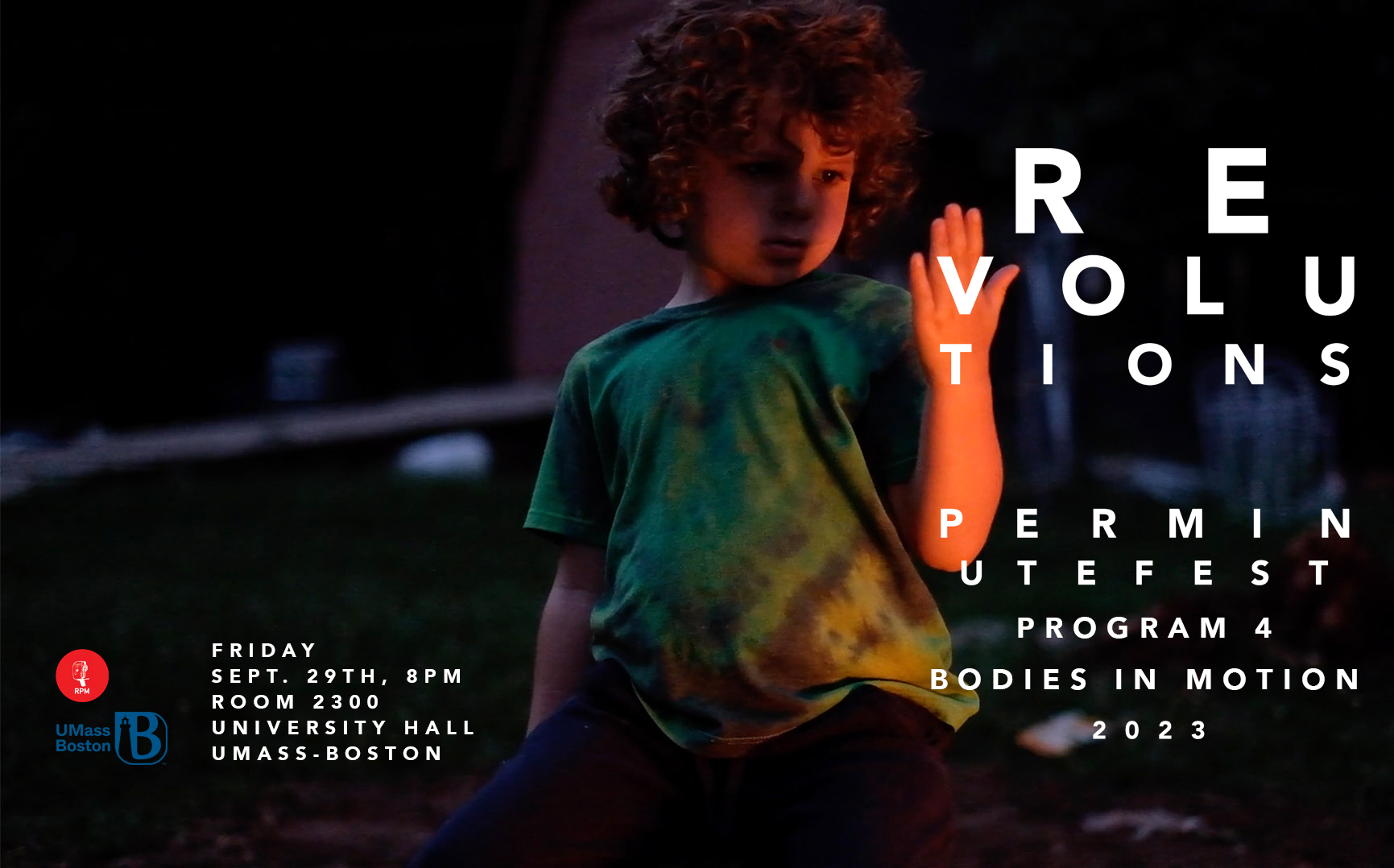
Two Boys and a Dream
Casey Carter
20mins45secs, 2023, USA, Color, Sound, HD&16mm to HD
Two young boys on a small farm explore the woods, tell stories about monsters on the moon, and recount their scariest dreams, while their father and mother take care of the garden and chickens, reflecting on their own fears and convictions. Recorded on HD, mini-dv, and super-8 cameras, the imagery slips formats as the film follows a dreamlike structure that morphs from an observational portrait to a psychological family diary - meditating on the tensions between familial intimacy, sentimentality, fear, and vulnerability. The mini-dv and super-8 formats invoke generations of home-movie making, collapsed into a portrait detached in time. A curious intimacy suggests the filmmaker may be part of the family too.
CASEY CARTER is a filmmaker and interdisciplinary designer and researcher whose work engages nonfiction storytelling in film, photography, data visualization, and cartography. His photographs have been published and exhibited in the U.S., Ecuador, and China. He was a 2017-2018 UnionDocs Collaborative Studio Fellow. He holds bachelors degrees in both physics and photography from Middle Tennessee State University and a Master of Architecture from the University of Michigan.
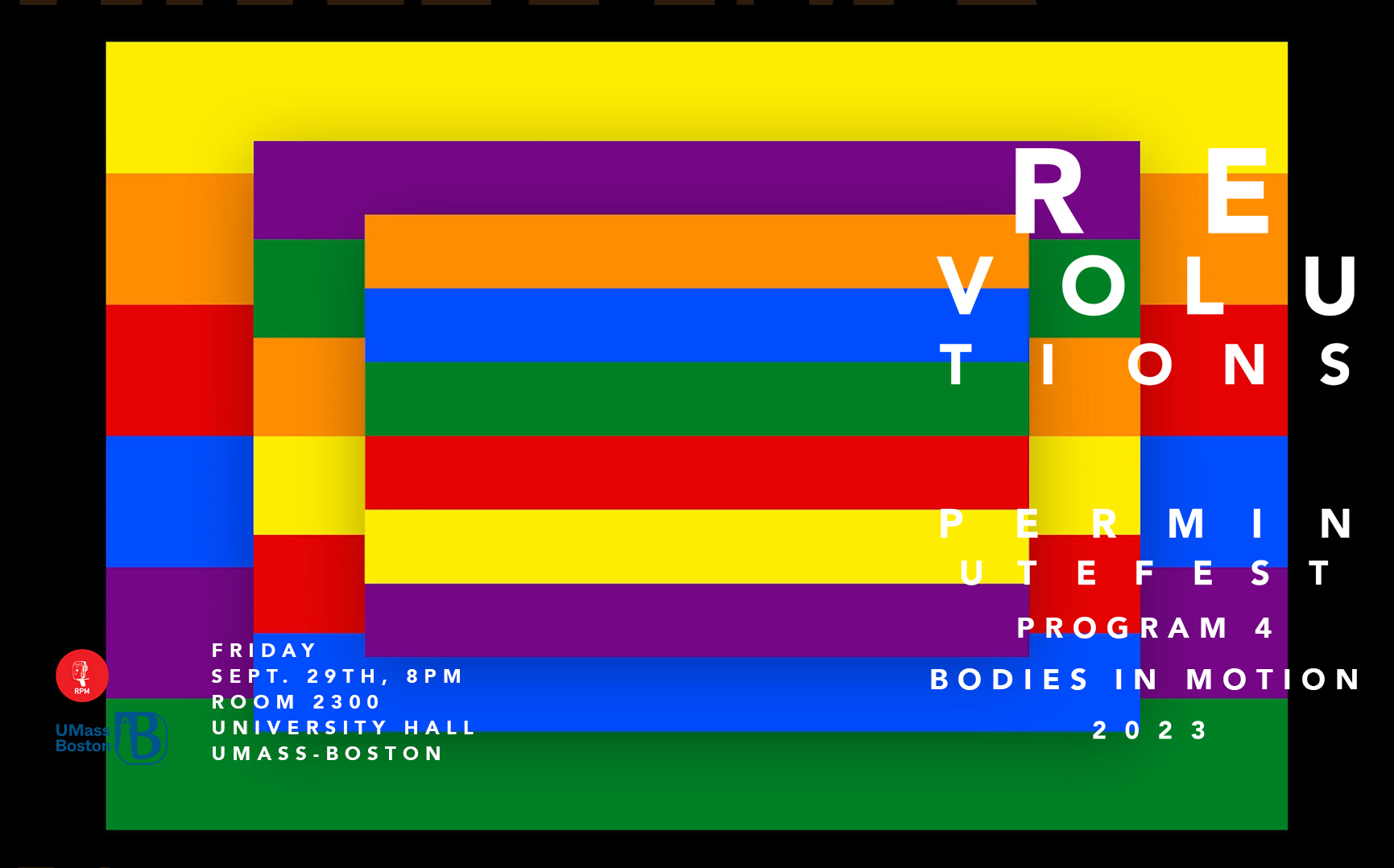
Three Pride Flags
Tom Bessoir
2mins, 2022, USA, color, sound, digital
Inspired by the joint Jasper Johns retrospective exhibitions at The Whitney Museum of American Art and The Philadelphia Museum of Art, I created three permutating pride flags.
Tom Bessoir’s experimental films often use mathematics and randomness to explore perception and the structure of cinema.
Tom was born and raised in the Astoria section of Queens in New York City in 1957. From there he commuted by subway to attended The Bronx High School of Science. Tom studied mathematics and electrical engineering at The Cooper Union for the Advancement of Science and Art. While attending the Engineering School, he took advantage of Art School classes, focusing on film theory and studying experimental filmmaking with Robert Breer. In the late 1970s, he started photographing the downtown music scene. His photographs have appeared on dozens of records as well as in films, books, magazines, and newspapers.
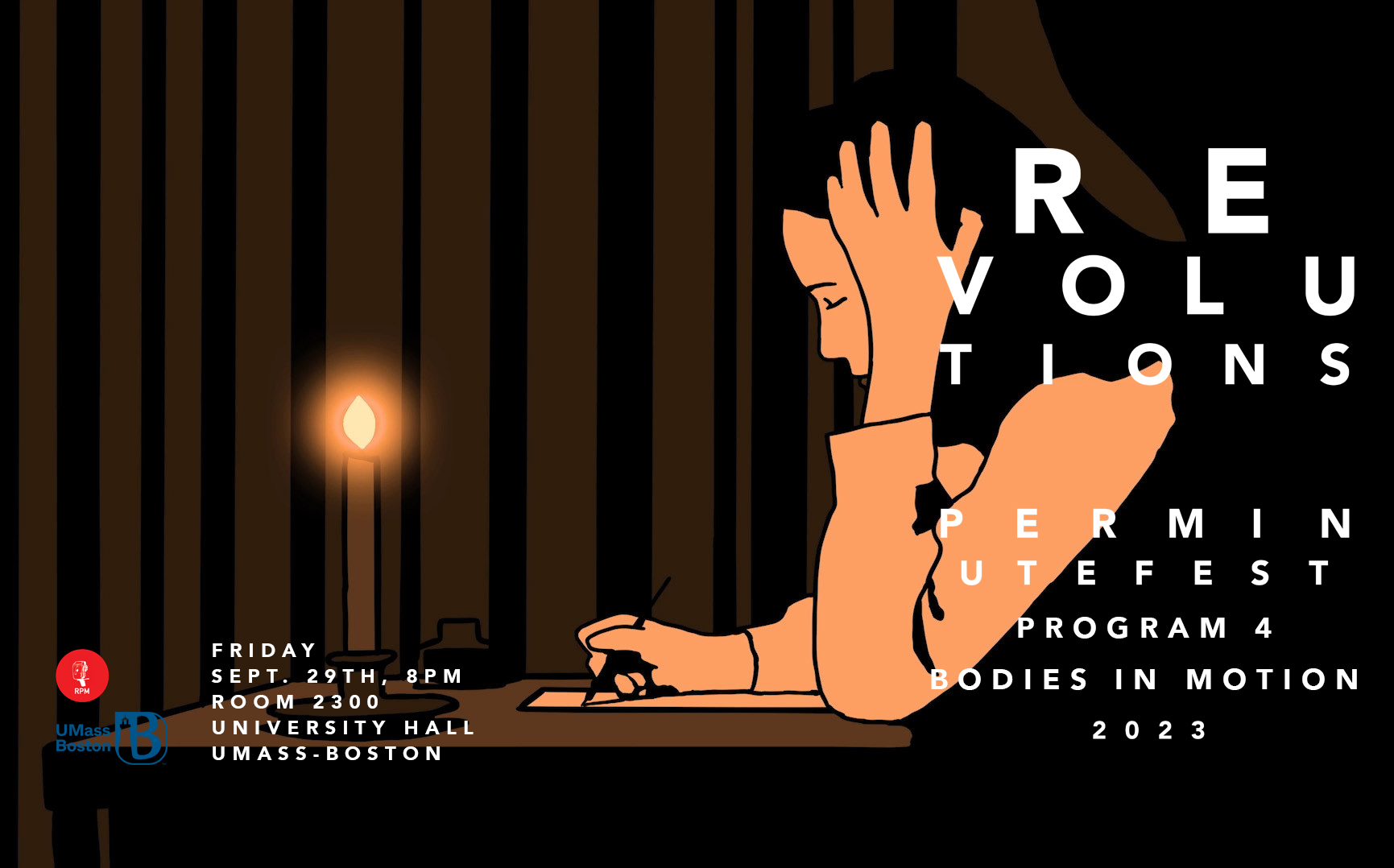
The Only Photograph of Emily Dickinson, American Poet
Dennis Tupicoff
7mins43secs, Australia, 2023, color, sound, digital
As the "slant of light" comes and goes in a Massachusetts studio c1850, Emily summons up an English poet from an earlier age. Her playful vision of love and life ends in the unique photograph of Dickinson that survives today.
Dennis has made many award-winning films as writer, director, producer, and animator: fiction and documentary, animated and live-action, comedy and drama – and often inventive combinations. He has also been a full-time lecturer at the VCA School of Film and Television in Melbourne, and has taught and conducted workshops in Europe, North America, Asia and Australia.

Site of Passage
Lucy Kerr
7mins, 2023, USA, color, sound, 16mm to HD
In a mysterious room shrouded in darkness, six young women, through the possibilities of their imaginations, conjure a series of ritual games. By the end of their playful rite, the interwoven bodies, levitating, appear to become one.
Lucy Kerr (b. Houston, Texas 1990) is a filmmaker, artist, choreographer, and educator. Her work is rooted in questions of image-making and performance and how both of these are tied up with ritual and transformation. Kerr received and MFA in Film/Video and Art from California Institute of the Arts in 2020. In 2022, she was named one of the 25 New Faces of Independent Film in Filmmaker Magazine. Her debut feature film, Family Portrait, premiered at the Locarno Film Festival in 2023 and garnered her the Locarno Boccalino d'Oro for Best Director, the feature film grant from Austin Film Society and the AirFrance Prize from FIDLab, and the New Horizons Award from US in Progress at the American Film Festival in Wroclaw, Poland. Her short film, Crashing Waves, is in the permanent collection of Frac Provence-Alpes-Côte d'Azur in Marseille, France. Kerr’s projects have been presented by International Film Festival Rotterdam, FIDMarseille, San Sebastian International Film Festival, Reykjavik International Film Festival, The San Francisco Museum of Modern Art, REDCAT, Anthology Film Archives, Francois Ghebaly Gallery, The McEvoy Foundation for the Arts, and others.
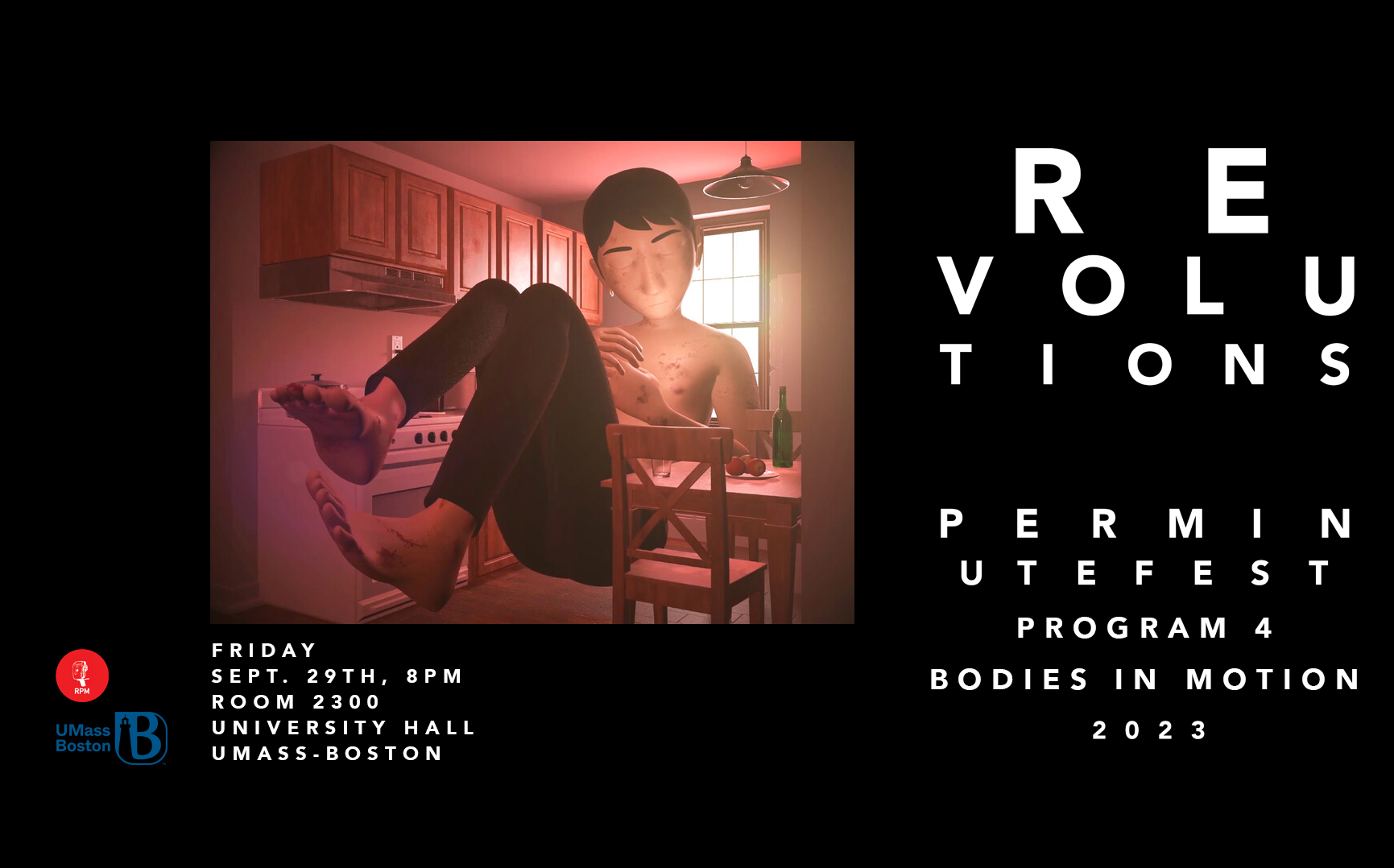
Endearing Insanity
Poyen Wang
8mins36secs, 2022, USA, Color, sound, digital
Employing the genres of horror and erotica, Endearing Insanity navigates the threshold where sensuality and terror meet. Staged within a small apartment kitchen, the seemingly ragged protagonist constrained in various enclosed spaces such as a cabinet, microwave, and sink, performs a monologue waiting for someone to visit. By utilizing the sensual as a tool, the protagonist calls the viewer to enter their intimate realm, gaining agency in a displaced environment. Hovering between the sincere and the absurd, the seductive and the repellant, Endearing Insanity reflects the longing for connection and the desire for visibility.
Poyen Wang is an artist and filmmaker, born and raised in Taiwan and currently based in New York City. Informed by his queer and immigrant experience, his recent work employs the languages of performance art and cinema, and uses 3D computer graphics to create still and moving images, grappling with issues of identity, sexuality and masculinity through a psychological lens.
He has had solo exhibitions at Essex Flowers, New York; Taipei Digital Art Center, Taiwan; 18th Street Arts Center, Los Angeles; Flux Factory, New York; and the National Taiwan Museum of Fine Arts. He teaches full-time at the Hunter College Department of Film and Media Studies.

Bodies #1: Milwaukee Waters
Michelle Trujillo
5mins5secs, USA, 2022, B/W , sound , 16mm to HD
Bodies 1: Milwaukee Waters is the first installation in a series shot on 16mm film that explores the magic and life of public bodies of water. Images for this film were collected from the Milwaukee River, a community pond and the shoreline of Lake Michigan (Milwaukee Bay area).
Throughout the 1800s, the Milwaukee River was used to carry sewage into Lake Michigan. The many tanneries, breweries and other industries lining the water, poured their waste into the river without any water treatment. Much work has gone into cleaning the water in the past decades and into removing dams, and flow barriers to increase fish passage. Much progress has been made and the water is much cleaner and safer than it used to be. However, the Milwaukee River Basin is still considered an area of concern (AOC). The main concern is the contaminants in the riverbed sediment such as PCBs, PAHs and heavy metals. My film focuses on the beauty found and restored within this area. My acknowledgement of this dirty past and work to be done stands in the recurring smoke stacks found within the film.
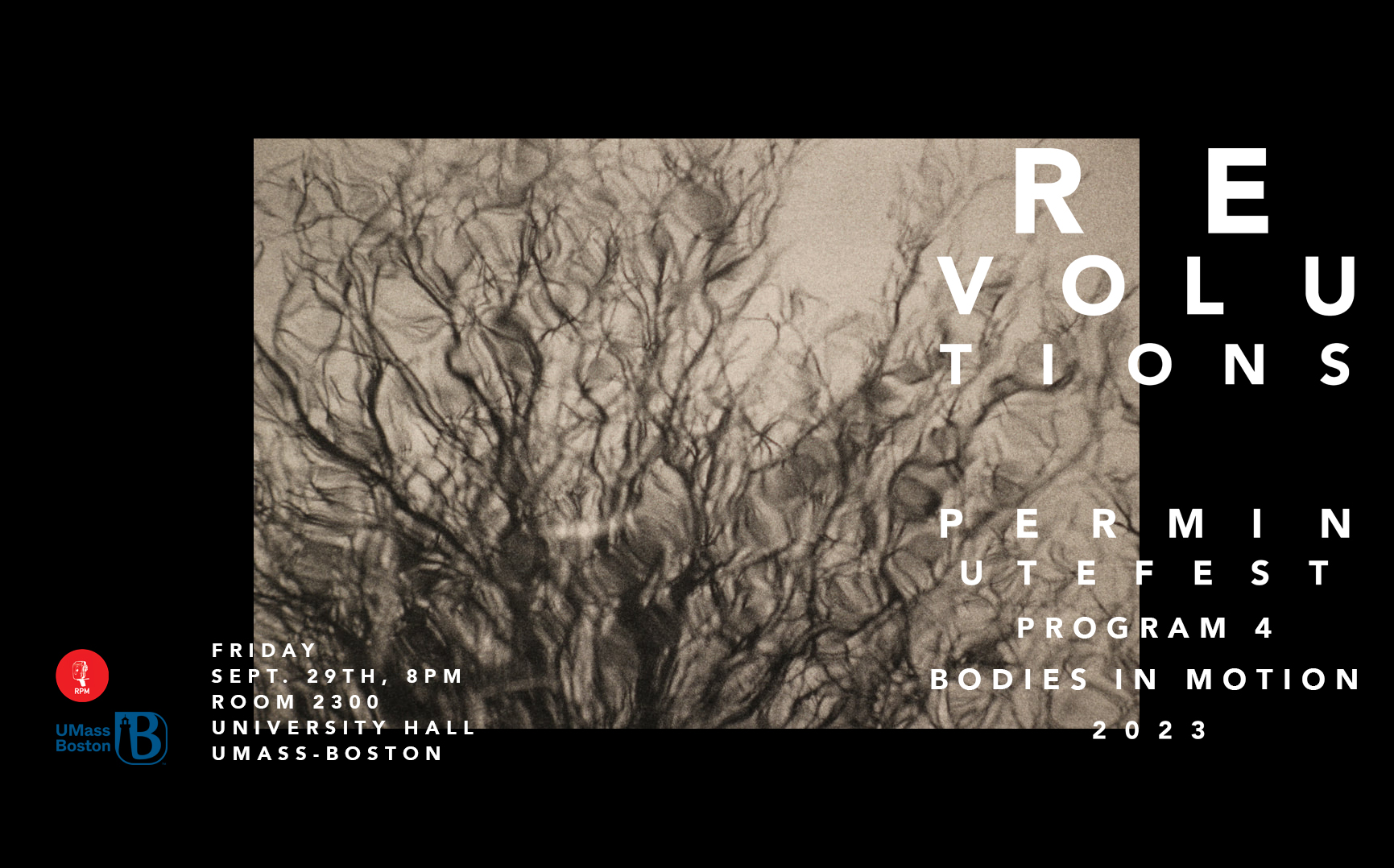
Michelle Trujillo received her BA in Multimedia Studies from Florida Atlantic University and her MFA in Film from the University of Wisconsin-Milwaukee. She is currently working and living in Boston, MA where she is a Visiting Assistant Professor in Film and Video at MassArt.
The focus of her practice is to question and explore representations of Latinx culture, gender and identity creation. Her work stems from an intersectional feminist perspective but does not always offer solutions to the problems it engages with. Instead, she is concerned with upsetting power structures and notions of normality through disorientation. She works in Spanish, English and Spanglish as a mirroring of her lived experience. She also works in various mediums such as eco and hand-processed 16mm film, digital video, 35mm still film and cyanotypes.
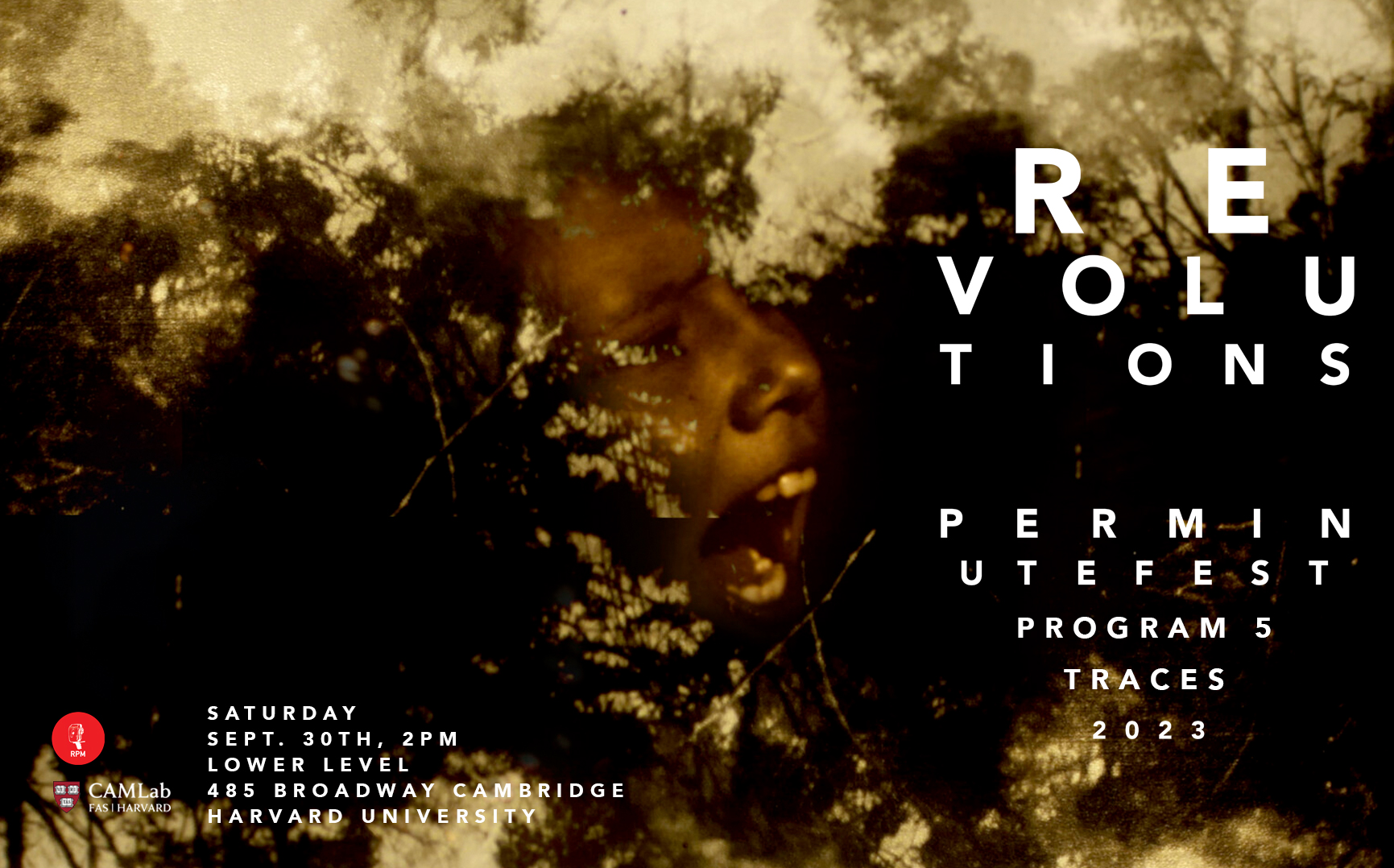
Saturday
Sept. 30th, 2PM
Harvard FAS CAMLab
Lower Level
485 Broadway Cambridge
MA 02138
Harvard University

Dehumanized
Louis Brückner
47secs, 2021, Germany, Color, sound, digital
Here where everything ends
Cláudia CÁRDENAS & JUCE FILHO
19mins, 2023, Brazil, color, sound, 16mm to HD
This World
George Ferrandi
6mins, 2022, USA, color, sound, HD
Ashes of Roses
Sasha Waters
11mins30secs, 2023, USA, Color, Sound, HD&16mm to HD
Bye Bye Now
Louise Bourque
8mins27, 2022, Canada, color, sound, 16mm to HD
Living Lessons in the Museum of Order
Malic Amalya
20mins, USA, 2022, color, sound , 16mm to HD
My beloved, grey-haired
Anastasiia Kirii
1mins17secs, 2023, Ukraine, color, sound, digital
Tlaloc (Lines Drawn in Water)
Abinadi Meza
8mins38secs, 2023, USA, Color, sound, 16mm
total: 72 mins
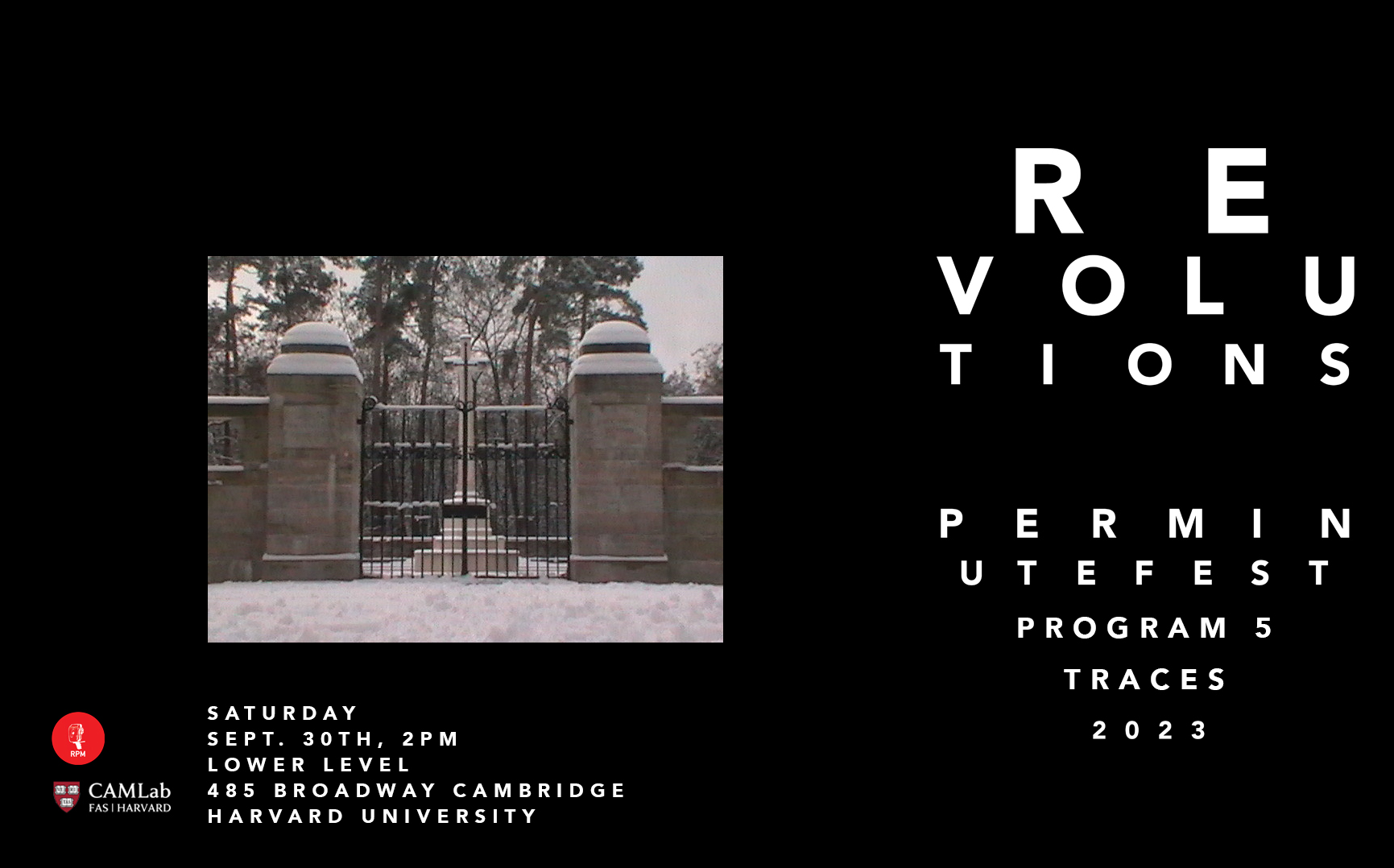
Dehumanized
Louis Brückner
47secs, 2021, Germany, Color, sound, digital
"Dehumanized" is an experimental short film, in which the peace of the dead in a military cemetery is disturbed with loud war noises. The camera itself becomes a weapon.
"The truth of war in a nutshell. Without words, but everything is said."
Holger Janke, Pastor
Louis Brückner has been making films since 2013, starting in high school. Afterwards, he completed an apprenticeship as a Technical Design Assistant. During the traininghe developed his obsession with experimental and animated films. Since 2020 he is studying "Film & Sound" at the FH Dortmund.
My vision is to break new ground with passion and experimentation. - Louis Brückner
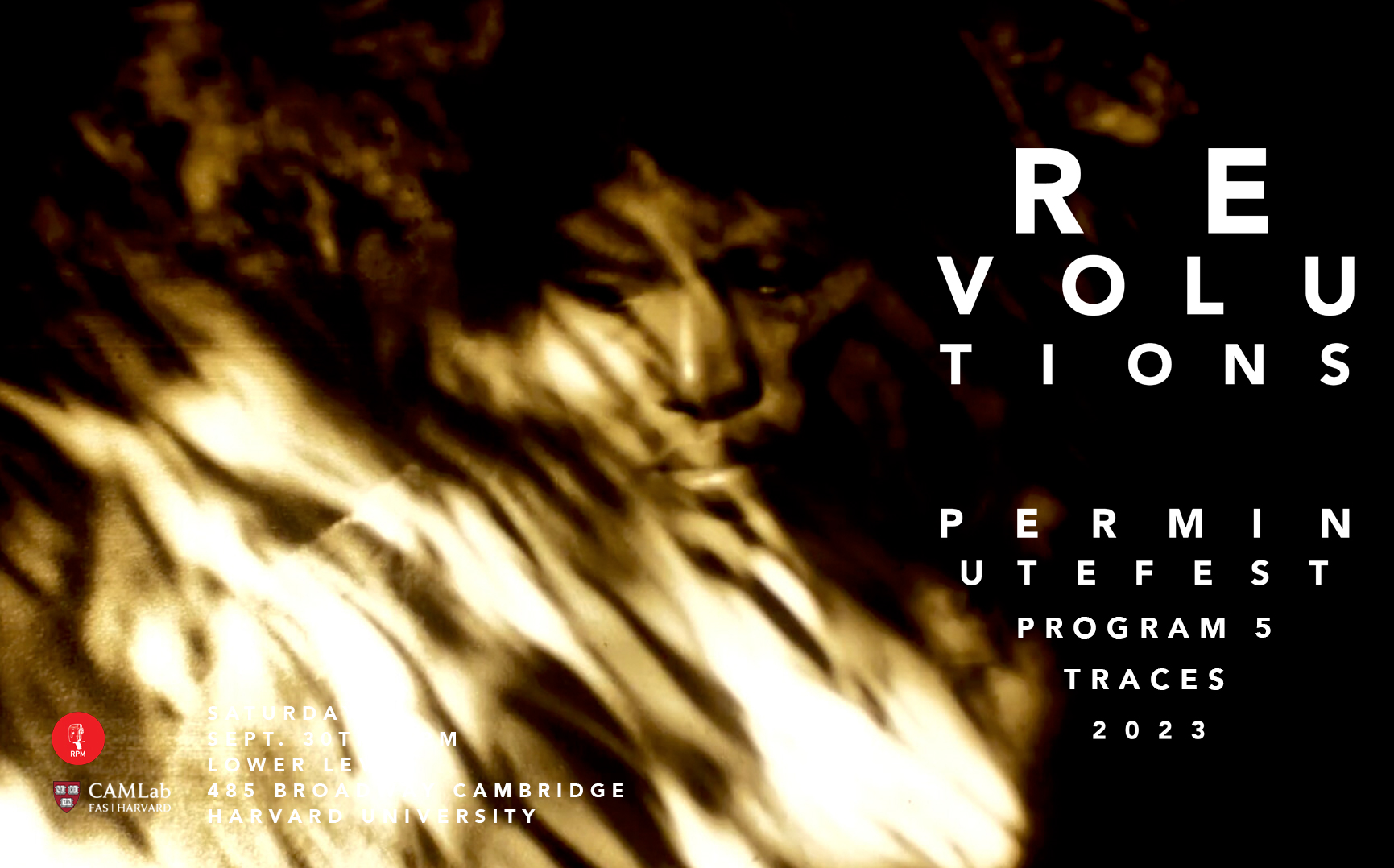
Here where everything ends
Cláudia CÁRDENAS & JUCE FILHO
19mins, 2023, Brazil, color, sound, 16mm to HD
Here where everything ends is a poetic and experimental short-film, that travels in between documentary and fiction to approach a culture faced with extinction: the indegeonous peoples of Brazil. It is particularly about the sharing of knowledge of the Bugio village, and made in a collective way in every stage of 16mm footage, botanical revelation and sound caption.
It tries to reactivate the memories of the origins of the Laklãnõ/Xokleng people, while observing what is lost with the alienation of their knowledge and culture practiced by colonialism.
Cláudia Cárdenas (Rio de Janeiro, 1961) is an experimental audiovisual artist.
Cláudia develops research work in video, film and experimental audio, as well as in the creation of experimental audiovisual works at Duo Strangloscope. She is also the creator and curator of Strangloscope – International Conference on Audio, Video / Film and Experimental Performance, which this year was in its 14th edition. Cláudia and Rafael, as Duo Strangloscope, started to carry out workshops and tutorials in experimental residencies in video both in Brazil and abroad for festivals around the world. They research has currently focused on experimental works with video art, expanded cinema and installation performances of different natures and in different supports.
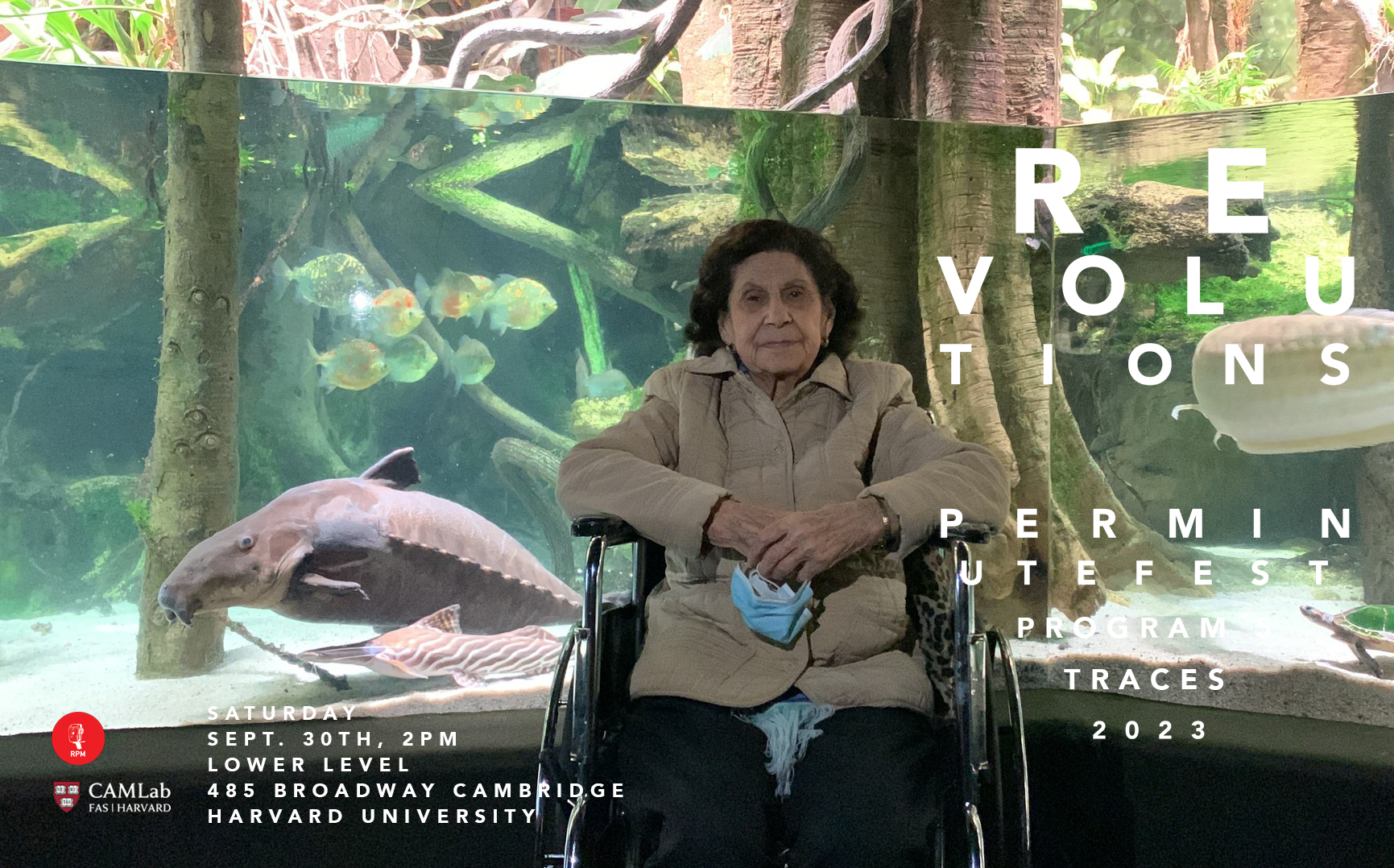
This World
George Ferrandi
6mins, 2022, USA, color, sound, HD
During a visit to the National Aquarium in Baltimore, my 90 year-old mom attempts to repeat after me the lines of Mary Oliver’s “This World,” a poem about the impossibility of writing a poem focusing on something in the world that isn’t special—because as soon as we focus on anything in the natural world, its special-ness becomes evident. My mom’s endearing fumbles in front of starfish and sharks demonstrate—with charming humor and poignancy— another level of truth in the premise of the poem.
George Ferrandi is an American interdisciplinary artist known for her performance, installation and participatory projects that address issues of vulnerability, impermanence, fallibility and spectacle, often through experimental approaches to narrative.
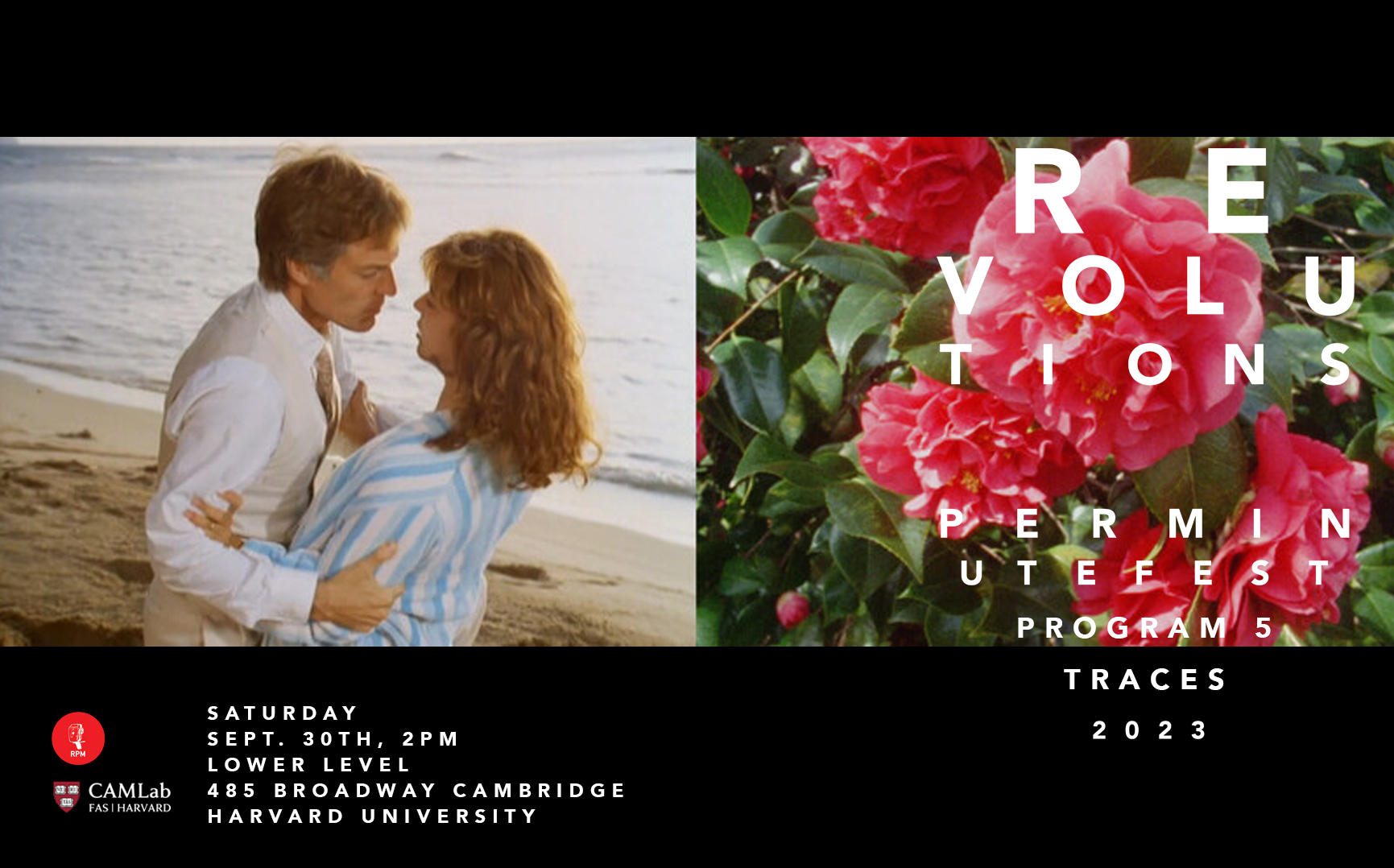
Ashes of Roses
Sasha Waters
11mins30secs, 2023, USA, Color, Sound, HD&16mm to HD
This movie is about loving things that are embarrassing and people who are inappropriate. It's an essay film reflection on popular trash; football parties; older men; adolescent desire and the outrageous yet mundane humiliations of being a teenage girl in the 1980s. With sound design by Kevin T. Allen and performance cameos by filmmakers Roger Beebe and Jason Livingston.
As a moving image artist, I am committed to a feminist cinema of opposition that re-imagines personal and social histories in the spirit of engagement with an earlier age of radical-romantic image making. Using anachronistic strategies of cinematic collage, I stitch together original 16mm footage, found/archival films, images, music and text into lyrical, unsentimental (and hopefully sometimes funny) films that mine the tension between the subjective, lived experiences of women / artists / mothers with our interior lives of fantasy and projection, mourning and dread. —Sasha Waters
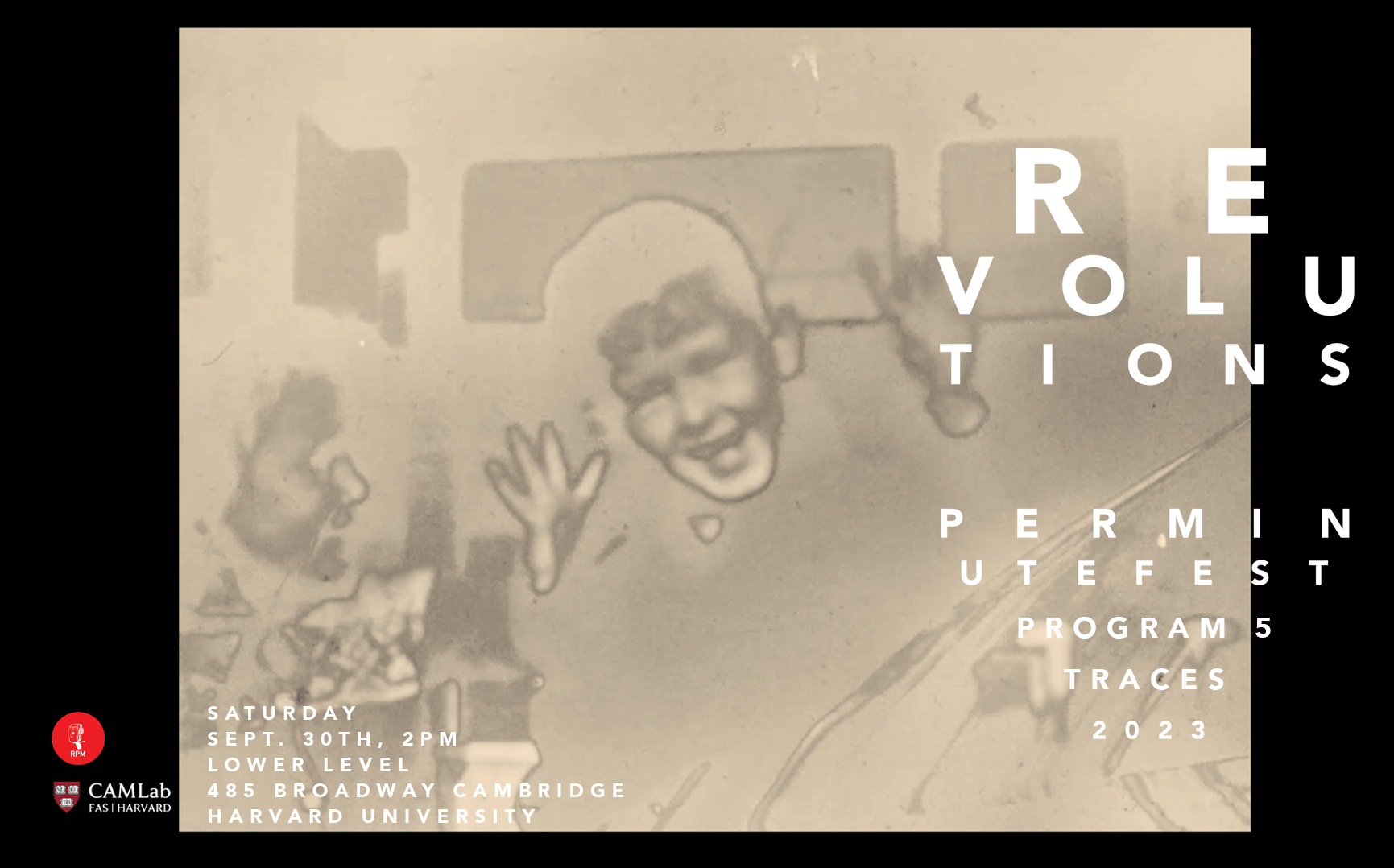
Bye Bye Now
Louise Bourque
8mins27, 2022, Canada, color, sound, 16mm to HD
Waving hello to the filming cameraperson, the subjects through this very gesture, are also providing a future viewer with the acknowledgment of a constant good-bye to a fleeting moment.
Yet when the film is projected and the captured gesture is seen, it's as if the subjects are saying hello again from the past.
This film is an homage to the artist's father, the man behind the camera in these personal family archives.
The filmmaker Louise Bourque recently moved back to Montréal after spending 30 years in the United States and elsewhere. Her films have been screened in more than forty-five countries and broadcast on PBS and the Sundance Channel in the US as well as on Télé-Québec in Canada and SBS in Australia. Her work has been presented by major galleries and museums worldwide, including the Musée de la Civilisation and the Musée national des beaux-arts du Québec in Québec city, the National Gallery of Art in Washington, D.C., the Museum of Modern Art and the Whitney Museum of American Art in NYC.
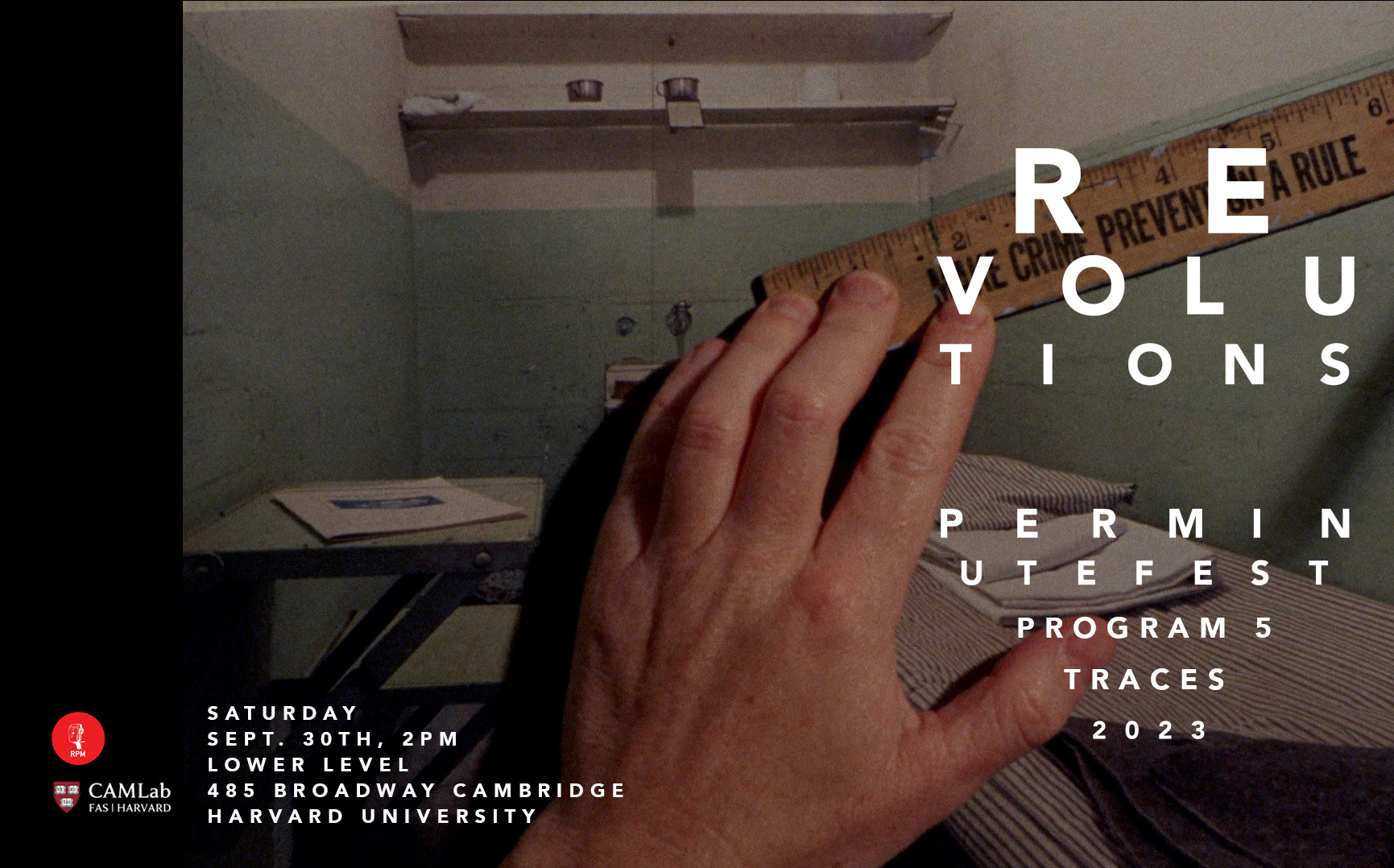
Living Lessons in the Museum of Order
Malic Amalya
20mins, USA, 2022, color, sound , 16mm to HD
Living Lessons in the Museum of Order examines the carceral logics of the Orca Encounter at SeaWorld San Diego and the “Doing Time” tour of the former Alcatraz prison in the San Francisco Bay.
Juxtaposing original 16mm footage, promotional VHS and 16mm footage, and analog video feedback, Living Lessons in the Museum of Order explores the tensions between public fantasies and exploitative practices, as well as between rhetorical and cultural changes, within the two California entertainment empires.
Malic Amalya (b. 1980. Burlington, VT) is an experimental filmmaker living and working in Boston.
Malic is an Assistant Professor of Experimental Media and Film Production at Emerson College. His films have screened widely and are distributed by Canyon Cinema in San Francisco and Collectif Jeune Cinema in Paris.
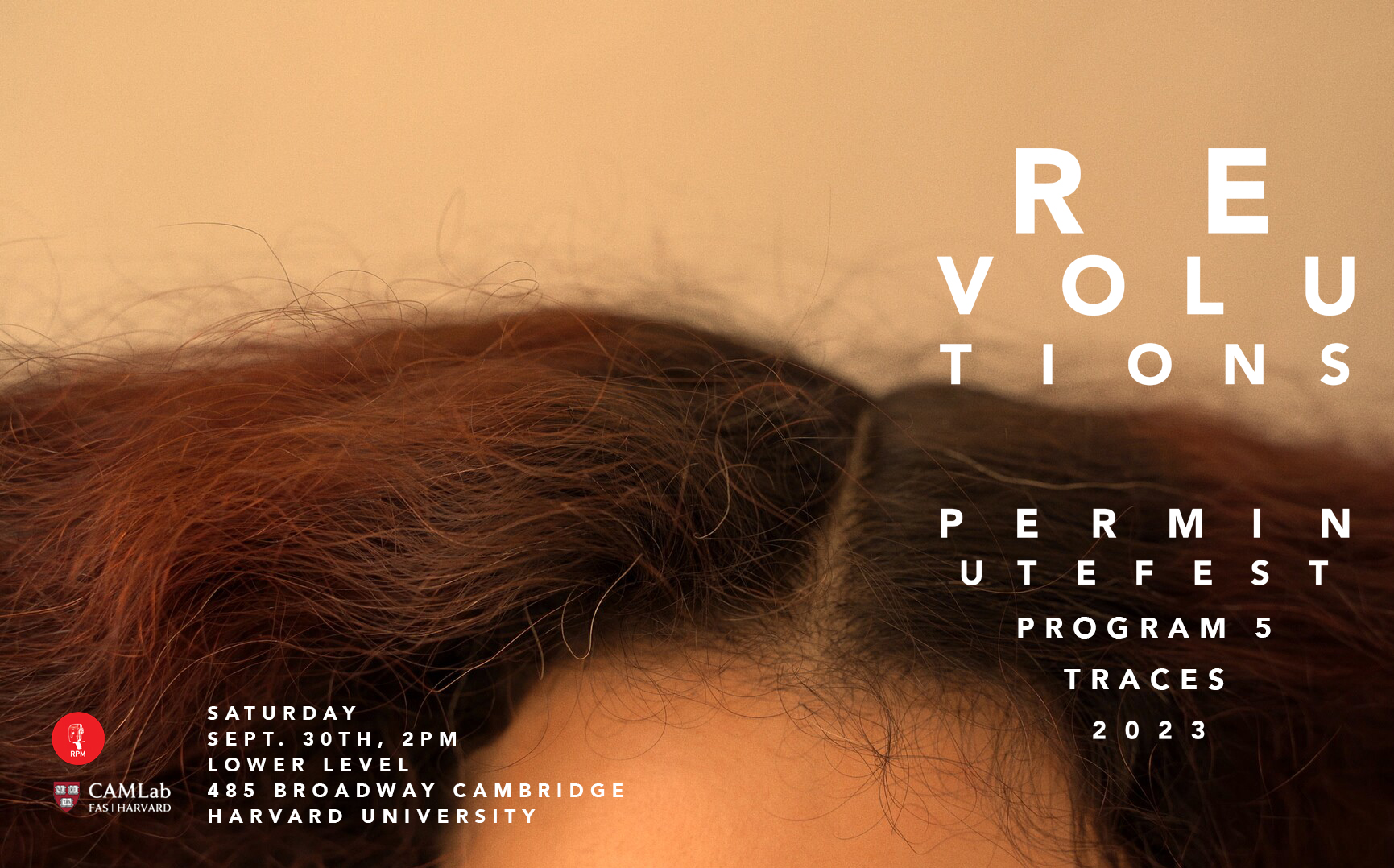
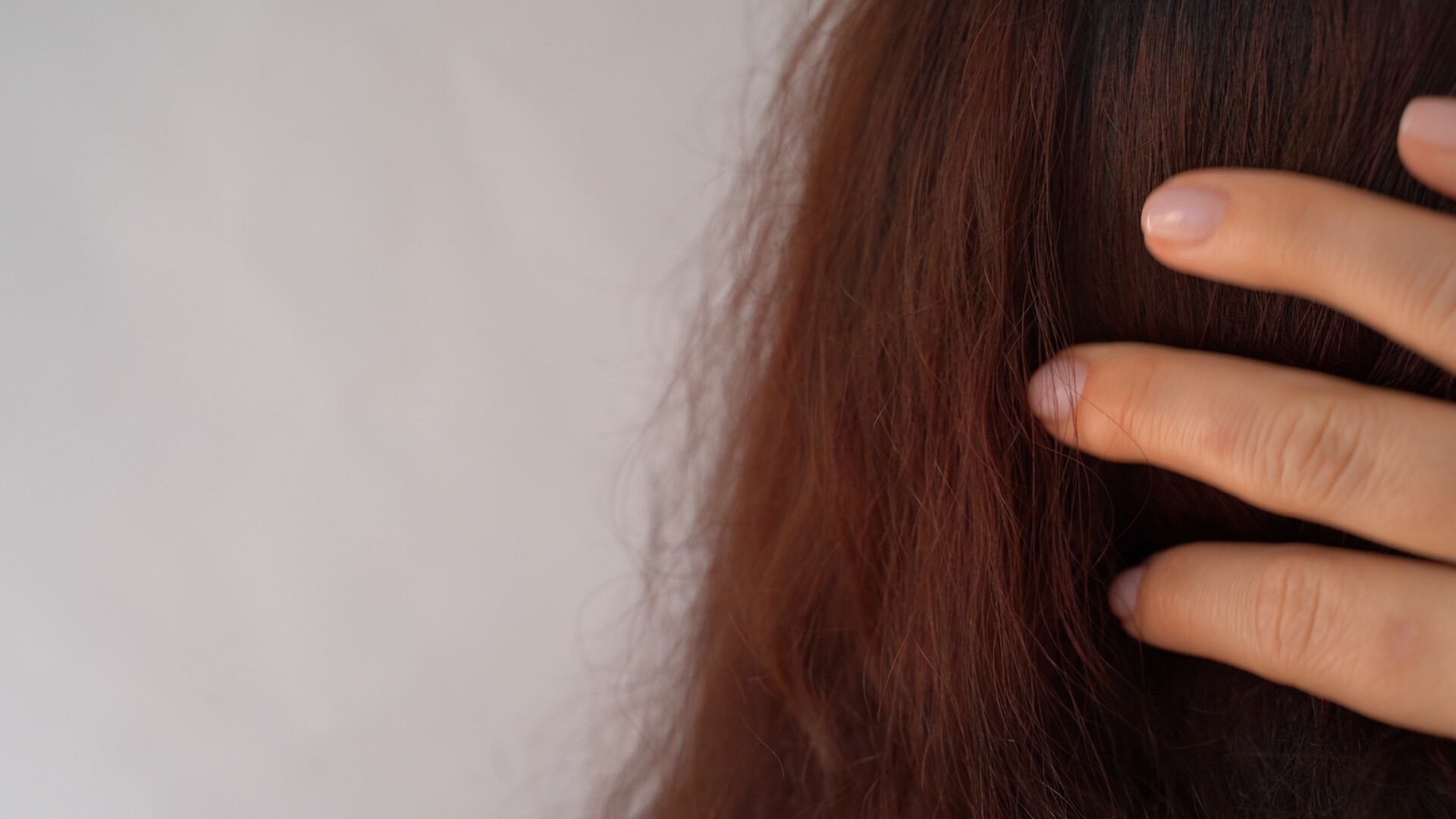
My beloved, grey-haired
Anastasiia Kirii
1mins17secs, 2023, Ukraine, color, sound, digital
When the war started in Ukraine, I moved to Barcelona, got there by 9 trains with my dog Penka. This is the first film I created as a reflection to this experience.
Born and raised in Kyiv, Anastasiia Kirii always loved books and used to play them out in my room, with dialogues and accents.
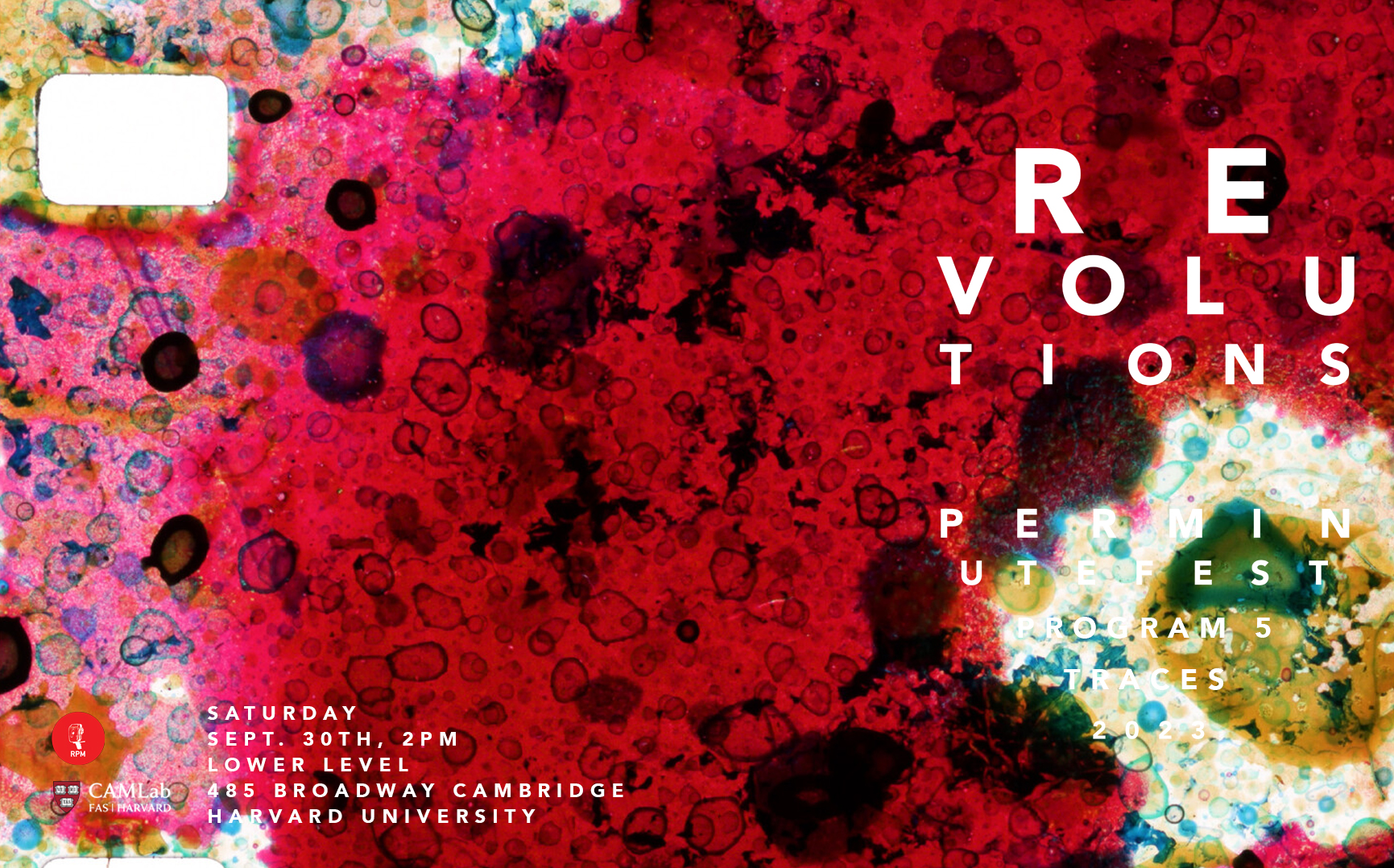
Tlaloc (Lines Drawn in Water)
Abinadi Meza
8mins38secs, 2023, USA, Color, sound, 16mm
Tlaloc (Lines Drawn in Water) is a handmade cameraless 16mm film of materiality and transformation; an enigmatic otherworld where hues of water evolve into prismatic blooms. Tlaloc is the deity of waters, rain, lightning, and growth in the Aztec pantheon. This film explores the membrane of film itself - a moving skin marked by fluid, punctured by light. The protean soundtrack was entirely composed with contact microphones to capture handmade surface markings and gestures. The motion picture was made with direct animation, scratching, hand-painting, and contact-printing techniques.
Abinadi Meza (US/MX) is a Latinx-Indigenous artist who studied creative writing, art and architecture, and whose practice includes experimental film, sound art, and installation. Meza’s films are made with found and original footage, hand-painted film, and original soundtracks.
Meza's award-winning films have been presented at: Anthology Film Archives, New York; Antimatter, Victoria BC; Athens International Film & Video Festival; Atlanta Film Festival; Aurora Picture Show, Houston; Blaffer Art Museum, Houston; Bogotá Experimental Film Festival; Festival de Cine Radical, La Paz; Cosmic Rays, Chapel Hill; Crossroads Festival, San Francisco; Festival ECRÃ, Rio de Janeiro; Esto Es Para Esto, Monterrey; Filmmakers’ Cooperative, New York; Flatpack Festival, Birmingham; Houston Cinema Arts Festival; Irish Museum of Modern Art, Dublin; Istanbul International Experimental Film Festival; Kassel Dokfest, Germany; Mientras Tanto Cine, Montevideo; Minneapolis Institute of Art; non-syntax Festival, Taipei; ULTRAcinema, Tepoztlán; Weisman Art Museum, Minneapolis; and Wexner Center for the Arts, Columbus among other places.
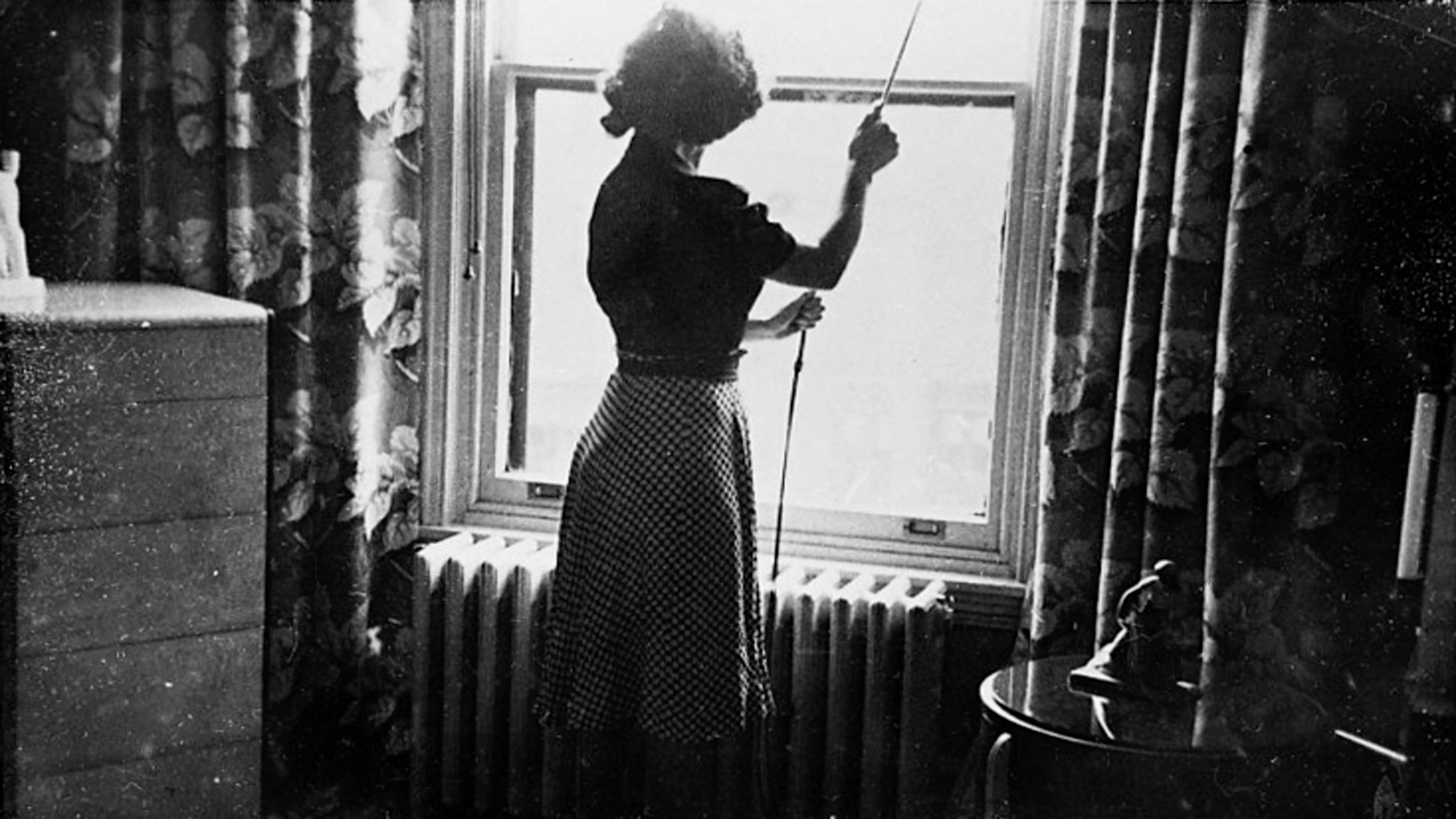
Saturday
Sept. 30th, 4PM
Harvard FAS CAMLab
Lower Level
485 Broadway Cambridge
MA 02138
Harvard University

River
Penny McCann
2mins57secs, 2023, Canada, B/W, sound, 16mm to digital
Bezuna
Saif Alsaegh
7mins30secs, 2023, USA, color, sound, HD
Fleshwork
Lydia Cornett
7mins, 2022, USA, B/W&color, sound, 16mm to HD
Daybook
Alfred Guzzetti
23mins30secs, 2022, USA, Color, Sound, HD
Exquisite Corpse Trilogy
Seokyoung Yang
17mins, 2023, Korea, color, sound, digital, 16mm & Super8 to HD
Fathers' Land
Francesco Di Gioia
11mins24secs, Italy, 2021, B/W, sound , found footage to HD
How to Build a House out of Wreckage and Rags
Bernd Lützeler
8mins, 2022, Germany, color, sound, Super8 & 16mm to digital
total: 75 mins
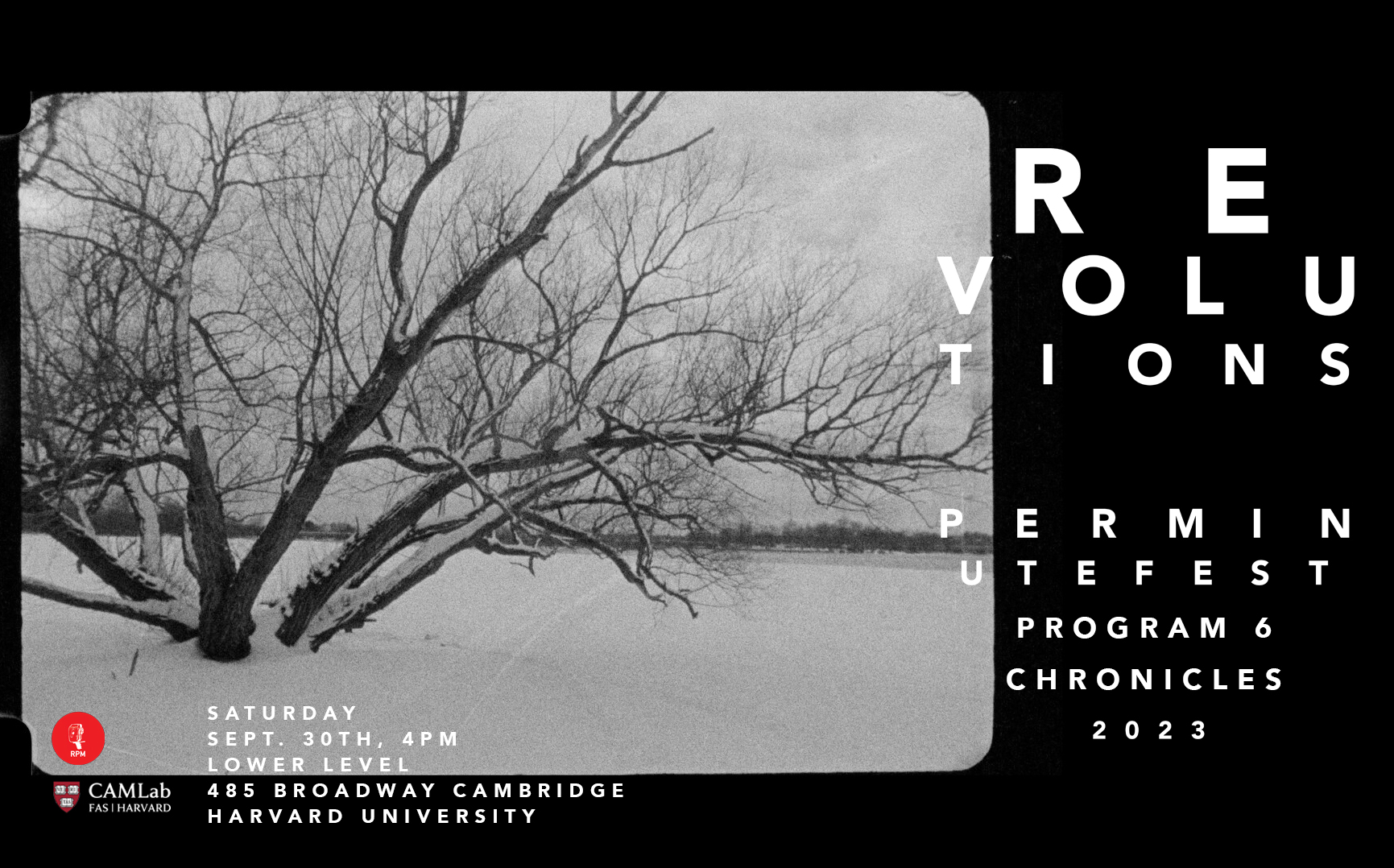
River
Penny McCann
2mins57secs, 2023, Canada, B/W, sound, 16mm to digital
A hand-processed black and white study of the Ottawa River in winter. Commissioned by the Lightproof Film Collective with sound design by Eric Walker.
Canadian media artist Penny McCann's body of work spans thirty years and encompasses both narrative and experimental films and video. Since 2000, she has been engaged in creating a body of experimental films that journeys through an abstract and poetic terrain marked by half-glimpsed memories and fragments of the past, forming a sustained poetic meditation on landscape, place and time. According to Cecilia Araneda in her essay commissioned by Gallery 101 to accompany her 2020 exhibition, Land Lines (of time and place) in no particular order: “McCann intervenes with our sense of the familiar with her use of hand-crafted analogue filmmaking approaches … purposefully setting it back into a kind of suspension that we immediately associate with the dream state of processing memories.”
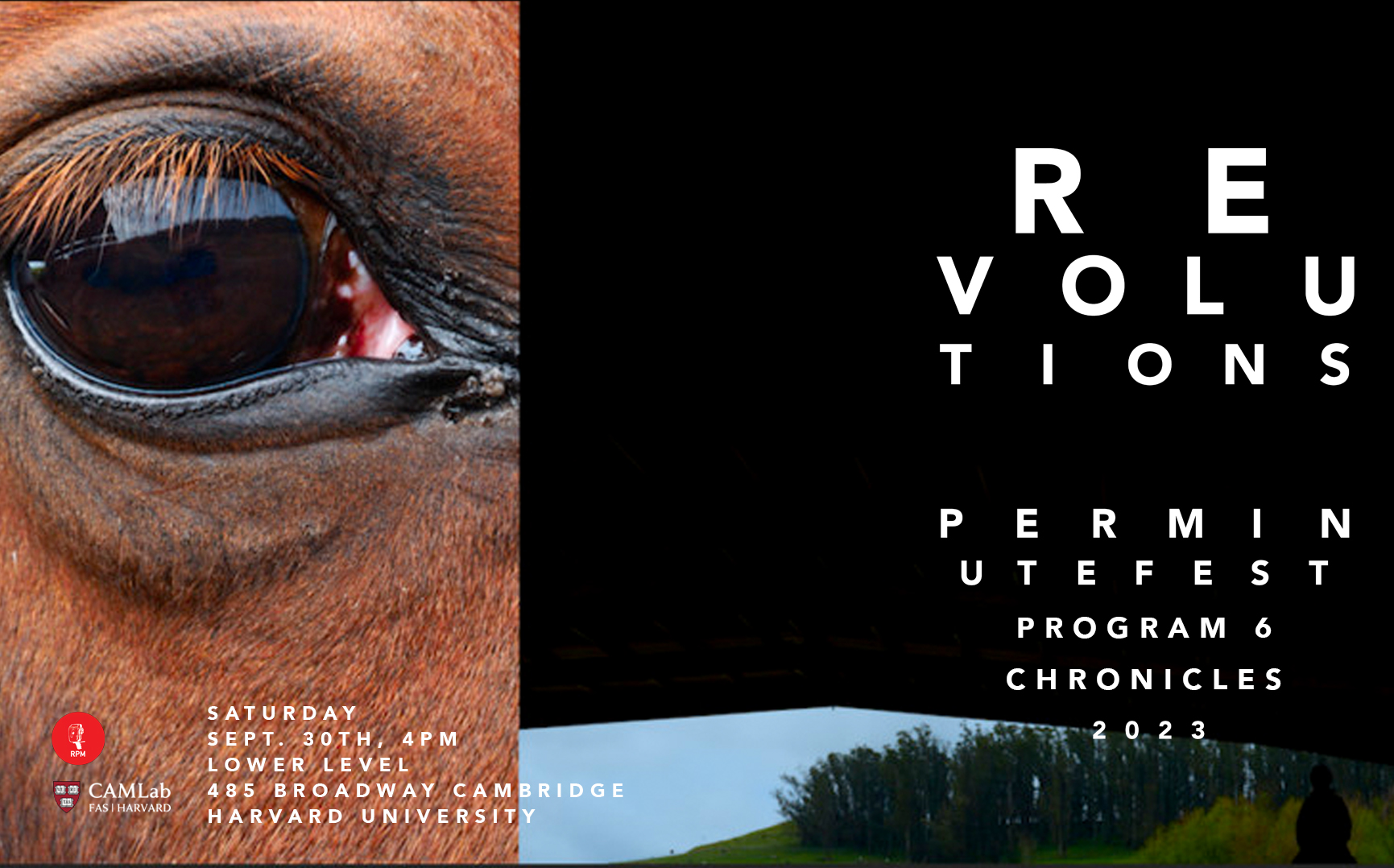
Bezuna
Saif Alsaegh
7mins30secs, 2023, USA, color, sound, HD
Bezuna explores the complexities of fleeing a war-zone through the analysis of peripheral details. Through interweaving different narratives, the film presents the raw and broken feelings of a child and a cat whose lives will never be the same.
Saif Alsaegh is a United States-based filmmaker from Baghdad. Much of Saif’s work deals with the contrast between the landscape of his youth in Baghdad growing up as part of the Chaldean minority in the nineties and early 2000s, and the U.S. landscape where he currently lives. His films have screened in festivals including Cinéma du Réel, Kurzfilm Hamburg, Kassel Dokfest, and in galleries and museums including the Wisconsin Triennial at the Madison Museum of Contemporary Art and Rochester Contemporary Art Center. He received his MFA in film from the University of Wisconsin-Milwaukee.

Fleshwork
Lydia Cornett
7mins, 2022, USA, B/W&color, sound, 16mm to HD
At a butcher shop in Jeromesville, Ohio, four meat processors situate their labor within their own minds and bodies.
Lydia Cornett (she/her/hers) is filmmaker based between Columbus, Ohio and Brooklyn, New York. As a former musician turned filmmaker, she makes work that unites the restraint of observational storytelling with the physicality and connective qualities she associates with music-making. Her work has screened at AFI Fest, BAMCinemaFest, Sheffield Doc Fest, AspenShortsFest, Hamptons International Film Festival, and DOC NYC, where she received a Special Jury Mention for her film Yves & Variation. She was awarded fellowships to the Jacob Burns Film Center’s Creative Culture program and the UnionDocs’ Collaborative Studio, and she has received support from the Tribeca Film Institute, IF/Then Shorts, the Princess Grace Foundation, and the NYC Women's Fund for Media, Music and Theatre. Her work has been distributed and featured by The New Yorker, PBS (POV and Reel South) Nowness, and Vimeo Staff Picks.
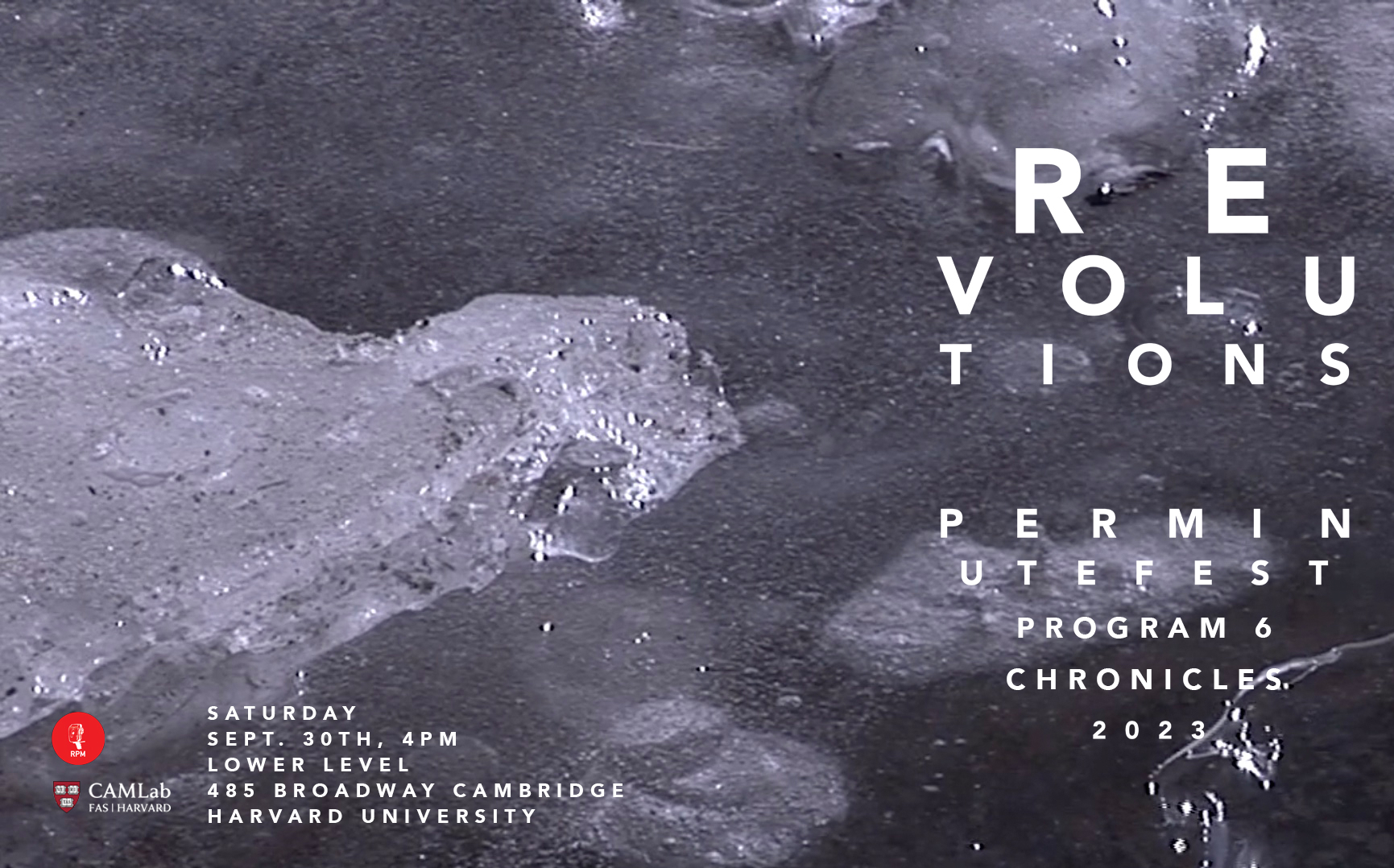
Daybook
Alfred Guzzetti
23mins30secs, 2022, USA, Color, Sound, HD
October, 2019 to August, 2021. Fragments of remembered music, poems, glimpses of objects, recorded day by day, as if a chronicle—
or elements of imaginary films yet to be made about a time that needs to be remembered but resists comprehension.
Alfred Guzzetti is a filmmaker and Professor of Visual Arts at Harvard University. His work has been shown at the New York and Berlin film festivals and other festivals in London, Rotterdam, Germany, Spain and France, as well as in installation settings in New York, Copenhagen, Houston and Santa Monica. Guzzetti is the author of the book Two or Three Things I Know about Her: Analysis of a Film by Godard (1981) and a member of the Academy of Motion Picture Arts and Sciences.
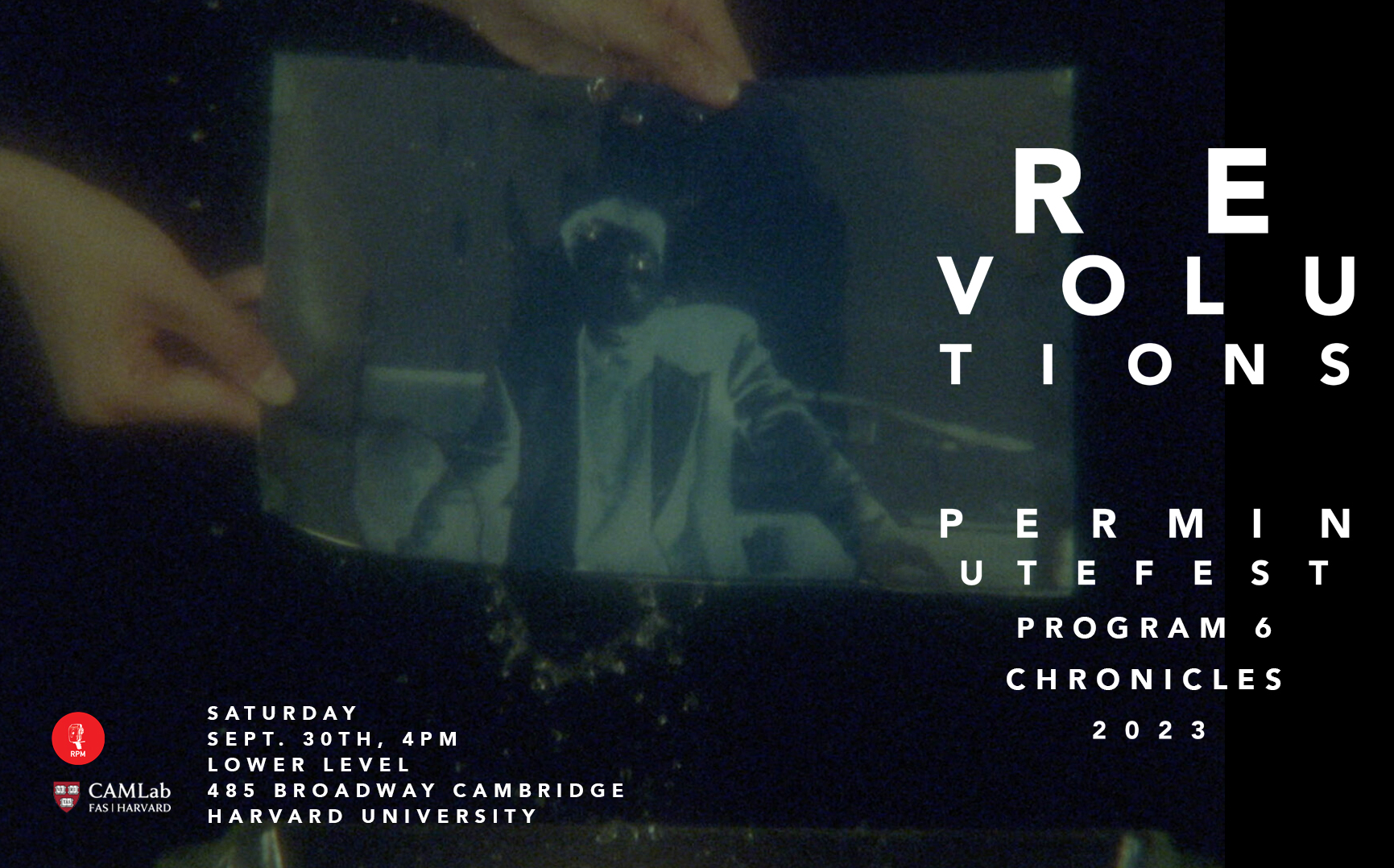
Exquisite Corpse Trilogy
Seokyoung Yang
17mins, 2023, Korea, color, sound, digital, 16mm & Super8 to HD
Through three unsuccessful attempts and trials, a filmmaker seeks to reconcile with the death of her father. This film explores the strength of persevering through multiple attempts, even when the outcome is likely to be failure.
Seokyoung Yang (she/they) is a curator, poet, and filmmaker dedicated to artistic experimentation. Born and raised in South Korea, she investigates the correlation between anomaly of language, diasporic bodies, and internal loss through moving images and texts. She received her BFA in film and video program at California Institute of the Arts. She currently resides in Los Angeles, California.
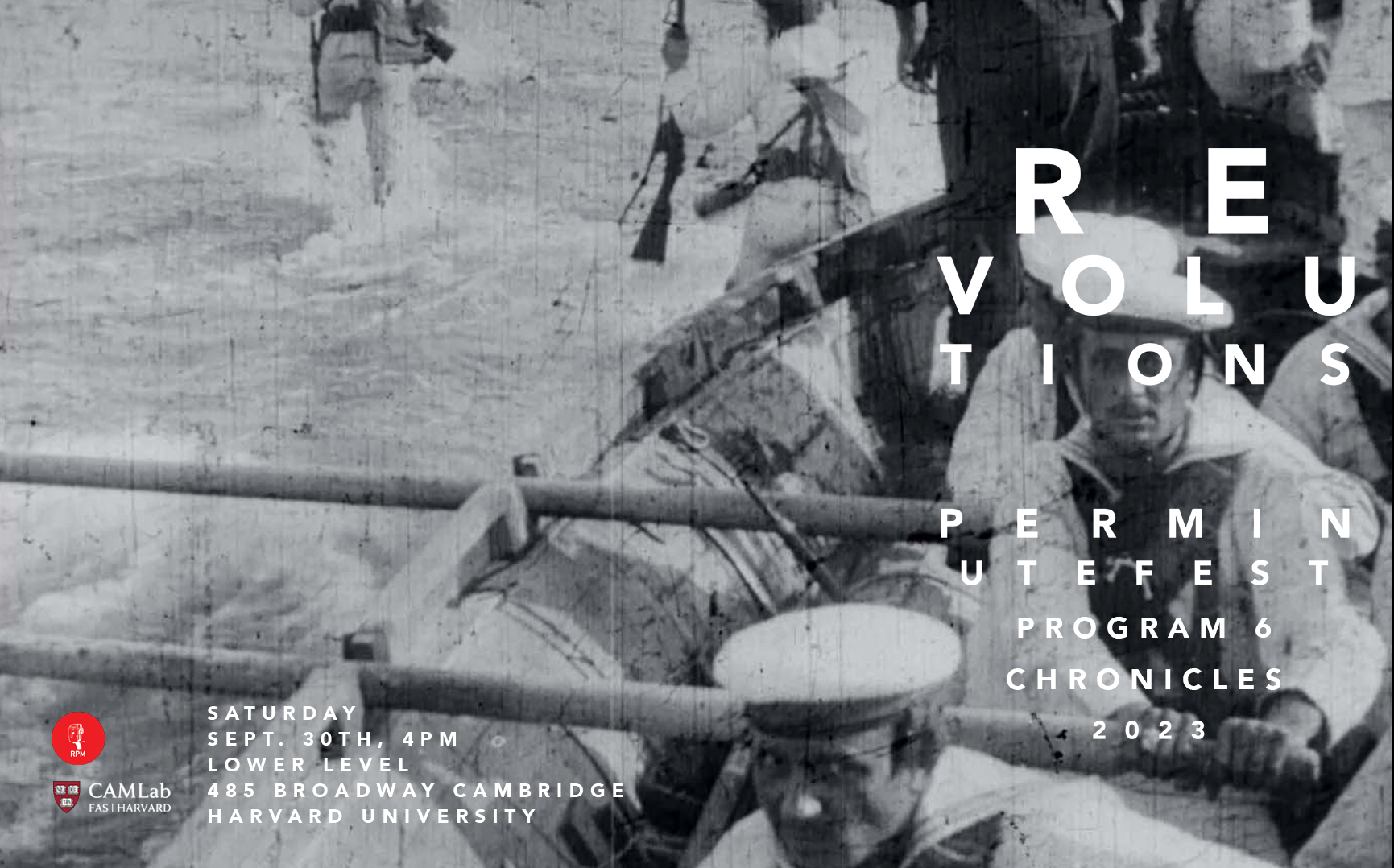
Fathers' Land
Francesco Di Gioia
11mins24secs, Italy, 2021, B/W, sound , found footage to HD
1910s. Poems with alternate rhymes narrate a journey by sea and by rail.
These are the verses of Fadil Hasin Ash-Shalmani who witness a historical fact often forgotten: the deportation of numerous civilians during the first years of the Italian occupation in Libya.
The short film follows the poet's experiences and memories using only archive footage, thus subverting the original propaganda function of the images.
Francesco Di Gioia (Gorizia, 1993) achieved a BA (Hons) at the Politecnico of Milan in Communication Design, after which he began a course at the Civica Scuola Luchino Visconti in Documentary Cinema. He then studied Video Editing at the Centro Sperimentale di Cinematografia in Rome. He currently works as an archive researcher for several productions.
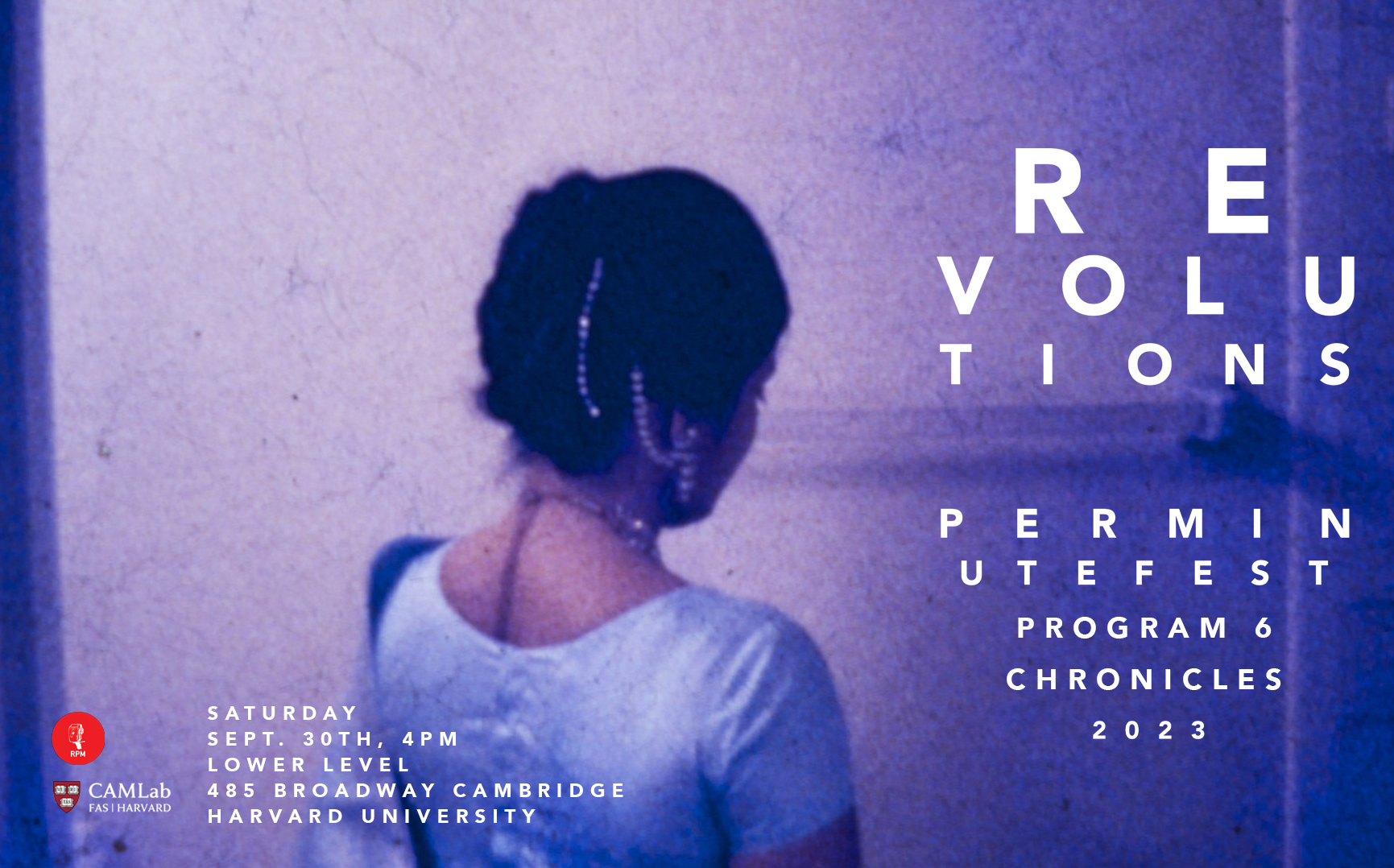
How to Build a House out of Wreckage and Rags
Bernd Lützeler
8mins, 2022, Germany, color, sound, Super8 & 16mm to digital
Found footage: California in the 1950's and 60's. A young Indian couple enjoys their personal American dream come true in their home somewhere in the suburbs of San Francisco. In great detail they demonstrate their newly achieved wealth in front of their Super-8 camera. Like postcards, they would send these film rolls to their families back in India. Around the same time, an American missionary couple visits the city of Calcutta to shoot a Christian propaganda film. The drastic reality of poverty and famine in the streets of the Indian metropolis fits perfectly into their wicked plan: To promote the believe in Christ by showing the misery that pagan believers are doomed to suffer from.
Artist and filmmaker Bernd Lützeler lives and works between Berlin and Mumbai. His films have been shown at venues and festivals worldwide, including Centre Pompidou, Berlinale International Film Festival, Rotterdam, Ann Arbor Film Festival, Views from the Avant-Garde and many more. Bernd is an active member of the artist-run analogue filmlab LaborBerlin.
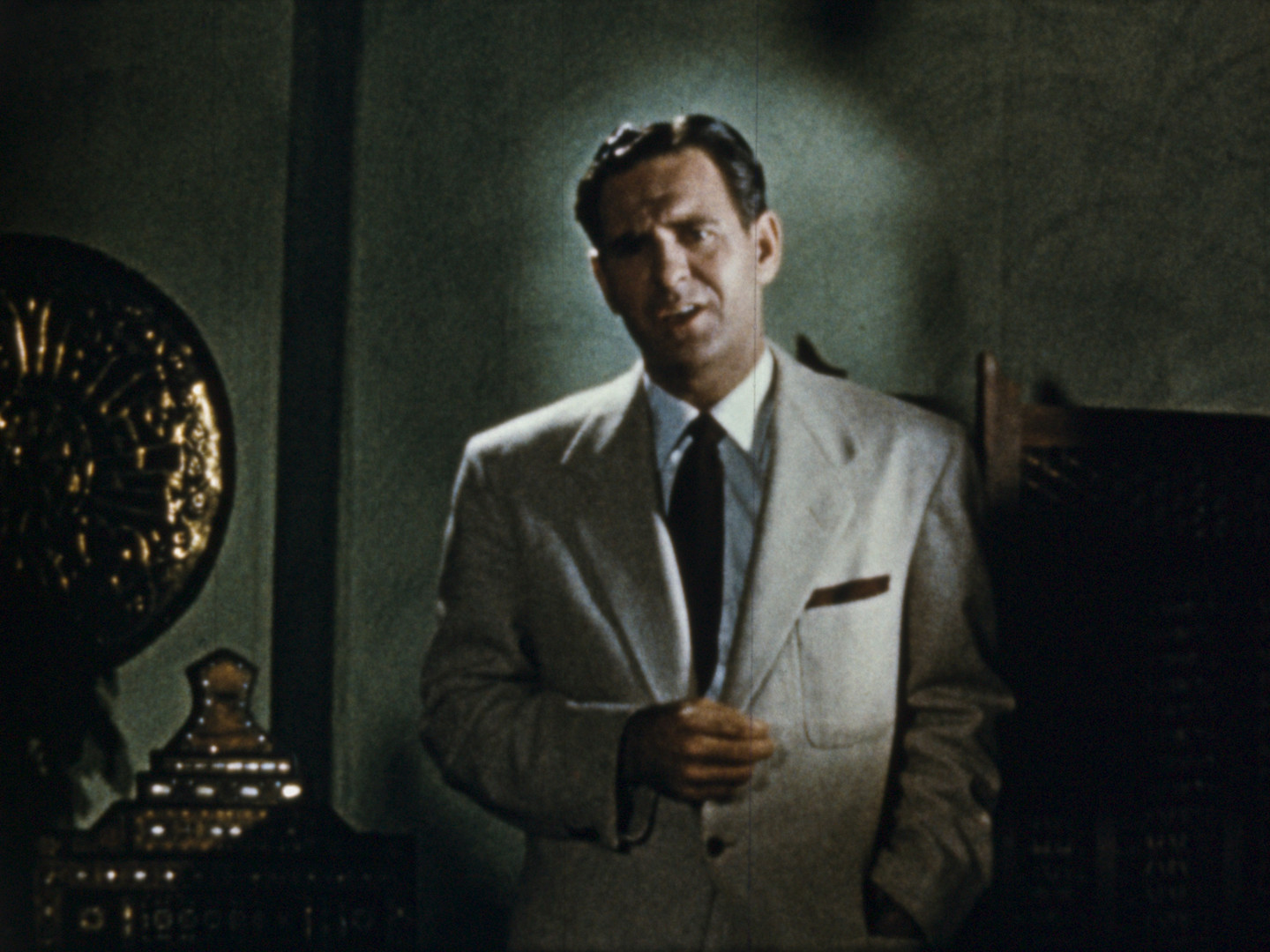
Saturday
Sept. 30th, 6PM - 8PM
Harvard FAS CAMLab
Lower Level
485 Broadway Cambridge
MA 02138
Harvard University

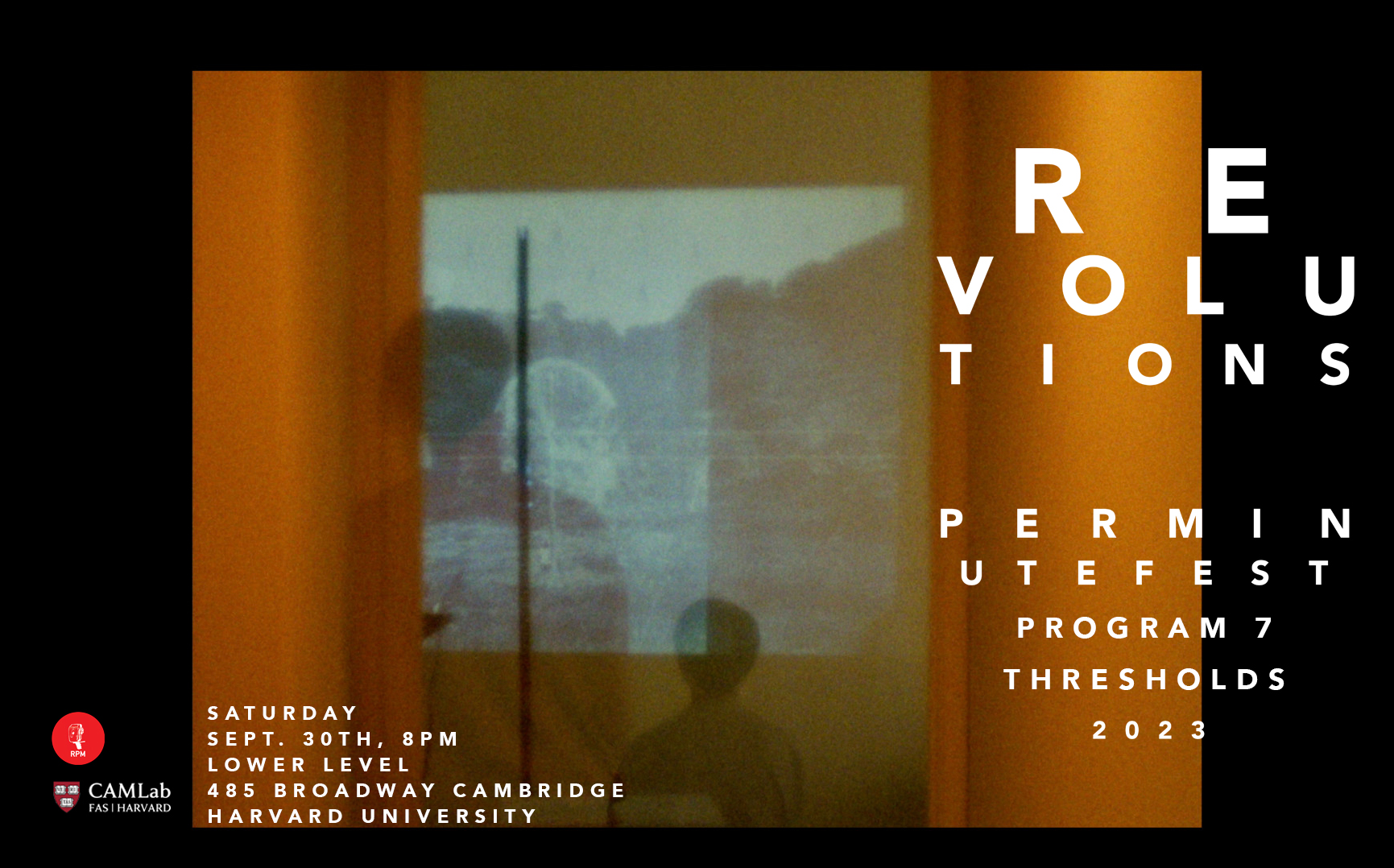
Saturday
Sept. 30th, 8PM
Harvard FAS CAMLab
Lower Level
485 Broadway Cambridge
MA 02138
Harvard University

(r)evolution
Vanessa Cardui
1min, 2022, Germany, Color, sound, digital
2cent / 10coil
Monteith Mccollum
10mins, 2022, USA, B/W, sound, HD
A throwing forth
Xiao Zhang
6mins, 2023, China/USA, color, sound, 16mm to HD
Rheme maining sources
Ж
17mins, 2022, Brazil, B/W & color, sound, digital
Vision of Paradise
Leonardo Pirondi
16mins, 2022, Brazil, color, sound, digital, 16mm to HD
Case Study One: The Shrink
Mila Rae Mancuso
5mins35secs, USA, 2022, B/W&Color, sound , 16mm to HD
Babbler, Fairy and Thrush
Karel Doing
3mins44secs, 2022, UK, B/W & Color, sound, 16mm to HD
Everything Comes Full Circle
Lilan Yang
13mins44secs, 2022, USA, B/W & Color, sound, 16mm
total: 73 mins
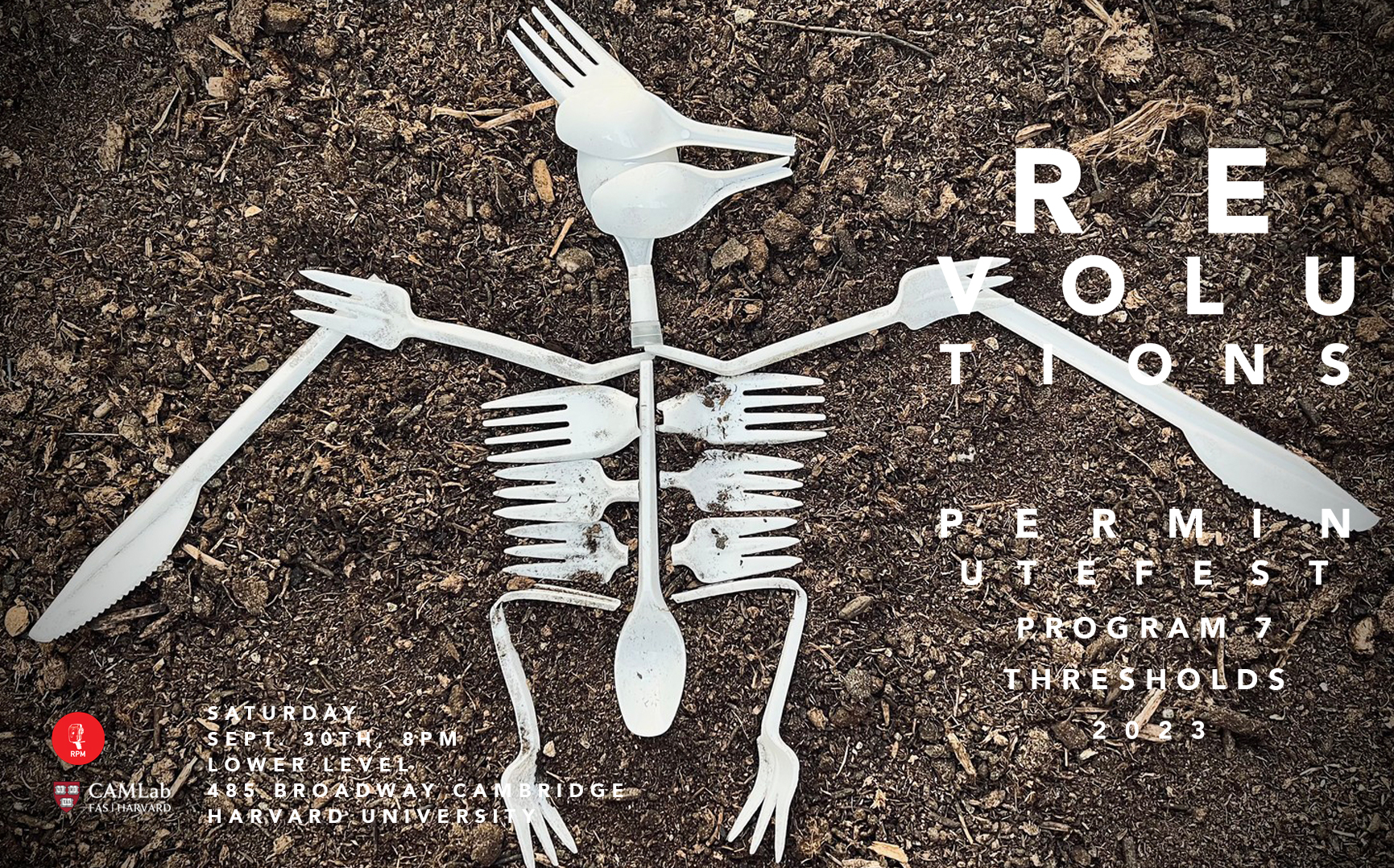
(r)evolution
Vanessa Cardui
1min, 2022, Germany, Color, sound, digital
(R)EVOLUTION is a 1- minute object animation film that explores the impact of plastic on wildlife. Researchers found that more than 1500 wildlife species worldwide have eaten plastic in the environment. 100 million marine animals die each year from plastic waste. And a recent study found that people eat five grams of micro and nano plastics every week. (R)EVOLUTION visualizes the increasing danger of plastic - it shows the extinction of animal species and how plastic takes over the body.
Vanessa Cardui, born in 1987, is a Berlin based video artist. She studied art and media at university Hildesheim in Germany. Her work is characterized by artistic metamorphoses. She transforms everyday objects into pieces of art by exploring the different techniques of animation to bring the objects to life. She works with meaningful color contrasts and creates an imaginative world that arises from the texture of the material.
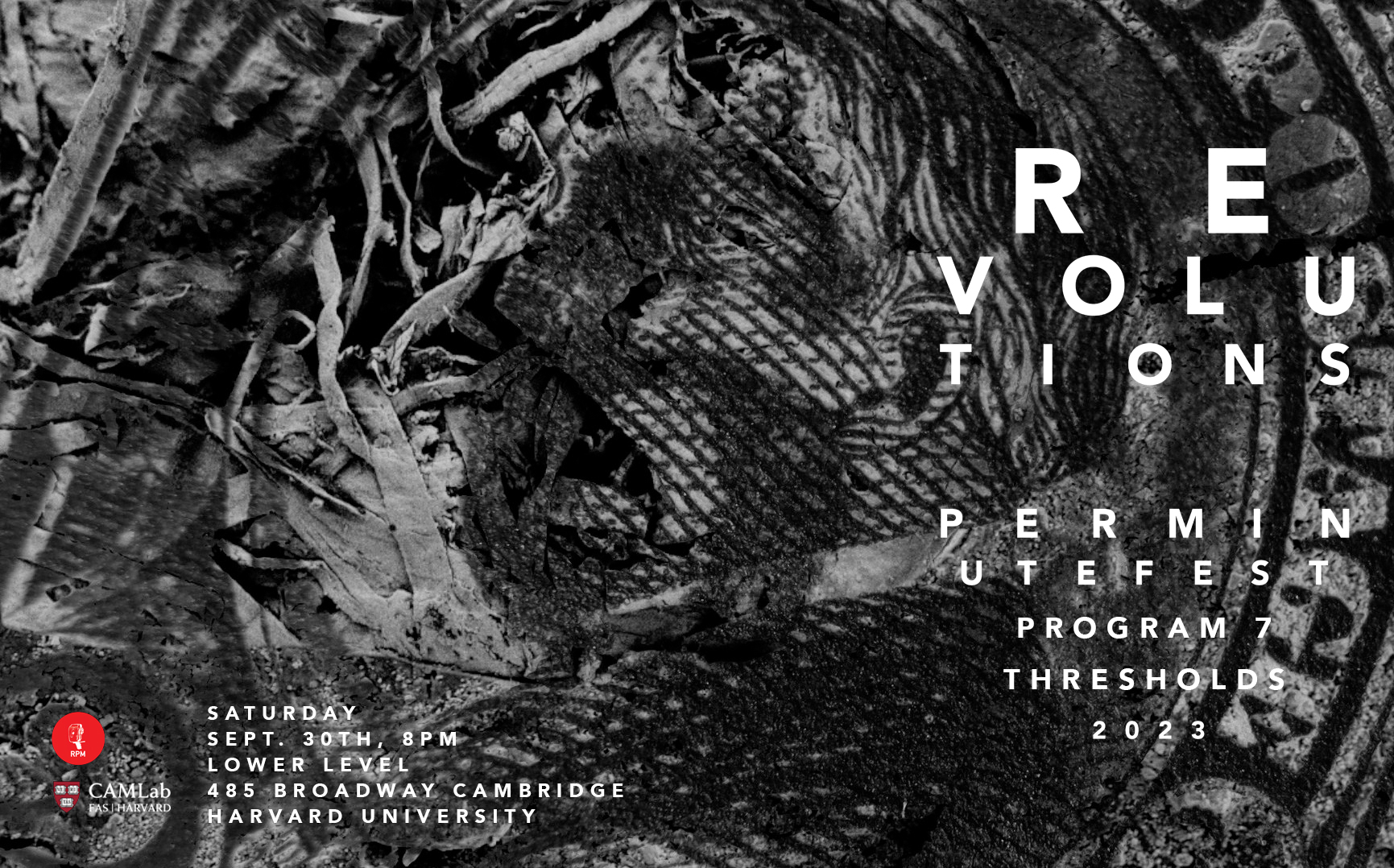
2cent / 10coil
Monteith Mccollum
10mins, 2022, USA, B/W, sound, HD
Part science, part history, 2cent / 10coil is an exploration into the physical properties of a U.S. postage stamp and the anomalies it presents when subjected to the beam of an electron microscope. Integrated within, are the philosophical musings and speeches of a man in his last weeks of life on a quest entitled, “The Voyage of Understanding.”
I like to say this subject found me. At the Analytic Diagnostics lab at Binghamton University I received training over many months culminating in access to a Scanning Electron Microscope.
I was enamored with the unique possibilities the SEM offered despite its difficulties. I brought in a small stamp collection to give myself border limitations. The 1932 Harding stamp was the first
to come to life. Using the SEM is a slow process, after sealing the stamp in the chamber and composing a shot there was only time for approximately 120 consecutive scans per session. This particular stamp reacted in a way the others hadn’t, fibers came to life and the ink danced. None of these images are animated with software. The mysterious movement stems from the scanning process itself and the build up of heat from the electrons rendering the object.
– monteith mccollum

A throwing forth
Xiao Zhang
6mins, 2023, China/USA, color, sound, 16mm to HD
A time remnant inhabits a personal space with a secret, private, unspoken word of one's being. Sliding planes of window and time, throwing drifts of the inner and the outer self, the film seeks in the interval of memory for a transitory reunion with my family.
Xiao Zhang is an artist-filmmaker from China living in Los Angeles. She received her BFA at Beijing Film Academy in 2020 and currently holds an MFA in Film/Video at CalArts. Her practice centers on personal poetics which derives from cross-generation memory and diaristic approaches. It continues by employing methods drawn from handcrafted celluloid film and expanded cinema. Her work often offers a complex fluctuation between material reality and subjective experience.
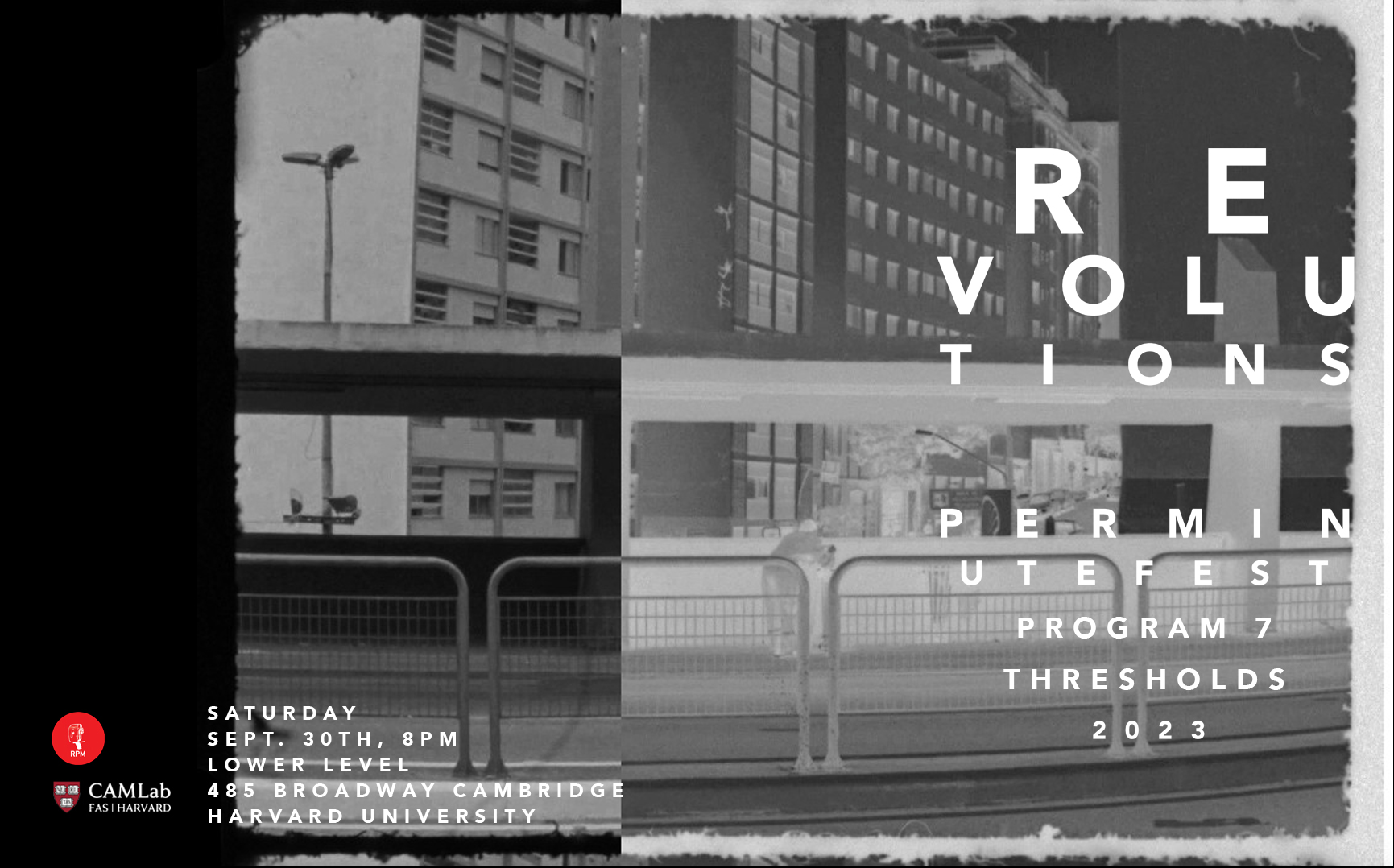
Rheme maining sources
Ж
17mins, 2022, Brazil, B/W & color, sound, digital
A place-specific film-excavation of Bixiga neiborhood-São Paulo.
Choreography of forces that cross present time.
Filmancy, clairvoyance is the vision of what is taking shape.
Allegory: lobby-color, speculates.
Hollow in the heart of the city, a rock. A bird ‘rappina’ lands.
Novelty: Quilombo, alley, dealers:step. Vai-Vai samba school’s black and white banner. Pictograms from Benjamin’s “The Arcades project”.
Progress: pluging a river while it’s possible.
Commodity: Matarazzo & Metro. The real state of things, real estate: banning organic. Ground- quotation, blue taroes, water tanks, oxum: (cosmo) political reaction. Rheme maining sources: life asking for passage.
Ж is a film-designer, educator and programmer. His films, video-installations and texts have been exhibited in festivals, galleries and museums such as: SFMoma -Cinemateque (Crossroads 2018)- EUA; Pantalla Global CCCB-Barcelona; Museo San Telmo -San Sebastián-Espanha; EAC (Espacio de Arte Contemporaneo)-Uruguay; Microscope Gallery; Bienal SURb2021-Buenos Aires, 13 Bienal de Artes Mediales (Temblor)- Chile; Berwick Film & Media Fesitival-Reino Unido; Programa de Exposições CCSP-SP-Brazil (solo); Revista ArtContexto- Brazil; 19 Fest CurtasBH-Brazil; 13 CineOP-Brazil; CantorGallery, Massachusetts - USA; VisArts– Frame & Frequency 3– Rockville- USA; CCEG- Centro Cultural España-Guatemala; La Darsena - Argentina; Sala Nordeste -MinC- Brazil; Museu da Imagem e do Som (MIS)- Brazil; Dobra Festival Internacional do Cinema Experimental- Cinemateca MAM- Rio de Janeiro, Blitz#27: Ж Economia/Ecologia _ Zumzeig Cinema-Barcelona, among many others.
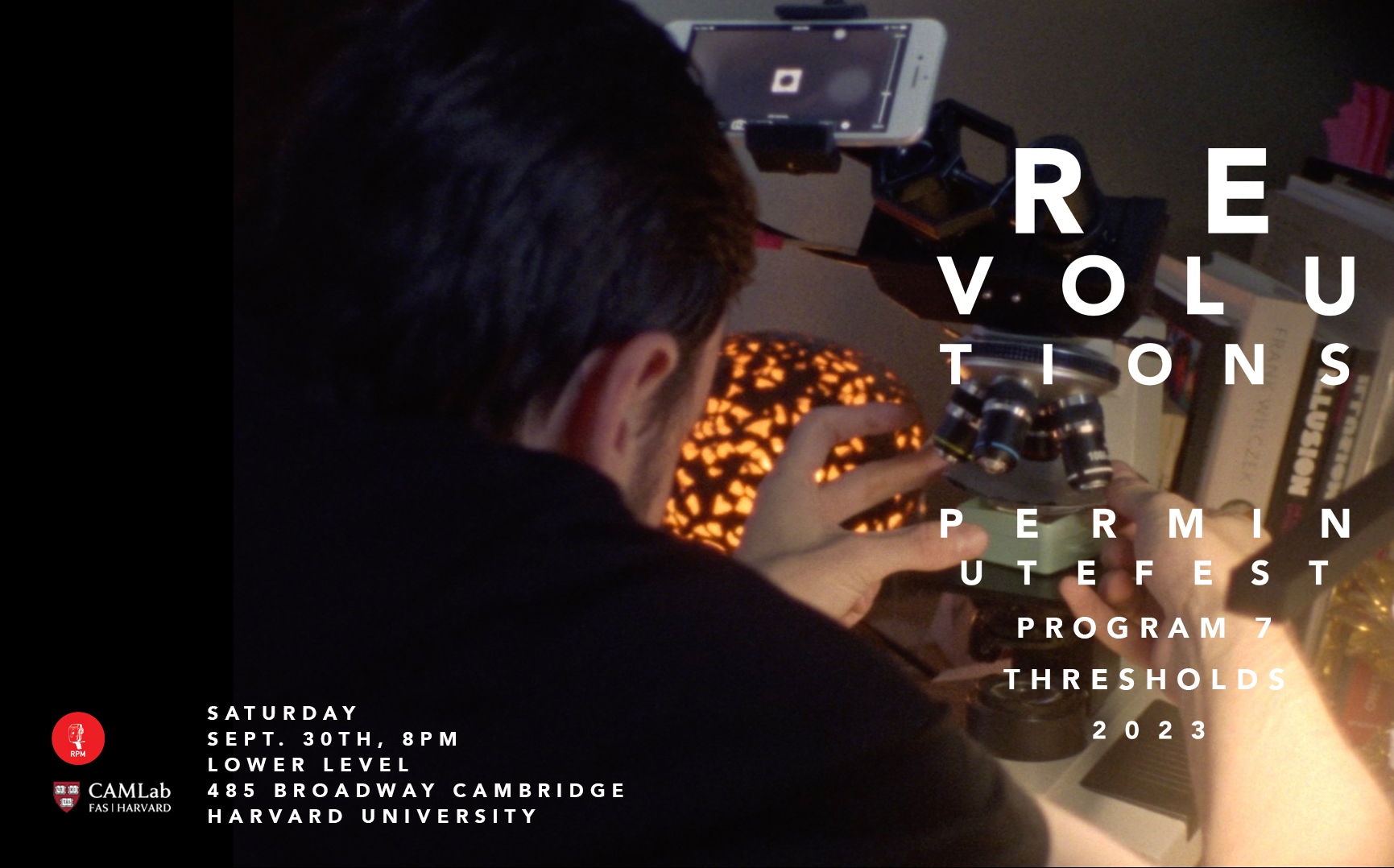
Vision of Paradise
Leonardo Pirondi
16mins, 2022, Brazil, color, sound, digital, 16mm to HD
The great voyages to the "New World" were seen as expanding the frontiers of the visible and displacing those of the invisible, therefore, maps from that time render the real and imaginary. The film follows a voyage of the Brazilian Military in search of an imaginary island with the same name as their country. The myth from 1483 Brazil, or Hy-Brazil, is known to exist to the west of Ireland and above the Fortunate Islands. Vision of Paradise is an examination of the capacity of the human imagination and computer simulations to construct environments. Amidst the fine threshold of the real, simulated, and imagined, the film analyzes the contemporary ideas of virtual reality and their ambition to expand the frontiers of the physical world into a "New World".
LEONARDO PIRONDI is a Brazilian filmmaker based in Los Angeles. His films explore the infinite abyss between the multiple derived versions of reality through documentary, experimental, and narrative modes. Much of his work uses analog and digital manipulations on celluloid to examine the sociopolitical unfoldings of the intersections between imagination, science, myth, and technology.
His films have been exhibited at various film festivals, institutions, and venues internationally, such as the International Film Festival Rotterdam, New York Film Festival, Viennale, BFI London, Melbourne, Edinburgh, Guanajuato, True/False, Ambulante, Curtas Vila do Conde, Wexner Center, REDCAT, and others. Some of his work exists in the collection of the UCLA Film & Television Archive, Cinematheque of the Museum of Modern Art in Rio de Janeiro, and The Film-Makers' Coop. in New York. He holds a Film/Video degree from CalArts, is a Sundance Ignite Fellow, and is the recipient of the Allan Sekula Social Documentary Fund and the Tim Disney Prize for Excellence in the Storytelling Arts.
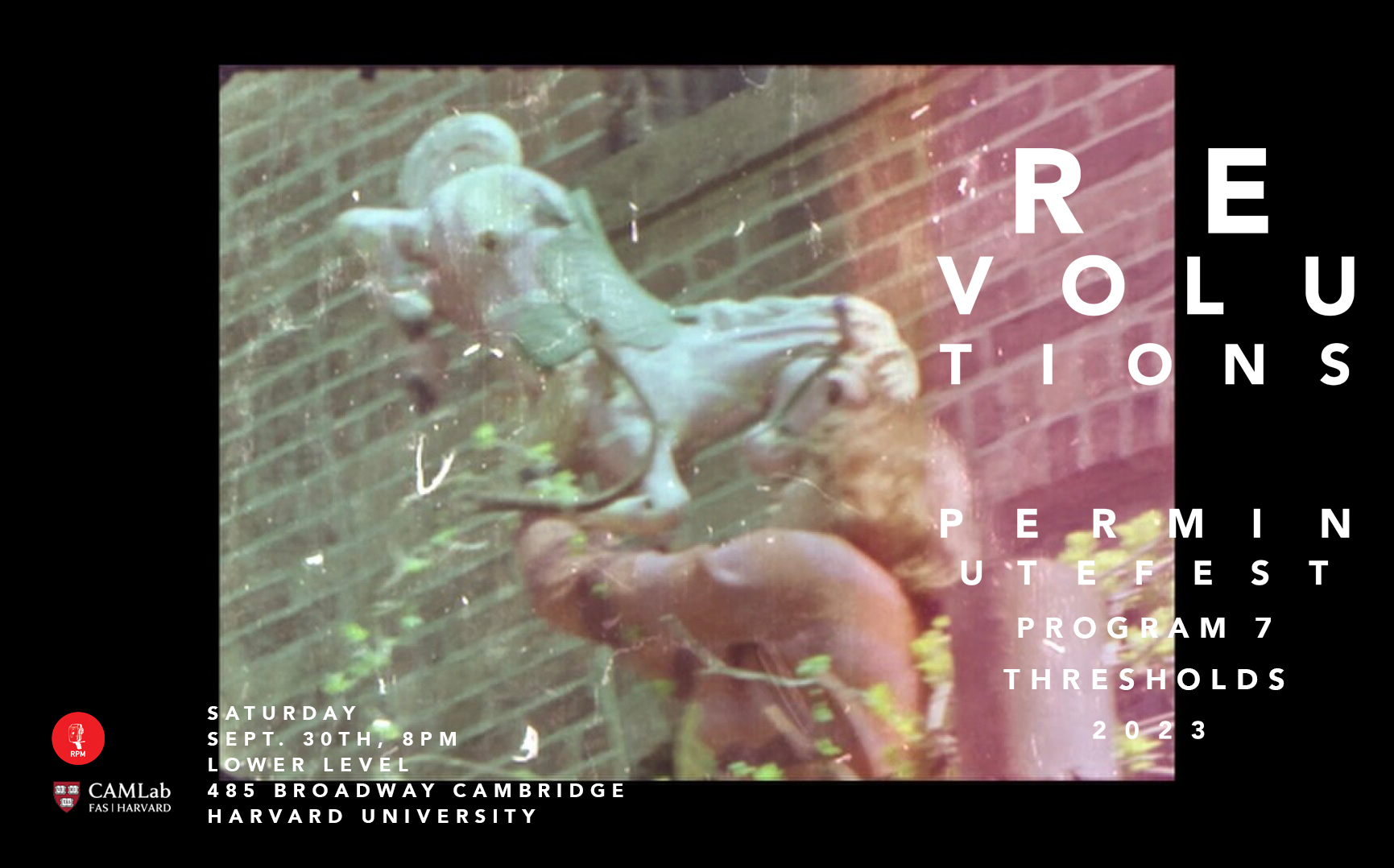
Case Study One: The Shrink
Mila Rae Mancuso
5mins35secs, USA, 2022, B/W&Color, sound , 16mm to HD
A short poetry thesis film surveying transitory object-life and permanence. Concepts arose from games of exquisite corpse & practices of automatic writing —part one of a series of vignettes. Shot on 500T 16mm, hand processed.
Mila Rae Mancuso is a writer and interdisciplinary artist whose creative work is driven by the subconscious. Writing poetry since the age of 14,
her work is fueled by self-discovery and contemporary feminist surrealism which explores the complex intersection of fairytales, girlhood, and the macabre.
Mancuso’s work often entwines the worlds of literature, art, filmmaking, and experimental processes to create an occupancy of its own kind.
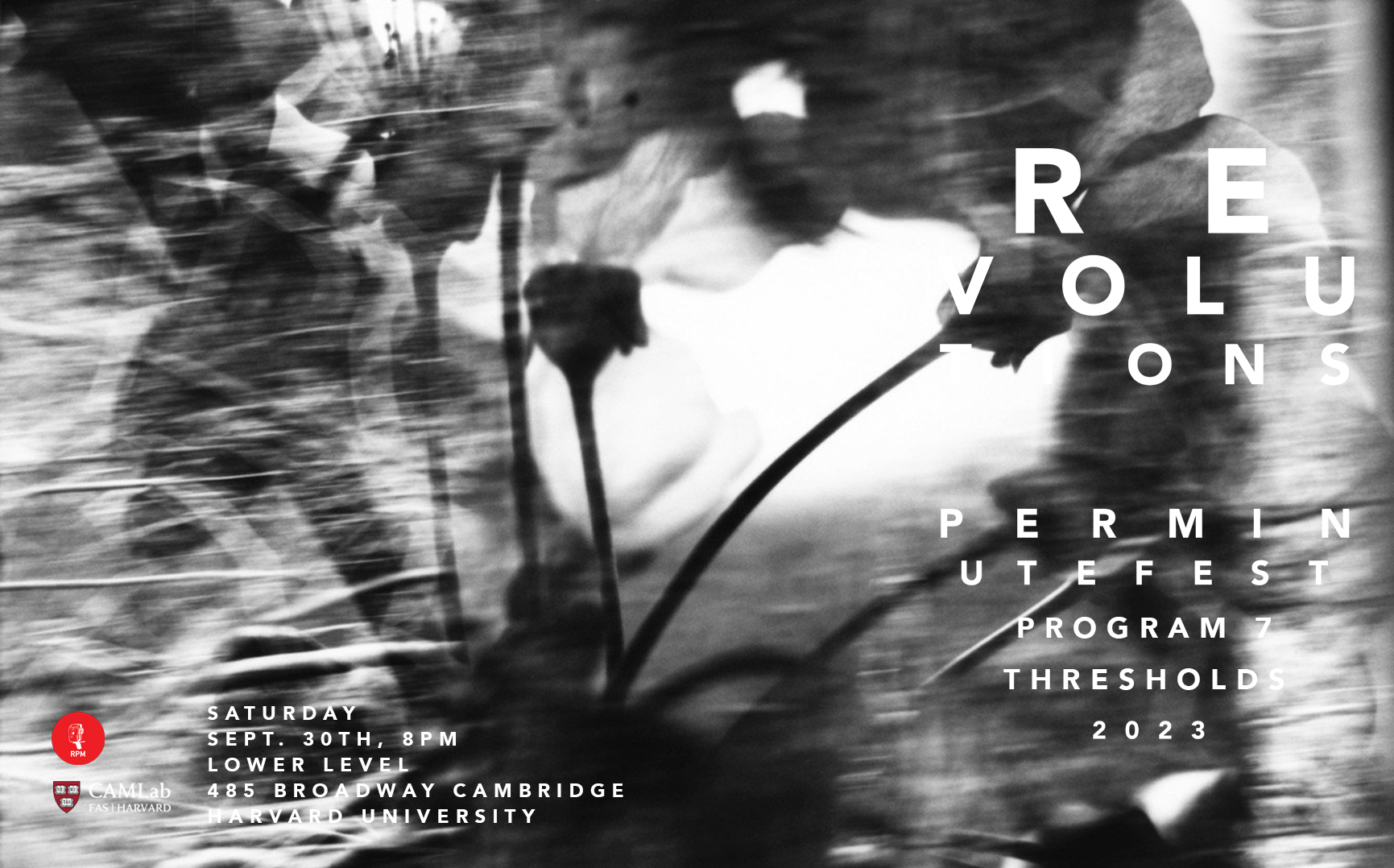
Babbler, Fairy and Thrush
Karel Doing
3mins44secs, 2022, UK, B/W & Color, sound, 16mm to HD
An unfiltered stream of perception: small objects and grand panoramas appear simultaneously. The certainties of near and far, detail and overview, inside and outside are deliberately thrown into confusion. Aided by ‘in camera’ superimposition and travelling mattes a near abstract experience is created. Sunlight filters through semi-transparent surfaces, while small holes and cracks allow the light to travel unrestrained. The work was conceived and shot within a few hundred yards from my house, focusing on the plants, flowers, trees and ferns that grow around me.The soundtrack is composed with noises and voices from that same area, revealing a further abundance of life.
Karel Doing is an independent artist, filmmaker and researcher whose practice investigates the relationship between culture and nature by means of analogue and organic process, experiment and co-creation.
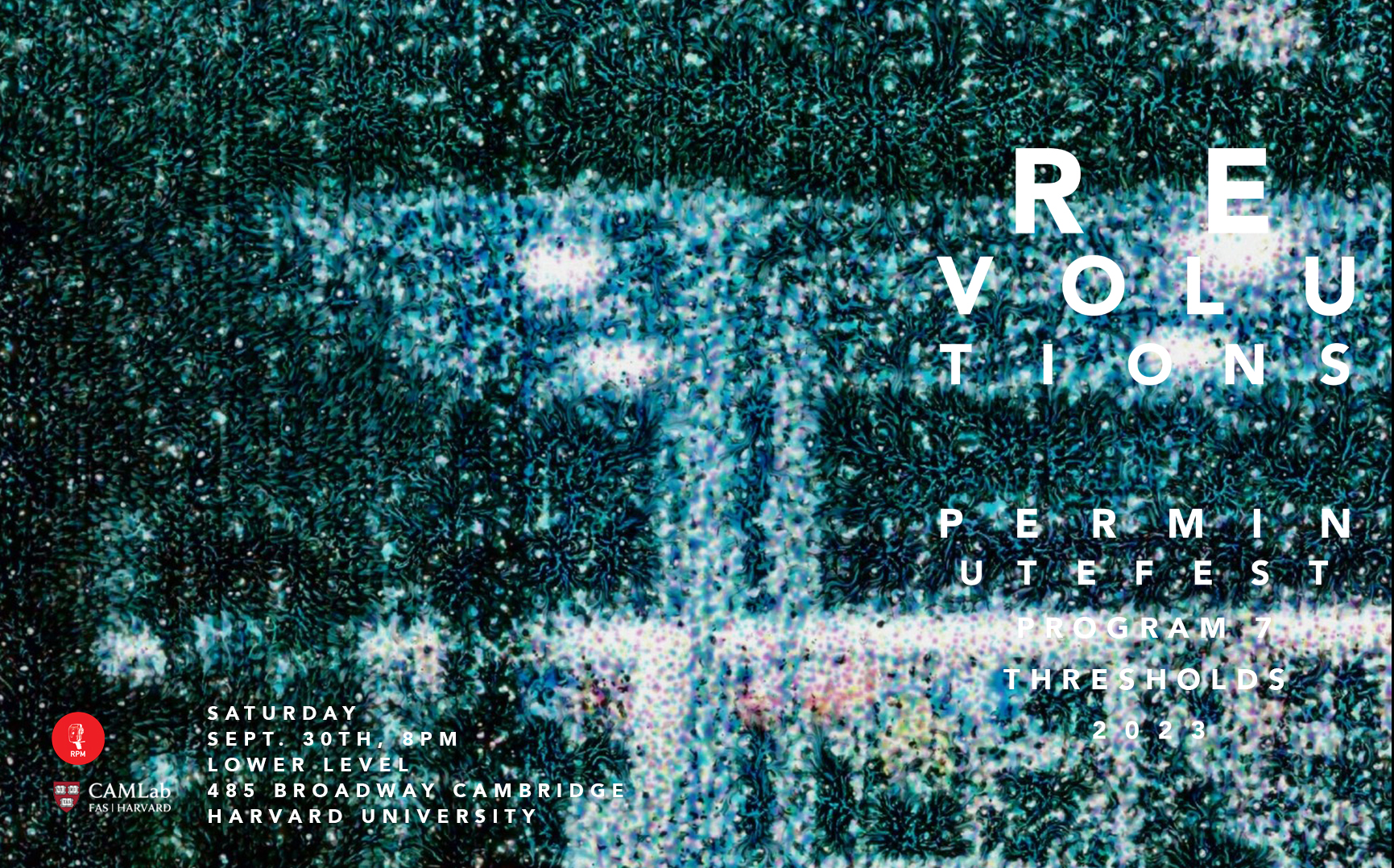
Everything Comes Full Circle
Lilan Yang
13mins44secs, 2022, USA, B/W & Color, sound, 16mm
Following Wim Wenders’ Paris, Texas (1984) filming locations from Houston, Texas to Los Angeles, California, I use a 16mm Bolex camera to capture the vastness of the American West. The footage draws me to reminisce about snippets of my everyday life. I contemplate how we perceive the world through analog optical apparatuses and how memories are multidimensional yet fragile. Our recollections of people and places can be distorted, unrecognizable, and fictitious. These memories would eventually diminish with the passing of time. Everything Comes Full Circle is a personal attempt to remember things that will soon be forgotten.
The original footage was shot in Kodak 16mm film stocks during the summer of 2021 and edited digitally with voiceover. Later the digital moving images were inkjet printed on clear film spliced together with perforations cut out with a laser cutter. Each run of the projection makes the printer ink slowly melt, and the film will eventually fall into decay over the course of time.
Lilan Yang is an artist and experimental filmmaker from Chongqing, China. Her practice explores the myth of cities and landscapes, ways of seeing and unseeing, and sentiments of remembering and forgetting, through lens-based analog media such as 16mm filmmaking and 35mm photography, as well as digital technologies such as machine learning and data visualization. She received a BS in Computer Engineering from University of Illinois at Urbana-Champaign and an MFA in Digital + Media from Rhode Island School of Design.

Sunday
Oct. 1, 2pm
Harvard FAS CAMLab
Lower Level
485 Broadway Cambridge
MA 02138
Harvard University

A Thousand Years Ago
Edgar Jorge Baralt
20mins, 2022, USA, B/W & Color, sound, 16mm to digital
Damp Moss
Christopher Thompson
4mins22secs, 2023, USA, color, sound, super8 to HD
Dear Monster
Stefano P. Testa
15mins, 2023, Italy, Color, Sound, HD
In Littleness
Cherlyn Hsing-Hsin Liu
8mins15secs, 2022, USA, color, sound, 8mm to HD
istén:'a
KJ Edwards
5mins12secs, Canada, 2023, Color, sound, 16mm to HD
Language Unknown
Janelle VanderKelen
6mins10secs, 2022, USA, color, sound, 16mm to digital
Pump
Charles Cadkin
4mins42secs, 2022, USA, color, sound, 16mm to digital
This Is How I Felt
Josh Weissbach
1mins35secs, 2022, USA, B/W, sound, 16mm
With The Tide, with the tide
Anna Kipervaser
2mins49secs, 2022, USA, Color, sound, 16mm to digital
total: 71 mins
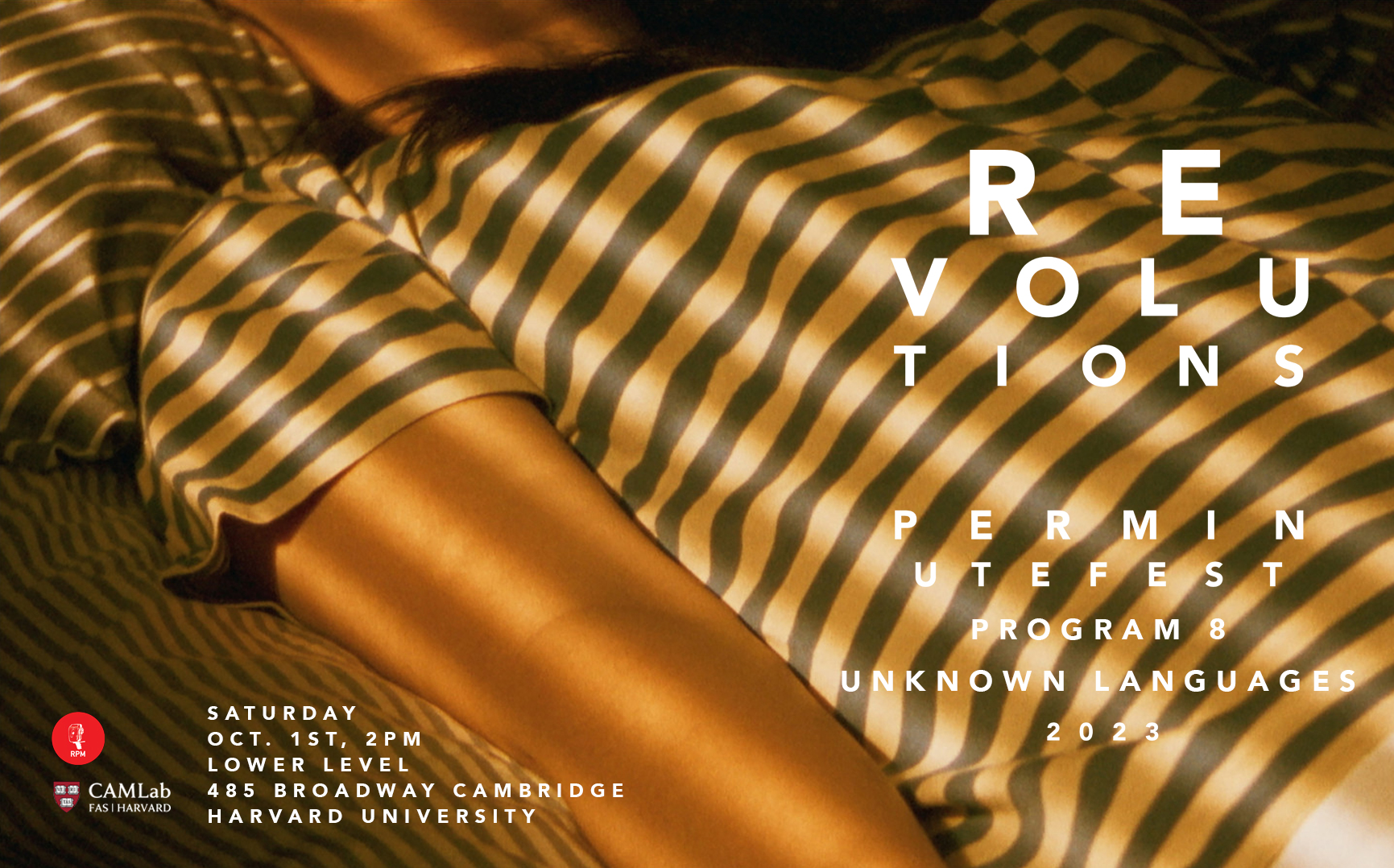
A Thousand Years Ago
Edgar Jorge Baralt
20mins, 2022, USA, B/W & Color, sound, 16mm to digital
(In an imaginary look back at the present from the year 2049, an exile returns to Los Angeles decades after being displaced by large scale social and environmental collapse. Once back, he recreates his past (our present), and imagines the lives of those who inhabited his apartment during his absence. His sense of displacement leads to a meditation on place, memory, and dreams.
Edgar Jorge Baralt (b. 1988) is a Venezuelan-born filmmaker based in Chicago, whose personal work tackles questions of memory and temporality, incorporating multiple formats in his practice. He obtained an MFA in Film and Video from the California Institute of the Arts. His work has been programmed at different international venues and festivals, including the Berlinale, LA Filmforum, Chicago Underground Film Festival, Kasseler Dokfest, Bucharest International Experimental Film Festival, among others. His films attempt to destabilize rigid ways of understanding identity, perception, and landscape.
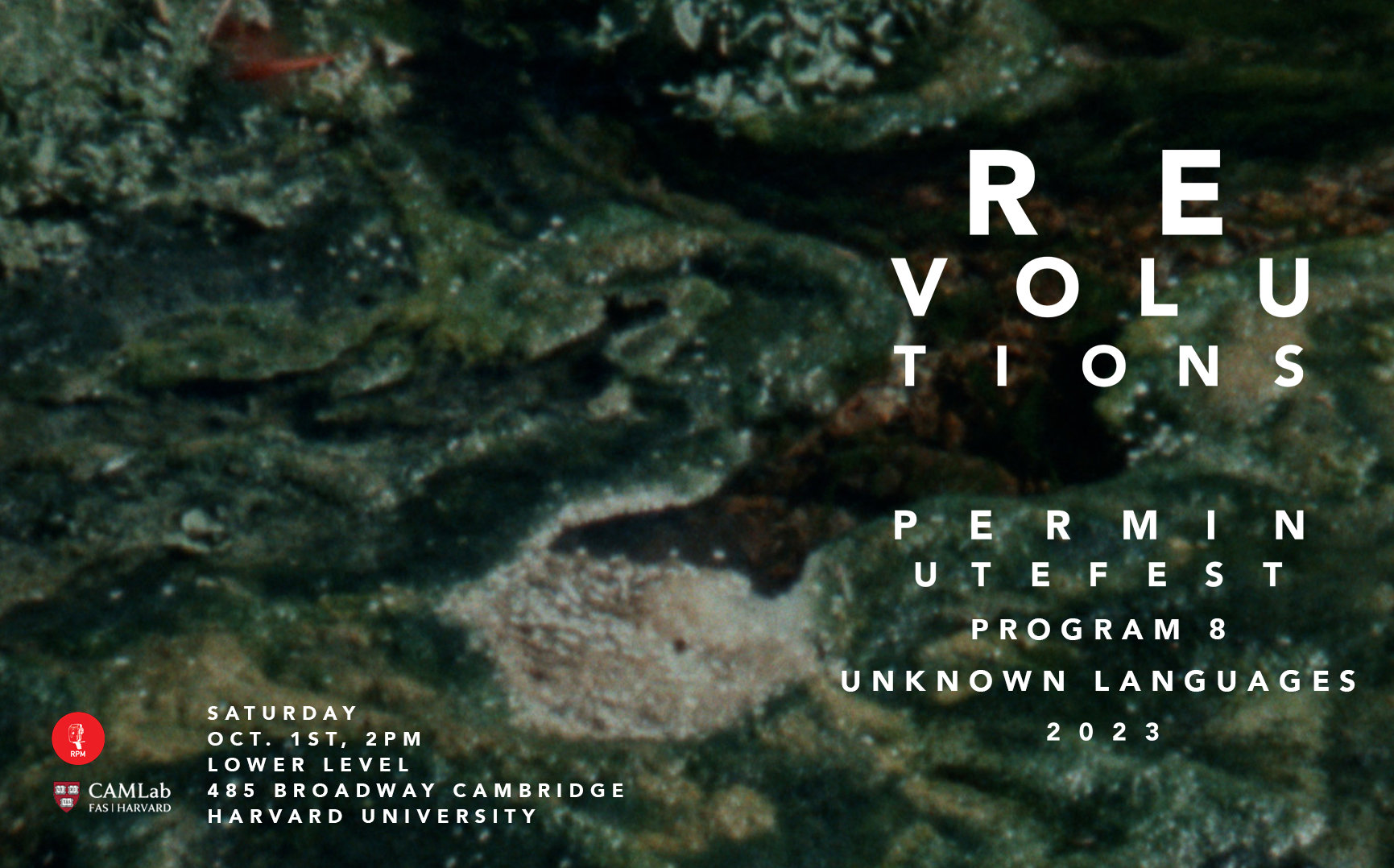
Damp Moss
Christopher Thompson
4mins22secs, 2023, USA, color, sound, super8 to HD
Glittering illusions of vectorized providence attempt to emulate an inherited physical realm of diminishing significance.
Christopher Thompson (1990) is a contemporary American artist and filmmaker whose work examines desire, capital, and the seemingly supernatural forces that govern its acceleration. His films and video works have been featured in film festivals and exhibitions worldwide, including San Francisco Cinematheque’s CROSSROADS Film Festival, Prismatic Ground, Mimesis Documentary Film Festival, the 5th Odessa Biennale at the Odessa Museum of Contemporary Art, and “Late capitalism, it's like, almost over” at The Luminary in St. Louis. He holds a B.A. from the University of Southern Indiana and an M.F.A. from Washington University in St. Louis, where he studied video art and performance. He is also the director of HATERS, an online moving image journal. Thompson lives and works in Brooklyn, NY.
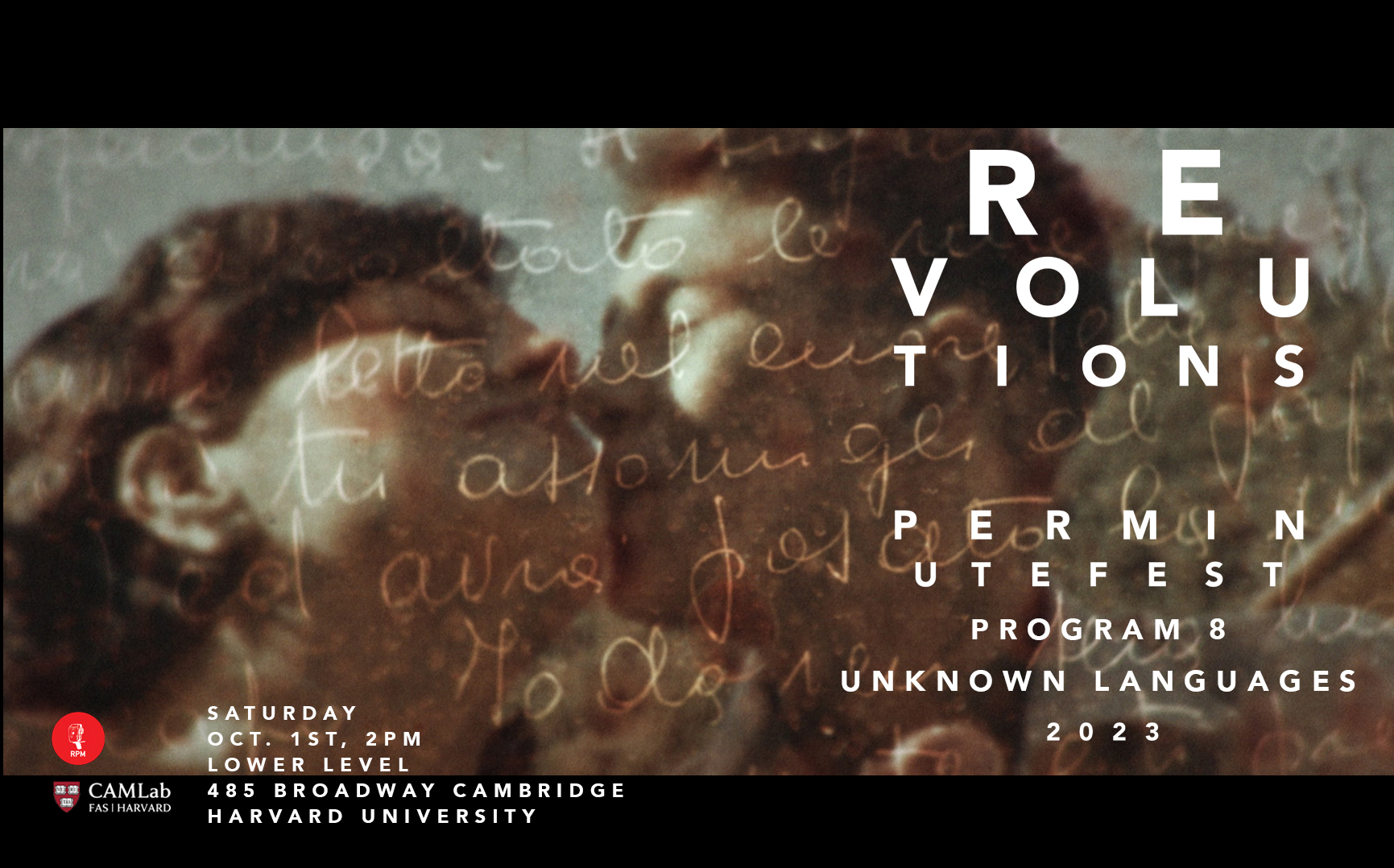
Dear Monster
Stefano P. Testa
15mins, 2023, Italy, Color, Sound, HD
A fragmented collection of letters tells the story of Elio’s passage from adolescence to adulthood. Elio is a restless and disobedient Italian 18-year-old fellow who lives his youth between cheating and betrayals during the swinging 60s.
“Dear Monster” is a collection of authentic documents. However, there are few historical and biographical references to the characters. Voices and handwriting are the only elements useful to draw the senders’ psychological profiles. The texts are read and interpreted by actors; the voices are inserted into sound environments, as if hypothetically present at the time of writing. The film develops visually through a slow overlap of symbolic and evocative images of the inner universe of the young Elio. Through the use of fade effects, the pages of the letters merge with photographs, magazine clippings and some amateur films of the time. The result is a stratification of worn-out textures and faded colours. “Dear Monster” is a backward journey in memories, in search of lost affections.
Stefano P. Testa was born in 1988. He lives and works in Bergamo (Italy) as a camera operator, video editor, colorist and post-production technician. Since 2010 he has been collaborating with Lab 80 film in documentary films production and with Bergamo Film Meeting, in charge of the festival audiovisual communication.
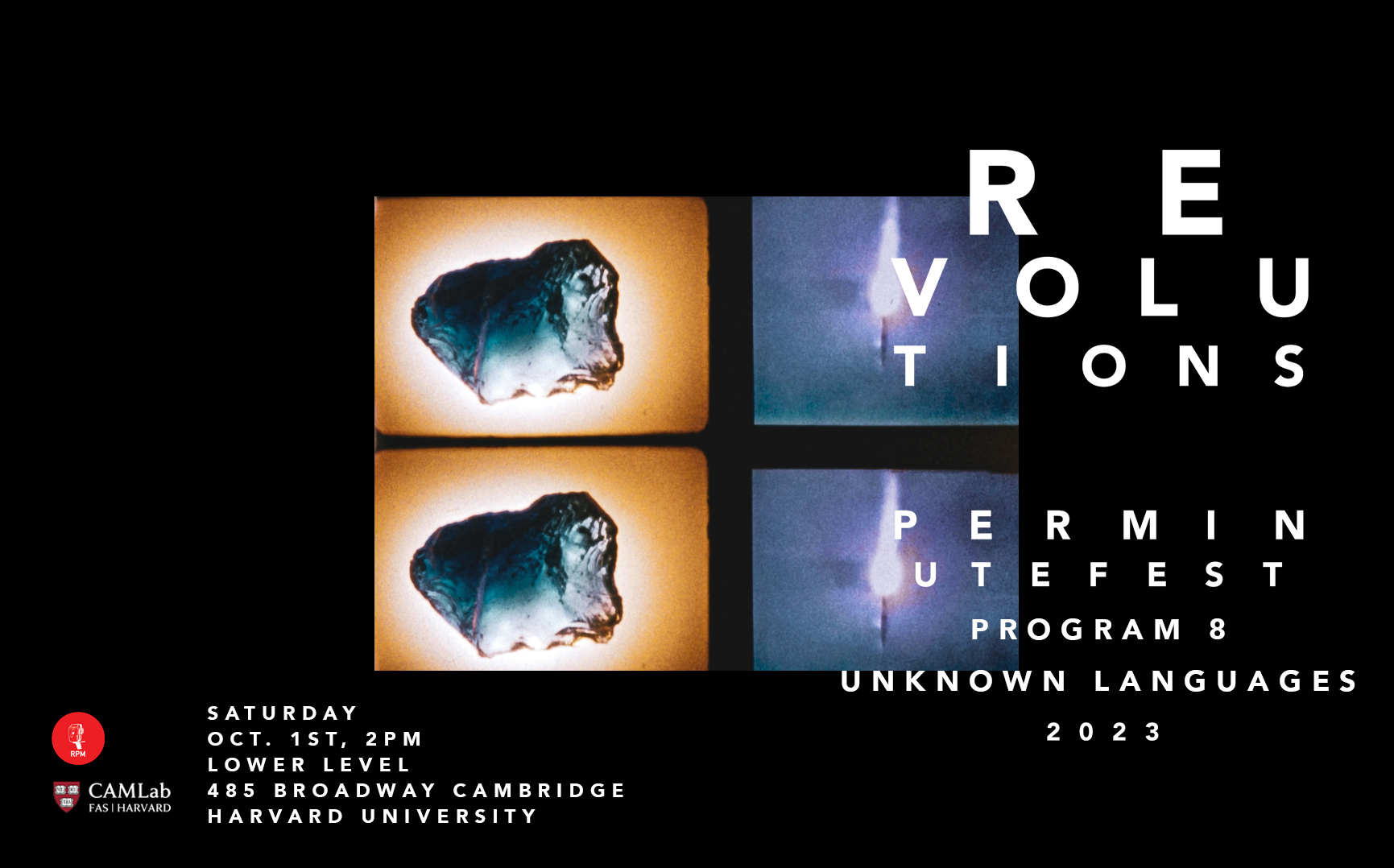
In Littleness
Cherlyn Hsing-Hsin Liu
8mins15secs, 2022, USA, color, sound, 8mm to HD
The film was shot on a regular 8mm camera and is presented in unslit form as 16mm, a screening format commonly referred to as double 8mm.
When I first came into contact with this medium, I was deeply attracted by its miniature size. Eight millimeters is a very small space on which to store images. It reminds me of all kinds of things from childhood: ephemeral, wonderful, changeable. Recalling that as a child I spent most of my time with my nanny, I decided to zoom in on daily life, especially trivial household chores. At the same time, the particles and dust of the childhood world are magnified.
Cherlyn Hsing-Hsin Liu (b. 1982, Kaohsiung, Taiwan) is an interdisciplinary artist, filmmaker and writer whose work is grounded in literature and the conceptual avant-garde. Cherlyn’s creative activity often starts from a life event or curiosity concerning an anomaly in language or in the material world. It continues by employing methods drawn from both Eastern and Western practices and philosophies. Her working method at various times involves handcrafted material, mixed media, and experimental interchange between new and old technologies.
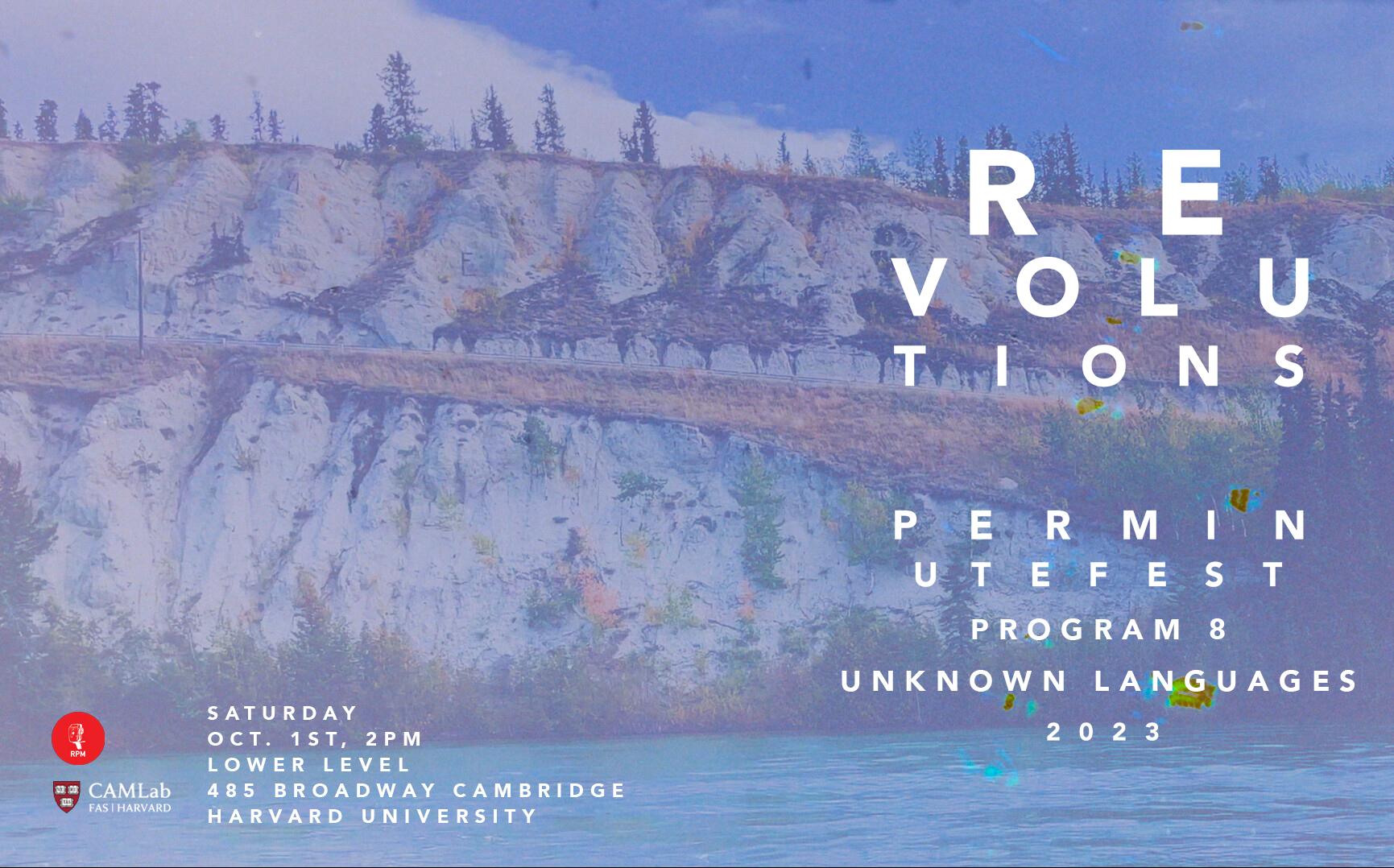
istén:'a
KJ Edwards
5mins12secs, Canada, 2023, Color, sound, 16mm to HD
A poetic retelling of a visit from the artist’s mother, istén:'a looks to dreamspace as a meeting place for us and our late loved ones who we are always tethered to.
KJ Edwards is a Kanien’kehá:ka,mixed-settler filmmaker and media artist. Their family is from Kahnawa:ké and Longueuil, Quebec, Canada; while KJ was born and raised in Treaty 6 Territory, Edmonton, Alberta, Canada.
Holding a BFA in Film Production from the Toronto Metropolitan University, KJ is trained in narrative, documentary and experimental filmmaking techniques, using both analogue and digital hybrid workflows. They are a 2023 MFA graduate from Emily Carr University of Art + Design, located on unceded traditional Musqueam, Squamish and Tsleil-Waututh Territory in Vancouver. KJ's thesis work involved eco processing analogue film, reflecting on the unpredictability of the medium as that of a collaborator, and the ways that dreams and memory can offer creative pathways toward content creation.
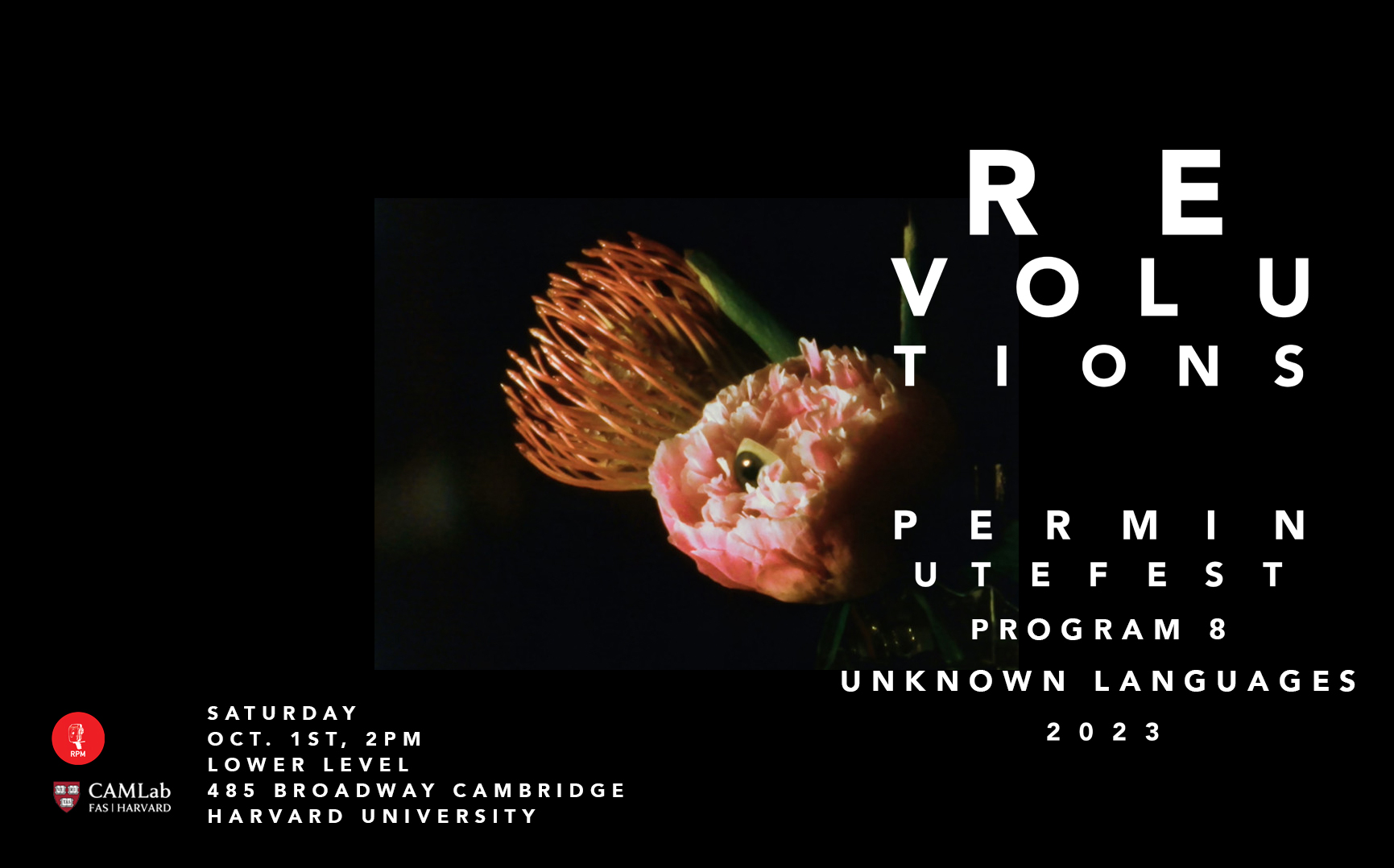
Language Unknown
Janelle VanderKelen
6mins10secs, 2022, USA, color, sound, 16mm to digital
This film embraces plant sentience as fact and speculates how beings of the vegetal variety might approach interspecies communication with humans (who are far more sensorially limited). Leaves, mycelium, and roots playfully examine how humans experience the world, and the (supposedly) silent watchers consider what language those swift blurs of human might possibly understand.
Janelle VanderKelen is an artist, curator, and educator currently based in Knoxville, TN. Her films and intermedia installations imagine alternative acts of relation between imperfect bodies (human, vegetal, geological, or otherwise) and make visible the agency of plants through experimental time-based media processes.
VanderKelen’s work has been exhibited at institutions including the Boulder Museum of Contemporary Art in Boulder, CO; Anthology Film Archives in New York; and Bow Arts in London, England. Her films have screened at Ann Arbor Film Festival, True/False, Athens International Film + Video Festival, Revelation Perth International Film Festival, IC DOCS, San Diego Underground Film Festival, and Antimatter [Media Art] Film Festival.
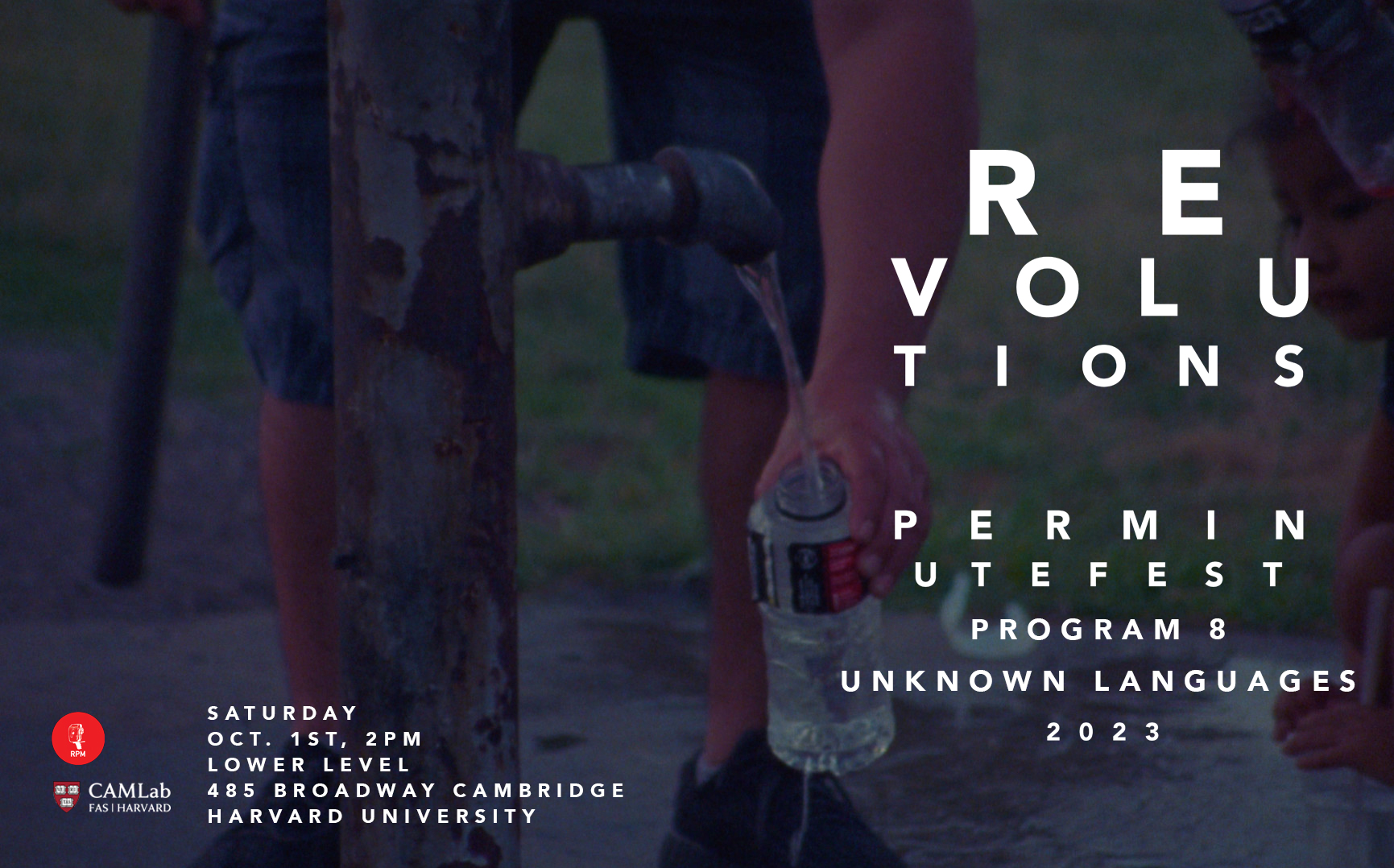
Pump
Charles Cadkin
4mins42secs, 2022, USA, color, sound, 16mm to digital
On the Northwest side of Chicago, large swaths of people have been gathering for decades to fill their containers with water from a magical water pump.
Charles Cadkin is a visual artist concerned with documenting and preserving neglected personal and local histories through topography, landscape and body. He holds a BS in Cinema and Photography from Ithaca College and resides in Chicago, IL.
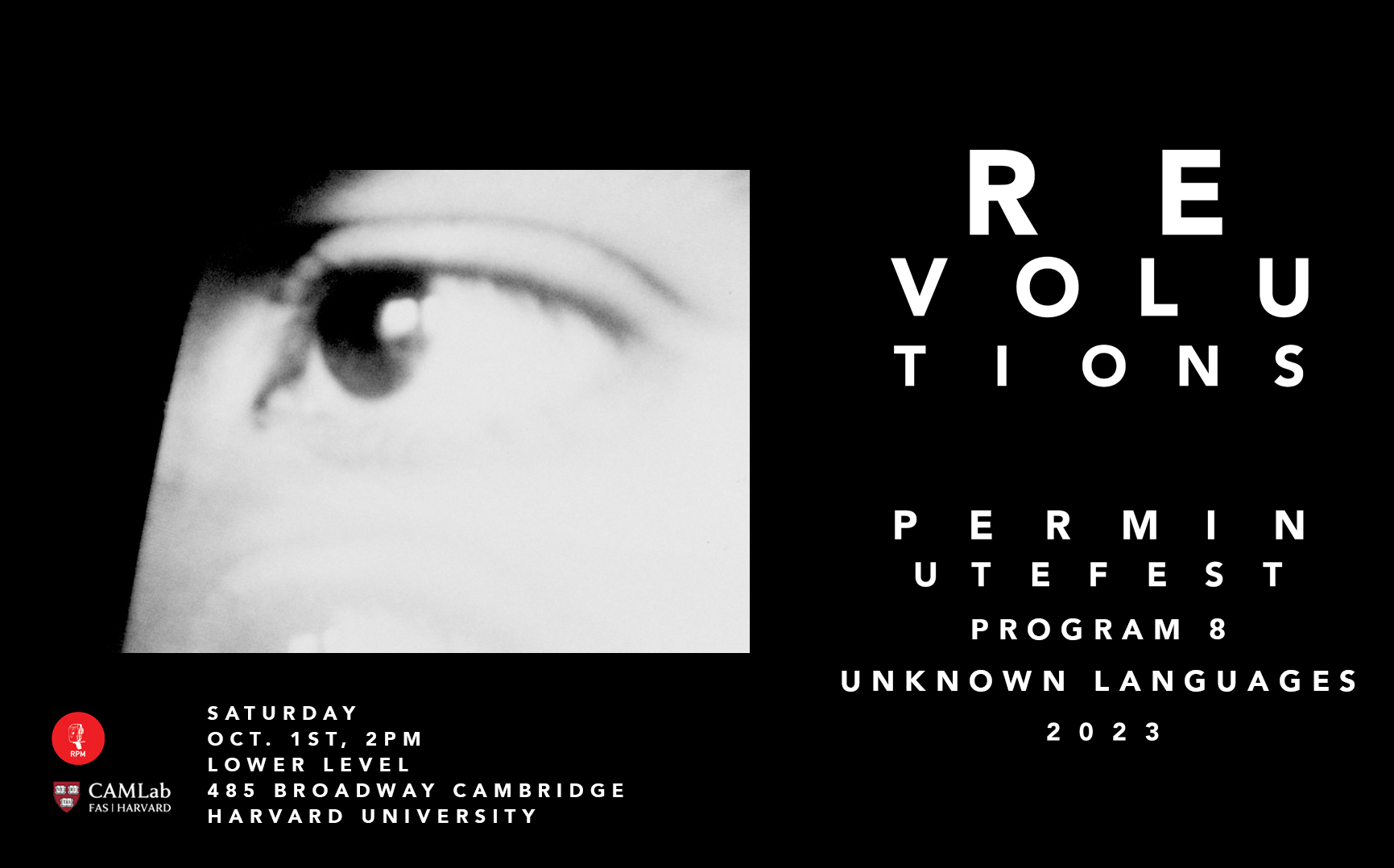
This Is How I Felt
Josh Weissbach
1mins35secs, 2022, USA, B/W, sound, 16mm
This Is How I Felt was filmed in a twenty-four period while the filmmaker was wearing a heart monitor to investigate possible arrhythmias.
Josh Weissbach is an experimental filmmaker. He lives in a house with his wife, two daughters, three cats, and six chickens next to a once abandoned village.
His films and videos have been shown worldwide in such venues as Ann Arbor Film Festival, Slamdance Film Festival, European Media Art Festival, Mono No Aware, Chicago Underground Film Festival, 25 FPS Festival, and Alchemy Film and Moving Image Festival. He has won jury prizes at Videoex, ICDOCS, $100 Film Festival, Onion City Experimental Film and Video Festival, Berlin Revolution Film Festival, and Haverhill Experimental Film Festival.
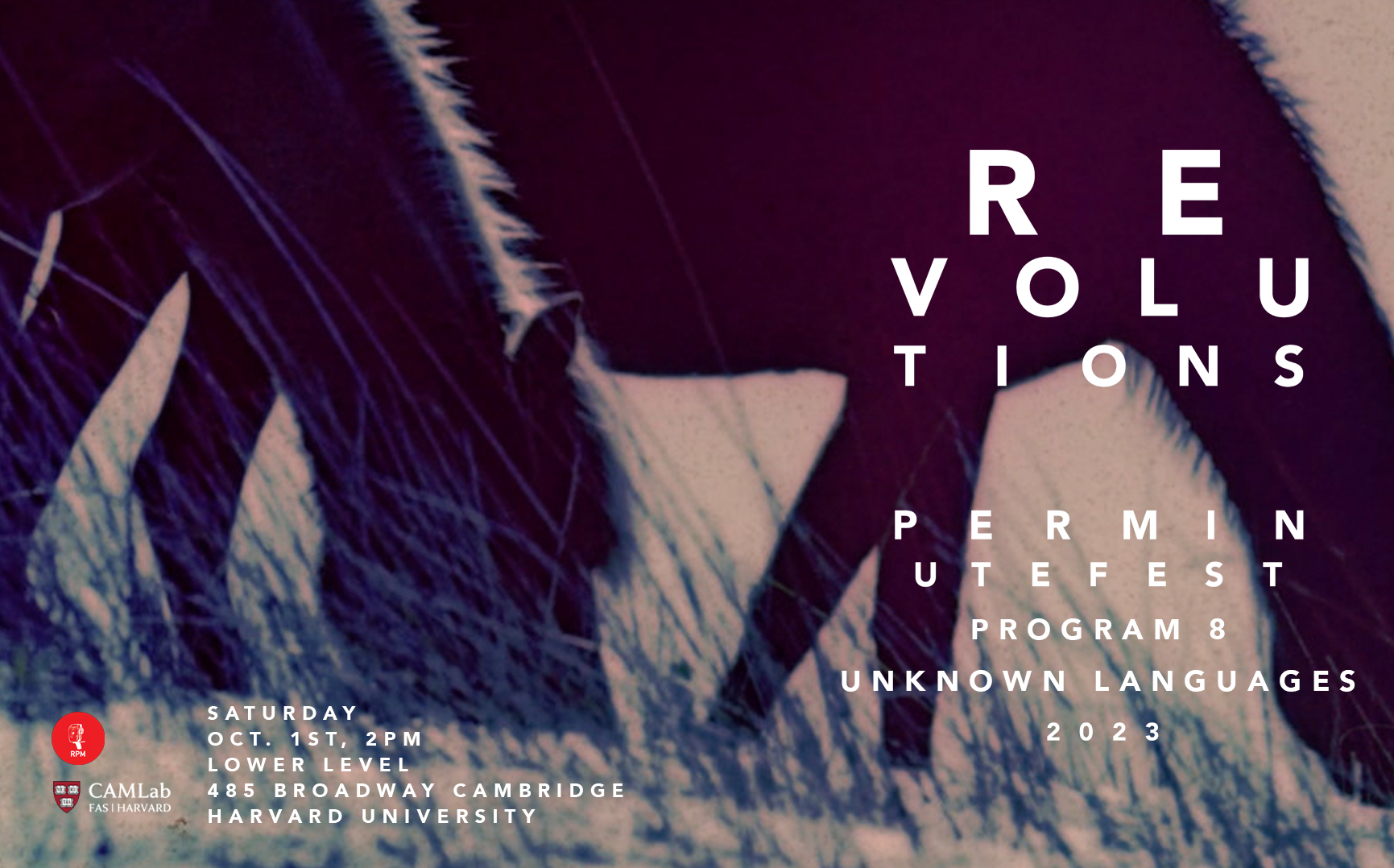
With The Tide, with the tide
Anna Kipervaser
2mins49secs, 2022, USA, Color, sound, 16mm to digital
I know, you're a seasonal beast
Like the starfish that drift in with the tide
With the tide
So until your blood runs
To meet the next full moon
Your madness fits in nicely with my own
With my own
Your lunacy fits neatly with my own
My very own
- from Sea Song by Robert Wyatt
Anna Kipervaser is a Ukrainian-born artist whose practice engages with a range of topics including human and animal bodies, ethnicity, religion, colonialism, and environmental conservation. Her engagement with these topics is informed by a commitment to formal experimentation, DIY and alternative processes, spanning disciplines including experimental and documentary moving image works in both 16mm film and digital video.
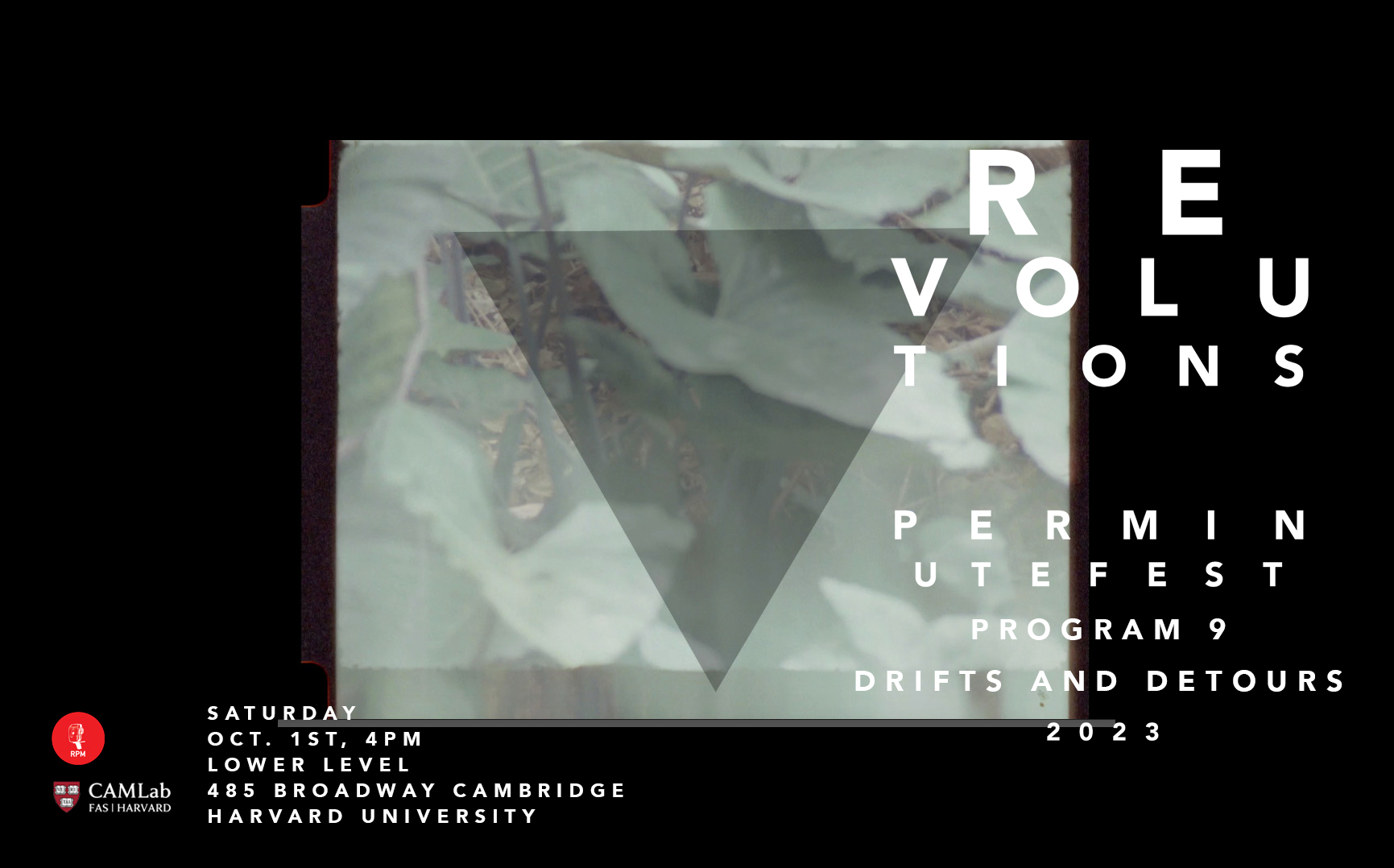
Sunday
Oct. 1, 4pm
Harvard FAS CAMLab
Lower Level
485 Broadway Cambridge
MA 02138
Harvard University

From Here
Flor Marmolejo
2mins, 2023, USA, Color, sound, digital
Reclamation Project No. 1
Tyler Bohm
1min13secs, 2022, USA, Color, sound, HD
In these rows of hurried lines
Michel Boulanger
9mins9, 2022, Canada, B/W, sound, HD
Panorama
Djuly Gava & Daniel Leão
17mins, 2023, Brazil, Color, Sound, 4k
Show de bleu
Antoine Larocque
2mins, 2022, Canada, color, sound, HD
Continental Drifts
Georg Koszulinski
12mins, USA, 2022, Color, sound, HD
I Gave It To You
Claire Maske
2mins45secs, 2022, USA, B/W, sound, 16mm to digital
Homesick Lungs
Felix Klee
15mins, 2022, Germany, B/W, sound, digital
total: 76 mins
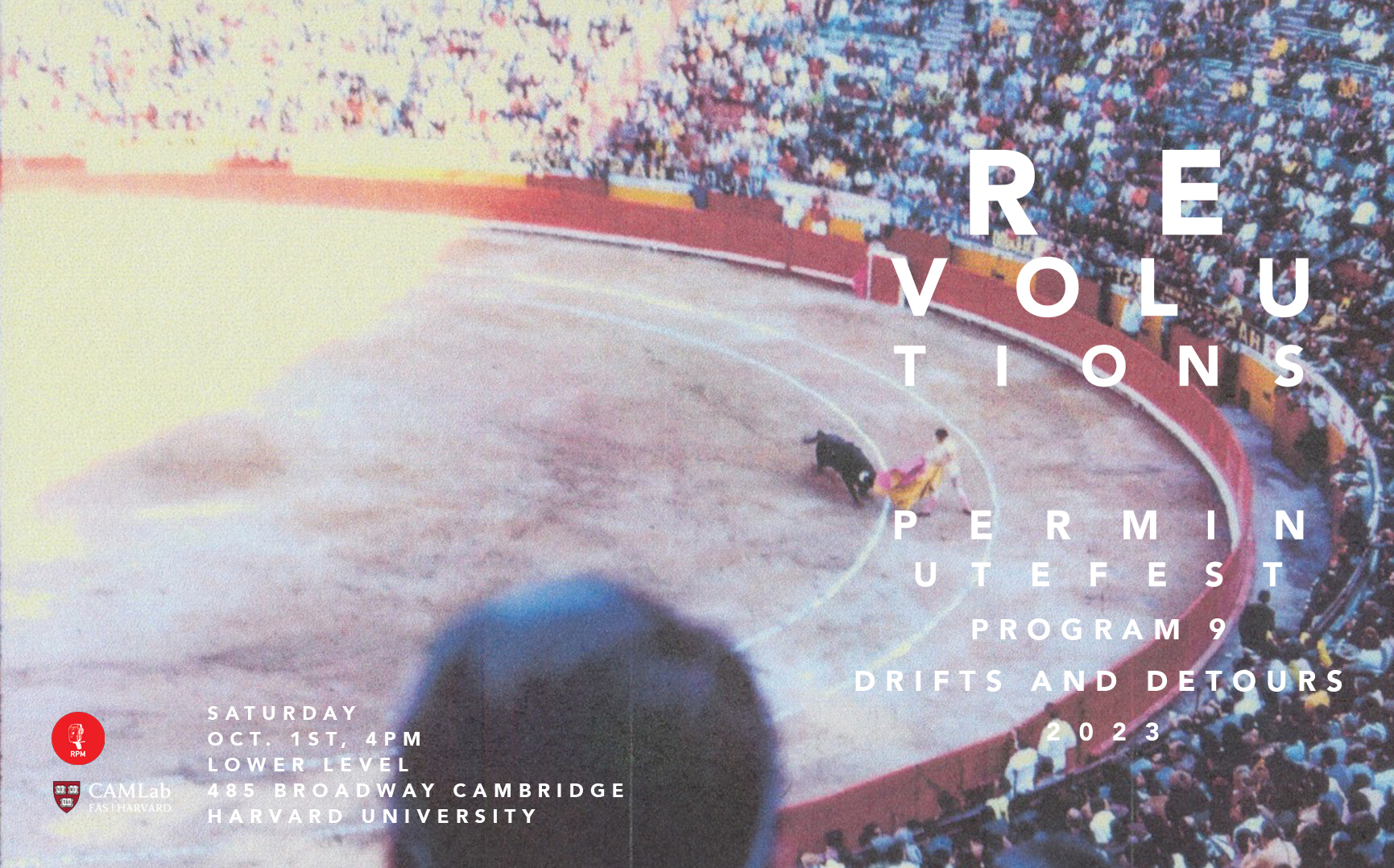
From Here
Flor Marmolejo
2mins, 2023, USA, Color, sound, digital
Thoughts about belonging, cultural symbols, and personal loss.
This short essay film grew out of my inability to reconcile with the distance that separates me (as a hyphenated-American) from my country of origin. Rather than a lived, embodied knowledge of Mexico, I walk around with myths and symbols that are my access to a country that should be so familiar. Entwined with this subjective experience is the objective reality that these same cultural myths and symbols shroud a palpable violence that lurks beneath the surface in Mexico. When faced with the disappearance of someone close to me, the distance shrouds them in a mythic story for me as well.
Flor Marmolejo
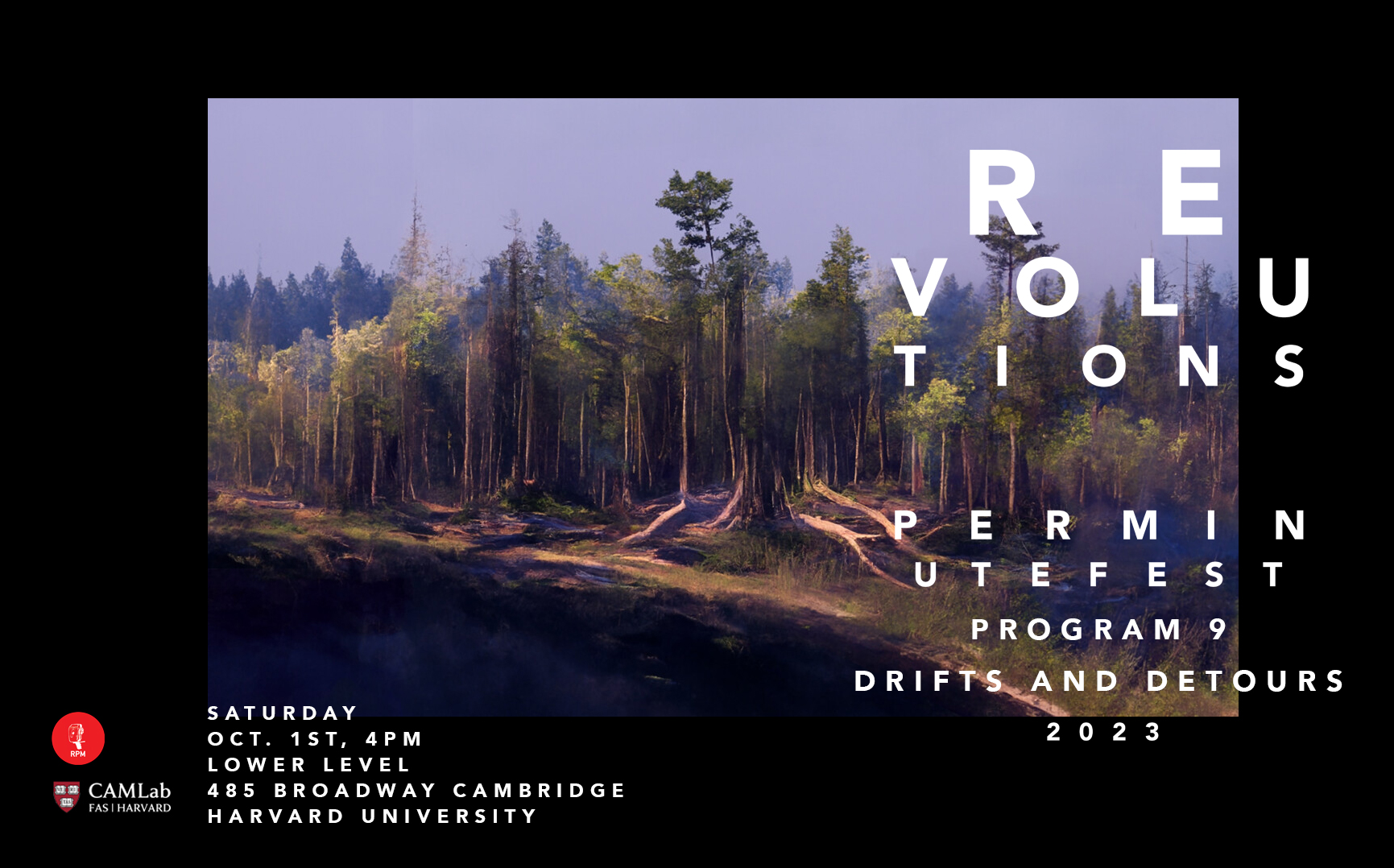
Reclamation Project No. 1
Tyler Bohm
1min13secs, 2022, USA, Color, sound, HD
Reclamation Project No. 1 is an AI-driven experimental short which explores an urban environment reverting to its natural state. The work represents both a reversion to an earlier era, and, potentially a progression through climatic upheaval into a future state where nature has reclaimed the city.
Ty Bohm is a new media artist and filmmaker who spent several years working in the architectural industry, where he adopted the tools of digital modeling to create experimental works exploring the impact of technological advancement.
In recent years, his work has been shown at FILE Festival (São Paulo), CineAutopsia (Bogotá), Cue Art Foundation (New York), Museum of Science Boston, Science Gallery Atlanta, NURTUREart (Brooklyn), Equity Gallery (New York), Boston Cyberarts Gallery, Terrault Contemporary (Baltimore), Proto Gomez (New York), Icebox Project Space (Philadelphia), Trestle Gallery (Brooklyn), Weston Art Gallery (Cincinnati), Gallery Madison Park (New York), Proto Gallery (Hoboken, NJ), Plexus Projects (Brooklyn) and Ann Street Gallery (Newburgh, NY). He is a graduate of Kenyon College and University of Oxford and lives in San Diego.
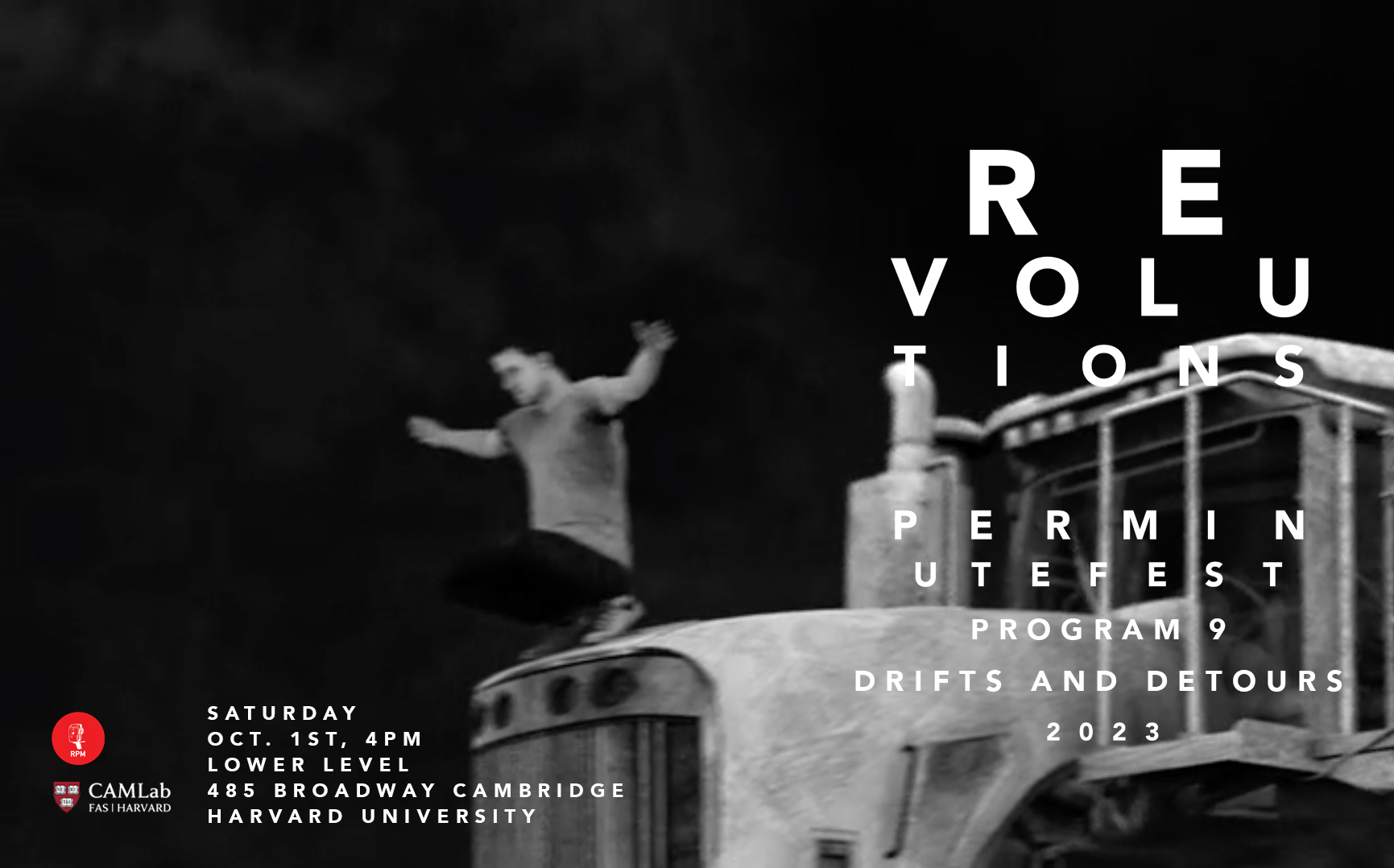
In these rows of hurried lines
Michel Boulanger
9mins9, 2022, Canada, B/W, sound, HD
This video depicts the torment of a farm worker who ends up sabotaging his watering plan and abandoning his tractor to better enter into a sensual relationship with the earth and the vegetation. The character questions the disembodied relationship to time and space in his work. As a challenge to break with his work schedule, our farmer performs a kind of ballet on his powerful machine before running in the fields, stopping, or rolling on the ground getting better interest in the details of the ground, following the sinuous line of a grass snake on a ground marked by the straightness of the lines. On a poetic tone, his voice is an ode to the reappropriation of time and space, a return to a form of existence where the movement of the body in itself is a strong moment.
Michel Boulanger, born in Montmagny, Québec, is a multidisciplinary artist that lives
and works in Montréal. He holds a master’s degree in Visual Arts from Université du
Québec à Montréal (1992). Michel Boulanger has participated in several exhibitions in Canada and in countries overseas, such as the United-Kingdom, France, Spain, the United-States and Mexico. In 2004, his work was featured in a solo exhibition at the Musée d’art contemporain de Montréal. His works furthermore belong to a number of public and private collections. Founding member of Galerie B-312, he has been professor at the École des arts visuels et médiatiques de l’UQAM from 2001 to 2020 where he started Grupmuv, a research-creation laboratory dedicated to drawing and moving images with professors Gisèle Trudel and Thomas Corriveau.

Panorama
Djuly Gava & Daniel Leão
17mins, 2023, Brazil, Color, Sound, 4k
Panorama is a marginal film like Panorama, one of the largest housing projects in southern Brazil. Located on the side of a highway on the outskirts of Florianópolis, the Panorama Housing Project was built in 1989, the year of the first Brazilian presidential election after the end of the military dictatorship. Through the appropriation of archival footage of the residents, the film narrates the passage of time in community life. Directed and edited by residents of the complex, Panorama is both an ode to possible joys of everyday life and a subtle reflection about what leads us to photograph, the ways of permanence of the past and the migration of images from familiar contexts to the public and common territory of the cinematic space.
Djuly Gava (Florianópolis, 1995) holds a master's degree in Contemporary Artistic Processes and is graduated in Visual Arts by the State University of Santa Catarina. She participates in exhibitions and art fairs since 2013, such as: 11th National Salon Victor Meirelles, 2022; 15th National Salon of Itajaí, 2021; Tijuana Printed Art Fair, Casa do Povo, São Paulo/SP, 2019; Microutopias - Feria de Arte Impreso de Montevideo, Centro Cultural España, Montevideo/Uruguay, 2019. Her photographic work is part of the collection of Santa Catarina Art Museum. She has been working with cinema since 2015.
Daniel Leão (Rio de Janeiro, 1984) is a documentary filmmaker, visual artist, professor and book editor. Graduated in cinema from Fluminense Federal University (2010),
Master in Image and Sound Analysis from the same institution, Doctor in Visual Arts from State University of Santa Catarina with a sandwich period at New York University (2020) and is
currently carrying out post-doctoral research in the area of Literature about the Brazilian documentaries about the coup d’état against former president Dilma Rousseff.
Daniel has been working as documentarist and visual artist since 2013, works that have been exhibited in several Brazilian and international institutions,
such as the Museum of Modern Art in New York (MoMA).
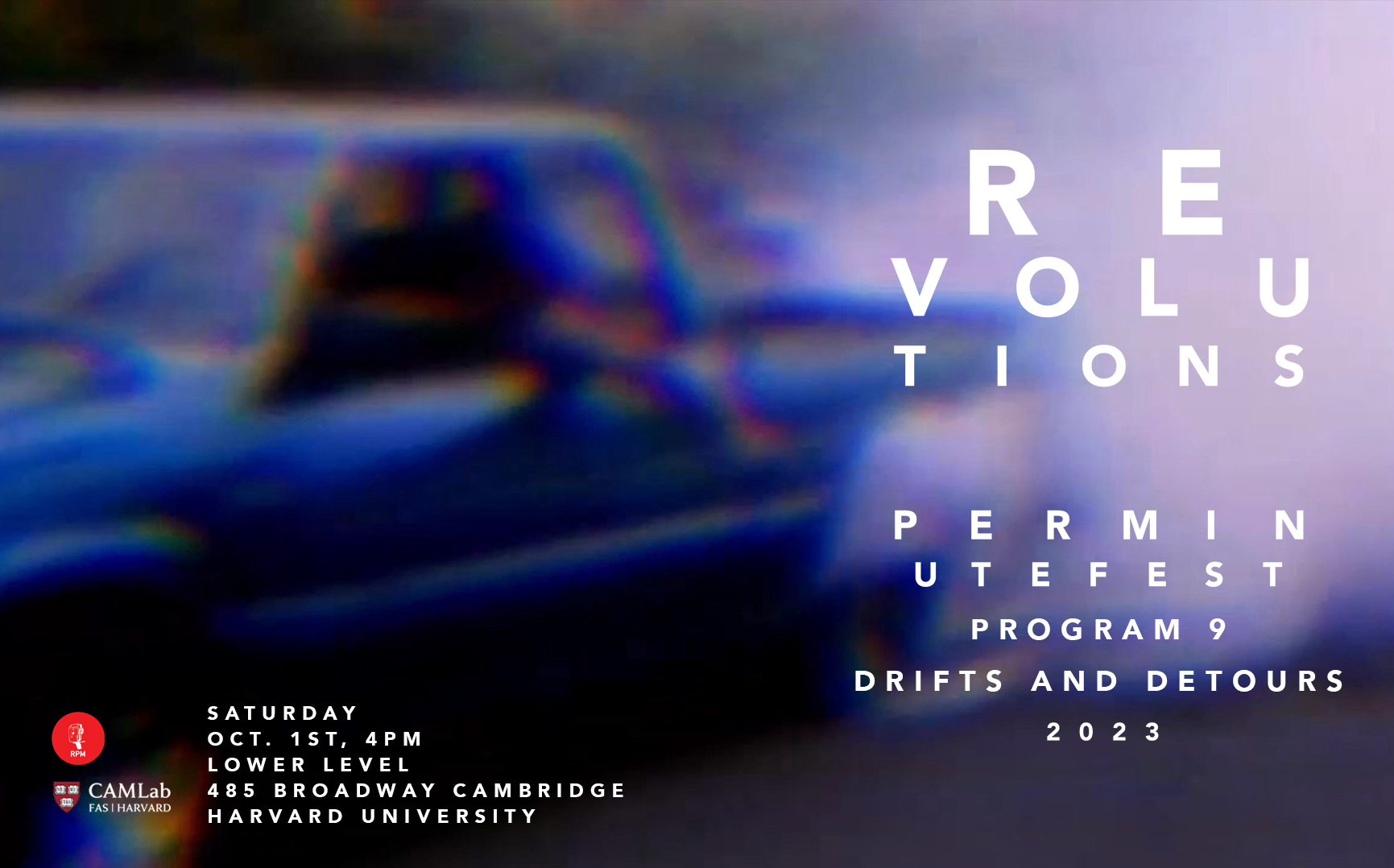
Show de bleu
Antoine Larocque
2mins, 2022, Canada, color, sound, HD
Show de bleu (2022) is a short film shot in Tingwick, in the Centre-du-Québec region. The title of the work comes from a Quebec expression which refers to burnout. Tire squealing (burnout) occurs when motorists cause their vehicles to lose traction so that the accelerated rolling of the wheels generates blue smoke. This practice, deemed illegal by the road safety code, highlights life in rural areas and the leisure activities that constitute it. The video thus highlights automobile culture through the encounter between its followers. By trying to “leave their mark”, they participate in a form of filial ritual. The sequence of images is taken from scenes found and filmed by Antoine Larocque. It is accompanied by a soundtrack created by the composer Charles Barabé.
Born in Arthabaska in 1995, Antoine Larocque is a visual artist. His work is characterized by a personal, raw and experimental approach to the image. He favors rudimentary means and elements found in his daily life, with the aim of transfiguring the aesthetic codes of the popular culture of the region where he grew up. He mainly uses photography, painting, video and writing. His video works are distributed by Vidéographe and have been broadcast in Canada and internationally.
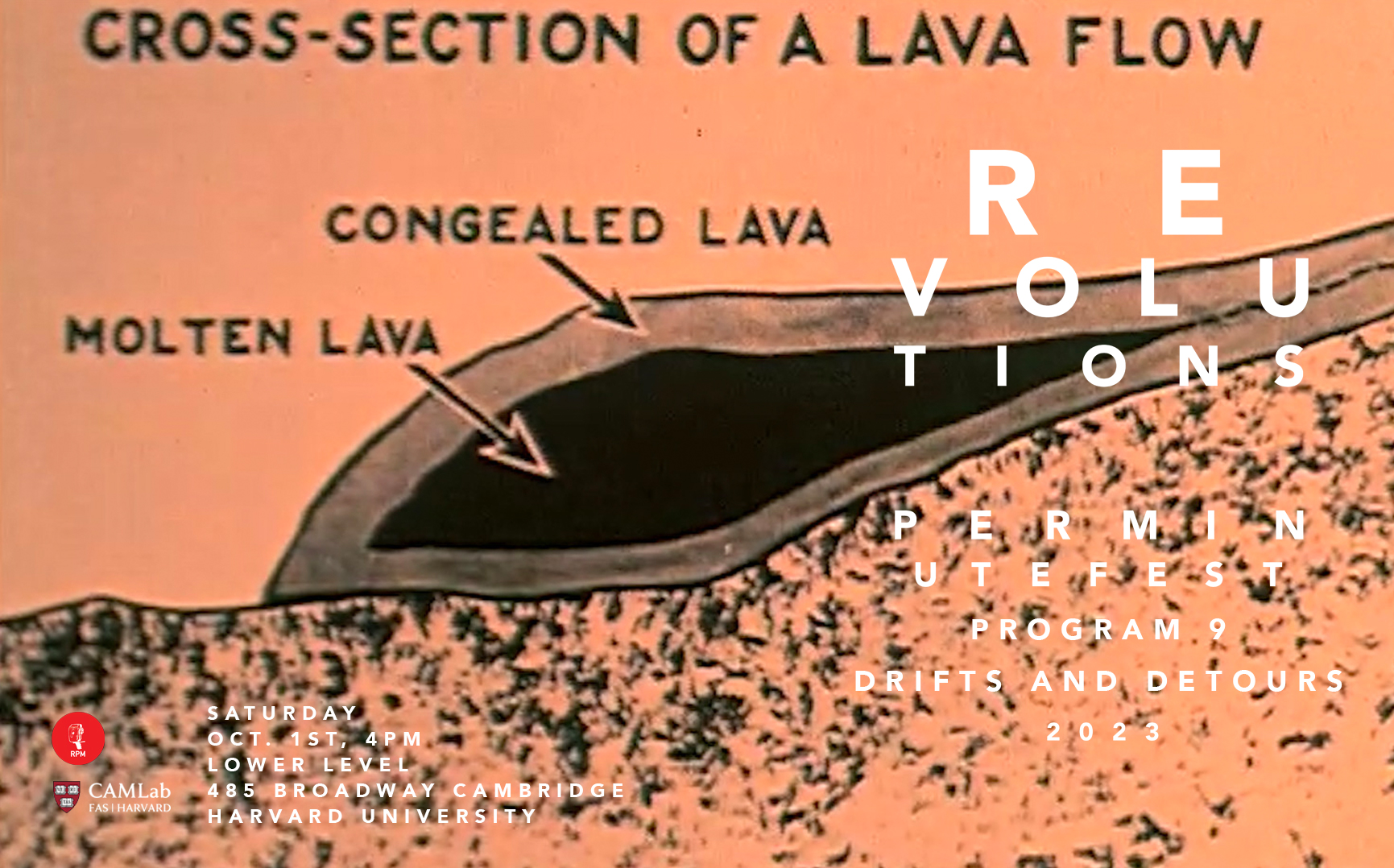
Continental Drifts
Georg Koszulinski
12mins, USA, 2022, Color, sound, HD
A fictional account of David Koresh’s last words, a cursory analysis of the pantheon of Icelandic sagas, a home movie taking into account 20 years of filming on an old Bolex 16mm camera, a series of reflections on the destructive nature of industrialized societies: a collage film, metaphysical road trip movie in time of pandemic and social uprising. A point-and-shoot epistolary fever dream collage film made in times of multiple crises.
Georg has been making films and videos since 1999. His recent work engages issues of the Anthropocene and merges his interests in science, poetry, and radical forms of non-fiction filmmaking. His award-winning works have been presented at hundreds of film festivals around the world. Georg is an associate professor of film studies at the University of North Carolina - Wilmington where he teaches courses in documentary & experimental modes of filmmaking.
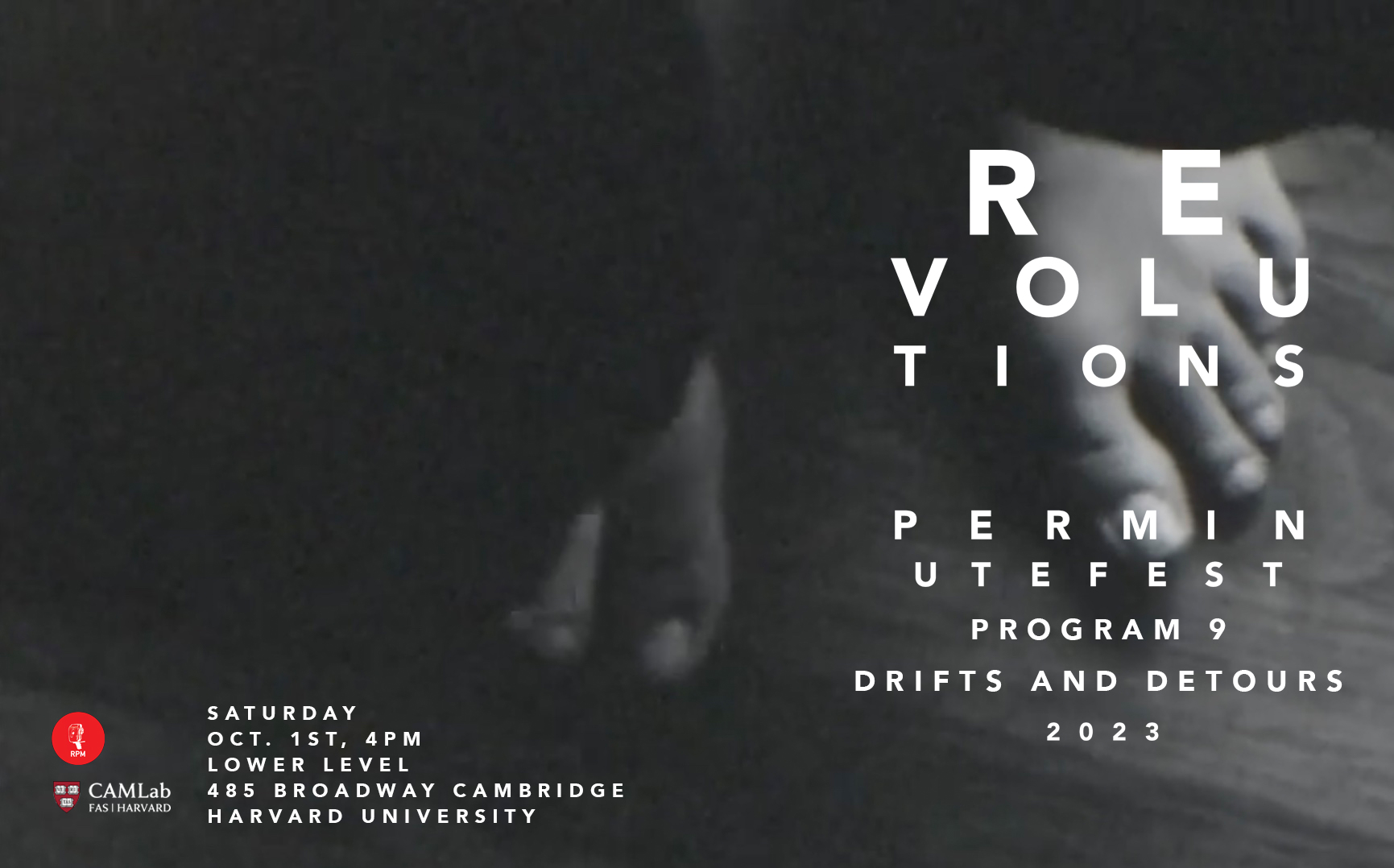
I Gave It To You
Claire Maske
2mins45secs, 2022, USA, B/W, sound, 16mm to digital
Two friends discuss guilt and personal responsibility after one transmits covid to another during an already hard time in her life.
Claire Maske is an artist and filmmaker currently based in boston:
Her work largely revolves around themes of illness, grief, and death- She is interested in the body and all the ways it can fail. Much of Her work is informed by own experiences of grief and loss, and Her anxieties surrounding these topics fuel its form and content.
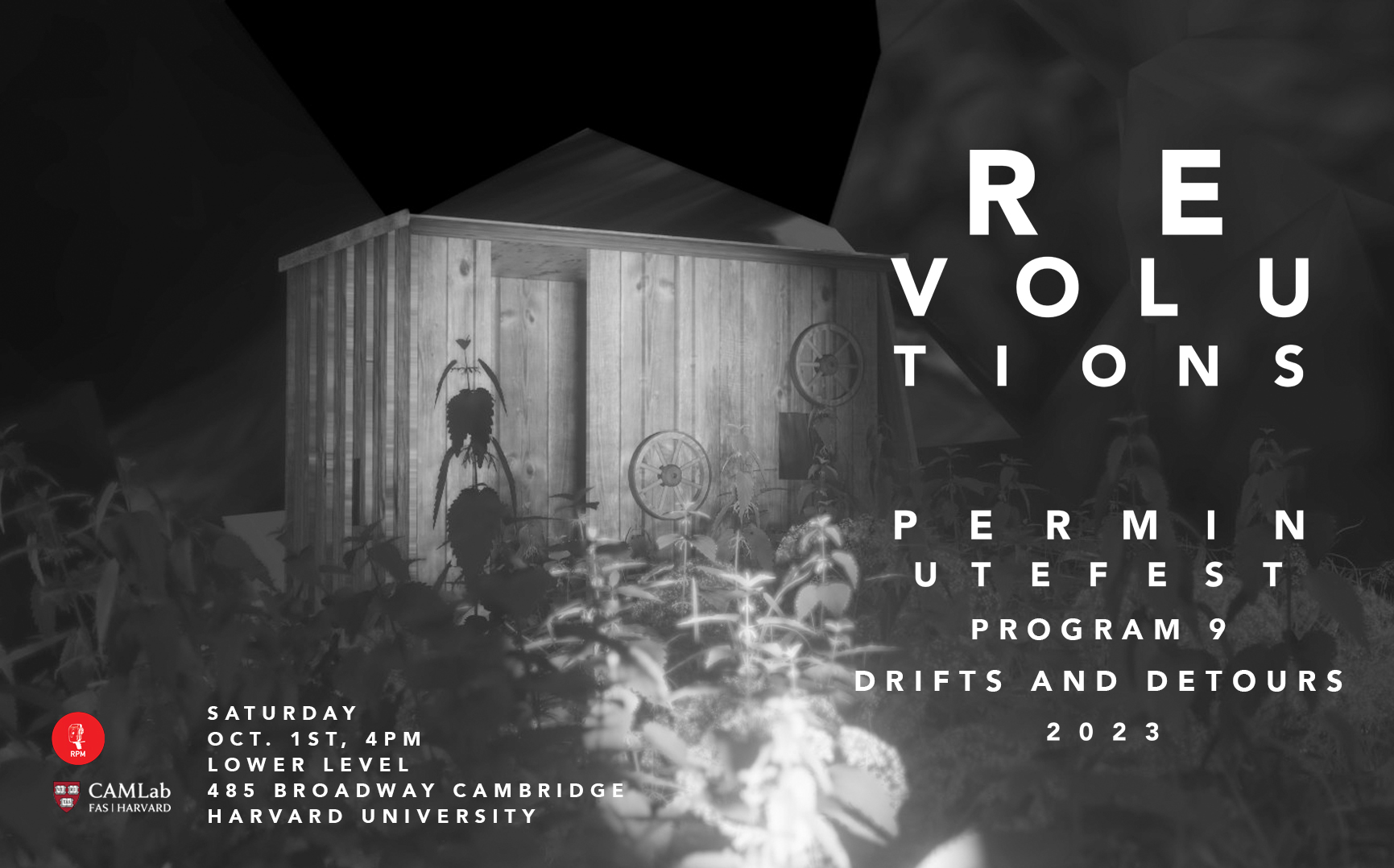
Homesick Lungs
Felix Klee
15mins, 2022, Germany, B/W, sound, digital
You can't bring back a dead horse, but there are ways to step into a place that was lost.
"Homesick Lungs" is an experimental farewell. The film delves into the lungs of Sheila, the dying horse, and the history of a sold family farm. 3D animations, screen recordings and documentary footage combine to form an essay on reconstructed memory. In the end, the wind brushes through virtual nettles.
Felix Klee (*1990) lives and works in Munich where he currently studies directing for documentary film at University of Television and Film Munich.
From 2020 – 2022 he serves as an advisory board member at Locarno Film Festival.
Together with Gisela Carbajal Rodríguez he received the 12-month media art scholarship by Kirch foundation and HFF Munich for 2022.
In 2019 he received Kirch foundation's project founding grant.
He is a graduate of the Academy of Fine Arts Munich where he studied time-based media under Prof. Julian Rosefeldt and painting under Prof. Pia Fries. He studied painting under Prof. Thomas Hartmann at the Academy of Fine Arts Nuremberg and was a guest student at Universidad de las Artes Aguascalientes Mexico.

RPM Festival and the Brattle Theatre are excited to announce our co-presentation of "Waiting for Snow," a long-awaited tribute to the avant-garde filmmaker Michael Snow. This special event will showcase three of Snow's classic films, namely "New York Eye and Ear Control" (1964), "Wavelength" (1967), and "Standard Time" (1967), in their original 16mm format. The screening is scheduled for October 17th at 8:00 PM at the historic Brattle Theatre in Cambridge.
Michael Snow (1928 -2023), a trailblazer in the world of experimental cinema, once stated, "My paintings are done by a filmmaker, sculpture by a musician, films by a painter, music by a filmmaker, paintings by a sculptor, sculpture by a filmmaker, films by a musician, music by a sculptor." This encapsulates his multidisciplinary approach to art, which has had a lasting impact on film, music, and visual arts.
The soundtrack of "New York Eye and Ear Control" (1964) was recorded by the Jazz Improvisations group led by avant-garde jazz saxophonist Albert Ayler, featuring trumpeter Don Cherry, drummer Sonny Murray, and other notable figures in New York's free jazz scene. One of the highlights of this event is the rare screening of Michael Snow's groundbreaking film "Wavelength," which hasn't been publicly shown in Boston for two decades. Don't miss this rare chance to immerse yourself in the visionary world of Michael Snow.
New York Eye and Ear Control
16mm, 1964, 34 min. B/W, sound.
Wavelength
16mm, 1967, 45 min. Color, Sound.
Standard Time
16mm, 1967, 8 min. Color, Sound.
Screening format: 16mm (16mm prints courtesy of Canyon Cinema. )
total: 87 mins
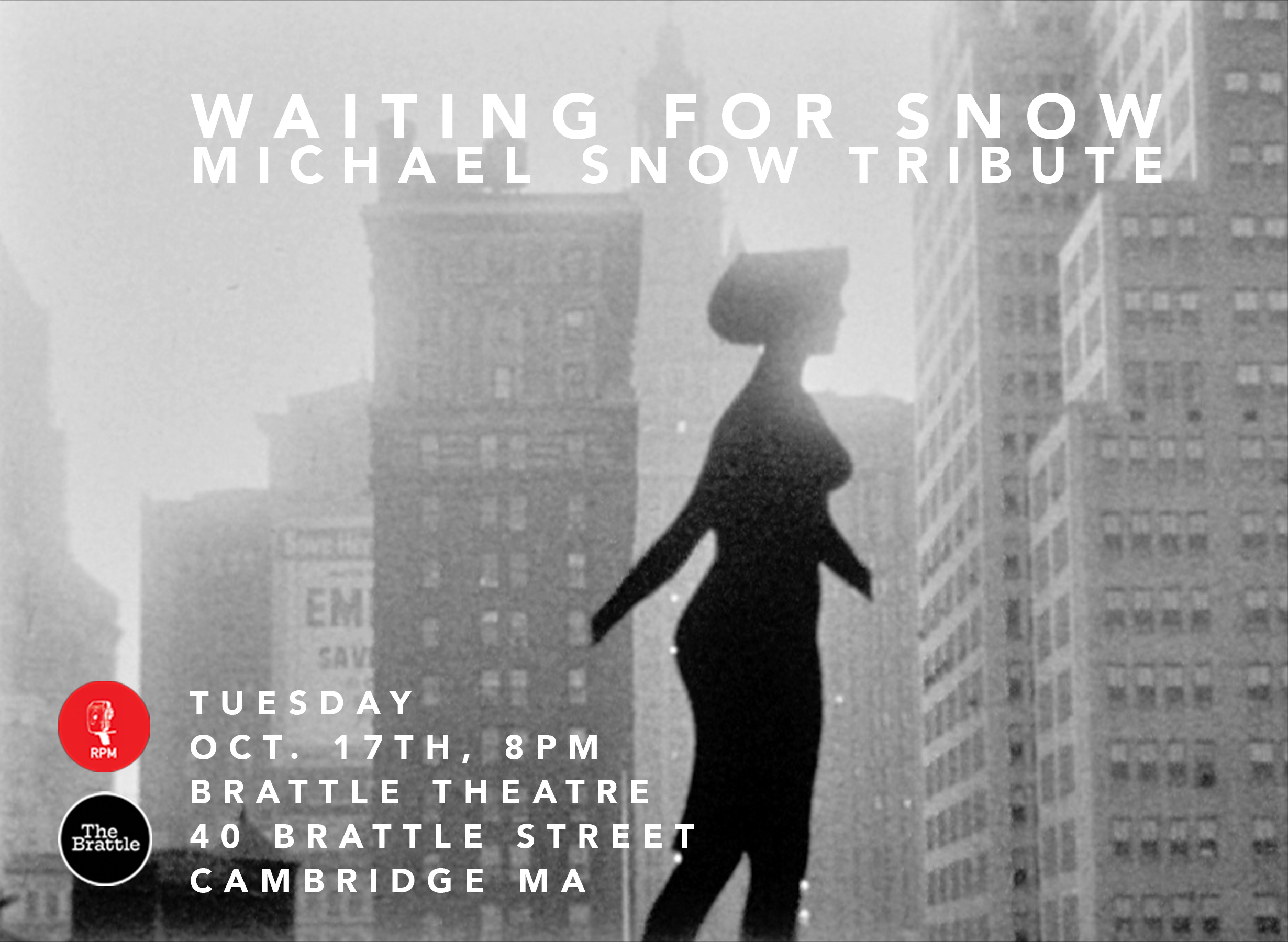
Michael Snow (1928 - 2023) was one of the world’s leading experimental filmmakers, having inspired the Structural Film movement with his groundbreaking film Wavelength (1967). Snow’s extensive and multidisciplinary oeuvre includes painting, sculpture, video, film, sound, photography, holography, drawing, writing, and music. His work explores the nature of perception, consciousness, language, and temporality.
Snow was born in 1928 in Toronto, where he lived and worked until his death in 2023. He received honorary degrees from the University of Toronto (1999), the University of Victoria (1997), the Nova Scotia College of Art and Design (1990), and Brock University (1975).
Jake Shainman Gallery
Michael Snow traces the dualistic structure of his work to his Canadian upbringing between two cultures—English and French—and his early awareness of the different qualities of sight and sound, learned from his parents. Having studied at the Ontario College of Art in his native Toronto, he travelled in Europe in the 1950s and lived in New York in the 1960s. Snow’s contributions to three spheres of cultural activity—visual art, experimental film, and music—have been recognized internationally.
-- By Martha Langford
Brattle Ticket Info

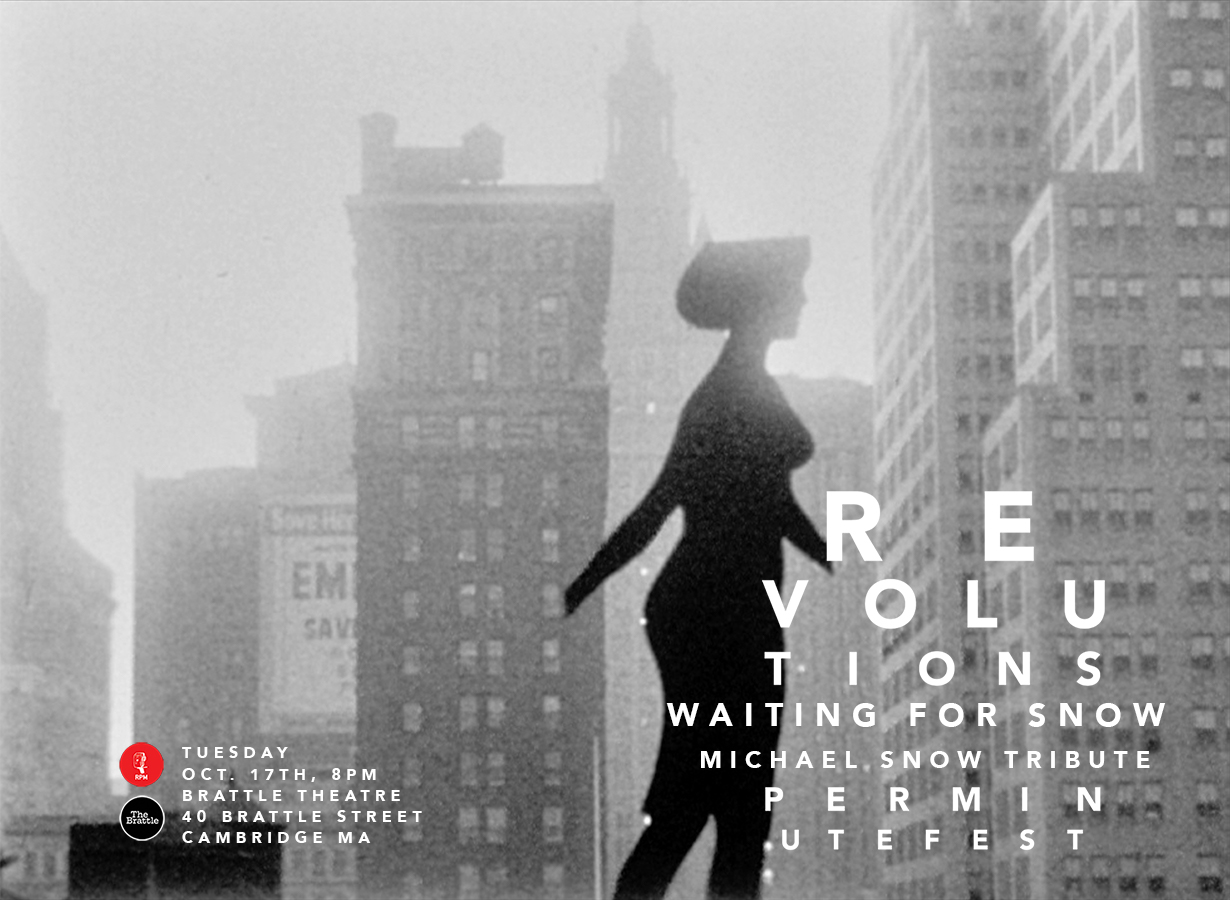
New York Eye and Ear Control
1964 | 34 minutes | B&W | OPT
"One of the major achievements of the sixties. Michael Snow postulates an eye that stares at surfaces with such intensity...
The image itself seems to quiver, finally gives way under the pressure. A deceptive beginning - silent: a flat white form sharply cut to the silhouette of a walking woman...
More Human images, love-making - a Human epic now still ruled by the after image of the "Walking Woman". As in no other film yet seen, its alternately soft and granite images
lift us toward the year 2000; capturing not events, not objects, but again and again registering a 'placement' of consciousness - the subject matter of the future, really.
Human energy on film..."
-- Richard Foreman, New York Film Co-op

Wavelength
1967 | 45 minutes | COLOR | OPT
WAVELENGTH was shot in one week in December, 1966, preceded by a year of notes, thoughts, mutterings. It was edited and first print seen in May, 1967. I wanted to make a summation of my nervous system, religious inklings, and aesthetic ideas. I was thinking of, planning for a time monument in which the beauty and sadness of equivalence would be celebrated, thinking of trying to make a definitive statement of pure Film space and time, a balancing of "illusion" and "fact," all about seeing. The space starts at the camera's (spectator's) eye, is in the air, then is on the screen, then is within the screen (the mind). The film is a continuous zoom which takes 45 minutes to go from its widest field to its smallest and final field. It was shot with a fixed camera >from one end of an 80 foot loft, shooting the other end, a row of windows and the street .... The room (and the zoom) are interrupted by four human events including a death. The sound on these occasions is sync sound, music and speech, occurring simultaneously with an electronic sound, a sine-wave .... It is a total glissando while the film is a crescendo and a dispersed spectrum which attempts to utilize the gifts of both prophecy and memory which only film and music have to offer.
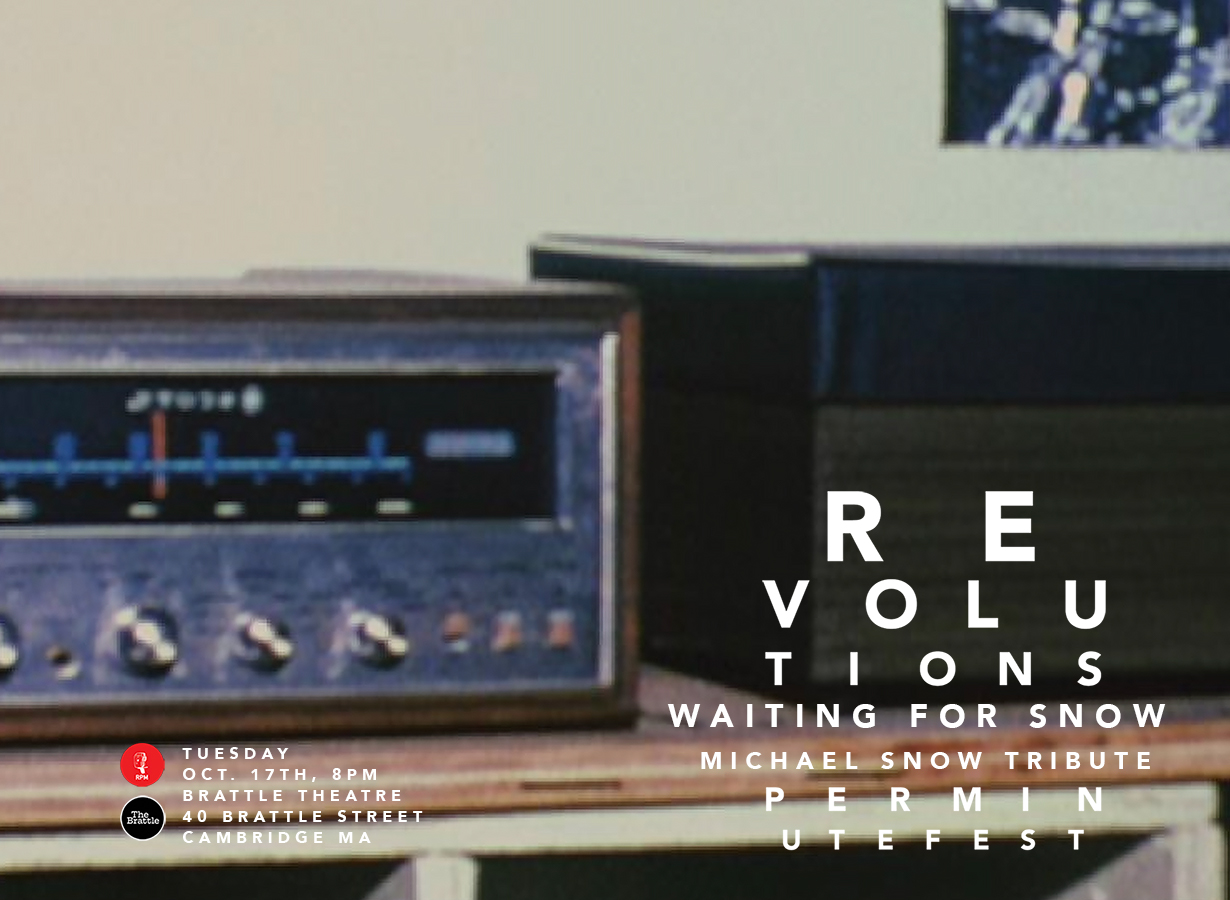
Standard Time
1967 | 8 minutes | COLOR | OPT
"In Snow's Standard Time a waist-high camera shuttles back and forth, goes up and down, picking up small,
elegantly-lighted square effects around a living room very much like its owner: ordered but not prissy.
A joyously spiritual little film, it contains both his singular stoicism and the germinal ideas of his other films,
each one like a thesis, proposing a particular relationship between image, time and space."
- Manny Farber, Art Forum
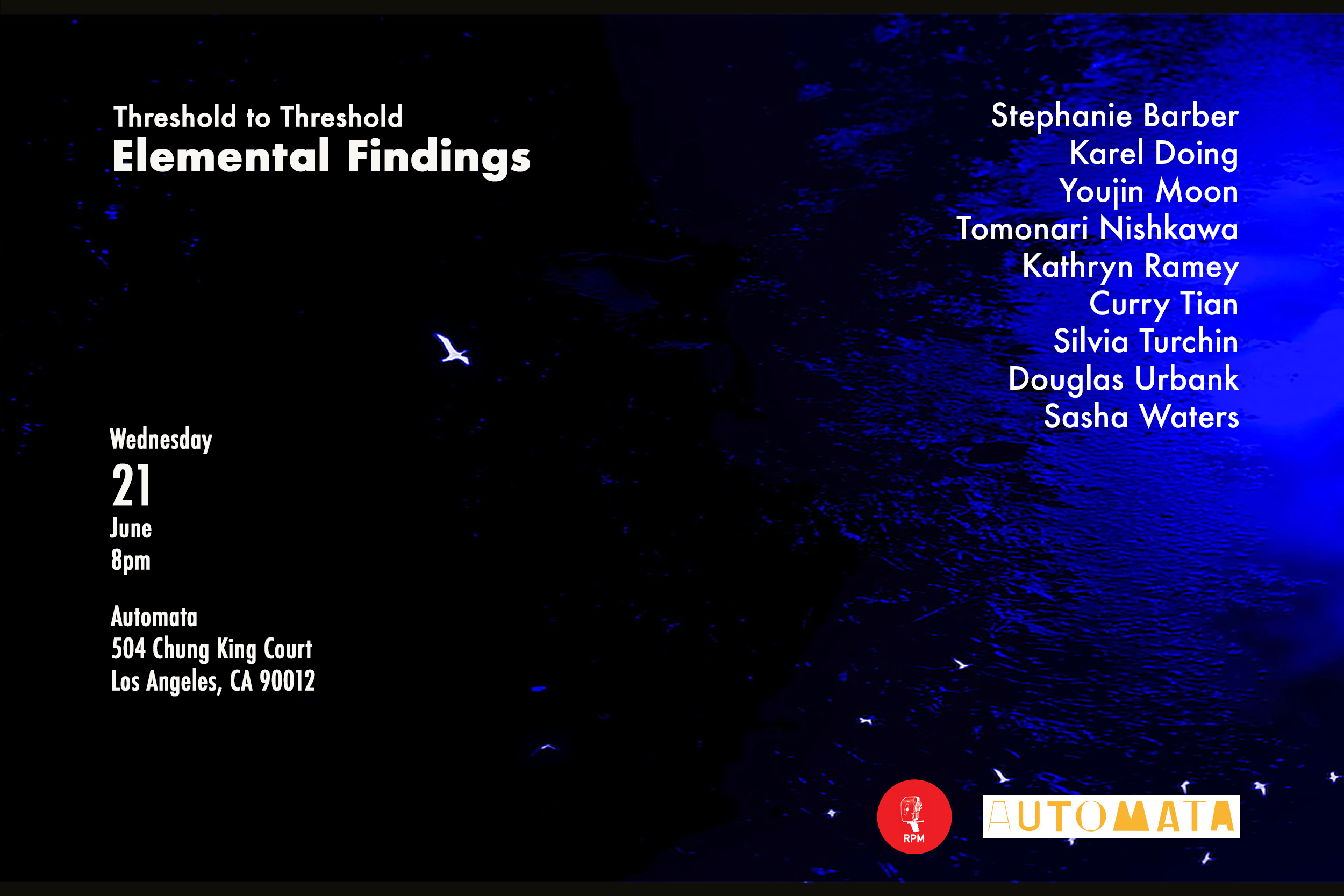
IT IS NOT SPRING, UNTIL ALL FLOWERS BLOSSOM. - Curry Tian
(2020, 6, sound, Color, Digital)
Amusement Ride - Tomonari Nishikawa
(2019, 6, Color, Sound, 16mm to Digital)
Another horizon - Stephanie Barber
(2020, 9, Color, Sound, 16mm to Digital)
A Perfect Storm - Karel Doing
(2022, 3, Color, Sound, 35mm to Digital)
Summer Light For Tula - Silvia Turchin
(2021, 9:24, Color, Sound, 16mm to Digital)
Fragile - Sasha Waters
(2022, 8, Color, Sound, 16mm to Digital)
Move - Douglas Urbank
(2021, 4:35, B/W, Sound, 16mm to Digital)
SAYOR - Kathryn Ramey
(2022, 10, Color, Sound, 16mm to Digital)
Laomedeia - Youjin Moon
(2019, 11:04, Color, Sound, Digital)
runtime 67 mins
AutoMata
Automata is an artist-run non-profit organization located in Los Angeles, California, dedicated to the creation, incubation, and presentation of experimental puppet theater, experimental film and music, installation, and contemporary art practices centered on ideas of artifice and performing objects. Automata stands at the fulcrum points between objects and performance, artifacts and ephemera, magic and mechanics, artifice and interface.
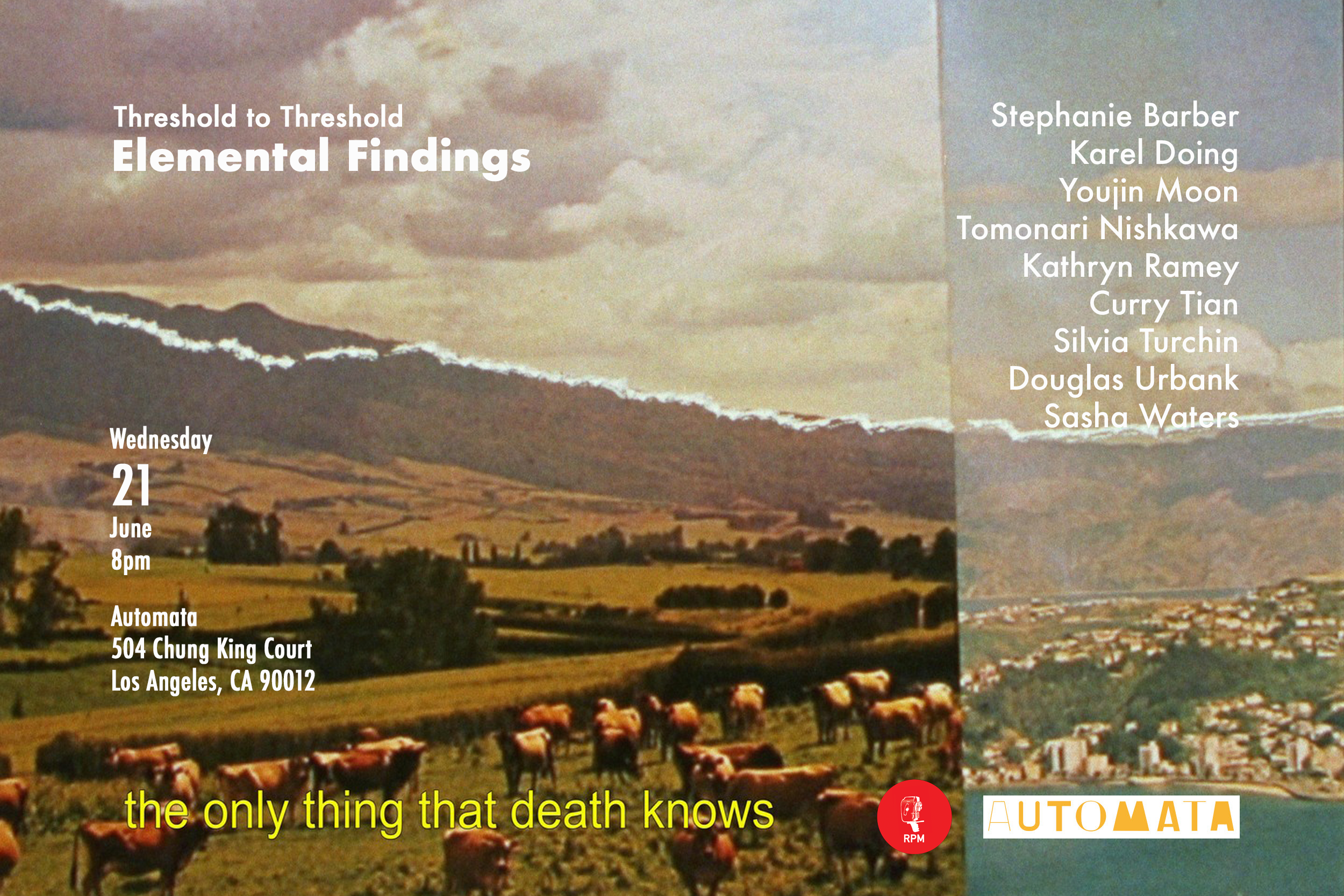
RPM hits the road once again! Coming up is a special event called Elemental Findings,
a collaborative screening set to take place on June 21st at Automata in Los Angeles, a non-profit organization run by artists.
This exciting program marks the start of the 2023 celebrations, commemorating the 10th anniversary of RPM's inception and its fifth year in Boston.
The lineup for this event features curated works from the past five years, showcasing artists who have contributed multiple pieces to various festival
editions. Among the featured artists are Stephanie Barber, Karel Doing, Youjin Moon, Tomonari Nishkawa,
Kathryn Ramey,Curry Tian, Silvia Turchin, Douglas Urbank, and Sasha Waters.
For further details and additional information, please visit:
AutoMata
Presented by
Revolutions Per Minute Festival and AutoMata.
Special thanks:
Cherlyn Hsing-Hsin Liu & AutoMata
Cherlyn Hsing-Hsin Liu is an interdisciplinary artist, filmmaker, writer, and curator whose work is grounded in literature and the conceptual avant-garde. Cherlyn’s creative activity starts from a life event, an anomaly in language or in the material world. It continues by employing methods drawn from both Eastern and Western practices and philosophies. Her working method at various times involves handcrafted material, mixed media, and experimental interchange between new and old technologies.
She is a lecturer at CalArts, teaching experimental film. She is co-curator of Move Screen, Process Cinema, the founder of Experimentalist Media Collective, the editor of B-Journal, and serves as a programmer for the Experimental session of Slamdance Film Festival.
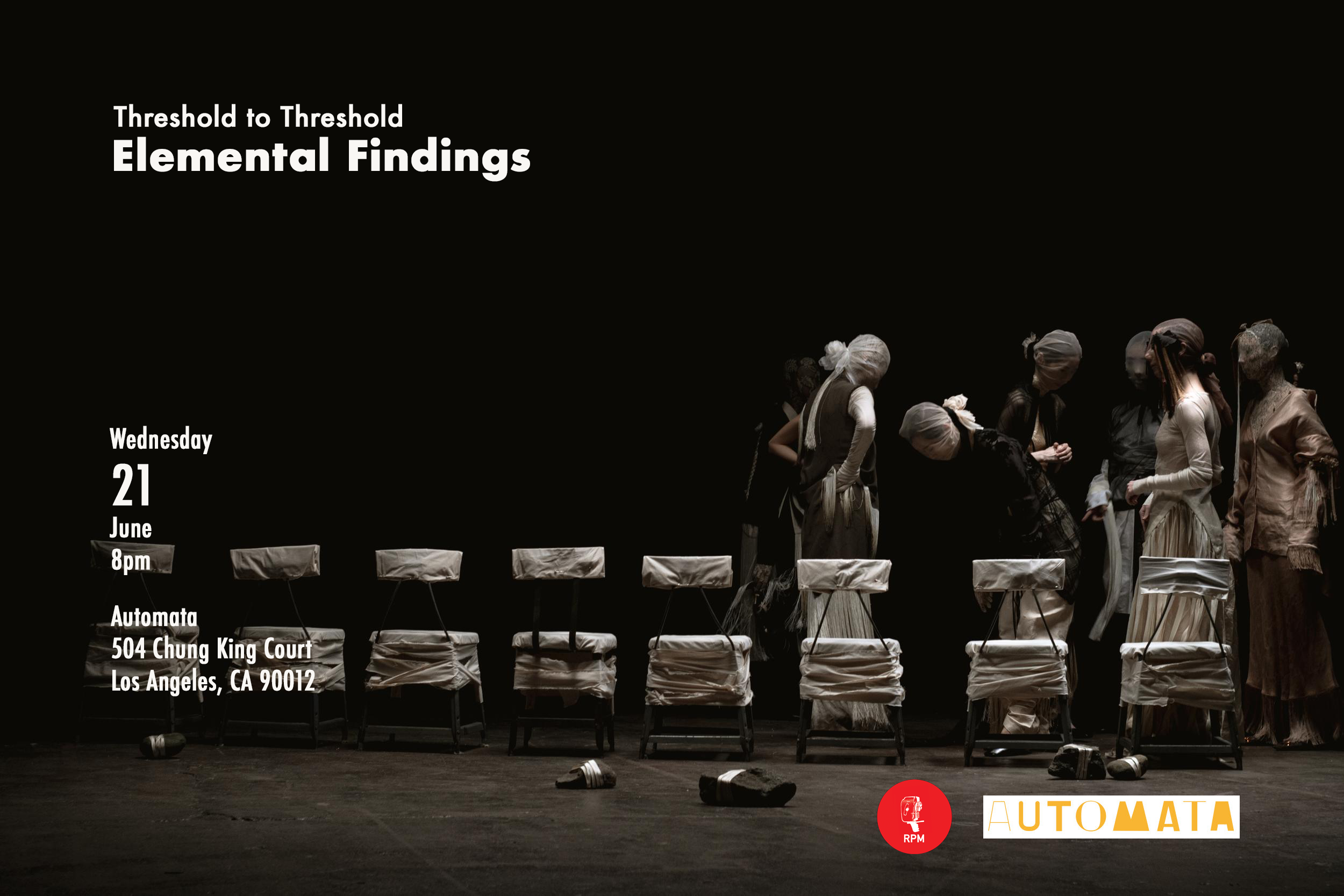
IT IS NOT SPRING, UNTIL ALL FLOWERS BLOSSOM. - Curry Tian
“ IT IS NOT SPRING, UNTIL ALL FLOWERS BLOSSOM ” (a quote from Shui Mak Ka, one of the factory workers initializing the 1982 Garment Strike) is a homage to
the overlooked and objectified laboring body of Asian Immigrant Women in the western world, with an eye on the garment factory owners and workers within the New York
garment production sector as a representation of the US social panorama.
With reference to the French philosopher Gaston Bachelars’s topo-analysis theory from his literature work The Poetics of Space — a form of research that examines the
intimacy of objects and spaces; the working space itself becomes the representation of one’s identity, cultural behaviour and a kind of consciousness. Thus, this
collaborative project aims to explore the poetic relationship between these women factory worker’s invisible social identity, the workspace, movement and fashion in the
Chinese diaspora in America, dating from the 1970s to present times.
Curry Sicong Tian is a US-China based multidisciplinary filmmaker and artist, whose talent ranges across Director, concept/digital, 3d, and photographer, and not in a segregated way but artfully blending the vastly different mediums into a seamless harmony of leading edge expression.
In 2020, Curry won an Academy Award for her student short film “Simulacra”, and in such a short span of time went on to create masterful works for clients such brands as Mercedes, Apple BEATS, Chanel, L’oreal, Canon and more. Her visual creation of the 88rising MainStage Coachella performances, made waves at the world’s premiere music festival.
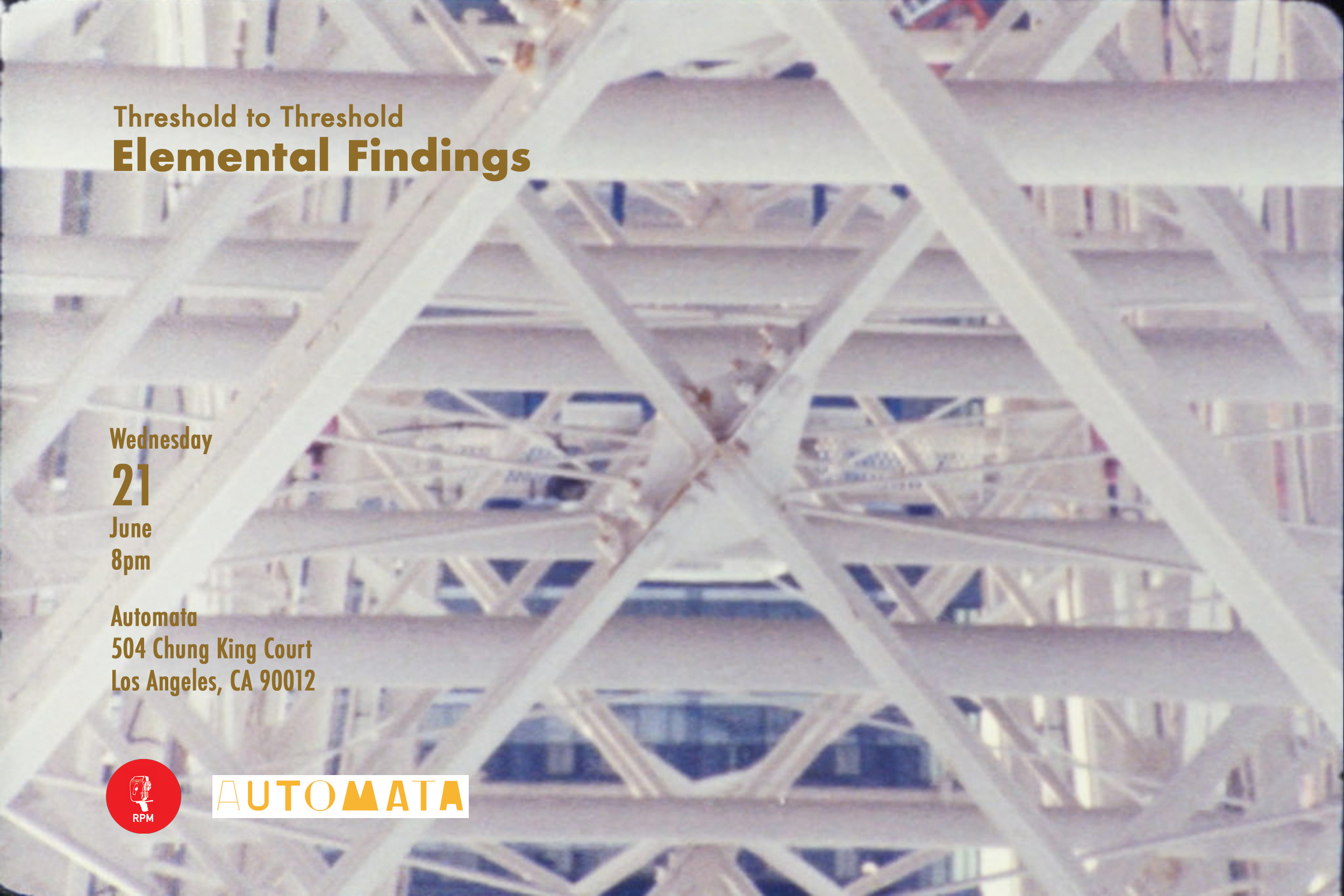
Amusement Ride - Tomonari Nishikawa
(2019, 6, Color, Sound, 16mm to Digital)
Shot with a telephoto lens from inside a cabin of Cosmo Clock 21, a Ferris wheel at an amusement park in Yokohama, Japan. The distorted image shows the structure of the Ferris wheel, focusing on the intermittent vertical movement, which resembles the movement of a film at the gate of a film projector or camera.
Tomo NIshikawa
Nishikawa’s films explore the idea of documenting situations/phenomena through a chosen medium and technique, often focusing on process itself. His films have been screened at numerous film festivals and art venues, including Berlinale, Edinburgh International Film Festival, Hong Kong International Film Festival, International Film Festival Rotterdam, London Film Festival, Media City Film Festival, New York Film Festival, Singapore International Film Festival, and Toronto International Film Festival. In 2010, he presented a series of 8mm and 16mm films at MoMA P.S.1 Contemporary Art Center, and his film installation, Building 945, received the 2008 Grant Award from the Museum of Contemporary Cinema in Spain. He served as a juror for the 2010 Ann Arbor Film Festival, the 2012 Big Muddy Film Festival, and the 2013 dresdner schmalfilmtage. He is one of the co-founders of KLEX: Kuala Lumpur Experimental Film and Video Festival and Transient Visions: Festival of the Moving Image. He lives in Japan/USA, currently teaching in Cinema Department at Binghamton University.
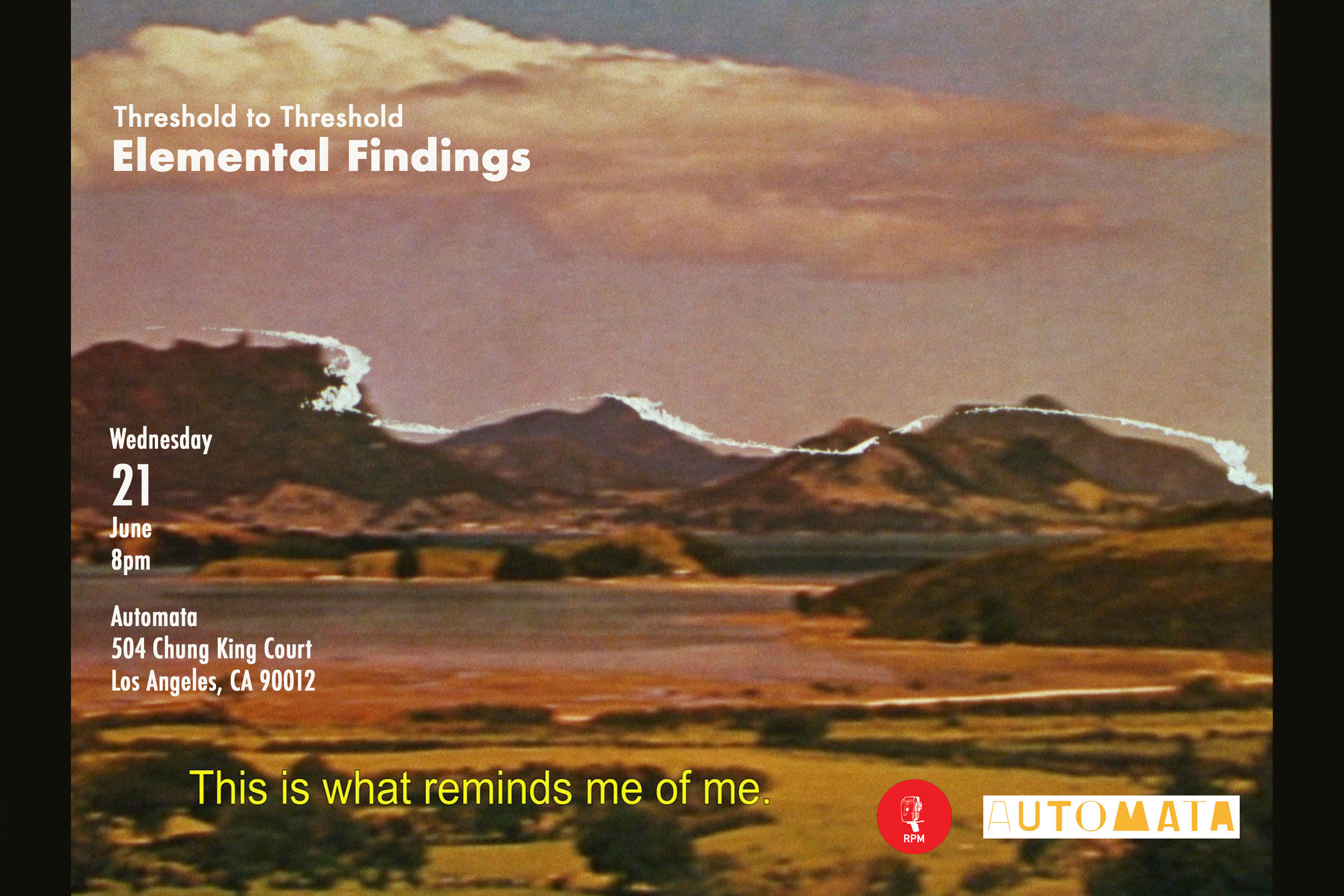
Another horizon - Stephanie Barber
(2020, 9, Color, Sound, 16mm to Digital)
the horizon, where the sky and the earth meet, is always elsewhere, a promised place where these two elements come together. a metaphor, an orienting, a promise of transition, change, transcendence. a place where the corporeal and spiritual meet, or are cleaved apart.
also, here, the space between narrative and documentary, fact and fiction, is scratched between two voices.
Stephanie Barber is a writer and artist who has created a poetic, conceptual and philosophical body of work in a variety of media, often literary/visual hybrids that dissolve boundaries between narrative, essay and dialectic works. Her work considers the basic philosophical questions of human existence (its morbidity, profundity and banality) with play and humor.
Barber’s films and videos have screened nationally and internationally in solo and group shows at MOMA, NY; The Tate Modern, London; The Whitney Museum of American Art, NY; The Paris Cinematheque; The Walker Art Center, MN; MOCA Los Angeles, The Wexner Center for Art, OH, among other galleries, museums and festivals.
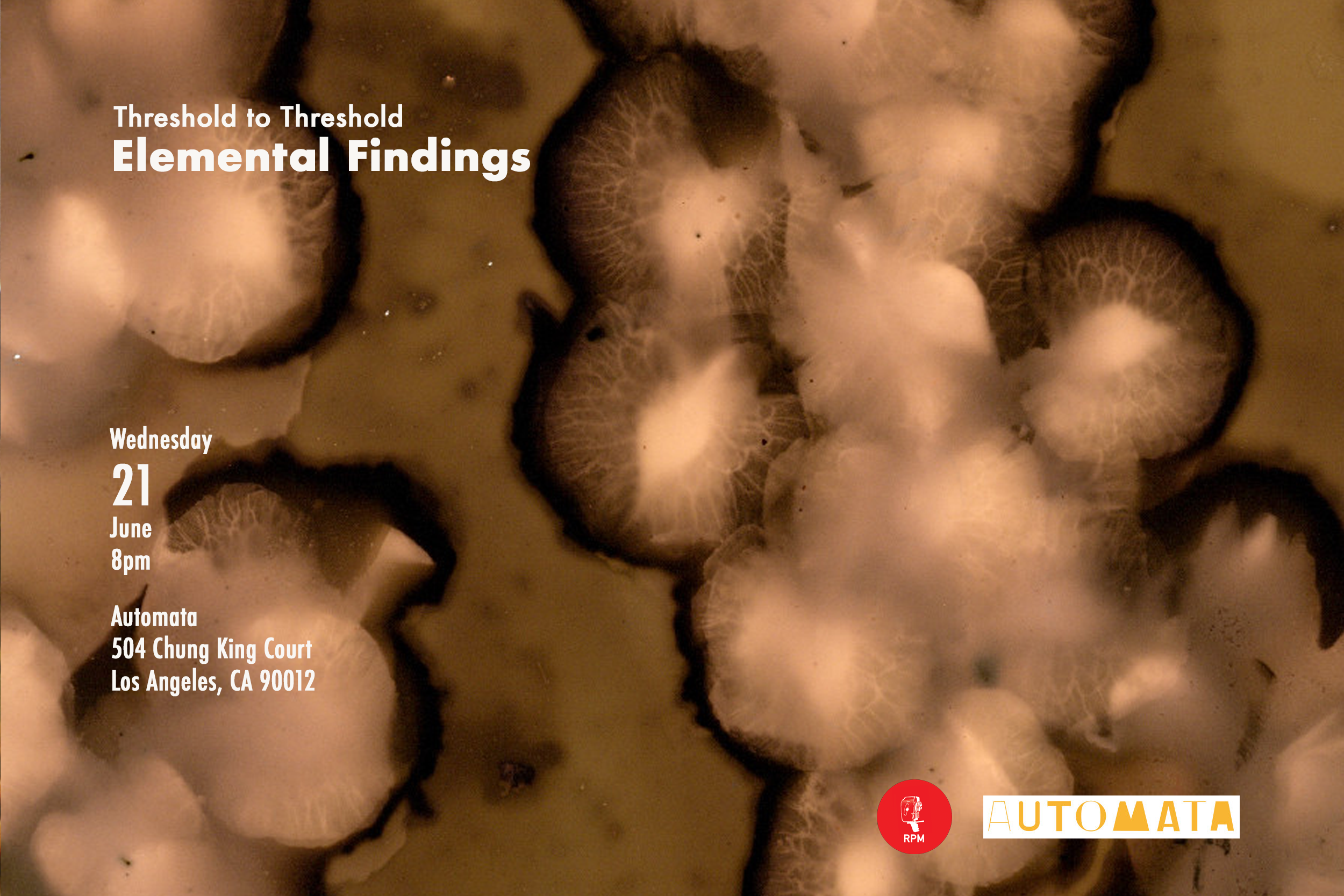
A Perfect Storm - Karel Doing
(2022, 3, Color, Sound, 35mm to Digital)
A Perfect Storm is a landscape film or, more precisely, a landscape imprinted on the film's emulsion. The artist has used seeds, tiny composite flowers and other small elements of cultivated plants that grow in his garden and wild plant species gathered from a nearby nature reserve. The film consists of sequences that are intricately composed and parts that are completely 'self-organised'. As such plants appear not merely as inanimate objects but rather as characters who are expressive in their own right. Such otherworldliness is also reflected in a sequence of gargoyles, providing a link to the hidden animist tendencies that prevail in human culture. This primordial expressiveness is underlined by an improvised guitar solo by the inimitable Florian Magnus Maier.
Karel Doing is an independent filmmaker, photographer, writer and researcher currently based in Oxford, UK. In his practice he investigates the relationship between culture and nature by means of analog and organic process, experiment and co-creation. Doing's work has been shown internationally in the context of film festivals, museum and gallery exhibitions and live events, including solo exhibitions in London and Paris. In 2012 he received a FOCAL award for his film Liquidator. He regularly gives workshops in analog film and photography practice and teaches at Ravensbourne University and the University of the Arts London.
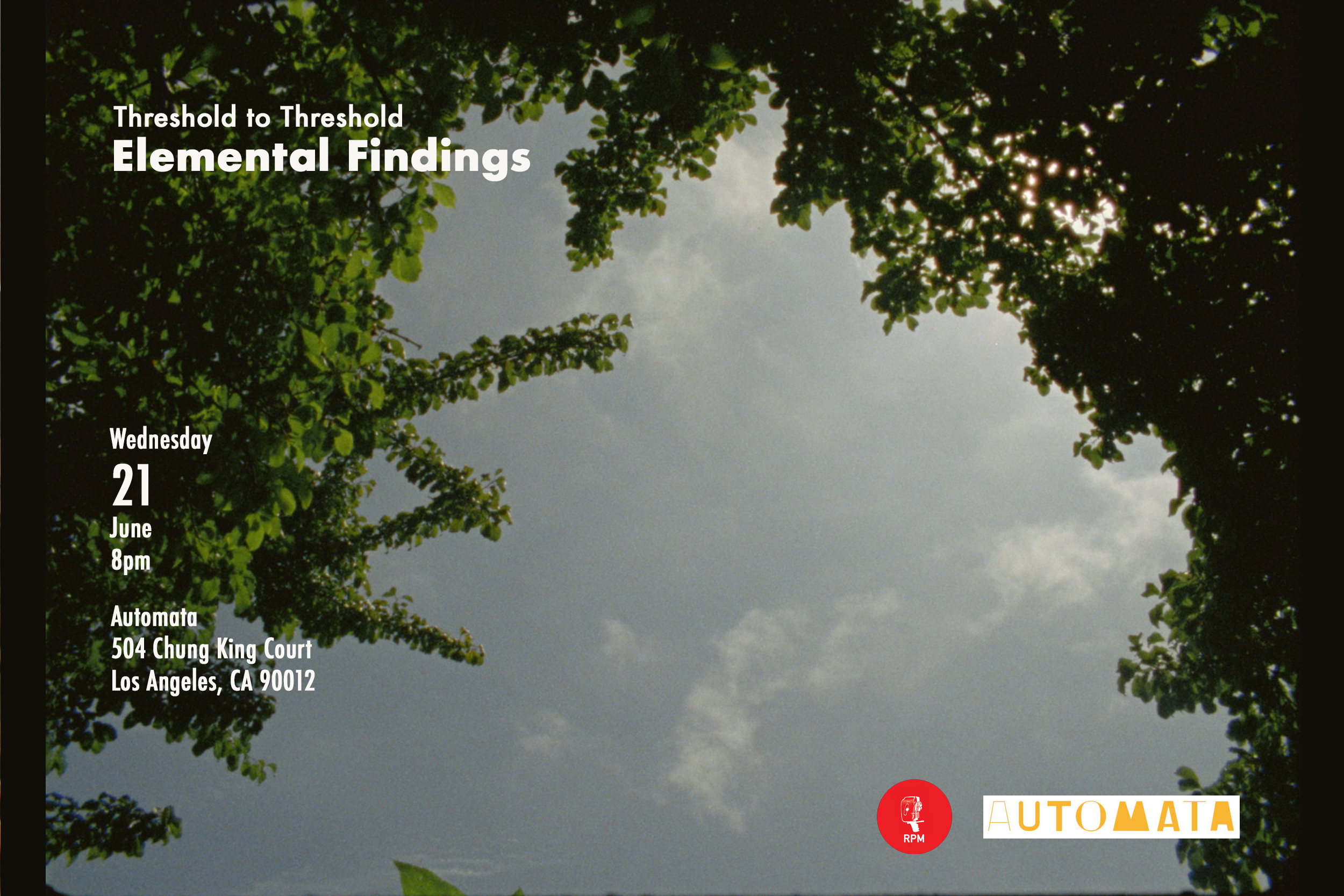
Summer Light For Tula - Silvia Turchin
(2021, 9:24, Color, Sound, 16mm to Digital)
"Summer Light for Tula" is a garden symphony of sorts, a tribute to the light and beauty, and an effort to reconcile with death.
Silvia Turchin is a Bay Area experimental and documentary filmmaker whose work is concerned with memory and loss.
Her films are experiential in style, encouraging viewers to immerse themselves in keen visual and aural observation of urban and natural landscapes.
Silvia is currently Associate Professor in the Cinematic Arts Department at California State University Monterey Bay and
has also taught film production at UC Berkeley, San Francisco State University, and the San Francisco Art Institute.

Fragile - Sasha Waters
(2022, 8, Color, Sound, 16mm to Digital)
"Maybe I will cast a younger woman to perform me, the 'hockey mom' in the voiceover..." And so I did: six women a decade or more younger than I am, all artists I admire, speak a personal meditation on the early history of cinema, the anxiety of aging, and the woeful comedy of professional envy. 16mm footage of six “magic lantern” glass slides from the turn of the last century wryly evoke the Structural film tradition of anti-illusionist cinema and demystification.
"Hockey mom" performed by T.J Dedeaux-Norris, Lori Felker, Kelly Gallagher, Penny Lane, Jesse McLean and Courtney Stephens.
Sasha Waters is a moving image artist and Professor of Film at Virginia Commonwealth University.
Since 1998, Sasha has produced and directed 18 documentary and experimental films, 14 of which originate in 16mm. With the exception of her first documentary, she has edited of all of her films. Embracing a personal, artisanal approach to craft, she also served as the cinematographer, primarily in 16mm, and sound editor, on ten of them.
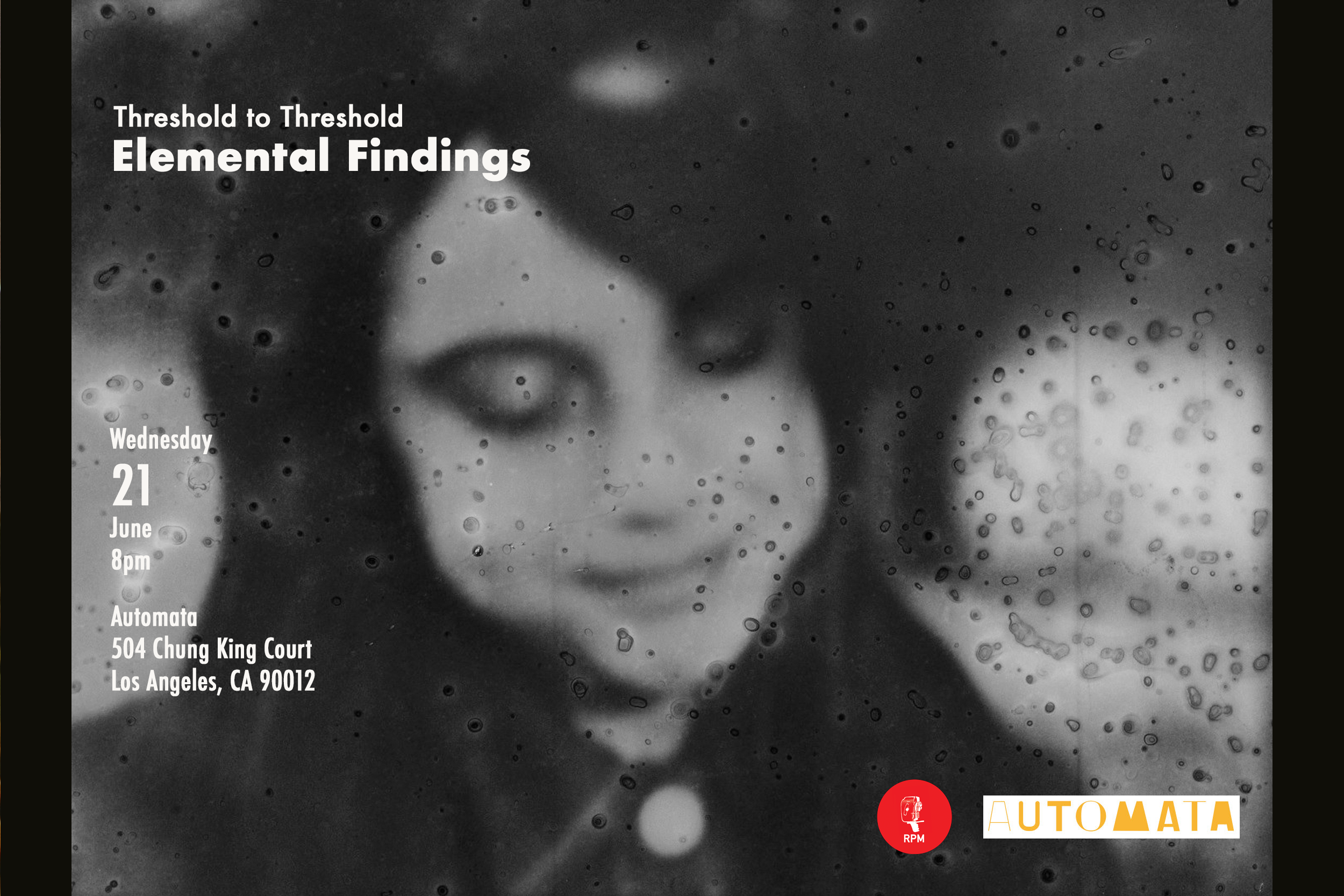
Move - Douglas Urbank
(2021, 4:35, B/W, Sound, 16mm to Digital)
A nature of children, birds, and insects. Made from a series of contact printings taken from different found footage films and other materials onto 16mm negative, part of the soundtrack from a film with the image blacked out.
Douglas Urbank, based in Boston, Massachusetts, is an artist with a background in sculpture and drawing who began to experiment with filmmaking in 2008. His short films have screened in festivals and curated programs nationally and internationally. Since 2001 he has hosted a radio program devoted to experimental, improvisational, and other unconventional music and sound art. He is also a member of Fort Point Theatre Channel, an independent theater company that brings together an ensemble of artists from the worlds of theater, music, and visual arts. And he is a founding member of the AgX Film Collective. He works to promote cross-pollination between art forms on the fringes of alternative culture: experimental music, film and theater.
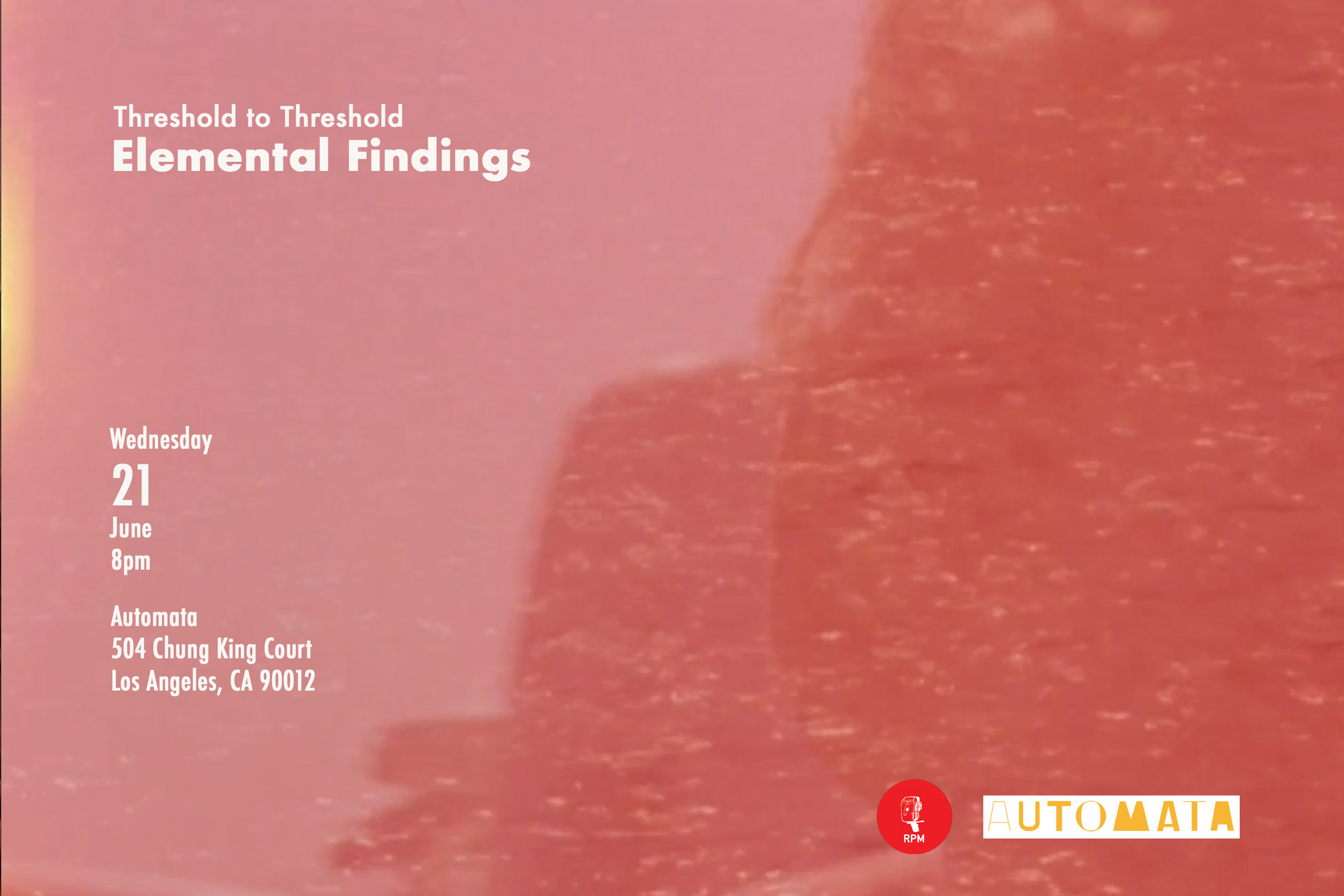
SAYOR - Kathryn Ramey
(2022, 10, Color, Sound, 16mm to Digital)
An acronym for swimming at your own risk, SAYOR refers to a forum without a moderator. Three years in the lives of three AMAB (assigned male at birth) children with a parent/observer. What does it mean to be a male in the 21st century?
Kathryn Ramey is a filmmaker and anthropologist whose work operates at the intersection of experimental film processes and ethnographic research. Her award winning and strongly personal films are characterized by manipulation of the celluloid including hand-processing, optical printing, and various direct animation techniques. Most recently she has been focused on creating an anti-colonial film practice with collaborators in Puerto Rico and researching environmentally friendly photochemical processes utilizing indigenous flora. She is deeply committed to sharing her knowledge of alternative analogue technologies through workshops and publications.
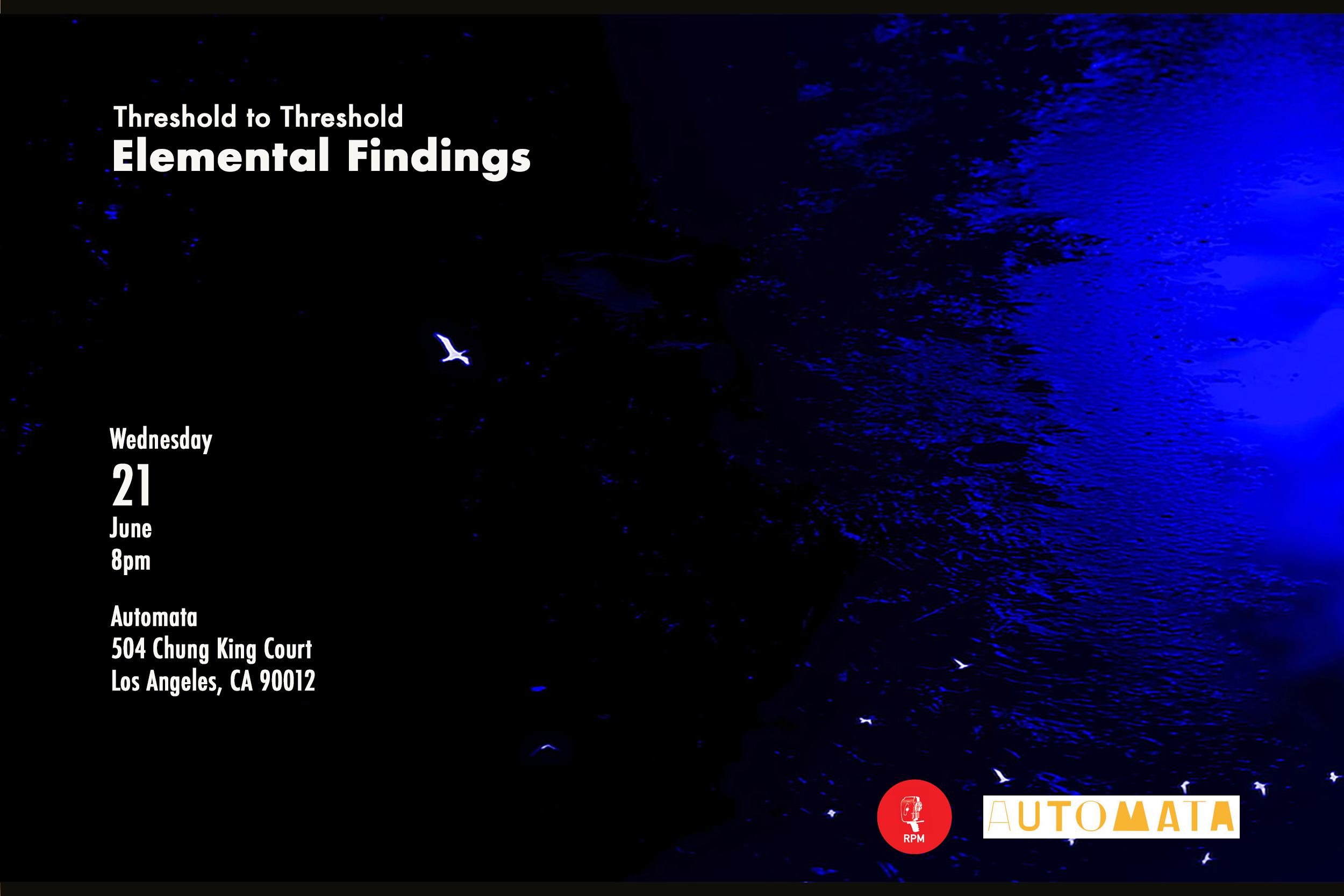
Laomedeia - Youjin Moon
(2019, 11:04, Color, Sound, Digital)
Laomedeia is an experimental video that travels through transitional spaces, which continuously unfold into different dimensions in a nonlinear trajectory. The migrating elements, such as water, birds, and trains, allow the viewer to navigate between painterly compositions of oceanic landscapes and cosmic spaces.
Youjin Moon is a visual artist and experimental filmmaker based in Boston. Moon holds MFAs in Painting and Film/Video from the Massachusetts College of Art and Design. She has shown her work at national and international film festivals and exhibitions, including the 2016 deCordova New England Biennial, Hamburg International Short Film Festival, and the 56th Ann Arbor Film Festival. She received the Korean EXiS Award at the 12th and 16th Seoul International Experimental Film and Video Festival.


















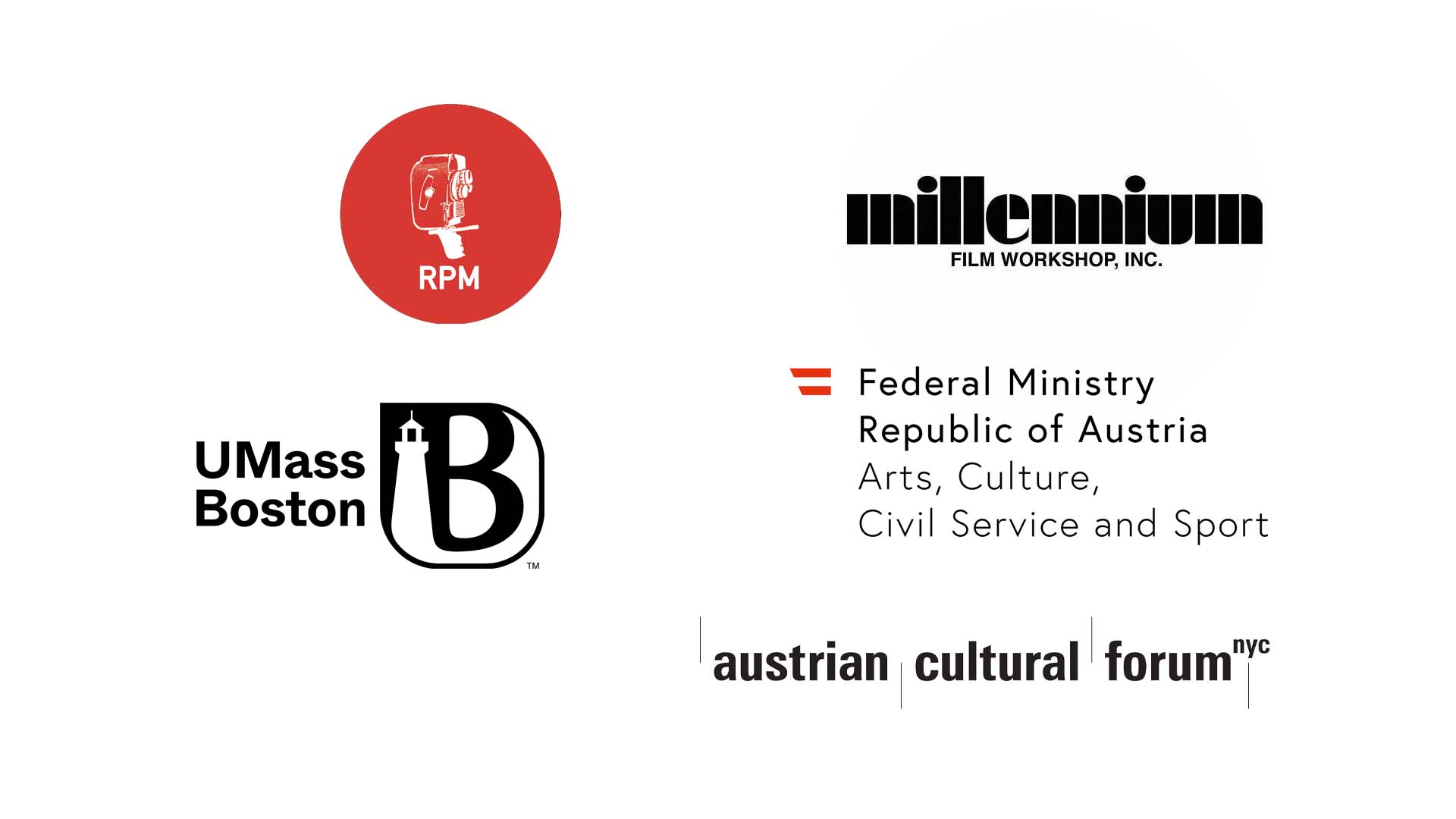





Douglas Urbank, based in Boston, Massachusetts, is an artist with a background in sculpture and drawing who began to experiment with filmmaking in 2008.
His short films have screened in festivals and curated programs, including nationally at Revolutions Per Minute Festival, Boston, Massachusetts;
Microscope Gallery and Millennium Film Workshop in New York; San Francisco Cinematheque’s Crossroads Film Festival; Moviate Underground Film Festival,
Harrisburg, Pennsylvania; Chicago Underground Film Festival; Engauge Experimental Film Festival, Seattle, Washington; and internationally at Mire Lab’s
PRISME festival, Nantes, France; and curated programs including, Zumzeig Cinema, Barcelona; Laboratorio Experimental de Cine program, Mexico City; Artist
Film Workshop, Melbourne, Australia; and others. He was a Massachusetts Cultural Council Artist Fellowships Film & Video finalist in both 2017 and 2019.
Beginning in 2001 he co-hosted a radio program devoted to experimental, improvisational, and other unconventional music and sound art.
He has been a member of Fort Point Theatre Channel, an independent theater company which brings together an ensemble of artists from the worlds of theater,
music, and visual arts. And he is a founding member of the AgX Film Collective. He is interested in cross-pollination between art forms on the fringes of
alternative culture: experimental music, film and theater.
Program: 65 minutes
Projection Format: 16mm film & Digital
Bathers
16mm, B&W, sound, 2019, 03:45
Oracle
16mm, color, sound, 2014, 07:20
Portrait
16mm, B&W, silent, 2017, 05:15
Small
16mm, B&W, silent, 2023, 04:30
Cartoon Dream
16mm to video, color, silent, 2023, 05:45
Hotel Cassiopeia: Algiers part 1
video, color, sound, 2013, 03:45
Splash
16mm to video, color, sound, 2012, 02:40
Skate
16mm to video, B&W, sound, 2019, 03:00
Cryptogram (v.5)
16mm to video, color, silent, 2022, 04:40
Move
16mm to video, B&W, sound, 2021, 04:40
3 Notes to a Redwood Tree
16mm to video, color, sound, 2023, 09:30
Sojourn
16mm to video, color, sound, 2010, 01:50
Post Screening Q&A
Alison Folland & Douglas Urbank


Bathers
16mm, B&W, sound, 2019, 03:45:
Three friends, the beach, the waves, their brief time together.

Oracle
16mm, color, sound, 2014, 07:20:
The Oracle answers a question.

Portrait
16mm, B&W, silent, 2017, 05:15:
An imagined portrait, a handmade, stream-of-consciousness improvisation.

Small
16mm, B&W, silent, 2023, 04:30:
The inner lives of figurines.

Cartoon Dream
16mm to video, color, silent, 2023, 05:45:
A found cartoon copied twice, in sequence, four rolls of 16mm film, contact printing, optical printing.

Hotel Cassiopeia: Algiers part 1
video, color, sound, 2013, 03:45:
Hotel Cassiopeia, a play by Charles Mee, imagines the fantasy world of artist, Joseph Cornell. The script includes three direct dialog excerpts from two Hollywood films: Algiers featuring Hedy Lamarr and To Have and Have Not with Lauren Bacall. This video is one of the three made for a Fort Point Theatre Channel production in Boston, intended as a reflection Cornell's found footage films Rose Hobart and By Night with Torch and Spear.

Splash
16mm to video, color, sound, 2012, 02:40:
Young bather, sand, waves, surf, synthetic soundtrack.

Skate
16mm to video, B&W, sound, 2019, 03:00:
Winter, Boston Common Frog Pond, 16mm film and in-camera editing.

Cryptogram (v.5)
16mm to video, color, silent, 2022, 04:40:
Double 8mm film and in-camera editing, landscape, cityscape, brick, glass, water, trees, windows, abstraction.

Move
16mm to video, B&W, sound, 2021, 04:40:
Rhythms of children, birds, and insects.

3 Notes to a Redwood Tree
16mm to video, color, sound, 2023, 09:30:
The space between.

Sojourn
16mm to video, color, sound, 2012, 01:50:
Arrival, celebration, departure.
Return to top

Curated by Brett Melican
Local Winds
Submission Deadline: Nov. 15, 2023
Selection Date: Dec. 1, 2023
Screening Date: Dec. 14, 2023 at Goethe-Institut Boston
Students in New England college and university programs (BA, BFA, MA, & MFA), including those who graduated in 2023, are invited to submit experimental films, documentaries, essay films, and animation pieces - or any work existing outside the cinematic norm (analog, celluloid or digital) .
Welcoming submissions from the states of New England: Connecticut, Maine, Massachusetts, New Hampshire, Rhode Island, and Vermont.
Please be advised that if your work is selected, you will need to have a downloadable copy ready.
RPM’s student shorts showcase seeks to highlight works by New England student filmmakers which exist outside of the cinematic norm - experimental film, documentary, and animation which push the boundaries of traditional filmmaking. A wide variety of works will showcase hand-altered and hand-developed analog film, experiments in narrative, and poetic, personal reflections on the medium. Join us and celebrate the next generation of local experimental filmmakers who are working to expand the vocabulary of cinema.
This program is curated by Brett Melican, a local filmmaker, member of the AgX Film Collective, and recent graduate of MassArt.



Guest Curator Brett Melican
Brett Melican is a filmmaker based in Boston, Massachusetts whose work mixes narrative and experimental forms, exploring fractured relationships and psychological isolation in a blend of genres. He is a member of the AgX Film Collective, and helps organize and program local film festivals alongside work in camera and lighting departments on independent and commercial productions.


Curated by Robin Roblee-Strauss
Home and Away features one biographical documentary and four short avant-garde
films by filmmaker, Barbara Meter. As one of the first women to study at the
Netherlands Film Academy in the 1960s and co-founder of Amsterdam's Electric
Cinema, a bastion of avant-garde film and ideas in the 1970s, Barbara has been a
pioneer in the production and promotion of experimental filmmaking in the Netherlands.
In a 1971 interview, Barbara describes her work as “pure films”, conveying “thoughts
and feelings by pure movement, a pure image that may flicker or be blurred, and by
intervening in the process of developing and printing the film.” Through her innovative
use of optical printing methods, she seamlessly massages, and reworks found sounds
and images: combining them with her personal archive. She remolds these documents
into distinct, deeply personal sense worlds.
This program showcases a range of works made throughout Barbara’s artistic career
which echo deep psychological themes tied to the destabilizing effects the Second
World War wrought on her family life and personal sense of home. Her notion of
“wanting to belong to something you can’t reach” is explored prismatically in this film
program by showing a biographical documentary work which explore her family’s history
during WWII alongside experimental films that represent the universal feelings of
yearning to belong, the pain of separation, the distance felt in estrangement, and the joy
of homecomings.
Throughout Barbara’s life she has continued to create work, program screenings, and
teach and lecture on film. Her work has been shown at Rotterdam Film Festival, BFI
London Film Festival, Stedelijk Museum Amsterdam, Filmmuseum Amsterdam, Tate
Gallery London, Cinematheque San Francisco, the Museum of the Moving Image in
New York City among many other venues in Europe. Home and Away is the first solo
exhibition that combines her experimental work alongside her documentaries and the
second solo exhibition of her films in North America.
Additional information about Barbara Meter
can be found at her website (https://www.barbarameter.com/) and
via Light Cone
(https://lightcone.org/en/filmmaker-
470-barbara-meter).
From The Exterior
1970, 16mm, color, silent, 9 min
Up To The Sky, And Much Much More
2015, video, color, sound, 36 min
Convalescing
2000, 16mm (from super 8), color, silent, 3 mins
Quay
2003, 16mm, color, sound, 4 mins
Ariadne
2004, 16mm, color, sound, 12 mins
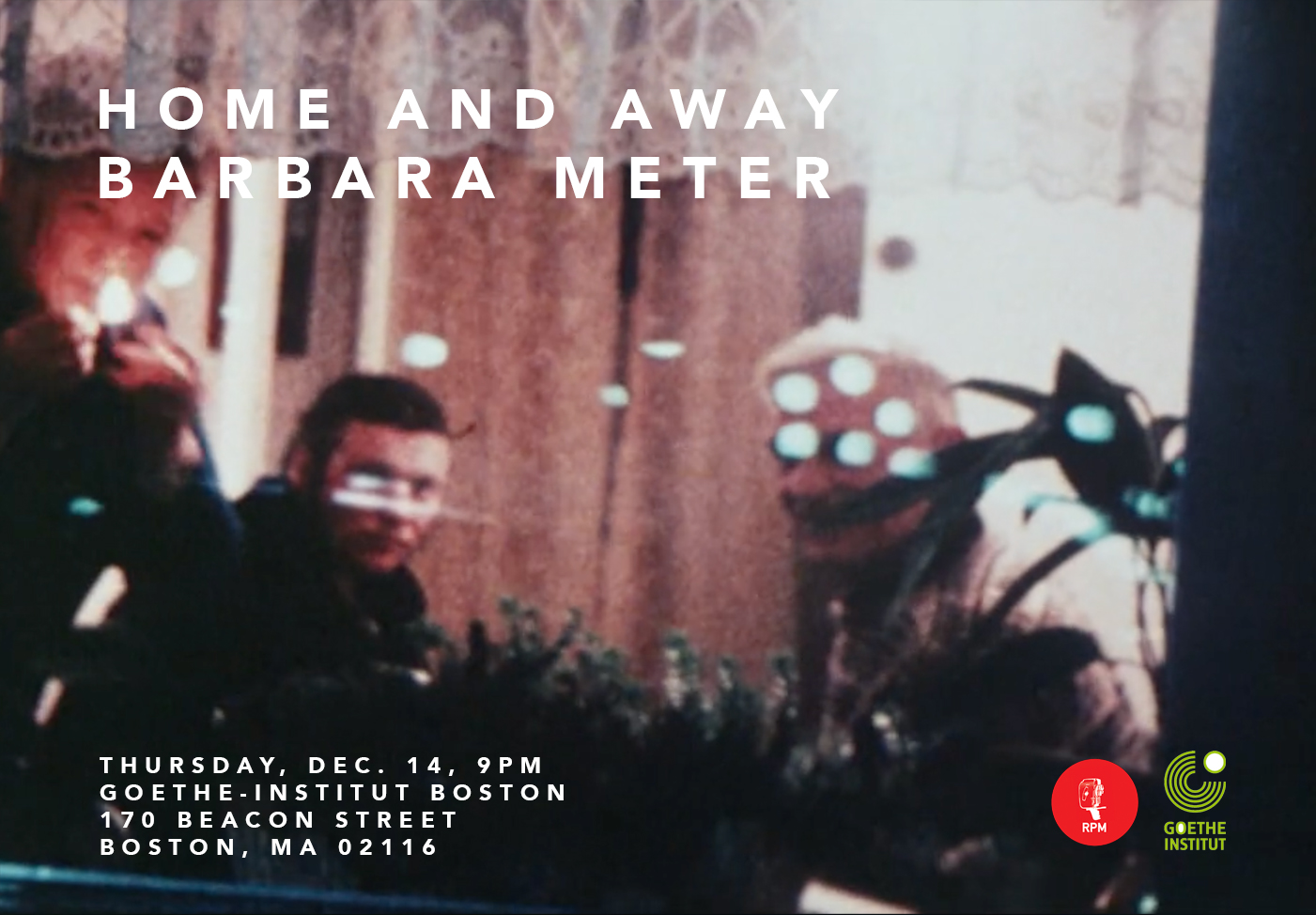
From The Exterior
1970, 16mm, color, silent, 9 min
A nocturnal view of existences left to themselves, seen from the other side. A handheld
camera peers covertly through open-curtained windows, overlapping lives: faces,
silhouetted figures, rouge lampshades, houseplants, blinking TV sets, cigarettes,
poodles, and amber orbs – unobtrusive fragments of an evening spent at home.

Up To The Sky, And Much Much More
2015, video, color, sound, 36 min
Barbara Meter tells the life story of her father Leo Meter, using slides, photographs,
drawings, and the letters her father wrote to her after being arrested by the Gestapo and
deported to the Eastern Front. Barbara Meter reflects, "There are not many testimonies
from Germans who resisted fascism – my father was one of them, and I could tell it. So,
I dug up what I found of him – photos, letters, drawings, stories – and recorded it.
During the making of the film, I felt that step by step I came closer to who he had been,
and also closer to the love and protection I experienced from him – even if I was too
little to remember his presence clearly. In Poland, I was very close to where he had
died. There were only empty fields of grain and old broken houses ... such an estranged
feeling that there were no signs left of the cruel fighting that had happened there. For
myself, this gap has been filled, and I hope for some others too."
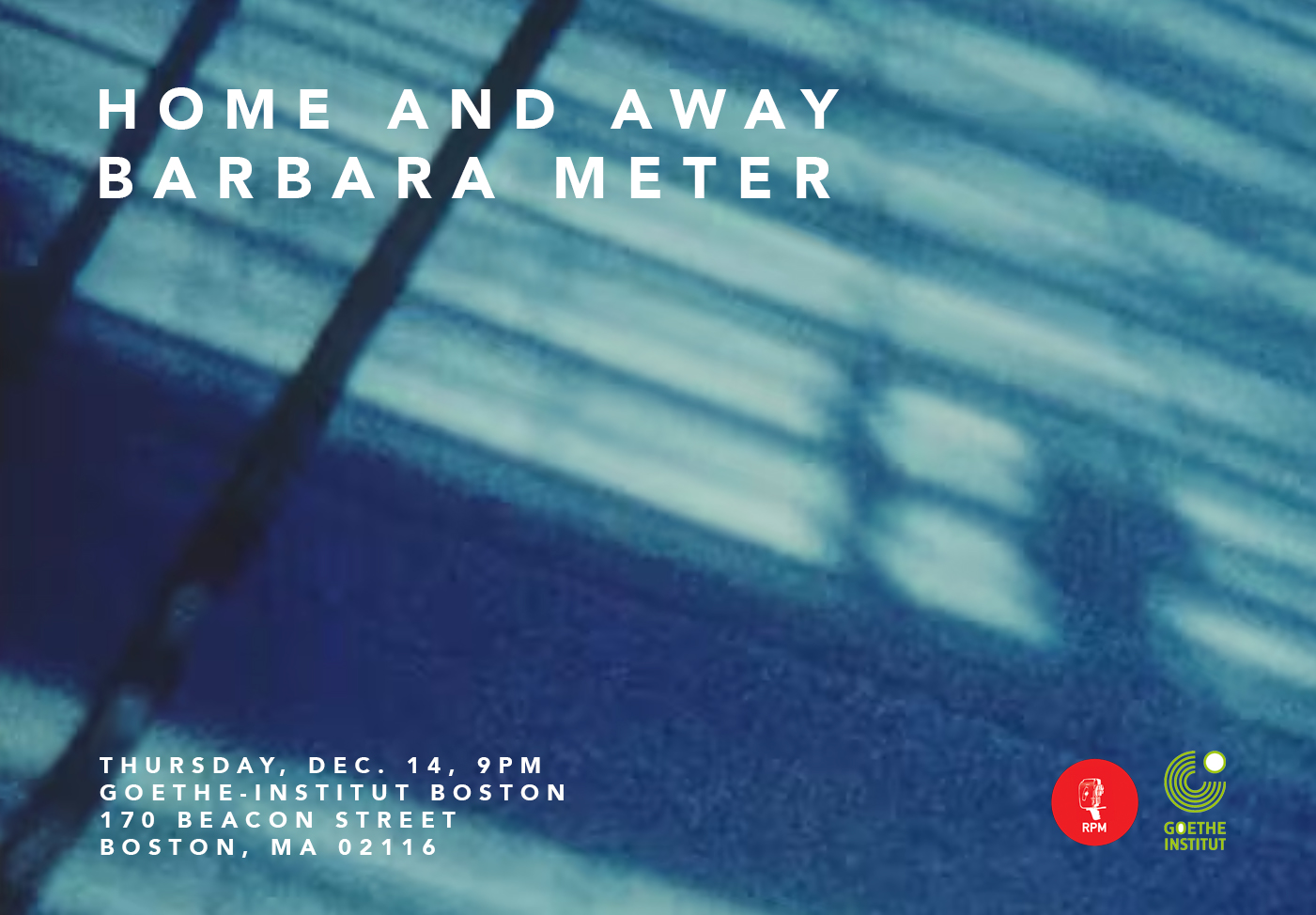
Convalescing
2000, 16mm (from super 8), color, silent, 3 mins
Confined to a room, one reads, looks, and listens. In these moments of distance from
the world, Barbara Meter considers “the blue, the light of the television, the blue, the
book, the patterns, the light, the blue. Time to appreciate how much that really is.”
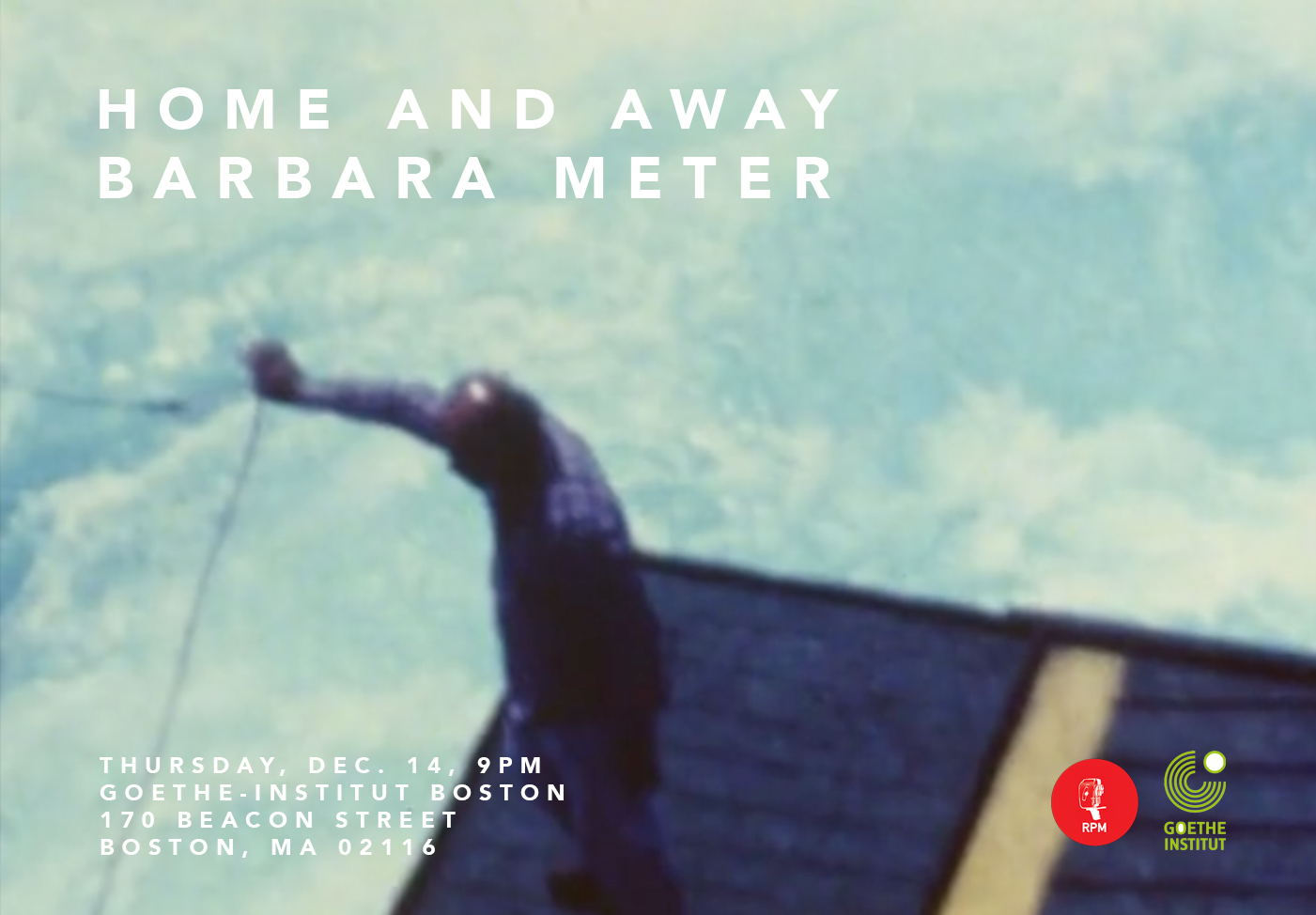
Quay
2003 16mm, color, sound, 4 mins
A study of arrivals, maritime comings and goings: vessels dock, sailors throw ropes,
drop anchor, and people poised on platforms await friends or families. Then the
choreography of reunions begins. Barbara writes: “Arriving at an island is a joy forever.
The magic of ships when they dock, the expectation on the quays, the exciting theatre
of the people with and without their vehicles, the saying hello and goodbye are everyday
experiences on the Greek islands.”

Ariadne
2004, 16mm, color, sound, 12 mins
A haptic hymn to longing restlessness and desire – movement of the wheels, a spool of
string, sprockets, feet, and hands suggests cycles of renewal and reinvention. An
anonymous woman– could it be Ariadne who gave Theseus the thread to find his way
out of the labyrinth? Or perhaps one of the ancient fates spinning the yarn of destiny…

Guest Curator Robin Roblee-Strauss is a lebenskünstler—a life-artist! Born and raised in the woodlands of Western Massachusetts. he has always gravitated towards filmmaking as an approach to research that combines scholarly investigation with artistic expression. At Hampshire College he studied non-fiction & experimental film, psychology, and critical disability studies. Robin has assisted several experimental filmmakers including Abraham Ravett, Barbara Meter, Ansuya Blom, and Abigail Child. He worked at Anthill Sound Design in the Netherlands as a sound editor and most recently as a research assistant on an archival documentary series directed by Luke Meyer. Curation is a new facet of his practice motivated by his investment in the haptic qualities of sound and the moving image works as a way to communicate through the senses—articulating alternative ways of knowing.

RPM Festival and the Brattle Theatre are excited to announce our co-presentation of "Movement
Exercises Trilogy," A feature-length trilogy of films by filmmaker-choreographer Sarah Friedland, Movement
Exercises deconstructs and revises the choreographic vocabularies of exercises practiced
across home, work, and school spaces. The trilogy consists of three short films: Home
Exercises (2017), Drills (2020), and Trust Exercises (2022). Movement Exercises examines the
premise and promise of the exercise: that by moving together, repeatedly, we both create and
recreate the social body.
Home Exercises
Digital, 22 minutes, 2017, Color, Sound.
Drills
Digital, 17 minutes, 2020, Color, Sound.
Trust Exercises
Digital , 25 minutes, 2022, Color, sound.
Screening format: DCP ( DCP courtesy of Video Data Bank)
total: 64 mins
Post-Screening Q&A: Sarah Friedland & Homa Sarabi

Sarah Friedland is a filmmaker and choreographer working at the intersection of
moving images and moving bodies. Through hybrid, experimental, and movement-based
filmmaking, multi-channel video installation, and site-specific live dance performance, she
stages and scripts bodies and cameras in concert with one another to elucidate, distill, and
revise the embodied patterns of social life and the body politic. Facilitating a research process
integrating found movements, gestures, and postures from embodied memories, cinema and
archival footage, and contemporary movement languages, she choreographs through practices
of interviewing, pre- and re-enactment, adaptation, and improvisational play, shaping dances
with diverse communities of performers and movers—from professional
dancers to cohorts of seniors and teenagers.
Her work has screened and been presented in numerous festivals and film spaces including
New York Film Festival, New Directors/New Films, Ann Arbor Film Festival, New Orleans Film
Festival, BAMcinématek, Mubi, and Anthology Film Archives, in art spaces such as Performa19
Biennial, La MaMa Galleria, MoMA, Sharjah Art Foundation, and Manifattura delle Arti Bologna,
and in dance spaces including the American Dance Festival and Dixon Place, among others.
Brattle Ticket Info


Home Exercises
22 minutes, 2017
Adapting the form of the home workout video, Home Exercises investigates the gestural habits
and choreographies of aging individuals in their homes. Created in collaboration with a group of
eight seniors to shape their daily routines into dance for camera, the on-screen movements shift
in their fidelity to the daily patterns they reperform. Some elders rigorously reenact their daily
actions, whereas others erupt into stylized and rhythmically altered movements. Intertitles
precede each exercise, annotating the performances while charting the time of day from morning
to nightfall.
Prior screenings include New Directors/New Film, BAMcinematek, Sharjah Art Foundation, and
American Dance Festival, among others.

Drills
17 minutes, 2020
Drills is a film about the choreography of preparing for the future. A hybrid documentary and
experimental dance film reimagining the form of the Cold War-era, US government-produced
social guidance film, Drills asks what futures we are preparing for through the exercises
embodying present anxieties. Weaving in between multiple forms of choreography and
documentation, Drills restages lockdown and active shooter drills, frames corporate and tech
start-up office meditation, and reperforms Boy Scout drills from their 1917 manual.
Past screenings include New York Film Festival (Currents), Prismatic Ground, Pleasure Dome,
ICDOCS, Full Frame, Mubi, and Athens International Film and Video Festival, where it won the
Film House Award for Visionary Filmmaking, among other festivals and galleries.

Trust Exercises
25 minutes, 2022
The final film in the trilogy, Trust Exercises explores the tension between the poetics of group
movement and its instrumentalization for capitalist management. Amending the choreography of
team-building and the visual grammars of corporate video, Trust Exercises braids together
movement from three work spaces: a fictional start-up retreat, a body work session as interview,
and a dance rehearsal. Movements transmit between performers across scenes, complicating the
discrete goals of their choreographies and examining their portability across spheres. Dislocating
the movement of the retreat to the space of rehearsal, professional dancers transform stock
exercises into intimate social dances. A body work session reconfigures the office environment.
Lingering after hours, movement facilitators transmute team-building games into a playful duet.
Funding for trilogy provided by the Dance Films Association, Rhode Island State Council on the
Arts, New York State Council on the Arts, New York Foundation for the Arts, and Athens
International Film and Video Festival, among others.

This touring program features 16mm films by Malic Amalya,
Karel Doing, Anna Kipervaser, Ryan Marino, Moviate (Josh Drake,
James Hollenbaugh, Jeremy Moss, Caleb Smith), Tomonari Nishikawa, Kathleen Rugh,
Josh Weissbach, and Lilan Yang. Exploring the formal and conceptual
possibilities of the medium with distinctive approaches, their films showcase
the diversity of works shown at RPM Festival in recent years.
The event is organized by Benny Shaffer and Wenhua Shi with Pittsburgh Sound + Image.
Program: 65 minutes
Projection Format: 16mm film
Time: doors at 7:30pm,
screening at 8:00pm.
Winter’s First Moons -
Kathleen Rugh
3 mins, 2018, USA, color, sound, 16mm
Radiant Forms
- Ryan Marino
7 mins, 2022, USA, color, sound, 16mm
Babbler, Fairy and Thrush - Karel Doing
3 mins 44 secs, 2022, UK, B/W, sound, 16mm
Amusement Ride
- Tomonari Nishikawa
6 mins, 2019, Japan, color, sound, 16mm
This Is How I Felt
- Josh Weissbach
1 mins 35 secs, 2022, USA, B/W, sound, 16mm
Everything Comes Full Circle -
Lilan Yang
13 mins 44 secs, 2022, USA, B/W & color, digital sound, 16mm
With the Tide, With the Tide
Anna Kipervaser
2 mins 49 secs, 2022, USA, color, sound, 16mm
Living Lessons in the Museum of Order
- Malic Amalya
20 mins, 2022, USA, B/W and color, sound , 16mm
Ill Composto -
Moviate (Josh Drake, James Hollenbaugh, Jeremy Moss, Caleb Smith)
3 mins 48 secs, 2023, USA, color, sound, 16mm


Winter's First Moons
- Kathleen Rugh
3 mins, 2018, USA, color, sound, 16mm
Following the winter solstice, the longest nights of the year prevail. Through these darkest nights the moon reaches to its fullest. Filmed over numerous nights the moons of different phases are brought together in the black sky. Through multiple exposures on film and editing created in-camera, the moons move and bounce off one another in unpredictable ways. Official NASA sound recordings from space help activate their actions. The stoic moon breaks free and gravitates at will.
Kathleen Rugh is a filmmaker and photographer based in Brooklyn, New York. Her film and photographic work has been exhibited in screenings and galleries throughout the US and internationally, including the Edinburgh International Film Festival, the Images Festival, Ann Arbor Film Festival, Antimatter [Media Art], EXiS Experimental Film Festival, and the Athens International Film and Video Festival. She has received funding for her films through the New York State Council on the Arts.

Radiant Forms
- Ryan Marino
7 mins, 2022, USA, color, sound, 16mm
Luminous forms merging in time.
Ryan Marino
is an interdisciplinary artist working with film, sound, and collage. His 16mm films explore the ethereality of time, light, and space. His 16mm films have screened at film festivals and venues including: Anthology Film Archives, New York Film Festival, San Francisco International Film Festival, Milwaukee Underground Film Festival, Uplink (Tokyo), Venice Biennale, Fracto Experimental Film Encounter, Spectacle Theater, and Pacific Film Archive. In addition to creating the soundtracks for his own films, his sound work includes original compositions and commissioned soundtracks for short films and theater productions. By day he works as an audiovisual archivist.

Babbler, Fairy and Thrush
- Karel Doing
3 mins 44 secs, 2022, UK, B/W, sound, 16mm
An unfiltered stream of perception: small objects and grand panoramas appear simultaneously. The certainties of near and far, detail and overview, inside and outside are deliberately thrown into confusion. Aided by ‘in camera’ superimposition and travelling mattes a near abstract experience is created. Sunlight filters through semi-transparent surfaces, while small holes and cracks allow the light to travel unrestrained. The work was conceived and shot within a few hundred yards from my house, focusing on the plants, flowers, trees and ferns that grow around me.The soundtrack is composed with noises and voices from that same area, revealing a further abundance of life.
Karel Doing is an independent artist, filmmaker and researcher whose practice investigates the relationship between culture and nature by means of analogue and organic process, experiment and co-creation.

Amusement Ride - Tomonari Nishikawa
6 mins, 2019, Japan, color, sound, 16mm
Shot with a telephoto lens from inside a cabin of Cosmo Clock 21, a Ferris wheel at an amusement park in Yokohama, Japan. The distorted image shows the structure of the Ferris wheel, focusing on the intermittent vertical movement, which resembles the movement of a film at the gate of a film projector or camera.
Tomo NIshikawa
Nishikawa’s films explore the idea of documenting situations/phenomena through a chosen medium and technique, often focusing on process itself. His films have been screened at numerous film festivals and art venues, including Berlinale, Edinburgh International Film Festival, Hong Kong International Film Festival, International Film Festival Rotterdam, London Film Festival, Media City Film Festival, New York Film Festival, Singapore International Film Festival, and Toronto International Film Festival. In 2010, he presented a series of 8mm and 16mm films at MoMA P.S.1 Contemporary Art Center, and his film installation, Building 945, received the 2008 Grant Award from the Museum of Contemporary Cinema in Spain. He served as a juror for the 2010 Ann Arbor Film Festival, the 2012 Big Muddy Film Festival, and the 2013 dresdner schmalfilmtage. He is one of the co-founders of KLEX: Kuala Lumpur Experimental Film and Video Festival and Transient Visions: Festival of the Moving Image. He lives in Japan/USA, currently teaching in Cinema Department at Binghamton University.

This Is How I Felt
- Josh Weissbach
1 mins 35 secs, 2022, USA, B/W, sound, 16mm
This Is How I Felt was filmed in a twenty-four period while the filmmaker was wearing a heart monitor to investigate possible arrhythmias.
Josh Weissbach is an experimental filmmaker. He lives in a house with his wife, two daughters, three cats, and six chickens next to a once abandoned village.
His films and videos have been shown worldwide in such venues as Ann Arbor Film Festival, Slamdance Film Festival, European Media Art Festival, Mono No Aware, Chicago Underground Film Festival, 25 FPS Festival, and Alchemy Film and Moving Image Festival. He has won jury prizes at Videoex, ICDOCS, $100 Film Festival, Onion City Experimental Film and Video Festival, Berlin Revolution Film Festival, and Haverhill Experimental Film Festival.

Everything Comes Full Circle
- Lilan Yang
13 mins 44 secs, 2022, USA, B/W & color, digital sound, 16mm
Following Wim Wenders’ Paris, Texas (1984) filming locations from Houston, Texas to Los Angeles, California, I use a 16mm Bolex camera to capture the vastness of the American West. The footage draws me to reminisce about snippets of my everyday life. I contemplate how we perceive the world through analog optical apparatuses and how memories are multidimensional yet fragile. Our recollections of people and places can be distorted, unrecognizable, and fictitious. These memories would eventually diminish with the passing of time. Everything Comes Full Circle is a personal attempt to remember things that will soon be forgotten.
The original footage was shot in Kodak 16mm film stocks during the summer of 2021 and edited digitally with voiceover. Later the digital moving images were inkjet printed on clear film spliced together with perforations cut out with a laser cutter. Each run of the projection makes the printer ink slowly melt, and the film will eventually fall into decay over the course of time.
Lilan Yang is an artist and experimental filmmaker from Chongqing, China. Her practice explores the myth of cities and landscapes, ways of seeing and unseeing, and sentiments of remembering and forgetting, through lens-based analog media such as 16mm filmmaking and 35mm photography, as well as digital technologies such as machine learning and data visualization. She received a BS in Computer Engineering from University of Illinois at Urbana-Champaign and an MFA in Digital + Media from Rhode Island School of Design.

With the Tide, With the Tide
- Anna Kipervaser
2 mins 49 secs, 2022, USA, color, sound, 16mm
I know, you're a seasonal beast
Like the starfish that drift in with the tide
With the tide
So until your blood runs
To meet the next full moon
Your madness fits in nicely with my own
With my own
Your lunacy fits neatly with my own
My very own
- from Sea Song by Robert Wyatt
Anna Kipervaser is a Ukrainian-born artist whose practice engages with a range of topics including human and animal bodies, ethnicity, religion, colonialism, and environmental conservation. Her engagement with these topics is informed by a commitment to formal experimentation, DIY and alternative processes, spanning disciplines including experimental and documentary moving image works in both 16mm film and digital video.

Living Lessons in the Museum of Order
-
Malic Amalya
20 mins, 2022, USA, B/W and color,
sound , 16mm
Living Lessons in the Museum of Order examines the carceral logics of the Orca Encounter at SeaWorld San Diego and the “Doing Time” tour of the former Alcatraz prison in the San Francisco Bay.
Juxtaposing original 16mm footage, promotional VHS and 16mm footage, and analog video feedback, Living Lessons in the Museum of Order explores the tensions between public fantasies and exploitative practices, as well as between rhetorical and cultural changes, within the two California entertainment empires.
Malic Amalya (b. 1980. Burlington, VT) is an experimental filmmaker living and working in Boston.
Malic is an Assistant Professor of Experimental Media and Film Production at Emerson College. His films have screened widely and are distributed by Canyon Cinema in San Francisco and Collectif Jeune Cinema in Paris.

Ill Composto
- Moviate (Josh Drake, James Hollenbaugh, Jeremy Moss, Caleb Smith)
3 mins 48 secs, 2023, USA, color, sound, 16mm
A collaborative Dadaist/exquisite corpse film on the theme of waste by four members of the Harrisburg-based collective Moviate.
Process: A found, expired 100’ roll of 16mm color negative film was split into four parts and photographed separately by each participant. Then each section was developed in a homemade b&w developer from the participant’s own compostable waste. The negative was then printed to 16mm color print stock on a makeshift DIY contact printer along with found optical sound. Lastly, it was assembled in the Dadaist poetry method by cutting the printed film into pieces, placing them into a large wooden box with holes, randomly pulling strips of film out through the holes one at a time and splicing them together in that order.
Moviate is a filmmaker-run curatorial collective based in Harrisburg, Pennsylvania.
Return to top

Pittsburgh Sound + Image
Pittsburgh Sound + Image is a 501(c)(3) nonprofit, formed in 2021 to create a film and video archive and cinema. Through preservation and exhibition, it is our mission to make local film history known and available to the public, alongside national and global artists who otherwise do not currently have outlets in Pittsburgh.
Return to top


This year marks the 100th anniversary of the birth of the 16mm film format. This medium, since its inception, has always had an intimate connection with amateur, underground, and experimental film. Today, a century later, experimental film has become even more diverse, and approaches to the medium have become highly varied. Contemporary filmmakers and visual artists have continued to explore the limitless possibilities of film as a medium, while also adopting new media and methods that have sparked new directions.
If we view the hundred-year history of experimental film as constantly transforming, then the endeavors in personal and poetic experimental film today can be seen as a type of palimpsest.[1] This screening program, titled Palimpsest, is a representative program that brings together a range of outstanding works shown at RPM Festival[2] in recent years, and presents the work of three generations of experimental film artists. Their medium and methods are the central elements that drive their experimentation with the moving image. In their distinctive films, clues and evocations emerge for audiences to interpret and contemplate.
This section features a diverse range of experimental film production methods: Italian director Stefano P. Testa uses still images and collage to create the essay film Dear Monster; Canadian director Louise Bourque uses a classic small gauge film format, super8, to create a work based on family film footage; American director Monteith McCollum employs unconventional tools to produce a microcosm of the world by shooting the surface of postage stamps with an electron microscope;
Lilan Yang’s innovative approach uses an inkjet printer to output images and then creates 16mm film works using a laser cutter; California artist Kate Lain produces photosensitive materials on blank 16mm film to create abstract films that reveal an environmental consciousness by processing film in streams and creeks; experimental filmmaker Xiao Zhang, who studied at the Beijing Film Academy in her early years, examines the family space and transforms it into a physical manifestation of memory; in Takahiro Suzuki's work, the artist reinterprets the communication between trees through low-frequency radio waves; artist Laura Kraning, who lives and works in the Rust Belt city of Buffalo, uses stop-motion animation to capture the rust marks of weathered steel, tracing time.
Artists include: Louise Bourque, Laura Kraning, Kate Lain, Monteith McCollum, Takahiro Suzuki, Stefano P. Testa, Lilan Yang, Xiao Zhang
The event is organized by Wenhua Shi, Benny Shaffer and Bianca LEI with Ox Warehouse Art Center, Macau.
2cent / 10coil
- Monteith Mccollum
10mins, 2022, USA, B/W, sound, HD
Water Mining (Eaton Canyon)
- Kate Lain
5mins10secs, 2021, USA, color, sound, 16mm to HD
electric moonlight & the language within the leaves
- Takahiro Suzuki
8mins, USA, 2023, B/W & color, sound , Super8 to HD
A throwing forth
- Xiao Zhang
6mins, 2023, China/USA, color, sound, 16mm to HD
Dear Monster
- Stefano P. Testa
15mins, 2023, Italy, Color, Sound, HD
Bye Bye Now
- Louise Bourque
8mins27, 2022, Canada, color, sound, 16mm to HD
Everything Comes Full Circle
- Lilan Yang
13mins44secs, 2022, USA, B/W & Color, sound, 16mm to HD
de-composition
- Laura Kraning
2mins40secs, USA, 2023, color, sound , HD
Total: 68 mins

[1] The term "palimpsest" originally refers to the parts of a written page that have been modified and corrected while retaining traces of the original text.
[2] Revolutions per Minute festival, an artist-run festival, is dedicated to short-form poetic, personal, cinematic work in experimental, essay film, animation, documentary, video, and audiovisual performance. For more information, please visit https://revolutionsperminutefest.org

2cent / 10coil
- Monteith McCollum
10mins, 2022, USA, B/W, sound, HD
Part science, part history, 2cent / 10coil is an exploration into the physical properties of a U.S. postage stamp and the anomalies it presents when subjected to the beam of an electron microscope. Integrated within, are the philosophical musings and speeches of a man in his last weeks of life on a quest entitled, “The Voyage of Understanding.”
I like to say this subject found me. At the Analytic Diagnostics lab at Binghamton University I received training over many months culminating in access to a Scanning Electron Microscope. I was enamored with the unique possibilities the SEM offered despite its difficulties. I brought in a small stamp collection to give myself border limitations. The 1932 Harding stamp was the first to come to life. Using the SEM is a slow process, after sealing the stamp in the chamber and composing a shot there was only time for approximately 120 consecutive scans per session. This particular stamp reacted in a way the others hadn’t, fibers came to life and the ink danced. None of these images are animated with software. The mysterious movement stems from the scanning process itself and the build up of heat from the electrons rendering the object.
– monteith mccollum
Monteith McCollum is an interdisciplinary artist working across film, sound, performance, and sculpture, with a fascination with topics encompassing ecology, agriculture, urban mobility, and technology in sound. Both his experimental shorts and feature essay documentaries have frequently blended nonfiction and fiction moving between character and subject-driven concepts. Parallel with creating his own work he often has been commissioned to compose soundtracks for experimental and independent filmmakers. His live audio-visual performances and fixed media sound compositions interweave environmental field recordings with musical assemblages incorporating strings and modular synthesis. Feature documentaries and shorts have been exhibited and broadcast on PBS’s “POV” series as well as presented in museums such as MOMA’s New Directors / New Films, Wexner Center for the Arts, and The Hirschhorn. Film festivals have included South by Southwest, Slamdance, Hot Docs, IDFA, Osnabruck Intermedia Film Festival, The New York City Electroacoustic Music Festival, and San Francisco International Film Festival. In addition to screenings his work has received generous financial support from the New York Foundation for the Arts, NYSCA, Kodak,
The Rockefeller Foundation, The National Endowment on the Arts, Iowa Arts Council, POV, and the Jerome Foundation.

Water Mining (Eaton Canyon) -
Kate Lain
5mins10secs, 2021, USA, color, sound, 16mm to HD
Water Mining (Eaton Canyon) is a nature document(ary) made *with* a stream, rather than about it. Its images come from a combination of cyanotype, a blue-and-white photographic process dating back to the 1840s, and actual plant material adhered to physical film. I hand-coated clear 16mm leader with cyanotype chemicals, then used sunlight to make photogram-style, cameraless exposures of plant matter I had gathered in and around the stream in Eaton Canyon. Cyanotypes are processed using water, and for this film, I used stream water that I had also collected from the canyon. I approached the film as though the stream, what was in it, its surroundings, the film, the chemicals, and I were all extensions of one another.
Kate Lain
is a Los Angeles–area multidisciplinary artist working in film, video, clay, and other media. Her experimental film and video work
verges on documentary and spans a wide range—from essay film to stopmotion collage to impressionist portraiture. Her works have screened
at festivals, microcinemas, museums, and other spaces across North America and Europe.

electric moonlight & the language within the leaves
- Takahiro Suzuki
8mins, USA, 2023, B/W & color, sound , Super8 to HD
a modern re-telling of the japanese tale of the bamboo cutter and the moon princess. the moon princess listens to the untold intelligence of the cosmos as observed by the trees to become closer with and eventually return home.
Takahiro Suzuki (he/him/his) is an artist currently residing in Portland, ME (USA). He completed his BA in Studio Art from the University of Virginia concentrating in the media of photography and cinematography, and received his MFA in Film, Video, Animation, and New Genres from the University of Wisconsin-Milwaukee.


Dear Monster -
Stefano P. Testa
15mins, 2023, Italy, Color, Sound, HD
A fragmented collection of letters tells the story of Elio’s passage from adolescence to adulthood. Elio is a restless and disobedient Italian 18-year-old fellow who lives his youth between cheating and betrayals during the swinging 60s.
“Dear Monster” is a collection of authentic documents. However, there are few historical and biographical references to the characters. Voices and handwriting are the only elements useful to draw the senders’ psychological profiles. The texts are read and interpreted by actors; the voices are inserted into sound environments, as if hypothetically present at the time of writing. The film develops visually through a slow overlap of symbolic and evocative images of the inner universe of the young Elio. Through the use of fade effects, the pages of the letters merge with photographs, magazine clippings and some amateur films of the time. The result is a stratification of worn-out textures and faded colours. “Dear Monster” is a backward journey in memories, in search of lost affections.
Stefano P. Testa was born in 1988. He lives and works in Bergamo (Italy) as a camera operator, video editor, colorist and post-production technician. Since 2010 he has been collaborating with Lab 80 film in documentary films production and with Bergamo Film Meeting, in charge of the festival audiovisual communication.

A throwing forth
- Xiao Zhang
6mins, 2023, China/USA, color, sound, 16mm to HD
A time remnant inhabits a personal space with a secret, private, unspoken word of one's being. Sliding planes of window and time, throwing drifts of the inner and the outer self, the film seeks in the interval of memory for a transitory reunion with my family.
Xiao Zhang is an artist-filmmaker from China living in Los Angeles. She received her BFA at Beijing Film Academy in 2020 and currently holds an MFA in Film/Video at CalArts. Her practice centers on personal poetics which derives from cross-generation memory and diaristic approaches. It continues by employing methods drawn from handcrafted celluloid film and expanded cinema. Her work often offers a complex fluctuation between material reality and subjective experience.

Bye Bye Now -
Louise Bourque
8mins27, 2022, Canada, color, sound, 16mm to HD
Waving hello to the filming cameraperson, the subjects through this very gesture, are also providing a future viewer with the acknowledgment of a constant good-bye to a fleeting moment.
Yet when the film is projected and the captured gesture is seen, it's as if the subjects are saying hello again from the past.
This film is an homage to the artist's father, the man behind the camera in these personal family archives.
The filmmaker
Louise Bourque recently moved back to Montréal after spending 30 years in the United States and elsewhere. Her films have been screened in more than forty-five countries and broadcast on PBS and the Sundance Channel in the US as well as on Télé-Québec in Canada and SBS in Australia. Her work has been presented by major galleries and museums worldwide, including the Musée de la Civilisation and the Musée national des beaux-arts du Québec in Québec city, the National Gallery of Art in Washington, D.C., the Museum of Modern Art and the Whitney Museum of American Art in NYC.

Everything Comes Full Circle -
Lilan Yang
13mins44secs, 2022, USA, B/W & Color, sound, 16mm to HD
Following Wim Wenders’ Paris, Texas (1984) filming locations from Houston, Texas to Los Angeles, California, I use a 16mm Bolex camera to capture the vastness of the American West. The footage draws me to reminisce about snippets of my everyday life. I contemplate how we perceive the world through analog optical apparatuses and how memories are multidimensional yet fragile. Our recollections of people and places can be distorted, unrecognizable, and fictitious. These memories would eventually diminish with the passing of time. Everything Comes Full Circle is a personal attempt to remember things that will soon be forgotten.
The original footage was shot in Kodak 16mm film stocks during the summer of 2021 and edited digitally with voiceover. Later the digital moving images were inkjet printed on clear film spliced together with perforations cut out with a laser cutter. Each run of the projection makes the printer ink slowly melt, and the film will eventually fall into decay over the course of time.
Lilan Yang is an artist and experimental filmmaker from Chongqing, China. Her practice explores the myth of cities and landscapes, ways of seeing and unseeing, and sentiments of remembering and forgetting, through lens-based analog media such as 16mm filmmaking and 35mm photography, as well as digital technologies such as machine learning and data visualization. She received a BS in Computer Engineering from University of Illinois at Urbana-Champaign and an MFA in Digital + Media from Rhode Island School of Design.

de-composition -
Laura Kraning
2mins40secs, USA, 2023, color, sound , HD
A textural macro collage of a rust belt landscape- scratched, splattered, dripping, cracking, and bursting to the surface. Photographed and meticulously edited over one year in Buffalo, NY, the reverberant tones of the New York Central rail line provide the rhythmic pulse to a rapid cascade of multi-hued material decay and metallic de-composition.
Laura Kraning’s moving image work navigates landscape as a repository for memory, cultural mythology, and the technological sublime. Exploring absence and the fluidity of time, she evokes liminal spaces of neither past, nor present, but a landscape of the imagination. Laura’s work has screened widely at international film festivals, such as New York, Rotterdam, London, Edinburgh, San Francisco, Ann Arbor, Antimatter, Visions du Réel, and Festival du Nouveau Cinema, among others. She is a recipient of the Princess Grace Foundation John H. Johnson Film Award, the Leon Speakers Award and Jury Awards at the Ann Arbor Film Festival, the Film House Award at the Athens International Film and Video Festival and the Jury Award for Short Film at Rencontres Internationales Sciences et Cinémas.
Return to top
Ox Warehouse is a private and non-profit art association offering free admission exhibitions. It is an art space open to local artists and art associations for collaborative projects, making the venue an experimental platform for Macau’s artistic creation.
The Ox Warehouse presents exhibitions and performances of contemporary art, trying to provide an alternative platform to the local arts scene. Being dedicated to the promotion of art, the Ox Warehouse also organizes inspirational artistic workshops, in order to foster individual creativity and the experimental spirit, as well as cross-border exchange programs.

實驗電影在今年是值得特別紀念,因為這是電影十六毫米膠片規格誕生100週年,這一媒介在誕生之際, 就與非專業/實驗視覺語言接下不解之緣。
在一百年之後的今天,實驗電影與實驗影像更是豐富多彩,媒介也相當多元,實驗影像藝術家也是倍有才人出,新媒介觸發新方向,我們是否可以認為「媒介即影像,方式即記憶」。 如果把百年實驗影像歷史視為一段記憶,那麼今天的個體實驗影像的嘗試可以被視為Palimpsest。
Palimpsest 原意是指書寫頁面上被修改更正的部分,並同時保留原文的印跡。這些「印跡」正成為一條條線索不斷給予觀眾解讀實驗影像的通道。
《有關記憶》實驗影像放映單元是從轉速節的展映作品裡挑選出的代表節目,這是一場集結老中青三代實驗影像藝術家的盛宴。本單元裡呈現多元化的實驗影像生產方式: 既有Stefano P. Testa 使用靜格拼貼組合義大利短片作品「親愛的魔鬼」;也有加拿大導演 Louise Bourque 以經典小規格膠片運用超8電影家庭影像為素材的創作; 美國導演Monteith Mccollum使用非常規工具生產,用超精度顯微鏡拍攝硬幣表面微觀大千世界;才女 Lilan Yang 更有用油墨打印機輸出圖像,再用激光切割機自製16毫米膠片作品;美國加州藝術家 Kate Lain在空白16毫米膠片上自製感光材料,利用河流小溪沖洗的環保意識的「水跡」抽象電影;早年就讀於北京電影學院的實驗電影人 Xiao Zhang 審視家庭空間,將其轉換成記憶的實體;在 Takahiro Suzuki 作品中,作者遙想樹木間以低頻電波隔空交流;居住在鐵繡城市布法羅的藝術家 Laura Kraning 用定格動畫方式拍攝風化岩融下的鋼鐵鏽跡,也堪稱「歲月痕跡」。


Public Reception: 9.29.23 from 5-7PM
Artists include: Brit Bunkley, Heather Cassano, Abigail Hendrix, Jodie Mack, Kym
McDaniel, Tess Martin, and Vito A. Rowlands
This year's exhibition, titled Room to Breathe, was co-curated by Samuel Toabe,
Director of University Hall Gallery, and Wenhua Shi, Associate Professor of Art and Art
History. A total of seven video installations were juried from forty-seven submissions.
The exhibition explores the possibility of the exhibition space to act as a site or a
sanctuary for energizing, renewing, and meditating.

Dear Hart - How they dream. How we dream. - Brit Bunkley
(2023, 3:38m loop, Sound, Color, Digital, New Zealand)
M*U*S*H* - Jodie Mack
(2022, 8m loop, Color, Silent, 16mm to Digital, UK/USA)
Nimueh Triptych - Abigail Hendrix
(2023, Three-channel 9:29m loop, Color, Sound, 16mm to Digital, USA)
Madness - Heather Cassano
(2022, Three-channel 16m, 24m & 24m loop, Color, Sound, Digital, USA)
Still Life with Woman, Tea and Letter - Tess Martin
(2022, 2:14m loop, Color, Sound, Digital, Netherlands)
Invisible World - Kym McDaniel
(2022, 4:51m loop, Color, Sound, Digital, USA)
Immaculate Generations no. 1
- Vito A. Rowlands
(2022, 11m loop, Color, Sound, Digital, Belgium/USA)

Dear Hart - How they dream. How we dream.
- Brit Bunkley
(2023, 3:38m loop, Sound, Color, Digital, New Zealand)
"Dear Hart, How they dream. How we dream" consists of animations of a hybrid Père David's deer combined with video footage where deer inhabit human space in a deep fake video of dreams.
The Père David's deer is an unusual animal whose antlers grow like tree branches - a chimerical animal. “The species is sometimes known by its informal name, sì bú xiàng… literally meaning four not alike… or like none of the four...The hooves of a cow but not a cow.
Brit Bunkley is a New Zealand-based artist and videographer whose practice includes the construction of large-scale outdoor sculpture and installations as well as the creation of ‘impossible’ moving and still images and architecture designed using 3D modeling, video editing, and image editing programs.
Bunkley, an NZ/USA citizen, has also been a recipient of a National Endowment for the Arts fellowship and the Rome Prize Fellowship in the USA.

M*U*S*H* - Jodie Mack
(2022, 8m loop, Color, Silent, 16mm to Digital, UK/USA)
Vital grief finds interplanetary putrescence.
Jodie Mack
is an experimental animator. Her films unleash the kinetic energy of material remnants of domestic and institutional knowledge to illuminate the relationship between decoration and utility. Straddling the boundary between rigor and accessibility, her cinema questions how we ascribe value to things.

Nimueh Triptych - Abigail Hendrix
(2023, Three-channel 9:29m loop, Color, Sound, 16mm to Digital, USA)
Nimueh is a hybrid 16mm and digital 3-channel installation that explores the mythologizing of the body after violence and death.
Abigail Hendrix is a writer, photographer, and filmmaker based in Boston, MA. With a BA in anthropology from the University of Washington, Hendrix is currently pursuing an MFA in Film and Media Art at Emerson College with emphases on animation, experimental media, and ethnography. Hendrix has edited short documentaries and concert videos for Smithsonian Folklife, Smithsonian Folkways, and The Roadwork Center, and has written screenplays and non-fiction prose pieces for various publications such as Smithsonian Folklife.

Madness - Heather Cassano
(2022, Three-channel 16m, 24m & 24m loop, Color, Sound, Digital, USA)
MADNESS is a three-channel video installation featuring archival video, moving imagery from mental institution cemeteries, and text-on-screen detailing the number of graves present at each gravesite. The archival video is taken from a series of films produced in the early 1950s featuring Dr. Heinz Lehmann describing eight forms of "mental symptoms" as they appear in the mentally ill. Mental institutions and state school cemeteries exist in every state in the contiguous United States.
Heather Cassano is a documentary film and media artist working at the intersection of observational and poetic documentary. Her work often frames narratives through her personal experiences, exploring the idea of “otherness” as it relates to mental health, disability, and established social norms. She has presented work in the form of documentary films, multi-channel video installations, and still photography.

Still Life with Woman, Tea and Letter - Tess Martin
(2022, 2:14m loop, Color, Sound, Digital, Netherlands)
A photograph is a window into the past, but sometimes the border between the past and the present is not entirely clear. This stop-motion animation invites us to think about our relationship to time by portraying one woman caught in the middle.
Tess Martin is a filmmaker/visual artist based in Rotterdam, The Netherlands. Her work is informed by hand-made animation techniques and their potential to explore the human condition. Persistent themes are our place in nature, our relationship to the past, and how memory and perception inform identity. She creates short films, interactive installations and paintings/prints.

Invisible World - Kym McDaniel
(2022, 4:51m loop, Color, Sound, Digital, USA)
To apply for an accessible or Crip parking placard, a doctor within the state must approve the application. As part of the application, there are six medical conditions which qualify a person for a placard. These conditions include: (1) cannot walk two hundred feet without stopping to rest; (2) cannot walk without the use of an assistance device; (3) is restricted by lung disease; (4) uses portable oxygen; (5) has a cardiac condition; (6) is severely limited in their ability to walk due to an arthritic, neurological, or orthopedic conditions. Many people with disabilities are included in these categories, and many are not.
Kym McDaniel (she/her) is queer, invisibly disabled, experimental filmmaker, choreographer, and performer. She began working in video after a head injury changed her relationship to her body, dance, and choreography. She uses image collages, text, gesture, and the body to explore chronic illness, queerness/disability, and structural dissociation. She is an AmSAT Alexander Technique teacher and has an MFA in Film, Video, Animation, and New Genres from the University of Wisconsin-Milwaukee.

Immaculate Generations no. 1 - Vito A. Rowlands
(2022, 11m loop, Color, Sound, Digital, Belgium/USA)
If the eyes are the window to the soul, "Immaculate Generations no. 1" presents its viewer with a singular look into thousands of souls. Equal parts Carl Sagan and William Blake, this flicker film is composed of tens of thousands of individual retinal photographs from public databases. Animated between 12 and 24 frames per second, they make for a dazzling rush into the maelstrom of life as we perceive it. Every retinal exposure is a galaxy, replete with its own sun, star-studded clouds, and light refracted through time and space.
Vito A. Rowlands(Antwerp / 1986) is a Belgian filmmaker and scholar whose films have toured internationally. His feature script "Elvis, We Like Your Music," was a finalist at the 2021 Sundance Film Festival Development Track, and his short "Into the Silver Ether" (2020) was in competition at the Raindance, Brooklyn and HollyShorts film festivals. Vito has taught in Amsterdam, Brussels, and Copenhagen, as well as at Columbia University. He is currently an Assistant Professor of Experimental Film and Media at New York University's Tisch School of the Arts, and a 16mm film instructor at Mono No Aware in Brooklyn.
Return to top

We are delighted to announce the upcoming mini retrospective program for solo artist Vincent Grenier at the Brattle Theatre in Cambridge on September 27th at 7pm. This event will showcase a total of 11 pieces spanning Grenier's impressive five-decade-long cinematic practice.
The program will commence with Mend, an early piece shot on 16mm film in 1979, and will extend to his more recent creations, Moonrise (2022) and Wishbone (2021), which is in Grenier's signature style: the simple gestures of everyday life (Nicole Gingras, La revue de la Cinémathèque, Montréal). Throughout his career, Grenier has deeply explored the fundamental aspects of the moving image; light and shadows, stillness and movements, and durations.
We sincerely hope you can join us for this event honoring the exceptional contribution of Vincent Grenier to experimental cinema.
Tabula Rasa
Orig: 16 mm. 1993-2004, originally edited on DV, Video, 7:30 min. color, sound.
Re-scanned to FHD /2K format 8-20-2018
Mend
Orig: 16mm, 1979, 5 min. b&w / silent.
Time’s Wake
Orig: 16mm, 1987, 12 min. color/B&W, silent.
Tremors
16mm, 1984, 13 min. color, sound.
You
Orig: 16mm, 1990 (revised 2014), 11:45 min. color, sound.
Surface Tension
Orig: 16 mm, 1995, 4.5 min. color, mono.
Color Study
Orig: Mini DV, 2000, 4:30 min. color, stereo.
Wishbone
HD Cinema (4:3), 2021, 1:10 min. color, stereo.
Moonrise
HD Video, 2022, 4:40 min. B&W, sound.
Commute
HD Cinema (4:3), 2018, 6:10 min. color, stereo.
While Revolved
(Orig 16mm, 1976, 18fps silent) HD Digital, 2022, 9:22 min. color, sound.
Screening format: DCP
total: 71 mins

Vincent Grenier is a native of Quebec City, Canada. He has lived largely in the US, mostly New York City and upstate New York. In spite of this, he was a frequent contributor to the Montreal art scene of the 70’s and 80’s and the San Francisco bay areas where he received an MFA at the San Francisco Art Institute in the early 70's.
Grenier's experimental films and videos have earned numerous awards and have shown in North America, Europe and China at major museums, showcases and festivals.
Grenier has made over two dozens films and since 1990 as many videos. His work was the subject of retrospectives at Media City film Festival, Windsor, Ontario and Images Film & Video Festival's Canadian Images Spotlight, in Toronto.
One of his video, Tabula Rasa, was screened in the “Best Avant Garde Films & Videos of the Decade” (2000-2010) program at the Lincoln Center, NYC and his recent work Watercolor received the Stellar award for Experimental Works at the Black Maria Film & Video Festival and the First Prize, experimental category, at the Athens Film Festival, Ohio.
For many years one of his video has screened each year at Views from the Avant Garde section of the New York Film Festival.
He has received a Guggenheim Foundation Fellowship in 2010 and the Stan Brakhage Vision Award in 2019. He lives in Ithaca NY and teaches at nearby Binghamton University.


Tabula Rasa
Orig: 16 mm. 1993-2004, originally edited on DV, Video, 7:30 min. color, sound.
Re-scanned to FHD /2K format 8-20-2018
Filmed in a South Bronx high-school, Tabula Rasa attempts through sound image juxtapositions, digital manipulation and layering to deal at once with the propensity to mislead and eloquence of the recorded image. The ambiguous qualities of appearances, so assiduously cultivated by institutions, the motivations found in the clues that tells the history of objects, colors, textures, architecture and ultimately, psychological states of mind are but some of the players in this poetic and cultural happening.

Mend
Orig: 16mm, 1979, 5 min. b&w / silent.
Is it happening in the screening room or on the screen; in a snowstorm or inside; what isn't surrounding and what is? From filming Ann sewing, on a grey winter day.

Time’s Wake
Orig: 16mm, 1987, 12 min. color/B&W, silent.
A collection of 'windows' on a personal past, TIME'S WAKE (once removed) is made from home movie and other types of footage I collected through the years when I went back to visit my parents at l'Ile d'Orléans, Québec. Through the use of the double exposure, fragmentation, motion and stillness are linked with memory. -VG.

Tremors
16mm, 1984, 13 min. color, sound.
Tall buildings and cars are filmed through the Kinemacolor process, variable color filters and a water lens. Sturdiness jousts with fragility, past with present, alienation with tenderness, abrasiveness with sensuality, red with green. (The Kinemacolor process was used in 19l5 to obtain fairly illusionistic colors from black and white films by filming and projecting them through synchronized, red and green filters.) -VG.

YOU
Orig: 16mm, 1990 (revised 2014), 11:45 min. color, sound.
No I? Should separate worlds be mixed? Knowing what one wants. The absurd and the hurt. Images for what you did.

Surface Tension
Orig: 16 mm, 1995, 4.5 min. color, mono.
This film was shot in color but using the Kinemacolor process, a process which was used in 1915 to obtain fairly illusionistic colors from black and white films by filming and projecting them through synchronized red and green filters.

Color Study
Orig: Mini DV, 2000, 4:30 min. color, stereo.
“It is interesting to think about Color Study in relation to the purely cinematic-photochemical nature of a work like Kurt Kren’s Asyl with its multiplicity of delicate composite imagery and overlapping seasons that create a feeling of all time being simultaneous. In Asyl, solar light cohabitates with the film - the emulsion receives singes and burns that inscribe the image and are reconstituted in projection as muted radiance. In Color Study, a cat’s eye like chatoyancy of splattered color, the precise mimicry of natural color combined with unnatural color fields, creates and breaks illusion. Color manufactures a kind of implied time lapse where it does not technically exist. A spatial jigsaw, combining the autumnal and the verdant. The invented light and color of the digital process creating an acid wash.” -- Mark McElhatten

Wishbone
HD Cinema (4:3), 2021, 1:10 min. color, stereo.
The basis of Wishbone is a still life on a tabletop near a window. In addition to a small figurine of a Buddha-like weightlifter, and a nondescript glass prism, the composition is anchored by the titular wishbone. It is situated inside two different drinking glasses, its branches contained as it tapers into a juncture that hovers between both containers. But this still life doesn't remain still for long. Grenier overlays the tabletop with a flowing river, complete with a rower in a tiny kayak.
– Michael Sicinski

Moonrise
HD Video, 2022, 4:40 min. B&W, sound.
A wild montage of everyday sounds that impersonate rain drops, anthropomorphize eyeballs floaters.

COMMUTE
HD Cinema (4:3), 2018, 6:10 min. color, stereo.
Distinct fields on the same screen, foreground each other, invite comparisons, between different times and spaces, and the constructed and natural processes that inescapably defines us thru textures and emotional spaces. Commute does refer to regular travels between one place and an other, but also to substitutions, and exchanges.

While Revolved
(Orig 16mm, 1976, 18fps silent) HD Digital, 2022, 9:22 min. color, sound.
Restored version with soundtrack by Etienne Grenier
An elusive film that highlights, in a series of movements, the magnified chemical soup of the emulsion as the camera lens is trained on both a closely foregrounded granular surface and a complex set of sinking, rising and emerging spaces behind it, subtly shaped by the focusing abilities of shadows. Sound introduce other layers and ideas about movement and space bringing new understandings and articulations to this sculpture like cinema.

Thursday
Sept. 28th, 7PM
Goethe-Institut Boston
170 Beacon Street
Boston, MA 02116

Rhythm 23(Rhythmus 23)
Hans Richter
3mins, 1923, Germany, B/W, sound, 16mm (prints from the Film-makers' Coop)
RED HOUSE
Barry Doupé
3mins, 2022, Canada, color, sound, digital
Just Untitled
Alessandra Vorontsova
2mins, 2023, USA, color/B&W, sound, 16mm to HD
Under the Midnight Sun
Mélissa Faivre
9mins52secs, 2022, France, B/W, Sound, HD
Like a Lighthouse
Richard Tuohy
12mins, 2023, Australia, color, sound, 16mm
Grain Cloud Atmosphere
Martin Moolhuijsen
6mins38secs, 2023, Germany, color, sound, 35mm to HD
Arcalis
Youjin Moon
12mins58secs, 2022, USA, color, sound, digital
Parts
Michael Lyons
4mins47secs, 2023, Japan, B/W, silent, 16mm to HD
Water Mining (Eaton Canyon)
Kate Lain
5mins10secs, 2021, USA, color, sound, 16mm to HD
In the Wind
Yue Hua
5mins36secs, 2022, USA, color, sound, 16mm to HD
Potemkin Piece
Justin Clifford Rhody
1min35secs, 2022, USA, color, sound, 35mm to 4K
total: 73 mins

Rhythm 23 (Rhythmus 23)
Hans Richter
3mins, 1923, Germany, B/W, silent, 16mm
"More complex than RHYTHM 21, the film is nonetheless a logical extent of Richter's conviction that film is modern art. Again, the orchestration of basic geometric forms according to precise rhythmical ...
Hans Richter was a German abstract painter, filmmaker and avant-gardist. He was a member of the Dada art movement and created one of the early and influential examples of abstract film, Rhythmus 21.

RED HOUSE
Barry Doupé
3mins, 2022, Canada, color, sound, digital
RED HOUSE is an animation that playfully explores metamorphosis in relation to the stability and structure of housing. Created using the AMIGA computer console and Deluxe Paint IV software, hand drawn sequences delight in the constant reconfiguration of images, characters and forms.
Barry Doupé (b. 1982 Victoria, BC) is a Vancouver based artist primarily working with computer animation. His films use imagery and language derived from the subconscious; developed through writing exercises and automatic drawing.
His films have been screened throughout Canada and Internationally including the Ann Arbor Film Festival (Ann Arbor, Michigan), International Film Festival Rotterdam (Rotterdam, the Netherlands), Anthology Film Archives (NY, New York), Lyon Contemporary Art Museum (Lyon, France),
Pleasure Dome (Toronto, ON), MOCCA (Toronto, ON), Whitechapel Gallery (London, UK), Centre Pompidou (Paris, France), the Vancouver Art Gallery (Vancouver, BC), and the Tate Modern (London, UK).

Just Untitled
Alessandra Vorontsova
2mins, 2023, USA, color/B&W, sound, 16mm to HD
16mm cameraless handmade film. The soundtrack is the materials used to create this film.
Alessandra Vorontsova is a multidisciplinary artist mainly working in stills, film and installation pieces. Analog and digital methods are often used to pose questions about the way we do things and why.
The work seeks to be a source of contemplation of media consumption in current times.

Under the Midnight Sun
Mélissa Faivre
9mins52secs, 2022, France, B/W, Sound, HD
"Under the Midnight Sun" is a dance of light and shadows, textured grayscale expanding across the landscape of an apocalyptic city. The sun is moon and light. It unveils itself by means of visual pulsating dynamics, unstable frequencies and vibrating rhythms; until it disintegrates into particles and pixels, and vanishes into darkness. This visual-musical piece is dark, worrying and calls to sensorial explorations into deeper energies.
Mélissa Faivre, born 1989 in France, is an experimental video artist based in Berlin. Her rhythmic and mesmerizing work seeks to provoke questions on the nature of perception.
The images she creates present blended and distorted realities that test the temporal and spatial coordinates foundational to the perceptive experience. Working only in digital format, her practice often pushes the aesthetic boundaries between film and video.

Like a Lighthouse
Richard Tuohy
12mins, 2023, Australia, color, sound, 16mm
A blinding beam of light. The piercing sound of ships. Everything - the land, plants, the sky - shouts for attention. Perceptions assail us with their demands to be noticed.
Richard Tuohy is one of the most active experimental film artists currently working on celluloid in Australia. His film IRON-WOOD won first prize (ex aequo) at Abstracta 2009 experimental film festival in Rome. He runs Nanolab in Australia – the specialist small gauge film processing laboratory. He actively encourages other artists to work with cine film through his Artist Film Workshop initiative (see artistfilmworkshop.org). He is also a founding director of the Australian International Experimental Film Festival.

Grain Cloud Atmosphere
Martin Moolhuijsen
6mins38secs, 2023, Germany, color, sound, 35mm to HD
Many grains make a cloud. many clouds form an atmosphere.
120 meters of handpainted 35mm film were digitized as single pictures and fed into a self developed editing software that shuffles the individual images according to certain parameters such as painterly technique and color. the film is the result of one hour of improvisation with that software. grain cloud atmosphere explores the perception of time through the eye and through the ear.
martin moolhuijsen is an italian intermedia artist based in berlin.
his work is situated at the threshold of sound art, experimental film and experimental poetry and has taken the form of installations, fixed-media pieces, conceptual artworks, poems, signs, films and of any combination of the aforementioned.
his work has been presented at akademie der künste, deutschlandfunk kultur, ZKM – zentrum für kunst und medien and CTM vorspiel among others.
he is a member of the analog film lab LaborBerlin

Arcalis
Youjin Moon
12mins58secs, 2022, USA, color, sound, digital
A cosmic panorama of dazzling silver forms and specks of light unfolds, conjuring a utopian vision. The viewer is led on a quest for paradise in shades of green and fantasies of unknown space.
Youjin Moon is a South Korean artist based in Boston. Moon has shown her work at national and international film festivals and exhibitions, including the deCordova New England Biennial, the 56th Ann Arbor Film Festival, Hamburg International Short Film Festival, and the Biennial of the Moving Image, Buenos Aires. Moon received the Korean EXiS Award at the 12th and 16th Seoul International Experimental Film and Video Festival. Her works have been featured in the Boston Globe and Art New England, among others.

Parts
Michael Lyons
4mins47secs, 2023, Japan, B/W, silent, 16mm to HD
This camera-less silent film examines parts and wholes. Electronic components were photogrammed on 16mm print stock. Displacements in time and space assemble the parts into an abstract dynamic gestalt.
Michael Lyons is a researcher and artist based in Kyoto, Japan.

Water Mining (Eaton Canyon)
Kate Lain
5mins10secs, 2021, USA, color, sound, 16mm to HD
Water Mining (Eaton Canyon) is a nature document(ary) made *with* a stream, rather than about it. Its images come from a combination of cyanotype, a blue-and-white photographic process dating back to the 1840s, and actual plant material adhered to physical film. I hand-coated clear 16mm leader with cyanotype chemicals, then used sunlight to make photogram-style, cameraless exposures of plant matter I had gathered in and around the stream in Eaton Canyon. Cyanotypes are processed using water, and for this film, I used stream water that I had also collected from the canyon. I approached the film as though the stream, what was in it, its surroundings, the film, the chemicals, and I were all extensions of one another.
Kate Lain is a Los Angeles–area multidisciplinary artist working in film, video, clay, and other media. Her experimental film and video work verges on documentary and spans a wide range—from essay film to stopmotion collage to impressionist portraiture. Her works have screened at festivals, microcinemas, museums, and other spaces across North America and Europe.

In the Wind
Yue Hua
5mins36secs, 2022, USA, color, sound, 16mm to HD
“In the wind” is a thought experiment on Found footage attempts to decipher myself and my experience of the physical world around me.
By linking my senses through sound and images, I establish my connection to this diverse and ever-changing world.
Walking In the wind is also a state that I try to maintain in the post-epidemic era, a state of confronting the world and maintaining myself -
"everything happens, dissipates in the wind, and I observe, experience, feel, and keep walking.
Yue Hua/华越 is an emerging artist and filmmaker based in Boston, focusing on visual storytelling and intermedia artwork. She loves using celluloid films to explore themes of the female, identity, spiritual and physical world. She holds a BFA from the China Academy of Art and is currently completing an MFA in Film and Media Art at Emerson College.

Potemkin Piece
Justin Clifford Rhody
1min35secs, 2022, USA, color, sound, 35mm to 4K
A collaborative deconstruction/destruction of a Battleship Potemkin 35mm trailer created through the mail during lockdown with nearly 100 participants. Each person was sent half-second long strips of the film to manipulate as they saw fit. Once returned, they were spliced together in a new sequence creating a chance-driven score from the optical soundtrack. A messy and exciting experiment in montage and cut up techniques made by a diverse cast including found footage maestro Craig Baldwin and my high school girlfriend.
Justin Clifford Rhody (b. 1984, Flint Michigan) is a fine art photographer, filmmaker and sound artist based in Santa Fe, New Mexico.

Thursday
Sept. 28th, 9PM
Goethe-Institut Boston
170 Beacon Street
Boston, MA 02116

A Companion for Amateur Cinematographers: Vol. I
Federico Di Corato
20mins, 2022, Italy, B/W & Color, sound, HD
Golden Headacher
Niina Suominen
17mins, 2022, Finland, color, sound, digital
Broadcasting from home
Mariano Ramis
3mins, 2022, Argentina, color, sound, HD
The Winter of Eternity
Patrick Müller
8mins10secs, 2022, Germany, Color, Sound, Super8 to HD
The End of the World
Ali Aschman
3mins, 2023, UK, color, sound, Digital & 16mm to HD
Postlude
Roger Deutsch
6mins, Hungary, 2023, color, sound , 8mm & 16mm to HD
Khorosho
Dominic Angerame
3mins23secs, 2022, USA, B/W, sound, 16mm to HD
Tarantula
Tomás Orrego
3mins20secs, 2023, USA, B/W, sound, 16mm to HD
White Shoes
Simone Bethancourt
6mins30secs, USA, 2022, color, sound , 8mm & HD to HD
total: 71 mins

A Companion for Amateur Cinematographers: Vol. I
Federico Di Corato
20mins, 2022, Italy, B/W & Color, sound, HD
Set against the backdrop of Italy in the years of the fascist dictatorship, a man of means, yet unknown to history, scrutinises the world through his small cine camera. Guiding him and teaching him is a manual; the buds of ideology are detectable beneath the seemingly impartial tone it uses to describe technique. But in his films, the ineffable signs of resistance still rise to the surface.
Production Companies: Enece Film, Lab 80 Film
Made with: Footage from the Augusto Gandini Collection (Archivio Cinescatti – Lab 80 Film)
Development supported by: Re-framing Home Movies, Vidéadoc
Born in Andria in 1991, he lives in Milan. He graduated from the Nuova Accademia di Belle Arti (NABA), where he now teaches film editing. He is one of the founding partners of the Re-framing Home Movies association, which works to safeguard and promote amateur film heritage. He has directed three short films. “The Shack” and “(s)words” both explore the theme of private memory, through the aesthetic of video tape devices; both were presented in competition at the Locarno Film Festival. “A Companion for Amateur Cinematographers: Vol. I” is the result of his research into Fascist-era manuals for amateur cine enthusiasts; it was presented in competition at the Venice Film Festival.

Golden Headacher
Niina Suominen
17mins, 2022, Finland, color, sound, digital
An experimental animation documentary about women’s hate and aggression and the culturally sanctioned ways to express or suppress these uneasy feelings. The film was created by animating textile and décor waste and beautiful glossy pictures of children that were popular in Scandinavia in the last century. The work brings to the fore the irritation and exhaustion felt by women and the thoughts often left unsaid outside the walls of home, as well as reflecting on the remorse and the shame felt after the bursts of anger.
Niina Suominen graduated from the Arts Academy at Turku in 2004. She also has an education of a blacksmith, animal nurse and a forest worker. She works as a film director and media artist using traditional animation techniques requiring hand-work. Her works have been shown widely at the festivals both in Finland and abroad. She lives and works in Southwest Finland.

Broadcasting from home
Mariano Ramis
3mins, 2022, Argentina, color, sound, HD
Broadcasting from home, was created while reflecting about the perplexity of loss and the human desire to communicate with the afterlife.
The video was manufactured using frame-by-frame analog transfer technique and digital post-production.
Born in San Pedro, Buenos Aires, Argentina in 1979.
Mariano Ramis is an Image and Sound Designer from the Faculty of Architecture and Design of the Universidad de Buenos Aires, preparing thesis on video montage through Artificial Intelligence.
As an artist he specializes in frame by frame experimentation on moving image recording, mixed image transfer techniques and music. His work has been exhibited in festivals, museums and salons in Argentina, America and Europe.

The Winter of Eternity
Patrick Müller
8mins10secs, 2022, Germany, Color, Sound, Super8 to HD
What's the meaning of life? How do I find my way? In his existential philosophy work CITADELLE, Antoine de Saint-Exupéry posthumously gives us uncomfortable answers.
A few years ago I visited the citadel on the island of Gozo and immediately remembered Antoine de St. Exupéry's posthumously published existential philosophy work CITADELLE. I had read the text fifteen years ago and, because of its radical nature and mysterious beauty, I never forgot one passage in particular that dealt with the meaning of life. I took my Super 8 camera and filmed my associations. The soundtrack finally succeeded in 2022: Valérie Hendrich spoke the text and four young musicians based in Chemnitz, Germany, composed the music (In 2023 they even won the first prize at "Jugend musiziert" festival in Berlin for their score).
Patrick Müller, born in 1981 in Frankenberg, GDR, has made more than 40 short films, primarily with 8 and 16mm film, seeking to explore poetry within moving images. His experimental works have screened at numerous film festivals around the world and won several awards.

The End of the World
Ali Aschman
3mins, 2023, UK, color, sound, Digital & 16mm to HD
How do we relate to the concept of climate catastrophe on a personal level? The filmmaker draws a parallel between various threats of climate change and her own visceral and emotional experience of grieving after an immense and sudden loss, questioning her capacity to care about humanity yet nonetheless showing a glimmer of hope for the future.
Ali Aschman is a London-based artist from South Africa and the United States, making experimental animated short films. Her work has been exhibited in numerous galleries in the US and screened at festivals worldwide. She has studied at the University of Cape Town, the School of the Art Institute of Chicago and the Royal College of Art. She is the Pathway Leader for Animation & Film at Cambridge School of Visual and Performing Arts.

Postlude
Roger Deutsch
6mins, Hungary, 2023, color, sound , 8mm & 16mm to HD
"Would I lie to you? All I do is dream of you."
"Don't"
Roger Deutsch is an American who lives in Hungary. He entered the realm of film 40 years ago as the producer of the punk classic “Blank Generation” featuring Richard Hell and the Voidoids.

Khorosho
Dominic Angerame
3mins23secs, 2022, USA, B/W, sound, 16mm to HD
In June 1999 dear friends Agnetta Falk and Jack Hirschman were married at Matt Gonzales' place in the Mission. I was there with my 16mm Bolex and filmed part of the ceremony and crowd. After almost 30 years I finally made this footage into a finished film. It features many of our dear friends both living and deceased. In honor of Jack and Aggie's wedding anniversary I finished the film over the weekend.
Dominic Angerame's works search for unfamiliar views of seemingly familiar things: cities, landscapes, faces, and bodies. The filmmaker's desire to make everyday images "strange" at the editing table, to learn to see them fresh and to estrange them from our senses, makes his films seem-in all the different social realities they contain-always distanced as well, as if they led to another world beyond the concrete, beyond time and defined space. In Angerame's films, which pay homage to films from early cinema and the classic avant garde to American underground films of the 1960s and 70s and non-narrative films of the present day, an amazingly comprehensive history of the "visionary" moving image is always present. It may be that precisely his refusal to adopt a signature style has diminished the immediate influence of Angerame's films; however, Angerame's decision to work "universally," not to be swayed by considerations of the art market, and to experiment with very different styles increases the pedagogical worth of his films. It's not surprising to learn that Angerame, born in 1949, teaches at several American schools in addition to having served as the executive director of the American avant garde distribution center Canyon Cinema from 1980 to 2012.

Tarantula
Tomás Orrego
3mins20secs, 2023, USA, B/W, sound, 16mm to HD
When hungry, the black gloved tarantula crawls out of its crypt to feed. The pale flesh of innocent bodies it takes into dark corners to ejaculate.
Tomás Orrego (Lima 1991) is a filmmaker, designer, visual artist, and musician with studies in architecture. Through digital animation, sound design and video installation, his work embraces the drowsy consciousness of dreams.

White Shoes
Simone Bethancourt
6mins30secs, USA, 2022, color, sound , 8mm & HD to HD
A memory told from the perspective of a little girl meeting her father for the first time, and the gift he gives her before disappearing.
Simone Bethancourt graduated from the Calarts in 2022. White shoes is her thesis project.

Friday
Sept. 30th, 5PM - 7PM
University Hall Gallery
UMass-Boston (JFK/UMass)
University Drive North
Boston(Dorchester)
MA 02125


Friday
Sept. 29th, 6PM
University Hall 2300
University Hall
UMass-Boston (JFK/UMass)
University Drive North
Boston (Dorchester)
MA 02125

“And when I die let me be buried in a Hemlock coffin, so I’ll go through hell snapping.”
Sarah Ema Friedland
7mins54secs, 2022, USA, B/W & Color, sound, 16mm&HD to HD
Sea of Sighs
J.M. Martínez
5mins, 2022, USA, color, sound, 18fps, Super8 to HD
Salute to the Sun
Darko Masnec
8mins50secs, 2022, Croatia, Color, Sound, HD
Radiant Forms
Ryan Marino
7mins, 2022, USA, color, sound, 16mm to HD
Exaggerations
Charles de Agustin
20mins, 2022, UK&USA, color, sound, digital
Konstantin
Hogan Seidel
3mins, USA, 2023, B/W & color, sound , 16mm to HD
Ill Composto
Moviate (Josh Drake, James Hollenbaugh, Jeremy Moss, Caleb Smith)
3mins38secs, 2023, USA, color, sound, 16mm
electric moonlight & the language within the leaves
Takahiro Suzuki
8mins, USA, 2023, B/W & color, sound , Super8 to HD
de-composition
Laura Kraning
2mins40secs, USA, 2023, color, sound , HD
total: 74 mins

“And when I die let me be buried in a Hemlock coffin, so I’ll go through hell snapping.”
Sarah Ema Friedland
7mins54secs, 2022, USA, B/W & Color, sound, 16mm&HD to HD
Combining fantastical hand-painted and computer animations with 16mm film, a Hemlock forest in Western Massachusetts that is dying due to beetle infestation tells a larger story about climate collapse and the interconnections between the natural and the built environments.
Sarah Ema Friedland received her BA from Sarah Lawrence College and the International School of Film and Television in Cuba and her MFA from the Integrated Media Art Program at Hunter College.
Friedland’s works have been supported by grants and fellowships from the Jerome Foundation, the Paul Newman Foundation, the Ford Foundation, the New York State Council on the Arts, the Palestine American Research Center, the LABA House of Study, and the MacDowell Colony.Friedland is a member of the Meerkat Media Collective and the Director of the MDOCS Storyteller’s Institute at Skidmore College.

Sea of Sighs
J.M. Martínez
5mins, 2022, USA, color, sound, 18fps, Super8 to HD
Oceanic patterns come in waves of chroma blurs and ultraviolet light, illuminating marine life in states of change.
Washed-up pieces of bleached coral, urchins, and abalone enter tide pools offering evidence of acidification in the warming waters of the Pacific Ocean. Imagery and color were manipulated with found sea glass and diachronic glass. The sound was made with hydrophones placed inside tide pools, within layers of sea foam, and the surrounding waters capturing the sounds of whales, sonar, container ships, cruise ships, and mining. An ocean soundscape of increasing noise.
J.M. Martínez is an artist based in the Santa Cruz Mountains of California working with photography, film, video, and sculpture. His work utilizes the properties of light with the intention of abstracted visions and biomorphic forms that reveal the evolving landscape. Works of his have been exhibited at SFMoMA, CROSSROADS, Chicago Underground, Festival ECRÃ, EXiS, Crater-Lab, Cámara Lúcida, Antimatter, and the San Francisco Cinematheque.

Salute to the Sun
Darko Masnec
8mins50secs, 2022, Croatia, Color, Sound, HD
An astronaut in love orbits around the sun absorbing its energy. But the sun is too big, causing their connection to break, and the astronaut must continue on his own. As he tries to return to his source of energy, he realizes there are others like him. What started out as a game, slowly turns into a love triangle. Shapes change, but their needs remain the same.
Darko Masnec (1985, Celje) graduated from the Faculty of Education (Department of Visual Arts) in Maribor in 2009 and in 2012 completed his MA studies at the Academy of Fine Arts in Zagreb, Department of Animation and New Media. In 2017 he obtained a PhD degree from the Academy of Fine Arts in Zagreb with the thesis “The Zagreb School of Animated Film: Art and Market Practices in the Context of Videogames”. He has worked as an animator on a few short animated film projects and published several articles on the topic of animation and videogames. He regularly cooperates with Animafest and other festivals. He currently works as an assistant professor at the Academy of Fine Arts in Zagreb.

Radiant Forms
Ryan Marino
7mins, 2022, USA, color, sound, 16mm
Luminous forms merging in time.
Ryan Marino is an interdisciplinary artist working with film, sound, and collage. His 16mm films explore the ethereality of time, light, and space. His 16mm films have screened at film festivals and venues including: Anthology Film Archives, New York Film Festival, San Francisco International Film Festival, Milwaukee Underground Film Festival, Uplink (Tokyo), Venice Biennale, Fracto Experimental Film Encounter, Spectacle Theater, and Pacific Film Archive. In addition to creating the soundtracks for his own films, his sound work includes original compositions and commissioned soundtracks for short films and theater productions. By day he works as an audiovisual archivist.

Konstantin
Hogan Seidel
3mins, USA, 2023, B/W & color, sound , 16mm to HD
Konstantin is an experimental film shot on high-contrast black and white 16mm film using a single 100ft reel. The film is an in-camera edit with triple exposures, creating a layered and complex visual language. Through this aesthetic, the piece explores themes of queer love and queer ecology. It invites the viewer to enter a unique and poetic world, where the boundaries between the human and natural realms blur and merge. Pushing against human exceptionalism & into a world where there is no ‘natural’ or ‘unnatural.’
Can a walk in the forest, a kiss between lovers, a roll of film, the touch lichen, liberate ourselves from these hierarchies?
Born and raised in the American South, Hogan Seidel is an interdisciplinary artist with a creative presence in Boston and Seattle. Their moving image art has been featured in prestigious festivals, including Alchemy, Analogica, Onion City, and Istanbul Experimental. Their work has been shown at museums and galleries such as the Belvedere Contemporary Art Museum, The Museum of Fine Arts Boston, The Boston Center for the Arts, Cyber Arts New Media Gallery, Fountain Street Gallery, and the Clemente. Hogan has received funding and support for their work from the Massachusetts Cultural Council, Collective Futures, and the United States Artists Grant. They are a recent alum of the Studios at MASS MoCA Artist Residency.

Ill Composto
Moviate (Josh Drake, James Hollenbaugh, Jeremy Moss, Caleb Smith)
3mins38secs, 2023, USA, color, sound, 16mm
A collaborative Dadaist/exquisite corpse film on the theme of waste by four members of the Harrisburg-based collective Moviate.
Process: A found, expired 100’ roll of 16mm color negative film was split into four parts and photographed separately by each participant. Then each section was developed in a homemade b&w developer from the participant’s own compostable waste. The negative was then printed to 16mm color print stock on a makeshift DIY contact printer along with found optical sound. Lastly, it was assembled in the Dadaist poetry method by cutting the printed film into pieces, placing them into a large wooden box with holes, randomly pulling strips of film out through the holes one at a time and splicing them together in that order.
Moviate is a filmmaker-run curatorial collective based in Harrisburg, Pennsylvania.

Exaggerations
Charles de Agustin
20mins, 2022, UK&USA, color, sound, digital
A supernatural road trip in the Scottish village of Foyers, the American hamlet of Grovers Mill, and reading breaks in an Amsterdam film library. We try to pick at belief and clarity. Difficulties between loving your work, working at loving, making a living. Language piles up, crashes down, and maybe becomes something else.
Charles de Agustin is an artist primarily making films, performances, and texts which playfully scavenge in the ruins of critique and complicity. Influenced by essay/diary cinema traditions, de Agustin finds value in making a caricature out of the didactic, working toward better questions about the insidious forms of violence that impact our attempts at leading ethical lives.

electric moonlight & the language within the leaves
Takahiro Suzuki
8mins, USA, 2023, B/W & color, sound , Super8 to HD
a modern re-telling of the japanese tale of the bamboo cutter and the moon princess. the moon princess listens to the untold intelligence of the cosmos as observed by the trees to become closer with and eventually return home.
Takahiro Suzuki (he/him/his) is an artist currently residing in Portland, ME (USA). He completed his BA in Studio Art from the University of Virginia concentrating in the media of photography and cinematography, and received his MFA in Film, Video, Animation, and New Genres from the University of Wisconsin-Milwaukee.

de-composition
Laura Kraning
2mins40secs, USA, 2023, color, sound , HD
A textural macro collage of a rust belt landscape- scratched, splattered, dripping, cracking, and bursting to the surface. Photographed and meticulously edited over one year in Buffalo, NY, the reverberant tones of the New York Central rail line provide the rhythmic pulse to a rapid cascade of multi-hued material decay and metallic de-composition.
Laura Kraning’s moving image work navigates landscape as a repository for memory, cultural mythology, and the technological sublime. Exploring absence and the fluidity of time, she evokes liminal spaces of neither past, nor present, but a landscape of the imagination. Laura’s work has screened widely at international film festivals, such as New York, Rotterdam, London, Edinburgh, San Francisco, Ann Arbor, Antimatter, Visions du Réel, and Festival du Nouveau Cinema, among others. She is a recipient of the Princess Grace Foundation John H. Johnson Film Award, the Leon Speakers Award and Jury Awards at the Ann Arbor Film Festival, the Film House Award at the Athens International Film and Video Festival and the Jury Award for Short Film at Rencontres Internationales Sciences et Cinémas.

Friday
Sept. 29th, 8PM
University Hall 2300
University Hall
UMass-Boston (JFK/UMass)
University Drive North
Boston (Dorchester)
MA 02125

Three Approaches
Ethan Osman
4mins48secs, 2022, USA, Color, sound, digital
Virtual Spectres
Sarah Boo
5mins12secs, 2022, Canada, color, sound, HD
Busy
Jan Otto Ertesvåg
6mins52secs, 2021, Norway, color, sound, HD
Two Boys and a Dream
Casey Carter
20mins45secs, 2023, USA, Color, Sound, HD&16mm to HD
Three Pride Flags
Tom Bessoir
2mins, 2022, USA, color, sound, digital
The Only Photograph of Emily Dickinson, American Poet
Dennis Tupicoff
7mins43secs, Australia, 2023, color, sound , digital
Site of Passage
Lucy Kerr
7mins, 2023, USA, color, sound, 16mm to HD
Endearing Insanity
Poyen Wang
8mins36secs, 2022, USA, Color, sound, digital
Bodies #1: Milwaukee Waters
Michelle Trujillo
5mins5secs, USA, 2022, B/W , sound , 16mm to HD
total: 68 mins

Three Approaches
Ethan Osman
4mins48secs, 2022, USA, Color, sound, digital
Three Approaches is collection of three animated dance performances by Ethan Osman, with sound by Carrie Neumayer. Each piece explores a different process or approach. Ethan uses the human form to explore movement without visual references or dance experience, embodying the 'dancers' to somatically explore the possibilities of movement, one frame at a time. While working on the first approach, Ethan met musician and visual artist, Carrie, who shared love for process oriented artwork and ‘chance’ operation, particularly the collaborations between John Cage and Merce Cunningham. Ethan and Carrie's collaboration began with the mantra, “whatever you make will be perfect.” This climate of safety also formed an intentional practice of allowing the other person to become the ‘chance’ element in each other’s process. For the second approach, Carrie made the music first for Ethan to ‘dance’ to. For the third approach, Carrie and Ethan developed a time code adapted from a text message conversation to compose/choreograph to.
"I make handmade animated films and studies. By intuitively following each film's process without preliminary sketches or editing out mistakes, the films serve as a document of their own process. Ideas, mood, and focus shift each time I enter the studio. These subtleties are evident when each image is sequenced at 12 frames per second, and months of work can be condensed into moments. Similar to AI generated art, my work starts with following a process (algorithm) that often uses prompts, but the work holds all its meaning in being made by hand with life wrapped up in its process." -- Ethan Osman

Virtual Spectres
Sarah Boo
5mins12secs, 2022, Canada, color, sound, HD
Virtual Spectres combines scrolling social media feeds with incomplete body scans, situating them together in 3D space. Moving patterns emerge when layers of TikTok footage are superpositioned and the silhouettes of their creators briefly occupy the same time and space, being swiped together and then away. The video ruminates on our existence as cyborgs in a state of the in-between and everywhere. How does it feel to have body-consciousness that is stretched between macro spaces and virtual spaces, duplicated between flesh organs and corporately owned data centers across the world?
Sarah is a Toronto-based multimedia artist who spent her formative years immersed in virtual worlds of various shapes and sizes. Her internet and video works aim to make sense of her experiences of memory, space, and time in a techno-capitalist society. Recently, she has spent much of her time thinking about online sound environments and their ability to foster digital intimacy. She is currently in the Digital Futures program at OCAD University.

Busy
Jan Otto Ertesvåg
6mins52secs, 2021, Norway, color, sound, HD
The reality of beach snails is not that much different from human lives, filled with an intricate interplay of social interaction and solitude, curiosity about the world and its rigid rules, fleetingness of life and the resilience to go on.
Jan Otto Ertesvåg (Norway, 1969) holds an MA in Animation from the Royal College of Art in London (1997). His films have been screened and awarded worldwide. After 12 years of animating and directing in a variety of animation styles in Oslo, he is now based in Aalesund on the northwest coast of Norway where he continues developing and producing his own abstract stories. He now makes both animated and live action films outdoors in the scenery. Over the recent years he has made a trilogy "from the shore", directing awareness towards lifeforms and civilization.

Two Boys and a Dream
Casey Carter
20mins45secs, 2023, USA, Color, Sound, HD&16mm to HD
Two young boys on a small farm explore the woods, tell stories about monsters on the moon, and recount their scariest dreams, while their father and mother take care of the garden and chickens, reflecting on their own fears and convictions. Recorded on HD, mini-dv, and super-8 cameras, the imagery slips formats as the film follows a dreamlike structure that morphs from an observational portrait to a psychological family diary - meditating on the tensions between familial intimacy, sentimentality, fear, and vulnerability. The mini-dv and super-8 formats invoke generations of home-movie making, collapsed into a portrait detached in time. A curious intimacy suggests the filmmaker may be part of the family too.
CASEY CARTER is a filmmaker and interdisciplinary designer and researcher whose work engages nonfiction storytelling in film, photography, data visualization, and cartography. His photographs have been published and exhibited in the U.S., Ecuador, and China. He was a 2017-2018 UnionDocs Collaborative Studio Fellow. He holds bachelors degrees in both physics and photography from Middle Tennessee State University and a Master of Architecture from the University of Michigan.

Three Pride Flags
Tom Bessoir
2mins, 2022, USA, color, sound, digital
Inspired by the joint Jasper Johns retrospective exhibitions at The Whitney Museum of American Art and The Philadelphia Museum of Art, I created three permutating pride flags.
Tom Bessoir’s experimental films often use mathematics and randomness to explore perception and the structure of cinema.
Tom was born and raised in the Astoria section of Queens in New York City in 1957. From there he commuted by subway to attended The Bronx High School of Science. Tom studied mathematics and electrical engineering at The Cooper Union for the Advancement of Science and Art. While attending the Engineering School, he took advantage of Art School classes, focusing on film theory and studying experimental filmmaking with Robert Breer. In the late 1970s, he started photographing the downtown music scene. His photographs have appeared on dozens of records as well as in films, books, magazines, and newspapers.

The Only Photograph of Emily Dickinson, American Poet
Dennis Tupicoff
7mins43secs, Australia, 2023, color, sound, digital
As the "slant of light" comes and goes in a Massachusetts studio c1850, Emily summons up an English poet from an earlier age. Her playful vision of love and life ends in the unique photograph of Dickinson that survives today.
Dennis has made many award-winning films as writer, director, producer, and animator: fiction and documentary, animated and live-action, comedy and drama – and often inventive combinations. He has also been a full-time lecturer at the VCA School of Film and Television in Melbourne, and has taught and conducted workshops in Europe, North America, Asia and Australia.

Site of Passage
Lucy Kerr
7mins, 2023, USA, color, sound, 16mm to HD
In a mysterious room shrouded in darkness, six young women, through the possibilities of their imaginations, conjure a series of ritual games. By the end of their playful rite, the interwoven bodies, levitating, appear to become one.
Lucy Kerr (b. Houston, Texas 1990) is a filmmaker, artist, choreographer, and educator. Her work is rooted in questions of image-making and performance and how both of these are tied up with ritual and transformation. Kerr received and MFA in Film/Video and Art from California Institute of the Arts in 2020. In 2022, she was named one of the 25 New Faces of Independent Film in Filmmaker Magazine. Her debut feature film, Family Portrait, premiered at the Locarno Film Festival in 2023 and garnered her the Locarno Boccalino d'Oro for Best Director, the feature film grant from Austin Film Society and the AirFrance Prize from FIDLab, and the New Horizons Award from US in Progress at the American Film Festival in Wroclaw, Poland. Her short film, Crashing Waves, is in the permanent collection of Frac Provence-Alpes-Côte d'Azur in Marseille, France. Kerr’s projects have been presented by International Film Festival Rotterdam, FIDMarseille, San Sebastian International Film Festival, Reykjavik International Film Festival, The San Francisco Museum of Modern Art, REDCAT, Anthology Film Archives, Francois Ghebaly Gallery, The McEvoy Foundation for the Arts, and others.

Endearing Insanity
Poyen Wang
8mins36secs, 2022, USA, Color, sound, digital
Employing the genres of horror and erotica, Endearing Insanity navigates the threshold where sensuality and terror meet. Staged within a small apartment kitchen, the seemingly ragged protagonist constrained in various enclosed spaces such as a cabinet, microwave, and sink, performs a monologue waiting for someone to visit. By utilizing the sensual as a tool, the protagonist calls the viewer to enter their intimate realm, gaining agency in a displaced environment. Hovering between the sincere and the absurd, the seductive and the repellant, Endearing Insanity reflects the longing for connection and the desire for visibility.
Poyen Wang is an artist and filmmaker, born and raised in Taiwan and currently based in New York City. Informed by his queer and immigrant experience, his recent work employs the languages of performance art and cinema, and uses 3D computer graphics to create still and moving images, grappling with issues of identity, sexuality and masculinity through a psychological lens.
He has had solo exhibitions at Essex Flowers, New York; Taipei Digital Art Center, Taiwan; 18th Street Arts Center, Los Angeles; Flux Factory, New York; and the National Taiwan Museum of Fine Arts. He teaches full-time at the Hunter College Department of Film and Media Studies.

Bodies #1: Milwaukee Waters
Michelle Trujillo
5mins5secs, USA, 2022, B/W , sound , 16mm to HD
Bodies 1: Milwaukee Waters is the first installation in a series shot on 16mm film that explores the magic and life of public bodies of water. Images for this film were collected from the Milwaukee River, a community pond and the shoreline of Lake Michigan (Milwaukee Bay area).
Throughout the 1800s, the Milwaukee River was used to carry sewage into Lake Michigan. The many tanneries, breweries and other industries lining the water, poured their waste into the river without any water treatment. Much work has gone into cleaning the water in the past decades and into removing dams, and flow barriers to increase fish passage. Much progress has been made and the water is much cleaner and safer than it used to be. However, the Milwaukee River Basin is still considered an area of concern (AOC). The main concern is the contaminants in the riverbed sediment such as PCBs, PAHs and heavy metals. My film focuses on the beauty found and restored within this area. My acknowledgement of this dirty past and work to be done stands in the recurring smoke stacks found within the film.

Michelle Trujillo received her BA in Multimedia Studies from Florida Atlantic University and her MFA in Film from the University of Wisconsin-Milwaukee. She is currently working and living in Boston, MA where she is a Visiting Assistant Professor in Film and Video at MassArt.
The focus of her practice is to question and explore representations of Latinx culture, gender and identity creation. Her work stems from an intersectional feminist perspective but does not always offer solutions to the problems it engages with. Instead, she is concerned with upsetting power structures and notions of normality through disorientation. She works in Spanish, English and Spanglish as a mirroring of her lived experience. She also works in various mediums such as eco and hand-processed 16mm film, digital video, 35mm still film and cyanotypes.

Saturday
Sept. 30th, 2PM
Harvard FAS CAMLab
Lower Level
485 Broadway Cambridge
MA 02138
Harvard University

Dehumanized
Louis Brückner
47secs, 2021, Germany, Color, sound, digital
Here where everything ends
Cláudia CÁRDENAS & JUCE FILHO
19mins, 2023, Brazil, color, sound, 16mm to HD
This World
George Ferrandi
6mins, 2022, USA, color, sound, HD
Ashes of Roses
Sasha Waters
11mins30secs, 2023, USA, Color, Sound, HD&16mm to HD
Bye Bye Now
Louise Bourque
8mins27, 2022, Canada, color, sound, 16mm to HD
Living Lessons in the Museum of Order
Malic Amalya
20mins, USA, 2022, color, sound , 16mm to HD
My beloved, grey-haired
Anastasiia Kirii
1mins17secs, 2023, Ukraine, color, sound, digital
Tlaloc (Lines Drawn in Water)
Abinadi Meza
8mins38secs, 2023, USA, Color, sound, 16mm
total: 72 mins

Dehumanized
Louis Brückner
47secs, 2021, Germany, Color, sound, digital
"Dehumanized" is an experimental short film, in which the peace of the dead in a military cemetery is disturbed with loud war noises. The camera itself becomes a weapon.
"The truth of war in a nutshell. Without words, but everything is said."
Holger Janke, Pastor
Louis Brückner has been making films since 2013, starting in high school. Afterwards, he completed an apprenticeship as a Technical Design Assistant. During the traininghe developed his obsession with experimental and animated films. Since 2020 he is studying "Film & Sound" at the FH Dortmund.
My vision is to break new ground with passion and experimentation. - Louis Brückner

Here where everything ends
Cláudia CÁRDENAS & JUCE FILHO
19mins, 2023, Brazil, color, sound, 16mm to HD
Here where everything ends is a poetic and experimental short-film, that travels in between documentary and fiction to approach a culture faced with extinction: the indegeonous peoples of Brazil. It is particularly about the sharing of knowledge of the Bugio village, and made in a collective way in every stage of 16mm footage, botanical revelation and sound caption.
It tries to reactivate the memories of the origins of the Laklãnõ/Xokleng people, while observing what is lost with the alienation of their knowledge and culture practiced by colonialism.
Cláudia Cárdenas (Rio de Janeiro, 1961) is an experimental audiovisual artist.
Cláudia develops research work in video, film and experimental audio, as well as in the creation of experimental audiovisual works at Duo Strangloscope. She is also the creator and curator of Strangloscope – International Conference on Audio, Video / Film and Experimental Performance, which this year was in its 14th edition. Cláudia and Rafael, as Duo Strangloscope, started to carry out workshops and tutorials in experimental residencies in video both in Brazil and abroad for festivals around the world. They research has currently focused on experimental works with video art, expanded cinema and installation performances of different natures and in different supports.

This World
George Ferrandi
6mins, 2022, USA, color, sound, HD
During a visit to the National Aquarium in Baltimore, my 90 year-old mom attempts to repeat after me the lines of Mary Oliver’s “This World,” a poem about the impossibility of writing a poem focusing on something in the world that isn’t special—because as soon as we focus on anything in the natural world, its special-ness becomes evident. My mom’s endearing fumbles in front of starfish and sharks demonstrate—with charming humor and poignancy— another level of truth in the premise of the poem.
George Ferrandi is an American interdisciplinary artist known for her performance, installation and participatory projects that address issues of vulnerability, impermanence, fallibility and spectacle, often through experimental approaches to narrative.

Ashes of Roses
Sasha Waters
11mins30secs, 2023, USA, Color, Sound, HD&16mm to HD
This movie is about loving things that are embarrassing and people who are inappropriate. It's an essay film reflection on popular trash; football parties; older men; adolescent desire and the outrageous yet mundane humiliations of being a teenage girl in the 1980s. With sound design by Kevin T. Allen and performance cameos by filmmakers Roger Beebe and Jason Livingston.
As a moving image artist, I am committed to a feminist cinema of opposition that re-imagines personal and social histories in the spirit of engagement with an earlier age of radical-romantic image making. Using anachronistic strategies of cinematic collage, I stitch together original 16mm footage, found/archival films, images, music and text into lyrical, unsentimental (and hopefully sometimes funny) films that mine the tension between the subjective, lived experiences of women / artists / mothers with our interior lives of fantasy and projection, mourning and dread. —Sasha Waters

Bye Bye Now
Louise Bourque
8mins27, 2022, Canada, color, sound, 16mm to HD
Waving hello to the filming cameraperson, the subjects through this very gesture, are also providing a future viewer with the acknowledgment of a constant good-bye to a fleeting moment.
Yet when the film is projected and the captured gesture is seen, it's as if the subjects are saying hello again from the past.
This film is an homage to the artist's father, the man behind the camera in these personal family archives.
The filmmaker Louise Bourque recently moved back to Montréal after spending 30 years in the United States and elsewhere. Her films have been screened in more than forty-five countries and broadcast on PBS and the Sundance Channel in the US as well as on Télé-Québec in Canada and SBS in Australia. Her work has been presented by major galleries and museums worldwide, including the Musée de la Civilisation and the Musée national des beaux-arts du Québec in Québec city, the National Gallery of Art in Washington, D.C., the Museum of Modern Art and the Whitney Museum of American Art in NYC.

Living Lessons in the Museum of Order
Malic Amalya
20mins, USA, 2022, color, sound , 16mm to HD
Living Lessons in the Museum of Order examines the carceral logics of the Orca Encounter at SeaWorld San Diego and the “Doing Time” tour of the former Alcatraz prison in the San Francisco Bay.
Juxtaposing original 16mm footage, promotional VHS and 16mm footage, and analog video feedback, Living Lessons in the Museum of Order explores the tensions between public fantasies and exploitative practices, as well as between rhetorical and cultural changes, within the two California entertainment empires.
Malic Amalya (b. 1980. Burlington, VT) is an experimental filmmaker living and working in Boston.
Malic is an Assistant Professor of Experimental Media and Film Production at Emerson College. His films have screened widely and are distributed by Canyon Cinema in San Francisco and Collectif Jeune Cinema in Paris.


My beloved, grey-haired
Anastasiia Kirii
1mins17secs, 2023, Ukraine, color, sound, digital
When the war started in Ukraine, I moved to Barcelona, got there by 9 trains with my dog Penka. This is the first film I created as a reflection to this experience.
Born and raised in Kyiv, Anastasiia Kirii always loved books and used to play them out in my room, with dialogues and accents.

Tlaloc (Lines Drawn in Water)
Abinadi Meza
8mins38secs, 2023, USA, Color, sound, 16mm
Tlaloc (Lines Drawn in Water) is a handmade cameraless 16mm film of materiality and transformation; an enigmatic otherworld where hues of water evolve into prismatic blooms. Tlaloc is the deity of waters, rain, lightning, and growth in the Aztec pantheon. This film explores the membrane of film itself - a moving skin marked by fluid, punctured by light. The protean soundtrack was entirely composed with contact microphones to capture handmade surface markings and gestures. The motion picture was made with direct animation, scratching, hand-painting, and contact-printing techniques.
Abinadi Meza (US/MX) is a Latinx-Indigenous artist who studied creative writing, art and architecture, and whose practice includes experimental film, sound art, and installation. Meza’s films are made with found and original footage, hand-painted film, and original soundtracks.
Meza's award-winning films have been presented at: Anthology Film Archives, New York; Antimatter, Victoria BC; Athens International Film & Video Festival; Atlanta Film Festival; Aurora Picture Show, Houston; Blaffer Art Museum, Houston; Bogotá Experimental Film Festival; Festival de Cine Radical, La Paz; Cosmic Rays, Chapel Hill; Crossroads Festival, San Francisco; Festival ECRÃ, Rio de Janeiro; Esto Es Para Esto, Monterrey; Filmmakers’ Cooperative, New York; Flatpack Festival, Birmingham; Houston Cinema Arts Festival; Irish Museum of Modern Art, Dublin; Istanbul International Experimental Film Festival; Kassel Dokfest, Germany; Mientras Tanto Cine, Montevideo; Minneapolis Institute of Art; non-syntax Festival, Taipei; ULTRAcinema, Tepoztlán; Weisman Art Museum, Minneapolis; and Wexner Center for the Arts, Columbus among other places.

Saturday
Sept. 30th, 4PM
Harvard FAS CAMLab
Lower Level
485 Broadway Cambridge
MA 02138
Harvard University

River
Penny McCann
2mins57secs, 2023, Canada, B/W, sound, 16mm to digital
Bezuna
Saif Alsaegh
7mins30secs, 2023, USA, color, sound, HD
Fleshwork
Lydia Cornett
7mins, 2022, USA, B/W&color, sound, 16mm to HD
Daybook
Alfred Guzzetti
23mins30secs, 2022, USA, Color, Sound, HD
Exquisite Corpse Trilogy
Seokyoung Yang
17mins, 2023, Korea, color, sound, digital, 16mm & Super8 to HD
Fathers' Land
Francesco Di Gioia
11mins24secs, Italy, 2021, B/W, sound , found footage to HD
How to Build a House out of Wreckage and Rags
Bernd Lützeler
8mins, 2022, Germany, color, sound, Super8 & 16mm to digital
total: 75 mins

River
Penny McCann
2mins57secs, 2023, Canada, B/W, sound, 16mm to digital
A hand-processed black and white study of the Ottawa River in winter. Commissioned by the Lightproof Film Collective with sound design by Eric Walker.
Canadian media artist Penny McCann's body of work spans thirty years and encompasses both narrative and experimental films and video. Since 2000, she has been engaged in creating a body of experimental films that journeys through an abstract and poetic terrain marked by half-glimpsed memories and fragments of the past, forming a sustained poetic meditation on landscape, place and time. According to Cecilia Araneda in her essay commissioned by Gallery 101 to accompany her 2020 exhibition, Land Lines (of time and place) in no particular order: “McCann intervenes with our sense of the familiar with her use of hand-crafted analogue filmmaking approaches … purposefully setting it back into a kind of suspension that we immediately associate with the dream state of processing memories.”

Bezuna
Saif Alsaegh
7mins30secs, 2023, USA, color, sound, HD
Bezuna explores the complexities of fleeing a war-zone through the analysis of peripheral details. Through interweaving different narratives, the film presents the raw and broken feelings of a child and a cat whose lives will never be the same.
Saif Alsaegh is a United States-based filmmaker from Baghdad. Much of Saif’s work deals with the contrast between the landscape of his youth in Baghdad growing up as part of the Chaldean minority in the nineties and early 2000s, and the U.S. landscape where he currently lives. His films have screened in festivals including Cinéma du Réel, Kurzfilm Hamburg, Kassel Dokfest, and in galleries and museums including the Wisconsin Triennial at the Madison Museum of Contemporary Art and Rochester Contemporary Art Center. He received his MFA in film from the University of Wisconsin-Milwaukee.

Fleshwork
Lydia Cornett
7mins, 2022, USA, B/W&color, sound, 16mm to HD
At a butcher shop in Jeromesville, Ohio, four meat processors situate their labor within their own minds and bodies.
Lydia Cornett (she/her/hers) is filmmaker based between Columbus, Ohio and Brooklyn, New York. As a former musician turned filmmaker, she makes work that unites the restraint of observational storytelling with the physicality and connective qualities she associates with music-making. Her work has screened at AFI Fest, BAMCinemaFest, Sheffield Doc Fest, AspenShortsFest, Hamptons International Film Festival, and DOC NYC, where she received a Special Jury Mention for her film Yves & Variation. She was awarded fellowships to the Jacob Burns Film Center’s Creative Culture program and the UnionDocs’ Collaborative Studio, and she has received support from the Tribeca Film Institute, IF/Then Shorts, the Princess Grace Foundation, and the NYC Women's Fund for Media, Music and Theatre. Her work has been distributed and featured by The New Yorker, PBS (POV and Reel South) Nowness, and Vimeo Staff Picks.

Daybook
Alfred Guzzetti
23mins30secs, 2022, USA, Color, Sound, HD
October, 2019 to August, 2021. Fragments of remembered music, poems, glimpses of objects, recorded day by day, as if a chronicle—
or elements of imaginary films yet to be made about a time that needs to be remembered but resists comprehension.
Alfred Guzzetti is a filmmaker and Professor of Visual Arts at Harvard University. His work has been shown at the New York and Berlin film festivals and other festivals in London, Rotterdam, Germany, Spain and France, as well as in installation settings in New York, Copenhagen, Houston and Santa Monica. Guzzetti is the author of the book Two or Three Things I Know about Her: Analysis of a Film by Godard (1981) and a member of the Academy of Motion Picture Arts and Sciences.

Exquisite Corpse Trilogy
Seokyoung Yang
17mins, 2023, Korea, color, sound, digital, 16mm & Super8 to HD
Through three unsuccessful attempts and trials, a filmmaker seeks to reconcile with the death of her father. This film explores the strength of persevering through multiple attempts, even when the outcome is likely to be failure.
Seokyoung Yang (she/they) is a curator, poet, and filmmaker dedicated to artistic experimentation. Born and raised in South Korea, she investigates the correlation between anomaly of language, diasporic bodies, and internal loss through moving images and texts. She received her BFA in film and video program at California Institute of the Arts. She currently resides in Los Angeles, California.

Fathers' Land
Francesco Di Gioia
11mins24secs, Italy, 2021, B/W, sound , found footage to HD
1910s. Poems with alternate rhymes narrate a journey by sea and by rail.
These are the verses of Fadil Hasin Ash-Shalmani who witness a historical fact often forgotten: the deportation of numerous civilians during the first years of the Italian occupation in Libya.
The short film follows the poet's experiences and memories using only archive footage, thus subverting the original propaganda function of the images.
Francesco Di Gioia (Gorizia, 1993) achieved a BA (Hons) at the Politecnico of Milan in Communication Design, after which he began a course at the Civica Scuola Luchino Visconti in Documentary Cinema. He then studied Video Editing at the Centro Sperimentale di Cinematografia in Rome. He currently works as an archive researcher for several productions.

How to Build a House out of Wreckage and Rags
Bernd Lützeler
8mins, 2022, Germany, color, sound, Super8 & 16mm to digital
Found footage: California in the 1950's and 60's. A young Indian couple enjoys their personal American dream come true in their home somewhere in the suburbs of San Francisco. In great detail they demonstrate their newly achieved wealth in front of their Super-8 camera. Like postcards, they would send these film rolls to their families back in India. Around the same time, an American missionary couple visits the city of Calcutta to shoot a Christian propaganda film. The drastic reality of poverty and famine in the streets of the Indian metropolis fits perfectly into their wicked plan: To promote the believe in Christ by showing the misery that pagan believers are doomed to suffer from.
Artist and filmmaker Bernd Lützeler lives and works between Berlin and Mumbai. His films have been shown at venues and festivals worldwide, including Centre Pompidou, Berlinale International Film Festival, Rotterdam, Ann Arbor Film Festival, Views from the Avant-Garde and many more. Bernd is an active member of the artist-run analogue filmlab LaborBerlin.

Saturday
Sept. 30th, 6PM - 8PM
Harvard FAS CAMLab
Lower Level
485 Broadway Cambridge
MA 02138
Harvard University


Saturday
Sept. 30th, 8PM
Harvard FAS CAMLab
Lower Level
485 Broadway Cambridge
MA 02138
Harvard University

(r)evolution
Vanessa Cardui
1min, 2022, Germany, Color, sound, digital
2cent / 10coil
Monteith Mccollum
10mins, 2022, USA, B/W, sound, HD
A throwing forth
Xiao Zhang
6mins, 2023, China/USA, color, sound, 16mm to HD
Rheme maining sources
Ж
17mins, 2022, Brazil, B/W & color, sound, digital
Vision of Paradise
Leonardo Pirondi
16mins, 2022, Brazil, color, sound, digital, 16mm to HD
Case Study One: The Shrink
Mila Rae Mancuso
5mins35secs, USA, 2022, B/W&Color, sound , 16mm to HD
Babbler, Fairy and Thrush
Karel Doing
3mins44secs, 2022, UK, B/W & Color, sound, 16mm to HD
Everything Comes Full Circle
Lilan Yang
13mins44secs, 2022, USA, B/W & Color, sound, 16mm
total: 73 mins

(r)evolution
Vanessa Cardui
1min, 2022, Germany, Color, sound, digital
(R)EVOLUTION is a 1- minute object animation film that explores the impact of plastic on wildlife. Researchers found that more than 1500 wildlife species worldwide have eaten plastic in the environment. 100 million marine animals die each year from plastic waste. And a recent study found that people eat five grams of micro and nano plastics every week. (R)EVOLUTION visualizes the increasing danger of plastic - it shows the extinction of animal species and how plastic takes over the body.
Vanessa Cardui, born in 1987, is a Berlin based video artist. She studied art and media at university Hildesheim in Germany. Her work is characterized by artistic metamorphoses. She transforms everyday objects into pieces of art by exploring the different techniques of animation to bring the objects to life. She works with meaningful color contrasts and creates an imaginative world that arises from the texture of the material.

2cent / 10coil
Monteith Mccollum
10mins, 2022, USA, B/W, sound, HD
Part science, part history, 2cent / 10coil is an exploration into the physical properties of a U.S. postage stamp and the anomalies it presents when subjected to the beam of an electron microscope. Integrated within, are the philosophical musings and speeches of a man in his last weeks of life on a quest entitled, “The Voyage of Understanding.”
I like to say this subject found me. At the Analytic Diagnostics lab at Binghamton University I received training over many months culminating in access to a Scanning Electron Microscope.
I was enamored with the unique possibilities the SEM offered despite its difficulties. I brought in a small stamp collection to give myself border limitations. The 1932 Harding stamp was the first
to come to life. Using the SEM is a slow process, after sealing the stamp in the chamber and composing a shot there was only time for approximately 120 consecutive scans per session. This particular stamp reacted in a way the others hadn’t, fibers came to life and the ink danced. None of these images are animated with software. The mysterious movement stems from the scanning process itself and the build up of heat from the electrons rendering the object.
– monteith mccollum

A throwing forth
Xiao Zhang
6mins, 2023, China/USA, color, sound, 16mm to HD
A time remnant inhabits a personal space with a secret, private, unspoken word of one's being. Sliding planes of window and time, throwing drifts of the inner and the outer self, the film seeks in the interval of memory for a transitory reunion with my family.
Xiao Zhang is an artist-filmmaker from China living in Los Angeles. She received her BFA at Beijing Film Academy in 2020 and currently holds an MFA in Film/Video at CalArts. Her practice centers on personal poetics which derives from cross-generation memory and diaristic approaches. It continues by employing methods drawn from handcrafted celluloid film and expanded cinema. Her work often offers a complex fluctuation between material reality and subjective experience.

Rheme maining sources
Ж
17mins, 2022, Brazil, B/W & color, sound, digital
A place-specific film-excavation of Bixiga neiborhood-São Paulo.
Choreography of forces that cross present time.
Filmancy, clairvoyance is the vision of what is taking shape.
Allegory: lobby-color, speculates.
Hollow in the heart of the city, a rock. A bird ‘rappina’ lands.
Novelty: Quilombo, alley, dealers:step. Vai-Vai samba school’s black and white banner. Pictograms from Benjamin’s “The Arcades project”.
Progress: pluging a river while it’s possible.
Commodity: Matarazzo & Metro. The real state of things, real estate: banning organic. Ground- quotation, blue taroes, water tanks, oxum: (cosmo) political reaction. Rheme maining sources: life asking for passage.
Ж is a film-designer, educator and programmer. His films, video-installations and texts have been exhibited in festivals, galleries and museums such as: SFMoma -Cinemateque (Crossroads 2018)- EUA; Pantalla Global CCCB-Barcelona; Museo San Telmo -San Sebastián-Espanha; EAC (Espacio de Arte Contemporaneo)-Uruguay; Microscope Gallery; Bienal SURb2021-Buenos Aires, 13 Bienal de Artes Mediales (Temblor)- Chile; Berwick Film & Media Fesitival-Reino Unido; Programa de Exposições CCSP-SP-Brazil (solo); Revista ArtContexto- Brazil; 19 Fest CurtasBH-Brazil; 13 CineOP-Brazil; CantorGallery, Massachusetts - USA; VisArts– Frame & Frequency 3– Rockville- USA; CCEG- Centro Cultural España-Guatemala; La Darsena - Argentina; Sala Nordeste -MinC- Brazil; Museu da Imagem e do Som (MIS)- Brazil; Dobra Festival Internacional do Cinema Experimental- Cinemateca MAM- Rio de Janeiro, Blitz#27: Ж Economia/Ecologia _ Zumzeig Cinema-Barcelona, among many others.

Vision of Paradise
Leonardo Pirondi
16mins, 2022, Brazil, color, sound, digital, 16mm to HD
The great voyages to the "New World" were seen as expanding the frontiers of the visible and displacing those of the invisible, therefore, maps from that time render the real and imaginary. The film follows a voyage of the Brazilian Military in search of an imaginary island with the same name as their country. The myth from 1483 Brazil, or Hy-Brazil, is known to exist to the west of Ireland and above the Fortunate Islands. Vision of Paradise is an examination of the capacity of the human imagination and computer simulations to construct environments. Amidst the fine threshold of the real, simulated, and imagined, the film analyzes the contemporary ideas of virtual reality and their ambition to expand the frontiers of the physical world into a "New World".
LEONARDO PIRONDI is a Brazilian filmmaker based in Los Angeles. His films explore the infinite abyss between the multiple derived versions of reality through documentary, experimental, and narrative modes. Much of his work uses analog and digital manipulations on celluloid to examine the sociopolitical unfoldings of the intersections between imagination, science, myth, and technology.
His films have been exhibited at various film festivals, institutions, and venues internationally, such as the International Film Festival Rotterdam, New York Film Festival, Viennale, BFI London, Melbourne, Edinburgh, Guanajuato, True/False, Ambulante, Curtas Vila do Conde, Wexner Center, REDCAT, and others. Some of his work exists in the collection of the UCLA Film & Television Archive, Cinematheque of the Museum of Modern Art in Rio de Janeiro, and The Film-Makers' Coop. in New York. He holds a Film/Video degree from CalArts, is a Sundance Ignite Fellow, and is the recipient of the Allan Sekula Social Documentary Fund and the Tim Disney Prize for Excellence in the Storytelling Arts.

Case Study One: The Shrink
Mila Rae Mancuso
5mins35secs, USA, 2022, B/W&Color, sound , 16mm to HD
A short poetry thesis film surveying transitory object-life and permanence. Concepts arose from games of exquisite corpse & practices of automatic writing —part one of a series of vignettes. Shot on 500T 16mm, hand processed.
Mila Rae Mancuso is a writer and interdisciplinary artist whose creative work is driven by the subconscious. Writing poetry since the age of 14,
her work is fueled by self-discovery and contemporary feminist surrealism which explores the complex intersection of fairytales, girlhood, and the macabre.
Mancuso’s work often entwines the worlds of literature, art, filmmaking, and experimental processes to create an occupancy of its own kind.

Babbler, Fairy and Thrush
Karel Doing
3mins44secs, 2022, UK, B/W & Color, sound, 16mm to HD
An unfiltered stream of perception: small objects and grand panoramas appear simultaneously. The certainties of near and far, detail and overview, inside and outside are deliberately thrown into confusion. Aided by ‘in camera’ superimposition and travelling mattes a near abstract experience is created. Sunlight filters through semi-transparent surfaces, while small holes and cracks allow the light to travel unrestrained. The work was conceived and shot within a few hundred yards from my house, focusing on the plants, flowers, trees and ferns that grow around me.The soundtrack is composed with noises and voices from that same area, revealing a further abundance of life.
Karel Doing is an independent artist, filmmaker and researcher whose practice investigates the relationship between culture and nature by means of analogue and organic process, experiment and co-creation.

Everything Comes Full Circle
Lilan Yang
13mins44secs, 2022, USA, B/W & Color, sound, 16mm
Following Wim Wenders’ Paris, Texas (1984) filming locations from Houston, Texas to Los Angeles, California, I use a 16mm Bolex camera to capture the vastness of the American West. The footage draws me to reminisce about snippets of my everyday life. I contemplate how we perceive the world through analog optical apparatuses and how memories are multidimensional yet fragile. Our recollections of people and places can be distorted, unrecognizable, and fictitious. These memories would eventually diminish with the passing of time. Everything Comes Full Circle is a personal attempt to remember things that will soon be forgotten.
The original footage was shot in Kodak 16mm film stocks during the summer of 2021 and edited digitally with voiceover. Later the digital moving images were inkjet printed on clear film spliced together with perforations cut out with a laser cutter. Each run of the projection makes the printer ink slowly melt, and the film will eventually fall into decay over the course of time.
Lilan Yang is an artist and experimental filmmaker from Chongqing, China. Her practice explores the myth of cities and landscapes, ways of seeing and unseeing, and sentiments of remembering and forgetting, through lens-based analog media such as 16mm filmmaking and 35mm photography, as well as digital technologies such as machine learning and data visualization. She received a BS in Computer Engineering from University of Illinois at Urbana-Champaign and an MFA in Digital + Media from Rhode Island School of Design.

Sunday
Oct. 1, 2pm
Harvard FAS CAMLab
Lower Level
485 Broadway Cambridge
MA 02138
Harvard University

A Thousand Years Ago
Edgar Jorge Baralt
20mins, 2022, USA, B/W & Color, sound, 16mm to digital
Damp Moss
Christopher Thompson
4mins22secs, 2023, USA, color, sound, super8 to HD
Dear Monster
Stefano P. Testa
15mins, 2023, Italy, Color, Sound, HD
In Littleness
Cherlyn Hsing-Hsin Liu
8mins15secs, 2022, USA, color, sound, 8mm to HD
istén:'a
KJ Edwards
5mins12secs, Canada, 2023, Color, sound, 16mm to HD
Language Unknown
Janelle VanderKelen
6mins10secs, 2022, USA, color, sound, 16mm to digital
Pump
Charles Cadkin
4mins42secs, 2022, USA, color, sound, 16mm to digital
This Is How I Felt
Josh Weissbach
1mins35secs, 2022, USA, B/W, sound, 16mm
With The Tide, with the tide
Anna Kipervaser
2mins49secs, 2022, USA, Color, sound, 16mm to digital
total: 71 mins

A Thousand Years Ago
Edgar Jorge Baralt
20mins, 2022, USA, B/W & Color, sound, 16mm to digital
(In an imaginary look back at the present from the year 2049, an exile returns to Los Angeles decades after being displaced by large scale social and environmental collapse. Once back, he recreates his past (our present), and imagines the lives of those who inhabited his apartment during his absence. His sense of displacement leads to a meditation on place, memory, and dreams.
Edgar Jorge Baralt (b. 1988) is a Venezuelan-born filmmaker based in Chicago, whose personal work tackles questions of memory and temporality, incorporating multiple formats in his practice. He obtained an MFA in Film and Video from the California Institute of the Arts. His work has been programmed at different international venues and festivals, including the Berlinale, LA Filmforum, Chicago Underground Film Festival, Kasseler Dokfest, Bucharest International Experimental Film Festival, among others. His films attempt to destabilize rigid ways of understanding identity, perception, and landscape.

Damp Moss
Christopher Thompson
4mins22secs, 2023, USA, color, sound, super8 to HD
Glittering illusions of vectorized providence attempt to emulate an inherited physical realm of diminishing significance.
Christopher Thompson (1990) is a contemporary American artist and filmmaker whose work examines desire, capital, and the seemingly supernatural forces that govern its acceleration. His films and video works have been featured in film festivals and exhibitions worldwide, including San Francisco Cinematheque’s CROSSROADS Film Festival, Prismatic Ground, Mimesis Documentary Film Festival, the 5th Odessa Biennale at the Odessa Museum of Contemporary Art, and “Late capitalism, it's like, almost over” at The Luminary in St. Louis. He holds a B.A. from the University of Southern Indiana and an M.F.A. from Washington University in St. Louis, where he studied video art and performance. He is also the director of HATERS, an online moving image journal. Thompson lives and works in Brooklyn, NY.

Dear Monster
Stefano P. Testa
15mins, 2023, Italy, Color, Sound, HD
A fragmented collection of letters tells the story of Elio’s passage from adolescence to adulthood. Elio is a restless and disobedient Italian 18-year-old fellow who lives his youth between cheating and betrayals during the swinging 60s.
“Dear Monster” is a collection of authentic documents. However, there are few historical and biographical references to the characters. Voices and handwriting are the only elements useful to draw the senders’ psychological profiles. The texts are read and interpreted by actors; the voices are inserted into sound environments, as if hypothetically present at the time of writing. The film develops visually through a slow overlap of symbolic and evocative images of the inner universe of the young Elio. Through the use of fade effects, the pages of the letters merge with photographs, magazine clippings and some amateur films of the time. The result is a stratification of worn-out textures and faded colours. “Dear Monster” is a backward journey in memories, in search of lost affections.
Stefano P. Testa was born in 1988. He lives and works in Bergamo (Italy) as a camera operator, video editor, colorist and post-production technician. Since 2010 he has been collaborating with Lab 80 film in documentary films production and with Bergamo Film Meeting, in charge of the festival audiovisual communication.

In Littleness
Cherlyn Hsing-Hsin Liu
8mins15secs, 2022, USA, color, sound, 8mm to HD
The film was shot on a regular 8mm camera and is presented in unslit form as 16mm, a screening format commonly referred to as double 8mm.
When I first came into contact with this medium, I was deeply attracted by its miniature size. Eight millimeters is a very small space on which to store images. It reminds me of all kinds of things from childhood: ephemeral, wonderful, changeable. Recalling that as a child I spent most of my time with my nanny, I decided to zoom in on daily life, especially trivial household chores. At the same time, the particles and dust of the childhood world are magnified.
Cherlyn Hsing-Hsin Liu (b. 1982, Kaohsiung, Taiwan) is an interdisciplinary artist, filmmaker and writer whose work is grounded in literature and the conceptual avant-garde. Cherlyn’s creative activity often starts from a life event or curiosity concerning an anomaly in language or in the material world. It continues by employing methods drawn from both Eastern and Western practices and philosophies. Her working method at various times involves handcrafted material, mixed media, and experimental interchange between new and old technologies.

istén:'a
KJ Edwards
5mins12secs, Canada, 2023, Color, sound, 16mm to HD
A poetic retelling of a visit from the artist’s mother, istén:'a looks to dreamspace as a meeting place for us and our late loved ones who we are always tethered to.
KJ Edwards is a Kanien’kehá:ka,mixed-settler filmmaker and media artist. Their family is from Kahnawa:ké and Longueuil, Quebec, Canada; while KJ was born and raised in Treaty 6 Territory, Edmonton, Alberta, Canada.
Holding a BFA in Film Production from the Toronto Metropolitan University, KJ is trained in narrative, documentary and experimental filmmaking techniques, using both analogue and digital hybrid workflows. They are a 2023 MFA graduate from Emily Carr University of Art + Design, located on unceded traditional Musqueam, Squamish and Tsleil-Waututh Territory in Vancouver. KJ's thesis work involved eco processing analogue film, reflecting on the unpredictability of the medium as that of a collaborator, and the ways that dreams and memory can offer creative pathways toward content creation.

Language Unknown
Janelle VanderKelen
6mins10secs, 2022, USA, color, sound, 16mm to digital
This film embraces plant sentience as fact and speculates how beings of the vegetal variety might approach interspecies communication with humans (who are far more sensorially limited). Leaves, mycelium, and roots playfully examine how humans experience the world, and the (supposedly) silent watchers consider what language those swift blurs of human might possibly understand.
Janelle VanderKelen is an artist, curator, and educator currently based in Knoxville, TN. Her films and intermedia installations imagine alternative acts of relation between imperfect bodies (human, vegetal, geological, or otherwise) and make visible the agency of plants through experimental time-based media processes.
VanderKelen’s work has been exhibited at institutions including the Boulder Museum of Contemporary Art in Boulder, CO; Anthology Film Archives in New York; and Bow Arts in London, England. Her films have screened at Ann Arbor Film Festival, True/False, Athens International Film + Video Festival, Revelation Perth International Film Festival, IC DOCS, San Diego Underground Film Festival, and Antimatter [Media Art] Film Festival.

Pump
Charles Cadkin
4mins42secs, 2022, USA, color, sound, 16mm to digital
On the Northwest side of Chicago, large swaths of people have been gathering for decades to fill their containers with water from a magical water pump.
Charles Cadkin is a visual artist concerned with documenting and preserving neglected personal and local histories through topography, landscape and body. He holds a BS in Cinema and Photography from Ithaca College and resides in Chicago, IL.

This Is How I Felt
Josh Weissbach
1mins35secs, 2022, USA, B/W, sound, 16mm
This Is How I Felt was filmed in a twenty-four period while the filmmaker was wearing a heart monitor to investigate possible arrhythmias.
Josh Weissbach is an experimental filmmaker. He lives in a house with his wife, two daughters, three cats, and six chickens next to a once abandoned village.
His films and videos have been shown worldwide in such venues as Ann Arbor Film Festival, Slamdance Film Festival, European Media Art Festival, Mono No Aware, Chicago Underground Film Festival, 25 FPS Festival, and Alchemy Film and Moving Image Festival. He has won jury prizes at Videoex, ICDOCS, $100 Film Festival, Onion City Experimental Film and Video Festival, Berlin Revolution Film Festival, and Haverhill Experimental Film Festival.

With The Tide, with the tide
Anna Kipervaser
2mins49secs, 2022, USA, Color, sound, 16mm to digital
I know, you're a seasonal beast
Like the starfish that drift in with the tide
With the tide
So until your blood runs
To meet the next full moon
Your madness fits in nicely with my own
With my own
Your lunacy fits neatly with my own
My very own
- from Sea Song by Robert Wyatt
Anna Kipervaser is a Ukrainian-born artist whose practice engages with a range of topics including human and animal bodies, ethnicity, religion, colonialism, and environmental conservation. Her engagement with these topics is informed by a commitment to formal experimentation, DIY and alternative processes, spanning disciplines including experimental and documentary moving image works in both 16mm film and digital video.

Sunday
Oct. 1, 4pm
Harvard FAS CAMLab
Lower Level
485 Broadway Cambridge
MA 02138
Harvard University

From Here
Flor Marmolejo
2mins, 2023, USA, Color, sound, digital
Reclamation Project No. 1
Tyler Bohm
1min13secs, 2022, USA, Color, sound, HD
In these rows of hurried lines
Michel Boulanger
9mins9, 2022, Canada, B/W, sound, HD
Panorama
Djuly Gava & Daniel Leão
17mins, 2023, Brazil, Color, Sound, 4k
Show de bleu
Antoine Larocque
2mins, 2022, Canada, color, sound, HD
Continental Drifts
Georg Koszulinski
12mins, USA, 2022, Color, sound, HD
I Gave It To You
Claire Maske
2mins45secs, 2022, USA, B/W, sound, 16mm to digital
Homesick Lungs
Felix Klee
15mins, 2022, Germany, B/W, sound, digital
total: 76 mins

From Here
Flor Marmolejo
2mins, 2023, USA, Color, sound, digital
Thoughts about belonging, cultural symbols, and personal loss.
This short essay film grew out of my inability to reconcile with the distance that separates me (as a hyphenated-American) from my country of origin. Rather than a lived, embodied knowledge of Mexico, I walk around with myths and symbols that are my access to a country that should be so familiar. Entwined with this subjective experience is the objective reality that these same cultural myths and symbols shroud a palpable violence that lurks beneath the surface in Mexico. When faced with the disappearance of someone close to me, the distance shrouds them in a mythic story for me as well.
Flor Marmolejo

Reclamation Project No. 1
Tyler Bohm
1min13secs, 2022, USA, Color, sound, HD
Reclamation Project No. 1 is an AI-driven experimental short which explores an urban environment reverting to its natural state. The work represents both a reversion to an earlier era, and, potentially a progression through climatic upheaval into a future state where nature has reclaimed the city.
Ty Bohm is a new media artist and filmmaker who spent several years working in the architectural industry, where he adopted the tools of digital modeling to create experimental works exploring the impact of technological advancement.
In recent years, his work has been shown at FILE Festival (São Paulo), CineAutopsia (Bogotá), Cue Art Foundation (New York), Museum of Science Boston, Science Gallery Atlanta, NURTUREart (Brooklyn), Equity Gallery (New York), Boston Cyberarts Gallery, Terrault Contemporary (Baltimore), Proto Gomez (New York), Icebox Project Space (Philadelphia), Trestle Gallery (Brooklyn), Weston Art Gallery (Cincinnati), Gallery Madison Park (New York), Proto Gallery (Hoboken, NJ), Plexus Projects (Brooklyn) and Ann Street Gallery (Newburgh, NY). He is a graduate of Kenyon College and University of Oxford and lives in San Diego.

In these rows of hurried lines
Michel Boulanger
9mins9, 2022, Canada, B/W, sound, HD
This video depicts the torment of a farm worker who ends up sabotaging his watering plan and abandoning his tractor to better enter into a sensual relationship with the earth and the vegetation. The character questions the disembodied relationship to time and space in his work. As a challenge to break with his work schedule, our farmer performs a kind of ballet on his powerful machine before running in the fields, stopping, or rolling on the ground getting better interest in the details of the ground, following the sinuous line of a grass snake on a ground marked by the straightness of the lines. On a poetic tone, his voice is an ode to the reappropriation of time and space, a return to a form of existence where the movement of the body in itself is a strong moment.
Michel Boulanger, born in Montmagny, Québec, is a multidisciplinary artist that lives
and works in Montréal. He holds a master’s degree in Visual Arts from Université du
Québec à Montréal (1992). Michel Boulanger has participated in several exhibitions in Canada and in countries overseas, such as the United-Kingdom, France, Spain, the United-States and Mexico. In 2004, his work was featured in a solo exhibition at the Musée d’art contemporain de Montréal. His works furthermore belong to a number of public and private collections. Founding member of Galerie B-312, he has been professor at the École des arts visuels et médiatiques de l’UQAM from 2001 to 2020 where he started Grupmuv, a research-creation laboratory dedicated to drawing and moving images with professors Gisèle Trudel and Thomas Corriveau.

Panorama
Djuly Gava & Daniel Leão
17mins, 2023, Brazil, Color, Sound, 4k
Panorama is a marginal film like Panorama, one of the largest housing projects in southern Brazil. Located on the side of a highway on the outskirts of Florianópolis, the Panorama Housing Project was built in 1989, the year of the first Brazilian presidential election after the end of the military dictatorship. Through the appropriation of archival footage of the residents, the film narrates the passage of time in community life. Directed and edited by residents of the complex, Panorama is both an ode to possible joys of everyday life and a subtle reflection about what leads us to photograph, the ways of permanence of the past and the migration of images from familiar contexts to the public and common territory of the cinematic space.
Djuly Gava (Florianópolis, 1995) holds a master's degree in Contemporary Artistic Processes and is graduated in Visual Arts by the State University of Santa Catarina. She participates in exhibitions and art fairs since 2013, such as: 11th National Salon Victor Meirelles, 2022; 15th National Salon of Itajaí, 2021; Tijuana Printed Art Fair, Casa do Povo, São Paulo/SP, 2019; Microutopias - Feria de Arte Impreso de Montevideo, Centro Cultural España, Montevideo/Uruguay, 2019. Her photographic work is part of the collection of Santa Catarina Art Museum. She has been working with cinema since 2015.
Daniel Leão (Rio de Janeiro, 1984) is a documentary filmmaker, visual artist, professor and book editor. Graduated in cinema from Fluminense Federal University (2010),
Master in Image and Sound Analysis from the same institution, Doctor in Visual Arts from State University of Santa Catarina with a sandwich period at New York University (2020) and is
currently carrying out post-doctoral research in the area of Literature about the Brazilian documentaries about the coup d’état against former president Dilma Rousseff.
Daniel has been working as documentarist and visual artist since 2013, works that have been exhibited in several Brazilian and international institutions,
such as the Museum of Modern Art in New York (MoMA).

Show de bleu
Antoine Larocque
2mins, 2022, Canada, color, sound, HD
Show de bleu (2022) is a short film shot in Tingwick, in the Centre-du-Québec region. The title of the work comes from a Quebec expression which refers to burnout. Tire squealing (burnout) occurs when motorists cause their vehicles to lose traction so that the accelerated rolling of the wheels generates blue smoke. This practice, deemed illegal by the road safety code, highlights life in rural areas and the leisure activities that constitute it. The video thus highlights automobile culture through the encounter between its followers. By trying to “leave their mark”, they participate in a form of filial ritual. The sequence of images is taken from scenes found and filmed by Antoine Larocque. It is accompanied by a soundtrack created by the composer Charles Barabé.
Born in Arthabaska in 1995, Antoine Larocque is a visual artist. His work is characterized by a personal, raw and experimental approach to the image. He favors rudimentary means and elements found in his daily life, with the aim of transfiguring the aesthetic codes of the popular culture of the region where he grew up. He mainly uses photography, painting, video and writing. His video works are distributed by Vidéographe and have been broadcast in Canada and internationally.

Continental Drifts
Georg Koszulinski
12mins, USA, 2022, Color, sound, HD
A fictional account of David Koresh’s last words, a cursory analysis of the pantheon of Icelandic sagas, a home movie taking into account 20 years of filming on an old Bolex 16mm camera, a series of reflections on the destructive nature of industrialized societies: a collage film, metaphysical road trip movie in time of pandemic and social uprising. A point-and-shoot epistolary fever dream collage film made in times of multiple crises.
Georg has been making films and videos since 1999. His recent work engages issues of the Anthropocene and merges his interests in science, poetry, and radical forms of non-fiction filmmaking. His award-winning works have been presented at hundreds of film festivals around the world. Georg is an associate professor of film studies at the University of North Carolina - Wilmington where he teaches courses in documentary & experimental modes of filmmaking.

I Gave It To You
Claire Maske
2mins45secs, 2022, USA, B/W, sound, 16mm to digital
Two friends discuss guilt and personal responsibility after one transmits covid to another during an already hard time in her life.
Claire Maske is an artist and filmmaker currently based in boston:
Her work largely revolves around themes of illness, grief, and death- She is interested in the body and all the ways it can fail. Much of Her work is informed by own experiences of grief and loss, and Her anxieties surrounding these topics fuel its form and content.

Homesick Lungs
Felix Klee
15mins, 2022, Germany, B/W, sound, digital
You can't bring back a dead horse, but there are ways to step into a place that was lost.
"Homesick Lungs" is an experimental farewell. The film delves into the lungs of Sheila, the dying horse, and the history of a sold family farm. 3D animations, screen recordings and documentary footage combine to form an essay on reconstructed memory. In the end, the wind brushes through virtual nettles.
Felix Klee (*1990) lives and works in Munich where he currently studies directing for documentary film at University of Television and Film Munich.
From 2020 – 2022 he serves as an advisory board member at Locarno Film Festival.
Together with Gisela Carbajal Rodríguez he received the 12-month media art scholarship by Kirch foundation and HFF Munich for 2022.
In 2019 he received Kirch foundation's project founding grant.
He is a graduate of the Academy of Fine Arts Munich where he studied time-based media under Prof. Julian Rosefeldt and painting under Prof. Pia Fries. He studied painting under Prof. Thomas Hartmann at the Academy of Fine Arts Nuremberg and was a guest student at Universidad de las Artes Aguascalientes Mexico.

RPM Festival and the Brattle Theatre are excited to announce our co-presentation of "Waiting for Snow," a long-awaited tribute to the avant-garde filmmaker Michael Snow. This special event will showcase three of Snow's classic films, namely "New York Eye and Ear Control" (1964), "Wavelength" (1967), and "Standard Time" (1967), in their original 16mm format. The screening is scheduled for October 17th at 8:00 PM at the historic Brattle Theatre in Cambridge.
Michael Snow (1928 -2023), a trailblazer in the world of experimental cinema, once stated, "My paintings are done by a filmmaker, sculpture by a musician, films by a painter, music by a filmmaker, paintings by a sculptor, sculpture by a filmmaker, films by a musician, music by a sculptor." This encapsulates his multidisciplinary approach to art, which has had a lasting impact on film, music, and visual arts.
The soundtrack of "New York Eye and Ear Control" (1964) was recorded by the Jazz Improvisations group led by avant-garde jazz saxophonist Albert Ayler, featuring trumpeter Don Cherry, drummer Sonny Murray, and other notable figures in New York's free jazz scene. One of the highlights of this event is the rare screening of Michael Snow's groundbreaking film "Wavelength," which hasn't been publicly shown in Boston for two decades. Don't miss this rare chance to immerse yourself in the visionary world of Michael Snow.
New York Eye and Ear Control
16mm, 1964, 34 min. B/W, sound.
Wavelength
16mm, 1967, 45 min. Color, Sound.
Standard Time
16mm, 1967, 8 min. Color, Sound.
Screening format: 16mm (16mm prints courtesy of Canyon Cinema. )
total: 87 mins

Michael Snow (1928 - 2023) was one of the world’s leading experimental filmmakers, having inspired the Structural Film movement with his groundbreaking film Wavelength (1967). Snow’s extensive and multidisciplinary oeuvre includes painting, sculpture, video, film, sound, photography, holography, drawing, writing, and music. His work explores the nature of perception, consciousness, language, and temporality.
Snow was born in 1928 in Toronto, where he lived and worked until his death in 2023. He received honorary degrees from the University of Toronto (1999), the University of Victoria (1997), the Nova Scotia College of Art and Design (1990), and Brock University (1975).
Jake Shainman Gallery
Michael Snow traces the dualistic structure of his work to his Canadian upbringing between two cultures—English and French—and his early awareness of the different qualities of sight and sound, learned from his parents. Having studied at the Ontario College of Art in his native Toronto, he travelled in Europe in the 1950s and lived in New York in the 1960s. Snow’s contributions to three spheres of cultural activity—visual art, experimental film, and music—have been recognized internationally.
-- By Martha Langford
Brattle Ticket Info


New York Eye and Ear Control
1964 | 34 minutes | B&W | OPT
"One of the major achievements of the sixties. Michael Snow postulates an eye that stares at surfaces with such intensity...
The image itself seems to quiver, finally gives way under the pressure. A deceptive beginning - silent: a flat white form sharply cut to the silhouette of a walking woman...
More Human images, love-making - a Human epic now still ruled by the after image of the "Walking Woman". As in no other film yet seen, its alternately soft and granite images
lift us toward the year 2000; capturing not events, not objects, but again and again registering a 'placement' of consciousness - the subject matter of the future, really.
Human energy on film..."
-- Richard Foreman, New York Film Co-op

Wavelength
1967 | 45 minutes | COLOR | OPT
WAVELENGTH was shot in one week in December, 1966, preceded by a year of notes, thoughts, mutterings. It was edited and first print seen in May, 1967. I wanted to make a summation of my nervous system, religious inklings, and aesthetic ideas. I was thinking of, planning for a time monument in which the beauty and sadness of equivalence would be celebrated, thinking of trying to make a definitive statement of pure Film space and time, a balancing of "illusion" and "fact," all about seeing. The space starts at the camera's (spectator's) eye, is in the air, then is on the screen, then is within the screen (the mind). The film is a continuous zoom which takes 45 minutes to go from its widest field to its smallest and final field. It was shot with a fixed camera >from one end of an 80 foot loft, shooting the other end, a row of windows and the street .... The room (and the zoom) are interrupted by four human events including a death. The sound on these occasions is sync sound, music and speech, occurring simultaneously with an electronic sound, a sine-wave .... It is a total glissando while the film is a crescendo and a dispersed spectrum which attempts to utilize the gifts of both prophecy and memory which only film and music have to offer.

Standard Time
1967 | 8 minutes | COLOR | OPT
"In Snow's Standard Time a waist-high camera shuttles back and forth, goes up and down, picking up small,
elegantly-lighted square effects around a living room very much like its owner: ordered but not prissy.
A joyously spiritual little film, it contains both his singular stoicism and the germinal ideas of his other films,
each one like a thesis, proposing a particular relationship between image, time and space."
- Manny Farber, Art Forum

IT IS NOT SPRING, UNTIL ALL FLOWERS BLOSSOM. - Curry Tian
(2020, 6, sound, Color, Digital)
Amusement Ride - Tomonari Nishikawa
(2019, 6, Color, Sound, 16mm to Digital)
Another horizon - Stephanie Barber
(2020, 9, Color, Sound, 16mm to Digital)
A Perfect Storm - Karel Doing
(2022, 3, Color, Sound, 35mm to Digital)
Summer Light For Tula - Silvia Turchin
(2021, 9:24, Color, Sound, 16mm to Digital)
Fragile - Sasha Waters
(2022, 8, Color, Sound, 16mm to Digital)
Move - Douglas Urbank
(2021, 4:35, B/W, Sound, 16mm to Digital)
SAYOR - Kathryn Ramey
(2022, 10, Color, Sound, 16mm to Digital)
Laomedeia - Youjin Moon
(2019, 11:04, Color, Sound, Digital)
runtime 67 mins
AutoMata
Automata is an artist-run non-profit organization located in Los Angeles, California, dedicated to the creation, incubation, and presentation of experimental puppet theater, experimental film and music, installation, and contemporary art practices centered on ideas of artifice and performing objects. Automata stands at the fulcrum points between objects and performance, artifacts and ephemera, magic and mechanics, artifice and interface.

RPM hits the road once again! Coming up is a special event called Elemental Findings,
a collaborative screening set to take place on June 21st at Automata in Los Angeles, a non-profit organization run by artists.
This exciting program marks the start of the 2023 celebrations, commemorating the 10th anniversary of RPM's inception and its fifth year in Boston.
The lineup for this event features curated works from the past five years, showcasing artists who have contributed multiple pieces to various festival
editions. Among the featured artists are Stephanie Barber, Karel Doing, Youjin Moon, Tomonari Nishkawa,
Kathryn Ramey,Curry Tian, Silvia Turchin, Douglas Urbank, and Sasha Waters.
For further details and additional information, please visit:
AutoMata
Presented by
Revolutions Per Minute Festival and AutoMata.
Special thanks:
Cherlyn Hsing-Hsin Liu & AutoMata
Cherlyn Hsing-Hsin Liu is an interdisciplinary artist, filmmaker, writer, and curator whose work is grounded in literature and the conceptual avant-garde. Cherlyn’s creative activity starts from a life event, an anomaly in language or in the material world. It continues by employing methods drawn from both Eastern and Western practices and philosophies. Her working method at various times involves handcrafted material, mixed media, and experimental interchange between new and old technologies.
She is a lecturer at CalArts, teaching experimental film. She is co-curator of Move Screen, Process Cinema, the founder of Experimentalist Media Collective, the editor of B-Journal, and serves as a programmer for the Experimental session of Slamdance Film Festival.

IT IS NOT SPRING, UNTIL ALL FLOWERS BLOSSOM. - Curry Tian
“ IT IS NOT SPRING, UNTIL ALL FLOWERS BLOSSOM ” (a quote from Shui Mak Ka, one of the factory workers initializing the 1982 Garment Strike) is a homage to
the overlooked and objectified laboring body of Asian Immigrant Women in the western world, with an eye on the garment factory owners and workers within the New York
garment production sector as a representation of the US social panorama.
With reference to the French philosopher Gaston Bachelars’s topo-analysis theory from his literature work The Poetics of Space — a form of research that examines the
intimacy of objects and spaces; the working space itself becomes the representation of one’s identity, cultural behaviour and a kind of consciousness. Thus, this
collaborative project aims to explore the poetic relationship between these women factory worker’s invisible social identity, the workspace, movement and fashion in the
Chinese diaspora in America, dating from the 1970s to present times.
Curry Sicong Tian is a US-China based multidisciplinary filmmaker and artist, whose talent ranges across Director, concept/digital, 3d, and photographer, and not in a segregated way but artfully blending the vastly different mediums into a seamless harmony of leading edge expression.
In 2020, Curry won an Academy Award for her student short film “Simulacra”, and in such a short span of time went on to create masterful works for clients such brands as Mercedes, Apple BEATS, Chanel, L’oreal, Canon and more. Her visual creation of the 88rising MainStage Coachella performances, made waves at the world’s premiere music festival.

Amusement Ride - Tomonari Nishikawa
(2019, 6, Color, Sound, 16mm to Digital)
Shot with a telephoto lens from inside a cabin of Cosmo Clock 21, a Ferris wheel at an amusement park in Yokohama, Japan. The distorted image shows the structure of the Ferris wheel, focusing on the intermittent vertical movement, which resembles the movement of a film at the gate of a film projector or camera.
Tomo NIshikawa
Nishikawa’s films explore the idea of documenting situations/phenomena through a chosen medium and technique, often focusing on process itself. His films have been screened at numerous film festivals and art venues, including Berlinale, Edinburgh International Film Festival, Hong Kong International Film Festival, International Film Festival Rotterdam, London Film Festival, Media City Film Festival, New York Film Festival, Singapore International Film Festival, and Toronto International Film Festival. In 2010, he presented a series of 8mm and 16mm films at MoMA P.S.1 Contemporary Art Center, and his film installation, Building 945, received the 2008 Grant Award from the Museum of Contemporary Cinema in Spain. He served as a juror for the 2010 Ann Arbor Film Festival, the 2012 Big Muddy Film Festival, and the 2013 dresdner schmalfilmtage. He is one of the co-founders of KLEX: Kuala Lumpur Experimental Film and Video Festival and Transient Visions: Festival of the Moving Image. He lives in Japan/USA, currently teaching in Cinema Department at Binghamton University.

Another horizon - Stephanie Barber
(2020, 9, Color, Sound, 16mm to Digital)
the horizon, where the sky and the earth meet, is always elsewhere, a promised place where these two elements come together. a metaphor, an orienting, a promise of transition, change, transcendence. a place where the corporeal and spiritual meet, or are cleaved apart.
also, here, the space between narrative and documentary, fact and fiction, is scratched between two voices.
Stephanie Barber is a writer and artist who has created a poetic, conceptual and philosophical body of work in a variety of media, often literary/visual hybrids that dissolve boundaries between narrative, essay and dialectic works. Her work considers the basic philosophical questions of human existence (its morbidity, profundity and banality) with play and humor.
Barber’s films and videos have screened nationally and internationally in solo and group shows at MOMA, NY; The Tate Modern, London; The Whitney Museum of American Art, NY; The Paris Cinematheque; The Walker Art Center, MN; MOCA Los Angeles, The Wexner Center for Art, OH, among other galleries, museums and festivals.

A Perfect Storm - Karel Doing
(2022, 3, Color, Sound, 35mm to Digital)
A Perfect Storm is a landscape film or, more precisely, a landscape imprinted on the film's emulsion. The artist has used seeds, tiny composite flowers and other small elements of cultivated plants that grow in his garden and wild plant species gathered from a nearby nature reserve. The film consists of sequences that are intricately composed and parts that are completely 'self-organised'. As such plants appear not merely as inanimate objects but rather as characters who are expressive in their own right. Such otherworldliness is also reflected in a sequence of gargoyles, providing a link to the hidden animist tendencies that prevail in human culture. This primordial expressiveness is underlined by an improvised guitar solo by the inimitable Florian Magnus Maier.
Karel Doing is an independent filmmaker, photographer, writer and researcher currently based in Oxford, UK. In his practice he investigates the relationship between culture and nature by means of analog and organic process, experiment and co-creation. Doing's work has been shown internationally in the context of film festivals, museum and gallery exhibitions and live events, including solo exhibitions in London and Paris. In 2012 he received a FOCAL award for his film Liquidator. He regularly gives workshops in analog film and photography practice and teaches at Ravensbourne University and the University of the Arts London.

Summer Light For Tula - Silvia Turchin
(2021, 9:24, Color, Sound, 16mm to Digital)
"Summer Light for Tula" is a garden symphony of sorts, a tribute to the light and beauty, and an effort to reconcile with death.
Silvia Turchin is a Bay Area experimental and documentary filmmaker whose work is concerned with memory and loss.
Her films are experiential in style, encouraging viewers to immerse themselves in keen visual and aural observation of urban and natural landscapes.
Silvia is currently Associate Professor in the Cinematic Arts Department at California State University Monterey Bay and
has also taught film production at UC Berkeley, San Francisco State University, and the San Francisco Art Institute.

Fragile - Sasha Waters
(2022, 8, Color, Sound, 16mm to Digital)
"Maybe I will cast a younger woman to perform me, the 'hockey mom' in the voiceover..." And so I did: six women a decade or more younger than I am, all artists I admire, speak a personal meditation on the early history of cinema, the anxiety of aging, and the woeful comedy of professional envy. 16mm footage of six “magic lantern” glass slides from the turn of the last century wryly evoke the Structural film tradition of anti-illusionist cinema and demystification.
"Hockey mom" performed by T.J Dedeaux-Norris, Lori Felker, Kelly Gallagher, Penny Lane, Jesse McLean and Courtney Stephens.
Sasha Waters is a moving image artist and Professor of Film at Virginia Commonwealth University.
Since 1998, Sasha has produced and directed 18 documentary and experimental films, 14 of which originate in 16mm. With the exception of her first documentary, she has edited of all of her films. Embracing a personal, artisanal approach to craft, she also served as the cinematographer, primarily in 16mm, and sound editor, on ten of them.

Move - Douglas Urbank
(2021, 4:35, B/W, Sound, 16mm to Digital)
A nature of children, birds, and insects. Made from a series of contact printings taken from different found footage films and other materials onto 16mm negative, part of the soundtrack from a film with the image blacked out.
Douglas Urbank, based in Boston, Massachusetts, is an artist with a background in sculpture and drawing who began to experiment with filmmaking in 2008. His short films have screened in festivals and curated programs nationally and internationally. Since 2001 he has hosted a radio program devoted to experimental, improvisational, and other unconventional music and sound art. He is also a member of Fort Point Theatre Channel, an independent theater company that brings together an ensemble of artists from the worlds of theater, music, and visual arts. And he is a founding member of the AgX Film Collective. He works to promote cross-pollination between art forms on the fringes of alternative culture: experimental music, film and theater.

SAYOR - Kathryn Ramey
(2022, 10, Color, Sound, 16mm to Digital)
An acronym for swimming at your own risk, SAYOR refers to a forum without a moderator. Three years in the lives of three AMAB (assigned male at birth) children with a parent/observer. What does it mean to be a male in the 21st century?
Kathryn Ramey is a filmmaker and anthropologist whose work operates at the intersection of experimental film processes and ethnographic research. Her award winning and strongly personal films are characterized by manipulation of the celluloid including hand-processing, optical printing, and various direct animation techniques. Most recently she has been focused on creating an anti-colonial film practice with collaborators in Puerto Rico and researching environmentally friendly photochemical processes utilizing indigenous flora. She is deeply committed to sharing her knowledge of alternative analogue technologies through workshops and publications.

Laomedeia - Youjin Moon
(2019, 11:04, Color, Sound, Digital)
Laomedeia is an experimental video that travels through transitional spaces, which continuously unfold into different dimensions in a nonlinear trajectory. The migrating elements, such as water, birds, and trains, allow the viewer to navigate between painterly compositions of oceanic landscapes and cosmic spaces.
Youjin Moon is a visual artist and experimental filmmaker based in Boston. Moon holds MFAs in Painting and Film/Video from the Massachusetts College of Art and Design. She has shown her work at national and international film festivals and exhibitions, including the 2016 deCordova New England Biennial, Hamburg International Short Film Festival, and the 56th Ann Arbor Film Festival. She received the Korean EXiS Award at the 12th and 16th Seoul International Experimental Film and Video Festival.
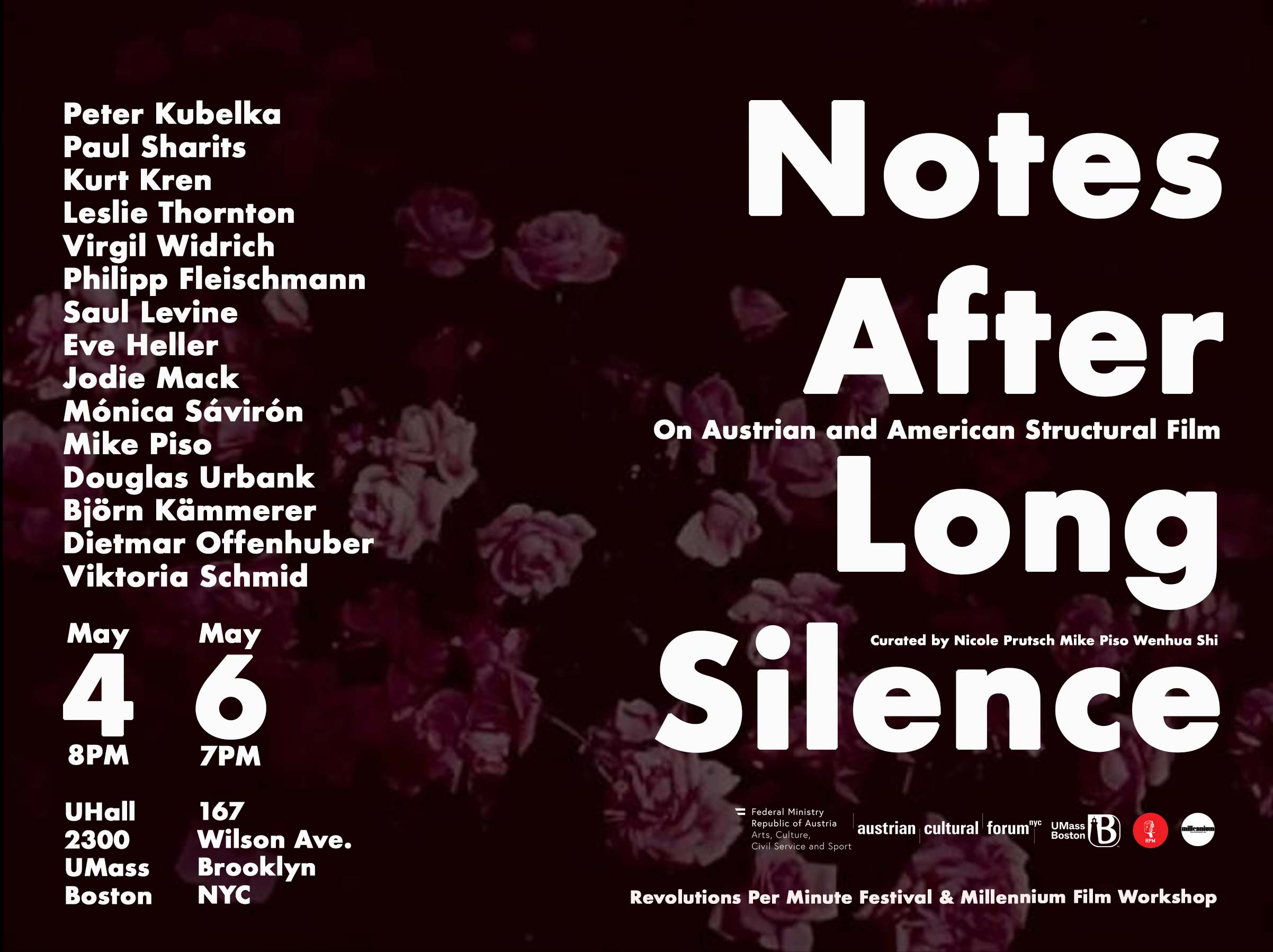
Arnulf Rainer - Peter Kubelka
| 1960| 6’30”| 16mm | Austria
T,O,U,C,H,I,N,G - Paul Sharits
| 1968| 12’| 16mm | USA
2/60: 48 Heads from the Szondi-Test - Kurt Kren
| 1960 | 4’5” | 16mm| Silent | Austria
X-TRACTS - Leslie Thornton
| 1975 | 8’30’| 16mm| USA
Ruby Skin - Eve Heller
| 2005 | 4’30" | 16mm | USA
Razzle Dazzle - Jodie Mack
| 2014 | 5’ | 16mm | Silent | USA
Untitled for William P. - Mike Piso
| 2016 | 6’46” | 16mm | Silent | USA
Portrait - Douglas Urbank
| 2014 | 5’16”| 16mm |Silent| USA
A Proposal to Project in 4:3
- Viktoria Schmid
| 2017| 2’| 16mm | Austria
The Invisible Cinema 3 - Philipp Fleischmann
| 2017 | 43" | 16mm | Silent | Austria
Untitled (Generali Foundation Vienna) - Philipp Fleischmann
|2015 | 34" | 16mm | Silent | Austria
Notes after Long Silence - Saul Levine
| 1989 | 15’| 8mm - Digital | USA
Answer Print - Mónica Savirón
| 2016 | 5’ | 16mm - Digital | Spain & USA
Navigator - Björn Kämmerer
| 2015 | 7’| Digital | Silent | Austria
Besenbahn - Dietmar Offenhuber
| 2001 | 10‘| Digital | Austria
Light Matter - Virgil Widrich
| 2018 | 5’ | Digital | Austria
runtime 97 mins 54 secs

A joint event between RPM Festival in Boston and Millennium Film Workshop in NYC is set to take place,
showcasing a special program titled "Notes after Long Silence: On Austrian and American Structural Film".
The first screening is scheduled for May 4th at 8PM, Thursday, at UMass-Boston's University Hall 2300, with the entire program subsequently
traveling to Millennium Film Workshop for a second showing on May 6th at 7PM. This program has been made possible thanks to the generous
support of various organizations, including the Austrian Federal Ministry for Arts and Culture (BMKOES), Austrian Cultural Forum New York,
UMass Boston's Art and Art History and Cinema Studies, and Millennium Film Workshop.
Filmmakers:
Peter Kubelka
Paul Sharits
Kurt Kren
Leslie Thornton
Virgil Widrich
Philipp Fleischmann
Saul Levine
Eve Heller
Jodie Mack
Mónica Sávirón
Mike Piso
Douglas Urbank
Björn Kämmerer
Dietmar Offenhuber
Viktoria Schmid.
A curatorial project by
Nicole Prutsch, Mike Piso, and Wenhua Shi.
Presented by Revolutions Per Minute Festival and Millennium Film Workshop.
Supported by the Austrian Federal Ministry for Arts and Culture (BMKOES), Austrian Cultural Forum New York, UMass Boston (Art and Art History, cinema studies), and Millennium Film Workshop.
Special thanks to Genevieve Carmel, Stefan Grabowski, Joe Wakeman, Paul Echeverria, Ty Ueda, AgX Film Collective, sixpackfilm, Canyon Cinema, Filmmakers’ Coop, Millennium Film Workshop, Umass Boston, Austrian Federal Ministry for Arts and Culture (BMKOES), and Austrian Cultural Forum New York.

Notes after Long Silence.
On Austrian and American Structural Film.
In the early 1960s, a number of filmmakers emerged in the United States and Europe to produce remarkable films that challenged any previous formal tendency
in avant-garde filmmaking. The Structuralist filmmakers—including Peter Kubelka, Tony Conrad, Paul Sharits
, and Kurt Kren––arranged their shots according to mathematical principles, attempting to produce non-narrative and non-illusionist films
to oppose the cinematic apparatus. Similar to the advent of Minimalism in painting and sculpture, structural films insisted on shape, and their content was
minimal and subsidiary to the outline. For instance, in his film 2/60: 48 Heads from the Szondi-Test (1960), Kurt Kren employed a strictly
serial sequence technique to present 48 portraits from the Szondi Test for "experimental diagnosis of human impulses" in various frame sizes and
pre-specified lengths. Meanwhile, Peter Kubelka used the most radical version of Structural arrangements to produce the first Flicker
Film, Arnulf Rainer (1960), which consisted solely of black or white frames coupled with either silence or white noise on the soundtrack.
The Flicker(1966) by Tony Conrad, another landmark in Structural filmmaking, gradually increased the frequency and pattern
complexity of black and white frames to create stroboscopic effects that could cause visual hallucinations and even epileptic seizures.
T,O,U,C,H,I,N,G (1968) by Paul Sharits further complicated the frame-by-frame approach with chromatically-varied frames
and combinations of visual and auditory repetition.
The Structural Film movement and its aesthetic principles—including serial cuts, static frames, and flicker effects—influenced several filmmakers of the next generation.
Leslie Thornton, for instance, a student of both Kubelka and Sharits, further developed the Structuralist approach in her debut experimental film X-TRACTS (1975),
which features cut-up readings of her high school diary paired with images of herself, once again exploring the territories of rhetoric, linguistics, and narrative structures.
Kubelka's co-founded institutions, the Anthology Film Archives in New York and the Austrian Film Museum in Vienna,
along with filmmakers like Saul Levine, continued to pass on the strategies of Structural Film to inspire younger generations of filmmakers to continue pushing
the boundaries of structure and materiality of film. The upcoming screening program, Notes After Long Silence, which takes its title from one of Levine's films,
traces the historical conversation of Austrian and American experimental film to the present day and explores the aesthetic and cultural limits pushed by filmmakers from both countries.
The program features works from members of the AgX Film Collective in Boston and the Schule Friedl Kubelka in Vienna, with films distributed by sixpackfilm, Canyon Cinema, and Filmmakers' Coop.
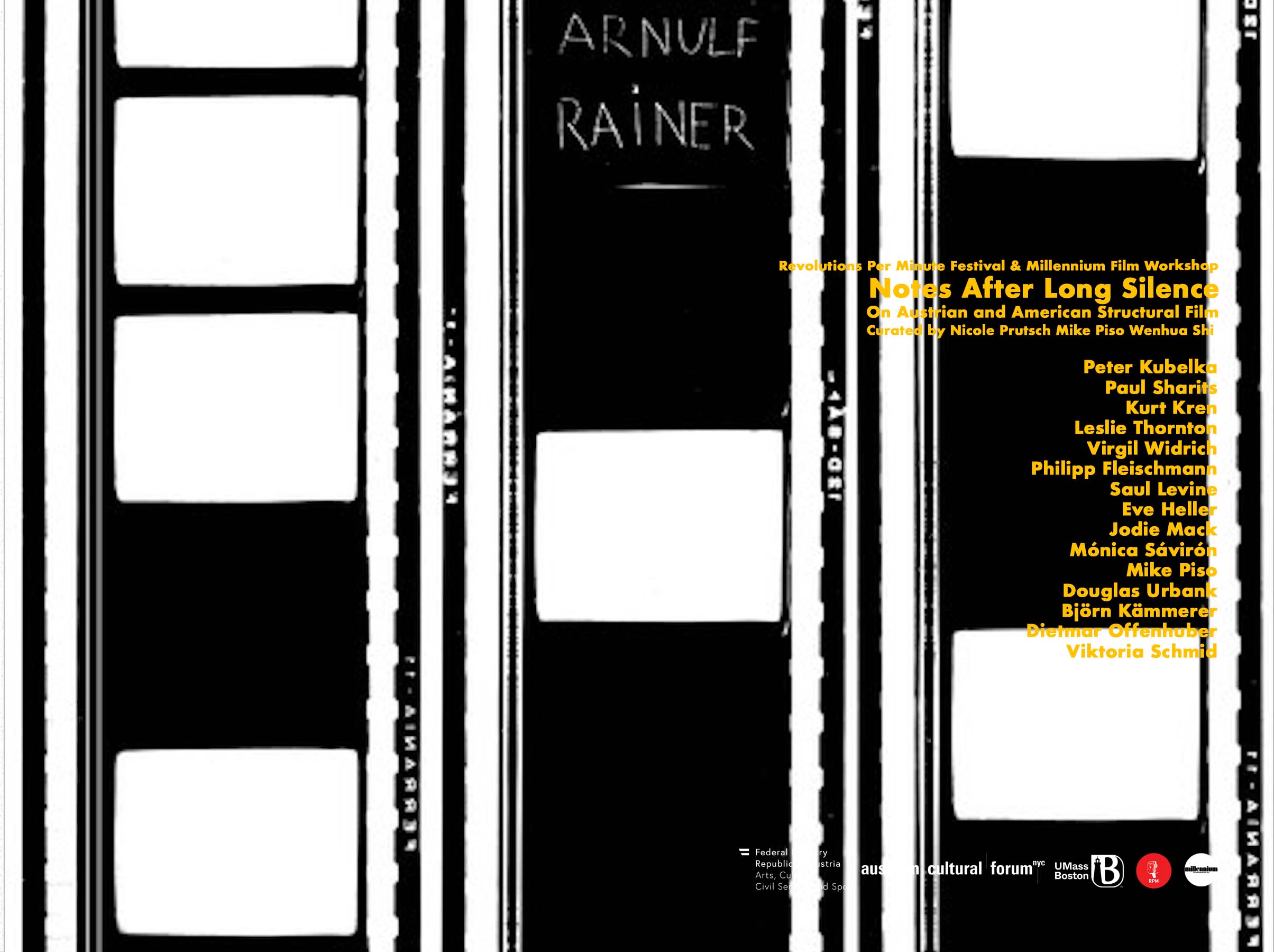
Arnulf Rainer
Peter Kubelka
| 1960| 6’30”| 16mm | Austria
This is a film composed entirely of frames of solid black and solid white, which Kubelka strings together in lengths as long as 24 frames and as short as a single frame. When he alternates between single black and white frames, a rapid flicker of motion-pictures projection; during the longer sections of darkness one waits in nervous anticipation for the flicker to return, without knowing precisely what form it will take. (Fred Camper) Arnulf Rainer, an architecture built in time by cinema uses only the four essential elements of the medium: light, darkness, sound and silence. (Peter Kubelka) With Arnulf Rainer, his third metrical film, Kubelka arrived at the most elemental components of cinematography – namely light, absence of light, sound, silence. These are the four poles from which all of cinema, all of film is suspended. Stretched to their utmost limits, all illusionism is driven out. The last trace of a spatial reproduction is extinguished. And the illusion of movement based on visual similarities of sequential frames (whose minor differences disappear upon projection and thanks to the sluggishness of perception are
transformed into an illusion of continuity) is also obliterated.
-- Peter Tscherkassky
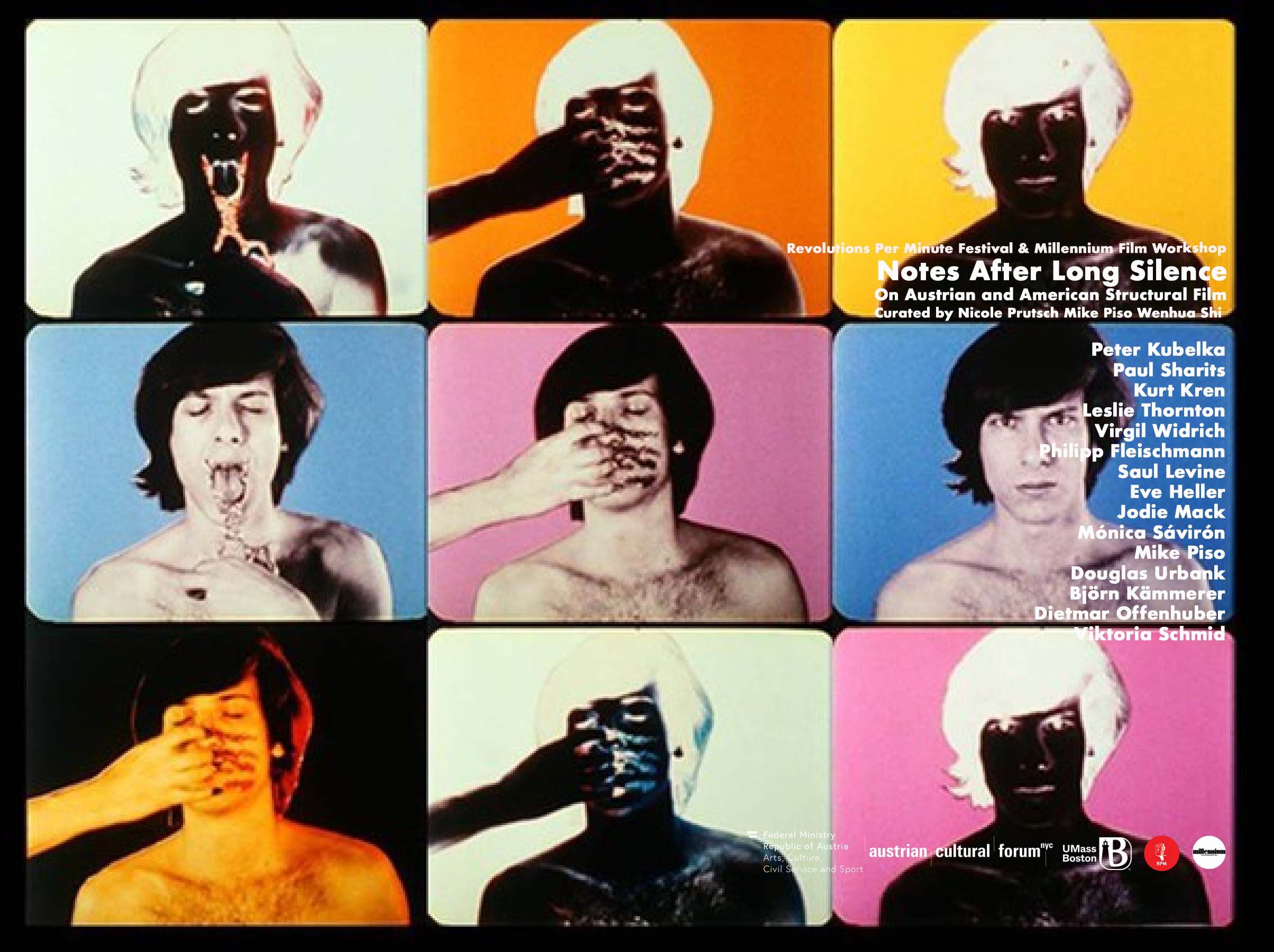
T,O,U,C,H,I,N,G
Paul Sharits
| 1968| 12’| 16mm | USA
T,O,U,C,H,I,N,G uses flickering frames of solid color juxtaposed with positive and negative still images of the poet David Franks—sometimes cutting off his own tongue with glitter-covered scissors, sometimes suffering a series of glitter-stained fingernail scratches across the face. Other rapidly alternating still images of eye surgery and a couple in the midst of intercourse. The soundtrack is a continuous looped recording of the word “destroy” over the entire length of the film.
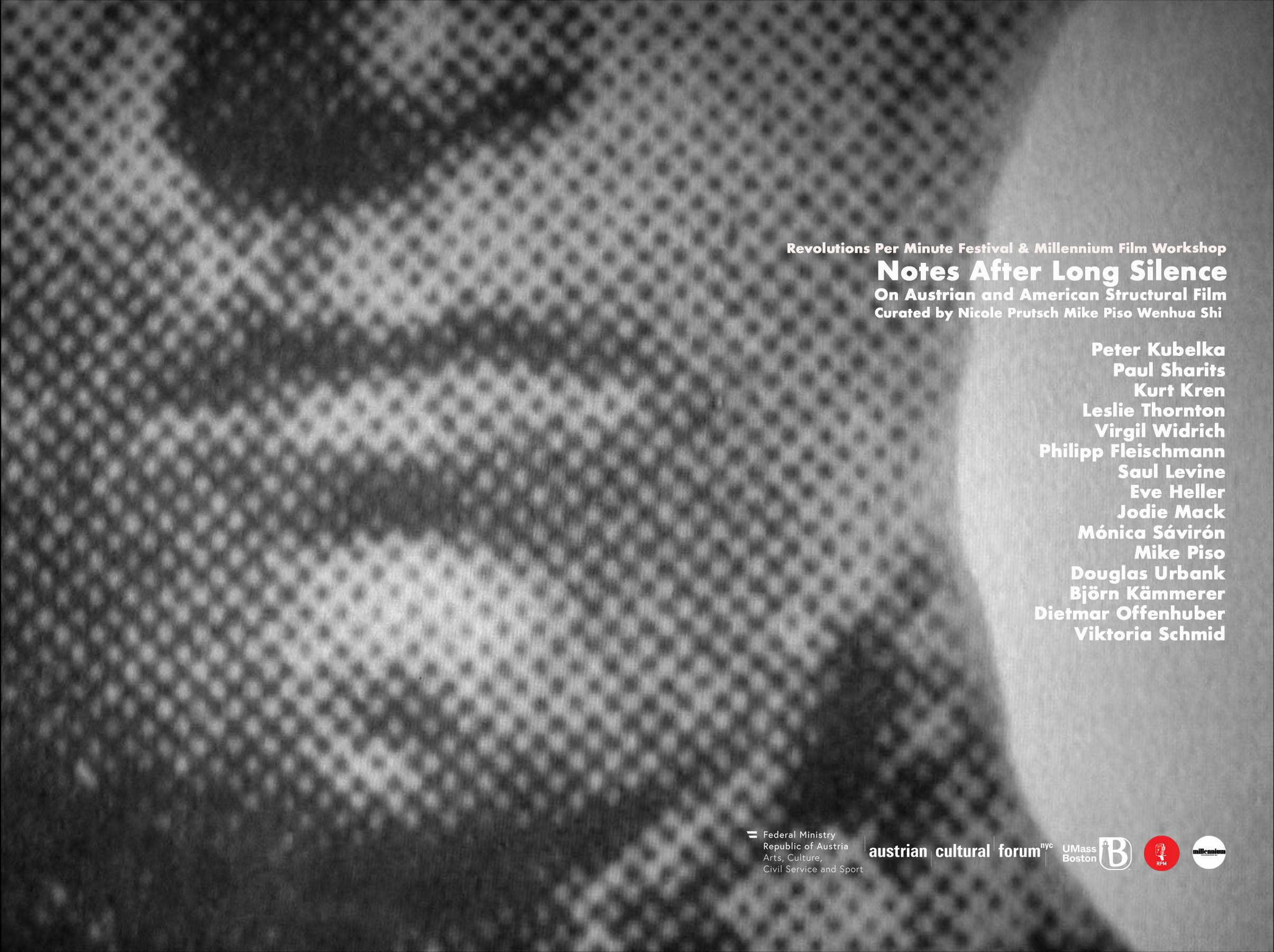
2/60: 48 Heads from the Szondi-Test
Kurt Kren
| 1960 | 4’5” | 16mm| Silent | Austria
Kren´s second film and the first he cut according to a strictly serial, sequence technique: in various framesizes, the 48 portraits from the Szondi Test for "experimental diagnosis of human impulses" are shown in pre-specified lengths (between one and eight frames).
-- Peter Tscherkassky
Kren´s 48 heads refer to a psychological procedure known as the Szondi Test. Running four minutes and shot at various speeds, Kren´s film fragments faces in extreme close-up: eyes, chins, hairlines, foreheads, with an occasional block of images using full-face. The film ends on mouths, viewed so closely as to be nearly abstracted. In 48 Köpfe body parts lose their original identification and become the subject of formal concerns.
-- Regina Cornwell (The Other Side: European Avant-Garde Cinema 1960-1980)
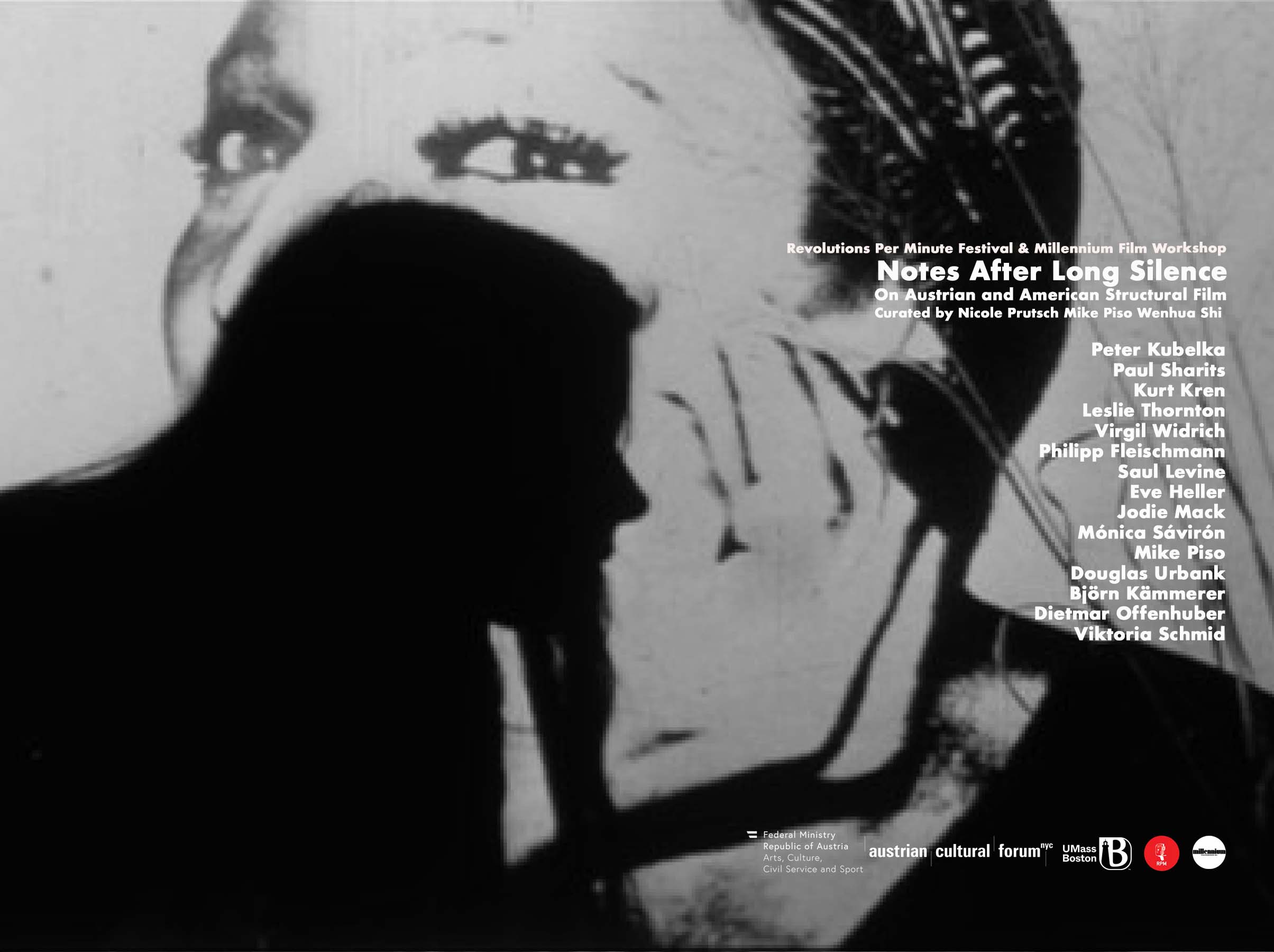
X-TRACTS
Leslie Thornton
| 1975 | 8’30’| 16mm | USA
Thornton's first 16mm film, X-Tracts was made in collaboration with cinematographer Desmond Horsfield.
The film consists of complex and rapid patterning of sound/image segments that are structured by a
formal mathematical schema that determines duration, interaction, and progression. Moving beyond the
critiques of the cinematic apparatus and its analogy to language that were central to that time
(Hollis Frampton's Hapax Legomena or Paul Sharit's T:O:U:C:H:I:N:G, for example), Thornton expands
into the territories of rhetoric, cognition, and linguistics. Composed of a cut-up reading of Thornton's
high school diary paired with images of the filmmaker, fragments of the body in motion or at rest, and
just-occupied spaces, X-Tracts seems both to defy and propose an autobiographical narrative.
The film has been described by Chrissie Iles, curator at The Whitney Museum of American Art,
as the "missing link" between the structuralists and the introduction of a more narratological tendency
in experimental film practice.
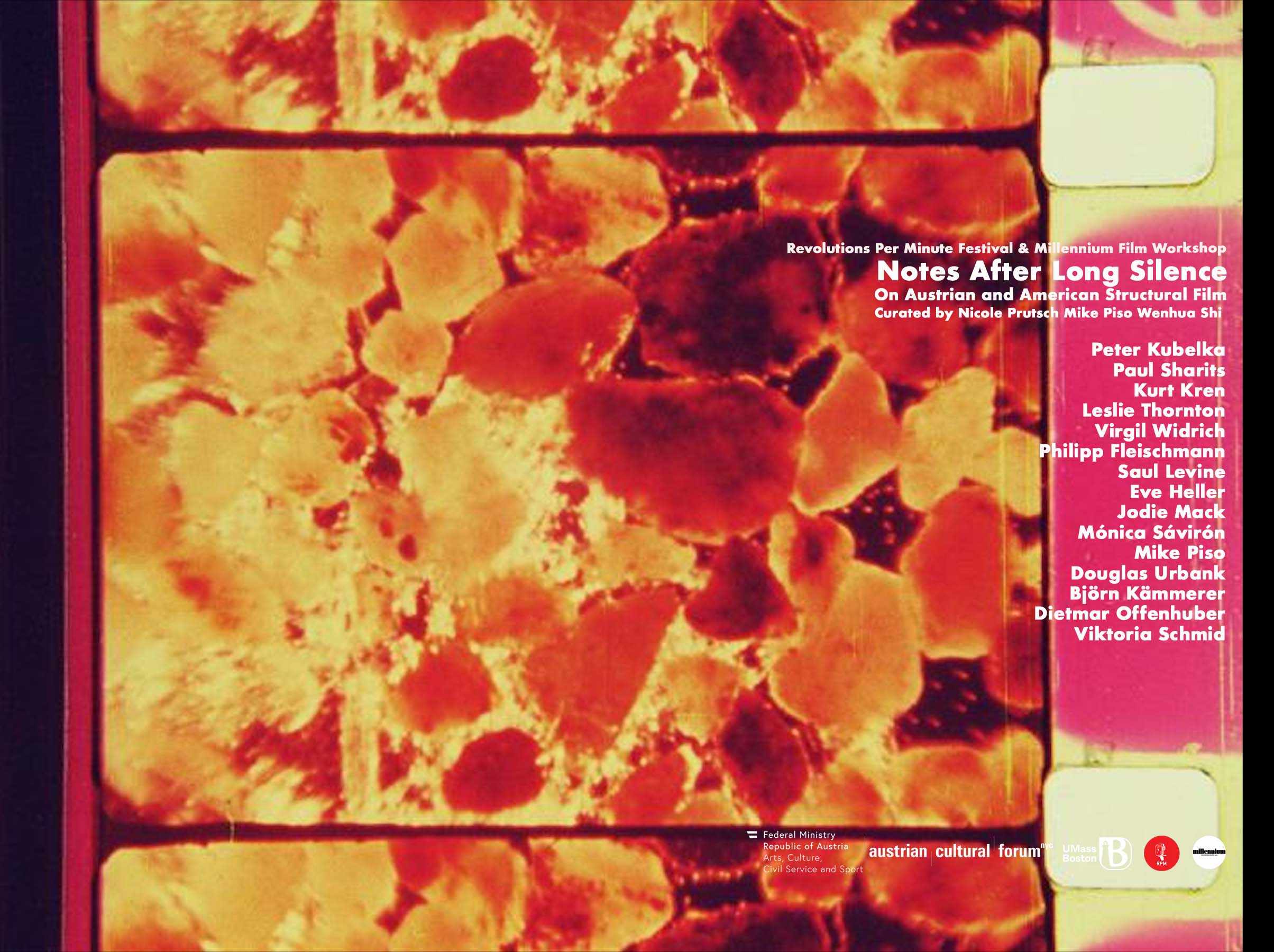
Ruby Skin
Eve Heller
| 2005 | 4’30" | 16mm | USA
A found footage film that taps into the poetic tradition of the language cut-up,
while taking filmic advantage of the 26 frame displacement between sound and image inherent
to 16 mm film’s optical soundtrack system. The magenta-shifted fragments of an educational movie on
"Reaching Your Reader" reveal their chemistry where the splicing tape pulled away a “ruby skin” of the emulsion,
leaving a green tear at the edit points. Ruby Skin is a material homage to the disappearing medium of 16 mm film
and some of its idiosyncrasies.
-- Eve Heller
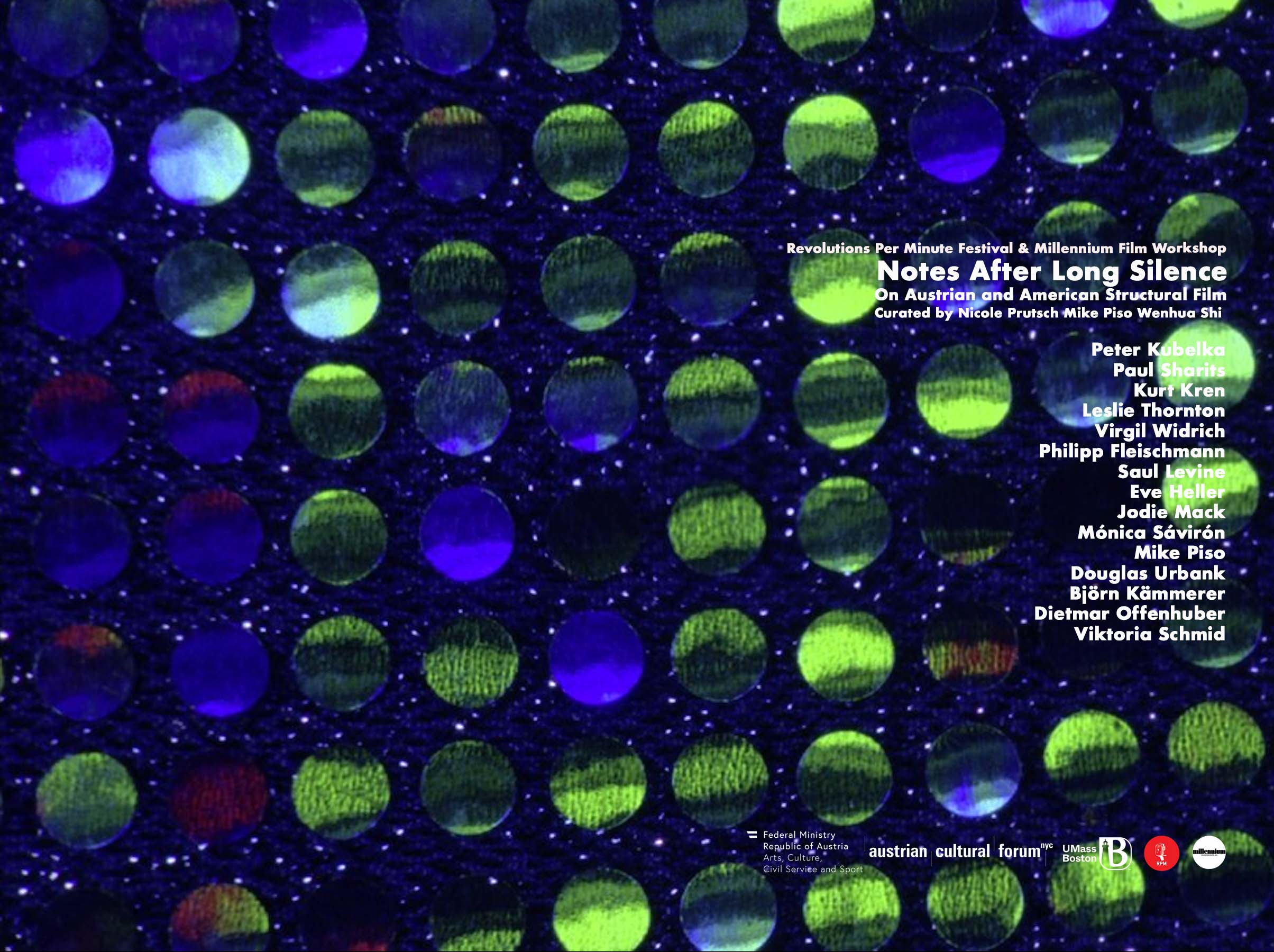
Razzle Dazzle
Jodie Mack
| 2014 | 5’ | 16mm | Silent | USA
Tacky threads luminesce at a firefly’s pace, twinkling through remnants of chintzy opulence and gaudy glamour
prestissimo brilliante. Razzle Dazzle is an iridescent animated flicker film about textiles which lend a new and
dizzying dimension to the illusion of glamour. In her usual psychedelic style,
Jodie Mack takes a look at the material production of desire.

Untitled for William P.
Mike Piso
| 2016 | 6’46” | 16mm | Silent | USA
For nine years Mike Piso worked in various roles at a day program for artists with intellectual disabilities in the Boston area. This short film is a black-and-white study of many colorful drawings and paintings by William, an outsider artist who attended the program for about ten years before he died at home. He was an artist of few words but created a fascinating and haunting body of work.
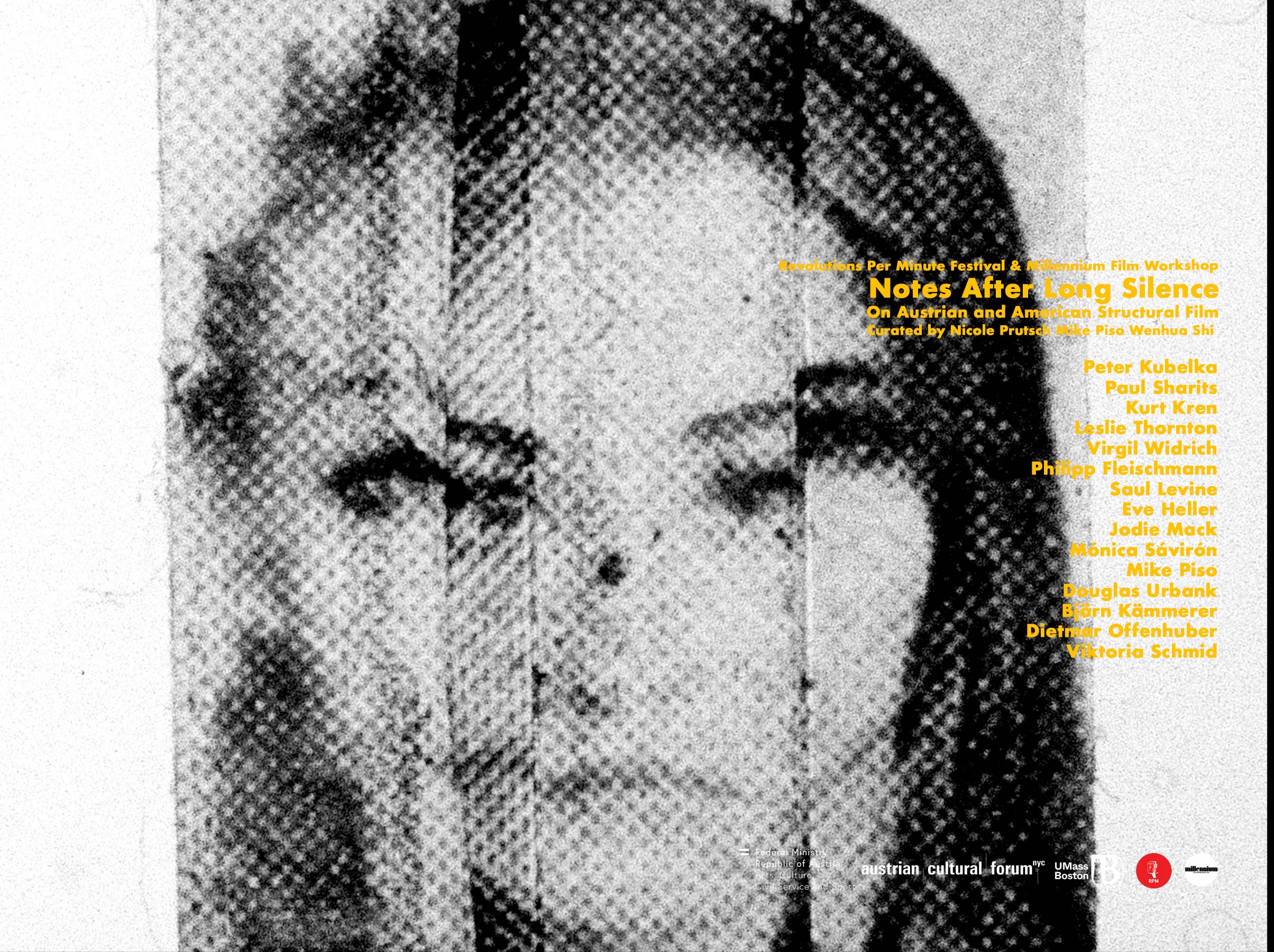
Portrait
Douglas Urbank
| 2014 | 5’16”| 16mm |Silent| USA
An imagined portrait, a handmade, stream-of-consciousness improvisation.
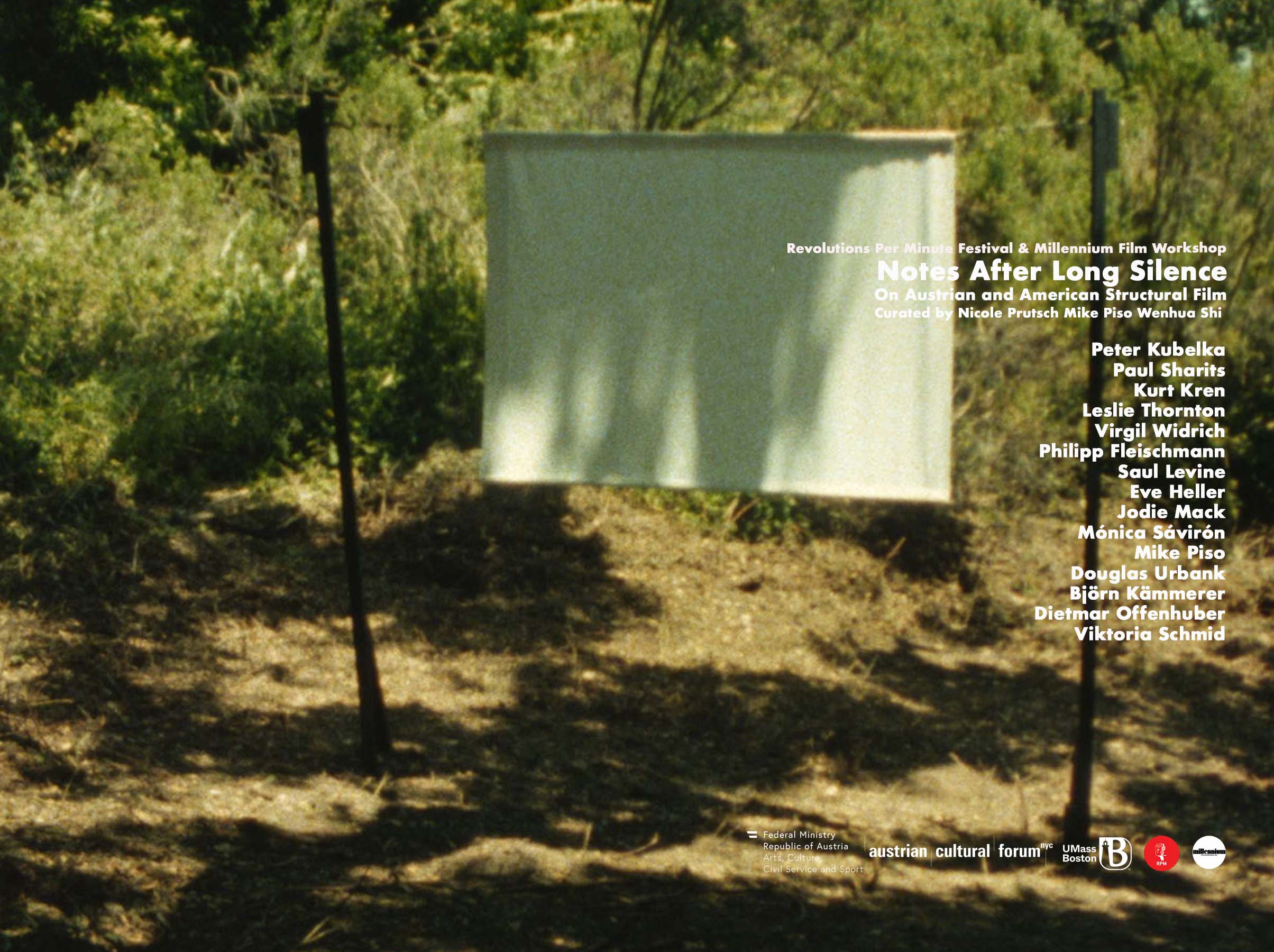
A Proposal to Project in 4:3
Viktoria Schmid
| 2017| 2’| 16mm | Austria
Schmid builds her own projection screens ranging from aspect ratios currently in use (in this case 4:3, the format she uses the most often, 16mm being her primary medium) to entirely fictitious ones (the 4:1 Viktoriascope) and if possible she then films them in the exact same aspect ratio. While at the Djerassi Artist in Residency Program in California, the artist constructed a screen with wood and canvas and installed it in the program’s sculpture park. Still standing there, it is an unexpected object on the way to a scenic view of the rolling hills on the Djerassi property. In A proposal to project in 4:3, Schmid shot this site-specific installation over the course of a single day when the screen became projection surface for the subtle interplay of shadow and light from the surrounding trees and shrubs. Cinema without film.
-- Claudia Slanar
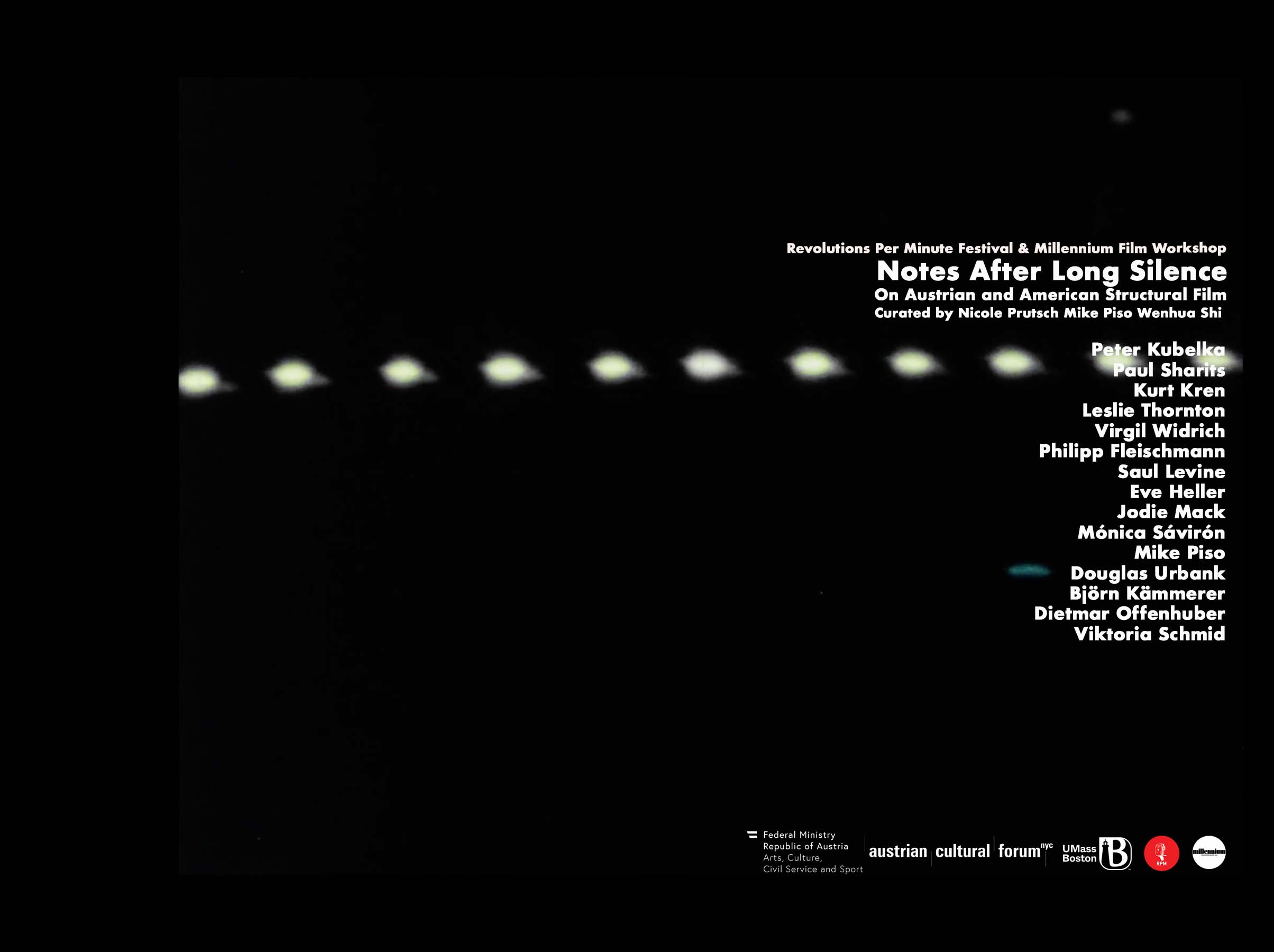
The Invisible Cinema 3
Philipp Fleischmann
| 2017 | 43" | 16mm | Silent | Austria
Conceived by filmmaker Peter Kubelka as a ´viewing machine` not
supposed to distract, in which only the film being projected should
“completely dictate the sensation of space”, the history of the
Invisible Cinema went through several locations and appearances (with
more and less ambitious setups, it was built in 1970 in New York City,
then in Vienna in 1989 and later remodeled in that same spot in 2003)
always according to the minimalistic maxim of being a completely black
box, with no reflective surfaces except the screen. That same sense of
visionary austerity, in which the respect for an art of lights and
shadows gives way to an experience of unparalleled vision, is what
Fleischmann seems to have channeled as a sort of filmmaker-medium.
Half phantasmagory, half blueprint in motion, The Invisible Cinema 3
is a 43-second blitzkrieg immersion into the total blackness of the
building whose only diversion is marked by a series of oscillating
white dots (the room lights) that parade through the frame upwards and
sidewards. The result is a cold and hypnotic miniature, a tiny slice
of unmediated reality that throws upon its viewer a barrage of
questions about the nature of the film medium too powerful to leave
the theater unharmed.
High on concept, the fact that Fleischmann’s whole creative endeavor
materializes into less than a minute of silent film (with barely any
image to see) ultimately speaks of an unbreakable pact with the
process rather than of a certain disappointment from the perspective
of the audience.
-- Pablo Marin (filmmaker and theorist)
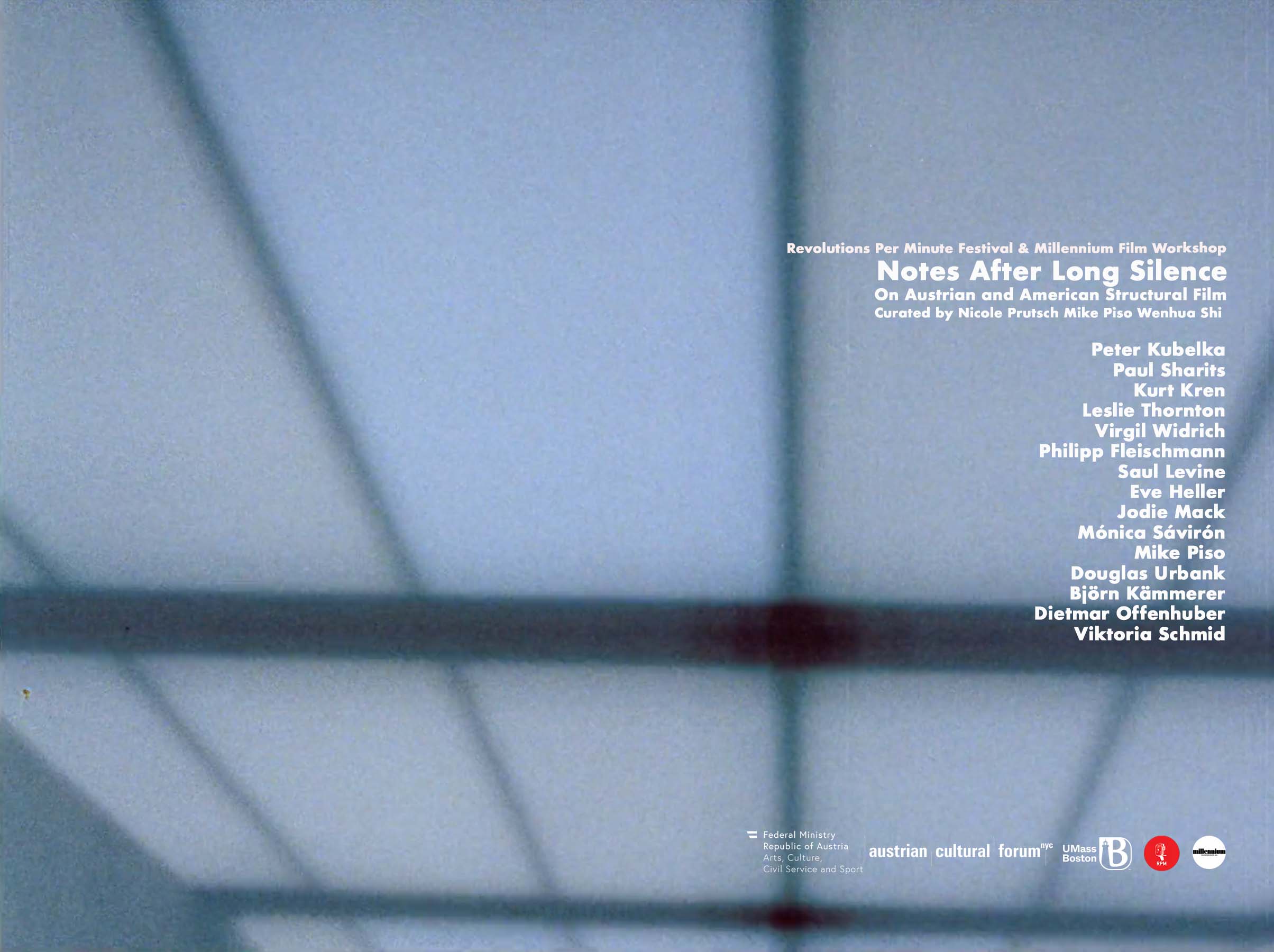
Untitled (Generali Foundation Vienna)
Philipp Fleischmann
|2015 | 34" | 16mm | Silent | Austria
Philipp Fleischmann builds camera objects for his films. This process results in films that are difficult to assign to existing categories of a film or art theoretical consideration, so that they in turn have the challenge of stepping out of the box and, as it were, of building the terms for what is perceived and its language depending on the situation . All these steps are integral elements of a work and an artistic-methodical sensitization for institutional norms of longing, which perhaps based on Keller Easterling‘s considerations on a living space in infrastructures and Karen Barad‘s concept of intra-action for subject-object relationships as (intra- ) can be described institutionally. In this respect, or consequently, in the case of Untitled (Generali Foundation Vienna), in addition to the film material, there are also photographic recordings from the cinematic-photographic recording instruments. The installation views were taken exactly at the time the exhibition space, which is now history, was closed. The artistic work was not commissioned, instead it seems to be precisely the insistence on reciprocal addressing that unfolds in the films.
-- Rike Frank (art historian)
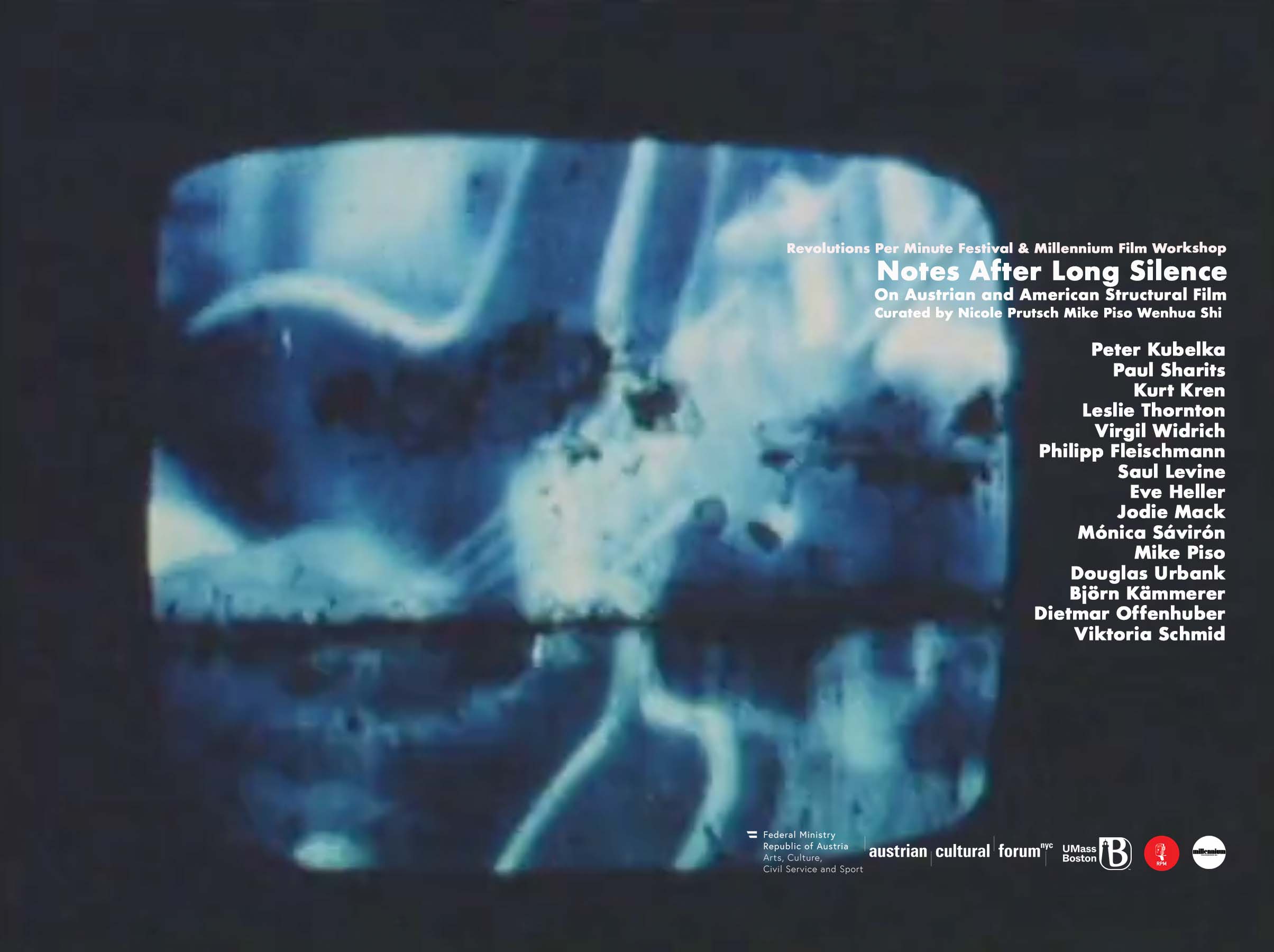
Notes after Long Silence
Saul Levine
| 1989 | 15’| 8mm - Digital | USA
In title and content NOTES AFTER LONG SILENCE directly alludes to Levine's '60s protest film,
NEW LEFT NOTES, as well as to the SDS newspaper of the same name he once edited. It's also a startling
companion piece to Oliver Stone's Born on the Fourth of July. If Stone is ultimately ambivalent about Vietnam,
Levine is not. A nameless vet in Fourth of July greets Tom Cruise's paraplegic Ron Kovic with 'Just what we need,
another limp dick.' In NOTES AFTER LONG SILENCE, ugly, ruddy close-ups of a flaccid penis begin to dominate the
blitzkrieg montage; the limp dick isn't innocent bystander to America's Fall, but guilty witness. Yet the final
images are of bouncy shtupping, a make-love-not-war, antiheroic corrective to Stone's mythic posturing.
– Manohla Dargis, The Village Voice
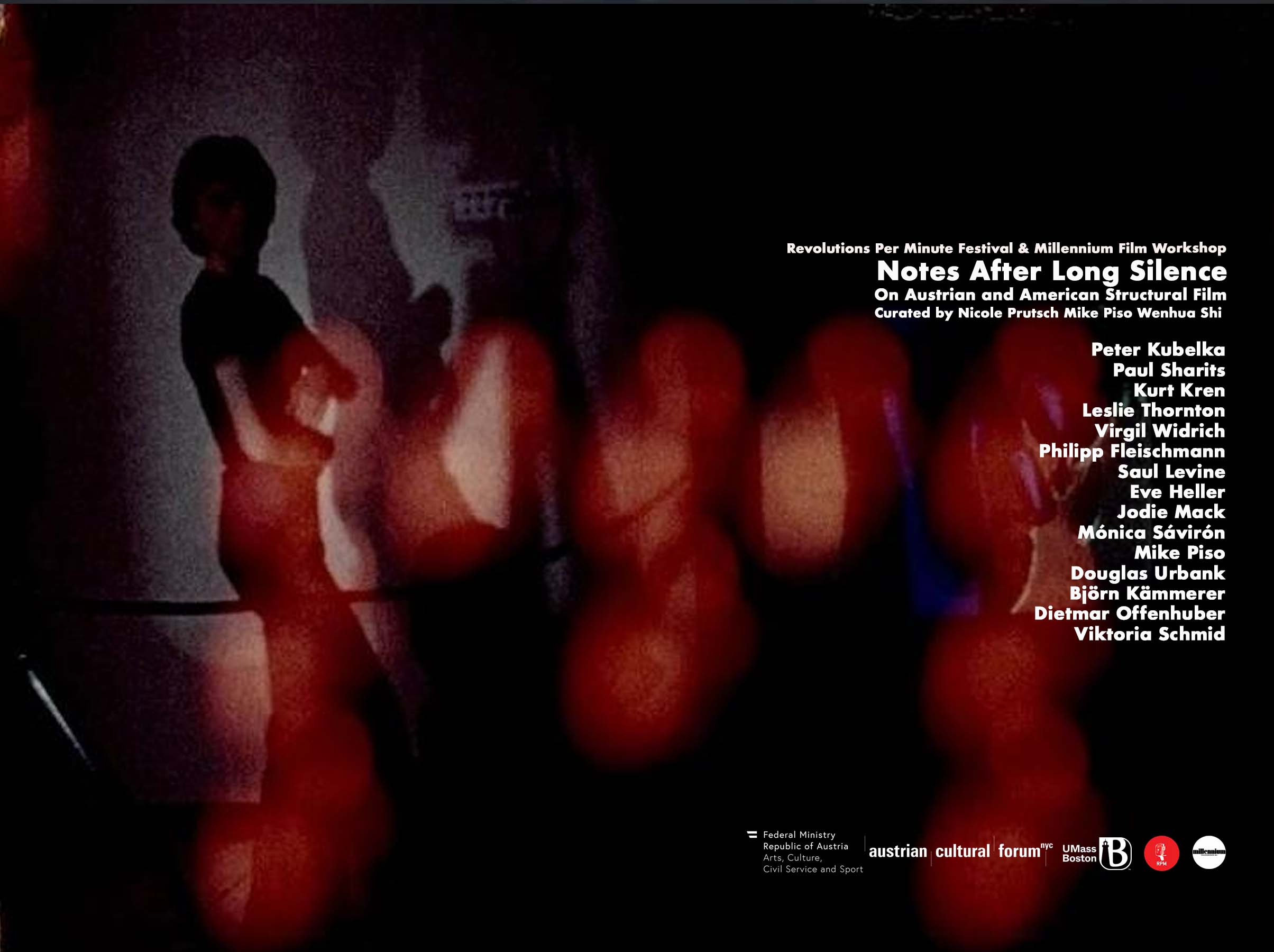
Answer Print
Mónica Savirón
| 2016 | 5’ | 16mm - Digital | Spain & USA
The fading that devastates color films occurs in the dark. It is accelerated by high temperatures and, to a lesser extent, relative humidity. Dye fading is irreversible. Once the dye images have faded, the information lost cannot be recovered.
An answer print is the first film after the original has been timed for every shot with fades and dissolves if any. The question that it answers is ‘what is this going to look like’, and ‘what corrections, if any, are needed’
-— Bill Brand
Answer Print is made with deteriorated 16mm color stock, and it is meant to disappear over time. Neither hue nor sound has been manipulated in its analog reassembling. The soundtrack combines audio generated by silent double perforated celluloid, the optical tracks from sound films, and the tones produced by each of the filmmaker’s cuts when read by the projector. The shots are based on a 26-frame length: the distance in 16mm films with optical tracks between an image and its sound.
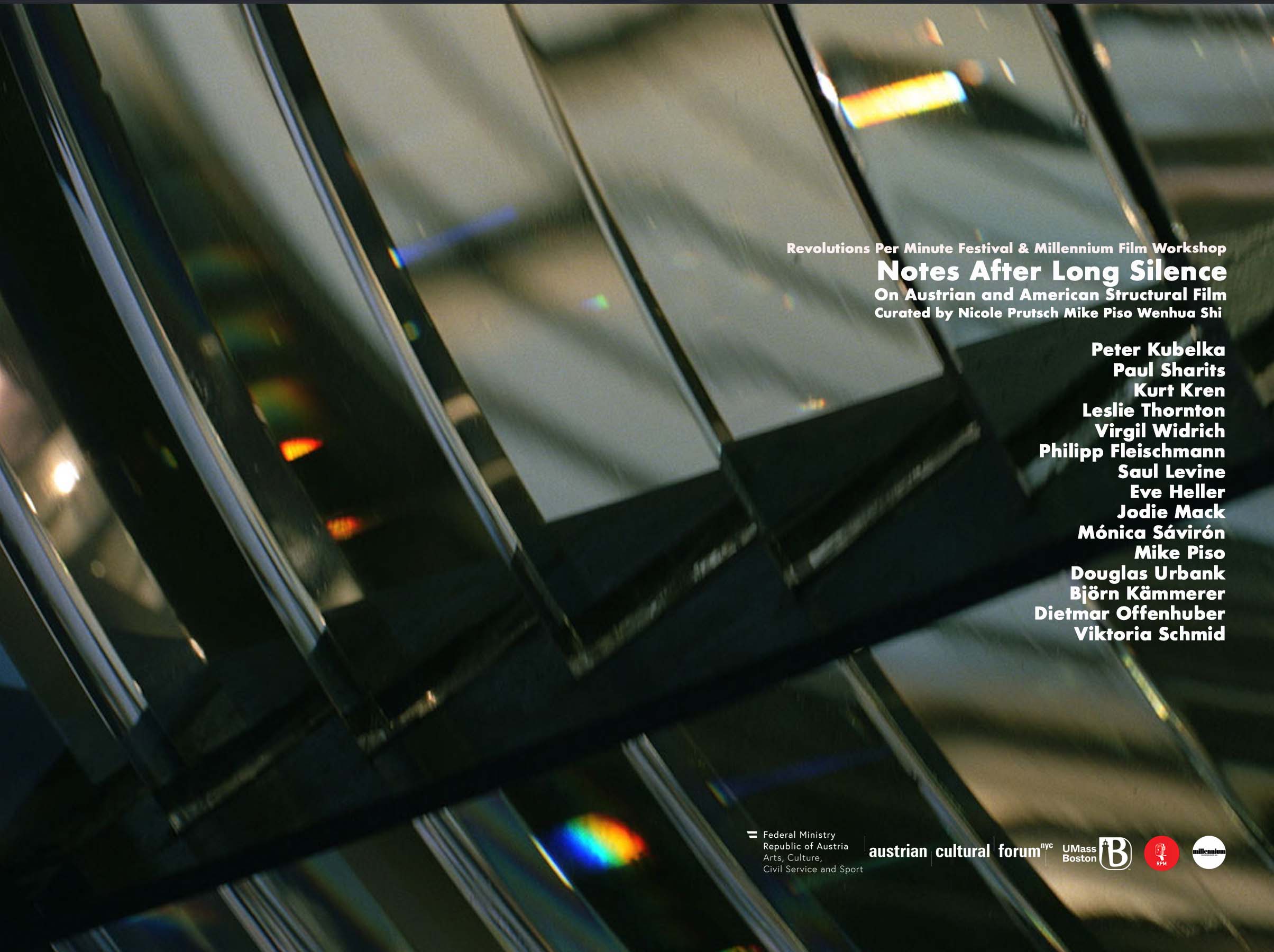
Navigator
Björn Kämmerer
| 2015 | 7’| Digital | Silent | Austria
Normally a navigational device or navigator serves to provide orientation in unfamiliar territory,
to establish paths in the middle of nowhere by means of geometric aids. But what happens when space and its record,
region and map, merge and begin to intertwine? In NAVIGATOR Björn Kämmerer creates a kind of seeing machine that
executes exactly such a convolution.
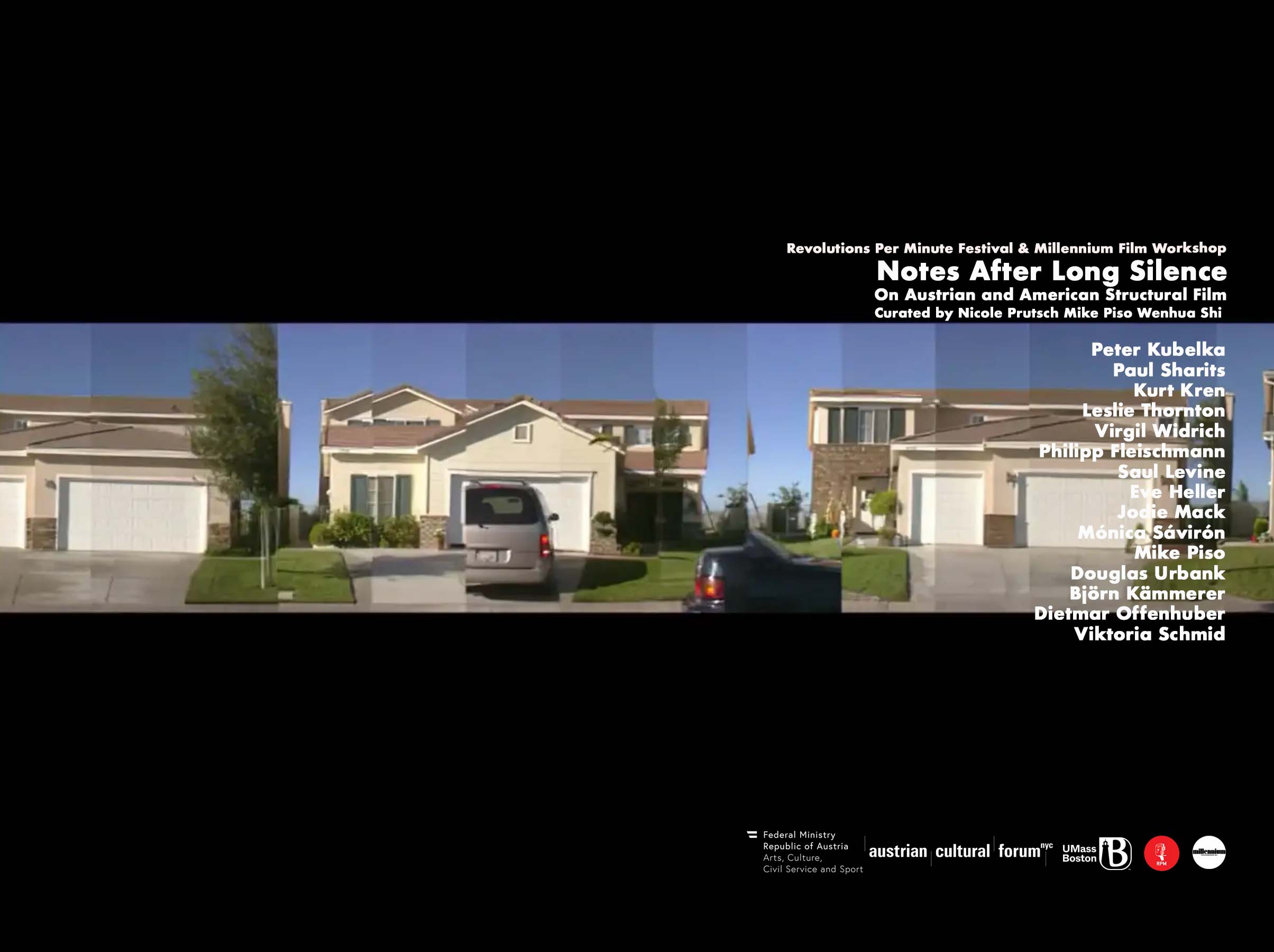
Besenbahn
Dietmar Offenhuber
| 2001 | 10‘| Digital | Austria
Perceiving perception: Through media, this is simultaneously possible and impossible. The important thing about moving images is what is moving rather than what is causing the movement.
But the fact sometimes tends to be forgotten that the animated image could not exist without the viewer´s illusionary assumption that he or she is not seeing individual frames but continuous motion.
As a result, it should not surprise when film or videographic experiments are at their core reflections on forms of perception conveyed through various media, their purpose to make accessible the
circumstances under which sensuous experience takes place, which are dictated by the media. This all applies to besenbahn, though the problem is made more complex by the reference to perception which
itself requires the use of technical apparatus. Its subject is not "natural" perception, but perception put in motion by modern means of transportation, and therefore implicitly the history of an epochal
transformation of the way in which time and space is experienced. It has come to a preliminary end in suitable contexts - for example cities such as Los Angeles, which has been shaped by the history of motorization -
where moving perception now seems to be regarded as integral to natural perception.
The thesis presented by besenbahn in this regard would therefore be that the specifically aesthetic quality of such animated perception is absent from the forms of audiovisual representation which are already considered natural
(such as indicating movement by means of a tracking shot): In its fragmentation of the continuum of perception, the "subjective geometry which defines space through intervals of time" (Dietmar Offenhuber) illustrates a manner
of experience which could remain submerged because it is already so familiar.
-- Vrääth Öhner
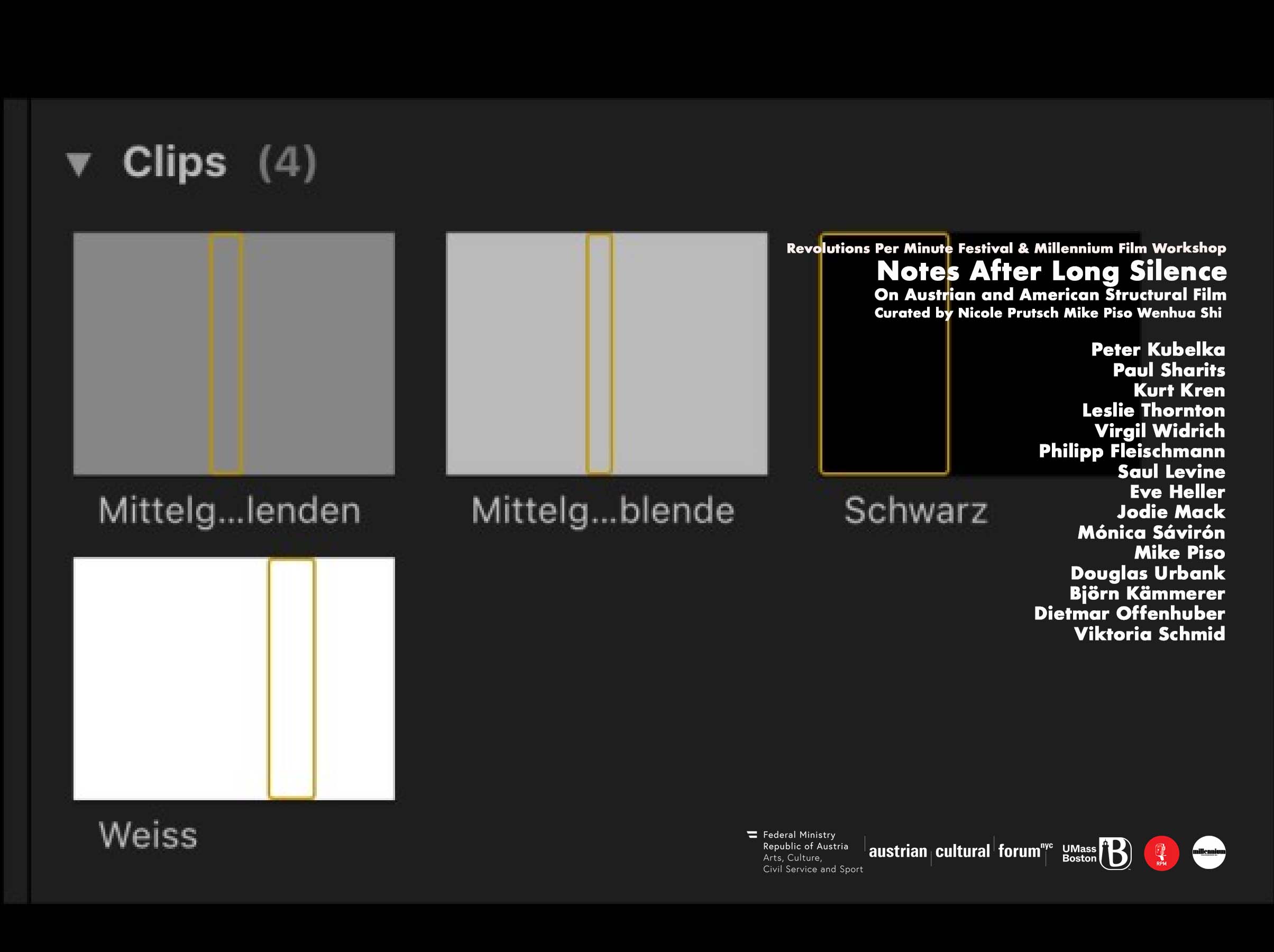
Light Matter
Virgil Widrich
| 2018 | 5’ | Digital | Austria
Five minutes of pure irritation of the retina in the human eye. It all starts with dim flashes of light slowly intensifying into a staccato of dark and light, with extreme contrasts. Stimulating the eye´s photo-receptors, the impulses work their way to the brain, creating an illusion of color where there is nothing but an inferno of black and white. Virgil Widrich refers to a phenomenon first described by two scientists in the 19th century. The effect is perceived differently by every viewer. You may glimpse some distant colors in the depths of the strobe, or you may be reminded of 1980s´ gaming aesthetics with visuals flashing in red and green.
-- Gunnar Landsgesell (Viennale 2018)
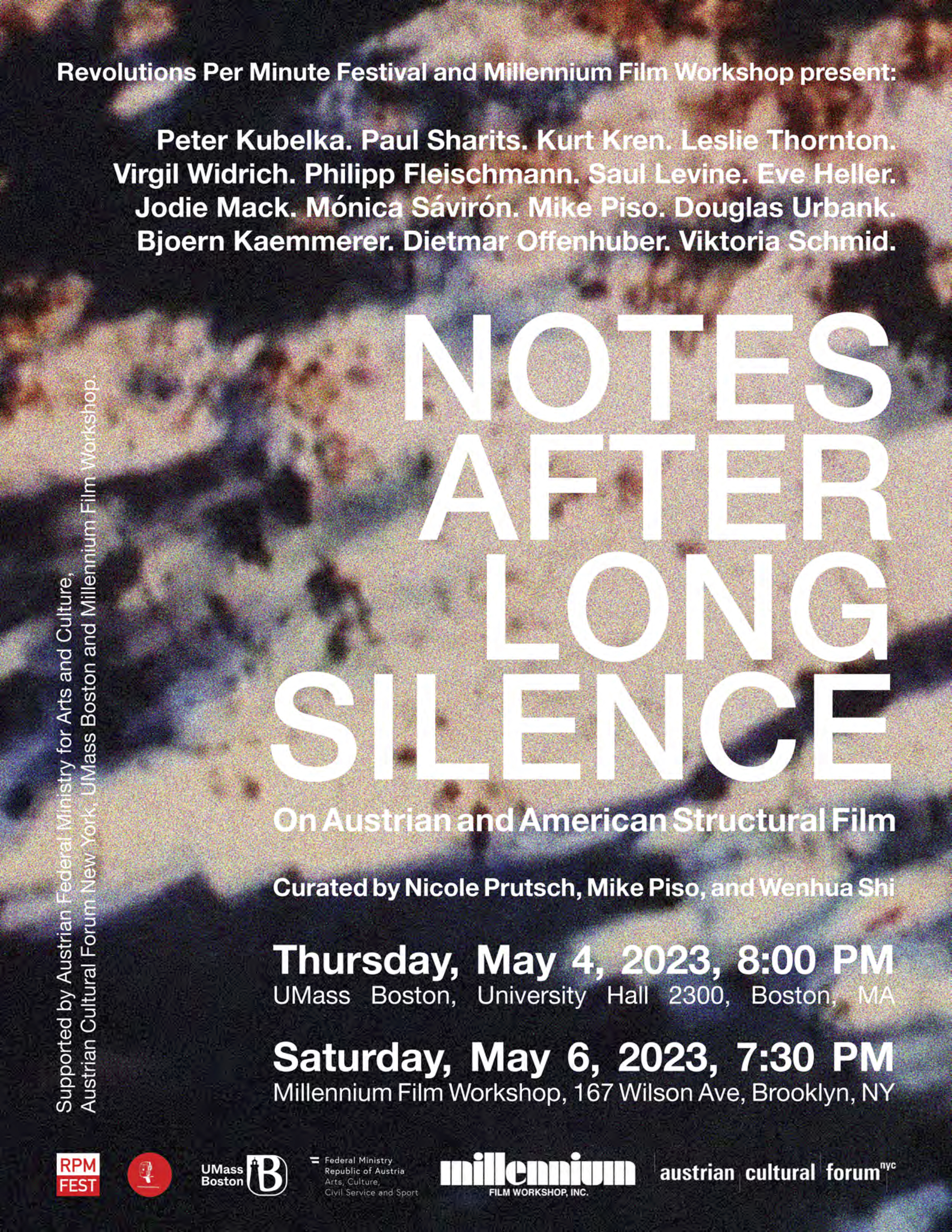
Please note that some parts of the programme are not adapted to people with PSE (Photosensitive epilepsy).

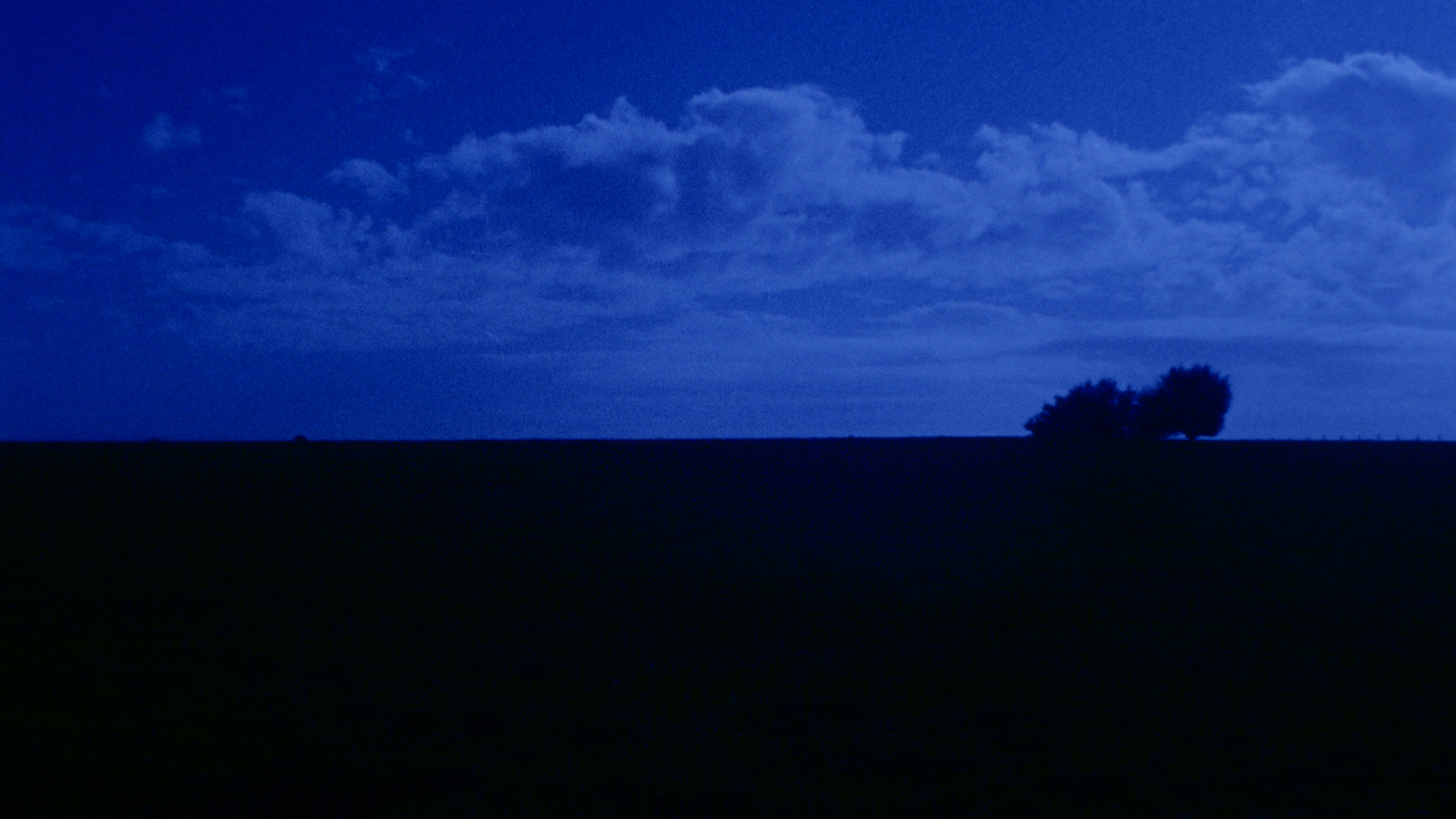
Sound Over Water,
4 mins, 16mm, color/sound, 2009
Orpheus (outtakes),
6 mins, 16mm, col/BW/sd. 2012
The Dragon is the Frame,
14 mins, 16mm, color/sound, 2014
The Glass Note,
9 mins, Digital, col/bw, 2018
Figure Minus Fact,
13 mins, Digital, col/bw, 2020
Exhibition,
19 mins, Digital, col/bw, 2022
Post Screening Q&A
Mary Helena Clark & Malic Amalya
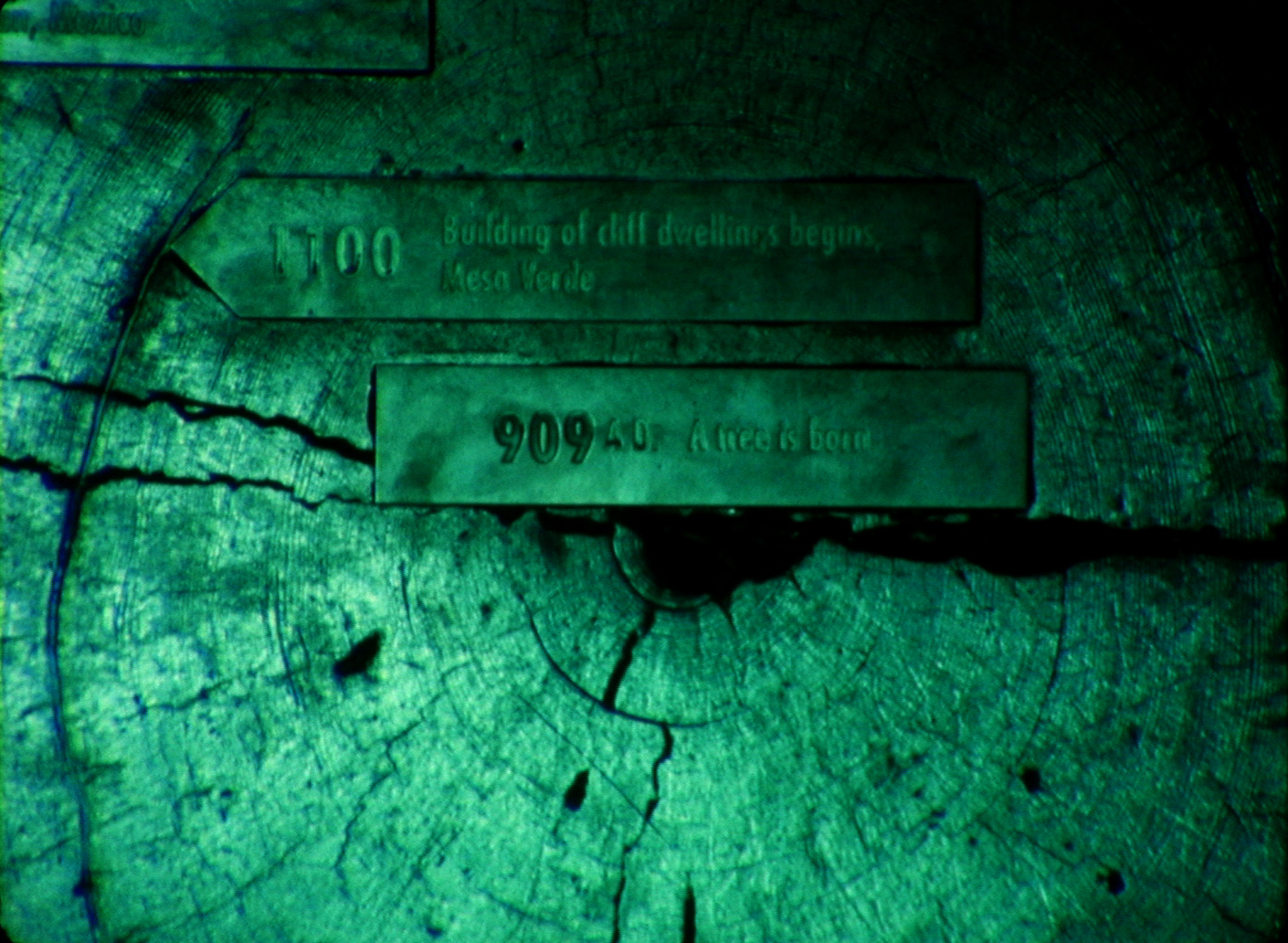
RPM and The Brattle Theatre are thrilled to co-present a program of experimental short pieces by artist Mary Helena Clark. The screening will take place on on April 12, Wednesday 7PM at The Brattle Theater in Cambridge, MA., titled Figure Minus Fact
Mary Helena Clark is a multi-faceted artist working in film, video, and installation based in Queens, New York. A collection of six short films is classified as trance-like, transparent films, where she explores narrative figures of speech, the materiality of film, and the artifacts from the painting technique trompe l'oeil to CGI models. Using the language of collage, her work investigates dissociative states through cinema, bringing together disparate subjects and styles that suggest an exterior logic or code. Her films blend conventions of narrative, language, and genre to shift subjectivities and push the limits of the embodied camera.
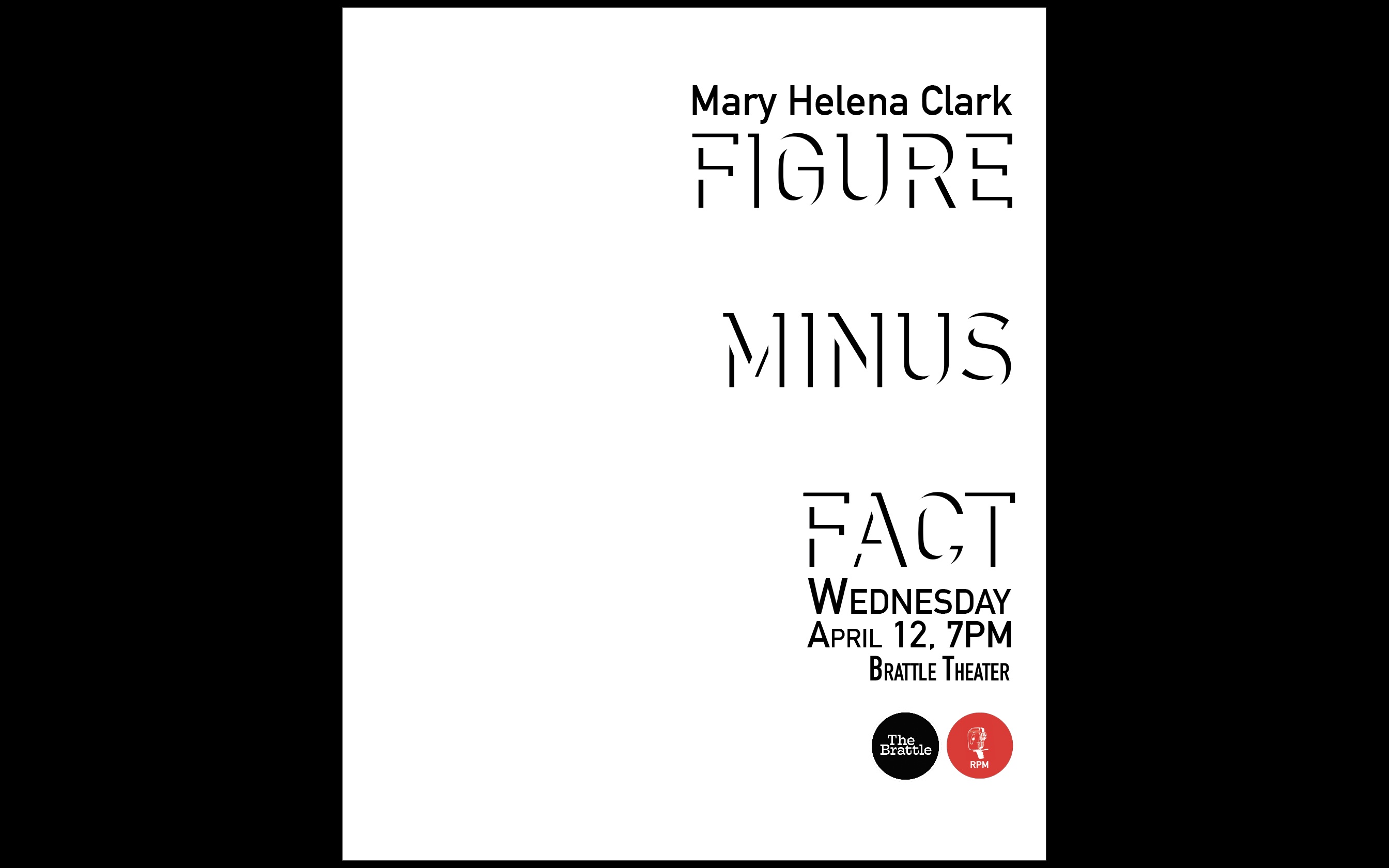
Her work has been exhibited at a variety of prestigious venues, including Sundance Film Festival, the International Film Festival Rotterdam, New York Film Festival, Toronto International Film Festival, Cinéma du Réel, Viennale, Anthology Film Archives, Wexner Art Center, the National Gallery of Art in Washington DC, and MIT List Visual Arts Center. In 2017, her work was featured in the Whitney Biennial.
Post Screening Q&A
with Mary Helena Clark & Malic Amalya
Malic Amalya is an Assistant Professor in the Department of Visual & Media Arts
at Emerson College and is a filmmaker who creates films exploring themes related to attachment, identity, and relationships.
He also curates INFRARED, a program of experimental films from underrepresented queer and trans voices.
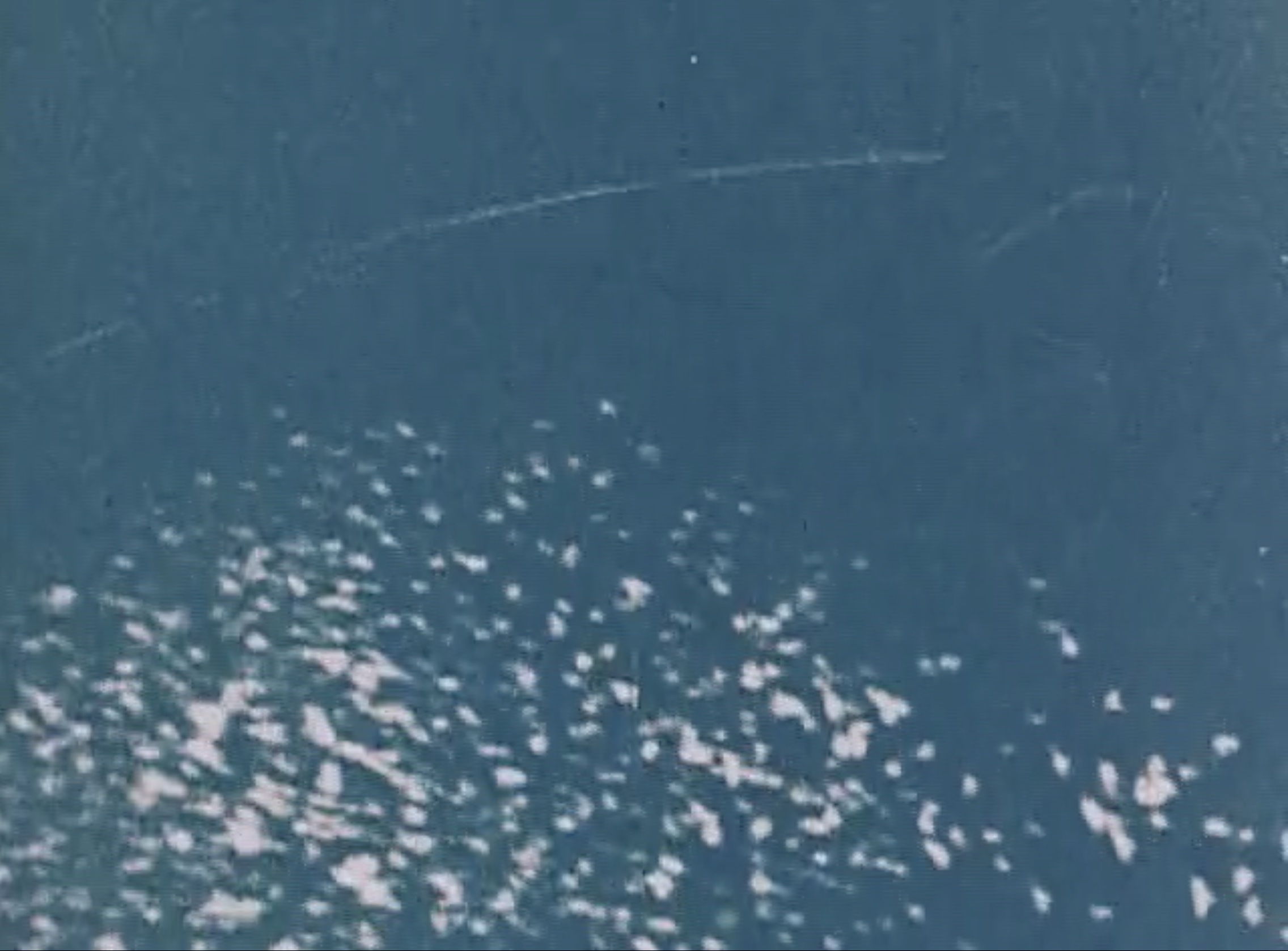
Sound Over Water
2009, 4 minutes (16mm)
Blue sky and blue sea meet on emulsion.
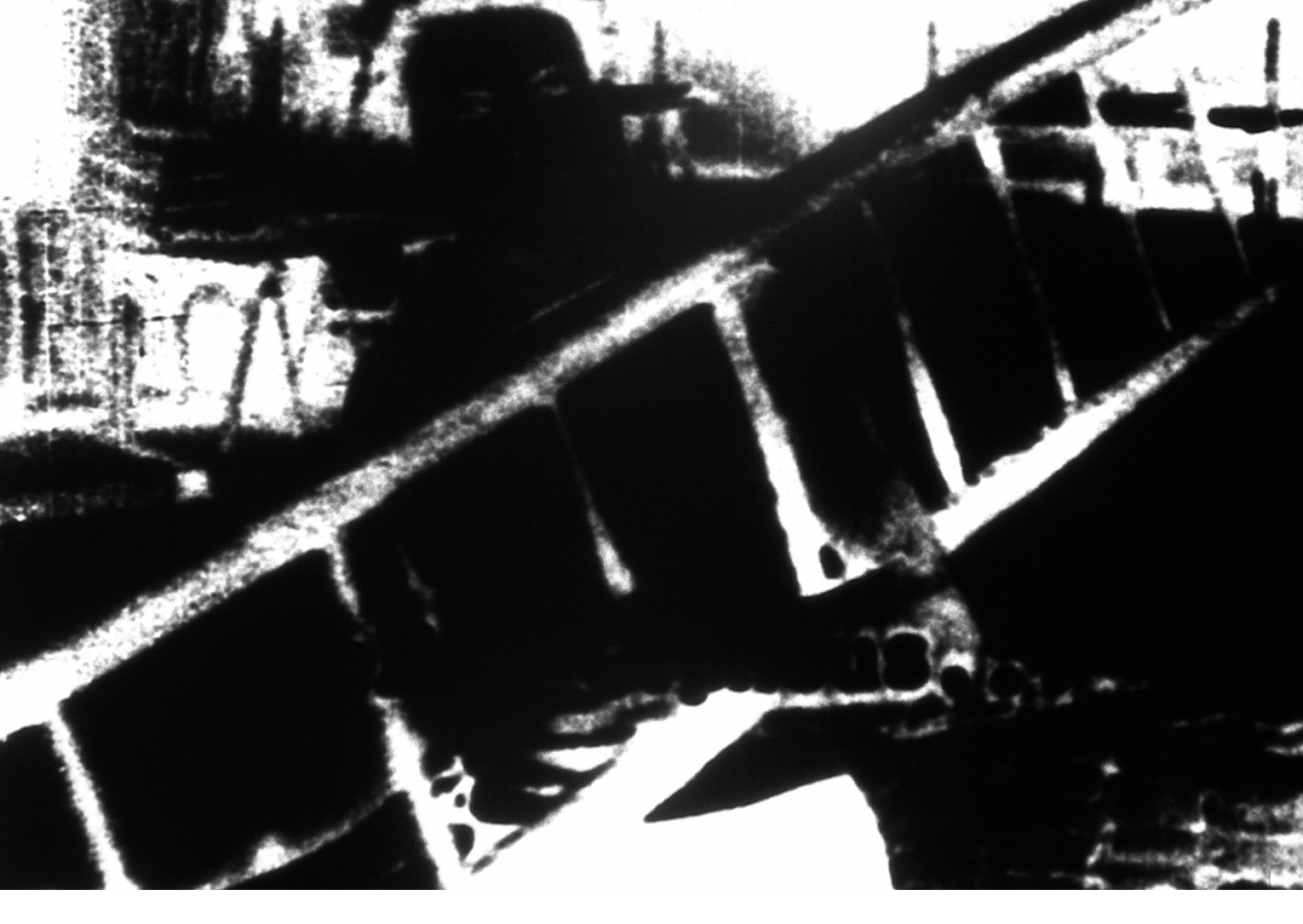
Orpheus (outtakes)
2012, 6 minutes (16mm)
Using footage from Cocteau's Orphée, Clark optically prints an interstitial space where the ghosts of cinema lurk beyond and within the frames. (Andrea Picard)
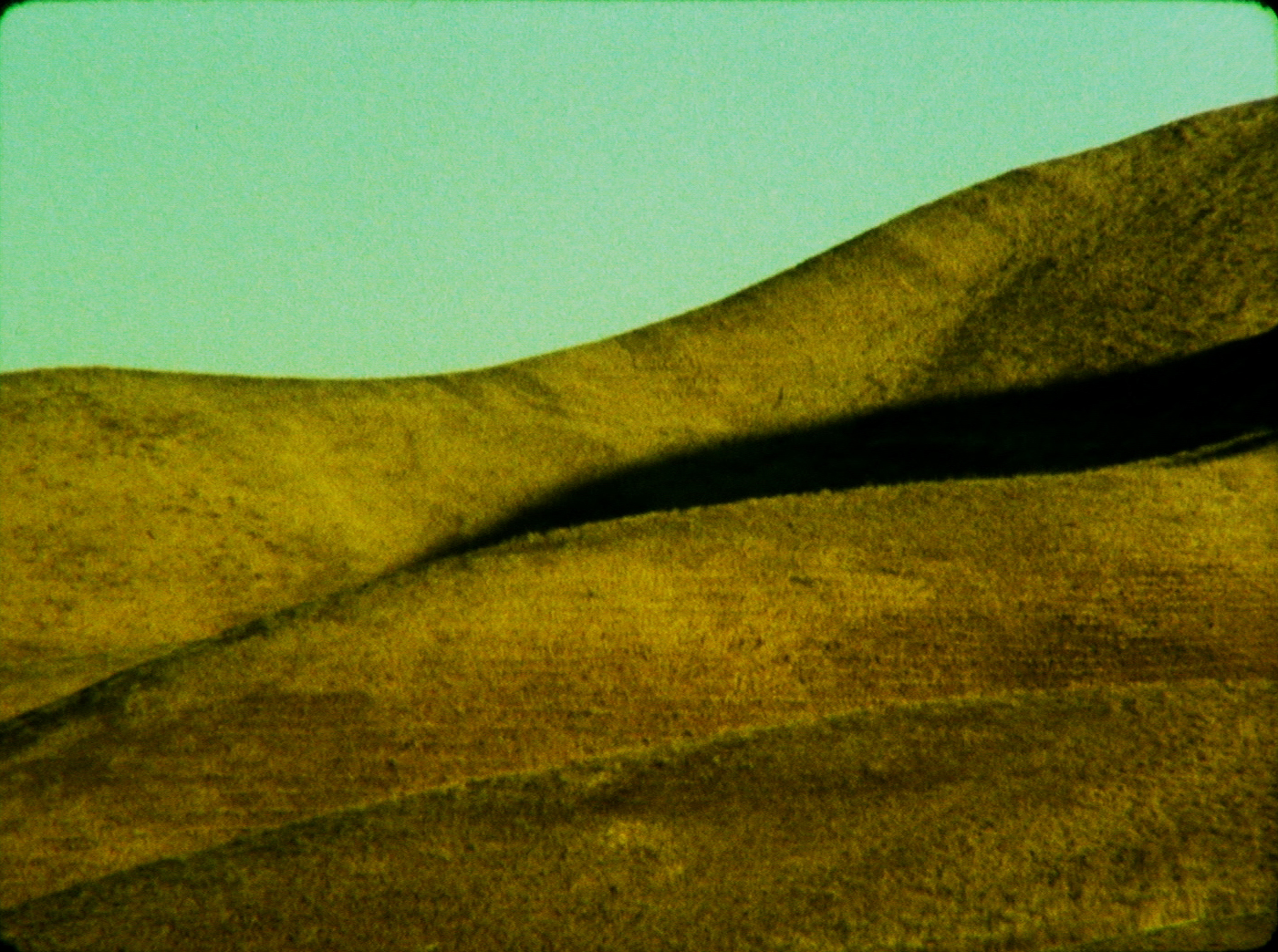
The Dragon is the Frame
2014, 14 minutes (16mm)
An experimental detective film made in remembrance: keeping a diary, footnotes of film history, and the puzzle of depression. (MHC)
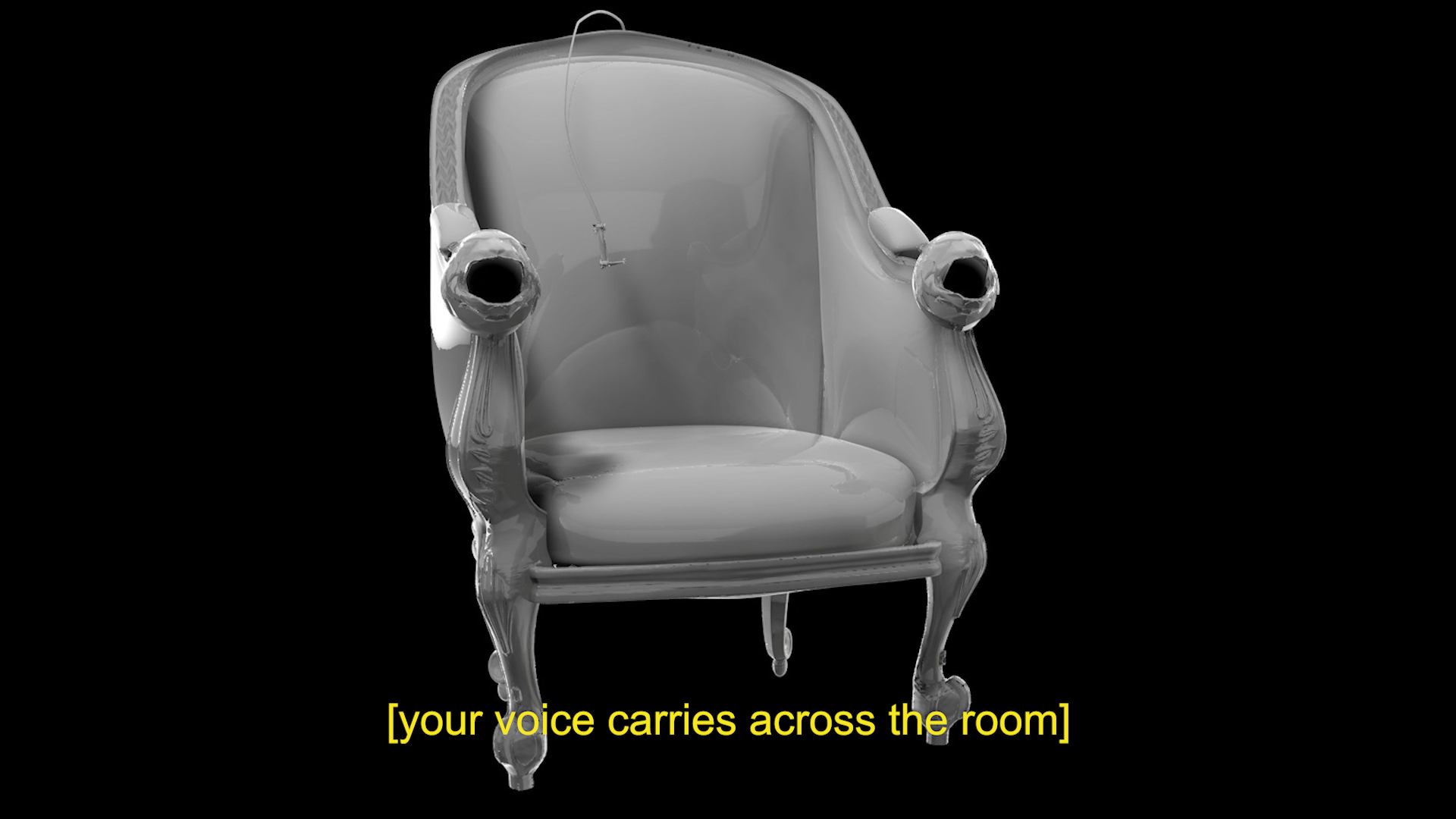
The Glass Note
2018, 9.5 minutes (digital)
In The Glass Note, a collage of sound, image, and text explore cinema’s inherent ventriloquism. Across surface and form, the video reflects on voice, embodiment, and fetish through the commingling of sound and image. (MHC)
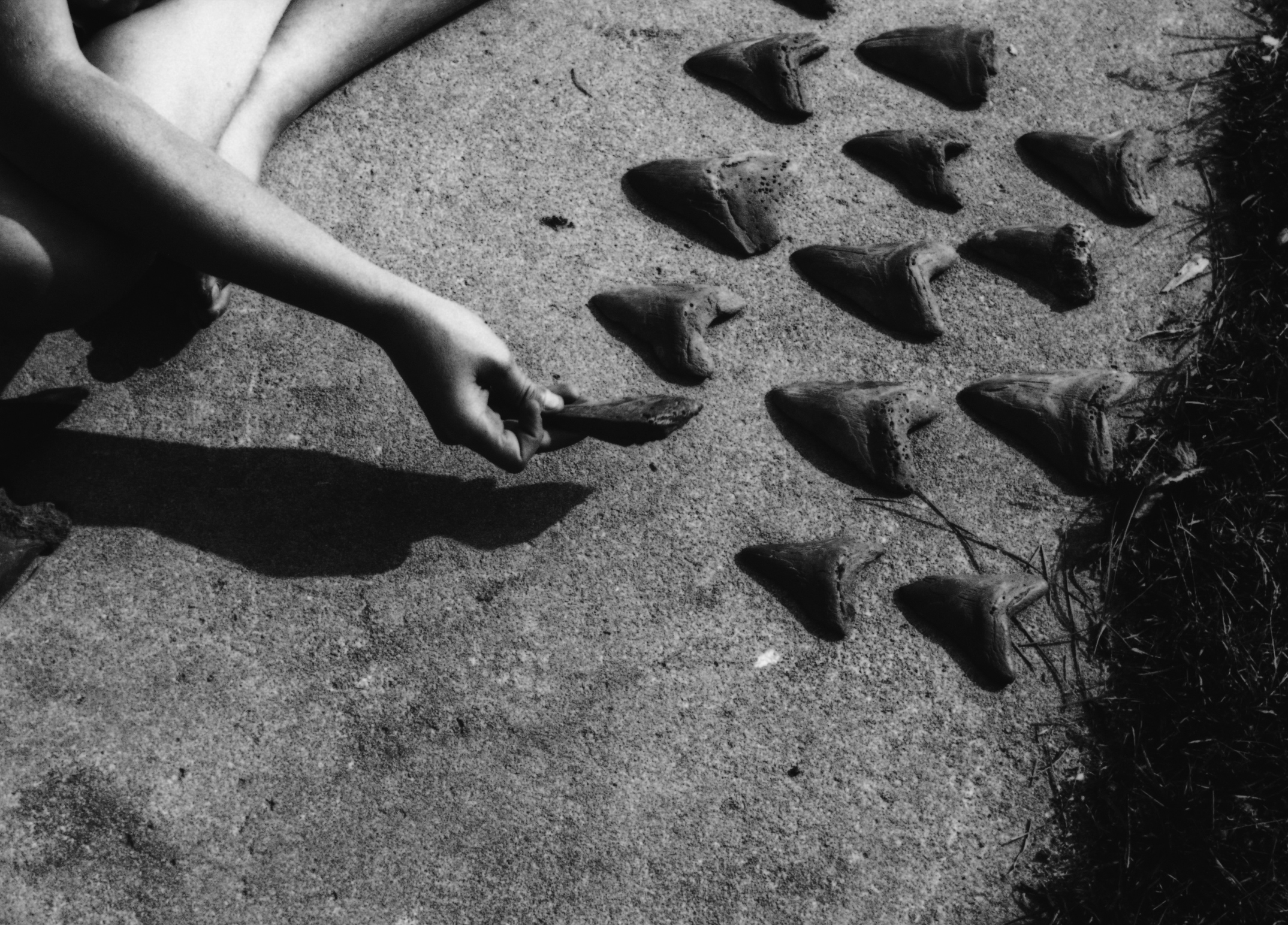
Figure Minus Fact
2020, 13 minutes (digital)
Night, like mourning, remakes space through absence: forms at the threshold of perception heighten sound and touch. When someone dies there is a pull towards the concrete and tangible, but disbelief creates a world of unreliable objects.
Figure Minus Fact draws and redraws coordinates between spaces, senses, and objects, groping in the dark, desiring to see something that’s not there. Spaces become evidentiary yet deceptive in a subjectless portrait of loss. (MHC)
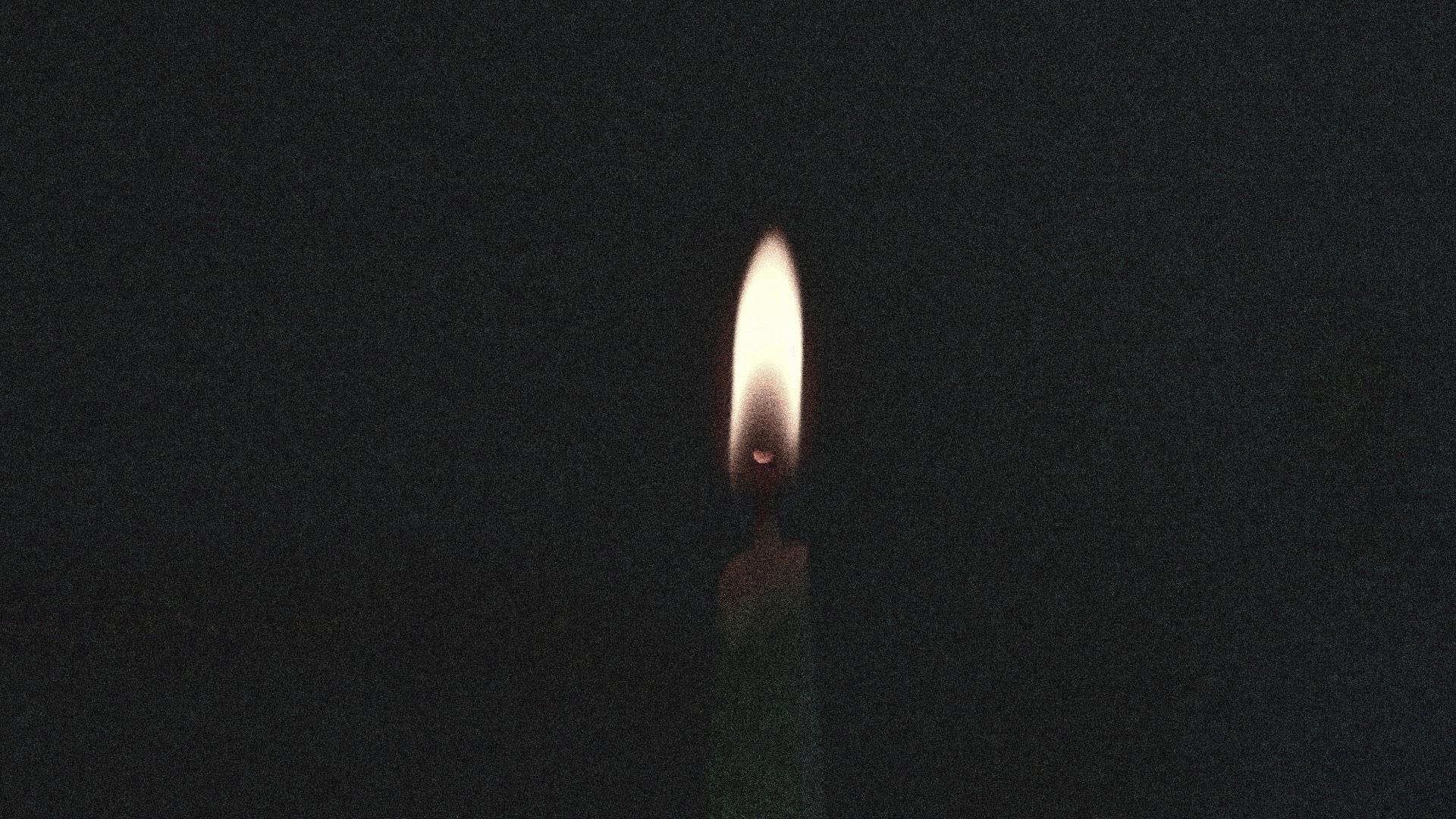
Exhibition
2022, 19 minutes (digital)
Pivoting between two stories of women and their relationships with objects—a Swedish woman’s marriage to the Berlin Wall,
and a suffragette’s hatcheting of Velásquez’s The Toilet of Venus—Mary Helena Clark’s Exhibition is a maze-like tour through
images and artifacts, a dense cryptography of the forms and objects that hold us in. (Leo Goldsmith)
RPM Festival Solo Artist Program presented with the support of a Festivals Grant from the Massachusetts Cultural Council.
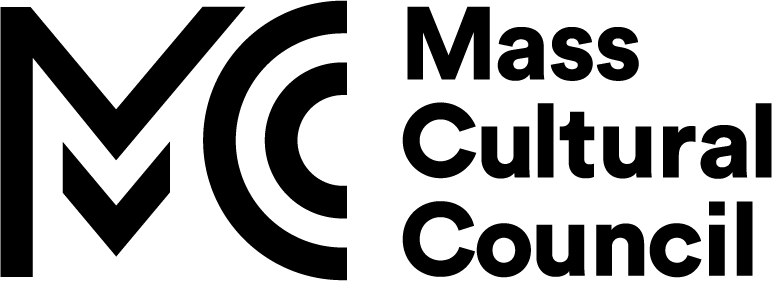
Return to top
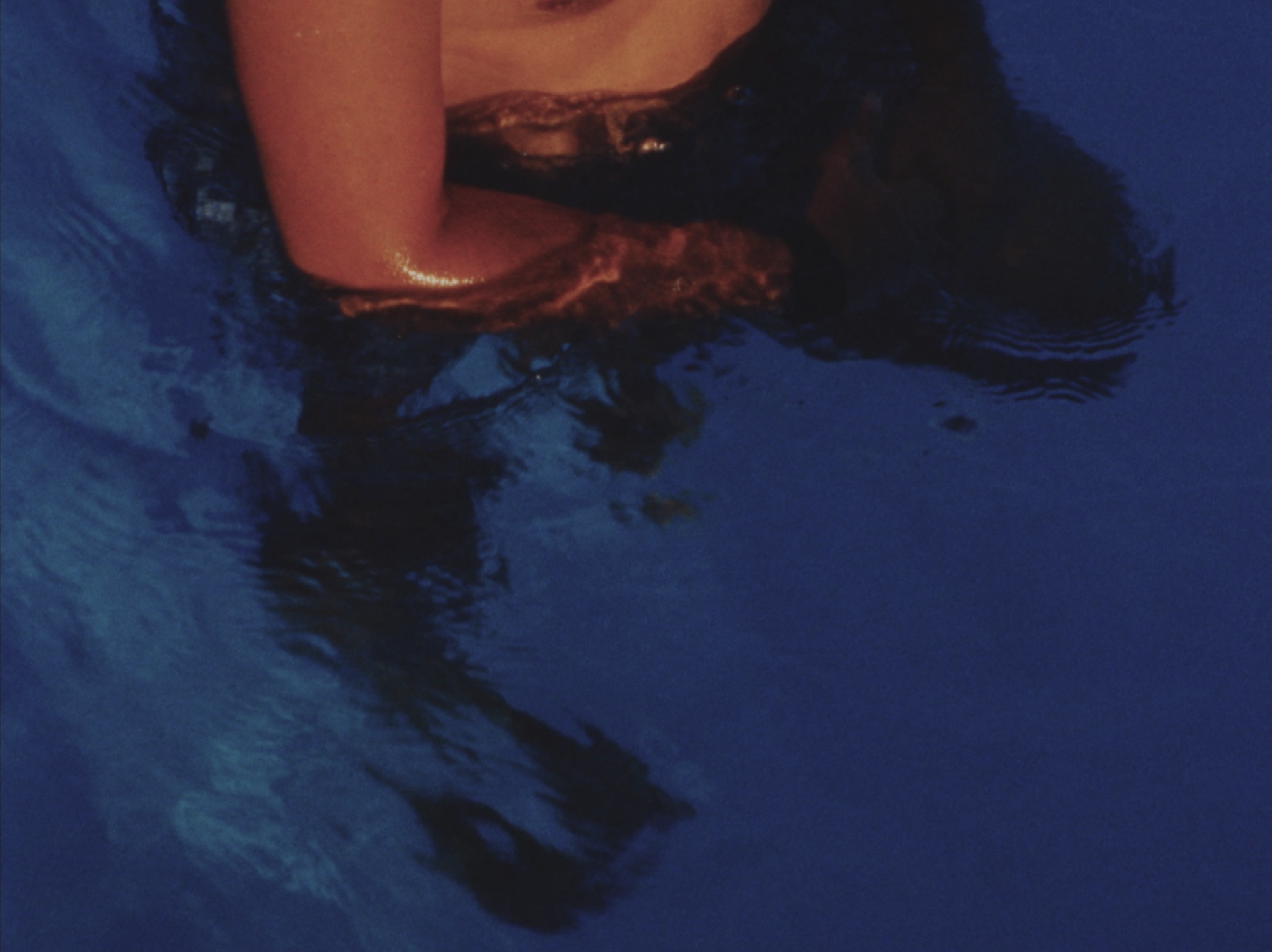
Attitudes Passionelles, 13 mins, HD, color/sound, 2015
House, 16 mins, HD, col/sd. 2015
Evangelia C’est Moi, 11 mins, 16mm to HD, color/sound, 2017
Keeping Together in Time, 9 mins, 16mm to HD, col/bw, 2020
Are You My Mother?, 5 mins, 16mm to HD, col/bw, WIP 2023
Post Screening Q&A
Alison Folland & Jennifer Montgomery
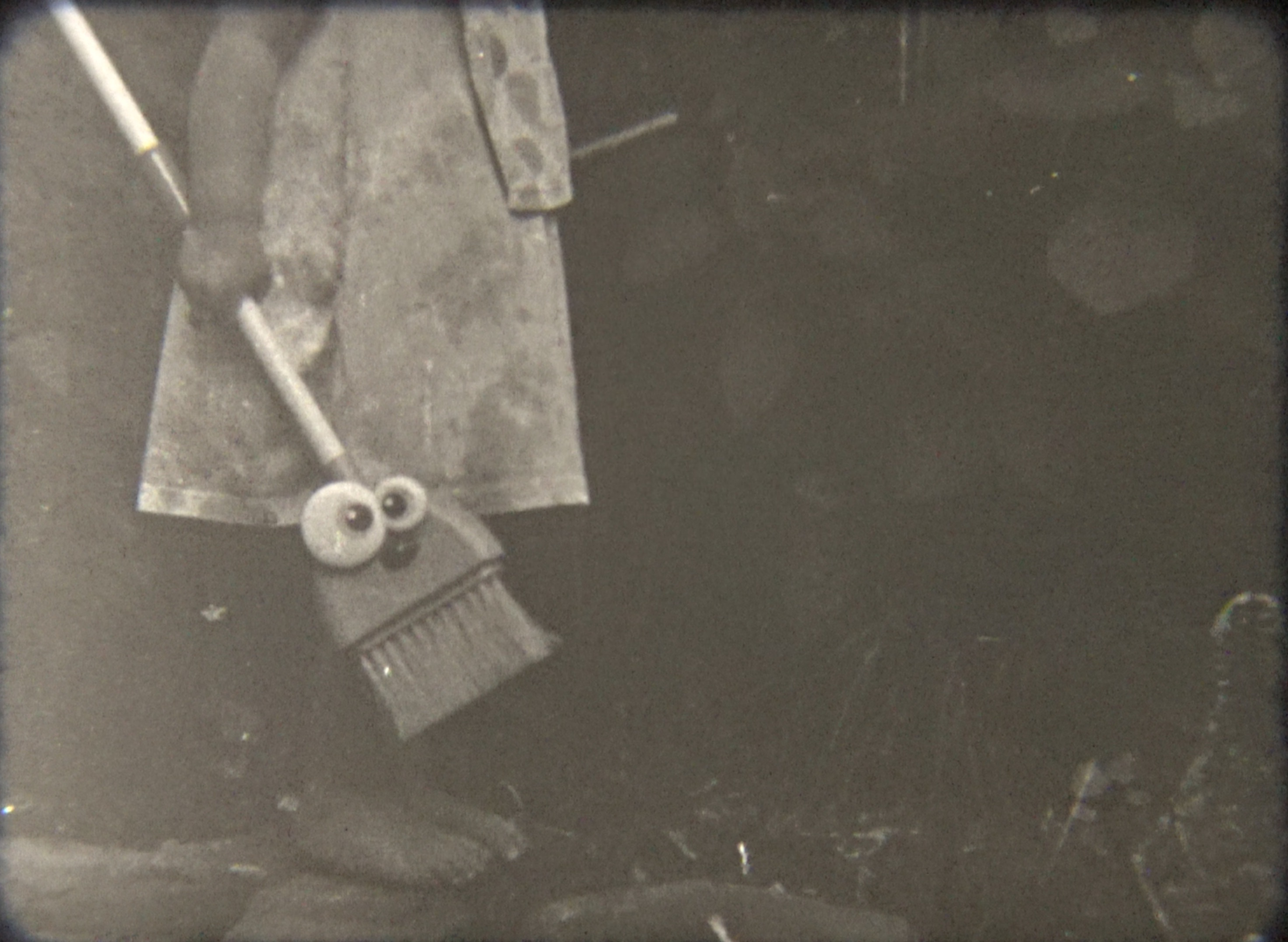
RPM and The Brattle Theatre are thrilled to co-present a program of experimental short films by filmmaker and performer Alison Folland. The screening will take place on Sunday, March 19 (2PM) at The Brattle Theater in Cambridge, MA., titled Some Problems of Domestication
Alison Folland is a filmmaker and performer based in Somerville, MA. Her short hybrid films engage questions of affect and truth-value and are directly informed by her work as an actor in the commercial film industry.
Alison studied physical theater at the Experimental Theater Wing at NYU/Tisch and film/video art at Massachusetts College of Art and Design.
Her films have been screened at festivals such as Athens International Film and Video Festival (Ohio), Athens International Film Festival (Greece), Antimatter (Victoria, BC), and Winnipeg Underground Film Festival.
As a performer, Alison has worked with directors such as Gus Van Sant, Todd Haynes, Barbet Schroeder, and David O. Russell.
She is a member of Agx Film Collective and teaches 16mm filmmaking at Emerson College.
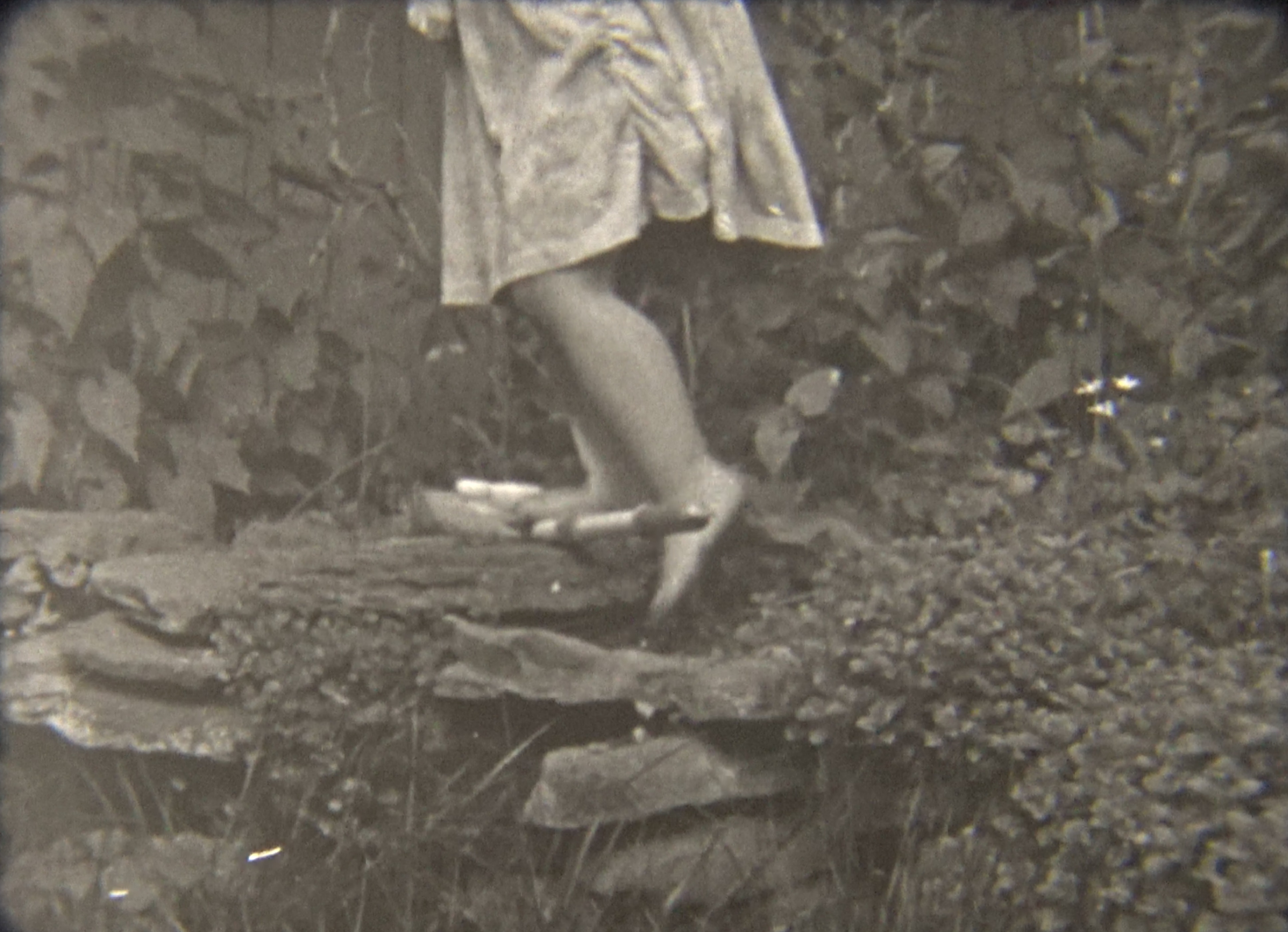
Post Screening Q&A with Jennifer Montgomery and Alison Folland
Jennifer Montgomery is a Visiting Assistant Professor of Modern Culture and Media at Brown University.
Her work has been screened internationally at festivals such as Toronto, New Directors New Films (MoMA), San Francisco, Rotterdam, Thessaloniki, Rimini, Edinburgh, and Melbourne.
It has also screened at museums such as the Whitney (NYC), the ICA (London), the Museum of Modern Art (NYC), the Walker Arts Center (Minneapolis), and the Pasadena Arts Center, and has had theatrical distribution in American and European repertory theaters.
She has received grants from the Guggenheim Foundation, the Jerome Foundation, Art Matters, the New York State Council on the Arts, the Wisconsin Arts Board, and received a Mary L. Nohl Fellowship from the Greater Milwaukee Foundation.
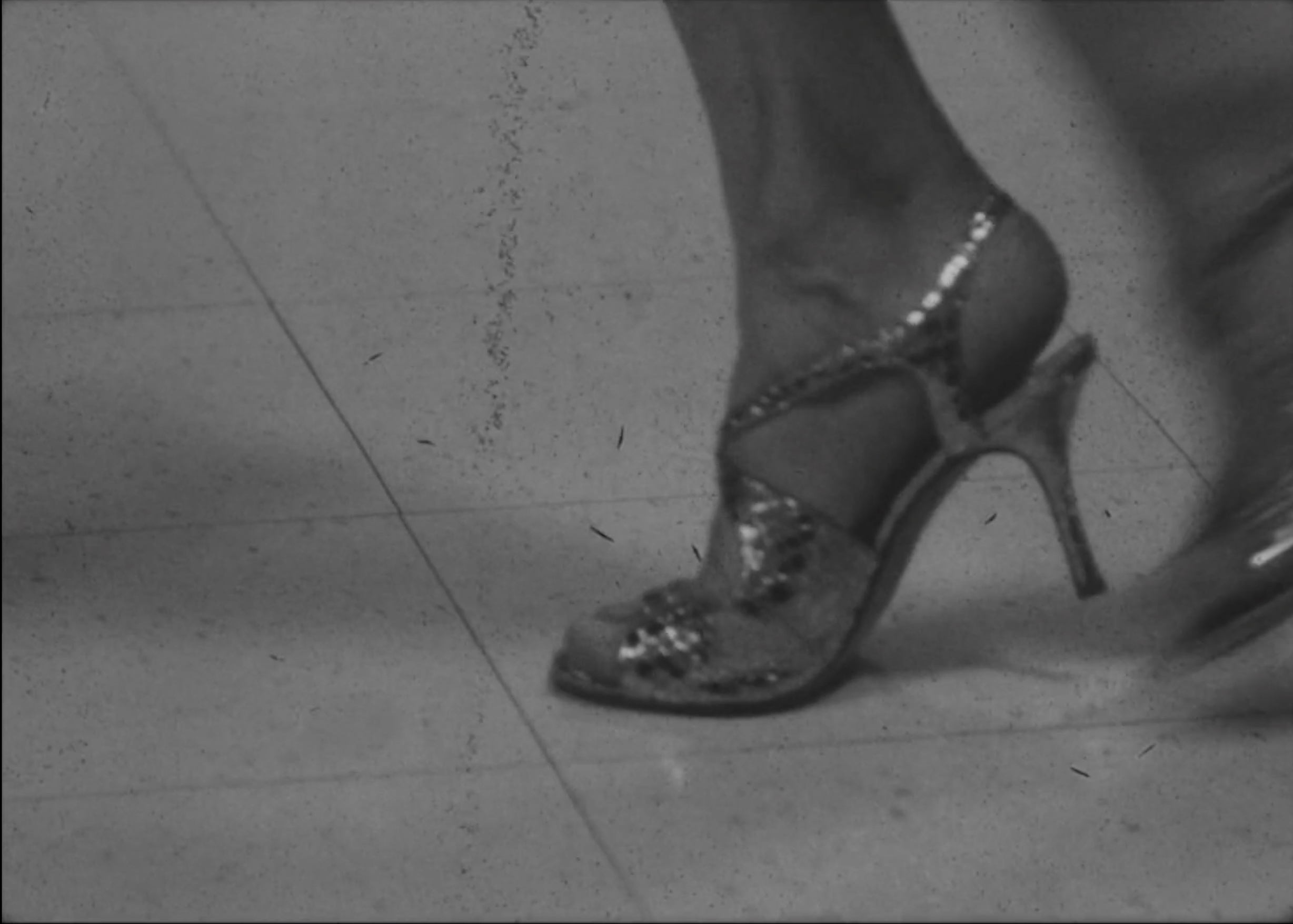
Attitudes Passionelles
2015 • HD • 13 min
A hybrid video essay exploring topics of romantic ballet, madness, and the relationship between physical gesture and inner state.

House
2015 • HD • 16 min
An adaptation of the “Full House” pilot, set on a half-built house outside Athens, Greece.
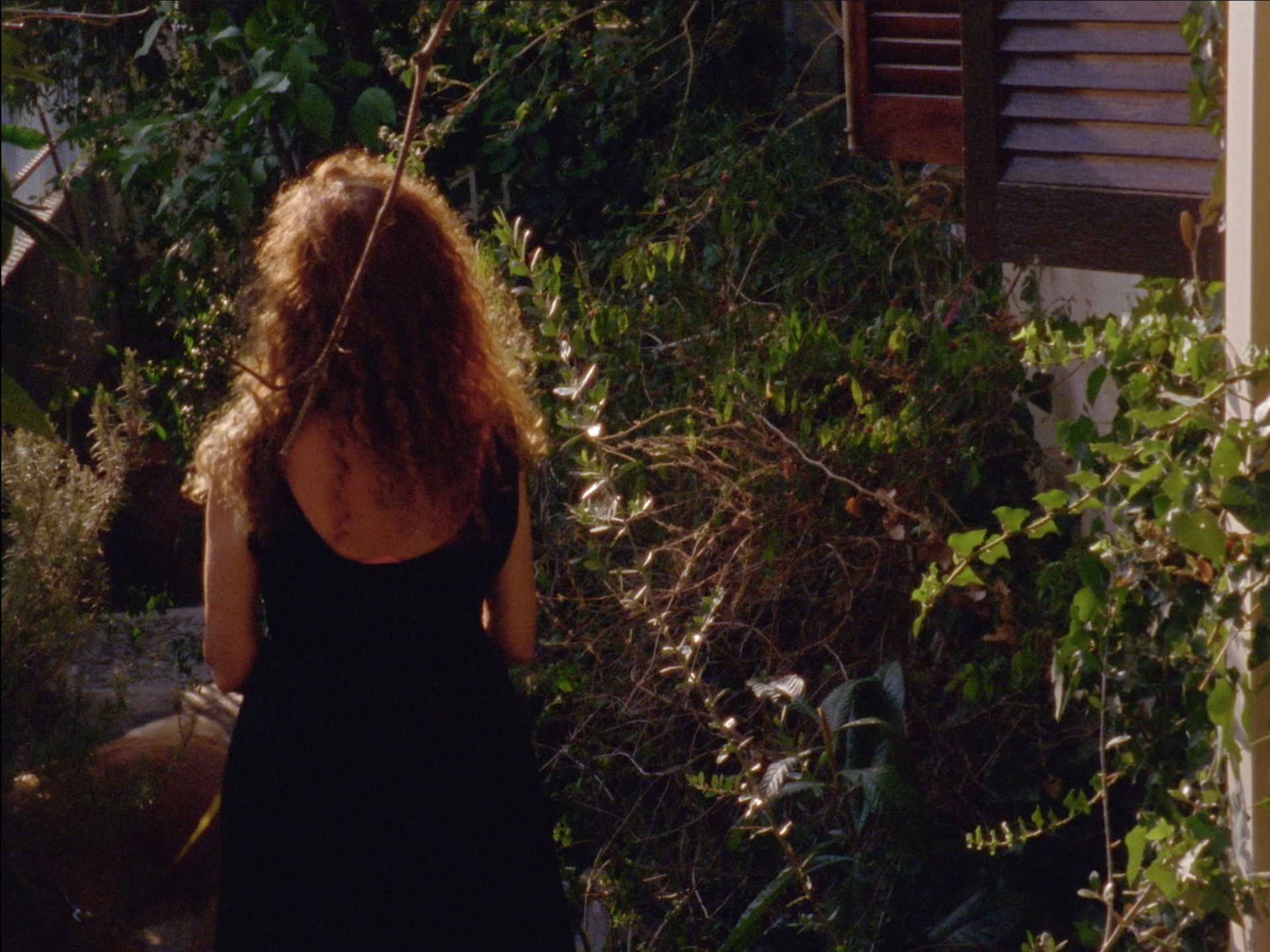
Evangelia C’est Moi
2017 • 16mm to HD • 11 min
The joys and heartaches of largesse. A real-life Madame Bovary reflects on her past excesses from her kitchen in austerity-era Greece.
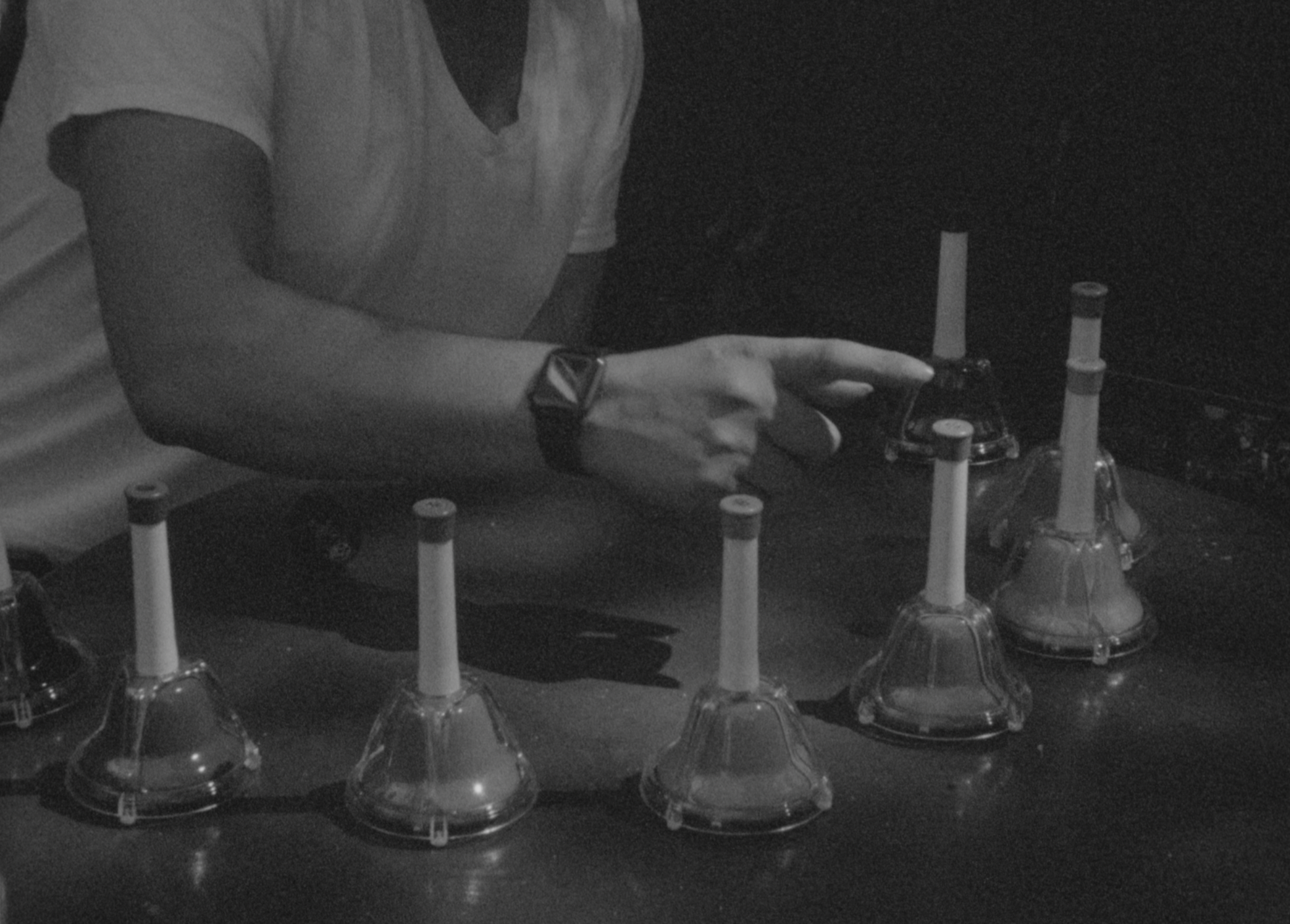
Keeping Together in Time
2020 • 16mm to HD • 9 min
This film is an attempt to define the word, “teleomeric”. It is an imaginary word, taught to me by my husband. He later had a stroke and lost his language, leaving me with the memory of a word that I cannot find in the dictionary.
--AF--
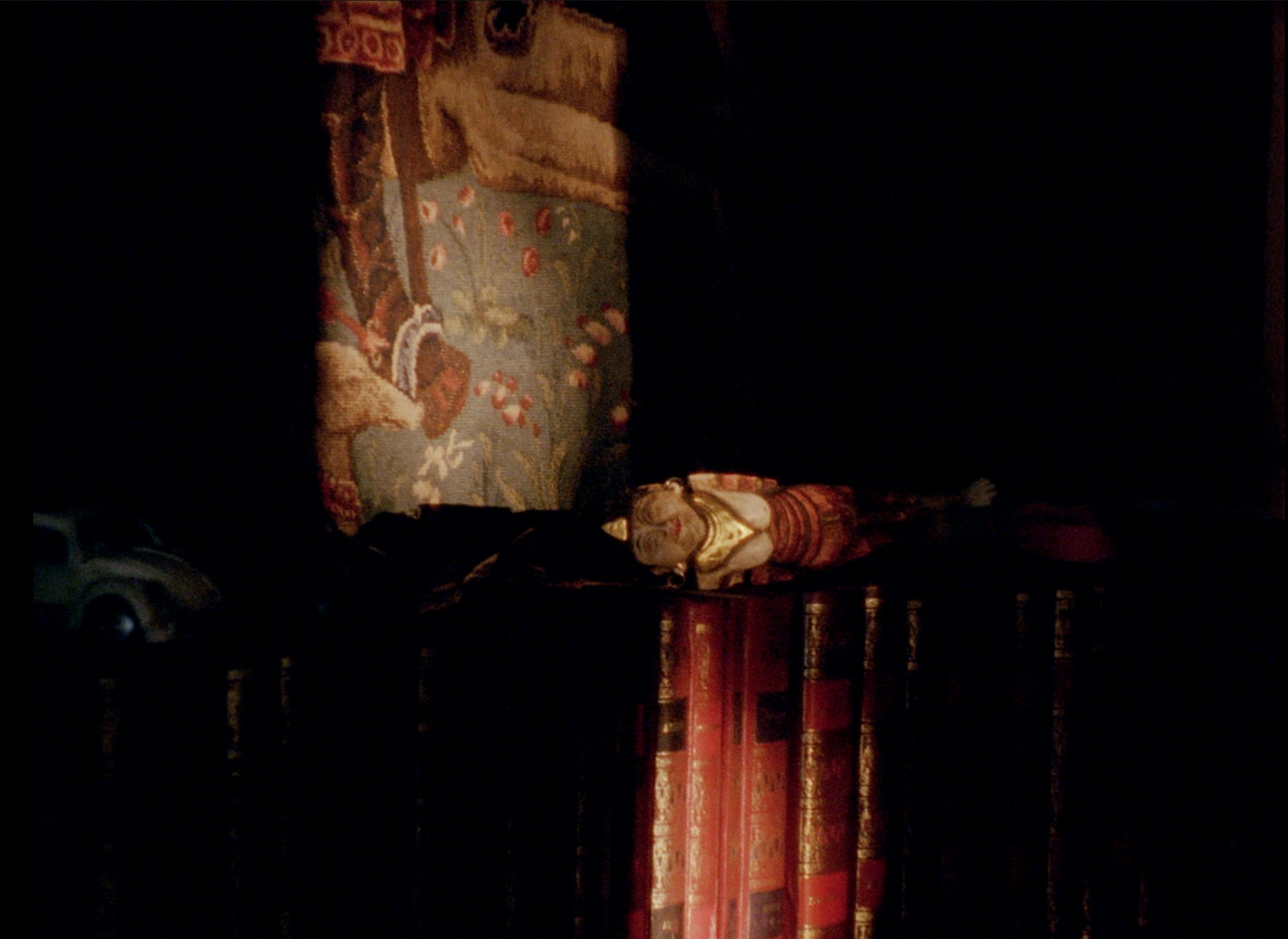
Are You My Mother?
WIP • 16mm to HD • 3 min
Can we have both love and freedom? A child ponders the situation in an animal simulator game.
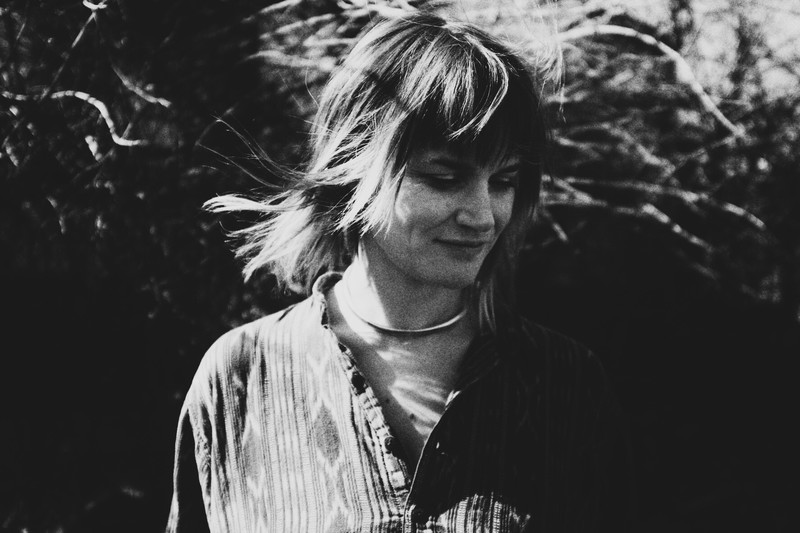
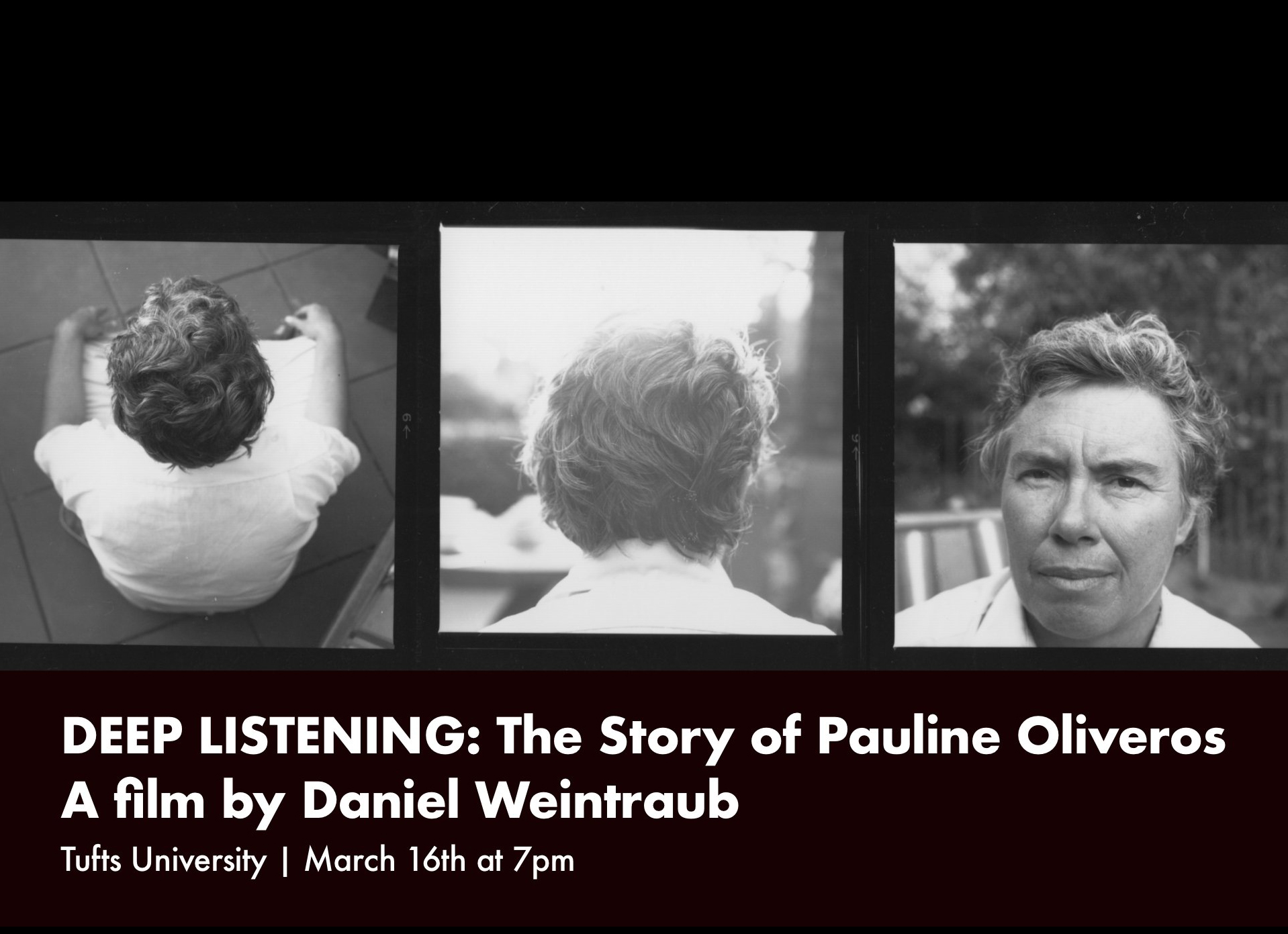
Tufts University
Barnum Hall 08
Dana Laboratory, Packard Ave,
Medford, MA 02155
Admission is free
RPM along with Non-Event, Tufts FMS, Tufts Music, and SMFA at Tufts Media Arts, presents the film Deep Listening: The Story of Pauline Oliveros, a film by Daniel Weintraub, which tells the story of the iconic composer, performer, teacher, philosopher, technological innovator and humanitarian.
Deep Listening: The Story of Pauline Oliveros tells the story of the iconic composer, performer, teacher, philosopher, technological innovator and humanitarian, Pauline Oliveros. She was one of the world’s original electronic musicians, one of the few women amongst notable post-war American composers, a master accordion player, a teacher and mentor to musicians,
a gateway to music and sound for non- musicians and a technical innovator who helped develop everything from tools that allow musicians to play together while in different countries to software that enables those with physical limitations to create beautiful music.
On the vanguard of contemporary American music for six decades, her story illuminates the pathway to how we got where we are and where the future will take us in the worlds of music, the philosophy of sound, and the art of listening.
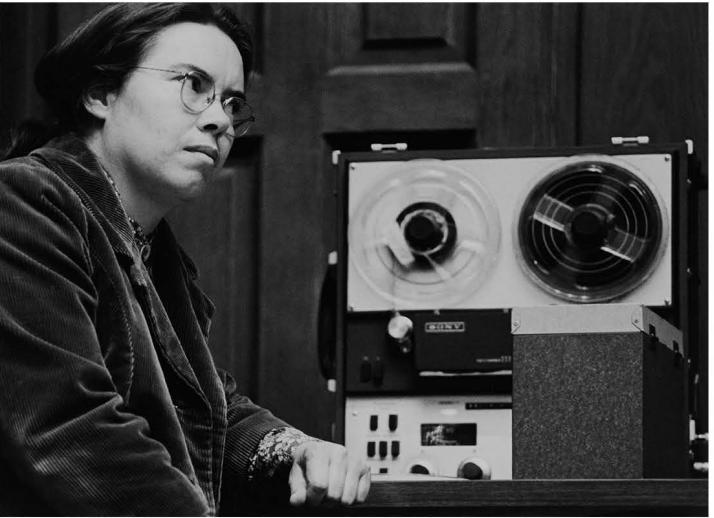
Produced in collaboration with executive producer Ione, Oliveros’ partner in life and work, and the Ministry of Maåt, Inc., the film combines rare archival footage, live performances, and unreleased music with appearances by Terry Riley, Anna Halprin, Ione, Linda Montano, Laurie Anderson, Thurston Moore, Alvin Lucier, Claire Chase, Miya Masaoka, Morton Subotnick, Tony Martin, Ramon Sender and many more ground- breaking artists.
Post Screening Q&A the director Daniel Weintraub.
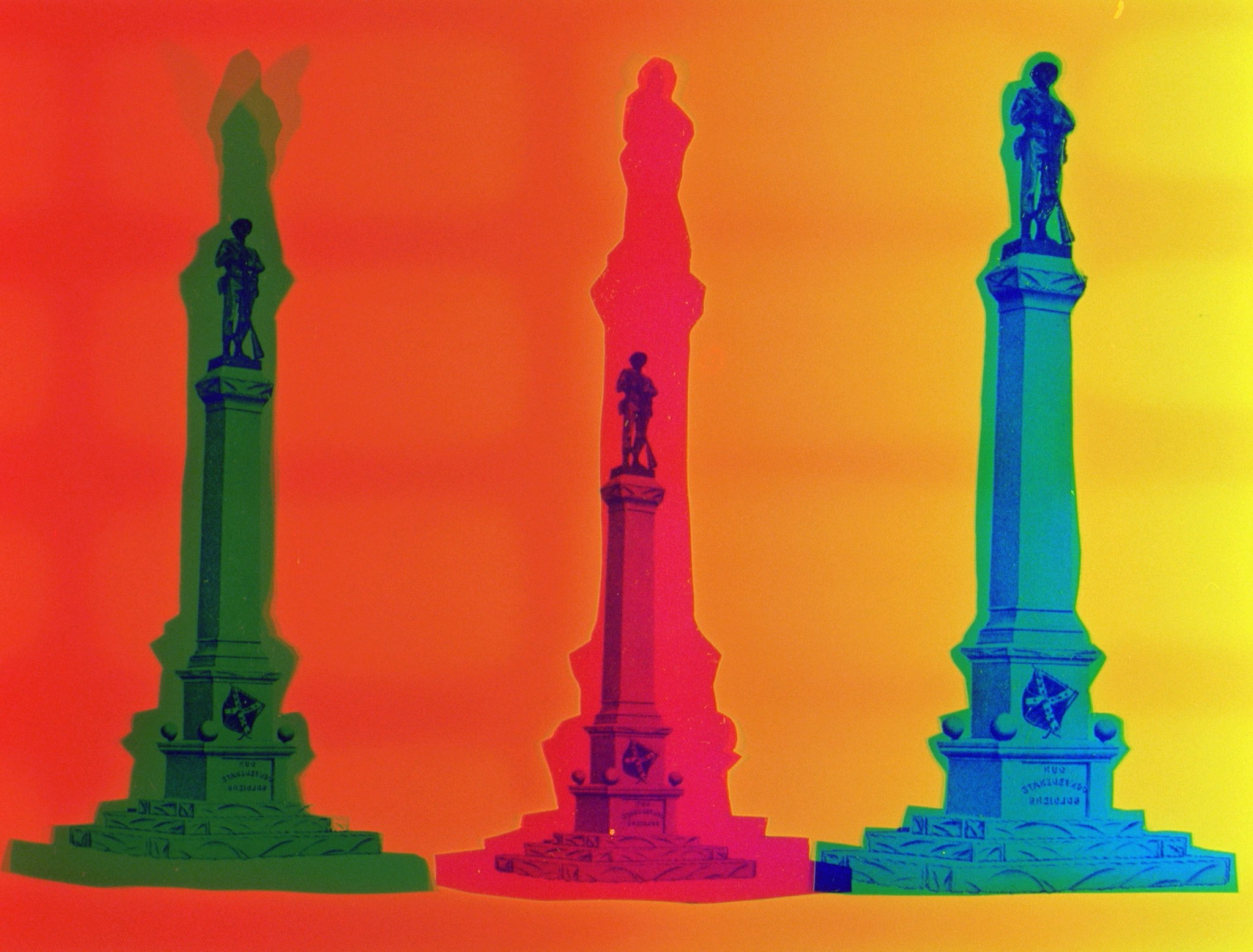
A Return to the Return to Reason | 2014, 3 minutes , 35mm to HD|
by Sabine Gruffat
Framelines | 2017,10:14 minutes |
by Sabine Gruffat
Take It Down | 2018, 12:30 minutes |
by Sabine Gruffat
Moving or Being Moved | 2020, 11 minutes |
by Sabine Gruffat
XCTRY | 2018, 6:18 minutes |
by Bill Brown
Life On The Mississippi | 2018, 28:13 minutes|
by Bill Brown
Amarillo Ramp | 2017, 24:10 minutes |
by Sabine Gruffat & Bill Brown
Post Screening Q&A
Sabine Gruffat & Bill Brown & Brittany Gravely
Brattle Theatre
40 Brattle St, Cambridge, MA 02138
8pm
RPM Festival & Brattle theatre Co-present a program of experimental short films by dynamic artist-filmmaker duo Sabine Gruffat & Bill Brown.
They have been making experimental films, documentaries and essay films and performing live electronic improvise for over two decades.
Sabine Gruffat explores different methods to generate content and images, from laser cutting/etching on 35mm film strips to 3D animation. Bill Brown is known for his nomadic filmmaking and transporting us to various destinations.
Seven shorts in this program titled Moving or Being Moved, highlight their praxis in recent 10 years.
Sabine Gruffat is a French-American artist born in Bangkok, Thailand. She works with experimental video and animation, media-enhanced performance, participatory public art, and immersive installation. In this work, machines, interfaces, and systems constitute the language by which she codes the world. The creation of new ideas means inventing new ways of using existing tools, crossing signals, or repurposing old hardware. By actively disrupting both current and outmoded technology, Gruffat questions the standardized and mediatized world around us. She has produced digital media works for public spaces as well as interactive installations that have been shown at the Zolla Lieberman Gallery in Chicago, Art In General, Devotion Gallery, PS1 Contemporary Art Museum, and Hudson Franklin in New York.
She is also a filmmaker with a special interest in the social and political implications of media and technology. Her experimental and essay films explore how technology, globalization, urbanism, and capitalism affect human beings and the environment. These films seek to empower people, encourage social participation, and inspire political engagement. Sabine's films and videos have screened at festivals worldwide including the Image Forum Festival in Japan, The Ann Arbor Film Festival in Michigan, and Migrating Forms in New York, the Viennale, MoMA Documentary Fortnight, Cinéma du Réel at the Centre Pompidou, 25FPS in Croatia, Transmediale in Berlin, and The Copenhagen International Documentary Film Festival. Her recent video works are distributed by the Video Data Bank in Chicago, IL.
Bill Brown is a media artist interested in ways landscape is interpreted, appropriated, and reconfigured according to human desires, memories, and dreams. His films have screened at venues around the world, including the Rotterdam Film Festival, the London Film Festival, the Sundance Film Festival, and Lincoln Center. A retrospective of his films was shown at the Museum of Modern Art in New York.
In addition to his filmmaking, Brown is the co-founder of the Zine Machine: Durham Printed Matter Festival, and the Cosmic Rays Film Festival, an annual showcase of experimental and first-person films.
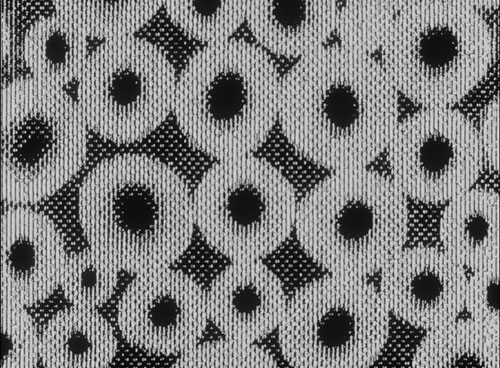
A tribute to Man Ray's 1923 film, the first film to use his 'Rayograph' technique in which Man Ray exposed found objects onto film negative. The “original” film was digitized with all its aged emulsions, scratches, and splices, then compiled into digital filmstrips. These filmstrips are used to output a dithered and inverted image that a laser engraver etched onto black 35mm film leader.
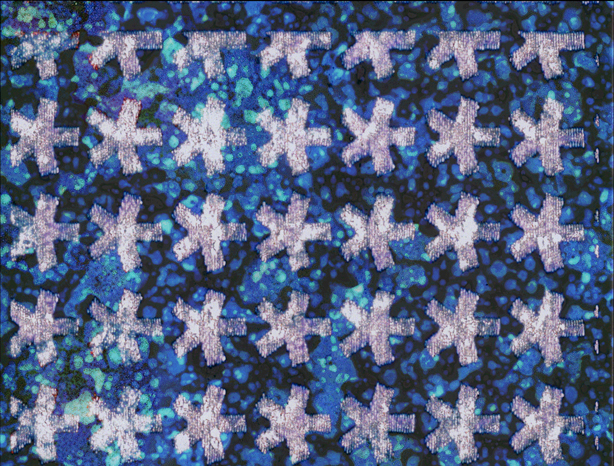
An abstract scratch film made by laser etching preset patterns onto the film emulsion of negative and positive 35mm film. The strips of film were then re-photographed on top of each other as photograms. The soundtrack is created by filtering and layering the noise made by the laser etched 35mm optical track.

Employing solarized color positive 35mm film and animation of old postcard images of Confederate monuments in North Carolina, Take It Down documents how Southern identity continues to be bound up in the legacy of the Civil War and the Jim Crow Era. The film considers how these old memorials continue to be sites of conflicting politics and historical narratives.
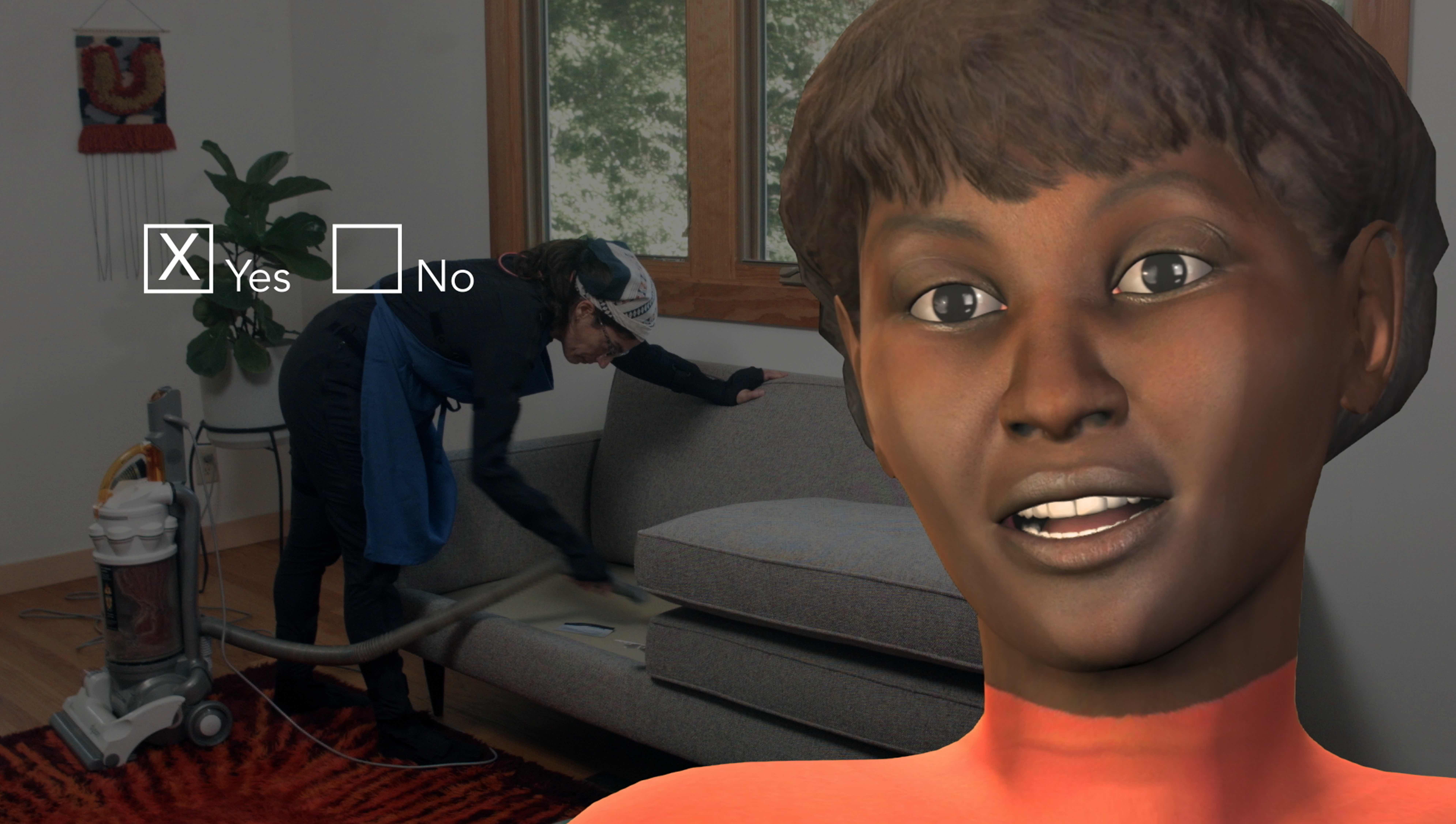
Post-modern dance theory by Trisha Brown and Yvonne Rainer is put to work while a woman cleans the house in a motion capture suit. The everyday performance of domestic labor is teleported into a surreal game world where an emotionally responsive AI chatbot provides no answers. In this gaming/ special effects world, movement has become a data set removed from the human body.
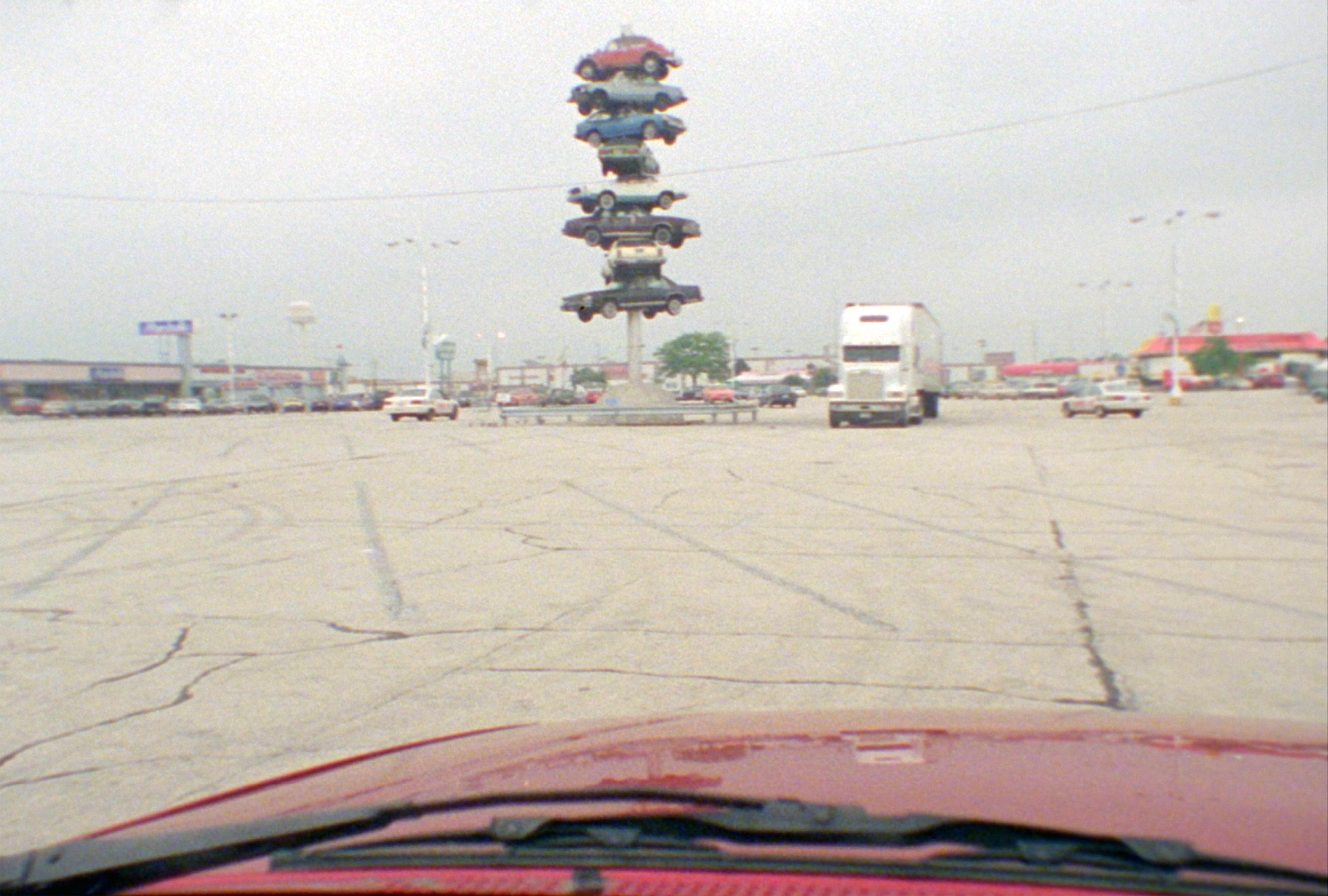
Brown re-works 16mm footage that he shot years ago during a cross-country road trip from Chicago to Las Vegas. The spatial discontinuities of the road trip are rendered as visual continuities across three frames as Brown goes in search of the next town to fall in and out of love with.
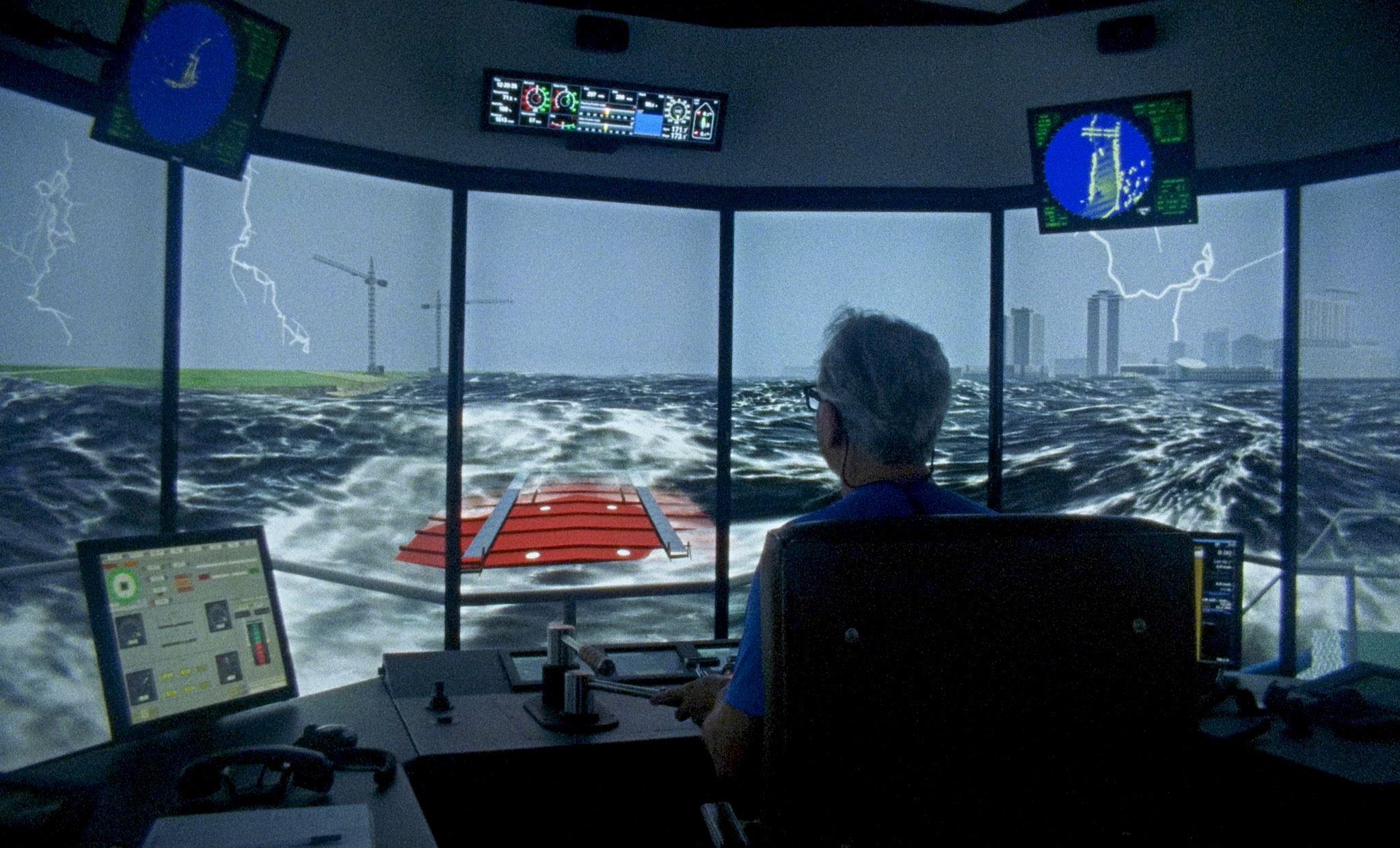
A short essay film about a river and the limits of knowing it. Using Mark Twain’s Life On The Mississippi as a road map, Brown travels from Memphis, Tennessee to New Orleans and considers ways that river pilots, paddlers, historical reenactors, and civil engineers attempt to know the river through modeling, measurement, and simulation.
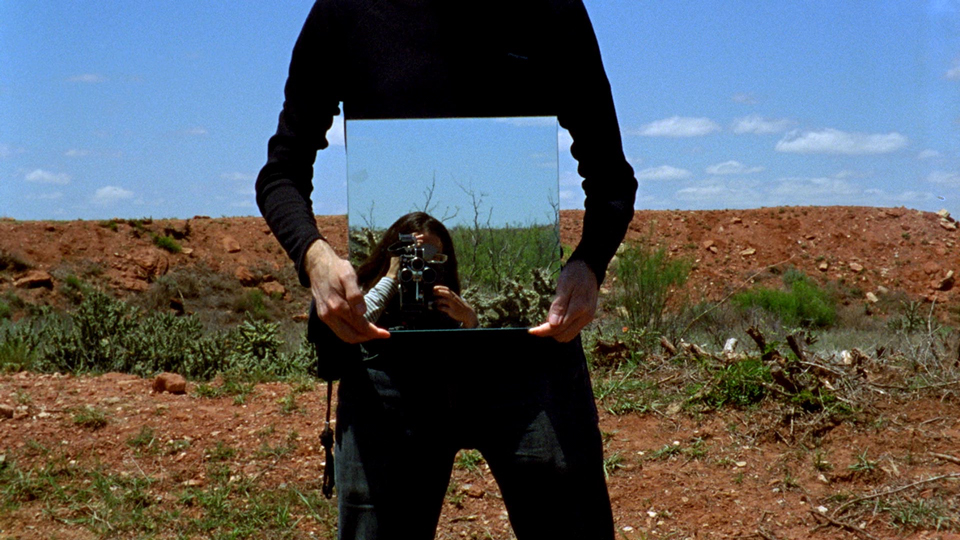
Amarillo Ramp
(Brown + Gruffat, 2017, 24:10)
A portrait of sculptor Robert Smithson's final earthwork. Employing filmmaking strategies that are both responsive to the artwork's environmental context and informed by Smithson's own art-making strategies, the filmmakers encounter the Ramp as an observatory where human scales of space and time are set against geological and cosmic scales.
Return to top
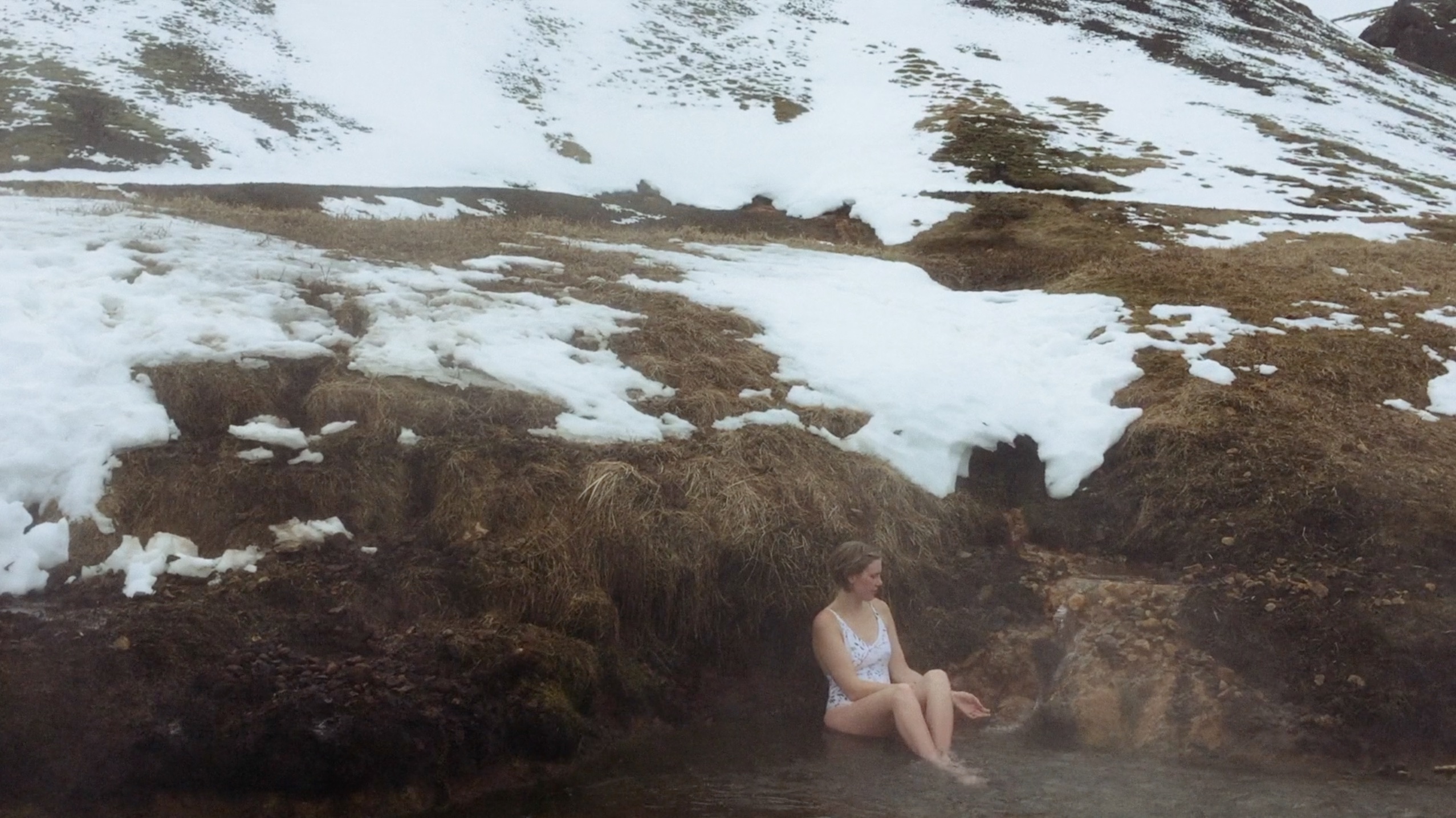
Quiet motors | 2017, 1’24 |
Music by Pierre Bastien
Babylone | 2018, 1’13 |
Music by Kraus
Three motors | 2018, 1’55 |
Sound recording by Ève Couturier and Jean-Jacques Palix
Transports | 2018, 15’50 |
Music by Pierre Bastien, Narassa, Gamelan Voices, Lawrence, mix by Waltraud Blischke.
Volatile | 2019, 9’47 |
Music by Stine Janvin
Korridor | 2020, 1’16 |
Music by Marie-Pierre Bonniol and Walter Duncan (co-director)
Wasser | 2021, 22'35 |
Music by Andreas O. Hirsch, Khaki Blazer, Raymonde, Richard Pinhas, The Dead Mauriacs
RPM Festival & Non-Event Co-present a program of experimental short films by the filmmaker Marie-Pierre Bonniol.
These seven short films are all related to music, with soundtracks by musicians such as Pierre Bastien, Gamelan Voices, and Stine Janvin. The longest of these films is Wasser (2021, 22'35), a powerful abstract essay on water and its transformation into energy, features a soundtrack by Andreas O. Hirsch, Raymonde, Khaki Blazer, Richard Pinhas, and The Dead Mauriacs.
Obsessed by the idea of Imaginary music, Marcel Duchamp’s idea of the “bachelor machine,” and the power of mysteries, Marie-Pierre Bonniol's films –
all recorded on her smartphone – have been presented at Cafe OTO in London, ZKM in Karlsruhe, the National Library of Argentina, Anthology Film Archive in New York, the Alchemy Arts & Film Festival, and the Chicago International Film Festival.
Please note that some parts of the programme are not adapted to people with PSE (Photosensitive epilepsy).
This program is co-presented with
the Goethe-Institut Boston and Non-Event
Post Screening Q&A
Marie-Pierre Bonniol & Wenhua Shi
Goethe-Institut Boston
170 Beacon Street, Boston
Doors: 7:30pm Performance begins promptly at 8pm
Tickets: $10 / $5 for members and students
Advanced Tickets available
Return to top